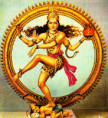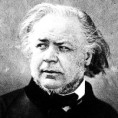Blog
Lately I have had unusually vivid dreams, perhaps stimulated by my enthusiastic blog writing. Writing those might, like dreams, be likened to stepping into a strange, yet familiar world where I spend time with people I've met and books I've read.
Last night, as so often before, I dreamed about dead and living friends and family members. I had interesting conversations with them, within surroundings familiar to me, though nevertheless strangely changed, both indoors and outdoors. Action took place within memories of childhood regions, but mixed with landscapes I have later spent time within. My dreams often occur in and around slightly dilapidated houses, or even labyrinthine castles and mansions, which for some incomprehensible reason I am the owner of, or otherwise associated with.
Last night I drove with some friends and acquaintances through such landscapes and when we reached our final destination we walked through am unkempt parkland around my parents' long-forgotten cottage, which was not at all surrounded by a park, but a forest.

Now that I have woken up, I remember quite well what we were talking about, and also the titles and content of a couple of thick and smelly books I found on the veranda of a dingy and miserably dilapidated outhouse. I can't understand why I had left such interesting books out there and neither when nor where I had purchased them.
It was also strange that the walls inside that leaky and unusually large outbuilding were covered with wallpaper, which had peeled in large chunks and strips. Under them, as had been common in the past, the walls had been covered, not with pasted newspaper as they did then, but with engravings I recognized, by Goya, Klinger, Esher, and others.

The books and graphics of my dreams were perhaps connected to my latest blog posts and this made me think of my youngest daughter, who lately in anticipation of something better, is working in an acquaintance's newsstand. She told me that most of the regular customers are older people who buy newspapers and crossword magazines. The latter is perhaps partly due to the fact that older people, in fear of an increasing senility, have listened to the fact that brain activity is stimulated by crossword puzzles. Personally, imagine that my blog writing might have a similar beneficial effect on my aging brain. I really don't know.

That the engravings appeared in the world of my dreams was not so strange because I recently with my wife visited an art gallery here in Prague where we stay my oldest daughter. Now that I have woken up and the others are still asleep, I got the idea to use my blog to present some engravings that have remained in my memory.
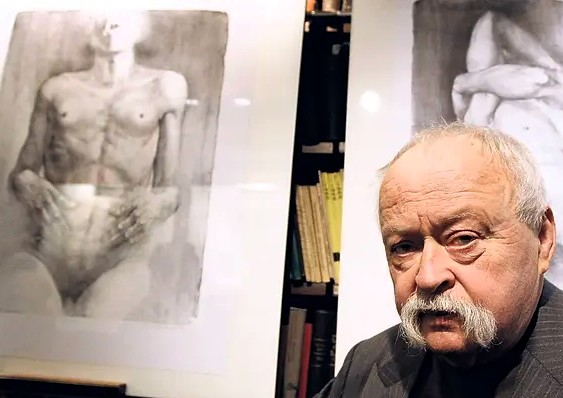
What Rose and saw here in Prague were works by Oldřich Kulhánek (1940 – 2013), a graphic artist who, among other things has made the Czech banknotes. It is one of my pleasures to scrutinize in countries I have ended up in and figure out what personalities they might depict. Banknotes are usually small works of art, and thus, are euro banknotes a disaster – boring as they are with their bland architectural motifs.

Kulhánek's Czech banknotes are works of art in their own right. Among other things, he produced the 500 corona banknote with an image of Božena Němcová (1820–1862) and of course I found out who this for ne earlier unknown lady might be.
Božena Němcová was married to a Czech patriot who, through his newspaper articles fought the Austro-Hungarian central power. However, he was a nasty domestic tyrant who tormented his wife and their four children. Finally, Božena left him and died in poverty.
Despite her marital suffering and other troubles, Božena had been a prolific and appreciated writer who had her patriotic articles both openly and clandestinely published. Her novel Babička, Grandmother, was based on her upbringing in the village of Ratibořice and is still popular among the Czechs. Perhaps out of a guilty conscience for allowing Božena to die alone and poor, the Czech patriots arranged a grand funeral and later erected several statues and monuments in her honour
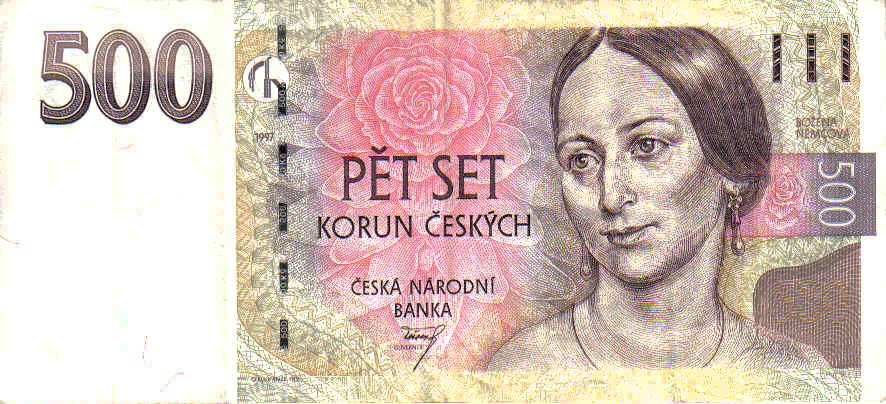
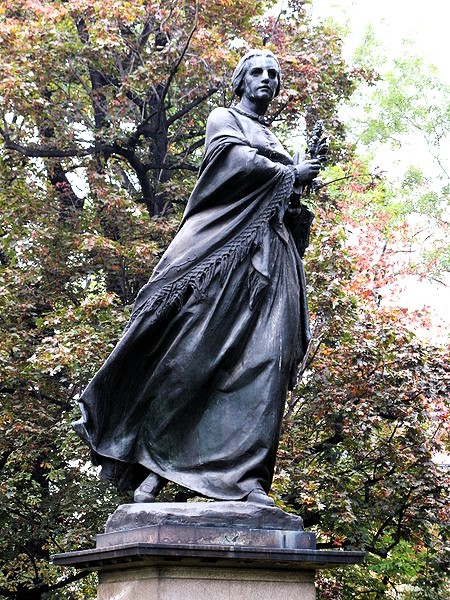
Kulhánek also devoted himself to produce a number of parodies of various banknotes. Below, for example, he has manipulated a German hundred-mark banknote with a picture of Clara Schumann, married to the brilliant composer but later incurable madman Robert Schumann and herself a skilled pianist and composer. Incidentally, I consider the original to be an unusually beautiful banknote.

In his mock version of an older German banknote Kulhánek makes Karl Marx breaking into Clara's banknote to steal her earring.
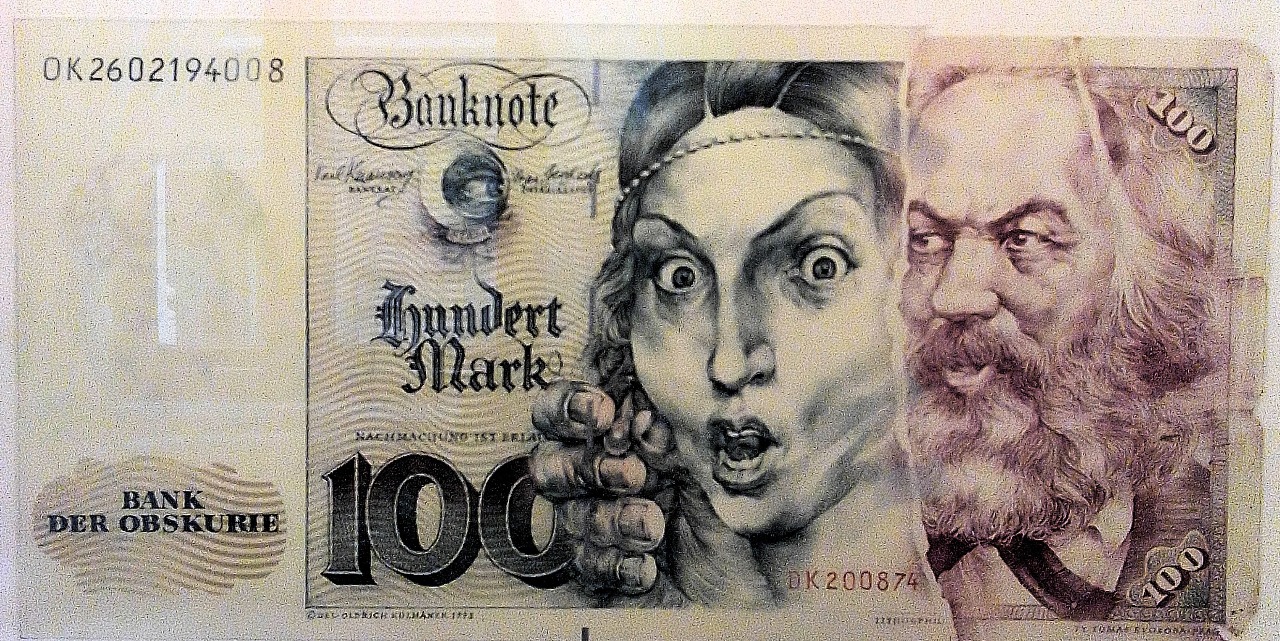
Possibly in protest against the Russian-Soviet occupation of Czechoslovakia in 1968, Kulhánek did a few years later make a ruble bank note depicting a fat pig.
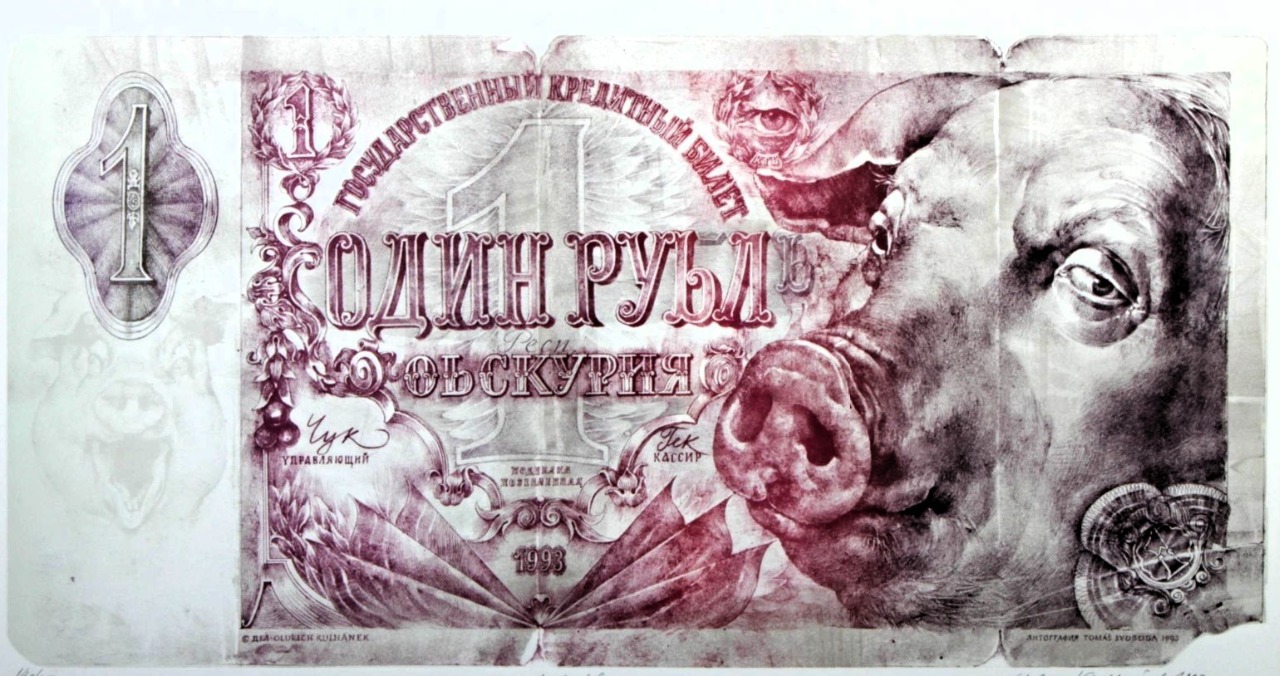
To present banknotes as a form of satire was also once done by my friend Jean Sellem in Lund, where he as a representative of the anarchist art movement Fluxus was the proprietor of the art gallery Skt. Petri. In 1977, when Sellem got into trouble with a municipal councillor named Rehn, who apparently wanted to withdraw the cultural support for his very interesting and lively gallery, he contacted the recently immigrated graphic artist Andrzej Ploski from Poland and together they created and distributed a number of "Ren noes”. Ren is the Swedish word for reindeer.
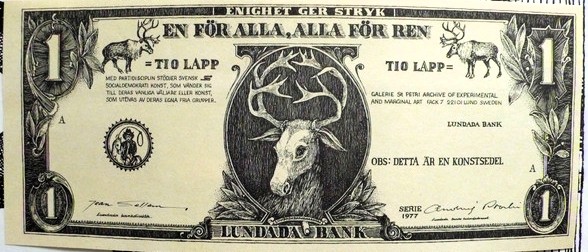
Sellem also asked me if he could use my family name to, together with Ploski, publish a satirical and partly incomprehensible little book which they called Lundius Commedia Dell'Arte
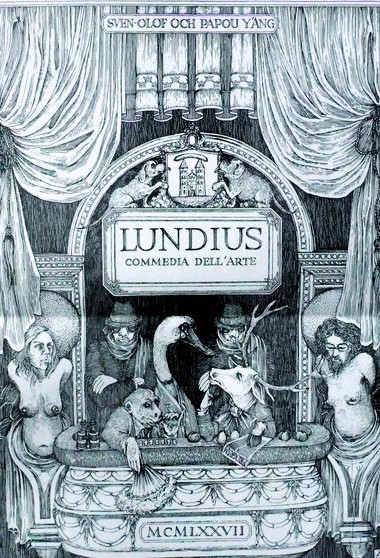
Even real banknotes have at some point been found to contain hidden satirical, or joking, allusions. Famous are banknotes from the small archipelago of the Seychelles, located far out in the Indian Ocean, printed in 1968. It was soon discovered that the pattern of the palm crowns on one of them could be read as "sex", while the pattern of corals on another banknote could be read as scum.
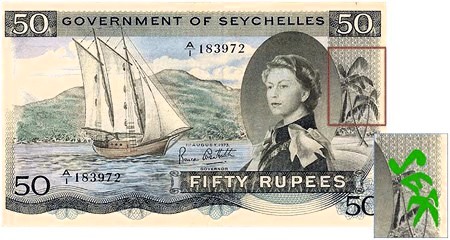
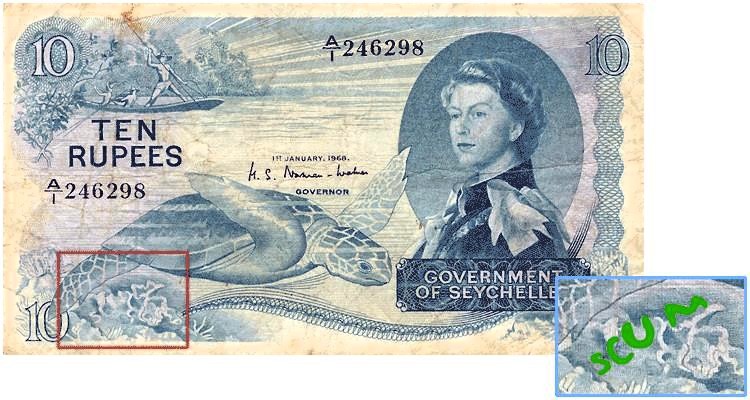
A debate ensued if the banknote's designers, Bradbury & Wilkinson, knew about the “joke”. The firm claimed it was an unintentional printing anomaly, but it seems that the whole thing was a prank by the engraver Brian Fox.
The Seychelles' British colonial administration allowed the banknotes to circulate for another eight years, until the islands in 1976 became an independent republic. Sir James Mancham, who previously had been the British governor now became president and adorned the Republic's new banknotes.
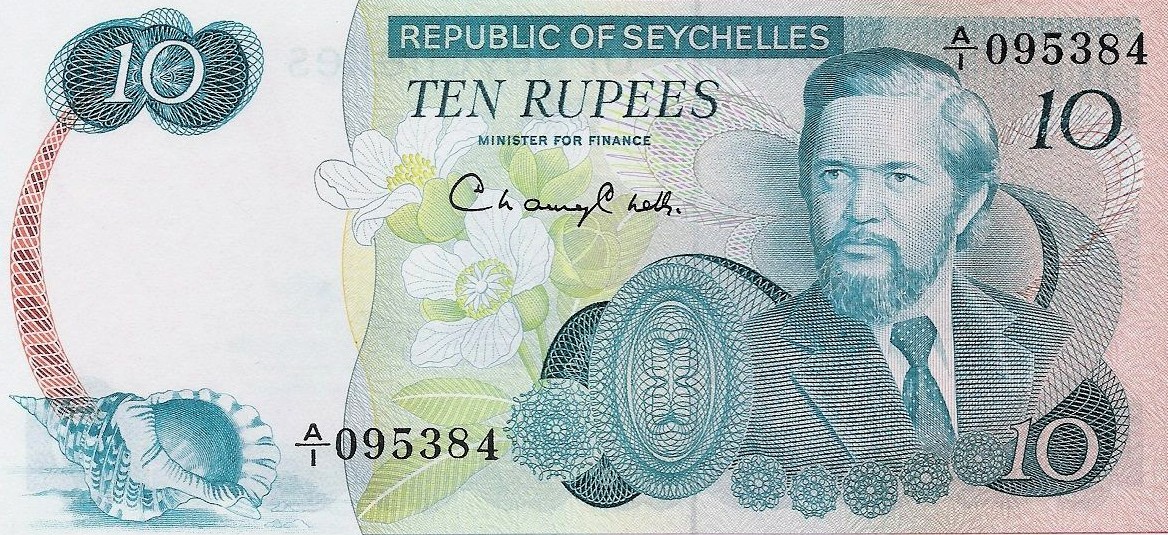
Nevertheless, they disappeared after just one year. When Sir Mancham haf travelled to England to celebrate Queen Elizabeth II's silver jubilee, his Prime Minister, France-Albert René, did with the help of about a hundred supporters and mercenaries, shipped in from Tanzania, carry out a military coup, thus beginning a twenty-year dictatorship. However, the new banknotes were not emblazoned with France-Albert René, but the stamps were.
.jpg)
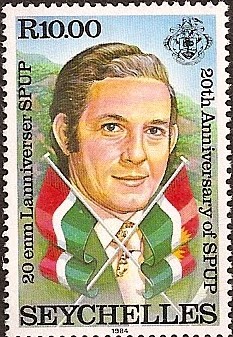
Kulhánek also created several Czech stamps, such as the ones below that paid tribute to the somewhat unconventional Holy Roman Emperor Rudolf II, who to his court in Prague invited artists, musicians and not least alchemists such as the Englishman John Dee and astronomers such as the Dane Tyge (Tycho) Brahe and the German Johannes Kepler.
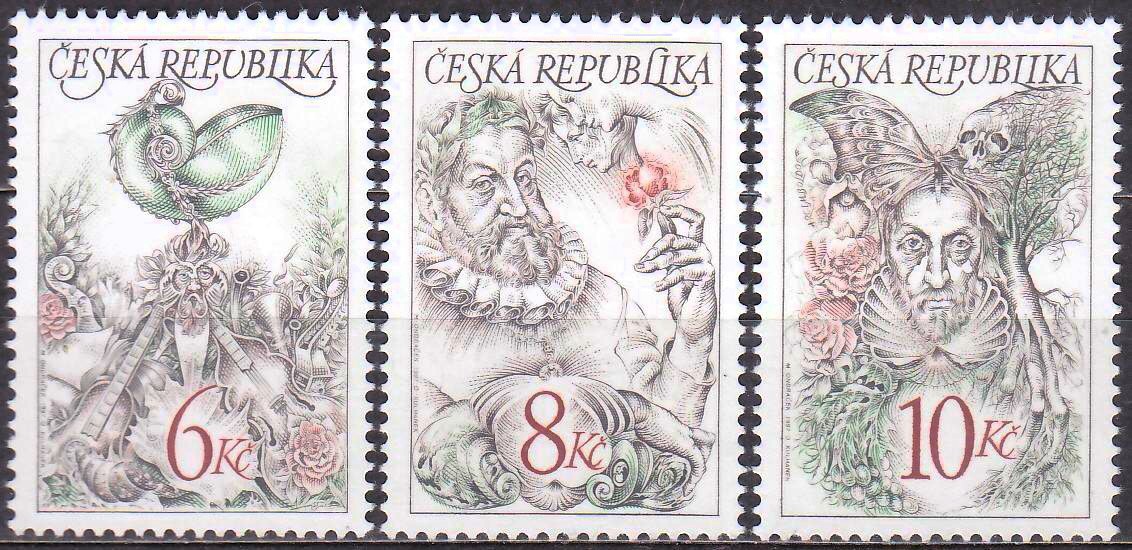
Like banknotes, stamps can also be regarded as small works of art and it is a shame that they are now increasingly disappearing and if they possibly remain, they have been replaced by boring multi-colour prints, far removed from the exquisitely engraved masterpieces they once were, produced by artists such as Kulhánek, and not least the more prominent Swede Czesław Słania (1921 – 2005). Słania came to Sweden from Poland in 1956 and up until his death he created more than 1000 postage stamps. At the time of his death, the Danish Post Office even issued a postage stamp in his honour, which was adorned with one of Słania's self-portraits.
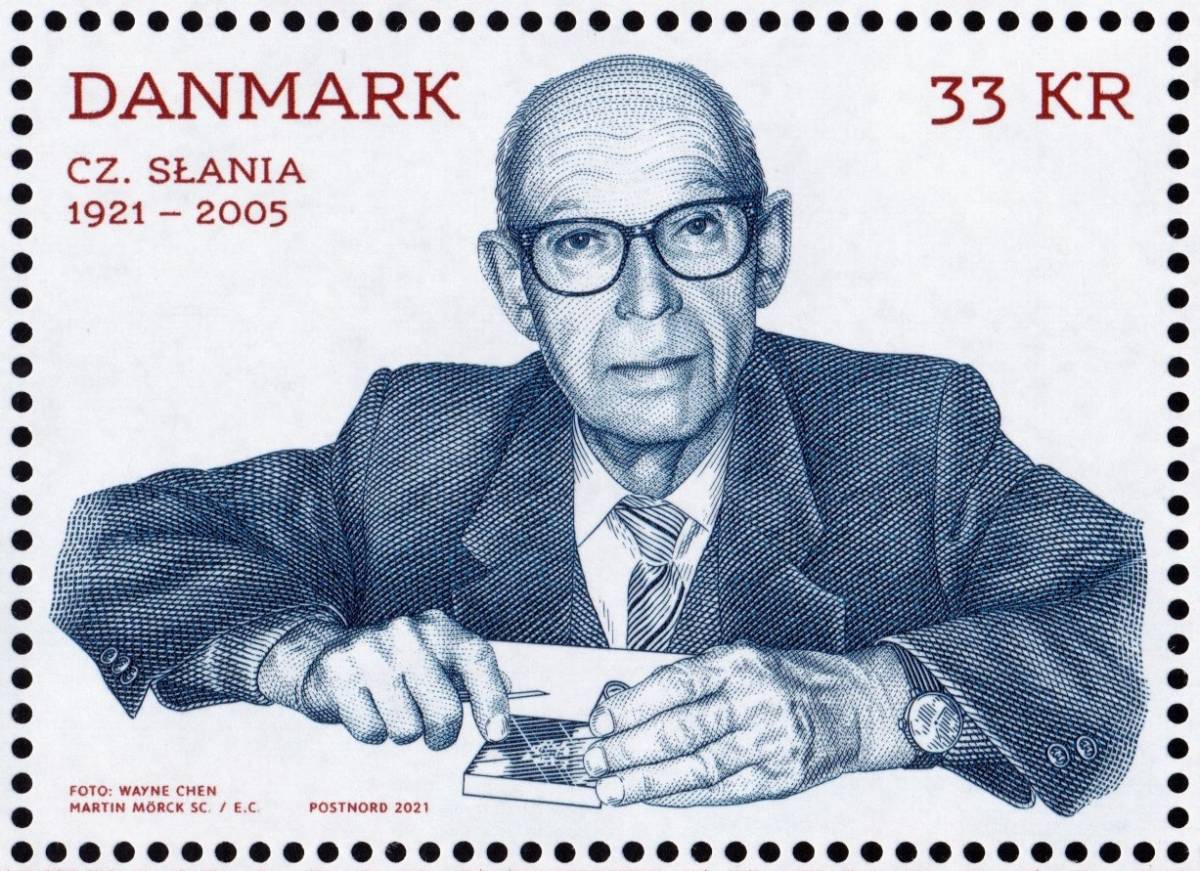
Already as a young student in Lublin, Słania had forged German banknotes and official documents for the Polish resistance movement, and when he came to Sweden he was employed by the Swedish Post Office. In addition to the stamps he created for the Post Office, he also engraved postage stamps for no less than thirty other countries. Like Kulhánek, Słania also engraved banknotes, for example Lithuanian banknotes with Lithuanian luminaries like Beniuševičiūtė-Žymantienė (1845–1921), who under the pseudonym Žemaitė wrote a number of novels and short stories mainly set among the Lithuanian peasantry.
Žemaitė is reminiscent of the Swedish author and national hero Selma Lagerlöf and like her she was the daughter of landowners who had lost their properties and wealth. Both later became exalted and respected personalities in their respective homelands.
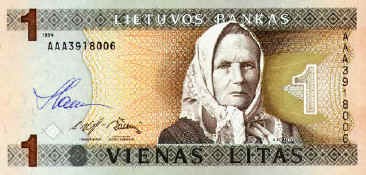
Selma Lagerlöf was portrayed on a Swedish banknote, though not engraved by Słania but by two young women – Toni Hanzon Kurrasch and Agnes Miski Török.
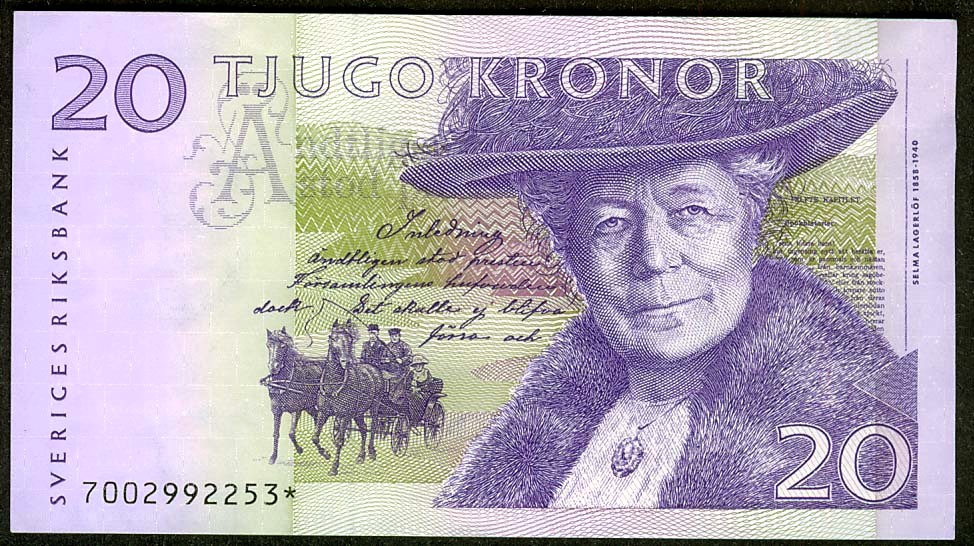
The new Swedish banknotes introduced in 2016 were provided with images by the graphic artist Göran Östlund and like the old ones also portrayed Swedish cultural personalities, but in my opinion they are not as aesthetically successful as previous banknotes. Take as an example the banknote with the once famous famous Swedish movie star Greta Garbo, I think it presents a messier impression, the portrait resemblance is poorer and the engraving is not so detailed.

Compare this banknote with Słania's masterful postage stamp of Greta Garbo as she appeared in the movie The Saga of Gösta Berling from 1924.
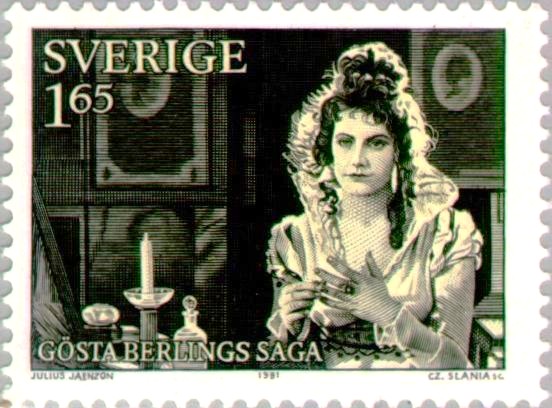
I am not a stamp collector, but I do have some Słania stamps which I received from my father and it is certainly a rewarding experience to examine them in detail. For example, Słania’s skilful rendition of the varied summer greenery around a steamboat on the Göta Canal.

Słania's craftsmanship is also evident in his depiction of a Faroese sheep.
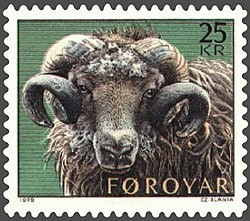
I also have a series of stamps in memory of Swedish explorers. Skilfully portrayed with exciting backgrounds, among them the famous botanist Linnaeus’ disciples such as Carl Peter Thunberg, who botanized in Japan, Indonesia and South Africa, and Anders Sparrman, who sailed with James Cook
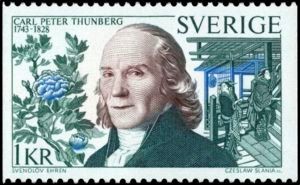
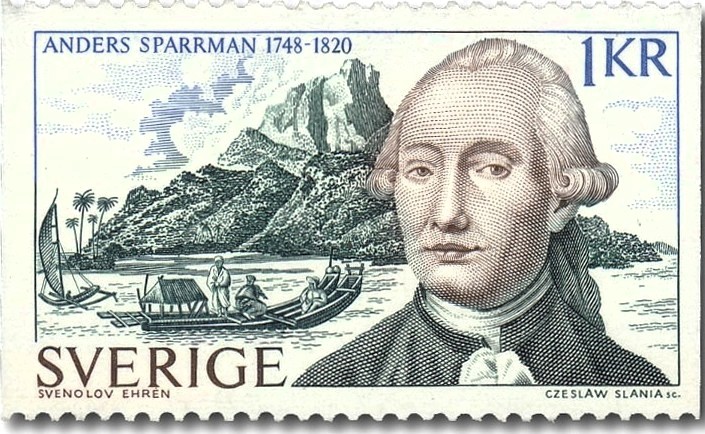
and later scientifically minded adventurers such as Adolf Erik Nordenskjöld who made his way through the Northeast Passage and Sven Hedin who explored Central Asia.
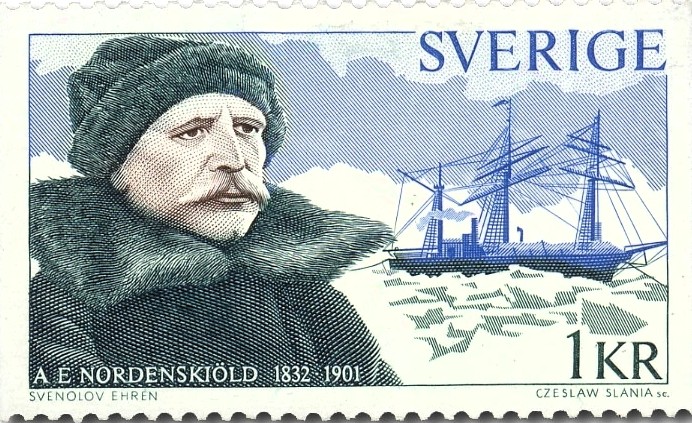
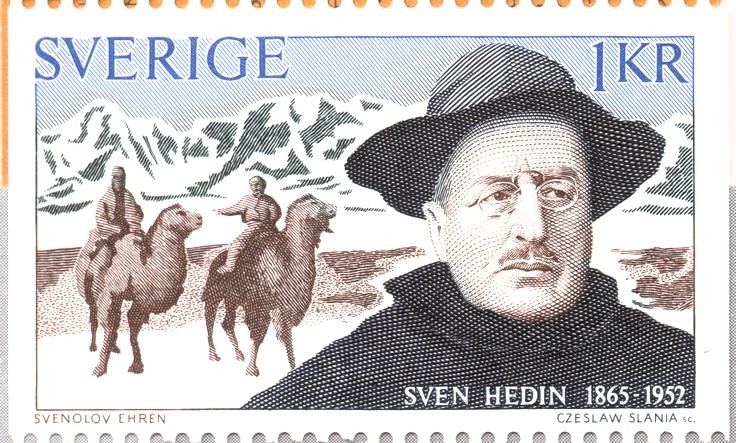
I also have a banknote from Brazil that turned out to be created by Czesław Słania and as usual I found out who Ruy Barbosa de Oliveira (1849 – 1923) could have been be.
It turned out that he had been a liberal-minded writer, politician and reformer. Barbosa had been influential in abolishing Brazilian slavery, something that did not happen until 1888. When the so-called Golden Law came into force, Barbosa made sure that all documentation of slavery and its Brazilian history was effectively destroyed under the pretext that he wanted to erase this stain from Brazil's history. In fact, it seems that Barbosa wanted to protect former, brutal slave owners from the consequences of their behaviour.
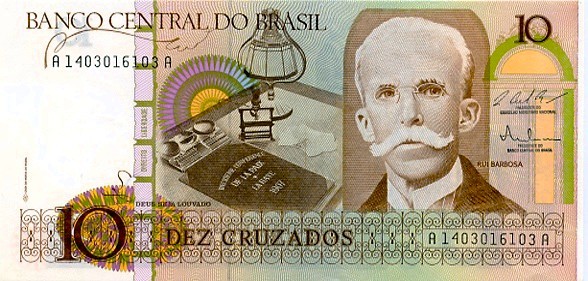
Considering how postage stamps and banknotes created by skilled graphic artists are disappearing, it is tragic to realize that yet another example of artisanal art are steadily disappearing from our everyday lives.
Kulhánek's graphic art was far from limited to stamps and banknotes. He was particularly interested in depicting the human body in different positions and ages. Kulhánek's naked people huddled together made me associate with the naked monster in del Toro's visually powerful Frankenstein, which I watched recently.
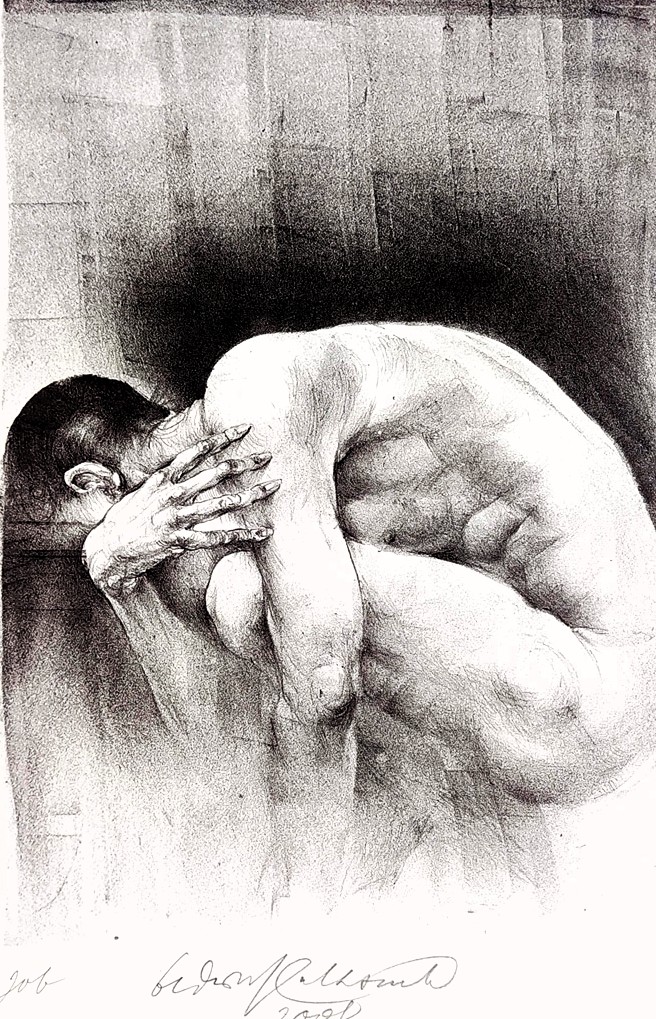

A fascinating idea was how Kulhánek in a series of etchings compiled portraits of people as babies and how they looked after they had aged.
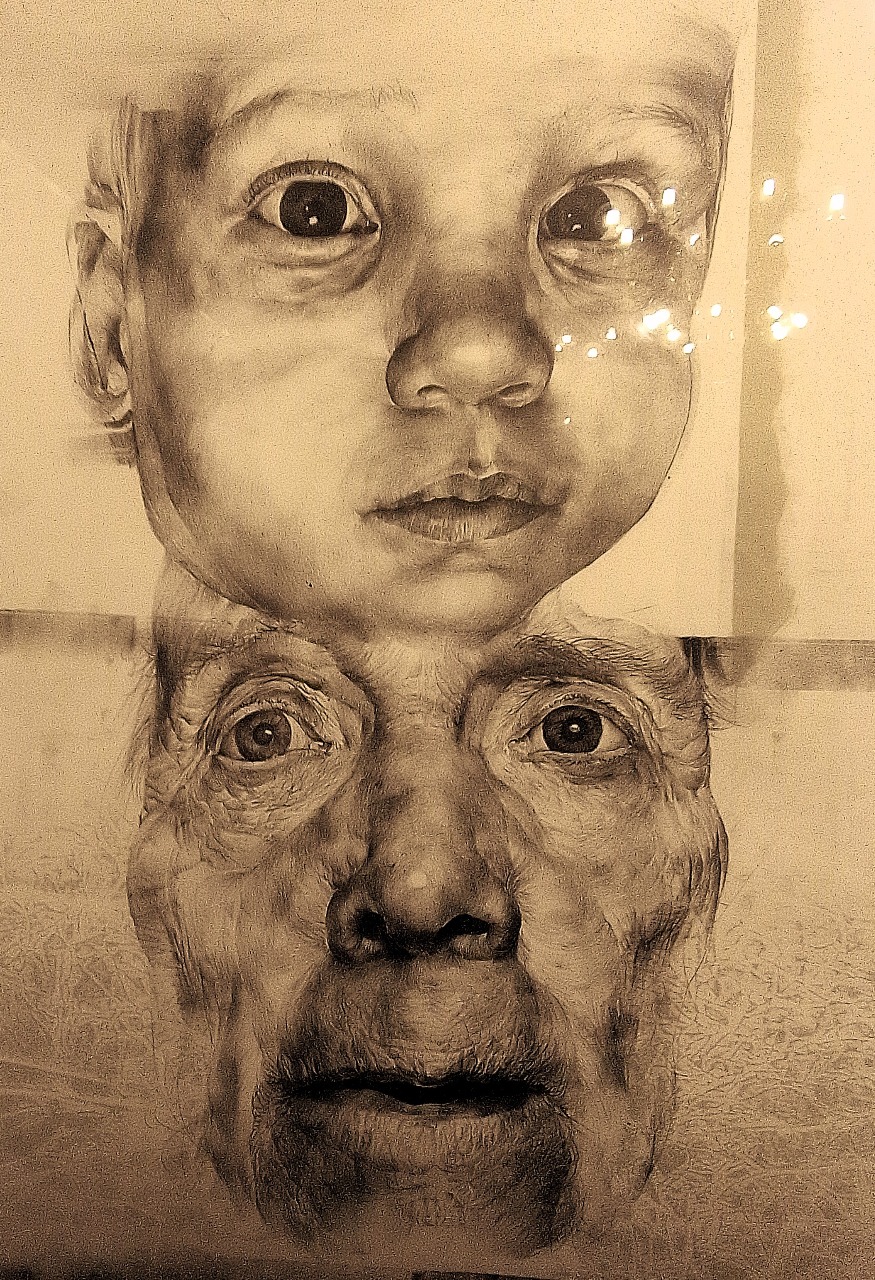
Another series of falling naked human bodies brought to mind Ruben's visions of crowds of naked people plunging into Hell during the Last Judgment.
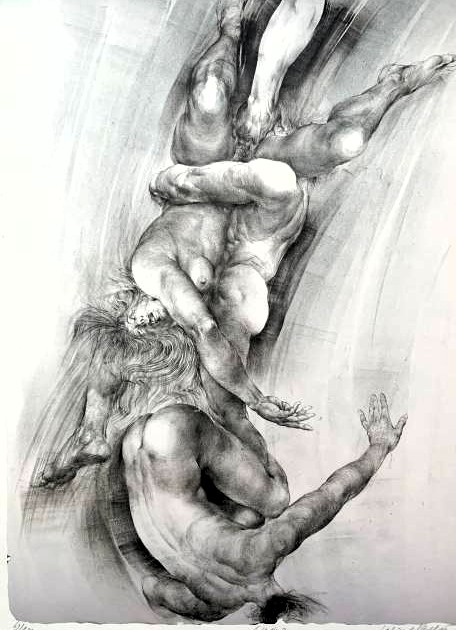
.jpg)
Kulhánek's assumed allusions to Baroque artists such as Rubens are reminiscent of the origins of the art of engraving. Several of the earliest etchings and their successors largely consisted of reproductions of paintings by well-known artists who thus had their works spread across Europe. For example, an engraver like Marcantonio Raimondi (1482–1534) worked closely with his good friend Raphael and transferred several of his works into prints, sold with a shared profit.
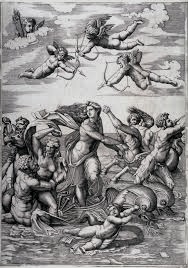
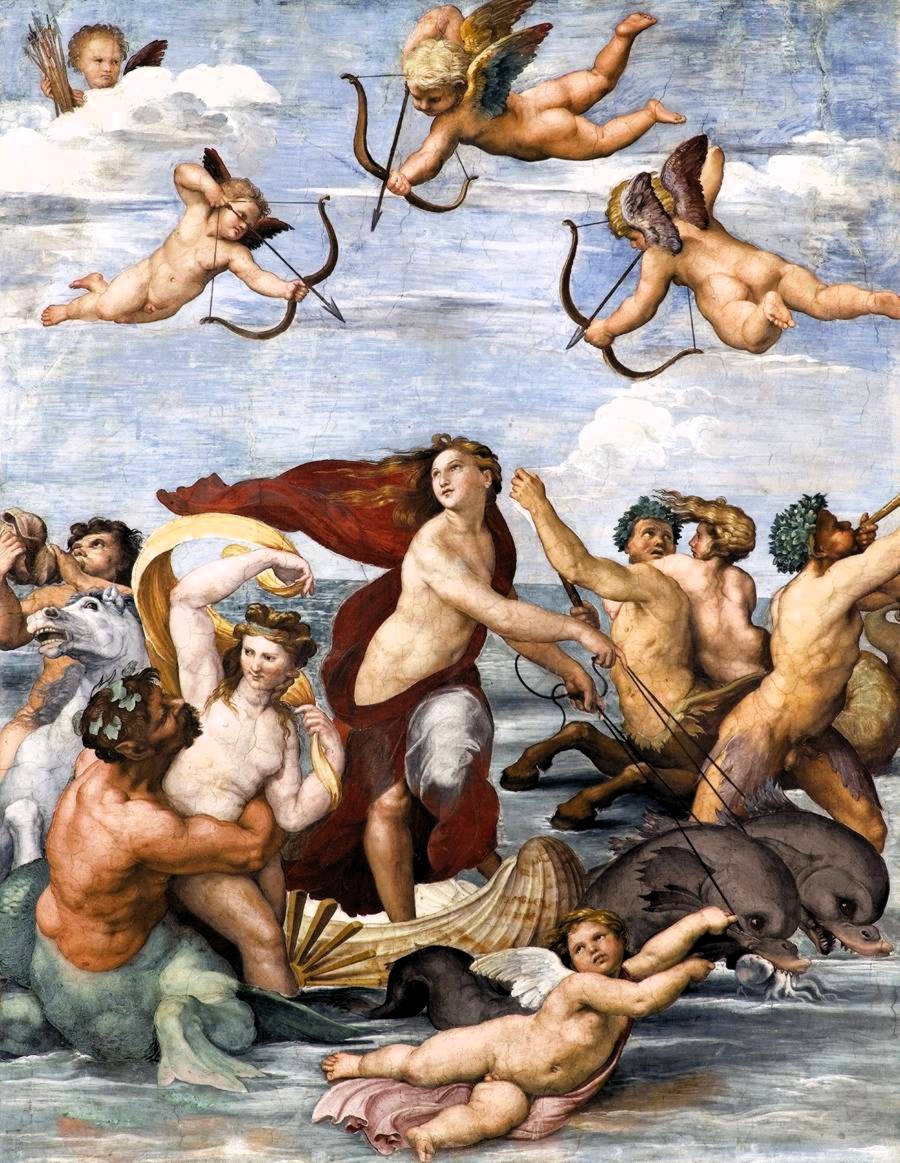
Some of Raimondi's etchings were made as being exclusively based on Raphael’s sketches. An example of this is probably Raimondi's The Judgement of Paris.
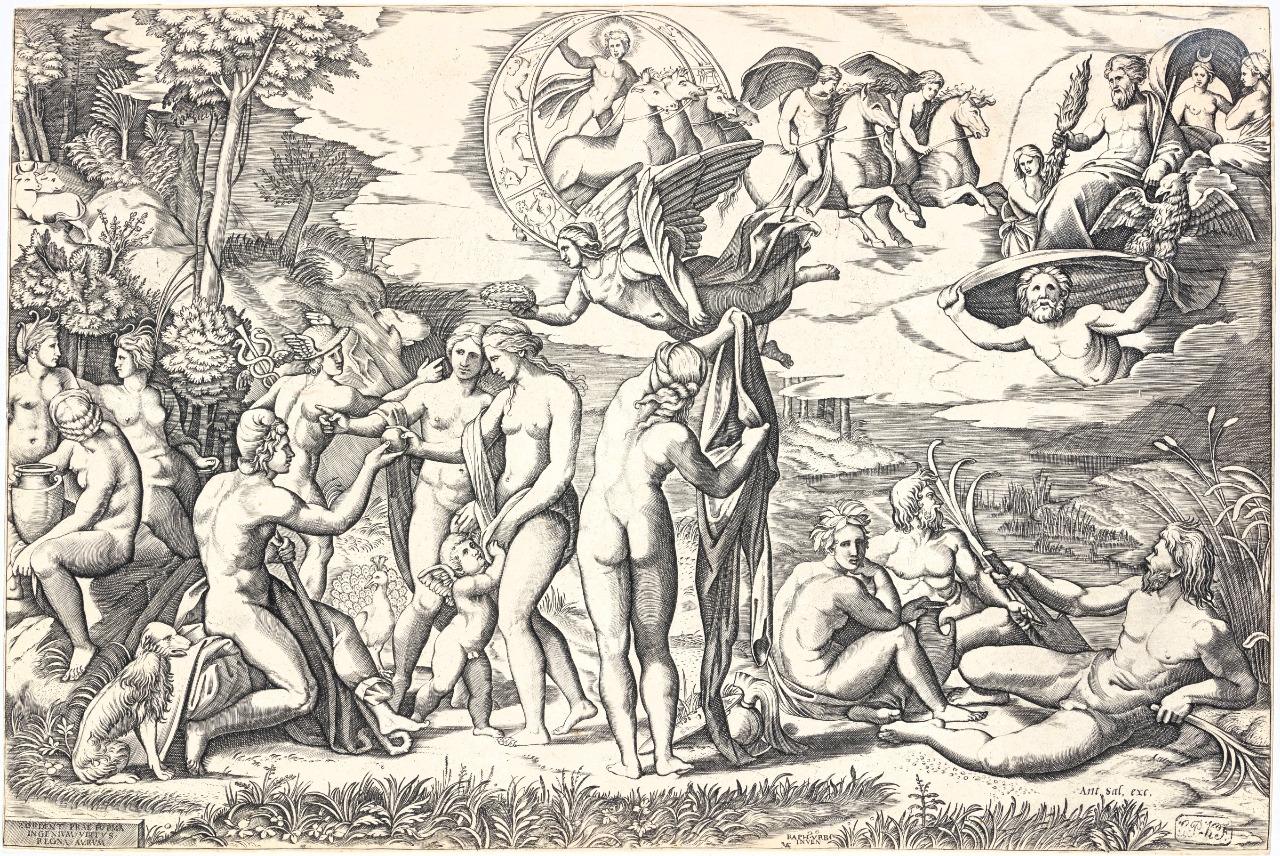
This etching has become particularly famous since the group at the bottom right a couple of centuries later became one of the models for Manet's scandalous painting Le Déjeuner sur l'herbe, Lunchon on the Grass, from 1862.
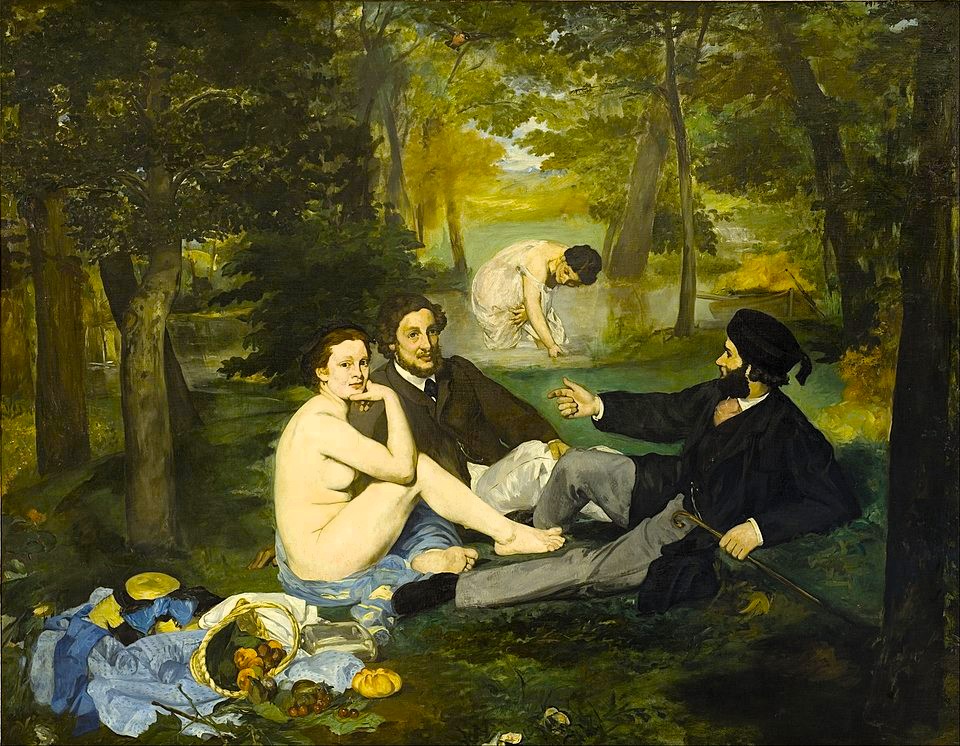
It was not only Raphael's paintings that Raimondi transferred to etchings, several artists were annoyed by the fact that he used their works without their consent. Albrecht Dürer, who for some time lived in Venice at the same time as Raimondi, the latter's birthplace, and openly confronted him for forging his graphic work and paintings, and even using his specific monogram. Raimondi made more than seventy copies of Dürer's woodcuts and etchings. As below, where he copied Dürer's woodcut with The Annunciation as an etching. Raimondi's work is on the left.
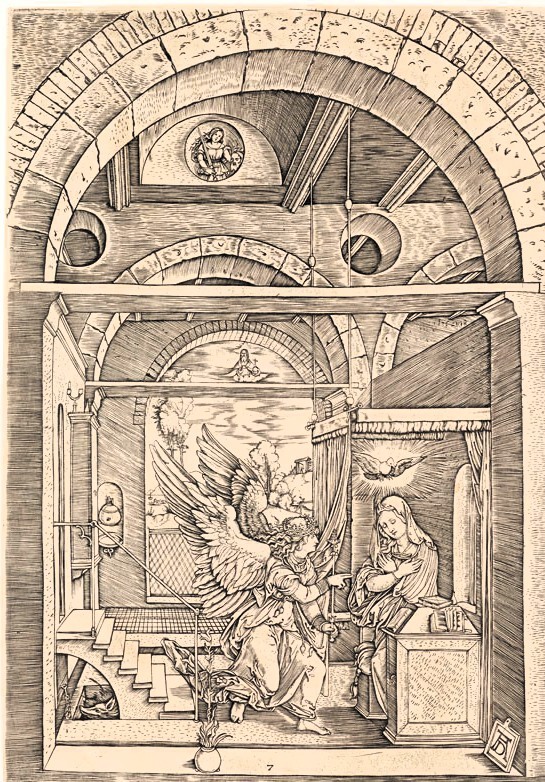
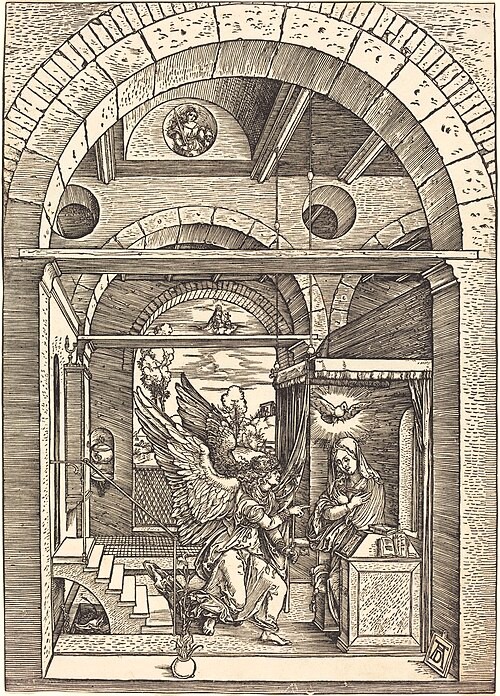
Dürer, who was just as skilled and innovative as graphic artist as a painter, was violently upset by the discovery, especially since Raimondi also was a particularly skilled graphic artist and for both of them the sale of their graphic works was a significant source of income (there are no paintings preserved by Raimondi).
After violent confrontations, Raimondi claimed that he was fully entitled to copy Dürer's paintings and prints. Accordingly, Dürer turned to the Venice government, the Signoria, which forbade Raimondi to use Dürer's monogram. However, given that the Venetian printing industry was extensive and profitable, the Signoria saw itself unable to prohibit anyone from copying the artistic works of others and selling them on the open market. Moreover, the Signoria's prohibition on the use of Dürer's monograms applied only to Venetian territories and Raimondi was therefore able to sell his Dürer copies provided with monograms outside of Venetian jurisdiction.
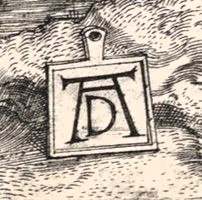
It is easy to understand Dürer's irritation, but also the Signoria's ruling. Before the development of photography it was difficult to take part of the works of significant artists, especially their paintings, and it was through printmaking that such knowledge spread to other artists and the general public. Raimondi"s frequent copying of Dürer’s works indicates how popular the German artist was already in his time (by the way, it was easier for Raimondi to copy the works of another graphic artist than his paintings, which were only available in the private residences of patrons, or in distant churches and palaces).
Certainly, Dürer's works are worthy of all the admiration they have been provided with, boundlessly skilfully made as they are, with an inexhaustible wealth of imagination, keen observation and a multitude of exquisite details. Take his Adam and Eve in Paradise, let your gaze move around within it and maybe let it rest in the upper right corner and there admire the image of a mountain goat looking down from a mountainous hill.
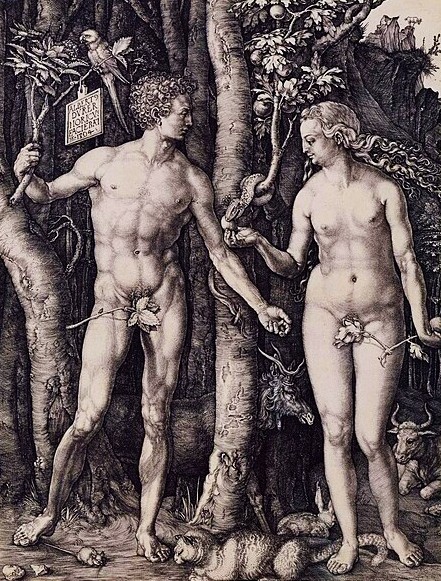

In his paintings as well as in his graphic prints, Dürer often provides us with detailed impressions of towns and villages adorning their backgrounds. Places he probably had seen and sketched during his frequent travels.
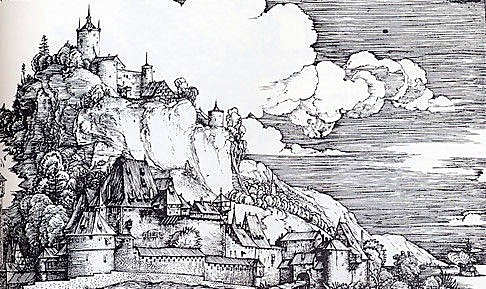
Not only was Raimondi a copyist of the works of other masters (there is no doubt that he was a great admirer of and inspired by Dürer's revolutionary art), he also created several remarkable images on his own. For example, Raphael's dream, which, despite its later and misleading title, was made before Raimondi got to know Raphael. A strange and truly nightmarish vision. A nocturnal scene with two brightly lit (moonlight?) naked, sleeping women lying on a riverbank, while small, phallic monsters crawl out of the water. In the background, people are fleeing from a burning castle and we glimpse something that appears to be reminiscent of a nocturnal Rome.
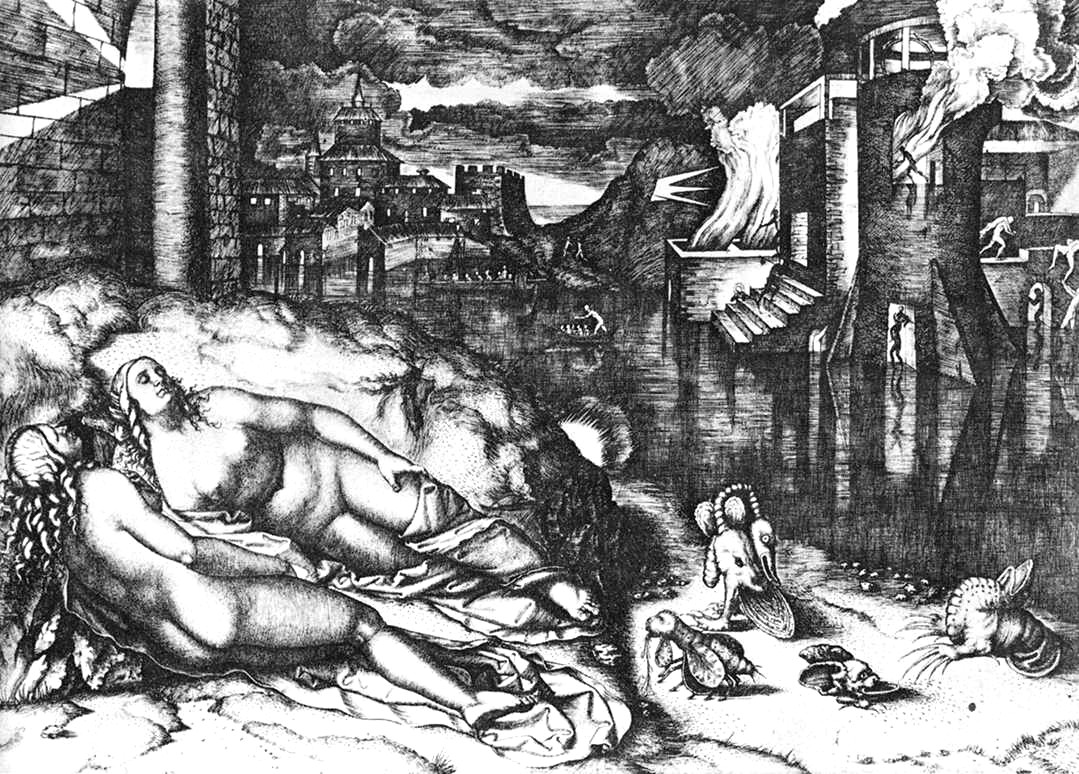
Nightmarish scenes seem to have been a common theme among several engravers. Here we find Piranesi's labyrinthinely and terrifyingly gloomy prison interiors, which, like in several of Borges' short stories, seem to encompass the entire world.
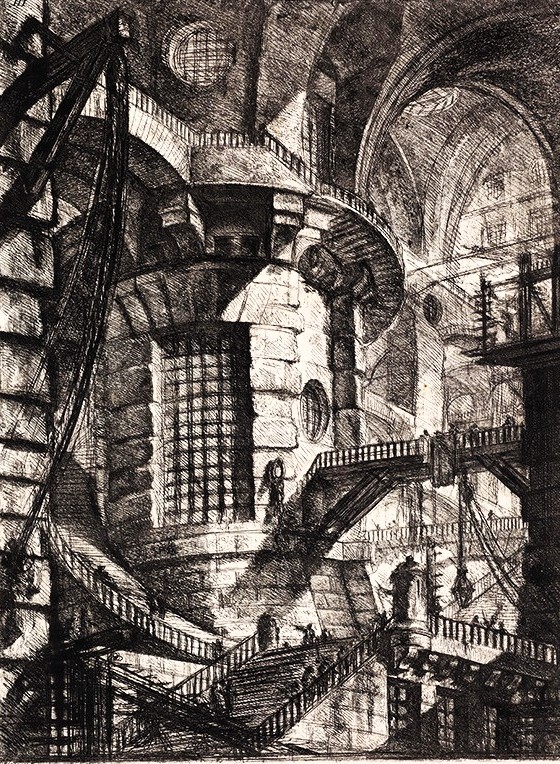
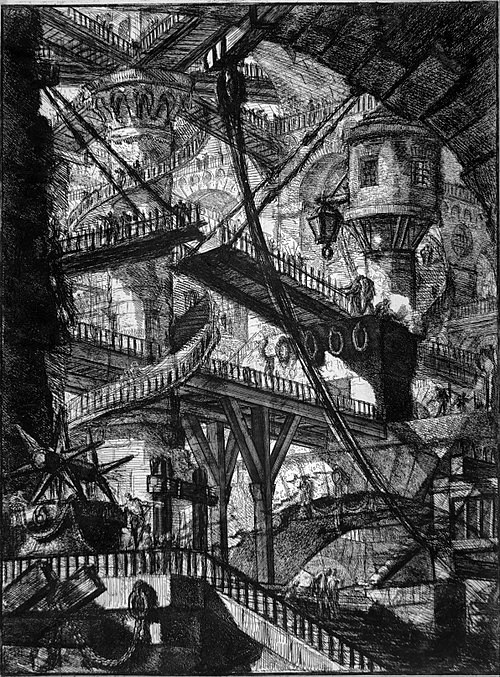
The manneristically elegant Jacques Callot, with his experiences of the horrors of the Thirty Years' War
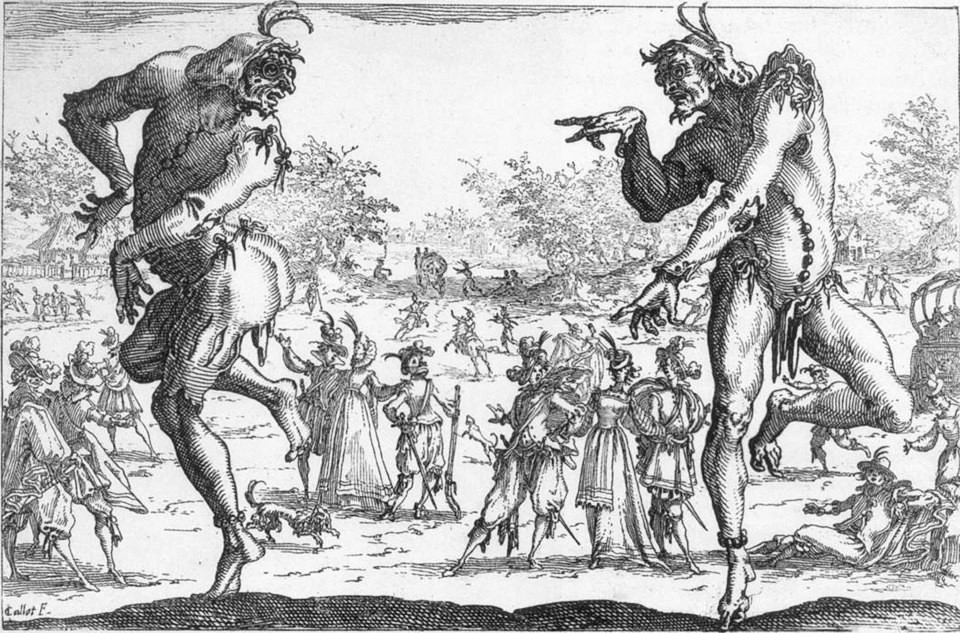
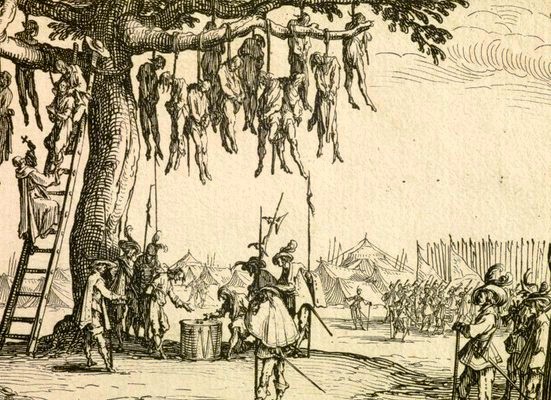
might with a sure hand lead us into the depths of a thoroughly depicted hell.
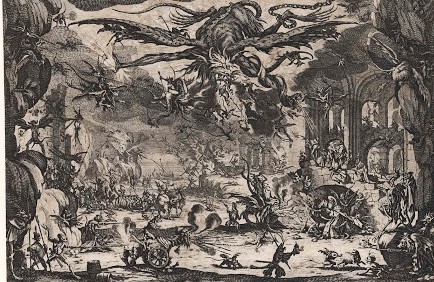
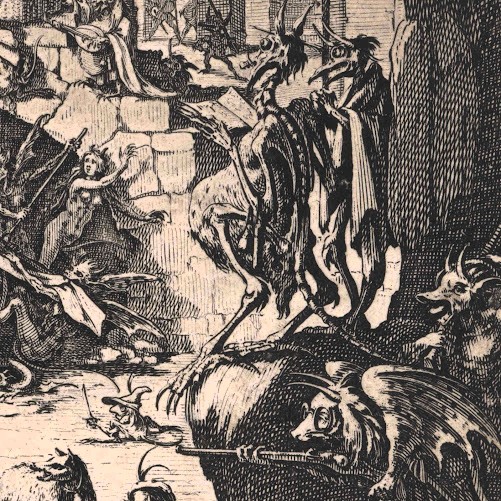
The equally war-experienced Goya, who with a sharp eye and great pathos depicted the Napolean troops' atrocities committed on his country's civilian population, could also take us into nightmarish worlds.
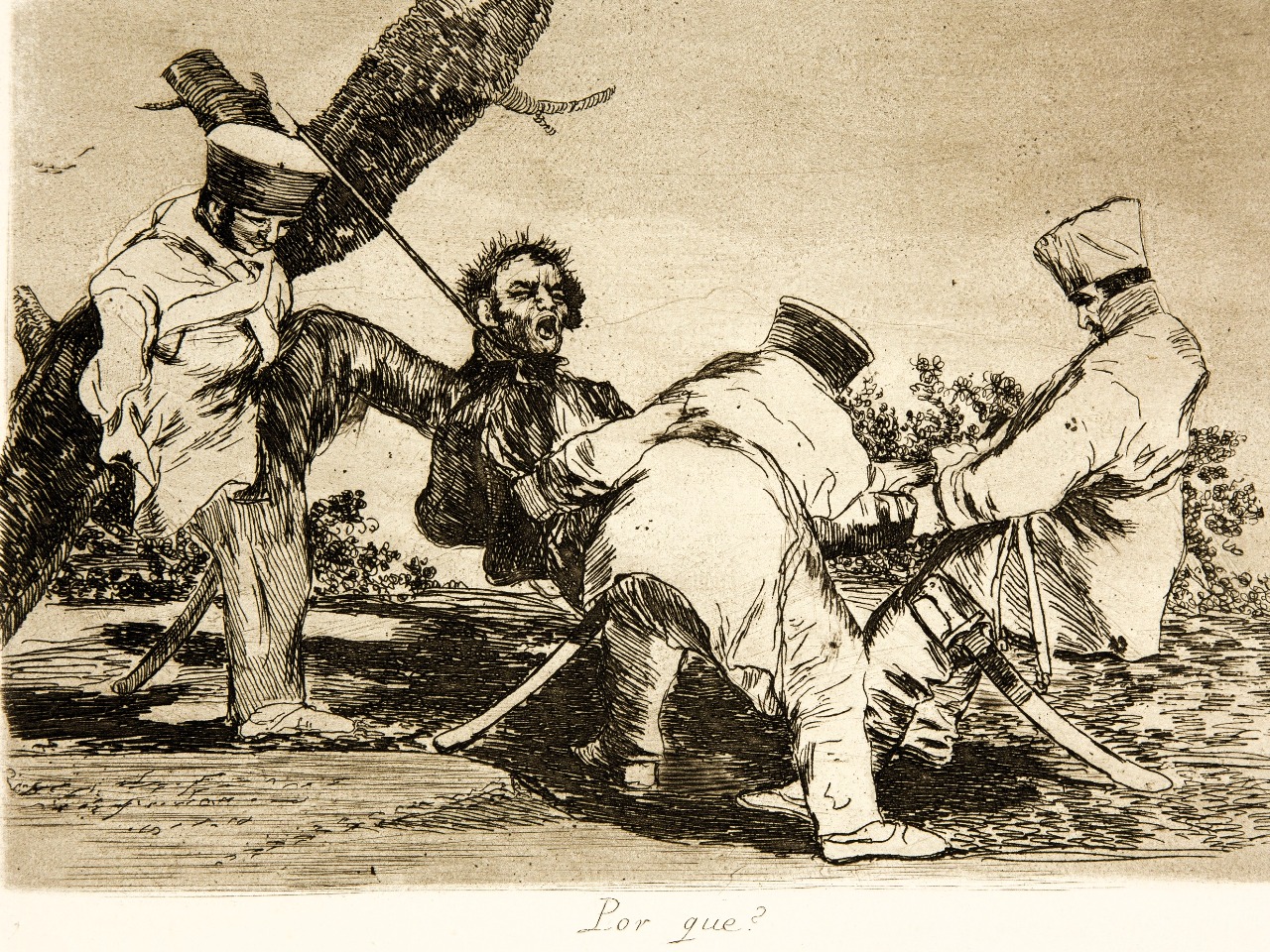
At least as detailed as Piranesi’s and Callot’s vissions are the French eccentric and graphic artist Rudolphe Bresdin’s (1822–1885) visits to a personal and strange dream world. The question is whether he could ever adapt to the world around him. At an early age, Bresdin left his messy parental home and led a bohemian existence in various parts of France, before settling in Paris, where he socialized with cultural figures such as Charles Baudelaire and Victor Hugo.
Bresdin married and had six children with his wife, whom he took with him to Canada in an attempt to make a living as a farmer. The business failed, and when Bresdin became completely destitute, Hugo and his French bohemian friends helped him and his family to move back to France, where Bresdin proved equally unable to support himself and his closest of kin. He was separated from them and finally died poor and alone in an attic in Sèvres.
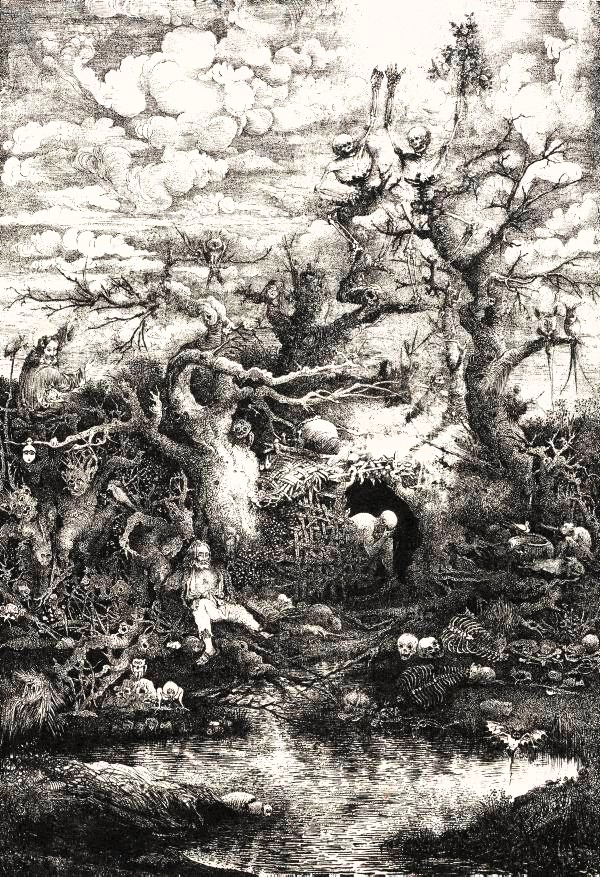
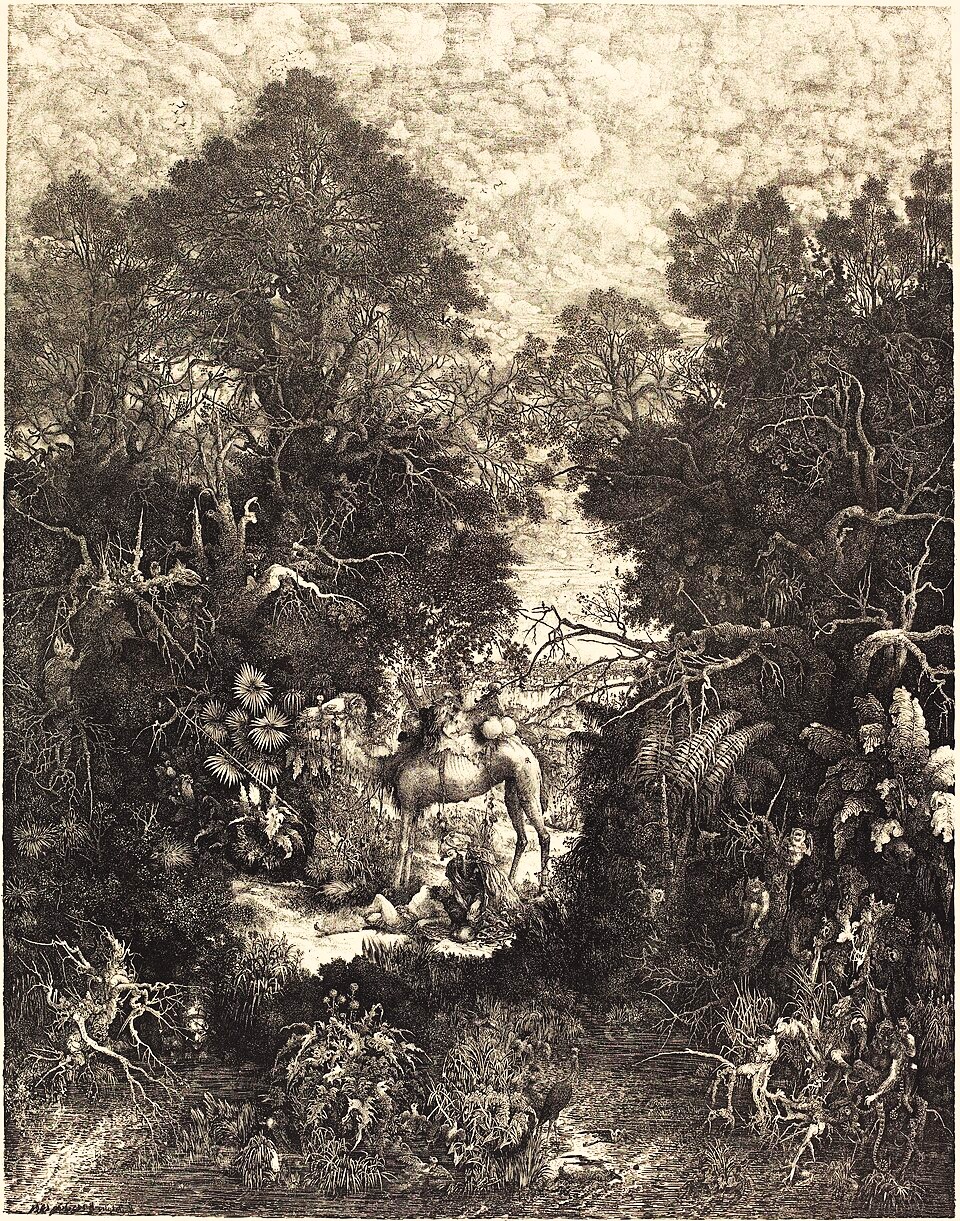
The in many respects unsurpassed and almost incomprehensibly productive Gustave Doré (1832 – 1883), was a contemporary of Bresdin. Like him Doré was a master at visualizing parallel, mythical worlds. In general, Doré drew his inspiration from literary masterpieces such as The Bible, The Divine Comedy, Gargantua, Paradise Lost, Orlando Furioso, Don Quixote, The Rime of the Ancient Mariner, and many, many more.
Already early in his career, Doré achieved great international success and although he was a skilled graphic artist, he soon came to work only as a draughtsman and designer. At the height of his career, Doré had more than 40 block cutters working for him, transferring his drawings to woodcut blocks, thus producing more than 10,000 illustrations which all bore Doré's name, most of them of the highest quality.
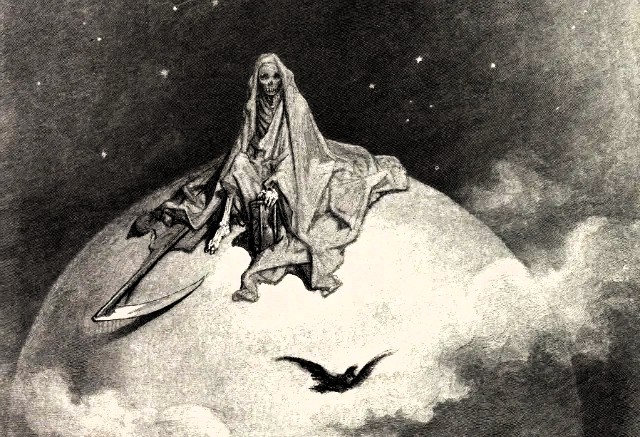
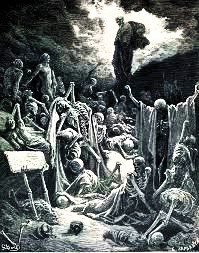
Doré also managed to bring contemporary human misery to life in a manner that, in all its realism nevertheless spiced up by his very own visionary, mystical and rather eerie manner of depicting the world. A masterpiece in this genre is his London. A pilgrimage where every image leaves an imperishable impression.
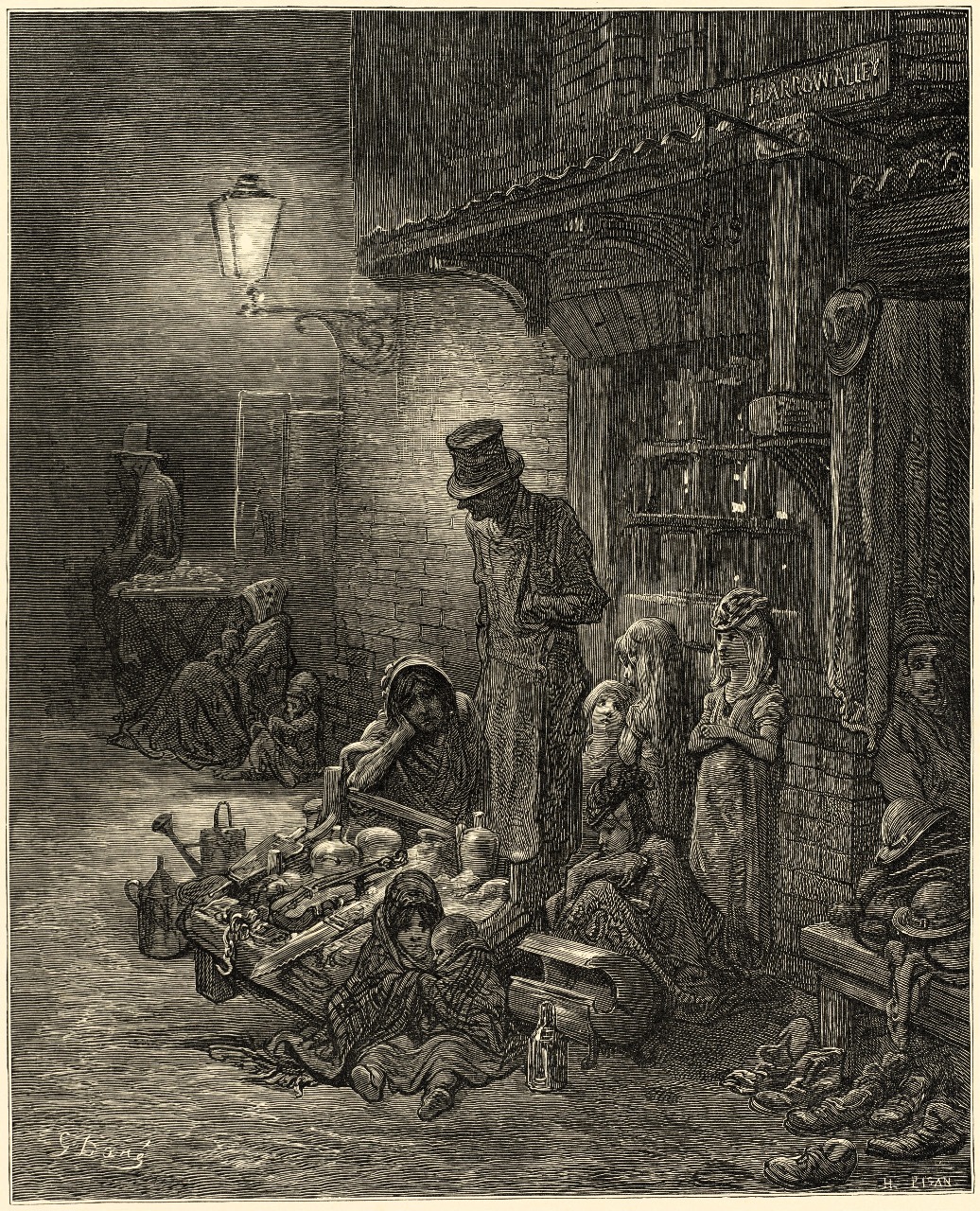
The somewhat earlier Jean Grandville (1803–1847) was also popular, with its parallel worlds populated by humanized things and animals.
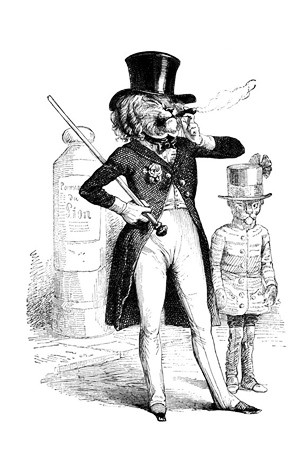
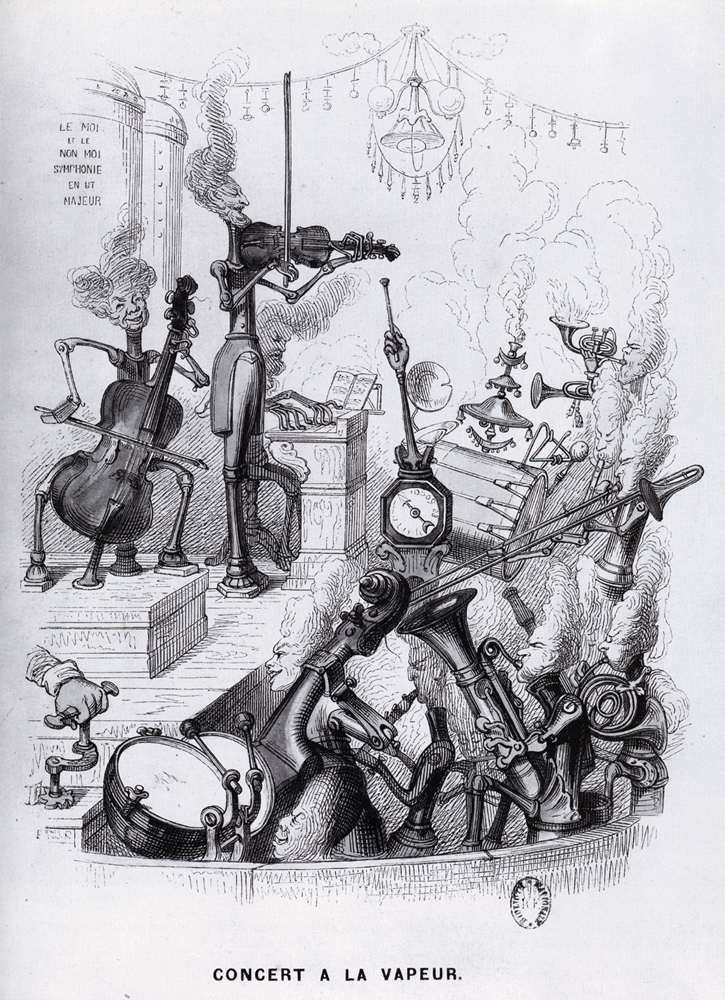
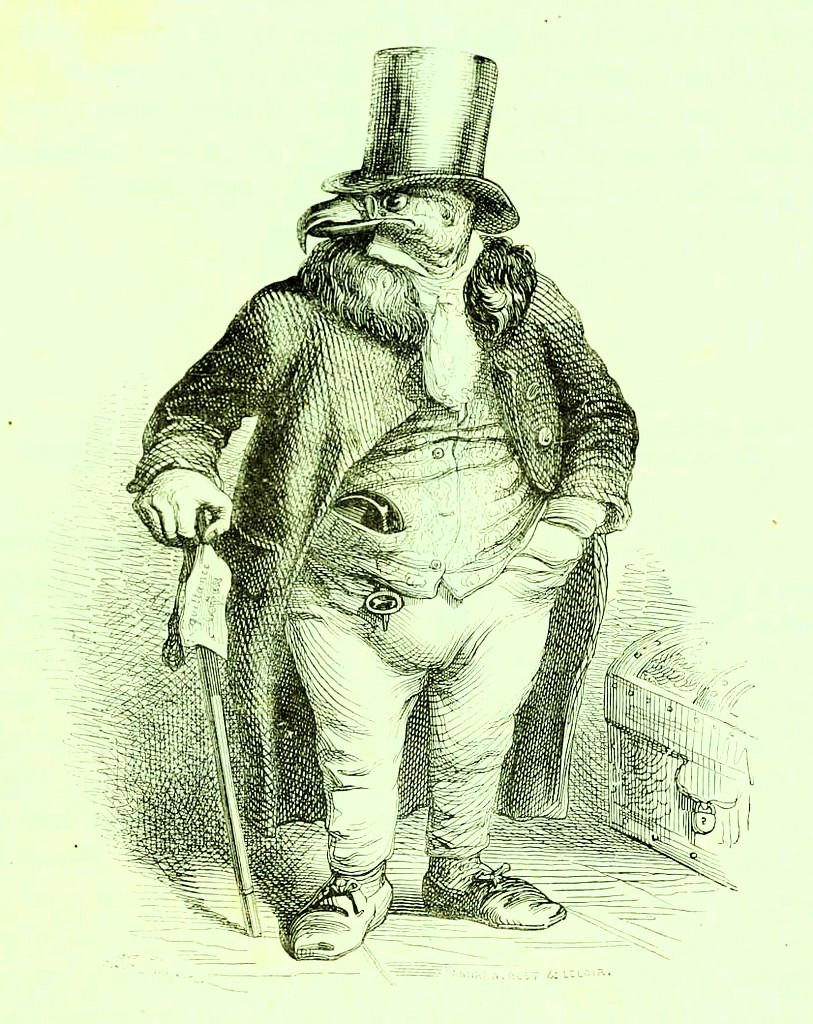
Grandville's contributions to fantasy and engravings have lived on not only in countless cartoons and films, but also in surrealist art for example how it was expressed in Max Ernst’s evocative and sometimes eerie collages collected in his book Une Semaine de bonté, A Friendly Week.
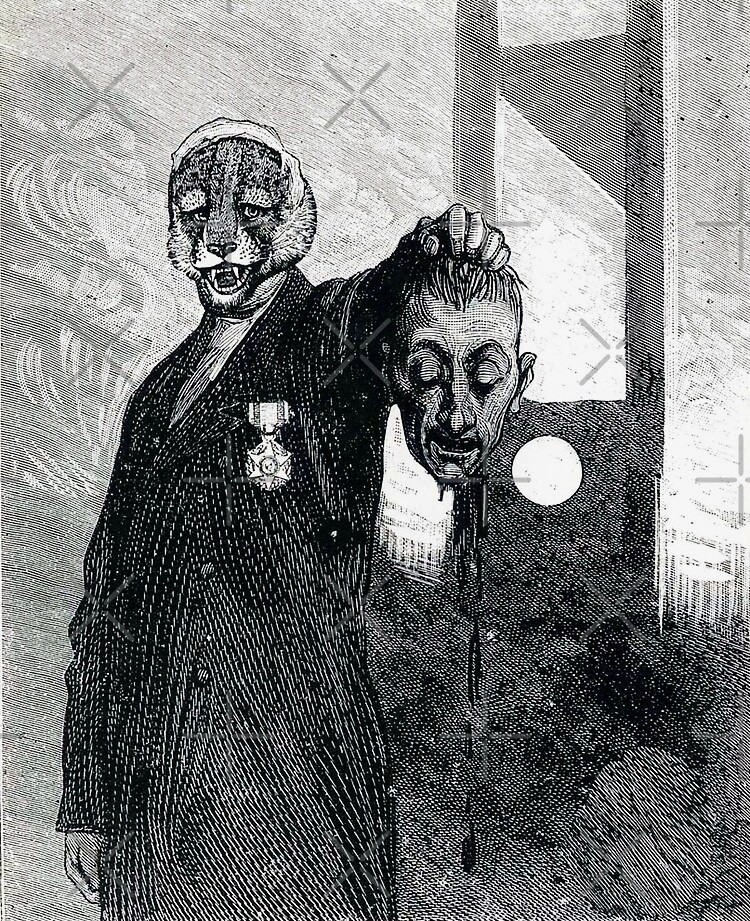
Before that, however, several graphic artists continued to enter into their dream worlds, such as the Bresdin admirer Odilon Redon (1840–1916), who in paintings, as well as in his prints, moved almost exclusively in his own sometimes dark, but nevertheless delicate, parallel reality.
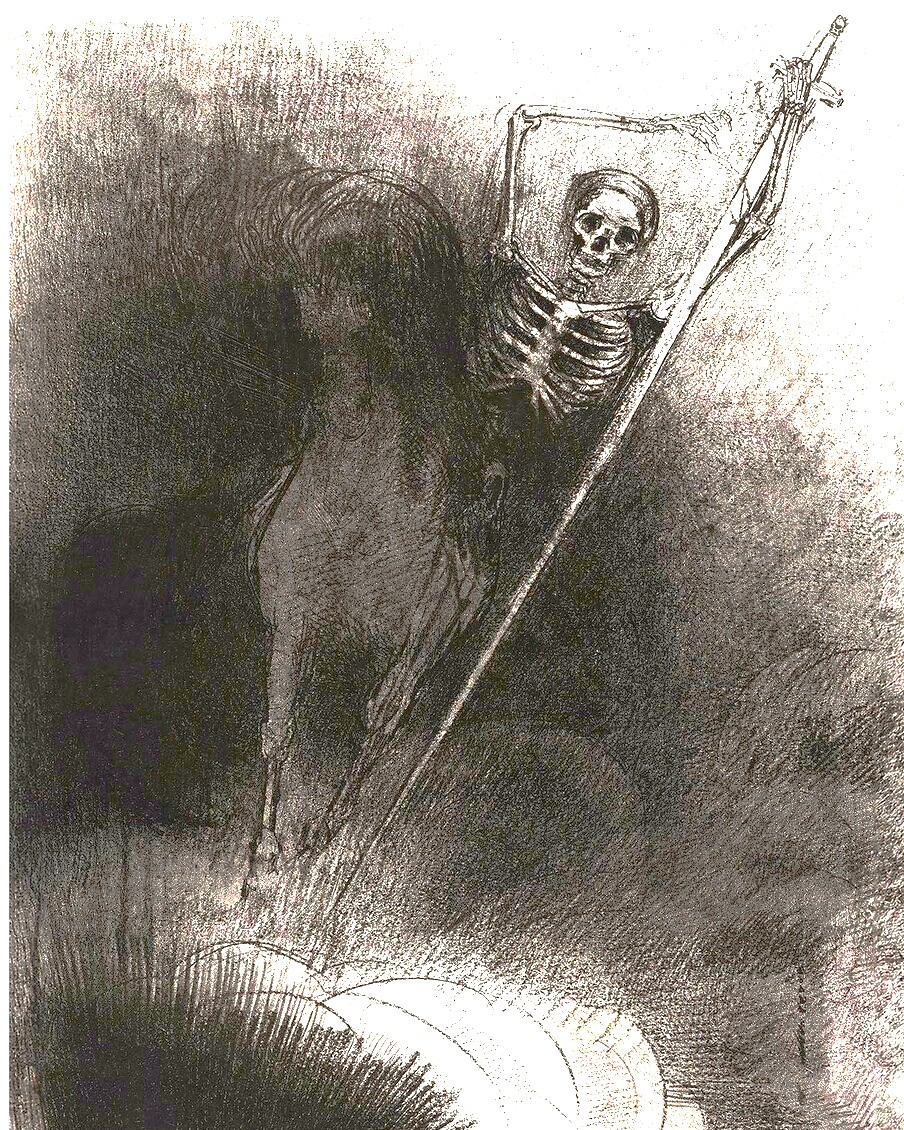
The German Max Klinger (1857–1920) was more hands-on in his dream worlds, as in his etching series A Glove, depicting how a man in a roller skating rink picked up a glove that a lady had dropped. He kept it and then became obsessed with one absurd dream after another, all of which revolved around this glove.
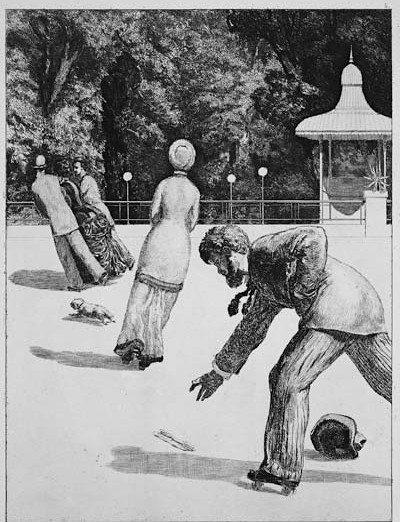
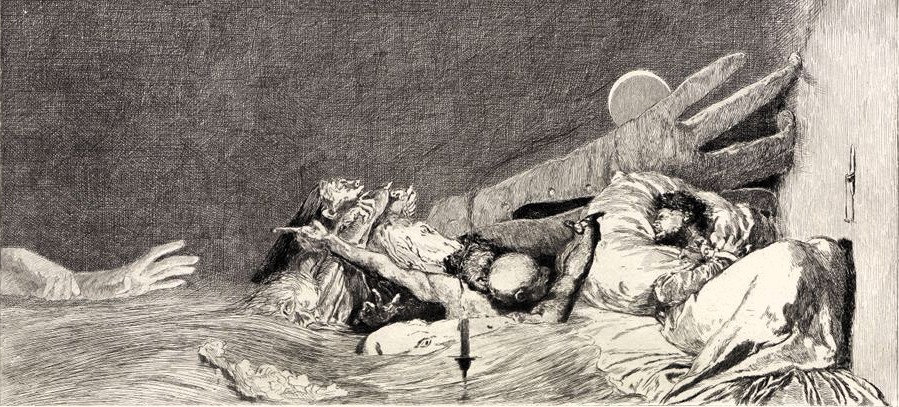
There are certainly erotic undertones in Klinger's dreams, but they do not cross the boundaries of decency, as is the case with the Belgian Félicien Rops (1833 – 1898), whose art often became provocative and sometimes excessively perverse. His Satan Sows His Seed, is however suggestively eerie in a way that lingers on in the mind.
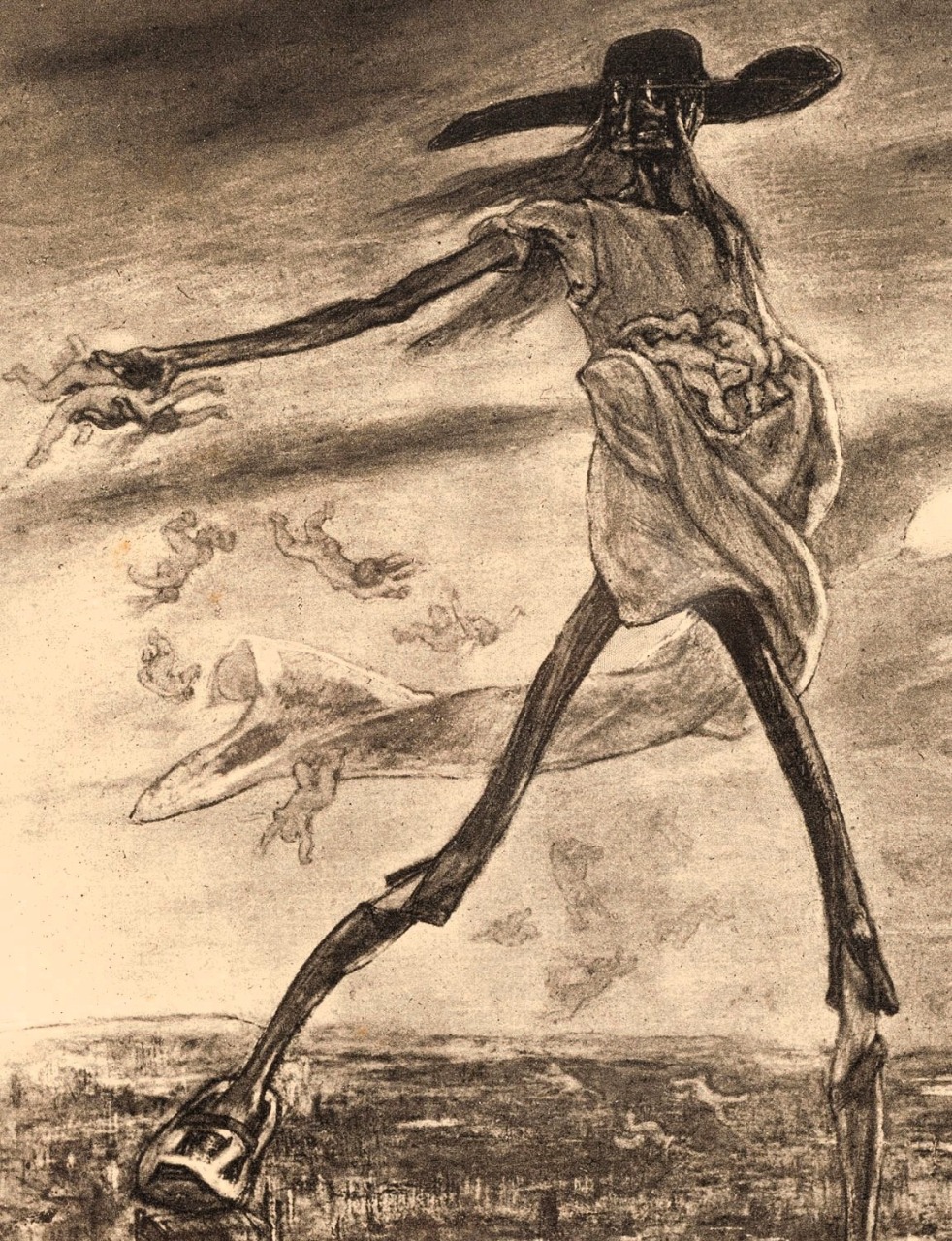
Further east, the Austrian Alfred Kubin (1877 – 1959) also tends to occasionally lose himself in perversity and misogyny witin a thoroughly dark world of his own, filled as it is with monsters and deformities, but Kupin's register is wider than that of Rops and Kubin also wrote a claustrophobic and original novel about a mad autocrat and the decay of an entire city. Die andere Seite, The Other Side.
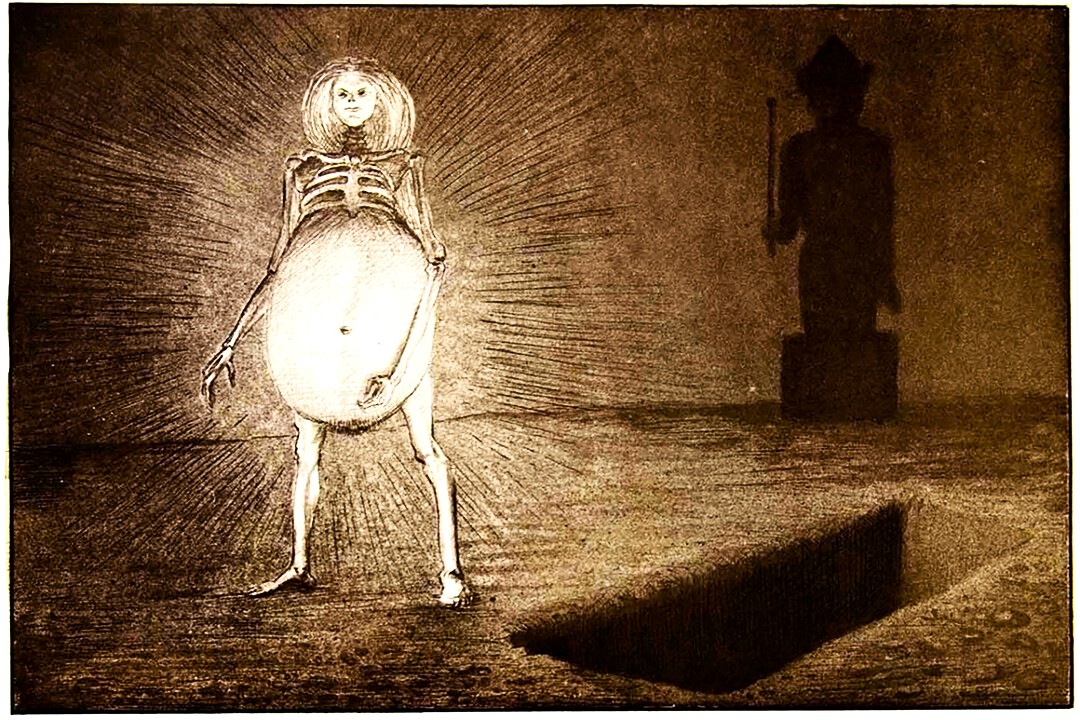
The tendency of graphic artists to depict nightmares continues into our time, and the road passes through Maurits Esher's (1898 – 1972) mathematically constructed parallel worlds, which he occasionally varied with nightmare images.
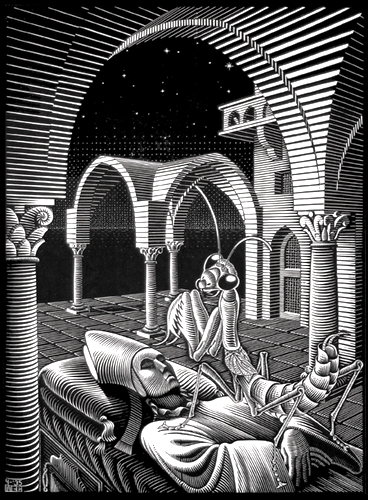
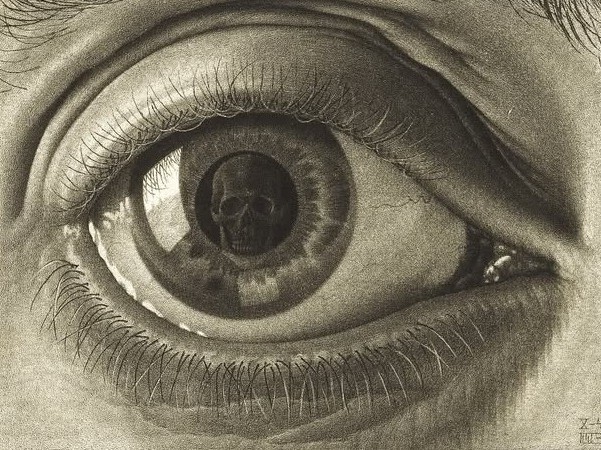
The Danish graphic artist Palle Nielsen (1920–2000) locates his graphic work within a dystopian world where people constantly are chased through often deserted urban landscapes.
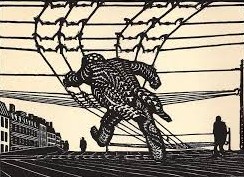
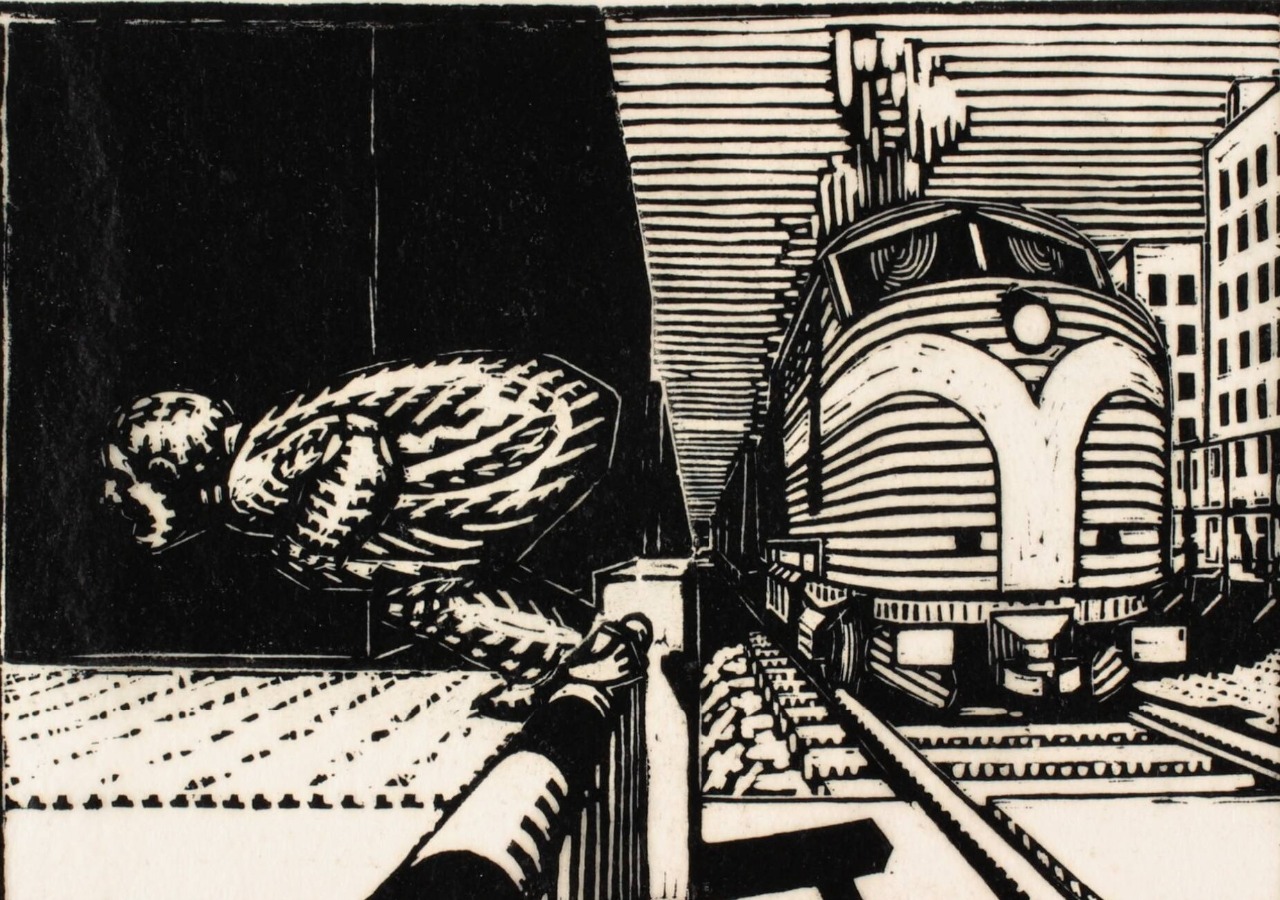
Nielsen’s woodcuts works evoke something akin to a silence in ultra-rapid, where houses collapse and explosions take place as if in a vacuum.
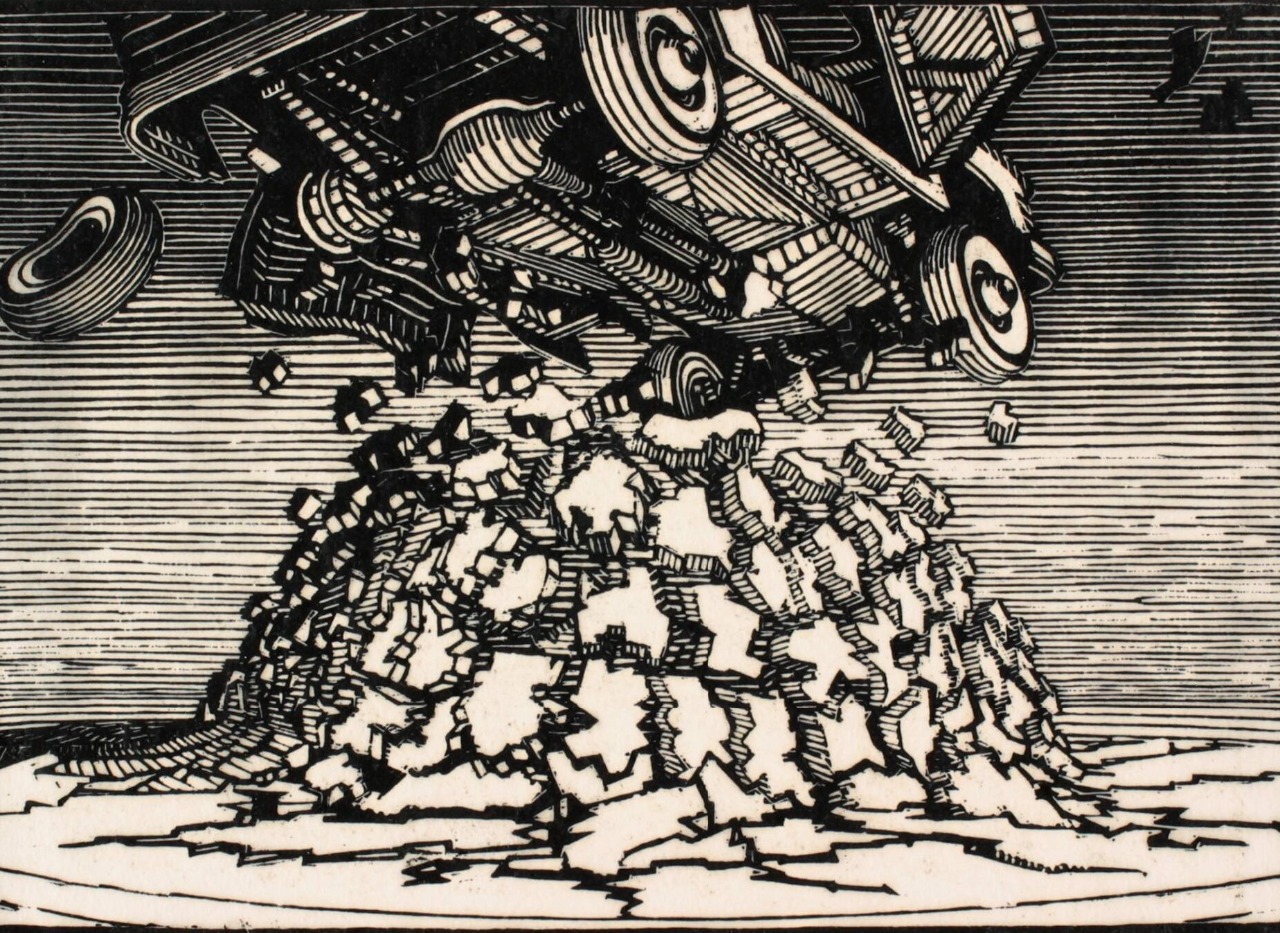
In the graphic art of the Swede Roy Friberg (1934 – 2016), it seems as if the catastrophe has already taken place, having petrified people and their homes, unifying them with a post-apocalyptic, rocky landscape.
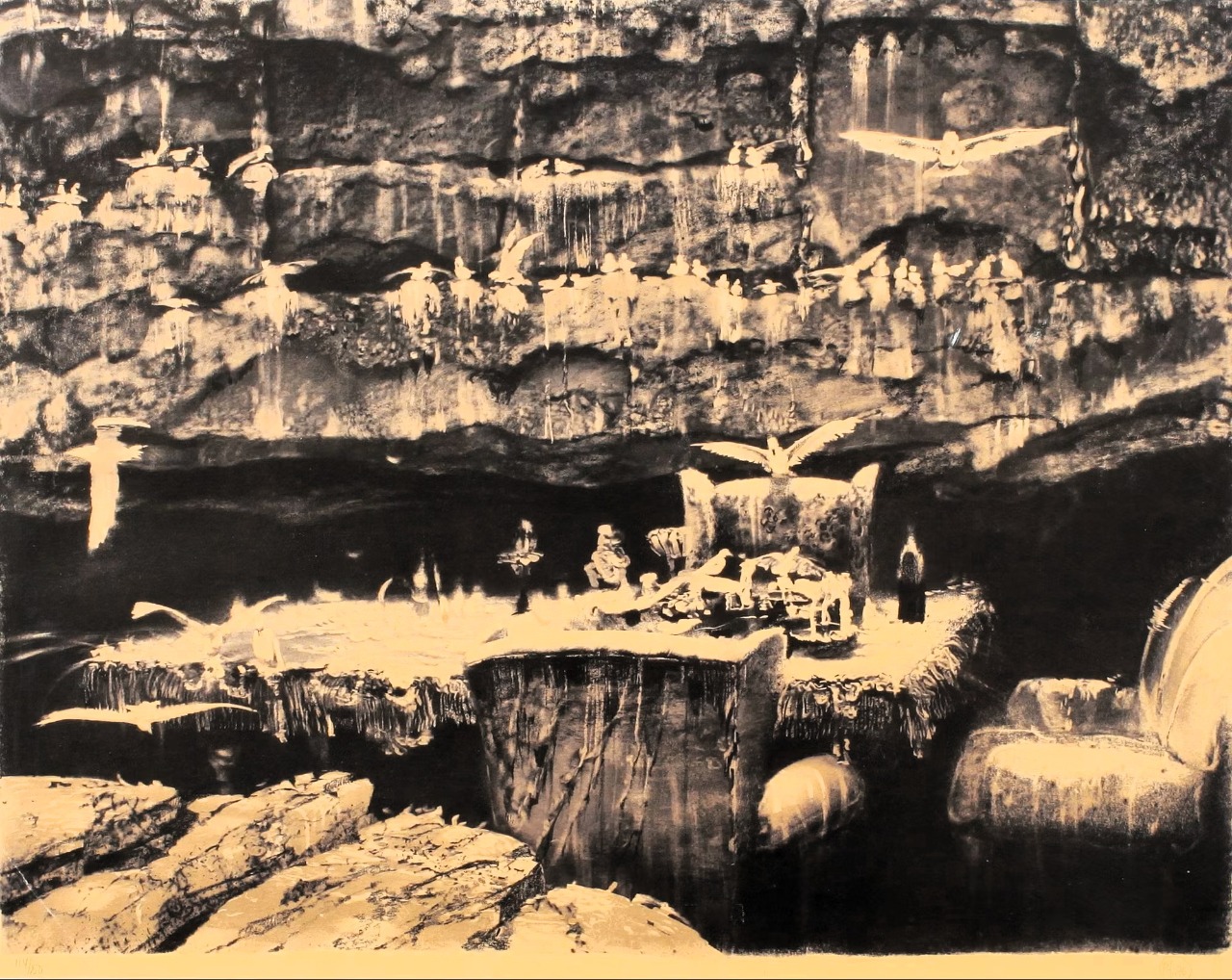
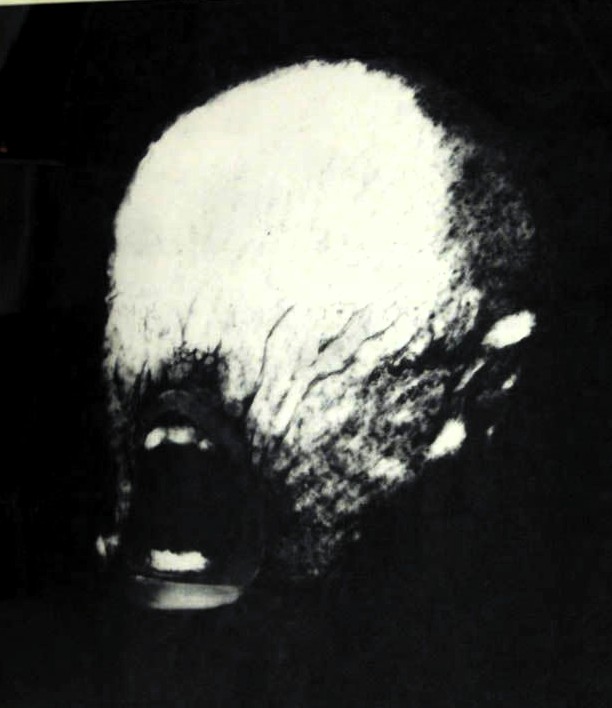
Death seems to have played a prominent role in European art, and not least the graphic artists have contributed to his presence, not least through series of "dances of death" that several of them produced. Perhaps the most important of such images where those produced by Hans Holbein the Younger (1497–1543). His suite of death dances consists of fifty-one woodcuts depicting how death visits different individuals from a variety of social classes and professions. The variety is impressive and so is the technology.
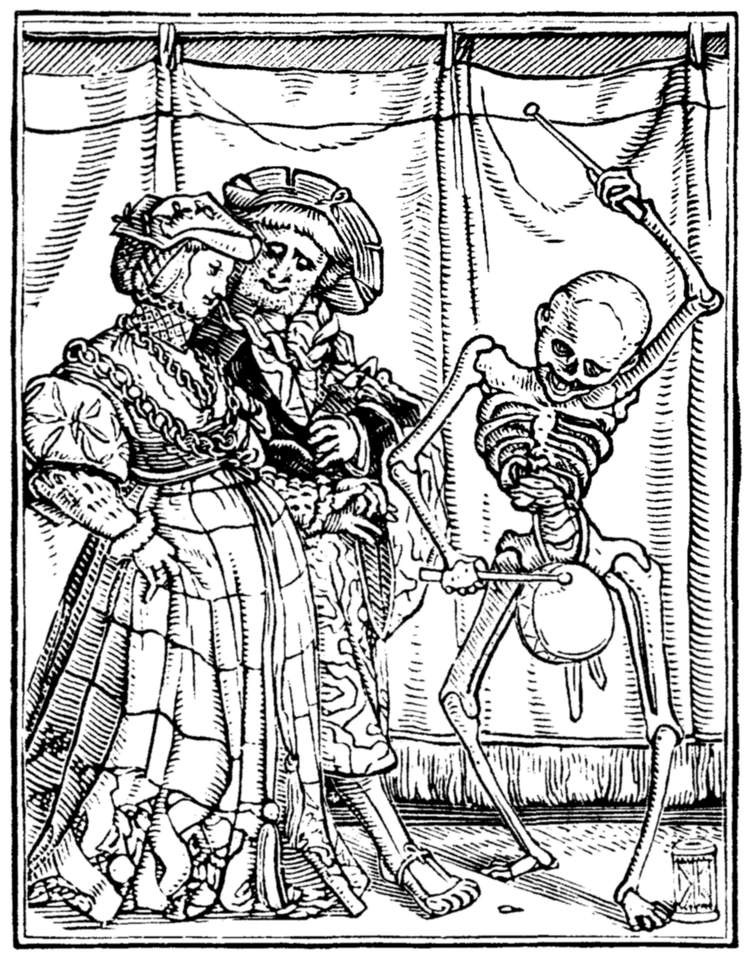
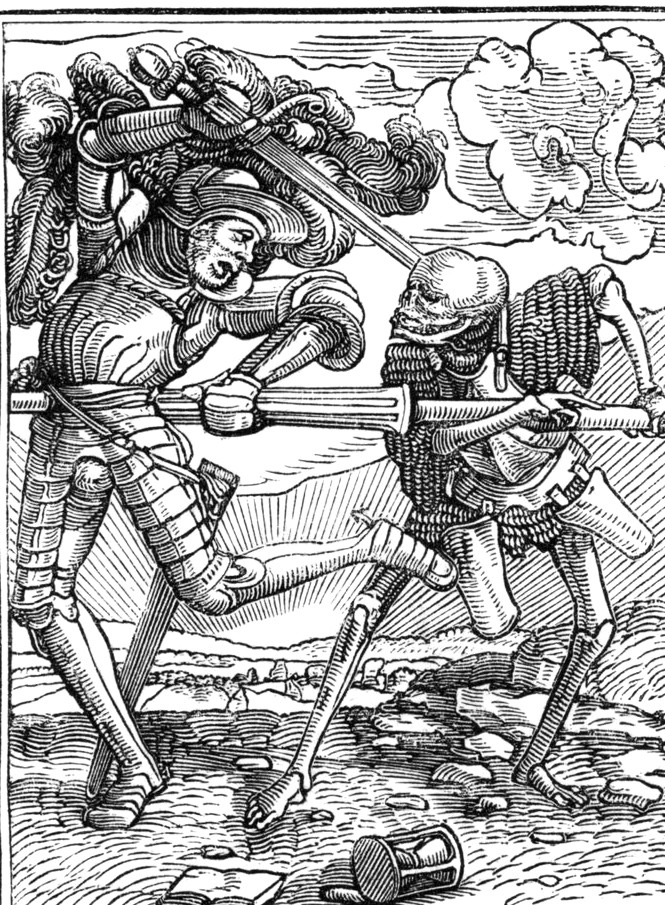
Another prominent engraver, the German-Polish Daniel Chodowiecki (1726 – 1801), made a similar suite two hundred years later.
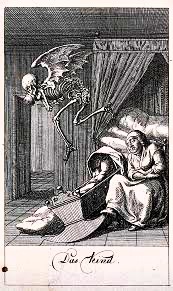
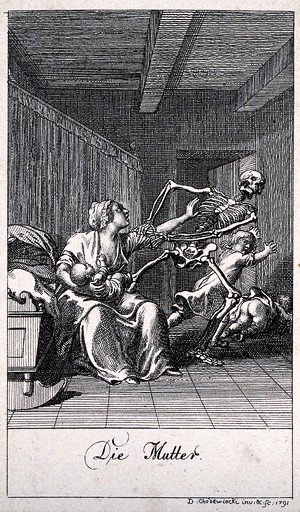
The above-mentioned Klinger had death as a prominent theme in a vast number of his etchings, among others he made a suite of ten pictures of death, which he published during a stay in Rome in 1889, but this was far from the only time he devoted himself to the motif of death.

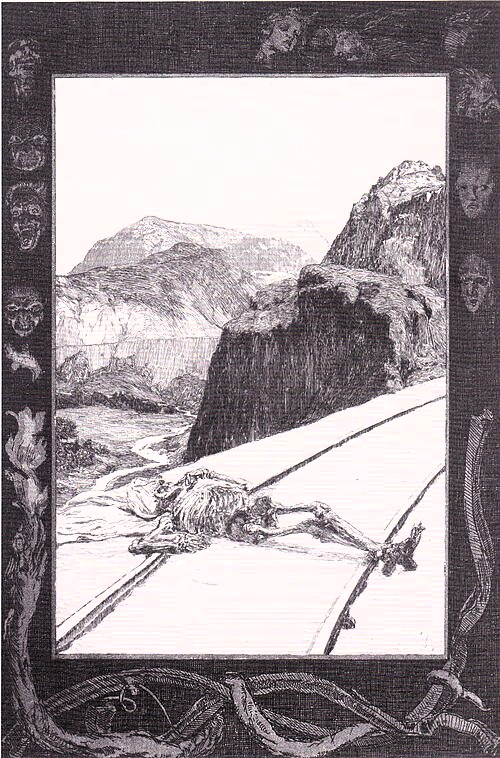
The Norwegian Theodor Kittelsen (1857 – 1914), was well acquainted with Norwegian folk tradition, not least cheap prints found in peasant cottages, and in his engravings he often returned to death and horror.
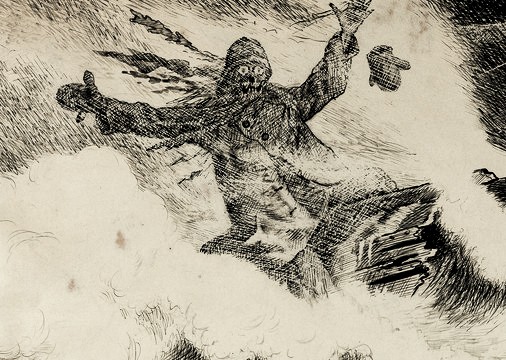
.jpg)
Death was common in the Scandinavian so-called Kistebrev, Coffin Letters, cheaply mass produced prints sold at markets and by peddlers to be used as decorations, or pasted up under coffin lids. Their heyday was from the beginning of the 1700s until about 1850.
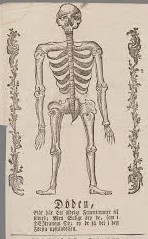
The Russian equivalent of coffin letters was Russian lubki and here we also find a number of death motifs. Death was certainly a dreaded presence among the entirety of the poor European peasantry.
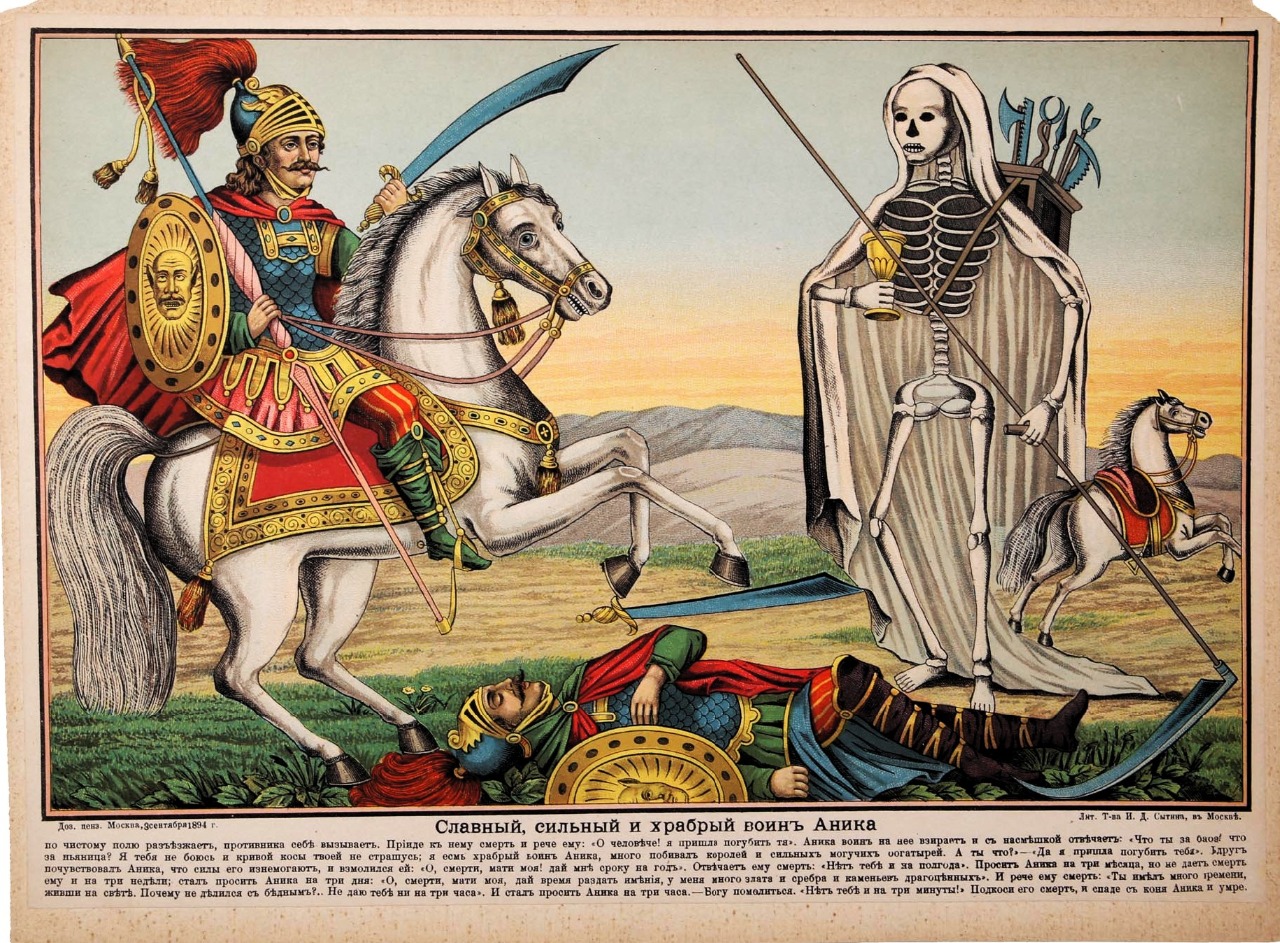
For several members of the Russian avant-garde, who had their heyday during the 1910s and 1920s, lubki came to be an important source of inspiration.
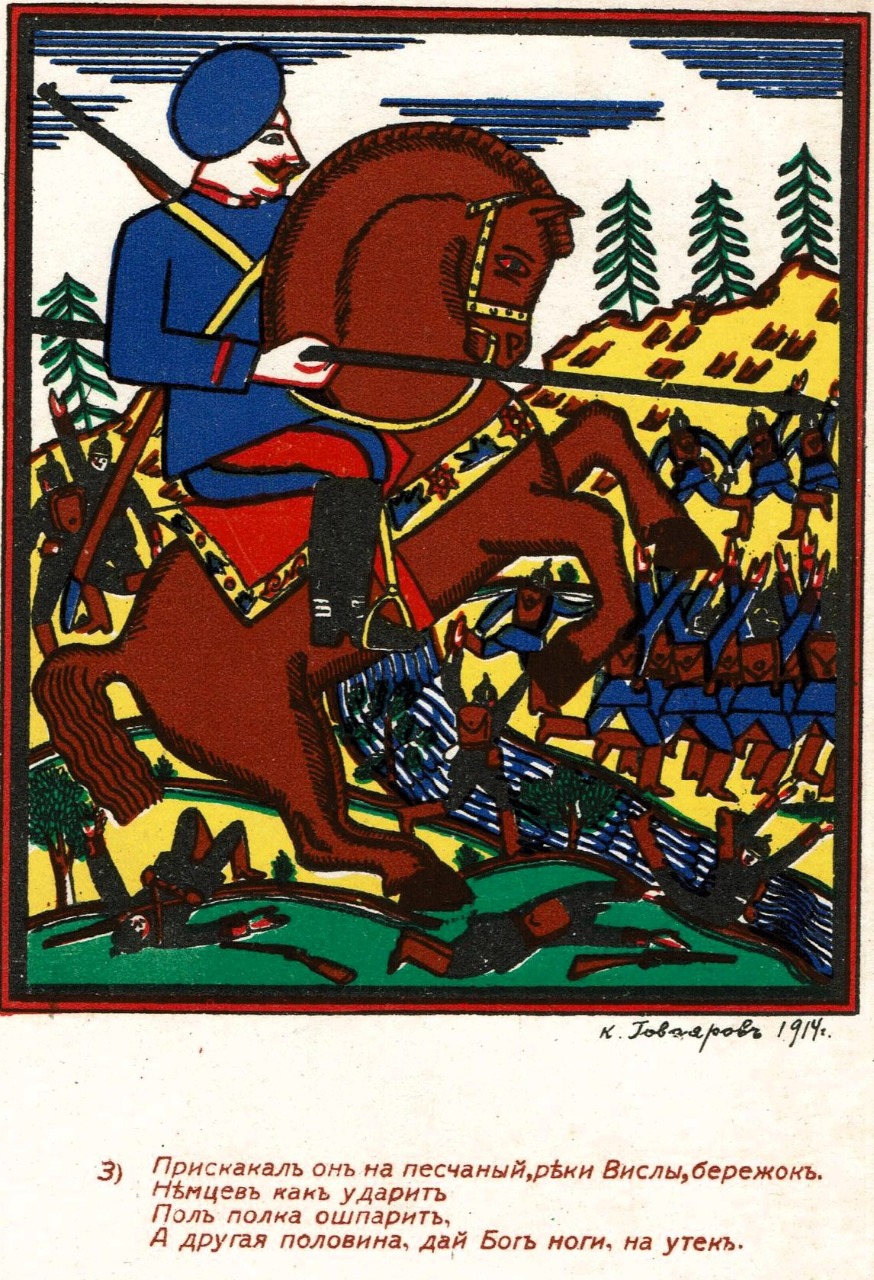
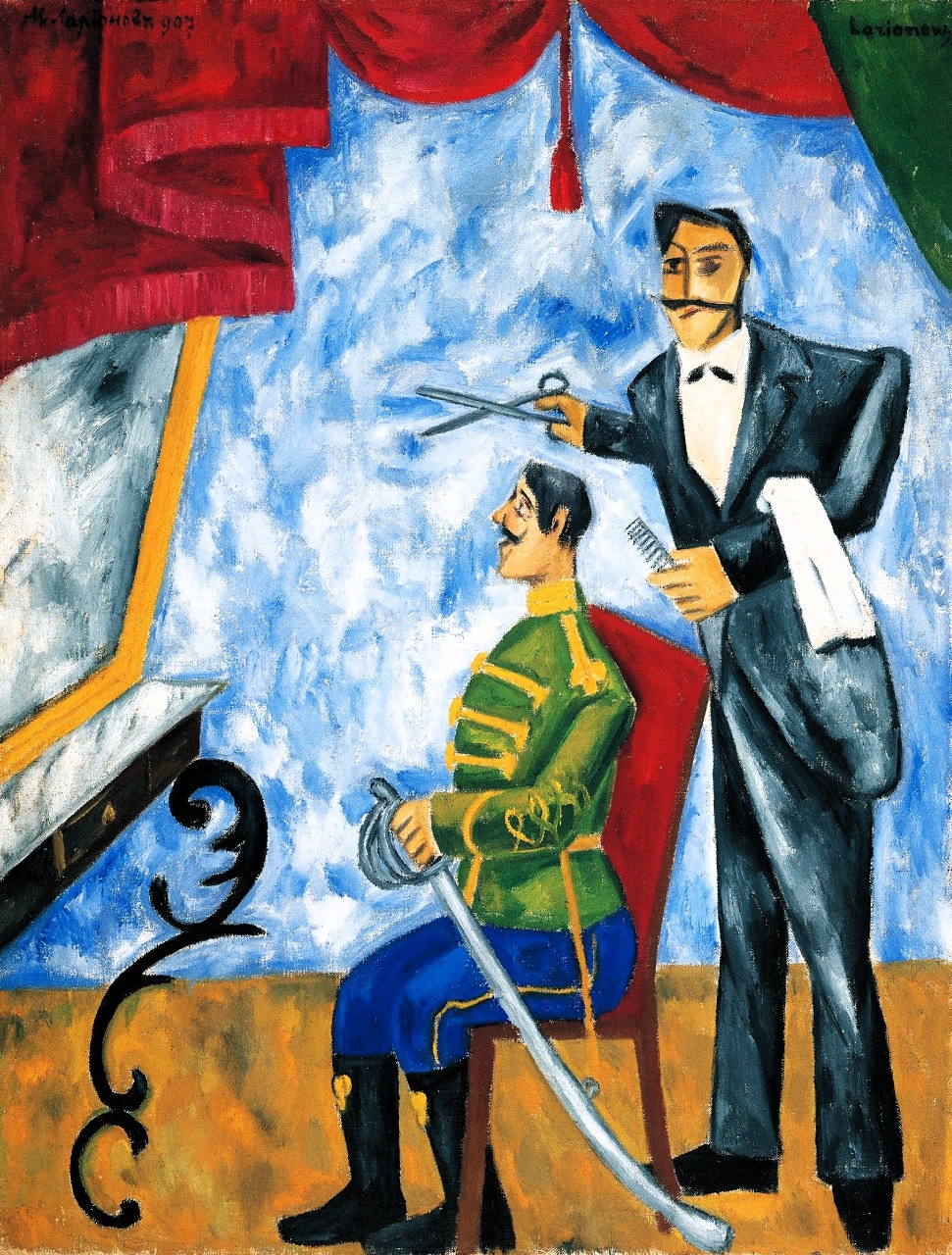
Nowhere has popular graphics been as obsessed with death as in Mexico. Its great master and inspirer of several successors, including Diego Rivera and Frida Kahlo, was José Guadalope Posada (1852 – 1913).
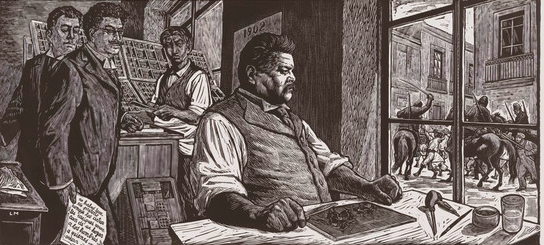
Among other things, he created the elegant skeleton lady La Catrina, which has become the epitome of the Mexican festivities around the Day of the Dead and the carnival.
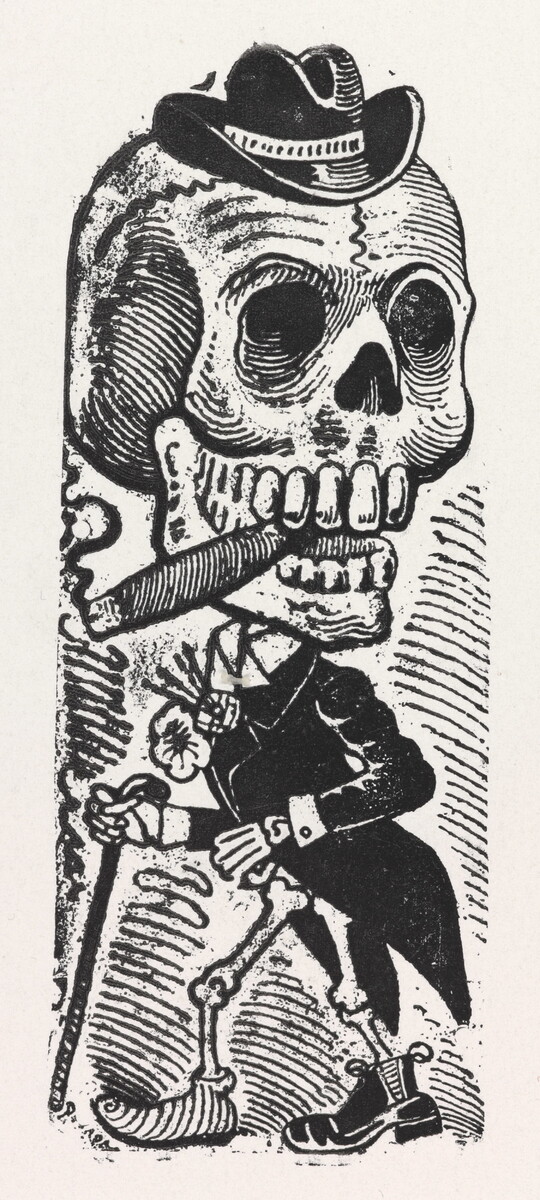
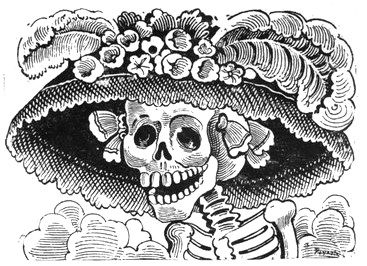
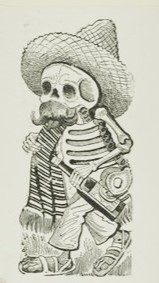
Posada's skeleton also took on the guise of Mexican bourgeois, politicians, and revolutionaries and has become an integral part of Mexican culture.
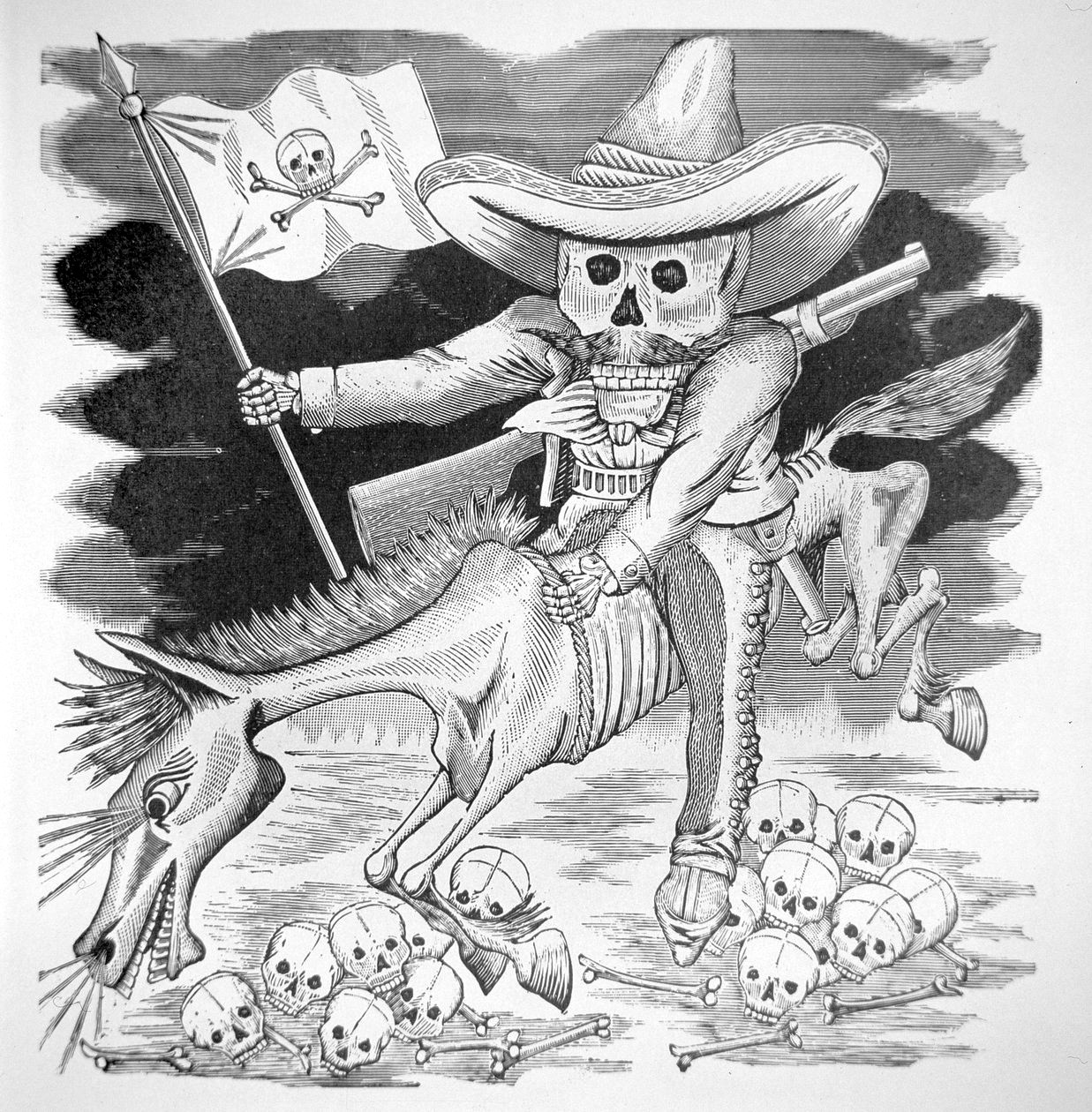
Of course, not all graphic art moves within lugubrious regions, etchings and woodcuts are no longer its most common means of expression. For a long time, graphic artists have devoted themselves to a variety of genres and techniques, which also have and have had their masters. For example, in advertising.
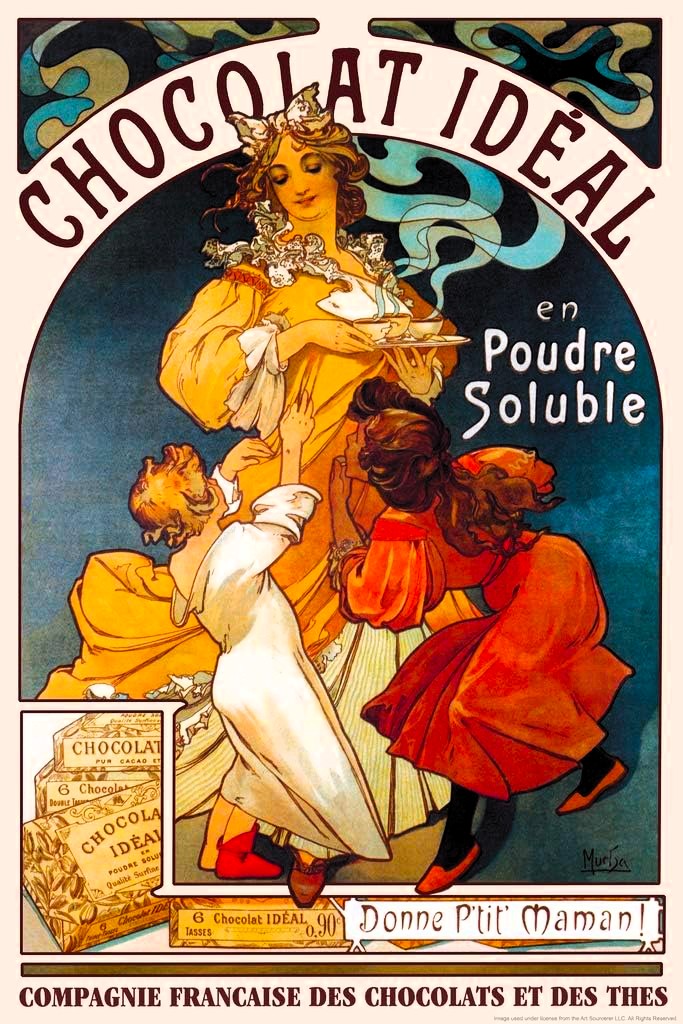
.jpg)
Political posters
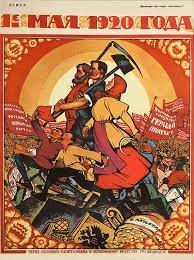

Movie posters


Comics magazines
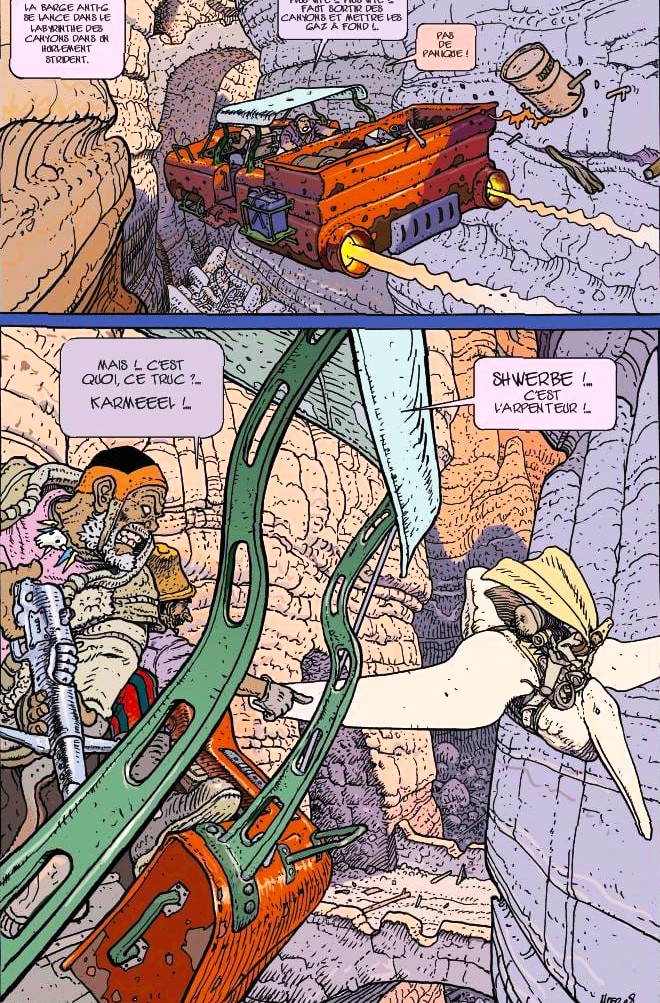
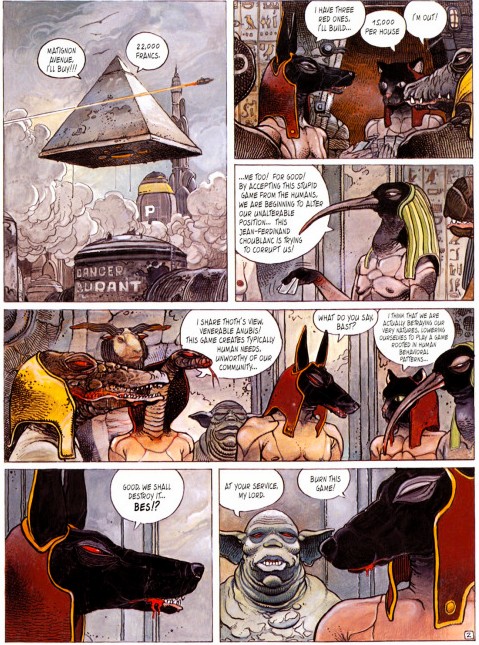
Book illustrations, an art that reached a peak in the latter part of the nineteenth and early twentieth centuries
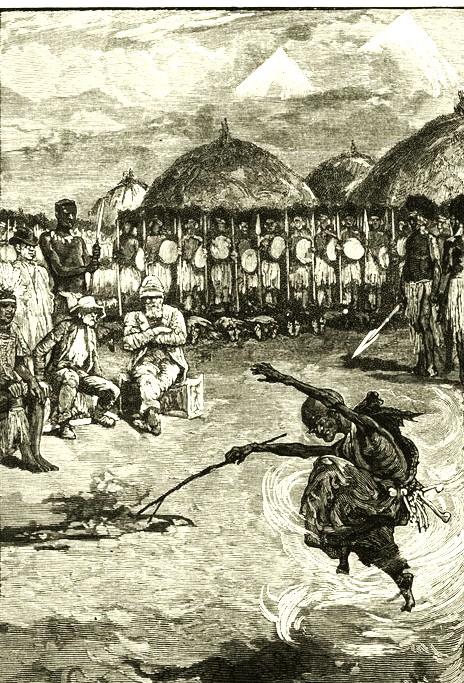
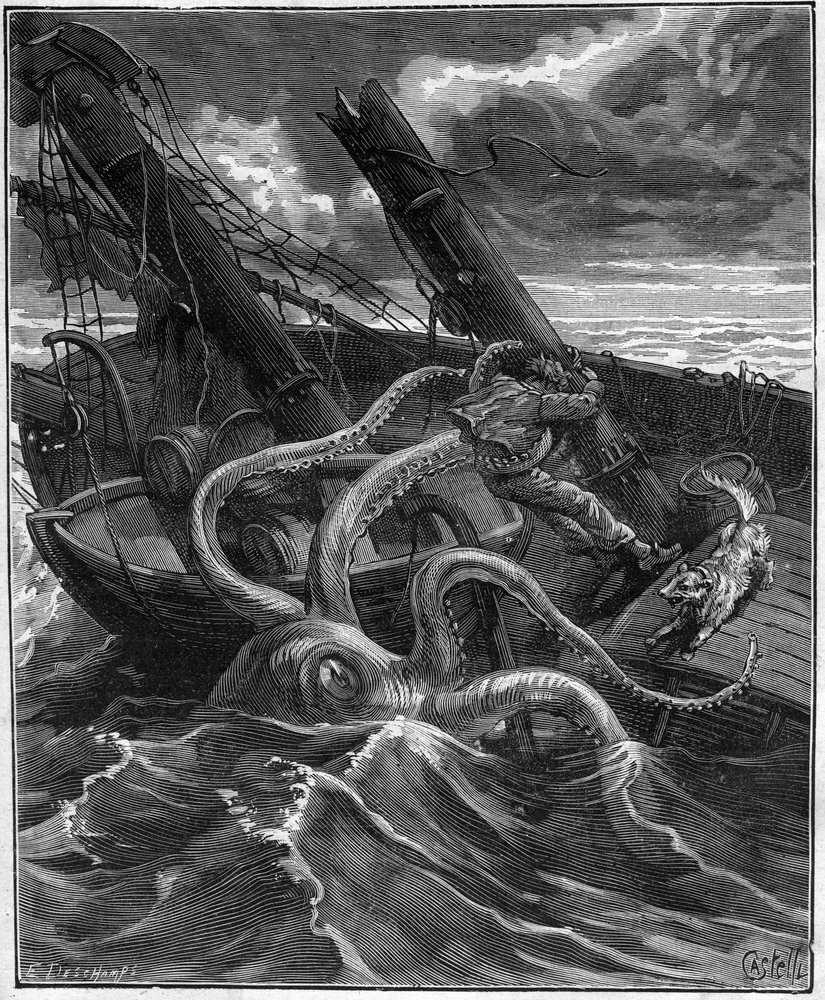
and has continued to exercise its fascination, mainly in children's literature.
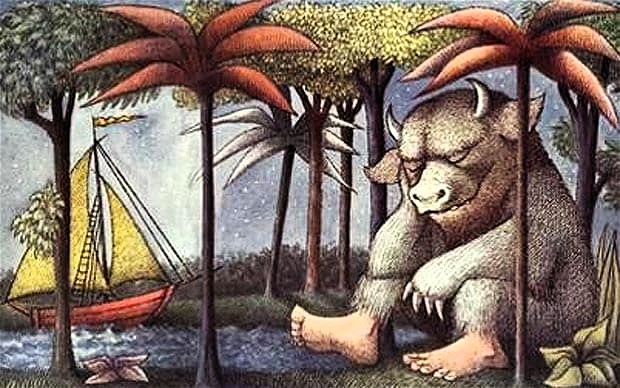
While talking about graphic art, it is easy to overlook the mastery that several artists have put into their skills, which often involve patience-demanding detailing.
Consider how Goya organized one of his graphic sheets. The centre of gravity is on its left side, which lays in shade and where the audience has gathered. This supports an illusion of the bull's violent rampage by stressing its movement into the void of the arena. Howver in the middle of the picture charging bull furious onslaught is stopped by the acrobatic matador's vertical cane, with which he for a moment halts all movement as he is hovering in mid-air, making the viewer wonder: "What will happen next?" As in a photograph, Goya has stopped time.
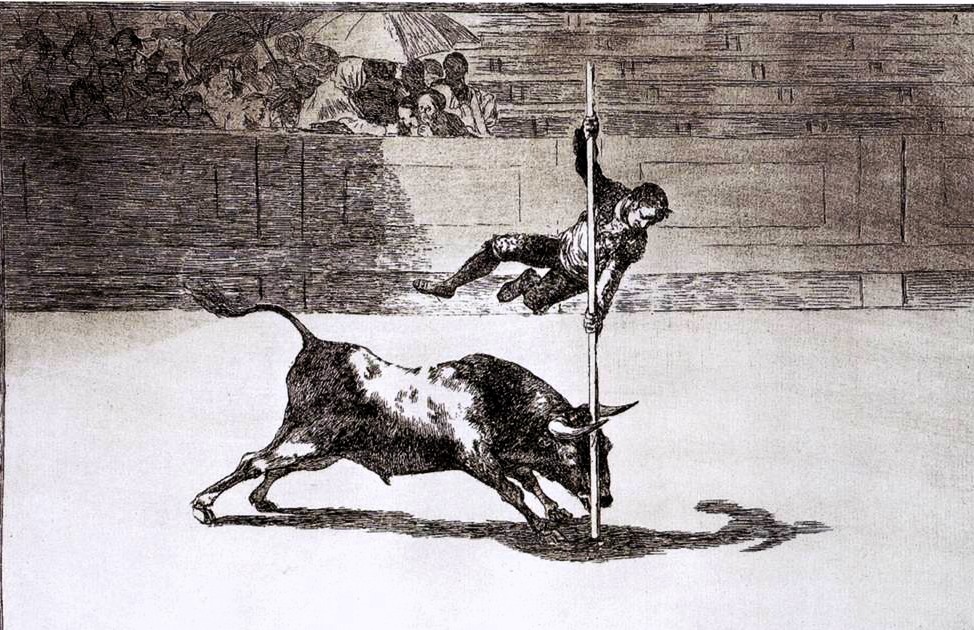
The Dutch Baroque master Hendrick Goltzius (1558 – 1617) has been called the last professional engraver who with the authority of a skilled painter was able to apply a lush creative ability and flowing lines to such an extent that he came to have a great influence on his European artist colleagues. A tribute which appears to be somewhat too exuberant, especially considering Rembrandt’s graphics, which a few years later perfected the art of engraving.
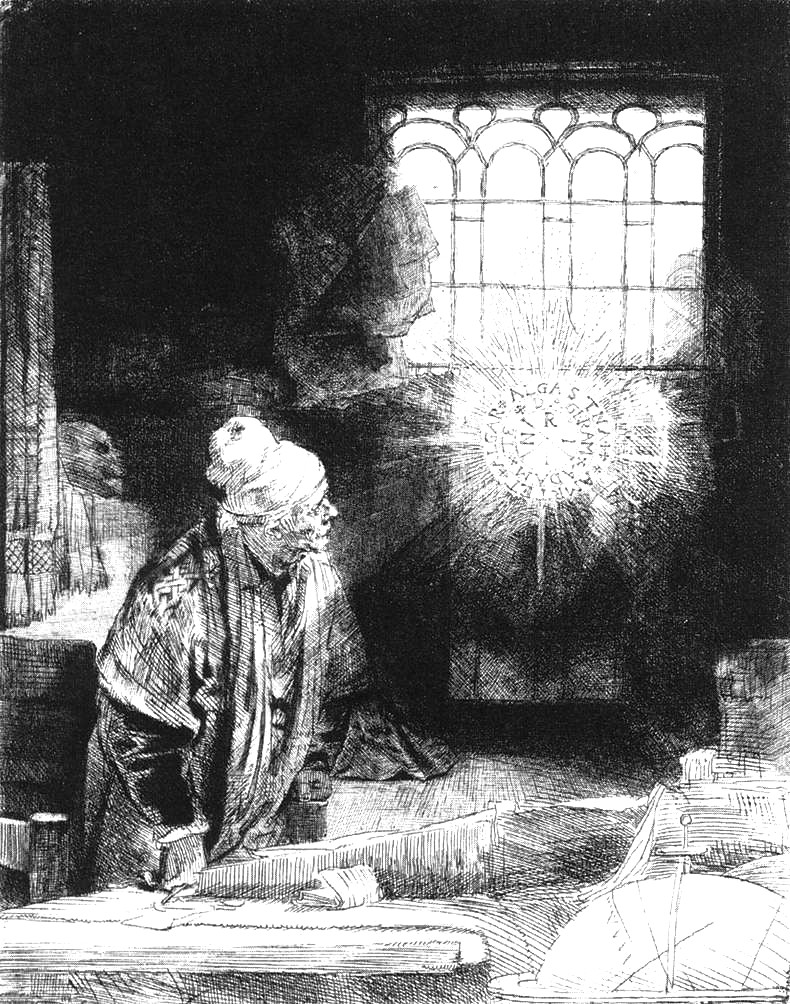
However, that does not deprive Goltzius of his championship. Goltzius had a deformed right hand, after having injuring during a fire. He was thus forced to put a lot of force into his arm - and shoulder muscles and persistent training gave him a powerful schwung in his lines, perhaps also a reason for the care he constantly demonstrated when it came to emphasizing the musculature of his figures. He also claimed that his deformed hand made it easier for him to get a secure grip on the burin, the etching needle. On several occasions, Goltzius depicted his distorted right hand, as below in a picture he named The Hand of Judas.
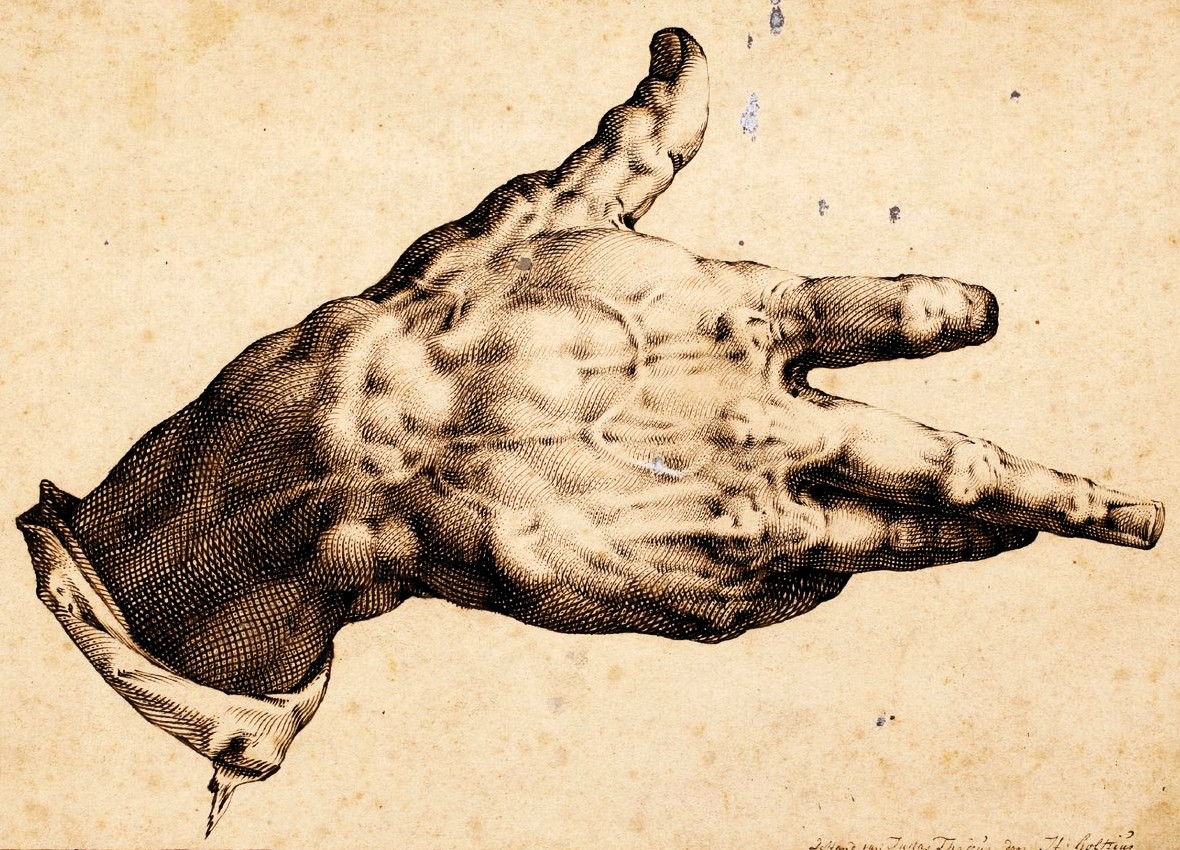
Muscle play and a bold abbreviation are demonstrated in his version of the falling Phaeton.
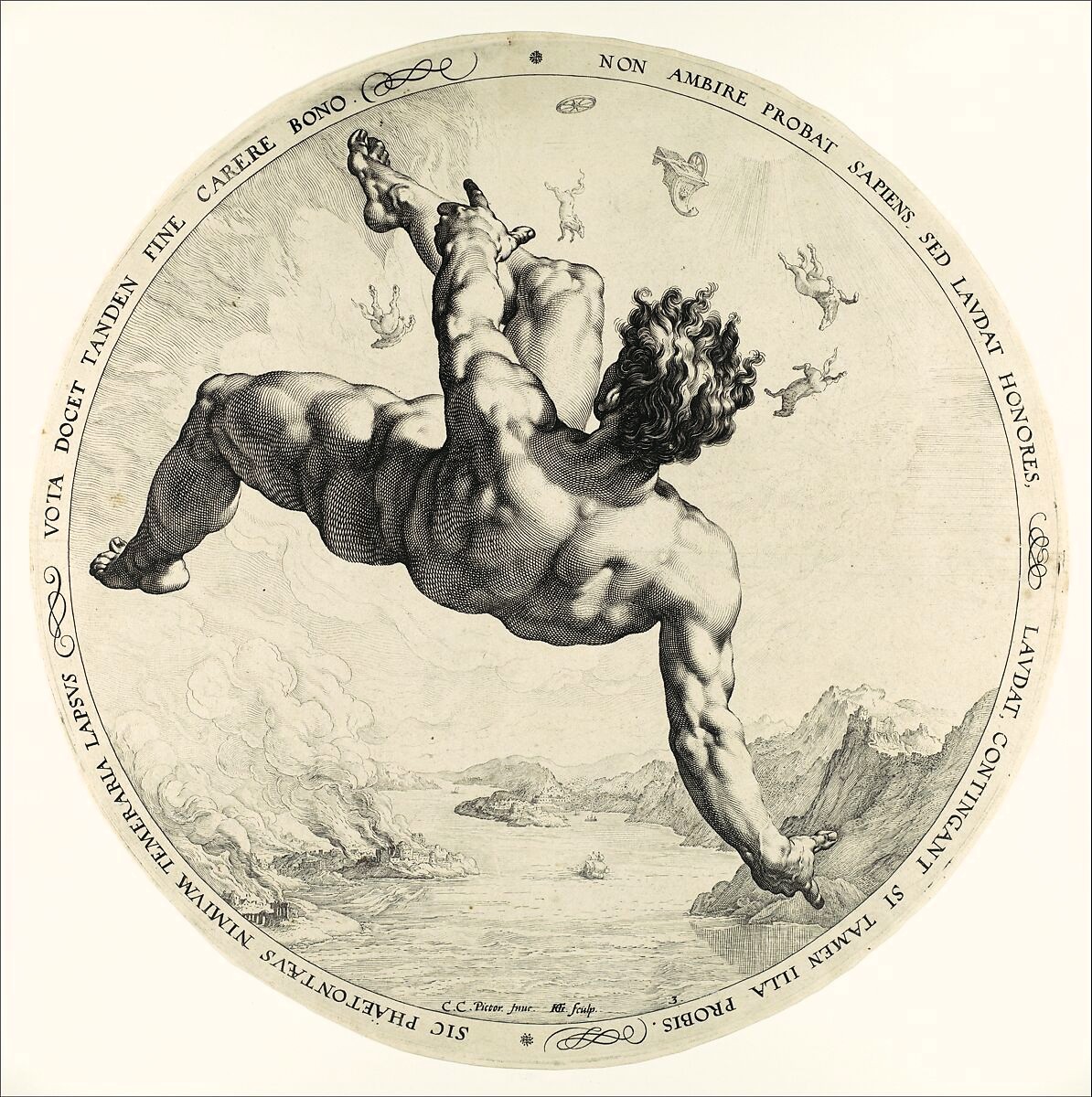
Graphic artists were often tempted to expose their superior skill. Like the Frenchman Claude Mellan (1598 – 1688) who with a single circular motion with the burin created a perfect Christ face.
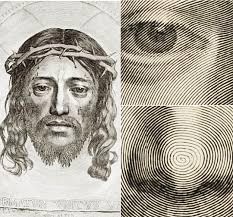
Otherwise, I am especially fascinated by another image of St. Peter of Nolasco being brought to the altar by two angels. Obviously, that etching, like so many others, is based on an oil painting by another artist, but I have not been able to identify the original. However, Mellan's picture is a masterpiece on its own accord, not least because of the refined lines, but also in the motif itself.
An aged saint is while sitting and reading carried by two angels who, in their efforts, do not seem to possess any heavenly powers. This while they are watched by a number of monks standing reverently in an airy church. I have no idea why St. Peter is carried to the altar while he is immersed in reading his book, nor who the saint was, other than that he was raising money to free Christian slaves from the Muslim Maghreb.
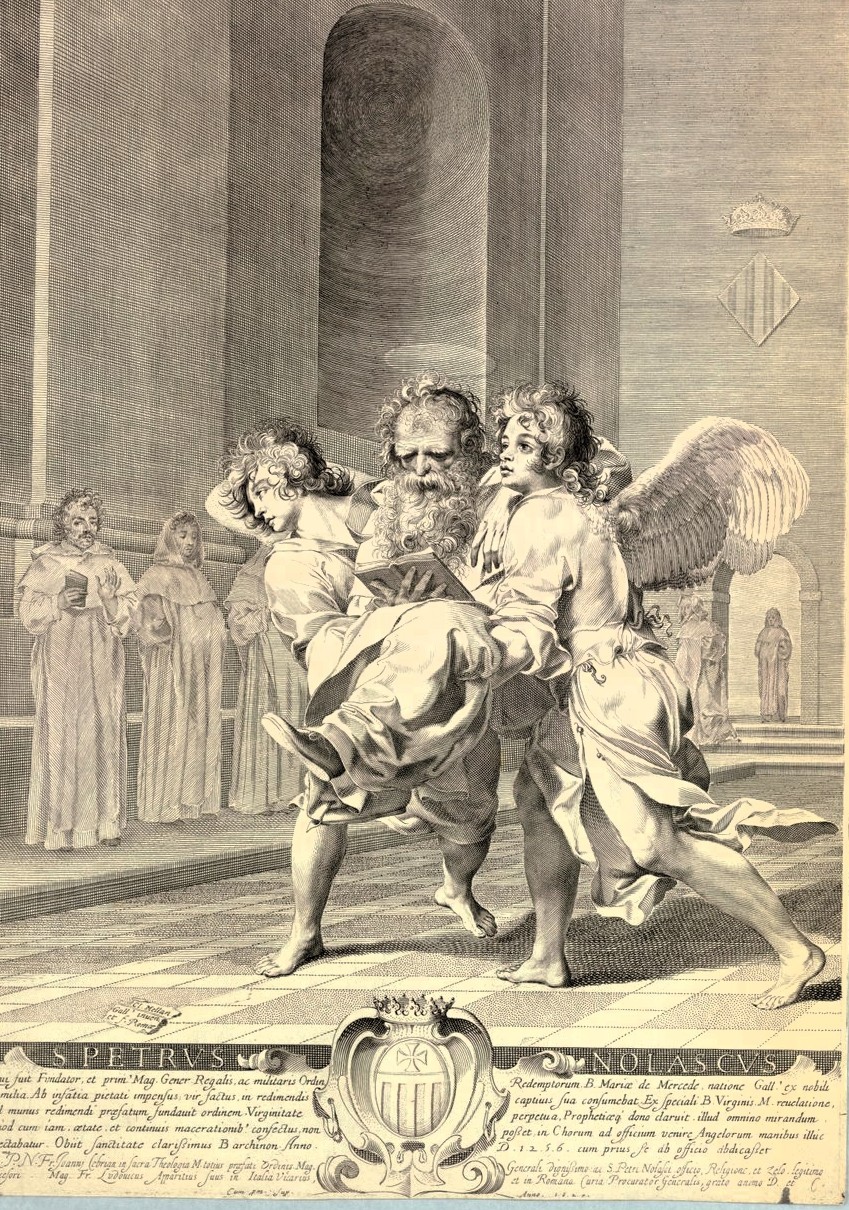
When I now read through what I have written about my findings in the history of printmaking, I find that they have taken a lugubrious direction. Goya, Kubin, Klinger, Redon, Doré and others with them seem to have had a penchant for the darker sides of existence and imagination.
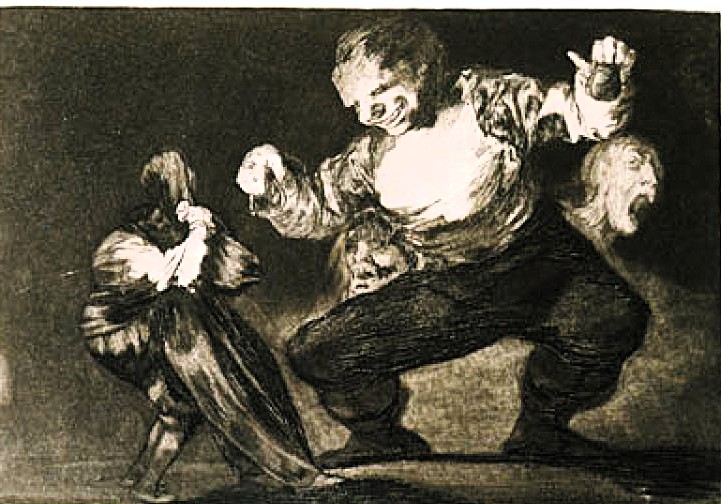
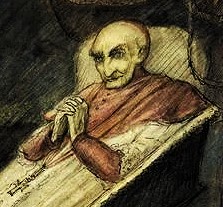
Perhaps, I am also attracted to such things, or it may simply be because at the time of writing I dins myself in Prague and the Czech Republic, where it seems to me that art and everyday life might be endowed with a somewhat gloomy macabre, or gallows-humorous, undertone.
Five years ago, after one of my visits to Prague, I wrote a blog post Flu, masks and witches in which I described, among other things, the terrifying monsters that threaten Czech children, especially during Advent, and which for centuries have haunted Bohemian and Moravian folklore.
Child-devouring Barboras and their demonic mistress Barbora/Frau Perchta, who have their freiendly counterparts in the Christmas-gift-giving saintly figures of St. Nicholas and Good King Wenceslas, whose opposite is the terrifying Krampus/Čert.
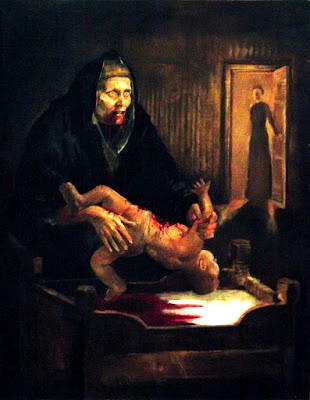

That such a now perishing folklore has crept into the art world is perhaps not so strange. In any case, during my current stay in the Czech Republic, I heard about an art project that fits well into this context.
About 200 km east of Prague we find the village of Luková. All of its 750 inhabitants are not permanent residents, several of the well-preserved old houses are now populated by people who only spend their weekends and holidays there.
The village's church, dedicated to St. George, was in 1352 built of locally mined stone, replacing an earlier wooden church. However, time has not been gracious for the originally beautiful church building. War, theft and fires have constantly ravaged it and repeated restorations have fundamentally changed its appearance; altarpieces, statues, church bells and the baptismal font have been taken away. Today, it is probably only the church pews that are more or less intact.
When a funeral was held in 1968, the roof collapsed, some of the parishioners were injured, but none seriously, and the result was that the church was definitively closed.
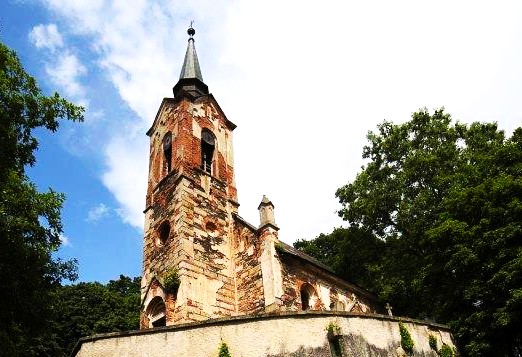
In 2012, Jakub Hadrava started looking for a suitable degree project to conclude his studies at the Faculty of Design and Art at the University of West Bohemia in Pilsen. He had begun to think about how church buildings for centuries had been at the very centre of people's lives and thinking:
The church was a place where you met God, a moral paragon, in my opinion it was a place that was primarily intended to promote people's goodness. The fact that several of these buildings now are empty and decaying is a reflection of the state in which so many of today's people are living, how they have deteriorated mentally and how their entire life situation threatens to fall apart. I wanted to draw attention to this and make a casual observer realize how important the place they happen to find themselves within in really is, especially if they have ended up in a church room, a holy sphere.
Hadrava came up with the idea of transforming an abandoned, dilapidated church into a place of insight and meditation. He thought about how he could stimulate a visitor’s contemplation through some kind of installation.
He found a 2007 publication called Endangered Churches listing the large amount of abandoned churches in the Czech Republic. The descriptions were brief and the photographs were often outdated.
Hadrava sought out a number of these churches and inquired about their use, owners, and the future planned for them. He found that most of them were now owned by private individuals, or companies, who demonstrated a limited interest either in preserving them or even less in letting them be available for an art installation. However, Hadrava eventually ended up in Luková.
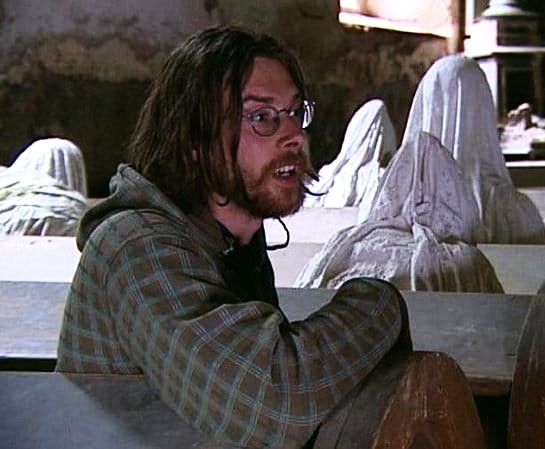
The dilapidated chirch was still owned by the Catholic Church, which found Hadrava's plans interesting – according to the local parish leaders, the proposal had a good Christian foundation and could possibly lead to the church being revived.
Hadrava had originally envisioned some kind of "abstract, minimalist" installation, but the peculiar mystique and tragic history of the place made him change his mind. It was not only that the population of Luková, through its almost thousand-year history, had suffered and often been decimated by plague and war, the latter in the form of the devastating Hussite rebellion of the fifteenth century, but a host of other wars as well, not least the thirty-year one in the 17th century and the First one that devastated the village and then World War II with its Nazi terror regime, followed by the forced deportation of Luková's German-speaking population, which was by then larger than its Czech population and made the village generally known by its German name – Sichelsdorf.
In the dilapidated church, Hadrava felt that he sensed the presence of all these missing people's ghosts and decided to populate the church with 32 life-size plaster figures. Because they represented now forgotten people, they took the form of ghost figures.
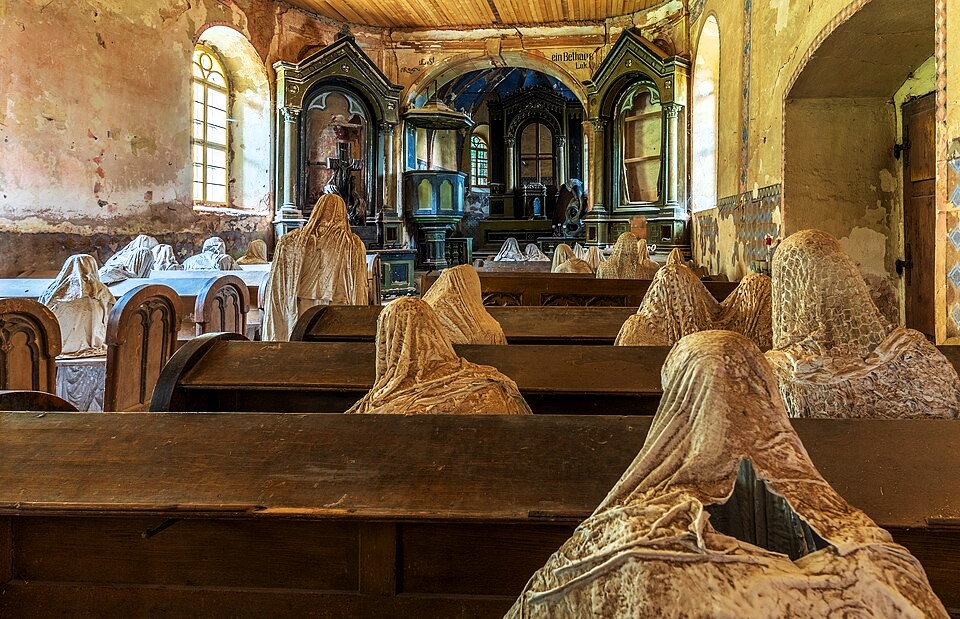
Since the church was closed and abandoned, Hadrava first wanted to preserve it in that manner – after all, it represented a past that for many modern people had been forgotten, a closed room, like a museum. The church's large windows were preserved and a visitor could look through them into the mass of the dead.
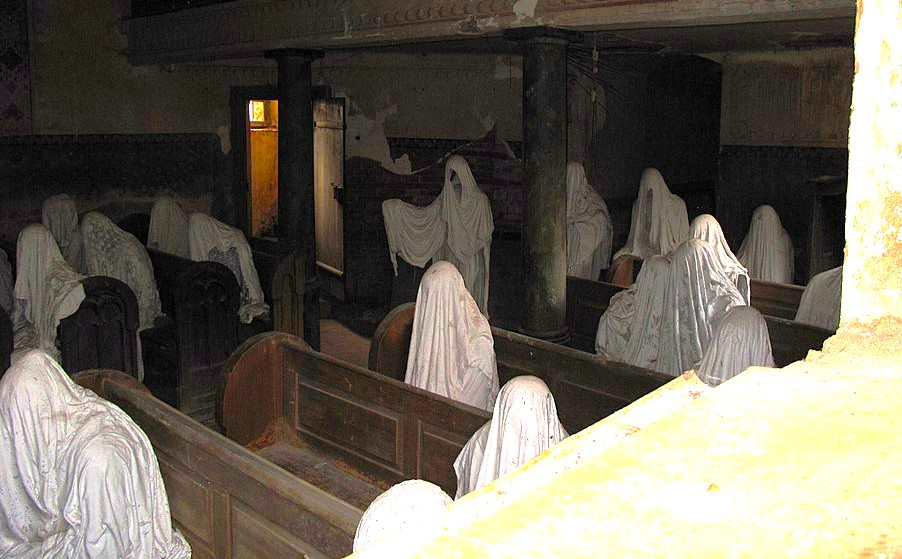
However, as Hadrava's project became increasingly known through newspaper reports and TV spots, more and more visitors sought out Luková. These visitors also wished to be allowed access to the church. Luková's congregation therefore decided to keep its ghostly church open every Saturday between March and October. More and more visitors from all over the world are now flocking to share the experience of sharing space with tangible ghosts from the past.
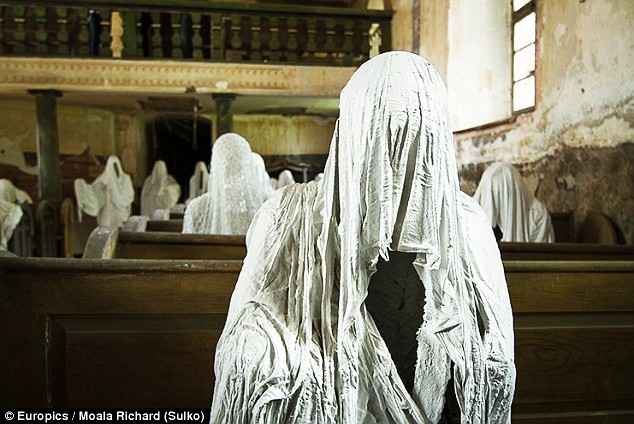
.jpg)
A strange and perhaps even scary feeling that deepens after dark.
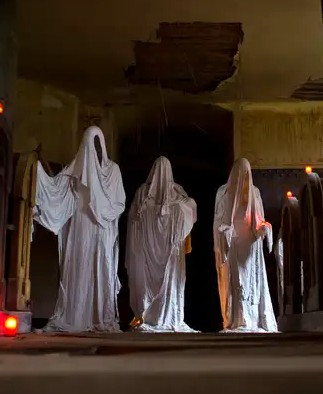
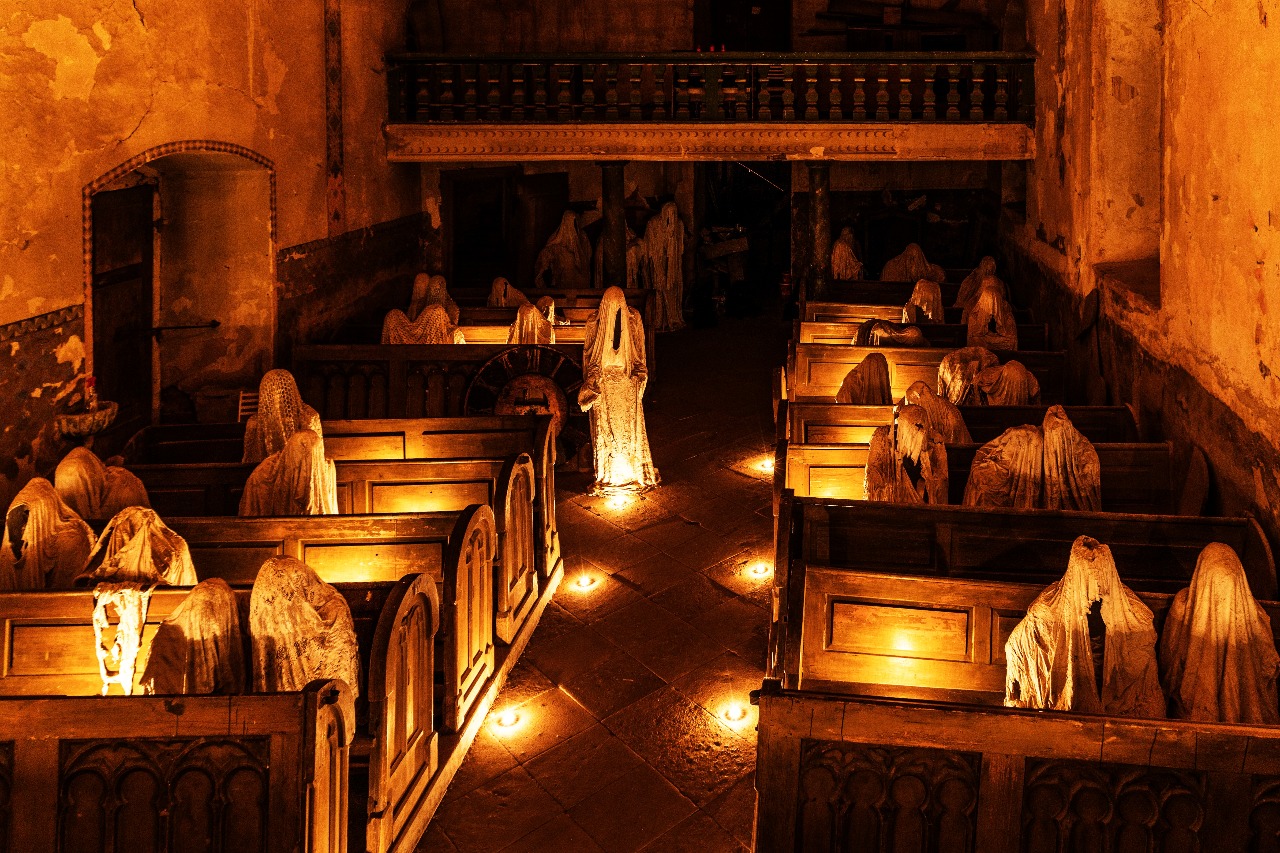
In any case, Jakub Hadrava's installation has been something of a success and has put Luková on the map. Donations from the increased number of visitors, which now amount to 25,000 euros, have enabled the parish to repair the roof and occasionally mass can be held in the church as parishioners carefully take their seats among the ghostly plaster figures.
However, there is a concern that the installation concept might be tarnished and popularized to such an extent that a sensationalist mass tourism could kill Harrava's original idea – to honour the memory of the dead and create a meditative atmosphere within a church space that would bring a visitor closer to history and the positive values that church and religion once were passing on to our ancestors.
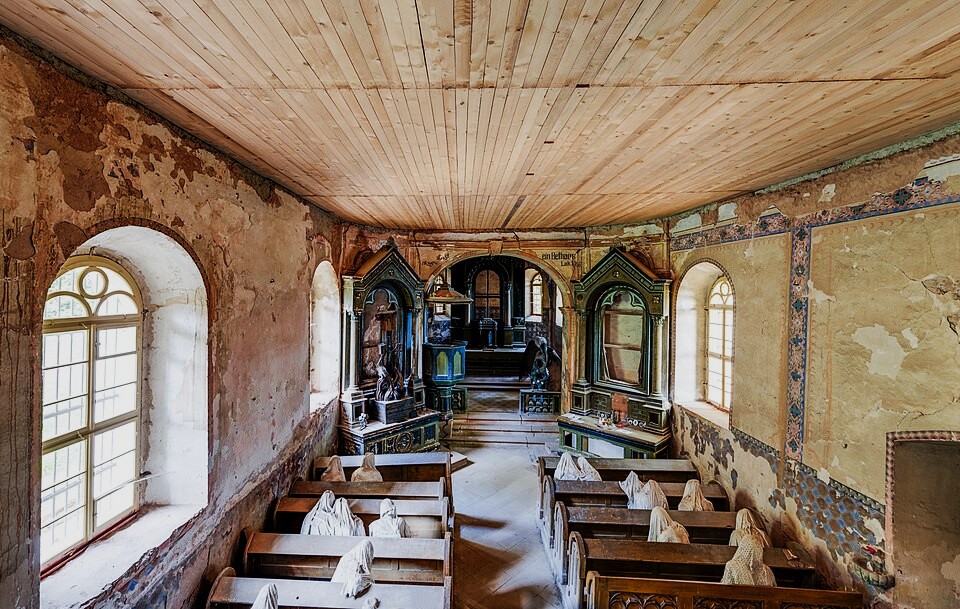
Under den senaste tiden har jag haft ovanligt livliga drömmar, kanske har de stimulerats av mitt ivriga bloggskrivande. Det, liksom drömmarna, är som att stiga in en främmande, men likväl välbekant värld där jag umgås med människor jag mött och böcker jag läst.
I natt drömde jag, som så ofta förr om såväl döda som levande vänner och familjemedlemmar. Jag förde intressanta samtal med dem, inom för mig välkända, fast likväl märkligt förändrade miljöer, såväl inomhus som utomhus. Det skedde främst inom minnen från barndomens regioner, men uppblandade med landskap som jag senare vistats i. Det händer ofta att flera av mina drömmar utspelar sig i och omkring lätt förfallna hus, eller till och med labyrintiska slott och herrgårdar, som jag av någon obegriplig anledning är ägare till, eller på annat vis associerad med.
I natt körde jag tillsammans med några vänner och bekanta bil genom sådana landskap och då vi nått vårt slutmål promenerade vi genom ett vildvuxet parklandskap kring mina föräldrars för länge sedan förgätna torp, som i själva verket låg i en skog.

Nu då jag vaknat, minns jag mycket väl vad vi samtalade om och även titlarna på och innehåller i ett par tjocka och illaluktande böcker jag fann på verandan till ett gistet och bedrövligt förfallet uthus. Kan inte begripa varför jag lämnat så intressanta böcker därute och varken när eller var jag fått tag på dem.
Märkligt var även att väggarna inne i de det där otäta, ovanligt stora uthuset var täckta av tapeter, som flagnat i stora sjok och remsor. Under dem, vilket varit vanligt förr i tiden hade man täckt väggarna, inte med uppklistrat tidningspapper som man gjorde då, men med etsningar av vilka jag kände igen de flesta gjorda som de var av Goya, Klinger, Esher, m.fl.

Drömmens böcker och grafiska tapeter var kanske kopplade till mina senaste blogginlägg och detta kom mig att tänka på min yngsta dotter som under den sista tiden i väntan på något bättre har arbetat i en bekants tidningskiosk. Hon har berättat för mig att de flesta stamkunderna utgörs av äldre personer som köper dagstidningar och korsordsmagasin. Det senare beror kanske delvis på att äldre personer, i fruktan för sin stigande senilitet, har hörsammat att hjärnverksamheten stimuleras av korsordslösande. Själv har jag inbillat mig att bloggskrivande kan ha en liknande välgörande inverkan på min åldrande hjärna. Inte vet jag.

Att etsningarna dök upp i drömmarnas värld var inte så underligt eftersom jag nyligen med min fru besökte ett konstgalleri här i Prag där vi hälsar på min äldsta dotter. Då jag nu vaknat upp och de andra fortfarande sover fick jag idén att i min blogg, främst för egen del, inkludera några konsttryck som förblivit i mitt bildminne.

Vad jag och Rose sett här i Prag var verk av Oldřich Kulhánek (1940 – 2013) en grafiker som bland annat gjort de tjeckiska sedlarna. Det är ett av mina nöjen att betrakta sedlarna i de olika länder jag hamnat i och lista ut vilka personligheter de avbildar. Sedlar är oftast små konstverk och därmed är exempelvis eurosedlarna rena katastrofen – urtråkiga som de är med sina intetsägande arkitekturmotiv.

Kulháneks tjeckiska sedlar är utmärkta och även de konstverk i sin egen rätt. Bland annat framställde han 500 koronasedeln med en bild av Božena Němcová (1820–1862). Givetvis tog jag reda på vem denna för mig okända dam kunde vara.
Božena Němcová var gift med en tjeckisk patriot som genom sina tidningsartiklar bekämpade den österrikisk-ungerska centralmakten. Men Boženas make var en otrevlig hustyrann som plågade sin hustru och deras fyra barn. Slutligen lämnade Božena honom och dog i fattigdom.
Trots sitt äktenskapliga lidande och andra besvär hade Božena varit en flitig och mycket uppskattad skribent som fått sina patriotiska artiklar både öppet och illegalt publicerade. Hennes roman Babička, Farmor, som var baserad på hennes uppväxt i byn Ratibořice, är fortfarande populär läsning bland tjeckerna. Kanske genom dåligt samvete över att man låtit Božena dö ensam och fattig anordnade de tjeckiska patrioterna en pampig begravning för henne och reste sedermera även flera statyer och monument till hennes ära


Kulhánek ägnade sig också åt att som grafisk konstnär framställa en mängd parodier på olika sedlar. Nedan har han exempelvis manipulerat en tysk hundramark sedel med en bild på Clara Schumann, gift med den geniale kompositören men sedermera obotlig galne Robert Schumann och själv en skicklig pianist och kompositör. För övrigt tycker jag att det rör sig om en ovanligt vacker sedel.

Kulhánek låter Karl Marx bryta sig in i Claras sedel och stjäla henne örhänge.

Möjligen i protest mot den rysk-sovjetiska ockupationen av Tjeckoslovakien 1968 gjorde Kulhánek några år senare en rubelsedel som framställde en fet gris.

Att framställa sedlar som en form av satir gjorde även en gång min vän Jean Sellem från Lund, där han, enligt min mening som en av de främsta företrädarna för den anarkistiska konströrelsen Fluxus var innehavare av konstgalleriet Skt. Petri. Då Sellem 1977 kommit i delo med något kommunalråd vid namn Rehn, som uppenbarligen ville dra in kulturstödet till hans mycket intressanta och livaktiga galleri, kontaktade Sellem den från Polen nyligen inflyttade grafikern Andrzej Ploski och tillsammans skapade de och delade ut en mängd ”renlappar”.

Sellem frågade mig också om han kunde använda sig av mitt familjenamn för att tillsammans med Ploski ge ut en satirisk och delvis obegriplig liten bok som de kallade Lundius Commedia Dell’Arte

Även riktiga sedlar har någon gång visat sig innehålla dolda satiriska, eller skämtsamma, anspelningar. Berömd är sedlar från den lilla ögruppen Seychellerna, belägen långt ute i Indiska Oceanen, tryckta år 1968. Man hade snart upptäckt att palmkronornas mönster på en av dem kunde utläsas som ”sex”, medan korallernas mönster på en annan sedel kunde läsas som scum, avskum.


En debatt skapades kring vad sedelns formgivare Bradbury & Wilkinson hävdade var en oavsiktlig tryckavvikelse, men det tycks trots allt som om det hela var ett skämt från gravören Brian Foxs sida.
Seychellernas brittiska kolonialadministration lät dock sedlarna cirkulera i ytterligare åtta år, tills öarna 1976 blev en självständig republik, Sir James Mancham, som tidigare varit guvernör och nu blev president, kom att pryda republikens nya sedlar.

Men de försvann redan efter ett år. Då Sir Mancham rest till England för att fira drottning Elizabeth II:s silverjubileum, genomförde hans premiärminister France-Albert René, med hjälp av ett hundratal anhängare och legoknektar som skeppats in från Tanzania, en militärkupp och inledde därmed en tjugoårig diktatur. De nya sedlarna pryddes dock inte med France-Albert René, men det gjorde frimärkena.
.jpg)

Kulhánek skapade även flera tjeckiska frimärken, som de nedan som hyllade den originelle tysk-romerske kejsaren Rudolf II som till sitt hov i Prag från hela Europa bjöd in konstnärer, musiker och inte minst alkemister som engelsmannen John Dee och astronomer som dansken Tyge (Tycho) Brahe och tysken Johannes Kepler.

Likt sedlar kan även frimärken betraktas som små konstverk och det är skada att de numera alltmer har försvunnit och om de möjligen finns kvar så har de ersatts av tråkiga flerfärgstryck, fjärran från de utsökta graverade mästerverk de en gång var, framställda av konstnärer som Kulhánek och inte minst den än mer kände och framstående svensken Czesław Słania (1921 – 2005). Słania kom 1956 från Polen till Sverige och skapade fram till sin död inte mindre än 1000 frimärken. Vid hans bortgång gav det danska postverket till och med ut ett frimärke till hans ära, det pryddes av ett av Słanias självporträtt.

Redan som ung student i Lublin hade Słania för den polska motståndsrörelsen förfalskat tyska sedlar och officiella dokument och då han kom till Sverige anställdes han av det svenska postverket. Förutom de frimärken han skapade för Postverket graverade han även frimärken för inte mindre än trettio andra länder. Likt Kulhánek graverade Słania även sedlar, dock inte Beniuševičiūtė-Žymantienė (1845–1921) som under pseudonymen Žemaitė skrev en mängd romaner och noveller som främst utspelade sig bland litauiska bönder.
Žemaitė påminner en hel del om Selma Lagerlöf och likt henne var hon dotter till godsägare som förlorat sina egendomar och förmögenhet. Båda blev sedermera upphöjda och respekterade personligheter i sina respektive hemland.

Även Selma finns som porträtt på en svensk sedel, dock inte graverad av Słania utan av två unga kvinnor – Toni Hanzon Kurrasch och Agnes Miski Török.

De nya sedlar som 2016 introducerades med bilder av grafikern Göran Östlund porträtterar även de svenska kulturpersonligheter, men i mitt tycke är de inte lika estetiskt lyckade som tidigare sedlar. Ta exempelvis sedeln med Greta Garbo. Jag tycker den ger ett rörigare intryck, porträttlikheten är sämre och gravyren inte så detaljerad.

Jämför sedeln med Słanias mästerliga frimärke med Greta Garbo i Gösta Berlings saga.

Jag är inte frimärkssamlare, men jag har en del Słaniafrimärken jag fått av min far och det är förvisso en fin upplevelse att detaljgranska dem. Exempelvis den skickliga framställningen av den varierade sommargrönskan kring en ångbåt på Göta Kanal.

Słanias hantverksskicklighet är också högst påtaglig i hans framställning av ett färöiskt får.

Jag har också kvar en serie med frimärken till minne av svenska forskningsresanden. Skickligt framställda med spännande bakgrunder, bland dem Linnélärjungar som Carl Peter Thunberg, som botaniserade i Japan, Indonesien och Sydafrika och Anders Sparrman, som seglade med James Cook


och senare vetenskapligt sinnade äventyrare som Nordenskjöld som tog sig genom Nordostpassagen och Hedin som utforskade Centralasien.


Jag har också en sedel från Brasilien som visade sig vara skapad av Czesław Słania och i vanlig ordning tog jag reda på vem Ruy Barbosa de Oliveira (1849 – 1923) kunde vara. Det visade sig att han varit en liberalt sinnad författare, politiker och reformator. Barbosa hade varit inflytelserik då det gällt att avskaffa det brasilianska slaveriet, något som inte skedde förrän 1888. Då den så kallade Gyllene lagen trätt i kraft såg han till att all dokumentation kring slaveriet och dess brasilianska historia effektivt förstördes under pretexten att Barbosa ville utplåna denna skamfläck ur Brasiliens historia. I själva verket tycks det som om han ville skydda tidigare, brutala slavägare från följderna av deras beteende.

Med tanke på hur de skickliga grafikernas frimärken och sedlar försvinner alltmer är det tragiskt att inse att ännu några exempel på hantverksmässigt baserad konst stadigt försvinner ur vårt vardagsliv.
Kulháneks grafiska konst begränsade sig långt ifrån till att gälla enbart frimärken och sedlar. Han intresserade sig speciellt för att skildra människokroppen, i olika ställningar åldrar. Kulháneks nakna hopkrupna människor kom mig att associera till det nakna monstret i del Toros visuellt kraftfulla Frankenstein, som jag såg alldeles nyligen.


En fascinerande idé var hur Kulhánek i en serie etsningar sammanställde porträtt av människor som spädbarn och åldringar.

En annan serie med fallande nakna människokroppar förde tankarna till Rubens visioner av kringslingrande, nedstörtande människomassor under den Yttersta domen och de dömdas fall ner i Helvetet.

.jpg)
Kulháneks förmodade anspelningar till barocka artister som Rubens minner om etsningskonstens ursprung. Flera av de tidigaste etsningarna och deras efterföljare utgjordes till stor del av reproduktioner av målningar av välkända artister som på så vis fick sina verk spridda över Europa. Exempelvis så arbetade Marcantonio Raimondi (1482–1534) nära sin gode vän Raphael och överförde flera av hans verk till grafik.


En del av Raimondis etsningar gjorde Raphael de direkta förlagorna till, utan de senare realiserades som målningar eller fresker. Ett exempel på detta är antagligen Raimondis Paris dom.

Denna etsning har blivit speciellt berömd emedan gruppen nere till höger ett par århundraden senare kom att utgöra en av förlagorna till Manets skandalomsusade målning Le Déjeuner sur l'herbe, Lunchen på gräset, från 1862.

Det var inte enbart Raphaels målningar som Raimondi överförde till etsningar, flera konstnärer irriterades av att han använde deras verk utan medgivanden från deras sida. Albrecht Dürer som under en tid levde i Venedig samtidigt som Raimondi, den senares födelsestad, konfronterade honom öppet för att förfalska sina etsningar och till och med använda hans speciella monogram. Raimondi gjorde fler än sjuttio kopior av Dürers träsnitt och etsningar, fast Raimondi arbetade uteslutande med etsningar, Som nedan där han kopierat Dürers träsnitt med Bebådelsen som en etsning. Raimondis verk är till vänster.


Dürer, som var lika skicklig grafiker som målare, blev våldsamt upprörd vid upptäckten, speciellt som Raimondi var mycket skicklig. De tjänade även båda två på sina grafiska arbeten (det finns inga målningar bevarade av Raimondi). Då Raimondi efter våldsamma konfrontationer hävdat att han var i sin fulla rätt att kopiera Dürers målningar och grafiska blad vände sig Dürer till Venedigs regering, Signorian, som förbjöd Raimondo att använda Dürers monogram. Men, med tanke på att den grafiska industrin redan vid den tiden hade blivit stor och inkomstbringande i Venedig sa sig Signorian vara oförmögen att förbjuda någon att kopiera andras konstnärliga arbeten och sälja dem på den öppna marknaden. För övrigt gällde Signorians förbud för användandet av Dürers monogram enbart inom venetianskt område och Raimondi kunde därför sälja sina Dürerkopior med monogram utanför venetianskt område.

Det är lätt att förstå Dürers irritation, men även Signorians domslut. Innan fotografins utveckling var det svårt att ta del av stora konstnärers verk, speciellt deras målningar, och det var genom grafiken denna kunskap spred sig till andra konstnärer och allmänheten. Raimondis flitiga kopierande av Dürers verk visar hur populär den tyske konstnären var redan i sin samtid (förresten, det var lättare för Raimondi att kopiera en annan grafikers verk än hans målningar som fanns att se i mecenaters privatbostäder, eller avlägsna kyrkor och palats).
Förvisso är Dürers verk värda all den beundran de fått sig beskärda, gränslöst skickligt gjorda som de är, med en outsinlig fantasirikedom, skarp iakttagelseförmåga och en mängd skickligt utförda och utsökta detaljer. Tag hans Adam och Eva i Paradiset, vandra med blicken runt i bilden och låt den exempelvis längs upp till höger vila vid en bergsget som blickar ner från en bergshöjd.


I såväl sina målnigar som i sina grafiska tryck ger oss Dürer allt som oftast ideras bakgrunder intryck från städer och byar som han sett och skissat ner under sina talrika resor.

Raimondi var inte enbart en kopist av andra mästares verk (det råder ingen tvekan om att han var en stor beundrare av och grundligt inspirerades av Dürers revolutionerande konst), han skapade på egen hand en hel del märkliga bilder. Exempelvis Raphaels dröm, som trots sin senare och missvisande titel gjordes innan han lärde känna Raphael. En underlig och i sanning mardrömslik vision, En nattlig secn med två skarpt belysta (månsken?) nakna, sovande kvinnor som ligger vid en flodstrand, medan det ur vattnet krälar upp fallosliknande små monster. I bakgrunden flyr människor ur ett brinnande slott och vi skymtar något som påminner om ett nattligt Rom.

Just mardrömslika scener tycks ha varit ett uppskattat tema hos gravörer. Här finner vi Piranesis labyrintiskt skräckfyllt tunga fängelseinteriörer, som likt i flera av Borges noveller tycks omfatta hela världen.
Den manieristiskt elegante Jaques Callot, med sina erfarenheter från det trettioåriga krigets fasor


för oss med säker hand ner i ett detaljrikt skildrat helvete.


Den likså krigserfarne Goya som med skarp blick och stort patos skildrade de napoleanska truppernas övergrepp på sitt lands civilbefolkning kunde även han föra oss in i mardrömslika världar.

Minst lika detaljrikt som Piranesi och Callot besöker den franske särlingen och grafikern Rudolphe Bresdin (1822–1885) sina ytterst märkliga drömvärldar. Frågan är om han någonsin kunde anpassa sig i sin omvärld. Tidigt lämnade Bresdin sitt stökiga föräldrahem och förde en bohemisk tillvaro på olika håll i Frankrike, innan han slog sig ned i Paris där han umgicks med kulturpersonligheter som Charles Baudelaire och Victor Hugo.
Bresdin gifte sig och fick med hustrun sex barn som han tog med sig till Kanada i ett försök att dra sig fram som jordbrukare. Företaget misslyckades och då Bresdin blivit fullständigt utblottad hjälpte Hugo och hans franska bohemvänner honom och hans familj att ta sig tillbaka till Frankrike, där Bresdin dock visade sig vara lika oförmögen att försörja sig och sin familj. Han skildes från dem och dog slutligen fattig och ensam i ett vindsrum i Sèvres.


Även den i många avseenden oöverträffade och nästan obegripligt produktive Gustave Doré (1832 – 1883) som var samtida med Bresdin var även han en mästare i att visualisera parallella, mytiska världar. I allmänhet hämtade Doré sin inspiration från litterära mästerverk som Bibeln, Den gudomliga komedin, Gargantua, Det förlorade paradiset, Den rasande Orlando, Don Quijote, Sången om den gamle sjömannen och många, många fler.
Redan tidigt i sin karriär fick Doré stora internationella framgångar och även om han var en skicklig grafiker kom han snart att verka enbart som tecknare och formgivare. På höjdpunkten av sin karriär hade Doré fler än 40 blockskärare i sin tjänst som på heltid överförde hans teckningar till träsnittsblocken och på så sätt kom fler än 10 000 illustrationer att bära Dorés namn, de flesta av yppersta kvalitet.


Även samtida mänsklig misär lyckades Doré levandegöra på ett sätt som i all sin realism likväl kryddats av hans alldeles eget visionärt mystiska och tämligen kusliga sätt att skildra världen. Ett mästerverk inom denna genre är hans London. A pilgrimage där varje bild lämnar efter sig ett oförgängligt intryck.

Populär blev även den något tidigare Jean Grandville (1803–1847) med sin parallellvärld befolkad av förmänskligade ting och djur.



Grandvilles insats har levt vidare inte enbart i ett otal tecknade serier och filmer, men också hos surrealister som Max Ernst, exempelvis i de suggestiva och emellanåt kusliga collage som han samlade i sin Semaine de bonté, En vänlig vecka.

Innan dess fortsatte dock flera grafiker beträda sina drömvärldar, som Bresdins beundrare Odilon Redon (1840–1916), som i målningar liksom i sin grafik så gott som uteslutande rörde sig i sin egen ibland mörka, men likväl skira, parallella verklighet.

Tysken Max Klinger (1857–1920) var mer handfast i sina drömvärldar, som i sin etsningsserie En Handske som skildrade hur en man på en rullskridskobana plockat upp en handske som en dam tappat. Han behöll den och blev sedan besatt av den ena absurda drömmen efter den andra, som samtliga rörde sig kring denna handske.


Det finns förvisso erotiska undertoner i Klingers drömmerier, men de överskrider inte gränserna till det anständiga, något som dock är fallet med belgaren Félicien Rops (1833 – 1898) vars konst ofta blev provocerande och ibland överdrivet pervers. Hans Satan sår sin säd är dock suggestivt kuslig på ett sätt som dröjer sig kvar.

Längre österut tenderar även österrikaren Alfred Kubin (1877 – 1959) att emellanåt förlora sig i perversitet och misogyni i en genomgående mörk värld, fylld som den är med monster och missbildningar, men Kubins register är bredare än hos Rops och Kubin skrev även en klaustrofobisk och originell roman om en galen självhärskare och en hel stads förfall, Die andere Seite, Den andra sidan.

Grafikers tendens att framställa mardrömmar fortsätter in i vår tid och vägen går över Maurits Eshers (1898 – 1972) matematiskt konstruerade parallellvärldar, som han emellanåt varierade med mardrömsbilder.


Den danske grafikern Palle Nielsen (1920 –2000) låter sina etsningar utspela sig i en dystopisk värld där folk jagas genom ofta öde stadslandskap.


Verken frammanar något som kan liknas vid en tystnad i ultrarapid, där hus störtar samman och explosioner äger som vore det i ett vakum.

I svensken Roy Fribergs (1934 – 2016) grafiska konst tycks det som om katastrofen redan ägt rum, förstenade människor och deras bostäder tycks ha blivit förenade med ett postapokalyptiskt klipplandskap.


Döden tycks alltid ha spelat en framträdande roll inom europeisk konst och inte minst grafikerna har bidragit till hans närvaro inte minst genom de serier med ”dödsdanser” som flera av dem har framställt, kanske de främsta var de som åstadkoms av Hans Holbein den yngre (1497–1543). Sviten består av femtioen träsnitt som visar hur döden besöker olika individer från en mängd olika samhällsstånd och yrken. Variationen är imponerande och så är tekniken.


En annan framstående gravör, tysk-polacken Daniel Chodowiecki (1726 – 1801) gjorde tvåhundra år senare en liknande svit.


Den ovan nämnde Klinger hade döden som ett framstående tema i sina etsningar, bland annat gjorde han en svit med tio bilder av döden, som han publicerade under en vistelse i Rom 1889, men det var långt ifrån den enda gången han ägande sig åt dödsmotivet.


Norrmannen Theodor Kittelsen (1857 – 1914) som var väl förtrogen med norsk folktradition, inte minst de billiga tryck som fanns i allmogestugorna, återvände ofta till döden, troll och vålnader i sina gravyrer.

.jpg)
Döden var vanligt förkommande i de skandinaviska så kallade kistebreven, enkelt framställda tryck som såldes på marknader och av gårdfarihandlare för att användas som dekorationer eller klistras upp under kistlock. Deras storhetstid var från början av 1700-talet fram till omkring 1850.

Kistebrevens ryska motsvarighet var lubki och även här finner vi en mängd dödsmotiv. Döden var ju förvisso en fruktad närvaro hos hela den fattiga europeiska allmogen.

För flera medlemmar av det ryska avantgardet som hade sin storhetstid under 1910 - och 1920-talen kom lubki att utgöra en viktig inspirationskälla.


Ingenstans har dock den folkiga grafiken varit så dödsbesatt som i Mexiko. Dess store mästare och inspiratör till flera efterföljare, bland andra Diego Rivera och Frida Kahlo, var José Guadalope Posada (1852 – 1913) .

Han skapade bland andra den eleganta skelettdamen La Catrina som kommit att bli till sinnebilden för de mexikanska festligheterna kring De dödas dag och karnevalen.



Posadas skelett antog även skepnaden av mexikanska borgare, politiker och revolutionärer och har blivit till en integrerad del av den mexikanska kulturen.

Givetvis rör sig inte all grafisk konst inom lugubra regioner, etsningar och träsnitt är heller inte längre dess vanligaste uttrycksmedel. Länge har grafiska artister ägnat sig åt en mängd olika genrer och tekniker, som även har och har haft sina mästare. Exempelvis inom reklam.

.jpg)
Politiska affischer


Filmaffischer


Seriemagasin


Bokillustrationer, en konst som nådde en höjdpunkt under senare delen av artonhundratalet och det tidiga nittonhundratalet


och har fortsatt utöva sin fascination, främst inom barnlitteraturen.

Då man talar om grafisk konst är det lätt att förbise det mästerskap som flera artister lagt ner på sin konst, som ofta inneburit ett tålamodskrävande detaljarbete.
Betrakta hur Goya disponerat ett av sina grafiska blad. Tyngdpunkten ligger vid dess vänstra sida, som ligger i skugga och där publiken samlats. Detta skapar en illusion av tjurens våldsamma framfart genom dess rörelse in i arenans tomrum, men i bildens mitt hejdas dess raseri av den akrobatiske matadorens vertikala käpp med vilken han för ett ögonblick hejdar all rörelse och blir liksom stillastående svävande mitt i luften och får betraktaren att undra: ”Hur skall det gå?” Som i ett fotografi har Goya stoppat tiden.

Den holländske barockmästaren Hendrick Goltzius (1558 – 1617) har kallats den siste professionelle gravören som förmått skapa med auktoriteten hos en skicklig målare och som genom sin frodiga gestaltningsförmåga och flödande linjeföring fick ett stort inflytande på sina europeiska konstnärskollegor. En lite väl överflödande hyllning, speciellt med tanke på Rembrandt som några år senare verkligen fulländade gravyrkonsten.

Men, det fråntar inte alls Goltzius hans mästerskap. Goltzius hade en missbildad högerhand efter att då han var liten ha skadat den över en eldslåga Det visade sig dock att hans skadade hand var särskilt väl lämpad för att hålla i burinen, etsningsnålen. Han tvingades lägga stor kraft i sina arm- och axelmuskler och ihärdig träning gav honom en kraftfull ”schwung” i sin linjeföring, kanske även en orsak till den omsorg han ständigt visade då det gällde att framhäva muskulaturen hos sina getslater. Vid flera tillfällen avbildad Goltzius sin högerhand, som här nedan i en bild han kallade för Judas hand.

Muskelspel och en djärv förkortning demonstreras bland annat i hans version av den fallande Phaeton.

Likt många andra konstnärer frestade grafiker ofta att exponera sin överlägsna skicklighet. Som fransmannen Claude Mellan (1598 – 1688) som med en enda cirkelrörelse med burinen skapade ett perfekt kristusansikte.

Annars är jag speciellt fascinerad av en annan bild av Mellan Sankt Petrus av Nolasco förs till altaret av två änglar. Uppenbarligen är den etsningen, som så många andra, baserad på en oljemålning av en annan konstnär, men jag har inte kunnat identifiera originalet. Mellans bild är dock ett mästerverk i sig, inte minst genom den raffinerade linjeföringen, utan även i själva motivet.
Ett åldrigt helgon bärs sittande och läsande fram av två änglar som i sin ansträngning inte tycks vara i besittning av några himmelska krafter. Detta medan de betraktas av en rad munkar andäktigt stående ett luftigt kyrkorum. Jag har inte en aning om varför Skt. Petrus bärs fram till altaret, medan han är försjunken i läsningen av sin bok, inte heller vem helgonet var, annat än att han samlade in pengar för att friköpa kristna slavar från det muslimska Maghreb.

Då jag nu läser igenom vad jag skrivit om mina nedslag i grafikens historia finner jag att de fått en inriktning åt det lugubra hållet. Goya, Kubin, Klinger, Redon, Doré och flera andra med dem tycks ha haft en fallehet för tillvarons och fantasins mörkare sidor.


Kanske även jag är attraherad av sådant, eller så kan det helt enkelt bero på att jag oi skrivande stund befinner i Prag och Tjeckien där det för mig tycks som om konstliv och vardagsliv under sig har en dystert makaber, eller galghumoristisk, underton.
För fem år skrev jag efter ett av mina besök i Prag ett blogginlägg Influensa, masker och häxor där jag bland annat skrev om jag funnit kring de skräckinjagande monster som speciellt under adventstiden hotar de tjeckiska barnen och som genom århundranden hemsökt böhmisk och mährisk folklore.
Barnaslukande Barborkas och deras demoniska härskarinna Barbora/Frau Perchta. som har sina motsvarigheter i de julklappsutdelande hegongestalterna Skt. Nikolaus och Gode Kung Wenceslas, vars motpol är den milt sagt fasaväckande Krampus/Čert.


Att en sådan numera utdöende folklore smugit sig in konstvärlden är kanske inte så underligt, i Tjeckien och annorstädes. Under alla förhållanden hörde jag under min nuvarande tjeckiska vistelse talas om ett konstprojekt som passar väl in i detta sammanhang.
Ungefär 20 mil österut från Prag ligger byn Luková. Samtliga av dess 750 invånare är inte bofasta, flera av byns välbevarade gamla hus befolkas numera av folk som tillbringar sina helger och semestrar där.
Byns kyrka, helgad åt Skt. Göran, är byggd av lokalt utvunnen sten och ersatte 1352 en tidigare träkyrka. Tiden har dock inte varit nådig tiden mor den ursprungligen vackra kyrkobyggnaden. Krig, stöld och bränder har ständigt härjat med den och upprepade restaurationer har i grunden ändrat dess utseende; altartavlor, statyer, kyrkklockor och dopfunten har rövats bort. Idag är det väl enbart kyrkbänkarna som är mer eller mindre intakta.
Då man 1968 höll en begravning störtade taket in, några av församlingsborna skadades, men ingen allvarligt och följden blev att kyrkan definitivt stängdes.

År 2012 började Jakub Hadrava söka efter ett lämpligt examensarbete som avslutning för sina studier vid Fakulteten för design och konst vid Västböhmens universitet i Pilsen. Han hade börjat fundera över hur kyrkobyggnader under århundraden varit mittpunkten för människors liv och tänkande:
Kyrkan var en plats där man mötte Gud, en moralisk förebild, enligt min mening var det en plats som främst var avsedd för att främja människors godhet. Det faktum att flera av dessa byggnader nu står tomma och förfaller återspeglas också i det tillstånd som så många av dagens människors lever i, hur det de försämrats mentalt och hur hela deras livssituation hotas av att falla isär. Jag ville uppmärksamma detta och få en tillfällig betraktare att inse på hur viktig den plats de för närvarande befinner sig i verkligen är, framförallt om de hamnat i ett kyrkorum.
Hadrava kom på tanken att förvandla en övergiven, förfallen kyrka till en plats för insikt och meditation. Han funderade på hur han genom någon form av installationskonstverk skulle kunna stimulera en betraktares eftertanke.
Han fann en publikation från 2007 kallad Utrotningshotade kyrkor och som listade den stora mängd övergivna kyrkor som finns i Tjeckien. Beskrivningarna var kortfattade och fotografierna ofta föråldrade.
Hadrava sökte upp en mängd av dessa kyrkor och förhörde sig om deras användning, ägare och den framtid som planerats för dem. Han fann att de flesta av dem numera ägdes av privatpersoner eller företag som inte visade något större intresse varken av att bevara dem och än mindre upplåta dem för någon slags konstinstallation. Dock hamnade Hadrava till slut i Luková.

Den förfallna helgedomen ägdes fortfarande av katolska kyrkan, som fann Hadravas planer intressanta – enligt de lokala församlingsherdarna hade förslaget en god kristen grund och kunde möjligen leda till att kyrkan fick liv igen.
Hadrava hade från början tänkt sig någon form av ”abstrakt, minimalistisk” installation, men platsens säregna mystik och sorgliga historia fick honom att ändra idé. Det var inte enbart så att Lukovás befolkning genom sin nästan tusenåriga historia genomlidit och ofta decimerats genom pest och krig, de senare i form av fjortonhundratalets förödande hussitiska uppror, men en mängd andra krig, inte minst det trettioåriga under 1600-talet och det Första som for illa fram i byn och sedan det Andra med dess nazistiska terrorregim, följt av tvångdeportationen av Lukovás tysktalande befolkning, som då var större än dess tjeckiska och gjort så att byn i allmänhet tecknades med sitt tyska namn – Sichelsdorf.
I den förfallna kyrkan tyckte sig Hadrava förnimma närvaron av alla dessa försvunna människors vålnader och beslöt sig för att befolka kyrkorummet med 32 gipsgestalter i naturlig storlek. Eftersom de representerade numera förgätna människor fick de formen av spökgestalter.

Eftersom kyrkan var stängd och övergiven ville Hadrava först bevara den så – den representerade trots allt ett förflutet som för många nutidsmänniskor blivit i förgätet, ett tillslutet rum, som ett museum. Kyrkans stora fönster var bevarade och en besökare kunde genom dem blicka in i de dödas gudstjänst.

Men då Hadravas projekt blivit alltmer bekant genom tidningsreportage och TV-inslag sökte sig alltfer besökare till Luková. Dessa önskade sig även få inträde till kyrkorummet. Lukovás församling beslöt sig dåför att hålla sin spökbefolkade kyrka öppen varje lördag mellan mars och oktober och alltfler besökare från hela världen flockas nu för att dela upplevelsen av att ta plats bland påtagliga vålnader från förr.

.jpg)
En märklig och kanske även otäck känsla som fördjupas efter mörkrets inbrott.


Under alla förhållanden har Jakub Hadravas installation blivit något av en succé och satt Luková på kartan. Donationer från det ökade antalet besökare som nu uppgår till 25 000 euros har gjort det möjligt för församlingen att reparera taket och emellanåt kan man hålla mässa i kyrkan då församlingsmedlemmarna försiktigt tar plats bland de spöklika gipsgestalterna. Man oroar sig dock för att konceptet kan förflackas och populariseras till en sådan grad att en sensationslysten massturism tar död på Hardravas ursprungliga installationsidé – att hedra minnet av de döda och inom ett kyrkorum skapa en meditativ atmosfär som för besökaren närmre historien och de positiva värden som kyrka och religion en gång förmedlat till våra förfäder.

Autumn has come, it's cold and dark in the apartment, but outside the sun is shining from a clear sky. As soon as I came out of doors, I felt the warmth of the sun and savoured in deep breaths the fresh air saturated with the scents of autumn. Even though I find myself in a metropolis the centre of Rome remains something of a rural idyll, with many trees and large unkempt parks, far from being as well-ordered as they are in Paris.
On the way to the outdoor café, I paid a visit to a church, something that has also become something of a habit. I like the devout, meditative tranquillity, just as I in a Muslim country I appreciate the serenity of mosques, although it is now been a long time since I have been to such places.
It was the end of a funeral act and I remained discreetly in the shadows. From my place behind a pillar, I saw the coffin being carried out by six men dressed in black. When the mourners had left the church, I sneaked out almost stumbled on the on the funeral wreaths that had been laid out on the church steps.
Somewhat downhearted I sat at my coffee cup, pondering about the flight of time, death’s obduracy and how it already had taken several friends from me. However, but was soon enlivened by the gentle warmth of the sun. After all, I was in Italy. A fact that sometimes surprises me. I can't really understand how fate brought me to a city I had been fascinated by and wanted to live in already as a child, more than sixty years ago.
Life has been good to me and in the midst of all its incomprehensible tragedy, I feel undeserved of the happiness that has been bestowed upon me. There are certainly concerns and problems. But... nevertheless. With a content sigh I thought of San Francisco’s canticle to the sun, written among the mountains and lush meadows of Italy:
All praise be yours, my Lord, through all that you have made,
and first my lord Brother Sun,
who brings the day; and light you give to us through him.
How beautiful is he, how radiant in all his splendour!
Of you, Most High, he bears the likeness.
All praise be yours, my Lord, through Sister Moon and Stars;
In the heavens you have made them, bright
and precious and fair.
All praise be yours, My Lord, through Brothers Wind and Air,
and fair and stormy, all the weather’s moods,
by which you cherish all that you have made.
All praise be yours, my Lord, through Sister Water,
o useful, lowly, precious and pure.
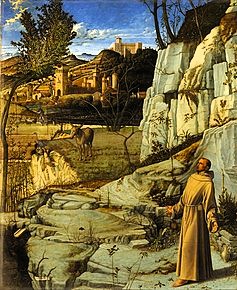
I finished my coffee and walked up to the nearby park around Villa Doria Pamphilj, with its meadows, pine forests and marble statues, all of which have lost their heads. I sit down on a bench overlooking the castle.
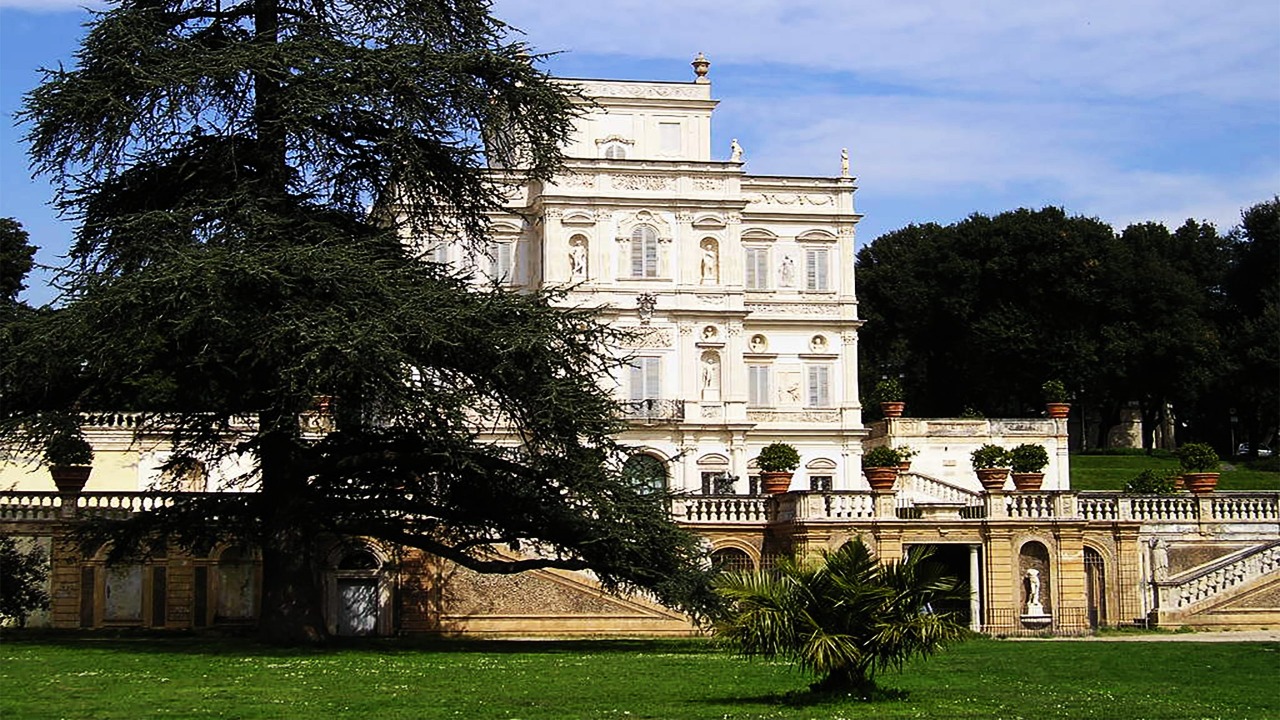
Warming my face in the sunshine before I took out the book I had brought with me in my coat pocket, Juan Mascaró's selection of Upanishads:
Like a falcon or an eagle, after soaring in the sky, folds his wings for he is weary, and flies down to his nest, even so the Spirit of man hastens to that place of rest where the soul has no desires and the Spirit sees no dreams.
What was seen in a dream, all the fears of waking, such as being slain or oppressed, pursued by an elephant or falling into an abyss is seen to be a delusion. But when like a king or a god the Spirit feels “I am all” then he is in the highest world. It is the world of the Spirit, where there are no desires, all evil has vanished, and there is no fear.
As a man in the arms of the woman beloved feels only peace around, even so the Soul in the embrace of Atman, the Spirit of vision, feels only peace all around. All desires are attained, since the Spriit that is all has been attained, no desires are there, and there is no sorrow.
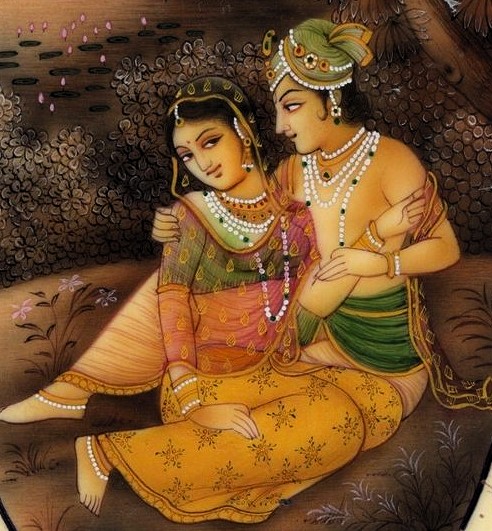
It is Yajñavalkya who, one thousand two hundred years ago, spoke thus to Janaka, the king of Videha.
As so often when I have read something thought-provoking, I closed my eyes and began to reflect upon what I had read. Recollections of Dark, a German TV series I had just seen, popped within my head. An extremely complicated story; a labyrinth of different time periods where characters and events changed, disappeared and resurged in an increasingly complicated merry-go-round that was to prove to be not so merry after all. However, towards the end, entanglements were to some extent dissolved and it was explained that everything has taken place around the nucleus of a time dimension symbolized by a triquetra.
This is the image of a kind of knot that has been cherished by modern New Age movements, but which origins are lost somewhere in the Bronze Age. The triquetra is by many considered to be an image of the junction between the past, the present, and the future, thus illustrating how these different aspects of time periods are intertwined.
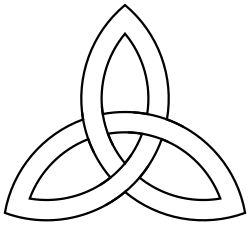
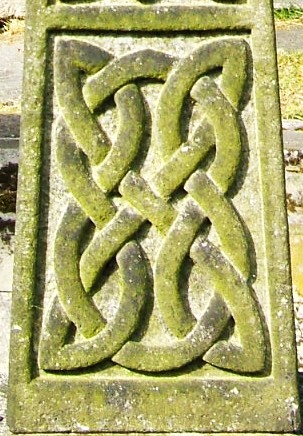
It was Ivan, the son of our Dominican friend Mayra, who recommended the series to me the last time we met. I have known Ivan since he was a little boy, now he is over fifty years old. We share an interest in horror films, for which he has a taste that is consistent with mine. Therefore, I trusted Ivan's judgment when he claimed that Dark was worth watching, especially as it provided him with an enriching view of time as an incomprehensible phenomenon.

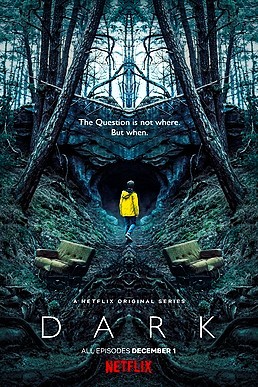
Ivan, this somewhat corpulent man with a beard, could it really be the same little menace I once knew and played with? Sure, I recognize him and we still get along well. But, nevertheless – the difference is evident. And what about 6me? Who am I compared to the man I was at the time when Ivan was just a little kid?
Thinking of my friends from the past. Some of them I haven't seen for years, mainly because I've often lived far away from them, in different countries. But, when I meet with my best friends from the past, it's as if time doesn't exist. We have just as much fun together as we had then... five, ten, twenty years ago, while other acquaintances that I have seen again have become total strangers to me. When I meet them, they might have been the same as before, I don't know, but they don't tell me anything. Some of them I found to be completely changed – often for the worse. And me? When I got to know Ivan ... and now. Is that the same man?


I sat on the bench in Villa Pamphilj's park and thought about time. There I was in the middle of the present, not knowing what would happen within a minute and with memories stretching far back in time, for certain encumbered with several incomprehensible gaps.
The future? Unfortunately, I knew some of it, especially unpleasantness like deadlines that have to be met – bills, doctor's appointments, repairs and other necessary expenses, a lot of misery that must be covered by a strained economy. However, there are also things that I can look forward to with joy. As my mother used to say when she lived alone in the loss of my father – “We must always have something joyful to look forward to.” She lived to be ninety-six years old, and kept her clear mind to the end. Nevertheless, the future is actually hidden from us, and there are for sure many unexpected threats to our wellbeing – at any moment I can be run over by a car, or suffer a fatal disease, not to mention a creeping senility and all the terrible things that might haunt my loved ones.
There on the bench, I asked myself the same question that people have wondered about for thousands of years – What is time? It amused me to think about all the things that time travel can mean and how it can mess up life – like in Dark and ... What is the human imagination not capable of? What a miracle is human thinking!
I looked at the book I was holding in my hand and remember how, many years ago, during lectures in Lund, I was gripped by mysticism, especially as it was presented by Indian wisdom teachers such as Yajñavalkya – that our perception of our self, of time, of our own existence, is just a chimera, an illusion. The result of limited thinking. We are in fact part of something much bigger than ourselves, than the world, something boundless, cosmically vast – like the drop of water compared to the Ocean.
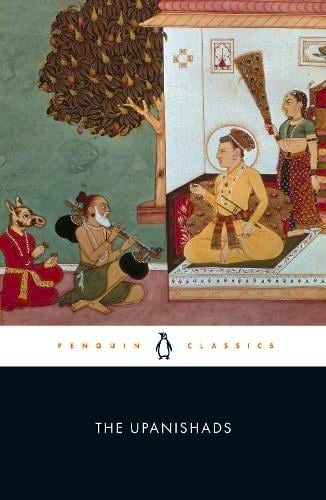
When we die, we merge into this ocean. Become part of it ... Like the drop of water when it is united with the sea, it is not obliterated, it continues to exist, but as an integral part of the boundless eternity. For me, it was a beautiful thought.Time is a natural presence – days pass by, the clocks tick on, our bodies are aging, reminding us of what we have done and what we have not done, what we should be doing and will not do.
As a former teacher, I know quite well that Time has a permanent home in language – present tense (is), past tense (was), perfect (had), past perfect (had been), future perfect (will have) and future perfect continuous (will have been). Through our ancestors' genes, time lives in our bodies and continues in our children. It is rooted in our brains, through memories that have characterized our lives – injustices we have committed and been subjected to; Triumphs and setbacks, an unhappy or happy childhood, bullying and admiration, discrimination and pampering. Time rests deep within us and characterizes our lives – the past, the present and the future.
Time is an essential dimension in the world of physics – length, width, height and time. Time controls the molecules and is found far out and everywhere in the Cosmos. It is integrated in both the small and the large. It lives within every being, within everything.
On my way home I watched the people pass. I had ended up in a strange mood. I knew that each person within him/herself carried his/her very own time dimension.Time is money!
Planes, rockets, subways, taxis,
there's no more rest, no more respite
Time to love? Man, you're dreaming!
Such is the law: run or die.
Time is money!
And the sun, it has to be disciplined,
it always wants to go to bed.
Hellish land, you have to curse it
if you don't want to spin faster!
Time is money.
And then he calmly and quietly celebrates love, closeness, community and nature. But once again, hustle and bustle break in.
I'm cautious.
empty promises aren't for me.
There's no merchant selling time.
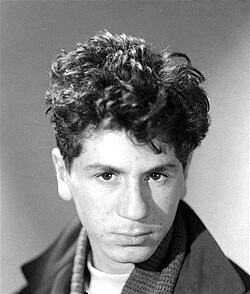
https://www.youtube.com/watch?v=Jt0kVkw9lvA
Time is constantly moving forward. It never returns. We cannot reclaim the opportunities we have allowed ourselves to miss, prevent the mistakes we have made, all the misery we have caused to ourselves and others. The Swedish poet Nils Ferlin wrote:
A crisis here, a crisis there.
Times they are so busy. —
The one you desire came for a visit.
Too bad it was for both of you.
She knocked — once or twice.
Put her ear against the door
No one was home. She had to go.
What else could she do?
https://www.youtube.com/watch?v=uKtwiYP60K8
Many of us, perhaps most of us, are excited and tormented by our individual time. Time seems to be something that we assume we own. We believe that we must constantly protect our cherished time, so that no one deprives us of it. Time thieves are plentiful; within our own family, in our workplaces.
And not the least, we steal our own time, waste it on unimportant things. Unforgettably expressed in Michael Ende's novel Momo or the Battle for Time, with German accuracy he gave his book the long title Momo. Die seltsame Geschichte von den Zeit-Dieben und von dem Kind, das den Menschen die gestohlene Zeit zurückbrachte, The Strange Story of the Time Thieves and of the Child Who Brought the Stolen Time Back to People. The child who in this strange novel takes back people's stolen time is the poor but positively cheerful and eccentric Momo, who single-handedly saves us from the devastating time thieves.
The parasitic Grey Men appear out of nowhere and deceive people by deluding them that they can become wealthy if they save their time in their Time Bank. A lie as good as the one that is constantly honked at us by the slippery henchmen of commercialism, who have deceived us into believing that everything can be measured and bought with money, not least time.
Get rich quickly and easily, without much hassle on your part. Give us what you have of your excess time and we will invest it and double its value. Everything has a value, even time – but let us take care of it all, you don't have to bother managing your own time.
The grey-clad, grey-skinned, bald non-people claim to represent The Time Savings Bank, an institution that provides "time savings" – Time deposited in this bank can then be recouped with interest. Fast cash!
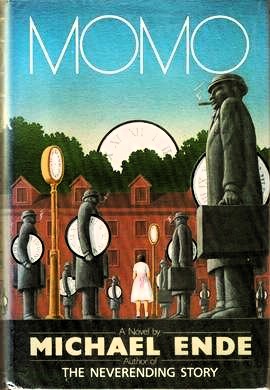
And people give the grey men their time, believing that at a later date they can regain an increased time. Soon life where the Grey Men have ravaged becomes sterile. They have stolen all “wasted” time — pastime, distraction, relaxation, amusement, art, fantasizing, daydreaming, strolling, rest, and sleep. Everything has become grey and uniform, levelling has spread like a deadly plague and transformed the lives of time savers; devastated colour, joy, imagination and love. Time, like art, has acquired a false, commercial value.
The Grey Men say they are paying for and managing time. However, they are con men. There is no Time Bank. The Grey Men turn our time into the grey cigars they constantly smoke in order to exist, and the more time that is stolen from us, the more the Grey Men proliferate.
Nevertheless, everything is a chimera. Momo is a fairy tale and just as true as Hans Christian Andersen's The Emperor's New Clothes. In Ende's novel, it is Momo who, finally, like in Andersen's fairy tale, reveals that "The King is naked" and thus makes people realize that saving time is a gigantic lie that has robbed them of life itself.
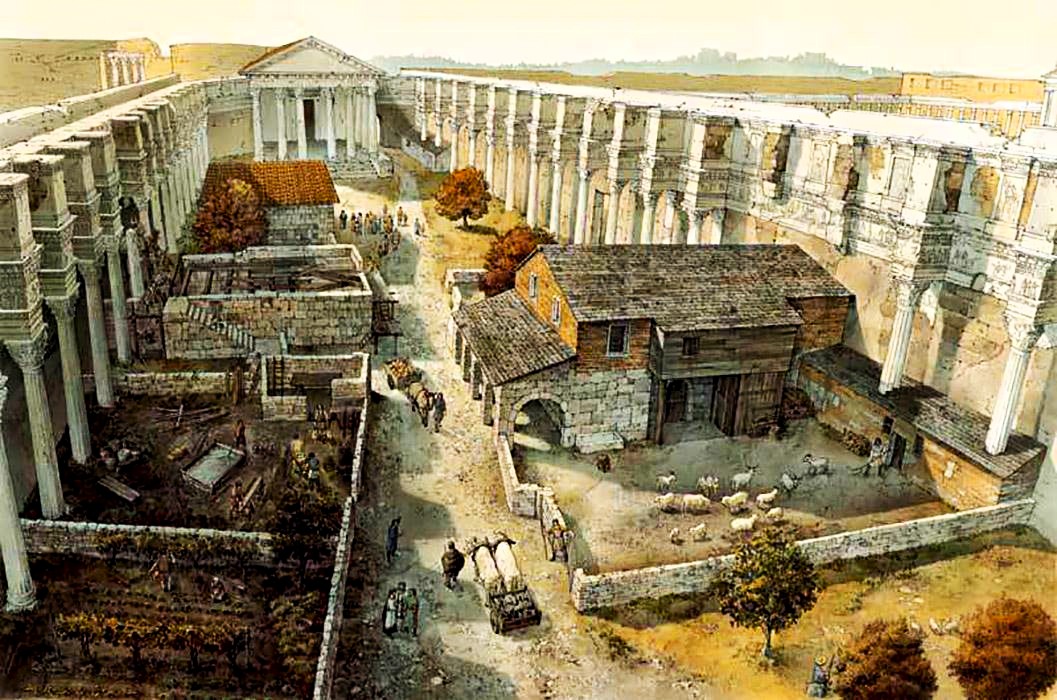
Momo is set in Italy and as I am walking home, I think that this country is the right place for such a fantastic story. Here in La città eterna, the Eternal City, people have during millennia come from all over the world and created a unique culture, so distinctive that it seems as if the entire city lives and breathes by and for itself. It as if it has turned itself into a giant organism. Here, buildings from different times have been built on top of and next to each other. If you during the night walk through the deserted places of Rome you will find that you are walking through and across time. Under your feet rest catacombs, temples and churches, and the miasma that has been gathered there rises up to the surface. The city tells you its stories and legends.
Time lives not only within us, but also outside of us. I realize it when I get home and step into a basement space that I have covered from floor to ceiling with my books. Some of them have already opened up themselves to me, others are waiting to do so. Down here rests the past, present and future.

In the world of books, I can travel back and forth in time. I also have the opportunity to return to books I have read (something I am currently engaged in) and then find that they, like me, have changed. On several occasions I have reread a book and found it to be quite different from when I first read it – either better or worse, or maybe simply ... different. I read somewhere that William Faulkner was once asked which three novels he had found to be the most fascinating. He replied "Anna Karenina, Anna Karenina, Anna Karenina". "But, it's the same book!" "I've read the novel three times and each time it was different."
Books are both frozen and living time. You ... my reader, you are right now in a different time dimension than I am, the one who is just now writing these lines. When you read my text, it is already written, aged. You are in my future and I am in your past.
Reading a book about a bygone era makes me think of my youngest daughter, who is an archaeologist. Archaeologists visit times gone by. In one of his novels the subtle Polish science-fiction writer Stanislaw Lem combined books and archaeology. Memories found in a bathtub begins when future archaeologists have found a diary thirty centuries after it had been written. It is believed to be the only known trace of a human hand left on paper.

When they have, with the help of the sophisticated machinery which are at their disposal, succeeded in translating the ancient and forgotten text, it turns out that diary was written by the end of the twentieth century, i.e. some thirty years after Stanislaw Lem wrote his novel. The diary was written under a military dictatorship harassing its citizenry with an extremely complicated bureaucracy, during which although it had begun to use what the future archaeologists designated as "electronic brains", almost all vital information had been “papyr-based”
Like so many other novels set in a distant future, a catastrophe had taken place. In this particular case, it was a chemical chain reaction that caused an almost immediate worldwide decay of a material that had been
"whitish, flaccid, a derivative of cellulose, rolled out on cylinders and cut into rectangular sheets. This papyr was almost the sole means of recording knowledge and contained information of all kind, impressed on it by dark tint."
All papyr-based archives were wiped out. At that time, there was no mnetamnetism or technology that could crystallize information. Panic broke out when people lost their identity through the erasure of paper and were thrown into a state of complete anarchy, when all bureaucracy and construction activities collapsed and citizens abandoned decaying metropolises. A long period called The Chaos began when ignorance and superstition took hold of almost everyone.
Before the catastrophe had taken place, the nameless diary writer, who every night had written down what had happened to him during the day. This had been done in a desperate attempt to maintain his sanity. Just before the disaster took place, he had hidden his manuscript under a bathtub. Since the unknown writer lived under a ruthless military dictatorship, which tried to keep every citizen under its surveillance, the unknown secret service agent had been afraid that his diary writing would be revealed.

The young man had been given a secret mission. Everything within the huge Headquarters was secret, General Kashenblade had informed him:
Your mission. Conduct an on-site investigation. Verify. Search. Destroy. Incite. Inform. Over and out. On the nth day, nth hour, sector n, subsector n, meeting with N. Stop. Salary group under the cryptonym Bareback. Unlimited oxygen voucher. Payment by weight for redundancies and sporadic notifications. Report regularly. Your contact person is Pyra-LiP, your cover Lyra-PiP. In case you fall in battle, posthumous decoration with the Top-Secret Order, complete honour, salutes, memorial plaque and a written recommendation in your dossier. Any questions?
The poor recruit cannot obtain any clarity about what his mission really involves. Everything is secret. In his search, he is shovelled from one office to another, all with strange designations in the form of inscrutable abbreviations. Occasionally, he is presented with forms that must be filled in and handed over to secretaries who only act on orders from top managers and do not concern themselves with anything "below their competence".
The diary writer finds that that the best way to move between offices and different destinations is to slip in where doors are open and where you are not asked about anything. In this way, for example, he comes to the "library", buried down deep in the office labyrinth – a room cluttered with dusty, greyish volumes, densely arranged on sagging shelves. A bald, wind-eyed old man with a trailing gait shows him, under the few, naked light bulbs, one foul-smelling volume after another, while muttering "a splendid work . . . brilliant." As the young agent stumbles out of this "paranoid nightmare", he feels as if he has left a slaughterhouse.

The narrator in Lem's novel is a diary writer and a diary is undeniably a time machine that takes its reader back in time, and so are old letters, photographs, discoloured home movies, biographies and autobiographies.
Several years ago, when I was studying literary history, I was told by one of the lecturers, Erland Lagerroth, that novels involve a process. I was annoyed by that assertion it was too banal for my taste. Maybe I misunderstood the whole thing, probably it meant that in a story one event follows another. And it can certainly be like that. The reader is wondering "and what happened next". That kind of wonder drives the stories forward and maintains the reader’s interest. It is easy to understand how the murderous king repeatedly postponed Scheherazade's execution in order to hear the continuation of the story she had not been able to finish when the day dawned. A Thousand and One Nights has certainly remained my favourite reading. It contains the entire fascination of storytelling, and with delight I often return to its stories.
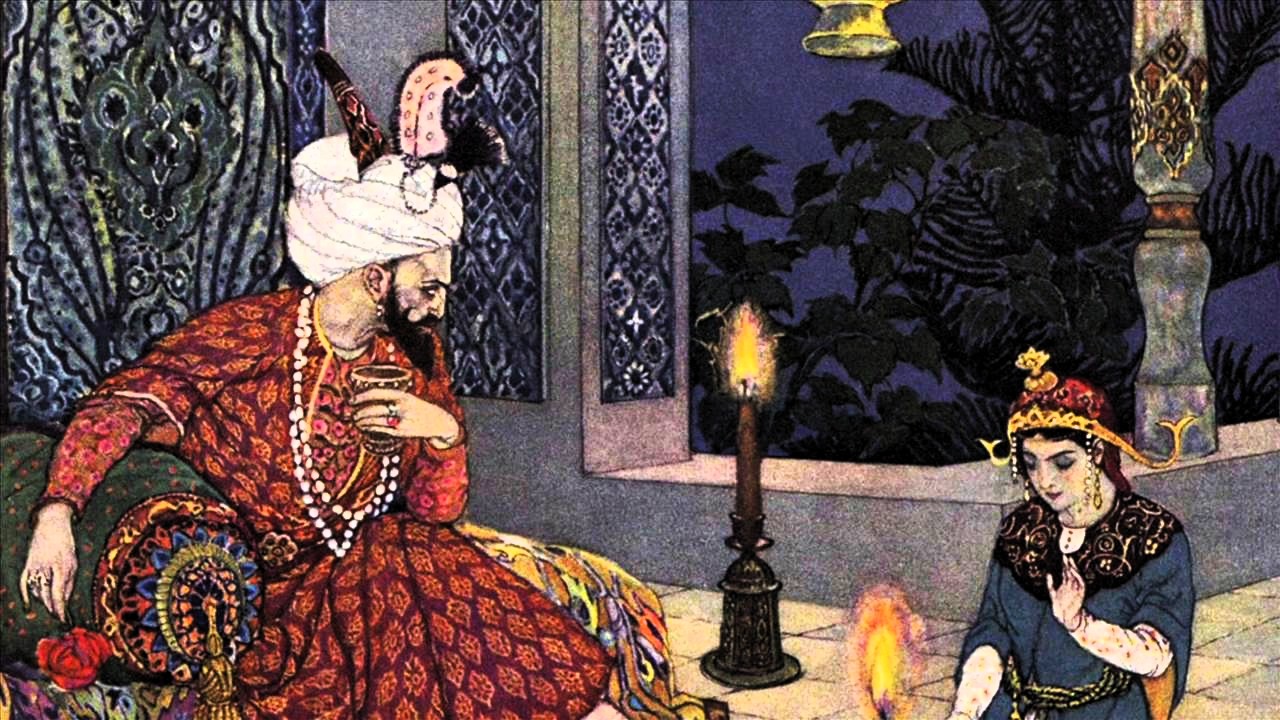
Books include their own time and an author is free to play with and manipulate the process of storytelling, but not to such an extent that the it becomes incomprehensible. An annoying example of this is James Joyce's Finnegan's Wake, which is incomprehensibly acclaimed by some connoisseurs. There have been times when I have tried to read it – a completely unnecessary effort. I could have spent my time better by reading other books worthy of the effort, than tormenting myself with that misery.

I remember how during my high school years I was fascinated by Lawrence Durrell's Alexandria Quartet, written between 1957 and 1960. The quartet's first three books depicted the same sequence of events, but from different points of view, which meant that the portrayal of the main characters in one novel shifted in such a way that they became secondary personalities in another. Based on the timespan depicted by the first three parts, the fourth part of the quartet moved the plot forward.
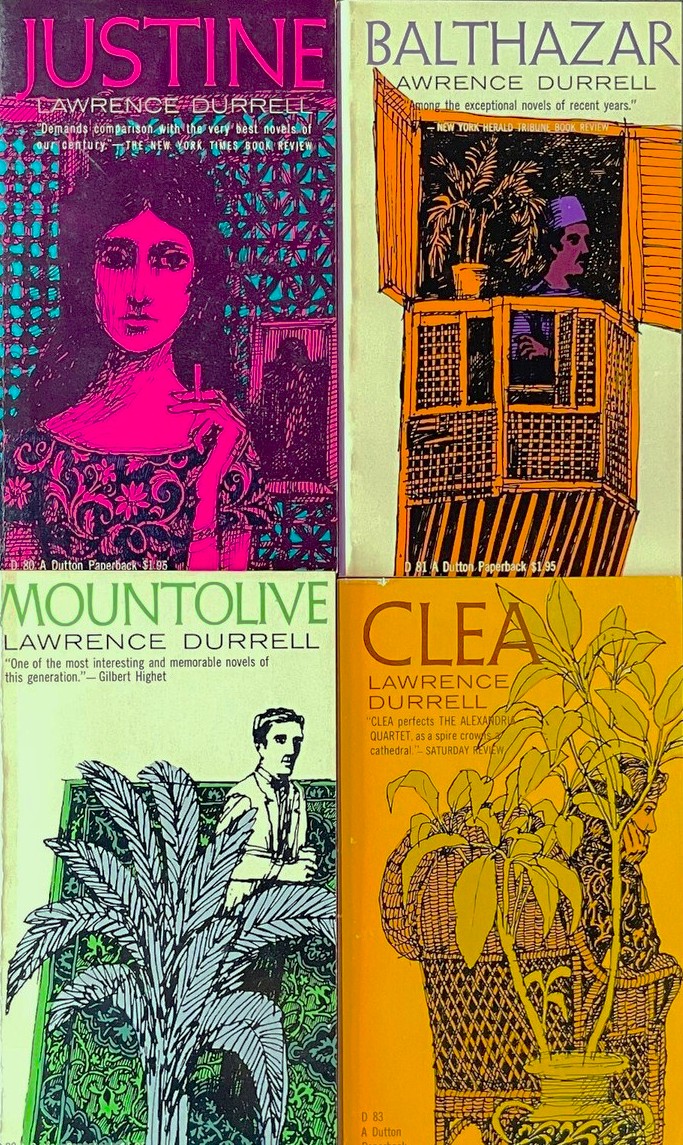
I recently reread Faulkner's Absalom! Absalom! from 1936 and found it even more complicated and stranger than Durrell's novels. Here the story emerged in a different manner. The narrator's voices are further complicated by the fact that they flow back and forth, while other voices come forward and recede, mixing together in a constantly changing landscape where even the resolution/final interpretation of the sequence of events becomes uncertain.
The reader senses the connections, but is forced to reconcile the different versions and voices without the author's help. However, it becomes abundantly clear that the historical depiction of a microcosm exposes the American South's dark legacy of racism, feelings of inferiority, shattered dreams of success, class thinking, slavery, and desperation, all within a framework of decay, violence, war and murder. A picture of a slice of time more than a process.
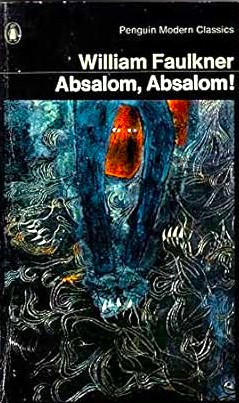
Absalom! Absalom! illustrates perfectly what the Italian Italo Calvino, a writer who also played with time and space, stated:
The time dimension has been shattered, we live and think in time The dimension of time has been shattered, we cannot love or think except in fragments of time each of which goes off along its own trajectory and immediately disappears. We can discover the continuity of time only in the novels of that period when time no longer seemed stopped and did not yet seem to have exploded, a period that lasted no more than a hundred years.
Calvino does not specify which hundred years he is alluding to. When they started and ended. He probably referred to the age of realist/naturalistic novels, as he had shown a great appreciation for what some writers had created before them – Homer, Ovid, One Thousand and One Nights, Ariosto, Cervantes, Cyrano de Bergerac, Defoe, Sterne, Diderot.
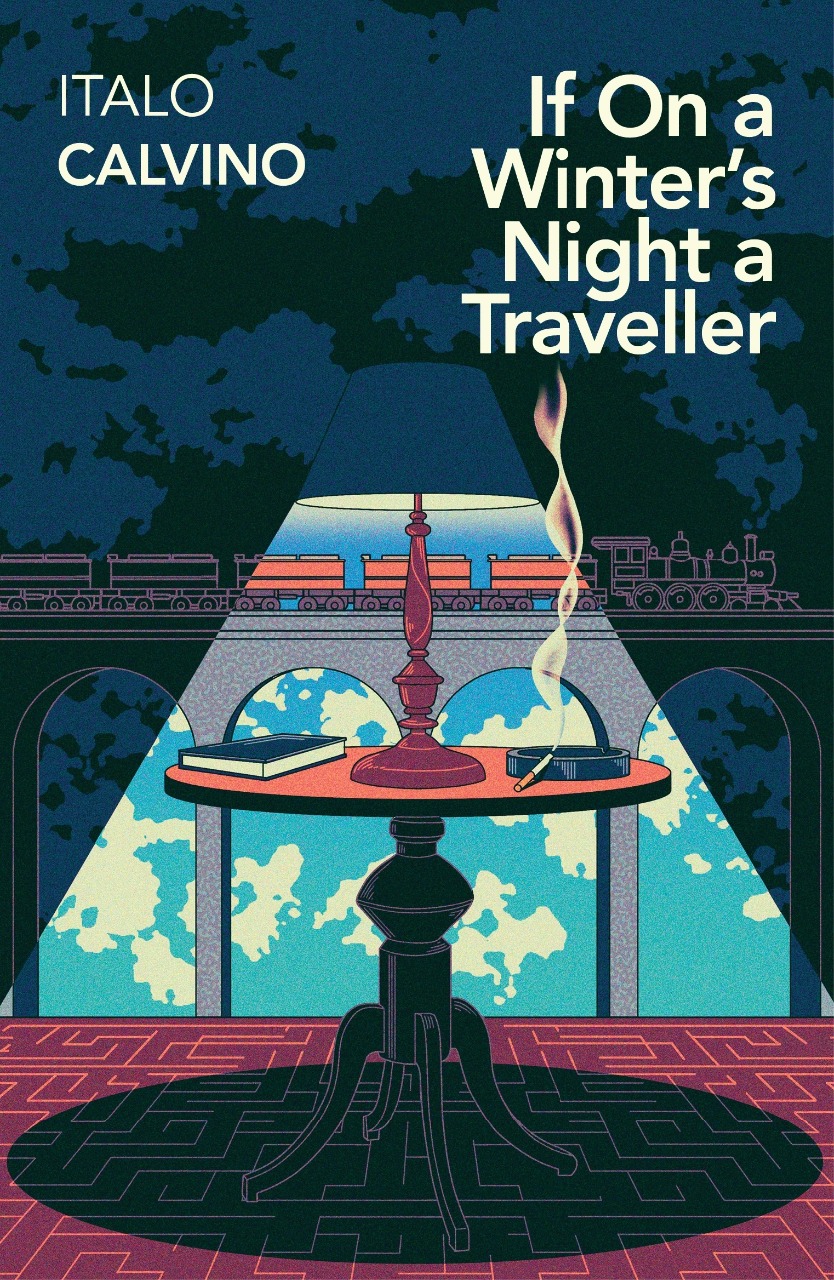
The quote above comes from the introduction to Calvino's novel If on a Winter’s Night a Traveller from 1979. A novel that dealt with the mystery of reading and dealt with the parallel worlds of novels and other stories. How an author like a magician can hide his tricks up his/her sleeves. In the first chapter, Calvino urges the reader to make him/herself comfortable, shut the door for the outside world to become immersed in the story that is about to begin:
In a small town a traveller sits on a winter night in a station bar. He has his suitcase next to him, maybe he is waiting for someone. In the chilly, smoke-filled room, he suspects the locals are critically examining him. Closing time is approaching and he is asked to leave the premises.
It now dawns on the reader that this is far from being an ordinary story. The author turns to him and reveals that there is an error in his book copy where the introductory section is followed by a story taking place in a Polish provincial household. The reader, who has now become part of the story, is forced to return to the bookstore to complain and then receives a new copy, while at the same time he is getting acquainted with Ludmilla, also known as the "Second Reader", thus a chaotic journey commences through literature and across the world. We are completely in the hands of the narrator, who provides us with ten chapters from ten different books, each and every one quite unlike the others, while we are taken different parts of the world and end up in unfamiliar, ancient and possibly fictional lands.
When the reader assumes s/he has got some kind of grip on the text, s/he is forced back from the bookstore to the publisher, from the publisher to a university professor, who turns out to be an expert in literature from an extremely small language area. The versatility is almost incalculable, we have ended up in Kathasaritsagara, a Sanskrit word that means something like "The ocean into which the rivers of stories flow".
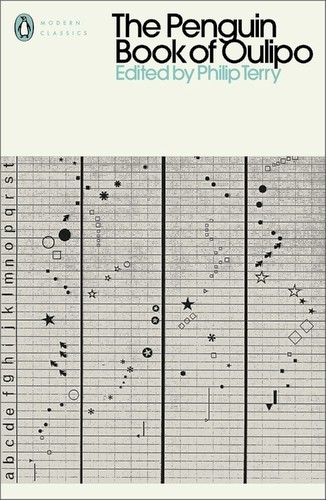
Italo Calvino was a member of Oulipo, Ouvroir de littérature potentielle, roughly translated as Workshop for Conceivable Literature. A loosely organized association with mainly French-speaking members, though also with corresponding Latin Americans, English, Scandinavians, Italians, etc. Particularly prominent at the movement’s pinnacle were the novelists Raymond Queneau, Georges Perec and Italo Calvino, but also several poets and not least mathematicians have been and are outstanding members. Oulipo still exists.
Within Oulipo, people gathered around literary games in which, with the help of rebuses, mathematical problems, the exclusion of a certain letter, card games, drawings, and a variety of other methods, they searched for new structures and patterns that could be used by writers "in whatever way they thought suited them". Queneau described the Oulipians as "rats who construct the labyrinth from which they planned to escape."
The playfulness of the Oulipians can sometimes be quite fun and stimulating, sometimes a somewhat too cryptically strained, although one of their rules is to avoid incomprehensibility. The writings of several earlier, distinctive writers such as Swift, Rabelais, Lewis, Carroll, Raymond Roussel, Homer, Jorge Luis Borges, Erik Satie, Alfred Jarry, and even authors of sacred writings such as the Bible, are with Oulipian admiration characterized as plagiat anticipé, anticipatory plagiarism.
I stayed in the basement and put on a CD (I also keep a lot of CDs and DVDs down there) on which the violin virtuoso Nigel Kennedy together with the Polish Yiddish trio Kroke Band played Time 4 Time, which introduce a trotting rhythm over which a painfully sentimental gypsy violin floats and languishingly sweeps forward, all the time with the roaming beat beneath it, as if to conjure up a vision of a gypsy caravan moving across the puszta. The timeless rhythm of nomadic peoples traveling across Asian steppes or African deserts, above which a star-studded firmament arches and tells them about time and travel direction. Finally, the CD explodes in Kukush, a loose, unbridled extravaganza, but with an unfailing, underlying and captivating rhythm beneath Nigel Kennedy who on his electric violin approaches a Jimi Hendrixesque improvisational ecstasy.

https://www.youtube.com/watch?v=e33gPMdasVE
Music as living time; intangible, instantaneous, captivating and yet bound within a fixed set of rules, which in spite of their strict framework provide seemingly endless possibilities for improvisation. However, every misstep might give rise to fatal dissonance, as when mathematical formulas collapse through minor miscalculations.
In addition, music is timeless. I can, whenever I feel like it, put on a CD with music by of Palestrina, Bach, Schönberg, or Vivaldi. It was different in the past – when, provided you belonged to the wealthy classes, could only enjoy a Beethoven symphony once in a lifetime. Music is for me as inexplicable as quantum mechanics.
At the end of his Tractatus Logico-Philosophicus, which I have difficulties with understanding, Ludwig Wittgenstein wrote the well-known phrase "Of which one cannot speak, one must remain silent". For most of its readers, this has meant that problems connected with ethics, the meaning of life, human existence, and other metaphysics, lie beyond the boundaries of language and therefore cannot be expressed through words, logic, or other factually based knowledge.
But... since Wittgenstein nevertheless approached metaphysics by a variety of means, one might interpret his quoted statement as referring to certain aspects of reality that are ineffable since our language is far too limited and thus insufficient. It locks us into predetermined, paralyzing ways of thinking, and within such a difficult conundrum we find a concept like "Time".
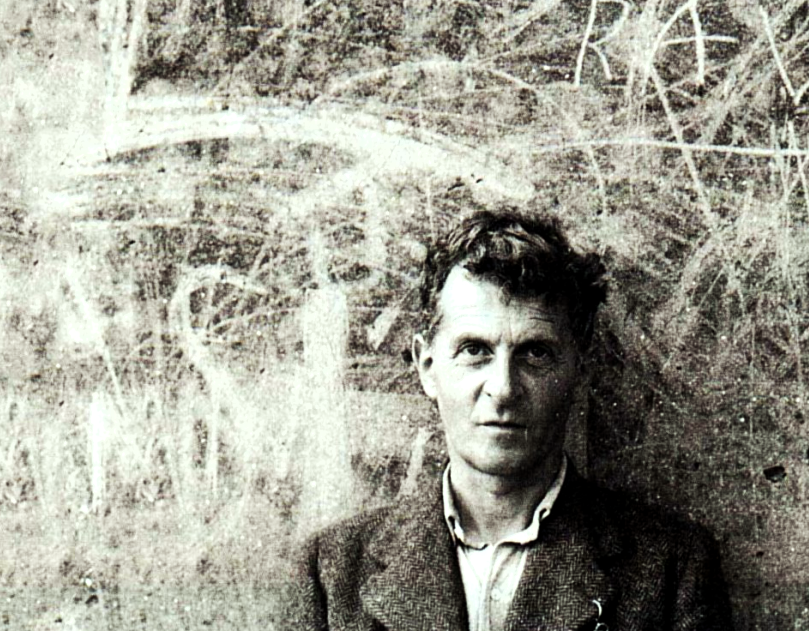
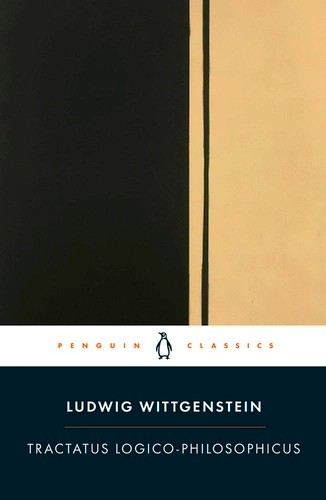
So... Maybe I should keep quiet when I try to express my thoughts about the time. But still, I use my writing mostly for myself. What does it matter if I am wrong while moving in metaphysical areas? First of all, för me it is a pleasure to write and I also use my writing to capture and try to find out something about my often swirling thoughts.
I ask myself what the three dimensions – length, width, height – would be without the influence of time – if not stagnant and dead? It is time that gives them life. Time drives the dimensions to the right or left, up and down, in and out, back and forth. It has been written and said that time does not exist in itself, only in relation to events or objects that already have been set in motion. But? Would they have been on the move without the time? I don't know. I'm not a physicist. Mathematics has always been a closed space for me. I've tried, but never found the keys to it.
However, I have learned that Hindu philosophy equates movement with life. Life and movement arise through karma, which briefly might be said to equal the law of cause and effect. If karma ceases to work, time is transformed into eternity—it becomes dormant in itself. But before that, Saṃsāra prevails – the cycle of existence, the ticking circle of life, manifested in Shiva's cosmic dance that simultaneously creates and destroys.
.jpg)
Shiva Nataraja, the Lord of Dance, expresses through his violent performance creation and destruction, prerequisite for life, but also its balance, protection and preservation.
With his long hair swaying in the frantic tempo of the dance, Shiva accompanies himself with a drum that he holds in his right hand; the rhythm of life, the beating of the heart, the pulse of life, the eternal cycle. In his left hand burns the fire of destruction – no life without death. But, Shiva has four hands. The third he raises in a sign of peace, with its palm open to the viewer Shiva seems to say: "Be calm, I move. I live, you shall all live." His fourth hand is directed at his raised leg – "I move, life goes on and I watch over you. I who am one with the All; man and woman, day and night, the time that incessantly moves us on.
Everything is in balance; Shiva's dance may be excited and seemingly unbridled. Not at all – it moves within a fixed framework, the cosmic rules. He steps on the god Apasmara, a child with a moustache, the demon of ignorance, whose pathetic knife is ignored by the dancing World Ruler who keeps his gaze fixed upon us: “Don’t you realize that I am identical with the absolute balance of Universe? Everything is indeed moving; time, atoms, planets, galaxies. Through my cosmic dance everything is held in place, time binds chaos, everything is in balance, the energy is constant, although changeable, it moves within the given framework of the Cosmos.”
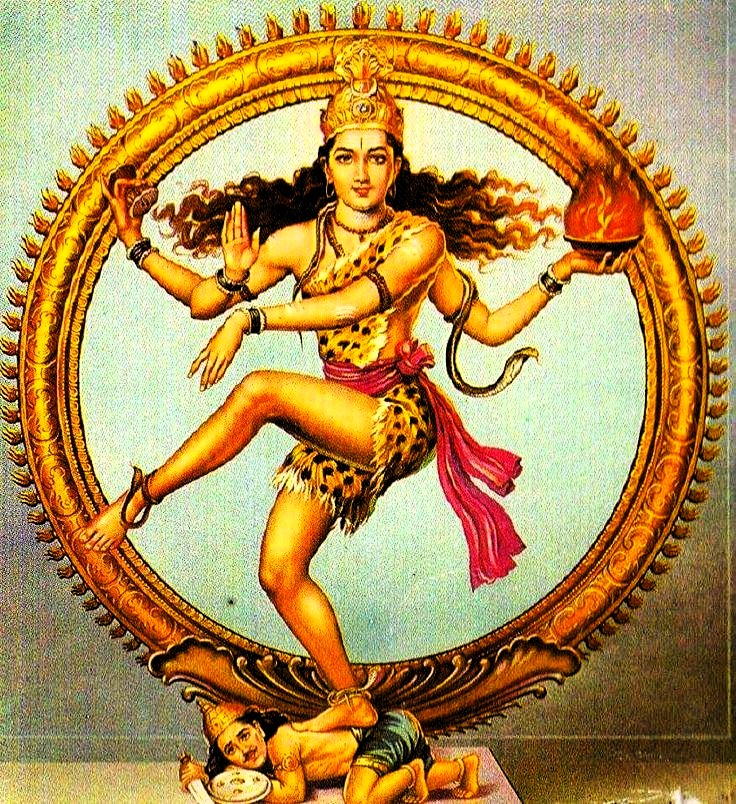
Time is thus linked to movement. Something that I experienced when I in my youth worked as waiter on the trains between (mainly) Malmö and Stockholm. A journey that took between five and seven hours. However, the movements of the trains meant that the working day did not feel like it was measured through some abstract time, linked to the circular movement of the hands over a dial, Instead, the passage of time corresponded to geographical stretches – Malmö-Hässleholm, Hässleholm-Växjö, Växjö-Nässjö, etc. By looking out the window, I got an idea of the passage of time.
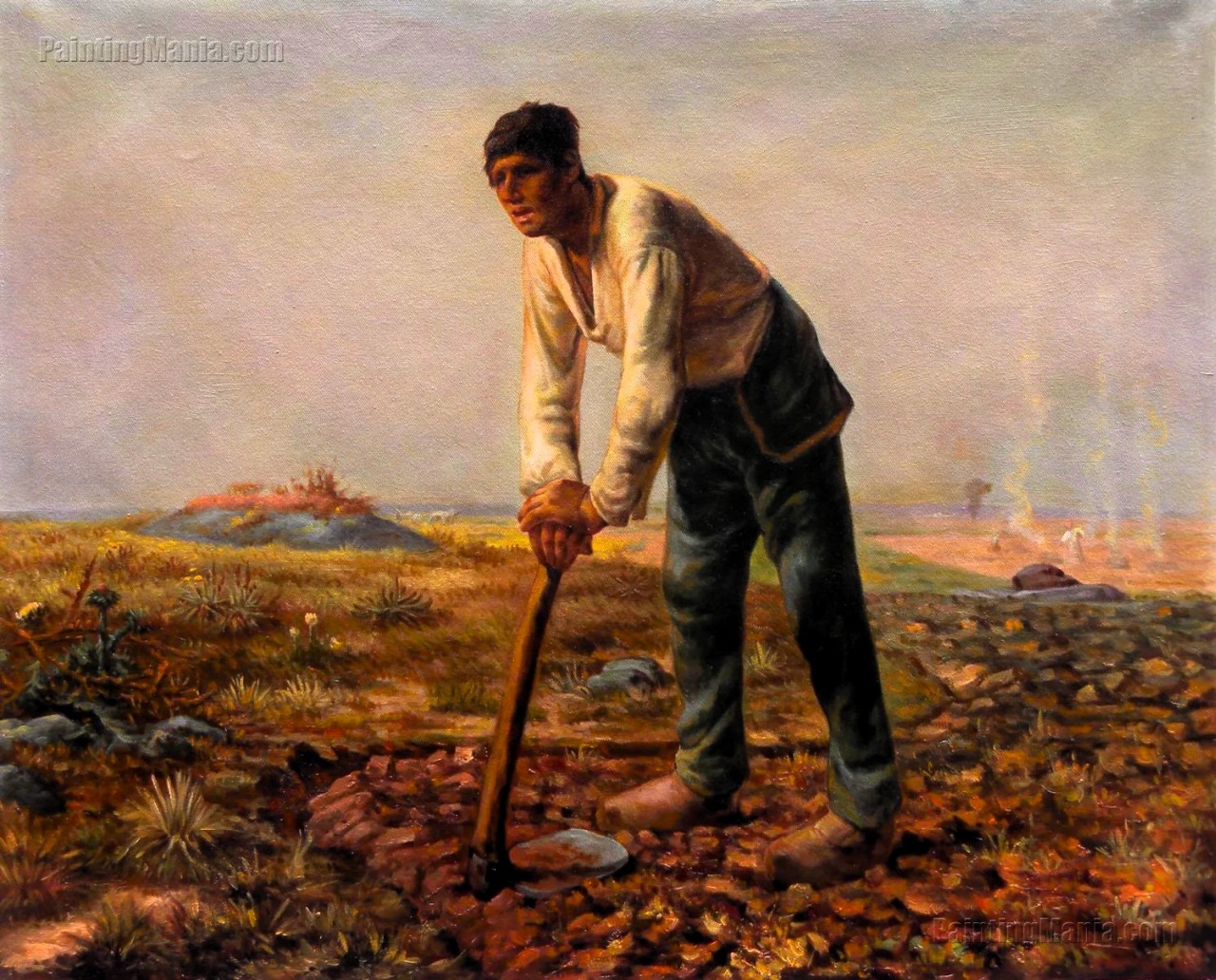
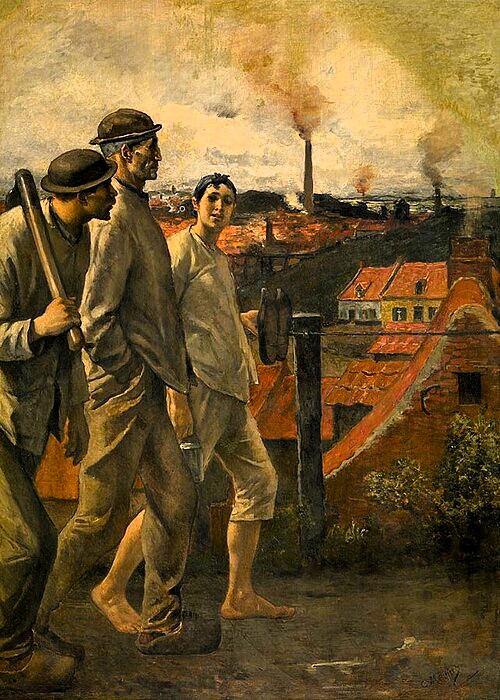
I would think that a peasant used to consider time as a movement between dawn and dusk, between spring and winter, reflected by the sun's journey across the sky. The time used to be something different from what it is now. Authorities tried in their own way to discipline people's consciousness of time, first with church bells, then with the help of factory whistles (time is money) and over time through increasingly sophisticated methods, from punch clocks onwards.
But where does time lead us? As new findings come to light, science becomes more and more complicated and hopelessly incomprehensible to an amateur like me. Perhaps this is what Nobel Prize winner Richard Feynman meant by stating that the ideas born through quantum/electrodynamic discoveries cannot be perfect. They are rather models and thus not identical to "reality", which continues to be beyond human comprehension and perhaps will continue to be so.
Einstein considered "time" and "space" to be concepts we use for our thinking, for the development of a reasonable theory. Theories that to some extent might be mathematically and experimentally proven, but that does not mean that mathematically conditioned models govern our way of living and perceiving the reality that surrounds us. Quantum mechanics tells us that the exact position and state of particles can never be completely known, uncertainties are and remain an integral part of Creation. Nevertheless, scientific discoveries point to a direction, and might describe a physical reality that over time will become increasingly sharp and thus change the lives of all of us.
An influential mathematical model is the so-called spacetime, which combines space and time into a single interwoven state, a continuum, i.e. something that has a spread in space and which in theory can be divided into infinitesimal parts. It was Hermann Minkowski, who had been Einstein's mathematics teacher during his time in Zurich, who created the concept of spacetime as an attempt to support Einstein's theories.
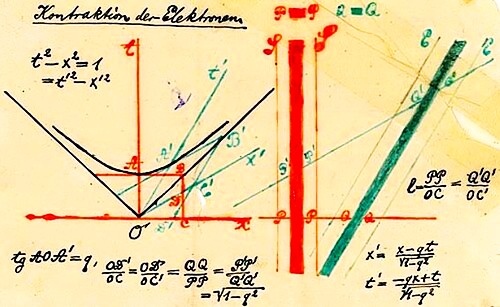

Einstein and Minkowski shared a desire to use abstract mathematics as a means to describe and possibly transform our perception of the nature of the Universe. They have succeeded to the extent that their mathematical models now have been refined and also largely experimentally proven. However, question marks remain, one is whether mathematicians like Minkowski and Einstein really believed that we live within a space-time with all that would imply for our everyday existence, for our perception of time, for our faith. Einstein also had his doubts about the applicability of Minkowski's mathematical models. He called them überflüssige Gelehrsamkeit, superfluous learning.
When Einstein's close friend, the engineer Michele Besso, died, he wrote a letter of condolence to the deceased friend's family. Ever since they had studied together at the Zurich Polytechnic Institute, Einstein and Besso had been close. Besso was not only Einstein's friend, but was also an understanding man with whom he could openly and on a completely different level from what he did his fellow scientists discuss both life issues and science. Einstein wrote:
Now he has preceded me a little in parting from this strange world, too. This means nothing. For us believing physicists the distinction between past, present, and future only has the meaning of an illusion, though a persistent one.
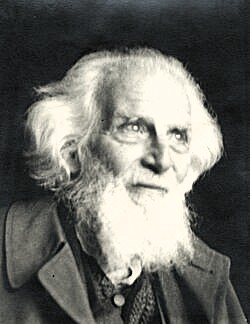
I don't understand much of all these scientific theories about the relationship between space and time, my ignorance makes me think of the science fiction author Robert Heinlein's short story By his Bootstraps , whose main character.
had as much chance of understanding such problems as a collie's perception of how dog food ended up in cans.
However – a growing confusion and uncertainty leads to revisits to things that are still considered self-evident, for both the common man and scientists. For example, that time moves inexorably forward. It cannot be reversed, something that has led several scientists to speak of the "arrow of time".

Where time moves is however an unsolved riddle, one seems to indicate that the speed of the "time arrow" is changing, it is assumed that it is slowing down and that all of the Creation is moving towards Entropy. Matter changes, falls apart; metal rusts, rocks wear down, organisms age and rot away, stars and galaxies die. The energy is certainly constant and indestructible, but it can be dispersed into smaller components. And then?

Several Hindu philosophers imagined the Universe/Brahma, as a vast organism that breathes; inside out. Scientists assumes that the Universe was once born – The Big Bang, when particles from an exploding centre were thrown in all directions crating a Universe that demonstrably still moves outwards from a core, until the movement eventually slows down.
For some Hindus, it is obvious that every tiny part of the Cosmos is part of this vast spectacle. The Maitrayaniya Upanishads, possibly finding its origin around 500 f.Kr, stated:
There are certainly two forms of Brahman: Time and Timelessness. That which precedes the Sun is Timelessness, perfect and indivisible. But what started with the Sun is Time, and it can be divided.
Brahman can then be considered timeless – eternal. This while earthly life is dependent on the sun and thus associated with man's concept of time; day follows night, the passage of months, the changing of the seasons, are all phenomena connected with time in its form of motion. The universe also moves, but it is a different form of movement – more like exhaling and inhaling, heartbeats. The cosmos is by Hindu philosophy likened to purusha and is then described as having a human shape. Human beings are like mirror representations of the cosmic purusha, though subjects to a different time than this enormous assembly. We humans are slaves to the time of the sun, while he time of the universe is the breath of Brahman.
What happens to matter and time when entropy finally strikes and the outward movement of the Universe slows down and ceases? Where does it all go? Perhaps it falls back to its origins, to a point that then becomes so compact, so bursting of compacted mater that it cannot hold all its parts together. The result – a new Big Bang. An endless pulse movement – Brahman breathes. Again – what do I know? I am not a scientist, not a physicist, no logician. I cannot even count, only the most basic algebra.
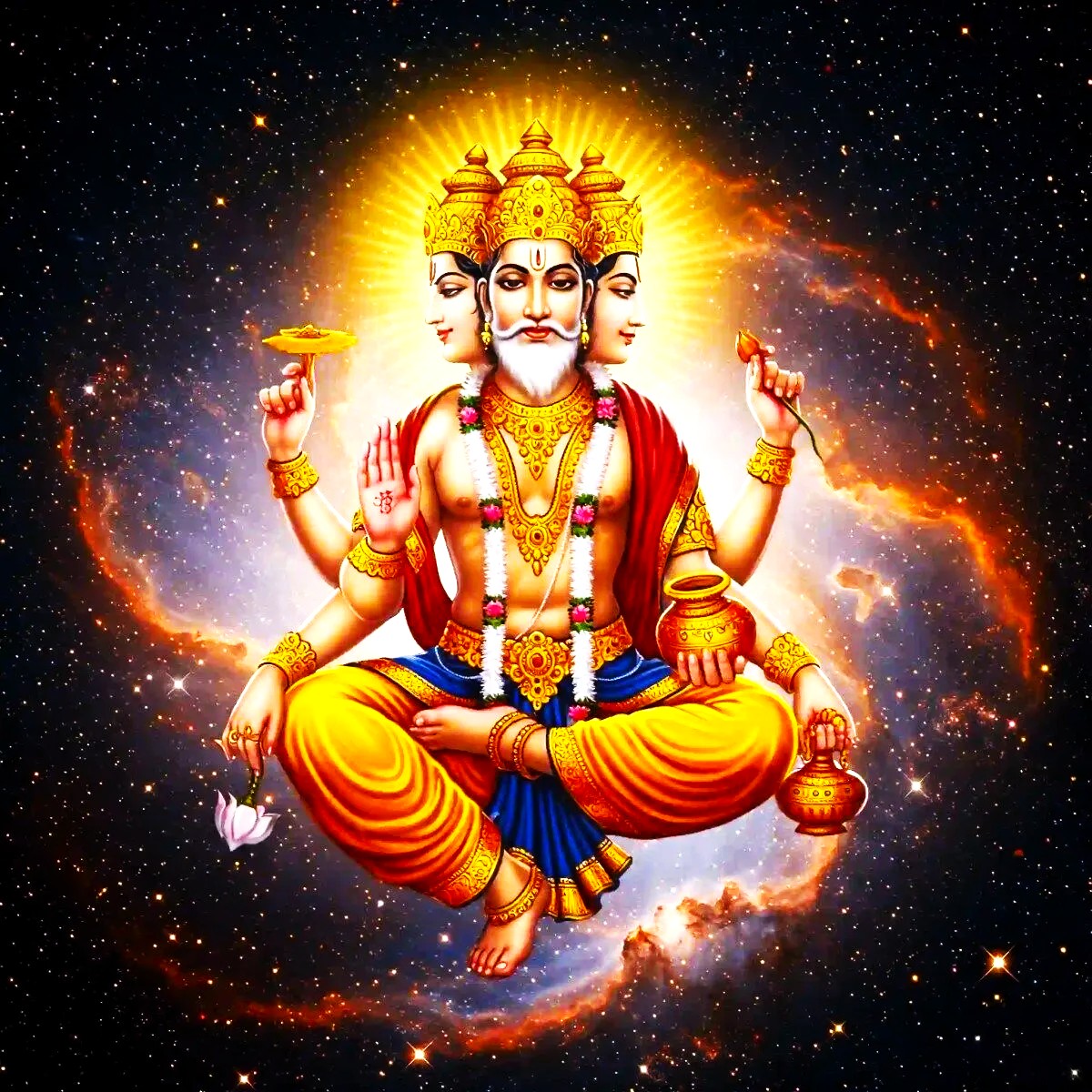
Sophisticated Eastern philosophy, such as what has thrived within Hinduism, Buddhism, Confucianism, and Taoism, tends to be more cyclical than the tradition inspired by Judaism, Christianity, and Islam. These so-called Abrahamic religions have a more linear concept of time, with a beginning and an end. A way of thinking that easily leads to a progressive view of existence, that one thing leads to another, but not as in the concept of karma in a cyclical movement, but towards an end goal, happy or unhappy depending on which individual you are born to be.
Virtually all ancient Greek philosophers believed in development in the sense of "progress" as improvement. In other words, a temporal movement towards what was perceived as a more refined, improved and universally desired stage of well-being. True, just as nowadays, it was written nostalgically about the fact that there had once been better times – a golden age when people were happier, just as Jews and Christians could imagine a perfect Garden of Eden. The Jews and Christians wrote that human's sin drove them out of this Paradise, while the ancient Greeks seem to have considered it to have been man's arrogance, a belief in his own great ability, hubris, that caused him to leave an original state of innocence and simplicity.
The Greeks, however, seem to have perceived this "golden age" not only as a glorious time, but also as a somewhat brutal time, in the absence of many of the comforts available to the Greeks in their present day – a "civilized" existence.
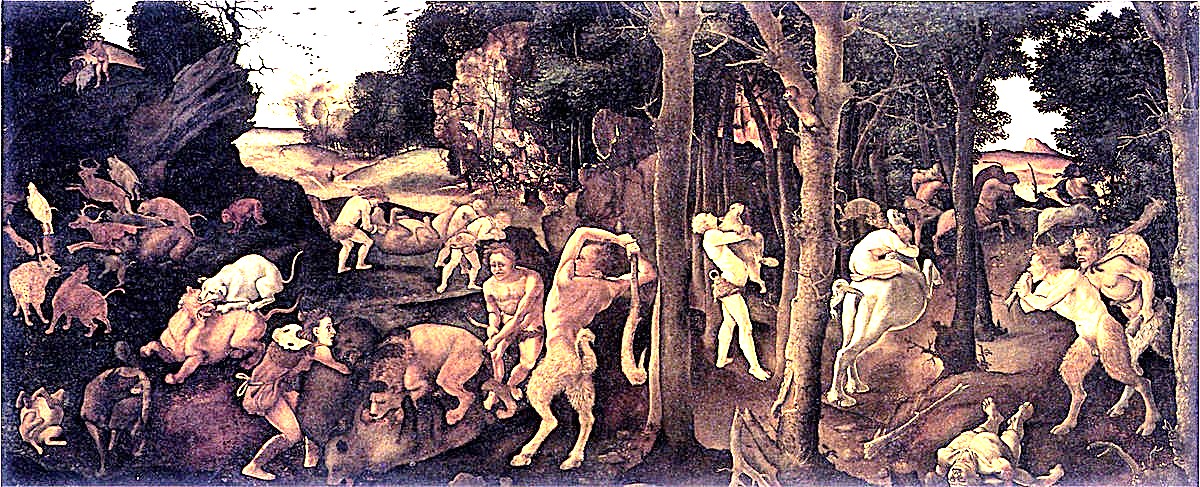
There were setbacks – war and plagues – but as the Roman poet and philosopher Lucretius wrote, we are moving pedetemtim progredientes, step by step, towards a better future, a concept that in English has become progressive time. It seems that most cultures, whether they have a cyclical, or a progressive perception of time, have their own cultural heroes. That is, mythological heroes, or sometimes even godlike figures, who through discoveries and inventions managed to change the world for the better, often against the will of the gods because these believed that preserving the status quo benefited their power.
A cultural hero/heroine could, for example, have brought fire to people, taught them agriculture and cattle husbandry, given them songs, dance and other cultural expressions, created new traditions, instituted laws and religious practices, etc. It seems that almost every known cultural circle has had one or more cultural heroes. They are not always people; they could also be talking animals. To show how common they are, I can mention a small number of those cultural heroes that exist among different peoples.
The Greeks had their Prometheus, Aztecs Quetzalcoatl, West African Ashanti – Anansi, Irish Celts – Cú Chulainn, Australian Aboriginals – Bunjil, Chinese – Fuxi, Finns – Ilmarinen, Inuit – Apanuugak, Lakota Sioux – Iktomi, Sumerians – Gilgamesh, Polynesians – Maiu, Tibetans – Gesar, etc., etc.
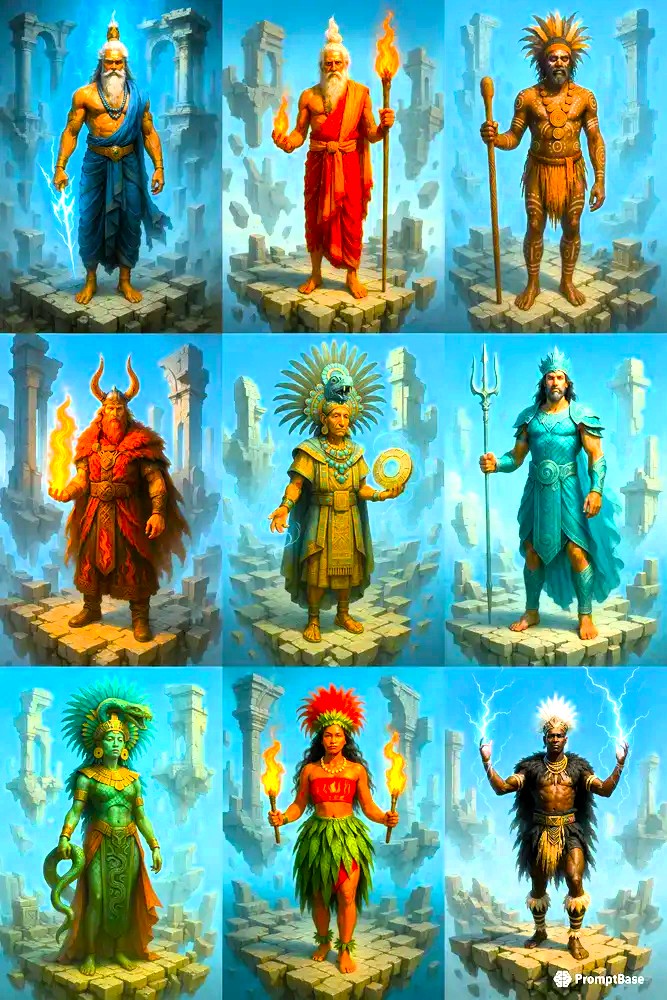
In Western ideology and politics, the idea of progress has become almost exclusive. For individuals it is important to become successful and success is then generally measured in money. High incomes give respect, a successful career is when you are considered to be better than others, higher positions give better income and even luck in business is considered to be a success and a sign that you have managed your time on earth in an exemplary way.

But even a society must be successful and how far a country has come on the step scale is mainly measured in GDP, a measure also primarily based on economic progress. Gross domestic product is expressed as the value of a country's total consumption of goods and services, investments and exports over the period of one year.
The concept of progress was introduced into the social theories by early 19th century, especially in the context of social development described by philosophers such as Auguste Comte and Herbert Spencer. At the same time, there was talk of modernization, which meant that society should remove traditional barriers to free markets. Accumulation of wealth meant that one had to be aware of the opportunities that existed to enrich oneself and seize the opportunity as soon as possible, time became an increasingly important factor in such social systems.
Bold, quick decisions were celebrated while the pace of existence increased, freed from nature, religion and traditions. The Futurist Filippo Tommaso Marinetti captured the spirit of the times in his manifesto from 1909, Time was turned up to a feverish heat, but in a "positive" sense:
1. We intend to sing the love of danger, the habit of energy and fearlessness.
2. Courage, audacity, and revolt will be essential elements of our poetry.
3. Up to now literature has exalted a pensive immobility, ecstasy, and sleep. We intend to exalt aggressive action, a feverish insomnia, the racer’s stride, the mortal leap, the punch and the slap.
4. We affirm that the world’s magnificence has been enriched by a new beauty: the beauty of speed. A racing car whose hood is adorned with great pipes, like serpents of explosive breath—a roaring car that seems to ride on grapeshot is more beautiful than the Victory of Samothrace.
5. We want to hymn the man at the wheel, who hurls the lance of his spirit across the Earth, along the circle of its orbit.
6. The poet must spend himself with ardour, splendour, and generosity, to swell the enthusiastic fervour of the primordial elements.
7. Except in struggle, there is no more beauty. No work without an aggressive character can be a masterpiece. Poetry must be conceived as a violent attack on unknown forces, to reduce and prostrate them before man.
8. We stand on the last promontory of the centuries!… Why should we look back, when what we want is to break down the mysterious doors of the Impossible? Time and Space died yesterday. We already live in the absolute, because we have created eternal, omnipresent speed.
9. We will glorify war—the world’s only hygiene—militarism, patriotism, the destructive gesture of freedom-bringers, beautiful ideas worth dying for, and scorn for woman.
10. We will destroy the museums, libraries, academies of every kind, will fight moralism, feminism, every opportunistic or utilitarian cowardice.
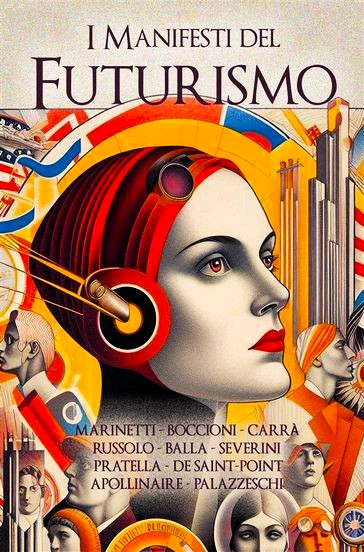
Change and worship of progress were far from new in Western culture. Although at the end of the 1800s it was linked to the pace of time, the rapid pounding of train wheels against the rails, raising smoke from factory chimneys, their blistering hot furnaces and powerful steam hammers, the increasingly common automobiles and aircraft. A paroxysm that found its explosive peak in the First World War, with its devastating, mechanized carnage.

It was not only the freedom of thought and the exchange of knowledge that was embodied in Gutenberg's revolution of the art of printing, but in parallel with this intellectual development, increasingly deadly weapons, were created leading to the progressive society we now live in.
Sociologist Robert Nisbet stated that "for three thousand years, in Western civilization, no single idea has been more important than the notion of progress." An important part of this perception has been an overestimation of the sovereign value of one's own culture compared to traditions of other countries and peoples. Added to this was a boundless reverence for economic and technological growth, coupled with a belief in scientific/academic knowledge.
An attitude that was reinforced by Darwin's theory of evolution, which was interpreted in conjunction with man as the "crown of creation", the end goal in all development and above it all towered not Homo sapiens, the thinking man, but Homo economicus, the economically minded man who over time had developed into the master of the Earth, far superior to his primitive fellow human beings.
The word "primitive" comes from the Latin primitivus, and has come to denote the first of its kind, and when the term is related to human society, it describes an early stage of development where people live in a simple manner without machines and sophisticated writing systems. Nowadays, the word "primitive" has come to be replaced by "underdeveloped", a term that also implies a form of progressive thinking, although the word "development" rather means "open up". Of course, one may wonder whether the exploitation of our natural resources and the development of sophisticated weapons of mass destruction can really be described as “progress.

Jewish religion does not seem to have been particularly obsessed with any idea of progress, but there was a strong belief that God was the Lord of Time and that He worked in history by punishing and rewarding His people. In times of persecution, the idea might thus arise that God, after punishing people for their mistakes, would also reward those who had been steadfast in their faith in Him. At the same time, God would punish the enemies of the righteous.
By the time of Jesus' birth there had among the Jewish Essenes developed the belief in an approaching Apocalypse, Revelation, and Judgement Day. The Essenes, due to Roman occupation and Jewish complicity isolated the themselves in the desert area of Qumran, where they lived a pure, strict monastic life awaiting God's doom. Several of their writings were found between 1947 and 1956.
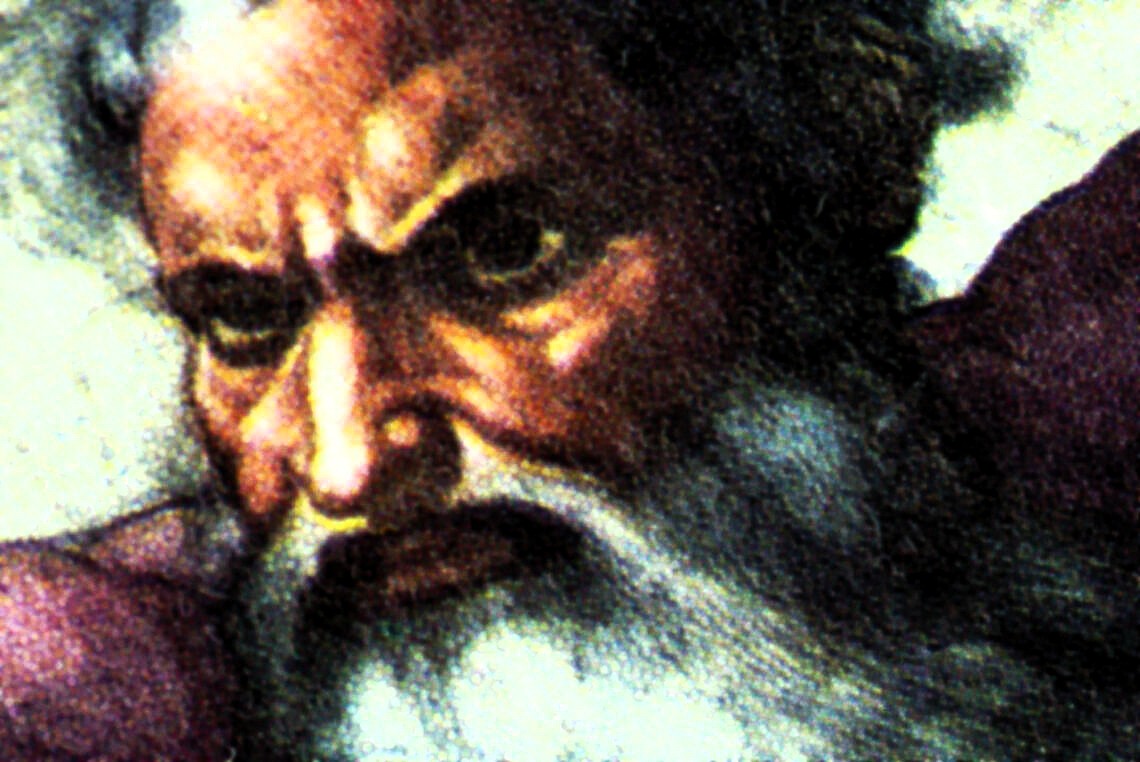
However, the absolute culmination of a temporal view of human development came through Christianity, as it developed after the death of Jesus. Here we find the Jewish idea of man's arrogance and faith in his own ability that made God to cast out the first human couple from their eternally innocent bliss in Paradise. Humans became compelled to administer the earth through hard work. To lead them onto the right path, God gave them a set of rules to live by. He punished and rewarded humanity throughout the course of history. From time to time, God sent His prophets to enlighten people about the unfortunate consequences of not obeying His commandments.
Christianity's contribution to this development was that God, apparently resigned after his constant attempts to reform his creation and finally felt compelled to incarnate himself as a human being and in the form of Jesus become a tangible example of how one should live. However, even this attempt went badly – the ungrateful people killed him.
Now, according to many Christians, nothing remained but the Last Judgment, when all mankind would be held accountable for their misdeeds. The righteous would be saved by the establishment of a new glorious world, while the guilty ones would be punished with eternal torment. An idea that was also adopted by Islam.

John' s Terrible Revelation is the last book of the Bible. Doomsday prophets and fanatics seem to love this book in which the forgiving and love-preaching Jesus has been transformed into an avenging violent persecutor and uninhibited tormentor who, in an apparently insane desire for revenge, hurls millions of people into merciless suffering and eternal damnation.
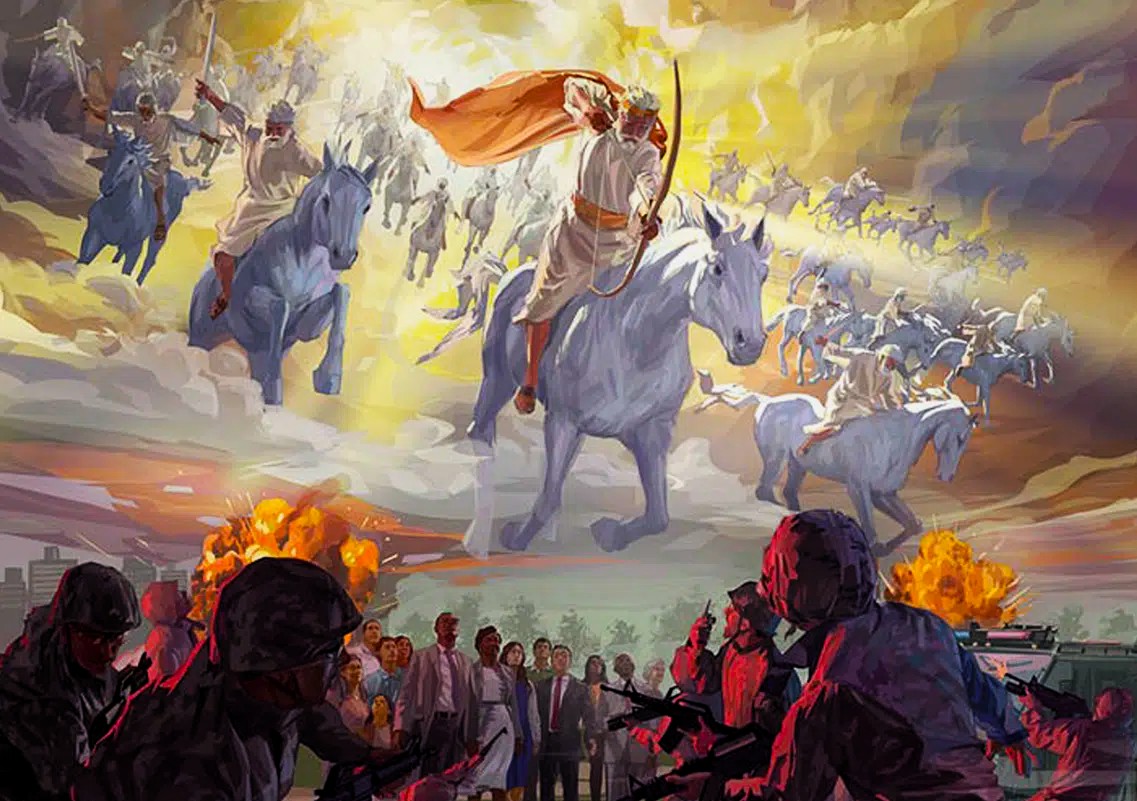
The book was probably written in the eighties AD by a certain John, a Christian-Jewish exile who had been forced to the live on the island of Patmos, off the present-day Turkish west coast. In bitter schadenfreude, John indulges in visions of all the evil that will befall enemies to his faith and how God after He has wiped them out from the face of the earth will establish a glorious Kingdom of Heaven for righteous and steadfast believers like John and his ilk. It is evident that John's revelry in all the misery that will befall the wicked alludes to conditions that prevailed in his time. The historian of religion Elaine Pagels has, through past and present literature, carefully analysed John's gloomy, admittedly powerful, but to put it mildly nasty visions.
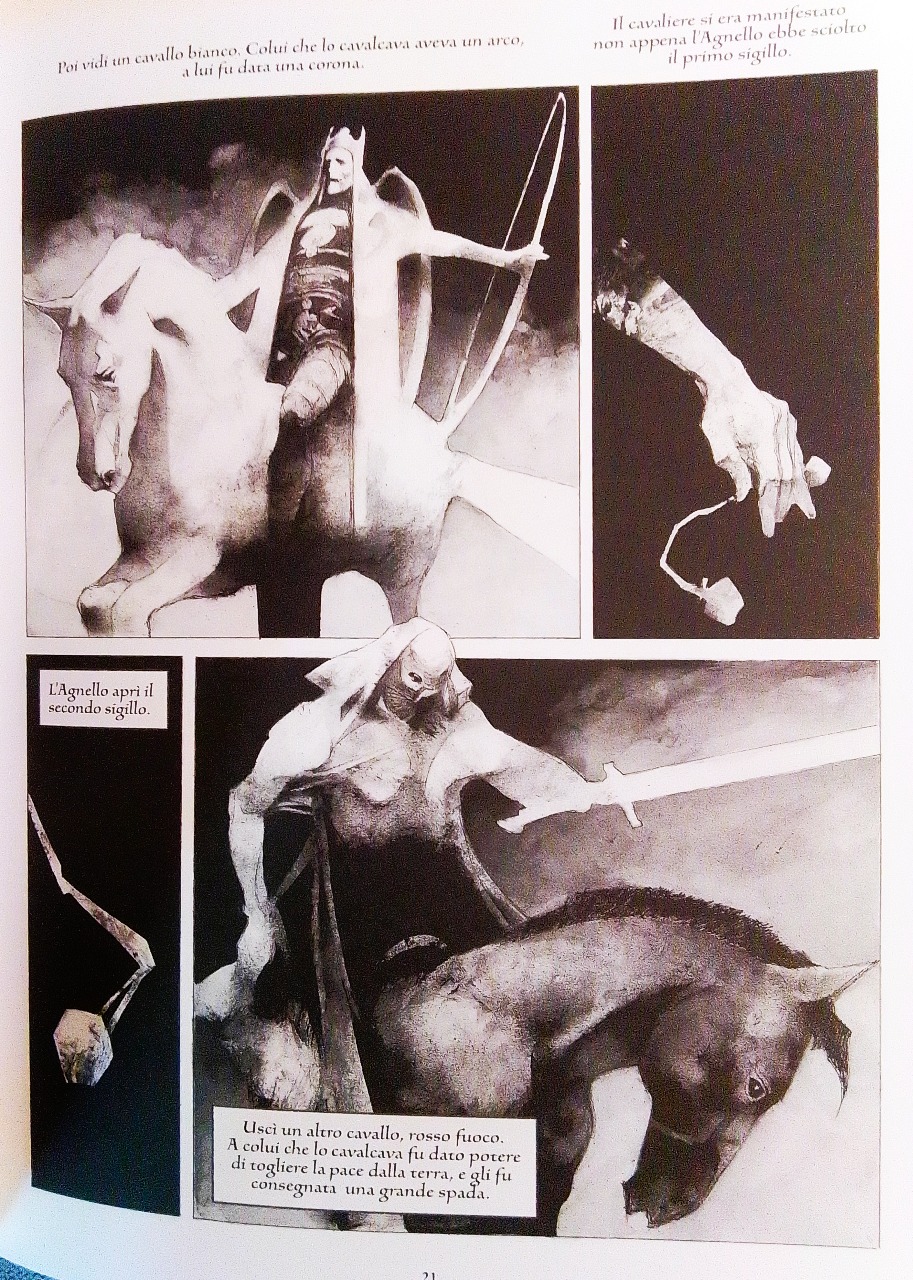
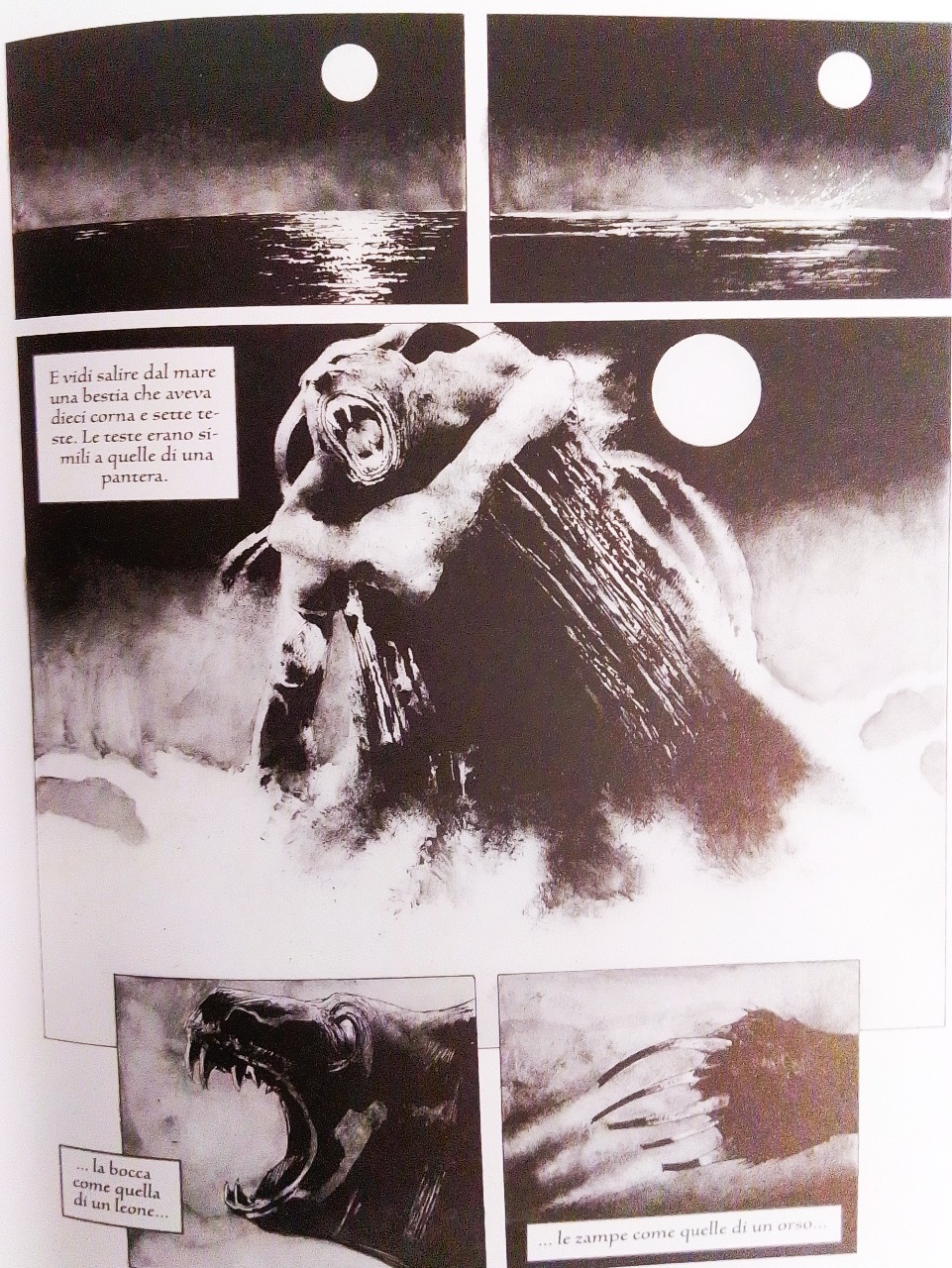
John not only turned against his oppressive Roman overlords who had destroyed the Jewish temple and razed Jerusalem to the ground, but he also raved against Christians who had abandoned the Jewish faith and joined St. Paul in his submission to Roman authority and rejection of certain aspects of the Mosaic Law.
From early on, there were a number of Christian prelates who opposed an acceptance of John's violent visions (there were at the time a number of other visionaries who, like John, claimed that their visions had at least the same authority as the Gospels).
Eusebius (260-339), bishop of Caesarea in what was then Palestine, wrote an extensive church history in which he quoted a number of writings. Eusebius was a scholar who relied more on books than anything else. There are few anecdotes and no humour in his rather dry book, which in return is rich in quotes and interesting excerpts from various older writings. Among other things, Eusebius reproduces letters and writings by the by him much admired Bishop Dionysus of Alexandra, who had about as if the Revelation of John had stated that
some of our predecessors rejected the book and pulled it entirely to pieces, criticizing it chapter by chapter, pronouncing it unintelligible and illogical and the title false. They say it is not John’s and it is not a revelation at all, since it is heavily veiled but a thick curtain of incomprehensibility so far from being one of the apostles, the author of the book was not even one of the saints, or a member of the Church but Cerinthus, the founder of a sect called Cerinthian after him, who wished to attach a name commanding respect to his own creation.
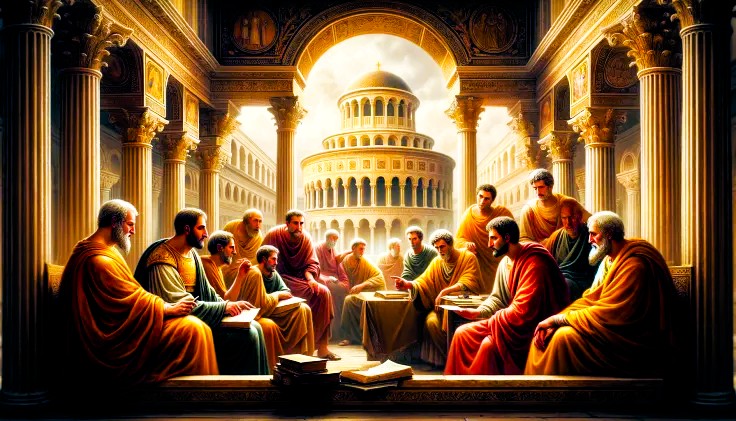
Bishop Dionysus, however, did not want to completely dismiss the Revelation of John because "many good Christians have a very high appreciation for it." However, he could not refrain from divulging his doubts that it was Jesus' disciple John who had written the book, as several of his more fanatical contemporaries had claimed. Dionysus, who was a learned man and had Greek as his mother tongue, believed that the Gospel of John was written with
A remarkable skill as regards diction, logical thought, and orderly expression. It is impossible to find one barbarous word or solecism, or any kind of vulgarism. For, by the grace of Lord, it seems their author possessed both things, the gift of knowledge and the gift of speech.
It was worse with the author of the Book of Revelation, whose "language and style are not really Greek: he uses barbarous idioms, and is sometimes guilty of solecisms."
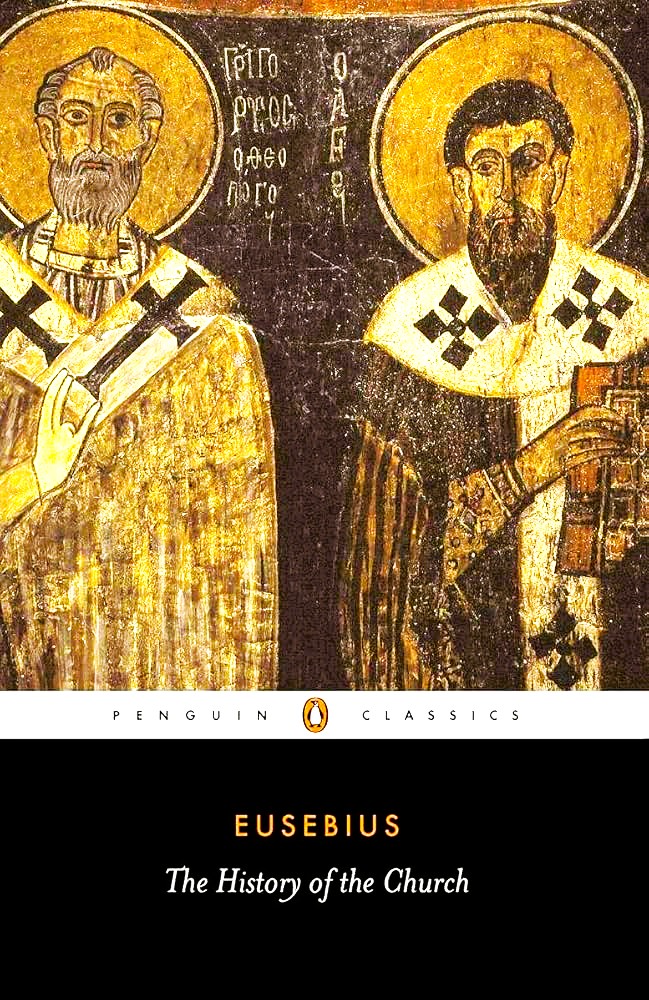
That the Book of Revelation finally found a place in the Christian canon and even ended up as the effective end of the entire Christian Bible is primarily due to the efforts of Bishop Athanasius (296-373). For forty years he was a dominant voice within Christendom, several times banished from and returning to his bishopric, he was a combative and skilled theologian, as well as a smart and power-hungry politician.
Athanasius early on found that if the Book of Revelation could be established as a canonical scripture, revealing the future and final judgment that God intended for the peoples of the earth, it could by him be used to condemn his adversaries, especially those who occasionally succeeded in usurping the bishopric from him and who, unlike Athanasius, claimed that Jesus Christ was not identical with God but "consubstantially" equal to God. It might seem to be a subtle difference, but these different perceptions divinity could result in violent riots with fatal outcomes. Supported by the Book of Revelation, Athanasius was able to equate his adversaries, the Arians, with those deniers of God’s real nature who according to the visions of John were going to be subjected to a multitude of horrors and mass destruction.
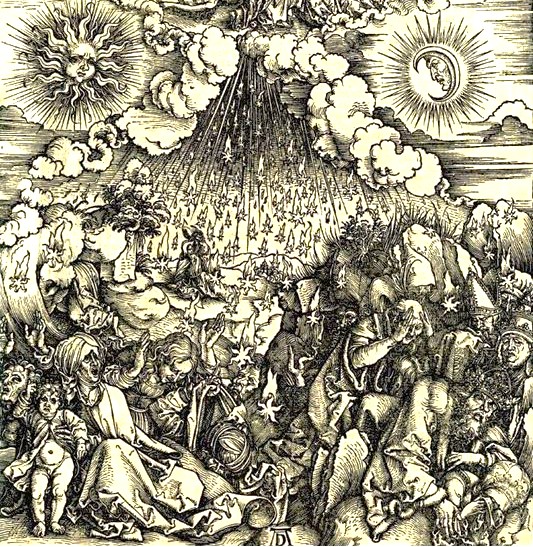
A trick that has since has been used by Protestants to condemn Catholics, and by Catholics to condemn Protestants, and on almost countless occasions when the Apocalypse of John has been used to predict God's destruction of countless opponents and other tumultuous events such as the HIV/AIDS and COVID epidemics, as well as a variety of wars. Not to mention how the "Sign of the Beast" – 666 – has been applied to Satan, a host of popes, Nero, Domitian, Vespasian, Muhammad, Napoleon, Hitler, Stalin, Reagan, Gorbachev, Jimmy Carter, and Saddam Hussein, to name only a few of them. Strangely enough, there are millions who still believe in the Book of Revelation and that it predicts the future in detail, even though it is perfectly clear that the Apocalypse was written in its time and for its time.
The Revelation of John thus has to do with time – the future and John's visionary visits to God during the Last Judgment can thus be regarded as a form of time travel. Many people have through their visions travelled into the future, although a few have also visited the past.
Some reached another time through dreams or sleep, as in the legend of the seven sleepers in Ephesus who fell asleep during the Roman persecution of Christians and then woke up when the whole world had become Christian (a legend that also appears in the Quran), or Rip van Winkle who fell asleep in the Catskill Mountains when the future United States was English and woke up 20 years later when it had become its own nation.
Another variant is the play The Bed Bug, a play from 1929 by Mayakovsky, in which a worker is frozen for fifty years and thawed in 1979 when he is shown in a communist Utopia in a zoo as an example of bourgeois habits from anno dazumal. A similar time travel was presented in Woody Allen’s film Sleeper in which Miles Monroe, owner of the Happy Carrot Health-food Store in New York, is frozen in 1973 and thawed in 2173.
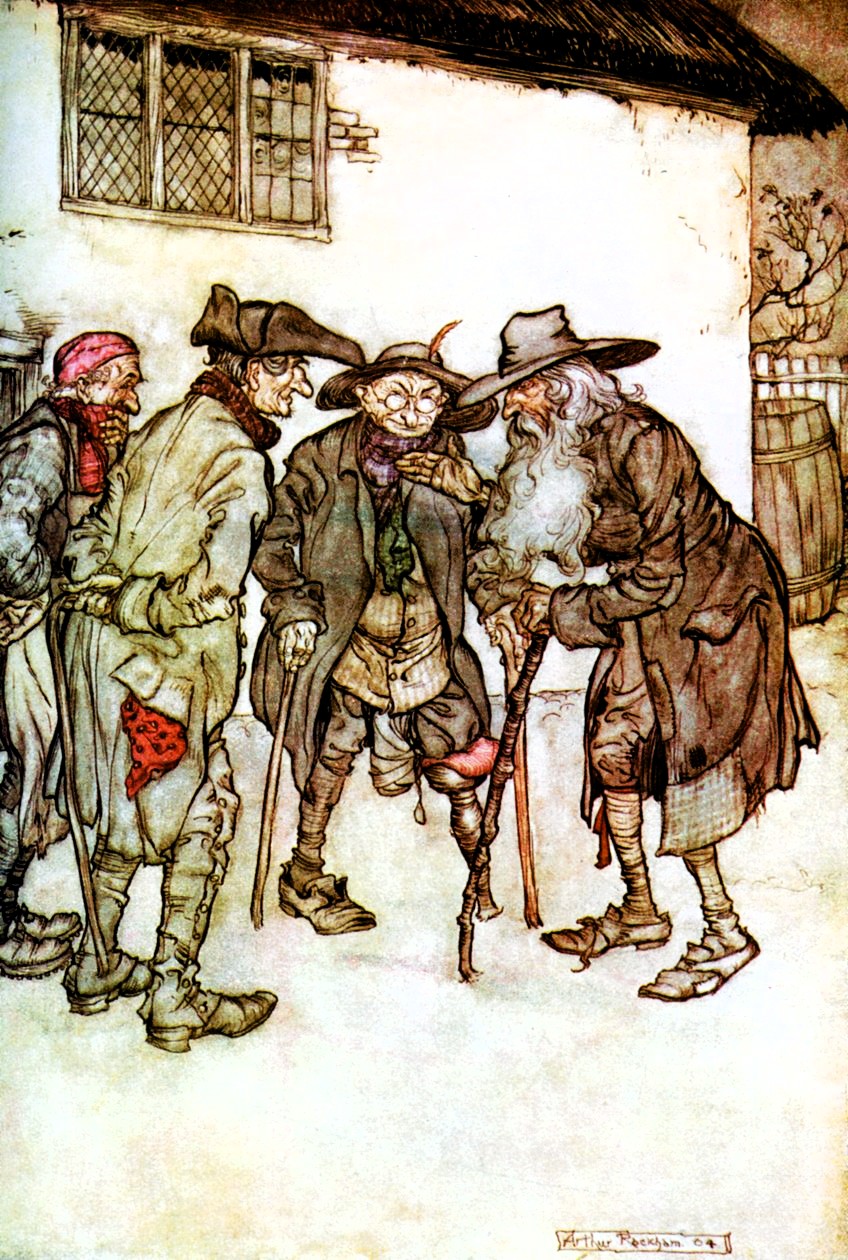
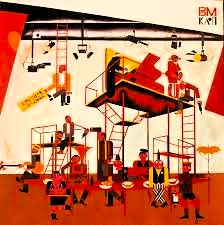
Then there are a number of fairy tales that tell of other time dimensions, such as when the Japanese fisherman Urashima Tarō ended up in an underwater palace in which he believes he had stayed for three days, only to find on his return to earth that he had been gone for decades without having aged, something that also happened to Tannhäuser after living in the Cave of Venus, as well as similar experiences by other heroes and heroines who had ended up in parallel worlds together with fairies and trolls. There are several such parallel worlds where time follows different rules than those that prevail in ours, such as the Celtic Tír na nÓg, the Tibetan Shambhala, or the Chinese Kunlun.
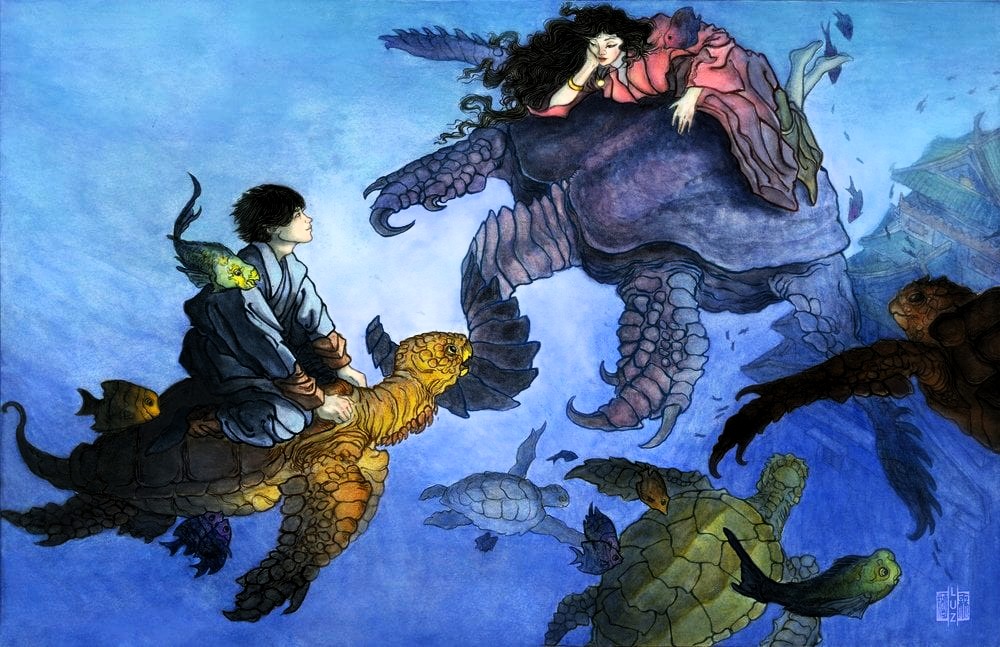
.jpg)
Other fairytale characters experience their future in dreams such as Scrooge in Dickens' Christmas Carol, or Julian West in Edward Bellamy's Looking Backward.
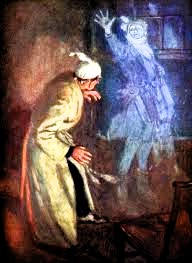
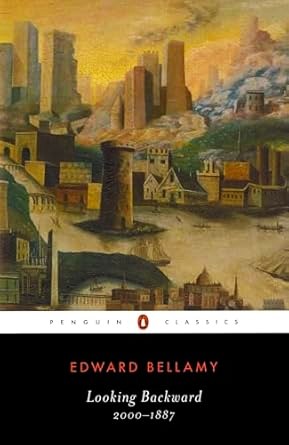
You can also be taken back in time, as in Hans Christian Andersen's The Galoshes of Fortune, which takes their wearer back to King Hans' time in the early fourteenth century, or Mark Twain's A Connecticut Yankee at King Arthur's Court, where engineer Hank Morgan wakes up in a field outside King Arthur's castle, after a blow to the skull with a crowbar. Confused, he asks "Bridgeport?", to which he gets the answer "Camelot".
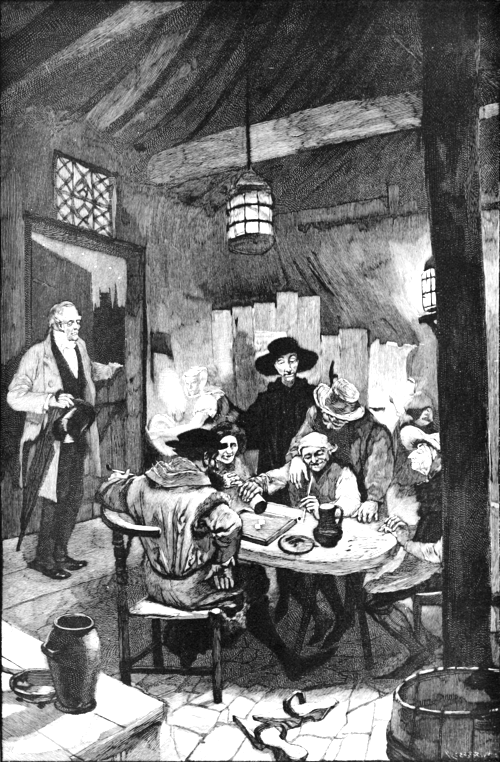
.jpg)
But it wasn't until 1895, in King Edward's England, when a time traveller climbed on his strange, bicycle/sleigh-like time machine that time travel took on a whole new aspect. It retained its adventurous fascination, but now the whole scenario was changed through new technology, scientific speculation and social criticism and thus time travel became a source of increasingly complex reflections on the special and incomprehensible nature of the time. A number of science fiction writers have since followed in Wells' footsteps and his story has spawned at least four films, all of which were quite unsuccessful.
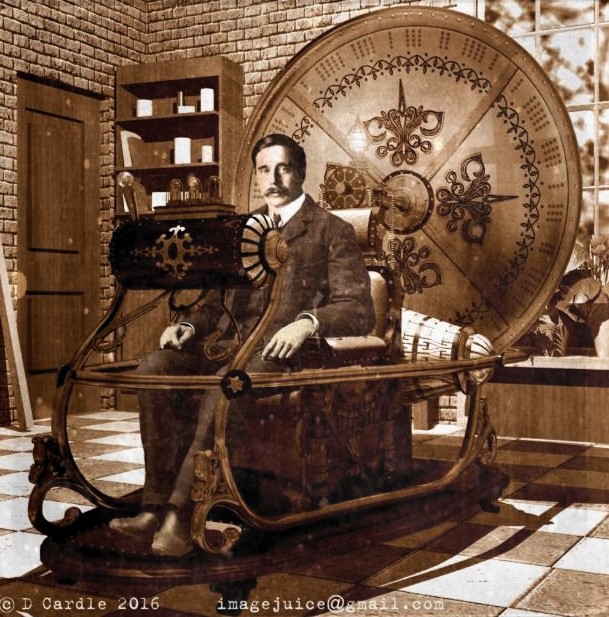
Wells' story, like so many of his short stories and science fiction novels, is both exciting and thought-stimulating. The time traveller voyages all the way to the year 802,701, where he encounters the Eloi – small, naïve and humanoid creatures living in modest communities among the ruins of huge, dilapidated buildings. Cheerful and carefree, Eloi fears dark, moonless nights. After exploring the area around the Eloi settlements, the time traveller reaches the top of a hill overlooking what he believes was once London and realizes that nature has now taken over the entire planet Earth and that humans have returned to their origins as small vegetable-eating creatures.
Later, he encounters the Morlocks, ape-like troglodytes living in the darkness underground and only coming to the surface during moonless nights. The time traveller realizes that Morlocks control and feed on the Eloi and speculates that humanity eventually had been split into two different species. The privileged aristocracy of his time has become the Eloi and the enslaved working force have evolved into Morlocks.
The story contains both love and suspense, before the time traveller travels further into a foggy future. Devid of human life it seems to anticipate T. S. Eliot's The Hollow Men:
This is the way the world ends
This is the way the world ends
This is the way the world ends
Not with a bang but a whimper.
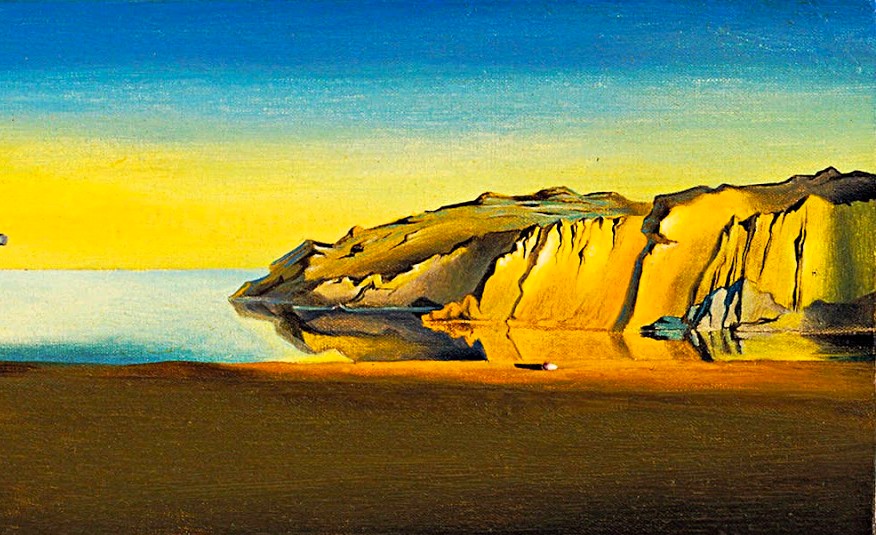
The time traveller manages to return to his own Edwardian time, but later disappears without a trace. However, that did not mean he vanished from literature and fantasy. Almost at the same time as The Time Machine was published, the new natural science broke through. Previously, matter and energy had been studied based on what scientists such as Isaac Newton and James Clerk Maxwell could calculate and observe within their traditional, but limited laboratory environments. This so-called classical physics had described the movements of bodies under the influence of various forces.
However, this previously applicable and often efficient "classical physics" were eventually challenged and changed by the study of matter and energy at very high speeds and/or at very large or extremely small scales. The two main branches of "modern physics" thus became quantum mechanics and relativity theories. Matter was investigated at atomic and subatomic levels, while the theory of relativity grew out of Einstein's studies of and theories about the effects of gravity and light on time and space.

During the 1890s, it had been discovered that atoms consisted of even smaller particles than those previously assumed. Max Planck found that the theories put forward by classical physics did not work very well. For years, scientists had assumed that energy flowed evenly in the form of a wave. Planck's work now found that energy also took the form of particles, moving in individual packets that he called quanta – the plural form of the Latin quantum, meaning "how much", or "how big".
Quantum mechanics led researchers into a subatomic world where the atom's protons and neutrons are made up of even smaller particles, some of which can simultaneously exist in more than one physical place at the same time and move from one place to another, without traveling through the space that separates them. If you try to observe them an effect called wavefunction collapse might occur. Such strange, for a layman like me, completely incomprehensible phenomena have led some physicists to speculate about the existence of parallel universes and/or alternative realities.

In 1905, Albert Einstein published an article supporting the theory that light travels as small packets of energy. Einstein's theory of the effects of speed and gravity on space and time revolutionized science. His relativity theory claims that the speed of light through an empty space is constant – 299,792, 458 meters per second. No spacecraft can travel faster than that, nor can anything slow down the speed of light. To people who travel with the light, the laws of physics would seem normal. Einstein theorized that time and space were not constants, but changed depending on the movement of the observer.
In accordance with this Brave New World, literary time travel became more numerous and bolder. Just as the new physics had changed the scientific view of existence, Wells had set a new standard for the increasingly popular science fiction literature. Since then, hundreds, if not thousands, of short stories and novels about time travel have been published annually around the world. Not to mention all the movies and TV series. Some of the better of the latter can be mentioned to give an idea of the span of time travel.
The great classic is Frank Capra's Life is Wonderful from 1946 in which small-town philanthropist George Bailey is ruined by a rival and thus contemplates suicide. Standing on a bridge in a snowstorm wishing he had never been born, an angel grants his wish and George is transferred to a miserable slum named by his rival. George's brother, whose life he saved as a child, is dead, and so are the hundreds of people his brother would have saved during World War II. George's wife is an embittered maiden and their children are accordingly not born at all.
The message of the film is that every person's life has a meaning and leaves an imprint on other people's existence. George returns to a present time that has not at all changed for the worst and is met by wife, his children, his brother, the war hero, and a grateful community. Everything works out for the best and Capra's film has become one of the most beloved movies of the Christmas season and every Christmas it is broadcasted on a great variety of American TV channels.

In Planet of the Apes from 1968, the first adult film I saw on my own and which impressed me greatly. It dealt with an astronaut who travelled back to Earth in a distant future and found it to be populated not only by primitive humans but also by intelligent, talking apes.
Time dilation is a result of the theory of relativity and meant, if I have understood correctly, that the past time is different within a moving object in relation to a stationary one, something that caused Taylor and his two colleagues in Planet of the Apes to end up on a future Earth, instead of the Earth they had left. I don’t remember what happened to his astronaut companions, if I am not wrong, they just disappeared.
In the various Terminator films of the 1980s and 1990s, a Cyborg, i.e. a creature consisting of both organic, metallic and biomechatronic body parts, in this case a deceased police officer, is brought back in time from the near future to prevent global catastrophes.


In Back to the Future from 1985, teenager Marty McFly travels back to 1955 in a DeLorean sports car converted into a time machine by his good friend "Doc" Emmett Brown.
McFly narrowly manages to avoid his own mother falling in love with him and instead marrying his father, thereby saving his own future existence. In a second instalment from 1989, Marty McFly and Doc Brown are forced to travel to the future to prevent Marty's children from ruining the family's reputation and repairing the "timeline" after the villainous Biff Tannen has created a terrible future. Biff Tannen had managed to steal Marty's and Doc Brown's time car and had in it travelled back in time and provided his former self with a list of sports results that allowed him to make a fortune and turn his future self into a ruthless capitalist.


In the French Les Visiteur from 1993, one of the most popular French films ever, a knight and his squire, after a number of intricacies in connection with various witches' potions, are transported from the twelth century and end up in today's France.
The same year came Groundhog Day, in which an initially life-weary and misanthropic weatherman for unknown reasons is forced to relive the second of February again and again within the small town of Punxsutawney. Over time he manages to think about his past life and change his behaviour towards his fellow human beings and thus acquire new and better priorities.


Terry Gilliam' s 1995 Army of the Twelve Monkeys sends James Cole from 2035 back to the time before 1996 to prevent the release of a deadly virus believed to have been created by a mysterious organization called the Army of Twelve Monkeys (which is in fact innocent).
The plot is complicated with its repeated time travel, even back to the First World War and it all becomes somewhat confusing. Cole is forced to confront what has come to be known as the Cassandra complex – you know what will happen, but you cannot change neither the past, nor the future. What happens must happen, as in ABBAS's song Cassandra
Sorry Cassandra, I misunderstood.
Now the last day is dawning.
Some of us wanted, but none of us would
listen to words of warning.
But on the darkest of nights
nobody knew how to fight
and we were caught in our sleep.

Even more confusing is Donnie Darko from 2001, which deals with adolescent anxiety, psychotherapy, déjà vu, precognition and possibly a black hole, or a wormhole. The latter is yet another incomprehensibility of the new physics. Wormholes, also known as Einstein-Rosen bridges, are a solution to field equations, i.e. calculations of how spacetime is curved by matter and energy. Worm Holes can be described as assumed "connections" between two flat parts of spacetime. These parts may be so far apart that a wormhole might appear and form a shortcut between two different points in in spacetime.
I don't understand any of this, but perhaps it can be put in connection with Kurt Gödel (1906-1978), one of history's foremost logicians and mathematicians. During the forties, when he was affiliated with Princeton University, Gödel developed a close friendship with Einstein and his interests came to be increasingly closer to philosophy (he was deeply religious) and physics.
In 1949, Gödel demonstrated the existence of closed time-like curves related to general relativity. His calculations indicated a closed "rotating universe" and, according to Gödel, it could theoretically enable time travel, to both the past and the future. Gödel's calculations, called the Gödel metric, made Einstein doubt his own theory.
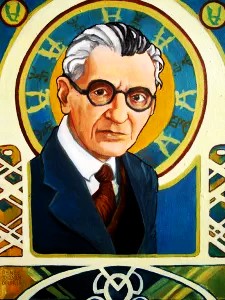

In Donnie Darko , the main character exists in a seemingly normal American small-town environment, though he suffers from somnambulism and during nocturnal walks he is accosted by a lugubrious figure, in a kind of rabbit costume, who tells Donnie that his existence will end within a certain number of days. This happens, but apparently only to Donnie Darko who is snatched from his existence, probably the victim of having ended up in some kind of time distortion. The end of the film is open to different interpretations, perhaps even Donnie's mother and little sister were in the missing plane which loose engine had fallen down, crashed on the family house and apparently killed Donnie. But has this really occurred in the world he was previously a part of?

In Tony Scott's Déjà Vu from 2006, the FBI has managed to find a way to use a wormhole to go back in time and prevent a terrorist act that has already taken place – the blowing up of a boat in New Orleans that killed 543 passengers.
In Christopher Nolan's Interstellar from 2014, astronauts use cosmic wormholes and similar phenomena such as Black holes to find new settlements for humanity.


In 2000, Christopher Nolan had created a different kind of time travel in his film Memento. Leonard Shelby suffers after a traumatic experience of anterograde amnesia that causes short-term memory loss and an inability to form new memories. He therefore develops an advanced system of photographs, handwritten notes and tattoos in an attempt to find the man who murdered his wife and caused his amnesia.

A similar thicket of time travel and parallel time schedules is made up in a number of TV series. For example, the 950 episodes of Star Trek, where the spacecraft Enterprise navigates through galaxies and time zones. The series, which began in 1966, became so popular in the United States that its personalities are now by many Americans almost perceived as living persons.
I've never seen any episodes of Star Trek, but I remember when I once bought an armchair in New York and the shop assistant appreciatively commented: "A very good choice. Dr. Spock bought a similar one last week." "Dr. Spock, the paediatrician?" "No, no, I don't know who that is. I meant Dr. Spock, science officer on the Enterprise."


However, I watched with great interest all the episodes of Lost, which followed the survivors of a plane that crashed between Sydney and Los Angeles on a mysterious island somewhere in the South Pacific. Are the former air passengers alive or dead? Is the island a place in another time dimension? Is it perhaps a version of the Catholics' Purgatory?
In any case, there was a kind of primary plot with a variety of underlying flashbacks, or forward-looking ones, that deepened the characters involved.

The German series Dark, which takes place in the small town of Winden, the site of a large nuclear power plant, is, if possible, even more confusing than Lost, and like it, leaves a lot of loose ends and unresolved questions in its wake.
Dark, which is the reason why I started writing this blog post, can almost be considered a museum of theories created around the passage of time and its role in our lives – the curved space, black holes, the Cassandra Complex, parallel worlds, wormholes, encounters with one's own passed and future self, aging, the avoidance of catastrophes that have already taken place, how the past, or the future, intervene in the present, predestination, the rise and fall of the world, our personal responsibility, the power of love, etc., etc., all trapped in a strange time loop.
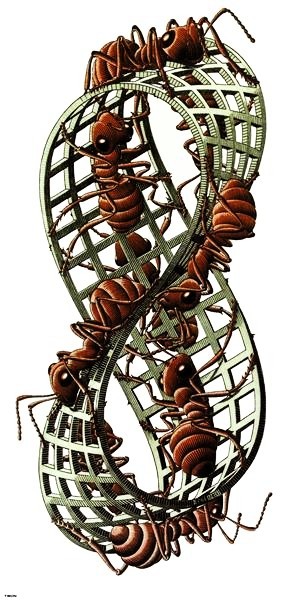
The couple Baran bo Odar and Jantje Friese, who created Dark, after that initiated the TV series 1899, which I found even more intriguing than they actually a little too enigmatic Dark. It is a shame that Netflix cancelled the 1899 project after the Brazilian cartoonist Mary Cagnin accused the German couple of plagiarism. I wonder. Plagiarism? In this age of quantum mechanics and shifting worlds? Incidentally, Cagnin's aesthetically and narratively quite unoriginal style does not seem to have much in common with the German couple's more sophisticated, multifaceted and now prematurely unfinished storytelling.
The influence of mysterious pyramids, which form the basis of Cagnin's plagiarism accusation, seems downright ridiculous given that pyramid power has been a common trope in the science-fiction genre ever since the New Age guru Patrick Flanagan introduced his mumbo jumbo around power-producing pyramids in the early 1970s. They have since appeared in all sorts of stories, such as in the 1994 film Stargate, or in the much more comical Illuminatus trilogy (1984) by Robert Shea and Robert Anton Wilson, as well as in Terry Pratchett's Pyramids (1989), in which pyramids actually affect different dimensions of time.

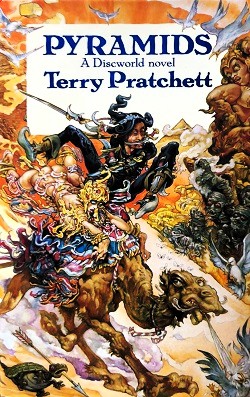
Along with wormholes, the Multi-Worlds Interpretation (MWI) occupies a prominent place in Dark. It is an interpretation of quantum mechanics that claims that the universal wave function is real and permanent, consequently there is no wave function collapse. This means that the outcomes of quantum measurements are realized within the different "worlds" that make up part of a "multi-universe".

As with so many other interpretations present in quantum mechanics, the multi-world interpretation is justified by the so-called Double-Slit Experiment. When particles, such as electrons, are sent through two slits towards a screen, they create an interference pattern on the screen, even when they are sent off one at a time, suggesting that each particle in some way influences/transforms itself. This phenomenon indicates that objects at the quantum level, such as photons or electrons, behave like waves until they are measured, at which point they behave like particles.
The experiment has been taken as evidence that the physical reality is associated with a wave function inherent in its most elementary particles and that this wave function does not collapse, as previously assumed, but is transformed. Consequently, there are several parallel universes, which can only interact with each other through interference.


Such parallel worlds exist in Dark, but they have appeared on several previous occasions, such as in Philip K. Dick's The Man in the High Castle from 1962. The novel takes place in 1962, fifteen years after Nazi Germany and Japan won World War II and the victorious powers have divided the United States between them, with a "neutral" zone between the two spheres of influence. However, there exists a forbidden "novel", The Grasshopper Lies Heav, which tells us that this is an illusion. It is never really clear what is reality, or whether it is perhaps just a writer's imaginary creation, a novel within a novel.
The excellent TV series that was later made on The Man in the High Castle, makes it all quite clear. It is in a parallel reality that the Japanese and the Germans have triumphed. There is another world where the Allies have triumphed and where life is completely different. Grasshopper Lies Heav, is in the series not a novel but hidden documentaries that truthfully depict how the Allies won the war – but ... Not here and now, not in this reality, but in a parallel world.

The different worlds make me remember a series of books that my oldest daughter was very fond of. Especially one that was about how a spirit fulfilled different desires. Each chapter ended with different choices and the story continued depending on the choice you made.
That book was read to pieces and I guess my daughter still remembers it. It was part of a book series called Choose Your Own Adventure, and the books were written in the second person. Between 1979 and 1998, they had sold more than 250 million copies and been translated into 40 languages. Time travel was a frequent theme in several of them.

I don't know if the Swedish author Peter Glas are familiar with those books. In any case, in 2015 he wrote the fascinating Amber Kiss, which dealt with Gabriel's life choices. He falls in love and is invited home for dinner by the coveted woman, but ... Should he accept, or instead go to a business meeting that could make him wealthy? The reader decides. If Gabriel accepts the dinner the reader gets to know how it unfolded. However, if it is the business meeting that Gabriel prefers to prioritise the reader will have to scroll to another page. And so, it continues throughout the book, where the reader is left with one choice after another, and soon we discover that the choices are generally about love, money or career, and consequences are accordingly.
.jpg)
As early as 1963, the Argentine writer Julio Cortázar had written the novel Hopscotch which was divided into 155 chapters and which, according to the author, could be read in different order, all according to a list of numbers given by Cortázar. If the novel was read in agreement with the multitude of options indicated by the different sequences of numbers, several different stories would emerge.
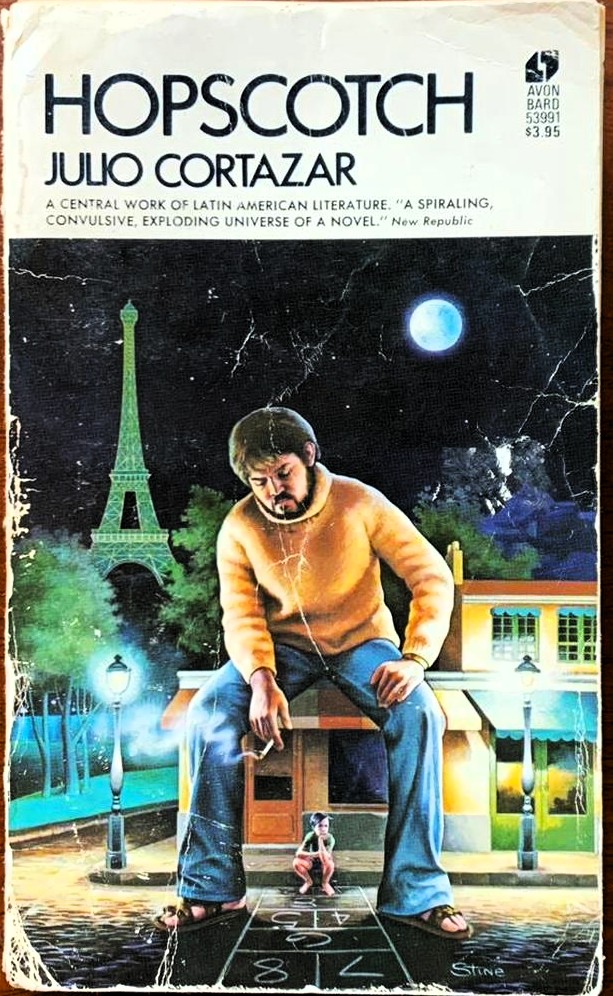
The most masterful story in the genre of "alternate realities" was written by Cortázar's compatriot Jorge Luis Borges. His story Garden of Forking Paths from 1941 is in many aspects the perfect short story: short, dense, original, strange, contemplative and thought-provoking.
A Chinese doctor, Yu Tsun, lives in England during World War I and spies on behalf of the Germans. He knows that he has been exposed, but before he is executed, Yu Tsun must find a way to pass on the crucial information he has obtained. The reader has no idea how to Yu Tsun will achieve this and part of the charm of the tale is that it is also a thriller where the main character is pursued by an agent who knows almost everything about him.
I don't want to spoil the enjoyment of a short story that "must be read before you die" as the titles are of books that informs you about novels to be read, movies to be seen, places to be visited and dishes to be enjoyed. One quote from Garden of Forking Paths may suffice:
Not for nothing am I the greatgrandson of Ts'ui Pen. He was Governor of Yunnan and gave up temporal power to write a novel with more characters than there are in the Hung Lou Meng, and to create a maze in which all men would lose themselves. He spent thirteen years on these oddly assorted tasks before he was assassinated by a stranger. His novel had no sense to it and nobody ever found his labyrinth.
Ts'ui Pen's labyrinth was in fact the representation of a multi-universe in which a myriad of possibilities opened up, where it was easy to get lost, and there was no way back. Yu Tsun knew the end of his life was coming close, but that didn't stop him from taking advantage of his ancestor's labyrinth to send his message to those who were waiting for it.

It is said that if a time traveller travels backwards or forwards in time, he cannot meet himself. This is something that the TV series Dark does not agree with at all. Much of the devastation and chaos that reigns in Dark's world is due to the fact that the main characters meet themselves at different times of their lives and at different time periods, and how they murder each other, are born to each other, converge and separate.
It certainly sounds chaotic and it is chaotic, but not to such a high degree as in Robert Heinlein's short story By His Bootstraps, which was actually published the same year as Borges' Garden of Forking Paths, though the two authors could not have known anything about each other's existence at the time.
The strange title "by his bootstraps" is probably incomprehensible if you do not consider how boots are generally equipped with such straps and to lift oneself up with the help of them is probably as impossible as when Baron von Münchausen lifted himself and his horse out of a swamp with the help of his own pigtail.


Heinlein’s short story begins with Bob Wilson locking himself in his room to finish a dissertation on the application of mathematical logic to the concept of time travel. At this stage, he doesn't care if his thesis whether time travel is valid or not, he's just desperate for sleep and wants to get the misery out of his way. Suddenly Bob hears a voice behind his back: "Don't worry about that. It's still a lot of nonsense."
The stranger, who calls himself Joe, has appeared through a time portal; a circle in the air behind his back with a diameter of about 1.8 meters. Joe tells Bob about how great opportunities await him if he follows him through the Gate and thousands of years into his own future. A chaotic story ensues. Joe is in fact a future version Bob Wilson who called himself Joe so as not to confuse him. In fact, Bob Wilson is not particularly fond of "Joe" nor the many other versions of himself he is confronted with in different time dimensions, some younger than himself, others bearded men. He even gets into a fight with a version of himself.
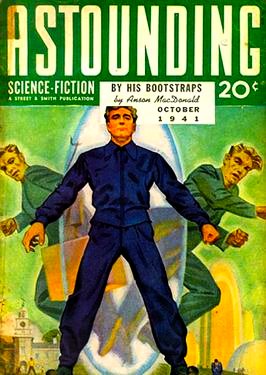
All these versions of himself that mess up Bob Wilson's existence reminded me of a scene of madness in The Marx Brothers' A Gala Night at the Opera, when people constantly show up in Groucho's ship's cabin.
 --
--
https://www.youtube.com/watch?v=8ZvugebaT6Q
Another form of time shifting is when a person is brought back in time of his or her own volition to correct his own, highly personal mistakes and shortcomings. In Pyotr Demyanovich Uspensky's The Strange Life of Ivan Osokin from 1915, the main character lamented:
It looks as though I had wanted to shape my life in my own way but had only succeeded in breaking it to pieces. The rest of you are going along by the ordinary ways. You have your life now and a future ahead of you. I tried to climb over all the fences and the result is that I have nothing now and nothing for the future. If only I could begin again from the beginning! I know now that I should do everything differently.
In despair after a failed love story, Ivan seeks out a magician with the reputation for being able to bring people back in time. Ivan rings the bell to the magician's apartment and is met by an old skinny man with a hunched back and piercing eyes, He to be familiar with Ivan's case. The magician (is he perhaps the Devil himself, or a demon, an angel, or a messenger of God?) assures Ivan that he can "send you back as far as you like, and you will remember everything, but it will lead to nothing." Ivan insists and asks to at least get twelve years of his life back:
The whole horror of the thing is that we do not know our way. If I know and remember, I shall do everything differently. I shall have an aim, I shall be aware of the use and the necessity for all the difficult things I have to do.
The magician agrees to grant Ivan's wish on the condition that after twelve years he will come back and tell him how the chance of correcting his life turned out. After complicated rites, Ivan disappears from the magician's room, but as agreed, he returns twelve years later. The magician and his room seem to be unchanged and he asks Ivan the question: "How did your life turn out? Were you able to make the right choices when you had knowledge of the future?" Ivan replied: "I did my best, but the result was the same, obviously I made all the wrong decisions."
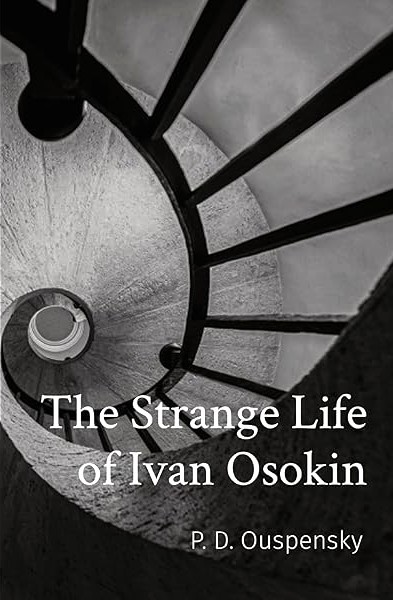
Perhaps Ivan Osokin fell victim to Novikov's principle of self-consistency , which means that the laws of physics prevent actions that contradict history. A time traveller cannot change the past. Any attempt to change history would either fail or would have been part of what has already happened. This does not prevent literary time travellers from persisting in trying to change the course of history, often it is a matter of preventing the death and suffering of someone who has been near and dear to them. For example, this is what caused suffering, murder and a nuclear disaster in the TV series Dark.
Just as often, a time traveller may seek revenge or change what already has occurred by, for example, murdering a future dictator – several time travellers, for example, have tried to kill Hitler, or alternatively tried to make sure he was never born .
I was particularly impressed by Stephen King's 11/22/63, the title of the novel alludes to the day John F. Kennedy was assassinated. Jake Epping, a divorced high school teacher in the small town of Lisbon Falls, has over the years become acquainted with Al Templeton, owner of a diner serving dishes reminding Jake of his childhood favourite food with original ingredients that has not been manipulated by modern food technology.
When Al is diagnosed with terminal lung cancer, he reveals the secret of his good food – in the restaurant's pantry there is a time portal, a wormhole that leads to Lisbon Falls on September 9, 1959. Over the years, Al has acquired his ingredients from the late fifties, but had recently also made a fatal decision. Al had during his youth participated in the Vietnam War and lost a number of close friends. He had decided to stay in the past to prevent Lee Harvey Oswald from assassinating Kennedy and thus, according to Al, hindering the Vietnam War from developing into the disaster it eventually became.
When Al's death puts an end to his plans, Jake takes over his quest for Lee Harvey Oswald. There is nothing to keep Jake in the year 2001, instead he patiently builds up a life in both Lisbon Falls, and later in Dallas where he systematically gets closer and closer to Oswald.
After a hectic chase over time, Jake manages to prevent Oswald from assassinating Kennedy, but when he returns to 2001, Jake finds himself in a completely changed dystopian future created by unforeseen politics. What's interesting in King's novel, apart from the well-documented early sixties, is that when Jake tries to stop Oswald's actions, it is as if time is working against him – accidents happen, buses and cars don't work. Perhaps it is Novikov's principle of self-consistency that tries to prevent him from doing what he nevertheless succeeds to do.

Another danger with time travel is that the slightest mistake can have fatal consequences, In Ray Bradbury's A Sound of Thunder, from 1952, time travel has by 2055 become so common that the company Time Safari Inc. offers wealthy adventurers the chance to travel back in time to hunt extinct animal species. Time Safari Inc. emphasizes the importance of adhering to extremely strict rules so that the future does not change. Time travellers are only allowed to shoot animals that previous time trackers have found will die in a natural way, and hunters are absolutely not allowed to leave established paths. Unfortunately, one of the participants finds that after he under dramatic circumstances managed to shoot a Tyrannosaurus Rex, he had accidentally stepped on a butterfly, a misstep that would change history.

However, not all time travel causes any major future changes, especially those that emerge as a result of a dissatisfaction with a current situation and/or a way of dreaming back to better, bygone times.
It took me a long time before I began to appreciate Woody Allen's films, but since my acquaintances praised them, I went to see his movies. However, I couldn't understand what the cinema audience was laughing at. Allen’s neurotic witticisms were just annoying and far beyond my simpler perception of humour.
But that has changed. Woody Allen's first time-travel in Sleeper didn't amuse me at all. It got much better when he worked with nostalgia, as in The Purple Rose of Cairo and Midnight in Paris, the latter became for me the final breakthrough when it came to appreciating Woody Allen's distinctive craft.
I saw the film when I lived alone in Paris and, like the main character Gil Pender, spent much of my time strolling through the city during evenings and weekends, The staircase where Gil waited for the car that in the company of Scott Fitzgerald, Hemingway or T.S. Eliot took him to the twenties and meetings with Cole Porter, Gertrud Stein, etc., was a few blocks from my home on Square Adanson.
Allen brought Paris to life in a way similar to what I feel about Rome. Cities when combined with my memories and experiences, reading fruits and art, becomes endowed with a life of their own.
Woody Allen works with a light hand, and Sidney Bechet's and Django Rheinhardt's music puts us in the right frame of mind, along with well-known Paris views. Without any unnecessary, far-fetched strained explanations, Gil steps unhindered into Paris of the twenties. The spoken lines are superb, and so is the depiction of Gil's relationship with his dismissive fiancée and annoying smart aleck Paul Bates. Greg is a dreamer and so is every true time traveller.
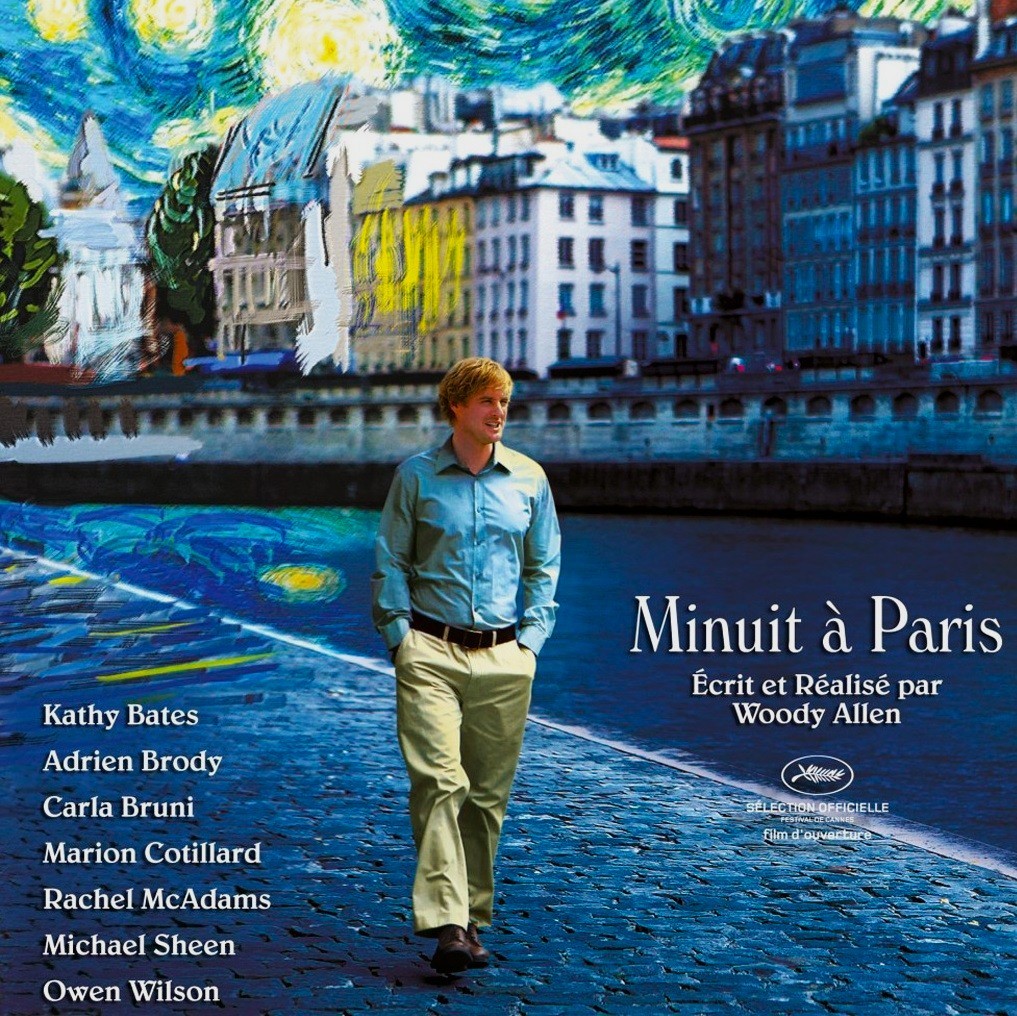
Borges, Jorge Luis (2000) Fictions. London: Penguin Classics. Bradbury, Ray (2005) A Sound of Thunder and Other Stories. New York: William Morrow. Calvino, Italo (1992) If on a Winter’s Night a Traveller. New York: Vintage. Coomaraswamy, Ananda K. (1985) The dance of Siva: essays on Indian art and culture. New York: Dover Publications. Cortázar, Julio (1984) Hopscotch. New York: Avon Books. Danchev, Alex (ed.) (2011) 100 Artists' Manifestos: From the Futurists to the Stuckists. London: Penguin Modern Classics. Dick, Philip K. (2001). The Man in the High Castle. London: Penguin Modern Classics. Ende, Michael (2013) Momo: Or the Curious Story About the Time Thieves and the Child Who Returned the People's Stolen Time. San Francisco CA: McSweeney's. Eusebius (2025) The History of the Church from Christ to Constantine. London: Penguin Classics. Faulkner, William (1990) Absalom! Absalom! New York: Vintage. Francis of Assisi The Canticle of the Sun. https://franciscanfriarscresson.org/the-canticle-of-the-sun/ Gleick, James (2016) Time Travel: A History. London: 4th Estate. Heinlein, Robert (1983) The Menace From Earth: Eight Short Stories. Hong Kong: Corgi Press. King, Stephen (2011) 11/22/53. New York: Scribner. Lem, Stanislaw (1986) Memoirs Found in a Bathtub. San Diego, CA: Harcourt. Mayakovsky, Vladimir (2015) La cimice-The bedbug- Kaon. Roma: Gangemi Editore. Mascaró, Juan (ed,) (1965) The Upanishads. Harmondsworth, Middlesex: Penguin Classics. Medicus, Heinrich A. (1994) “The Friendship among Three Singular Men: Einstein and His Swiss Friends Besso and Zangger,” in Isis, Vol 85, No. 3. Nisbet, Robert (1994) History of the Idea of Progress. New Brunnswick, NJ: Transaction Publishers. Oupensky, P. D. (2002) Strange Life of Ivan Osokin: A Novel. Berwick Upon Tweed: Lindisfarne Press. Pagels, Elaine (2012). Revelations: Visions, Prophecy, and Politics in the Book of Revelation. New York: Viking Press. Terry, Philip (ed.) (2020) The Penguin Book of Oulipo. London: Penguin Modern Classics. Twain, Mark (1972) A Connecticut Yankee in King Arthur's Court. Harmondsworth, Middlesex: Penguin Classics. Wells, H. G. (2007) The Time Machine. London: Penguin Classics. Wittgenstein, Ludwig (2023) Tractatus Logico-Philosophicus. London: Penguin Classics.
Hösten har kommit, det är kallt och mörkt i lägenheten, men ute skiner solen från en klar himmel. Då jag kommit ut kände jag solens värme och drog i djupa andetag in luften som mättats med höstens dofter. Även om jag befinner mig i en storstad är Roms centrum i mångt och mycket en lantlig idyll, med många träd och stora vildvuxna parker, långt ifrån så välordnade som de är i Paris.
På väg till utekaféet gör jag ett besök i en kyrka, något som även det blivit till en vana. Jag gillar meditativa ro, liksom om jag skulle befinns mig i ett muslimskt land uppskattar moskéernas lugn, fast det är nu länge sedan jag varit på sådana platser.
Det är slutet av en jordfästningsakt och jag håller mig diskret i skymundan. Från min plats bakom en pelare ser jag hur kistan bärs ut av sex svartklädda män. Då de sörjande lämnat kyrkan smyger jag mig ut och håller då på att snava över mängden av begravningskransar som lagts på kyrktrappan.
Något mollstämd sitter jag vid min kaffekopp, men livas snart upp av solens milda värme. Jag befinner mig trots allt i Italien. Ett faktum som emellanåt förvånar mig. Jag kan egentligen inte begripa hur ödet fört mig till en stad som jag redan som barn, för mer än sextio år sedan, fascinerades av och ville bo i.
Livet har varit gott gentemot mig och mitt i all obegriplig tragik känner mig oförtjänt av den lycka som blivit mig beskärd. Oro och problem finns förvisso. Men ... ändå. Jag tar ett djupt andetag, tänker på San Fransiskus solsång, skriven bland Italiens berg och ängar:
Lovad vare du; Herre, och alla dina skapade verk,
besynnerligast herr broder Solen.
Se, varje ny dag upptänder du honom åt oss,
och han är skön och strålande med väldig glans,
av dig, Allrahögste, en sinnebild.
Lovad vare du, Herre för syster Månen och stjärnorna,
på himlen har du fäst dem klara och kosteliga och vackra.
Lovad vare du, Herre, för broder Vinden
och för luften och molnen och aftondaggen, ja, för all väderlek,
genom vilken du håller din skapelse vid liv.
Lovad vare du, Herre, för syster Vatten,
så mäkta nyttig är hon och ödmjuk och kostelig och kysk.

Dricker ur mitt kaffe och går upp till den närbelägna parken kring Villa Doria Pamphilj, vidsträckt med sina ängar, tallskogar och marmorstatyer, som samtliga förlorat sina huvuden. Slår mig ner på en bänk med utsikt över slottet.

Värmer ansiktet i solskenet innan jag tar fram boken jag haft med mig i rockfickan, Juan Mascarós Upanishad-urval:
Där, likt en falk eller en örn som efter att ha svävat i skyn, viker samman sina vingar, ty han är trött, och sänker sig ner till sitt bo, så skyndar sig människans Ande till den viloplats där själen inte har några begär och Anden inte ser några drömmar.
Det som syntes i en dröm, all rädsla för att vakna, eller för att bli dödad eller förtryckt, förföljd av en elefant, eller falla ner i en avgrund, blir till en illusion då Anden, likt en kung eller en gud, känner ”Jag är allt”, då befinner den sig i den högsta världen. Det är Andens värld, där det inte finns några begär, allt ont och all rädsla har försvunnit.
Liksom då en man i sin älskades famn enbart känner frid omkring sig, så har själen frid i Atmans omfamning Alla begär stillas, eftersom Anden, som är allt, har uppnåtts, inga begär finns det där och ingen sorg.

Det är Yajñavalkya som för ettusentvåhundra år sedan talade så med Janaka, kungen av Videha.
Som så ofta då jag läst något tänkvärt blundade jag och började fundera över vad jag läst. Tanken på en tysk TV-serie jag nyss sett dök upp i skallen. En ytterst komplicerad historia; en labyrint på olika tidsplan där gestalter och händelser skiftar gestalt i en allt svårbegripligare ringdans. Men, mot slutet löses härvorna i viss mån upp och det förklaras att allt utspelats kring mittpunkten av en tidsdimension symboliserad genom en triquetra.
Detta är bilden av en slags knut som omhuldats av moderna New Age rörelser men vars ursprung förlorar sig någonstans i bronsåldern. Triquetran anses av många vara en bild av knutpunkten mellan det förflutna, framtiden och nuet och illustrerar därmed hur de olika tidsplanen är sammanlänkade.


Det var Ivan, sonen till vår dominikanska väninna Mayra som rekommenderat serien sist vi sågs. Jag har känt Ivan sedan han var en liten pojke, nu är han över femtio år, Vi delar ett intresse för skräckfilmer, för vilka han har en smak som överensstämmer med min. Därför litade jag på Ivans omdöme då han påstod att Dark var tänkvärd, speciellt som den gett honom en berikande syn på tiden som ett svårbegripligt fenomen.


Ivan, denne något korpulente man med skägg, kan det verkligen vara samme lille illbatting jag en gång kände och lekte med? Visst, jag känner igen honom och vi kommer fortfarande bra överens. Men, likväl – skillnaden är stor. Och jag? Vem är jag jämfört med den man jag var på den tiden?
Tänker på mina vänner från förr. Några av dem har jag inte sett på flera år, främst beroende på att jag ofta bott långt ifrån dem, i vitt skilda länder. Men, då jag återsett mina bästa vänner från förr är det som om tiden inte fanns. Vi har det lika roligt och trevligt tillsammans som vi hade då … för fem -, tio -, tjugo år sedan, alltmedan andra bekanta som jag återsett blivit totalt främmande för mig. Då jag mött dem igen har de kanske trots allt varit som förr, inte vet jag, men de säger mig ingenting. En del av dem har jag funnit vara fullkomligt förändrade – ofta till det värre. Och jag? Då jag lärde känna Ivan … och nu. Rör det sig om samme man?


Jag satt på bänken i Villa Pamphiljs park och tänkte på tiden. Där var jag mitt i nuet, utan att veta vad som skulle hända inom en minut och med minnen som sträckte sig långt tillbaka i tiden, förvisso behäftade med flera svårbegripliga luckor.
Framtiden? Jodå, en del trodde jag mig veta, speciellt otrevligheter; deadlines som måste mötas – räkningar, läkarbesök, reparationer och andra nödvändiga utgifter, en mängd elände som måste täckas medelst en ansträngd ekonomi. Fast där fanns även sådant som jag med glädje kunde se fram emot. Som min mor brukade säga då hon levde ensam i saknaden efter min far – ” måste alltid ha något glädjande att se fram emot.” Hon levde tills hon blev nittiosex år gammal och behöll hela tiden sitt klara förstånd. Likväl, framtiden ligger dold för oss, där finns mörka hot – när som helst kan jag bli överkörd eller drabbas av en dödlig sjukdom, för att nu inte tala om en smygande senilitet och allt hemskt som kan hemsöka mina nära och kära.
Där på bänken ställde jag mig samma fråga som människor gjort i tusentals år – Vad är tid? Det roade mig att tänka på allt vad tidsresor kan innebära och hur de kan trassla till tillvaron – som i Dark och … vad är inte den mänskliga fantasin förmögen till? Vilket mirakel är inte det mänskliga tänkandet!
Jag betraktade boken jag höll i handen och minns hur jag för många år sedan under föreläsningar i Lund gripits av mystiken, speciellt så som den framställts av indiska vishetslärare som Yajñavalkya – att vår uppfattning av vårt jag, av tiden, av vår egen existens, enbart är en chimär, en illusion. Resultat av ett begränsat tänkande. Vi är i själva verket del av något mycket större, något gränslöst, kosmiskt omfattande – som vattendroppen jämfört med Oceanen.

Tiden är en självklar närvaro – dagarna svinner bort, klockorna tickar på, vår kropp åldras och påminner oss om vad vi gjort och vad vi inte gjort. Vad vi bör göra och inte kommer att göra.
Som gammal svensklärare vet jag att Tiden har en hemvist i språket – presens (är), preteritum (var), perfekt (har varit), pluskvamperfekt (hade varit), futurum (skall vara) och futurum preteritum (skulle vara). Genom våra förfaders gener bor tiden i vår kropp och lever vidare hos våra barn. Den sitter rotad i våra hjärnor, genom minnen som präglat våra liv – oförrätter vi begått och blivit utsatta för; triumfer och bakslag, en olycklig eller lycklig barndom, mobbing och beundran, diskriminering och bortskämdhet. Tiden vilar djupt inom oss och präglar våra liv – dåtiden, nutiden och framtiden.
Tiden är en dimension inom fysikens för mig ytterst svårbegripliga värld – längd, bredd, höjd och tid. Den styr molekylerna och finns ute i Kosmos. Tid är integrerad i såväl i det lilla som i det stora. Den lever inom varje varelse, inom varje ting, i hela universum.
På väg hem betraktade jag människorna som passerade. Jag hade hamnat i en underlig stämning. Jag visste att varje människa inom sig bar en alldeles egen tidsdimension.
Många av oss stressar runt som yra höns, piskade av ett plågsamt tidsbegrepp. Med sin hetsiga inledning ljöd Ulla Sjöbloms sång Tid är pengar i mitt minne:
Vi rusar hit, vi rusar dit.
Det är en fest. Det är en rit.
Vilket är bäst? Vad kostar mest?
Vad ger man här för mänskligt pris?
Tid är pengar!
Vem faller nu? Var faller du?
Och hyllar sedan lugnt och stilla kärleken, närheten, gemenskapen och naturen. Men återigen bryter jäkt och dissonanser in.
Jag, jag är rik för jag har tid,
ingen butik försäljer tid.

https://cover.info/en/song/Ulla-Sjoblom-med-Gunnar-Svenssons-Ensemble-Tid-ar-pengar
Tiden riktar sig ständigt framåt. Den vänder aldrig åter. Vi kan inte återta de chanser vi låtit oss gå förbi, förhindra de felsteg vi gjort, allt det elände vi förorsakat för oss själva och andra. Nils Ferlin skrev:
Ett ärende hit och ett ärende dit
— tiderna är ju så bråda. —
Hon som du längtar kom på visit
— synd det var om er båda!
Knackade på — en gång eller två,
mot dörren la hon sitt öra.
Ingen var hemma. — Då måste hon gå.
Vad hade hon annat att göra?
https://www.youtube.com/watch?v=uKtwiYP60K8
Många av oss, kanske de flesta, hetsas och plågas av vår individuella tid. Tid tycks vara något som vi tror oss äga. Vi tror att vi ständigt måste skydda vår omhuldade tid, så att ingen berövar oss på den. Tidstjuvar finns det gott om; inom vår egen familj, på våra arbetsplatser..
Och inte minst stjäler vi vår egen tid, slänger bort den på oväsentligheter. Oförglömligt utryckt i Michael Endes roman Momo eller kampen om tiden, med tysk noggrannhet har boken fått den långa titeln Momo. Die seltsame Geschichte von den Zeit-Dieben und von dem Kind, das den Menschen die gestohlene Zeit zurückbrachte, Den sällsamma berättelsen om tidstjuvarna och om barnet som tog den stulna tiden tillbaka till människorna. Barnet som i denna sällsamma roman tar tillbaka människornas stulna tid är den fattiga men positivt livsglada särlingen Momo som på egen hand räddar oss från de förödande tidstjuvarna.
De parasitiska Grå männen dyker upp från ingenstans och lurar människorna genom att inbilla dem att de kan bli förmögna om de sparar sin tid i deras Tidsbank. En lögn såväl så god som den som ständigt tutas i oss av kommersialismens hala hantlangare, som lurat oss att tro att allt kan mätas och köpas med pengar, inte minst tiden.
Bli rik snabbt och lätt, utan något större besvär från din sida. Ge oss av det du har av din överflödiga tid och vi investerar den och fördubblar dess värde. Allt här ett värde, även tiden – men låt oss sköta det hela, du behöver inte besvära dig med att förvalta din egen tid.
De gråklädda, gråhyade, flintskalliga ickepersonerna säger sig representera Tidssparbanken, en institution som tillhandahåller ”tidsbesparing” – Tid som sätts in på denna bank kan sedan återfås med ränta. Snabba cash!

Och folk ger de grå männen sin tid i tron att de vid ett senare kan återfå en ökad tid. Snart blir livet där de Grå männen härjat sterilt. De har stulit allt tidslöseri – tidsfördriv, distraktion, avkoppling, nöjen, konst, fantiserande, dagdrömmeri, flanerande, vila och sömn. Allt har blivit grått och likriktat, nivelleringen har spritt sig som en dödlig pest och förvandlat tidsspararnas liv; ödelagt färg, glädje, fantasi och kärlek. Tiden har liksom konst fått ett falskt, affärsmässigt värde.
De Grå männen säger sig samtidigt betala för och förvalta tid. Men, de är con men, lurendrejare. Det finns ingen Tidsbank. De grå männen förvandlar vår tid till grå cigarrer som de ständigt röker för att därigenom kunna existera och ju mer tid som stjäls från oss ju fler blir de Grå männen.
Men, allt är en chimär. Momo är en saga, men lika sann som H.C. Andersens Kejsarens nya kläder. Hos Ende blir det Momo som slutligen liksom i Andersens saga ropar att ”Kungen är naken” och därmed får folk att inse att tidsbesparing är en gigantisk lögn som berövat dem på själva livet.

Momo utspelar sig i Italien och medan jag rör mig hemåt tänker jag att detta land är den rätta platsen för en så fantastisk historia. Här i La Città eterna, Den eviga staden, har folk genom årtusenden från alla håll och kanter kommit och skapat en enastående kultur, så särpräglad att det tycks som om hela staden lever och andas av och för sig själv. Den tycks ha blivit till en jättelik organism. Här har byggnader från olika tider byggts ovanpå och bredvid varandra. Om du om natten vandrar genom Rom och dess folktomma platser känns det som om du att du vandrar genom och över tiden. Under dina fötter vilar katakomber, tempel och kyrkor. Staden berättar historier och legender.
Tid lever inte enbart inom oss, utan även utanför oss. Jag inser det då jag kommit hem och kliver in ett källarutrymme som jag från golv till tak har klätt med böcker. En del har redan öppnat sig för mig, andra väntar på att få göra det. Här nere vilar dåtid, nutid och framtid.

I böckernas värld kan jag färdas fram och tillbaka i tiden. Jag har även möjligheten att återvända till böcker jag läst (något jag just nu ägnar mig åt) och då finna att de liksom jag har förändrats. Vid flera tillfällen har jag läst om en bok och funnit den vara annorlunda än då jag först läste den – antingen bättre eller sämre, eller kanske helt enkelt … annorlunda. Läste någonstans att William Faulkner en gång blivit tillfrågad vilka tre romaner han funnit vara mest fascinerande. Han svarade ”Anna Karenina, Anna Karenina, Anna Karenina”. ”Men, det är ju samma bok!” ”Jag har läst romanen tre gånger och varje gång var den annorlunda”.
Böcker är såväl frusen som levande tid. Du … min läsare, befinner dig just nu i en annan tidsdimension än jag som nu skriver dessa rader. Då du läser min text är den redan skriven, åldrad. Du befinner dig i min framtid och jag i din dåtid.
Att läsa en bok om en gången tid får mig att tänka på min yngsta dotter som är arkeolog. Även arkeologer uppsöker gångna tider. Den underfundige, polske science-fiction författaren Stanislaw Lem kombinerade i en av sina romaner böcker och arkeologi. Minnen funna i ett badkar tar sin början då framtida arkeologer funnit de nämnda memoarerna, trettio århundraden efter det att de skrivits. Dagboken antas vara det enda kända spåret av en mänsklig hand som finns kvar på papper.
Då man lyckas tolka texten visar det sig att den är skriven vid slutet av nittonhundratalet, alltså ett trettiotal år efter det att Stanislaw Lem skrev sin roman. Dagboken skrevs under en militärdiktatur med en oerhört tillkrånglad byråkrati, som visserligen börjat använda sig av vad de framtida arkeologerna kallar ”elektroniska hjärnor”, men fortfarande var all information så gott som uteslutande pappersbaserad. Men den forntida kulturens tid var utmätt.

Liksom så många andra romaner som utspelar sig i en avlägsen framtid har en katastrof ägt rum. I detta speciella fall rörde det sig om en kemisk kedjereaktion som orsakade ett i det närmaste omedelbar världsomspännande sönderfall av ett material som var
vitaktigt och slappt, ett derivat av cellulosa, rullat ut på cylindrar och sedan skuret i rektangulära ark. Detta papyr var nästan det enda medlet för bevarande av kunskap och innehöll all slags information inpräntat på det genom en form av mörk vätska.
Alla pappersbaserade arkiv utplånades. På den tiden fanns det ingen mnetamnetism eller någon teknik som kunde kristallisera information. Panik utbröt då människor genom pappersutplånandet förlorade sin identitet och slungades in i ett tillstånd av fullständig anarki, då all byråkrati och konstruktionsverksamhet kollapsat och folk övergivit storstädernas förfall. En lång period kallad Kaoset inleddes då okunnighet och vidskepelse fick så gott som alla människor i sitt grepp.
Innan katastrofen ägt rum hade den namnlöse dagsboksskrivaren, som varje kväll skrivit ned vad som hänt honom under dagen i ett förtvivlat försök för att behålla sitt förnuft. Han hade strax innan katastrofen ägt rum gömt sitt manuskript under ett badkar. Eftersom den okände skribenten levde under en skoningslös militärdiktatur, som försökte hålla varje medborgare under uppsikt, var han rädd för att hans dagboksskrivande skulle uppdagas.

Den unge mannen hade fått ett hemligt uppdrag. Allt inom det väldiga Högkvarteret var hemligt, General Kashenblade hade informerat honom:
Ditt uppdrag. Genomför en utredning på plats. Verifiera. Sök. Förstör. Uppvigla. Informera. Over and out. På den n:te dagen, n:te timmen, sektor n, undersektor n, möte med N. Stop. Lönegrupp under kryptonymet Bareback. Kupong för obegränsat syre. Betalning per vikt för uppsägningar och sporadiska anmälningar. Rapportera regelbundet. Din kontaktperson är Pyra-LiP, din täckmantel Lyra-PiP. Om du skulle falla i strid, postum dekoration med Topphemliga Orden, fullständig hedersbetygelse, saluter, minnesplakett och en skriftlig rekommendation i din dossier. Några frågor?
Den stackars rekryten kan omöjligt få klarhet i vad uppdraget egentligen går ut på. Allt är hemligt. I sitt sökande skyfflas han från det ena kontoret till det andra, samtliga med underliga beteckningar i form av outgrundliga förkortningar. Emellanåt förses han med formulär som måste fylla i och lämnas till sekreterare som enbart agerar på order från övre chefer och inte befattar sig med något ”under deras kompetens”.
Dagboksskrivaren finner att det bästa sättet är att röra sig mellan kontor och olika destinationer är att slinka in där dörrar står öppna och där man inte ställer honom några frågor. På så sätt kommer han exempelvis till ”biblioteket”, begravt djupt ner i kontorslabyrinten – ett rum belamrat med dammiga, gråaktiga volymer, tätt uppställda på bågnande hyllor. En skallig vindögd gubbe med släpande gång visar honom under takets fåtaliga, nakna glödlampor den ena illaluktande volymen efter den andra, alltmedan han mumlar ”ett strålande verk … strålande.” Då den unge agenten stapplar ut från denna ”paranoida mardröm”, känner han det som om han lämnat ett slakthus.

Berättaren i Lems roman är en dagboksskrivare och en dagbok är onekligen en tidmaskin som för sin läsare bakåt i tiden och så är gamla brev, kort, familjefilmer, biografier och självbiografier.
Då jag för flera år sedan läste litteraturhistoria fick jag från en av föreläsarna, Erland Lagerroth, till leda höra att romaner innefattar en process. Jag retade mig på tesen, den var alltför banal för min smak. Kanske jag missuppfattade det hela, antagligen betydde det att i en berättelse följer en händelse efter en annan. Och visst kan det vara så. Läsaren undrar ”och vad hände sen”. Sådant driver historierna framåt och håller intresset uppe. Det är lätt att förstå hur den mordiske kungen gång på gång sköt upp Scheherazades avrättning för få att höra fortsättningen på den historia hon inte kunnat avsluta då dagen grytt. Tusen och en Natt har förvisso förblivit min favoritlektyr, där finns berättandes hela fascination innesluten och jag återvänder ofta med glädje till dess berättelser.

Böcker innefattar sin egen tid och det står en författare fritt att leka med och manipulera berättandets process, dock inte i en sådan omfattning att böckerna blir obegripliga. Ett irriterande exempel på detta är James Joyces av somliga obegripligt hyllade Finnegan’s Wake. Det har hänt att jag försökt läsa den – en fullkomligt onödig ansträngning, jag hade kunnat ägna min tid åt annan läsning än att plåga mig med det där eländet. Det finns andra lekar med tid och händelseförlopp som är betydligt mer stimulerande och mindre tidskrävande.

Minns hur jag under min gymnasietid fascinerades av Lawrence Durrells Alexandriakvartett, skriven mellan 1957 och 1960. Kvartettens tre första böcker skildrade samma händelseförlopp, men från olika syn- och berättarvinklar, vilket gjorde så att synen på och skildringen av huvudpersonerna i en roman skiftade på ett sådant sätt att de blev bipersoner i annan. Med utgångpunkt i den tid som de första tre delarna skildrat förde den fjärde delen av romankvartetten handlingen framåt.

Jag läste nyligen om Faulkners Absalom! Absalom! från 1936 och fann den än mer komplicerad och märkligare än Durrells romaner. Här växte historien fram på ett annorlunda sätt, Berättarrösterna kompliceras ytterligare genom att de flyter in och ur varandra, blandas samman inom ett ständigt skiftande landskap där även upplösningen/sluttolkningen av händelseförloppen blir osäker.
Läsaren anar sammanhangen, men tvingas utan författarens hjälp att förena de olika versionerna och rösterna. Det framgår dock med full tydlighet att den historiska skildringen inom ett mikrokosmos klarlägger de amerikanska sydstaternas mörka arv av rasism, mindrevärdeskänslor, grusade framgångsdrömmar, klasstänkande, slaveri och desperation, allt inom ett ramverk av förfall, våld, krig och mord. En tidsbild mer än en process.

Absalom! Absalom! belyser ypperligt vad den italienske Italo Calvino, även han en författare som i sina romaner lekte med tid och rum, konstaterade:
tidsdimensionen har splittrats, vi lever och tänker i tidsfragment som vart och ett rör sig bort längs sin egen bana och försvinner. Vi kan enbart upptäcka tidens kontinuitet i romaner skrivna då tiden inte längre tycktes ha stannat och ännu inte exploderat. En period som varade i högst hundra år.
Calvino anger inte vilka hundra år han anspelar på. När de började och slutade. Antagligen avsåg han de realistiska/naturalistiska romanernas tidevarv, detta eftersom han visat stor uppskattning av vad vissa författare skapat innan dess – Homeros, Ovidius, Tusen och en natt, Ariosto, Cervantes, Cyrano de Bergerac, Defoe, Sterne, Diderot.

Citatet ovan kommer från inledningen till Calvinos roman Om en vinternatt en resande från 1979. En roman som handlade om själva läsandets mystik och om romanernas parallella världar. Hur författaren likt en trollkarl kan gömma sina tricks i rockärmarna. I första kapitlet uppmanar Calvino läsaren att göra det bekvämt för sig, hålla omvärlden utanför, för att därigenom kunna försätta sig i rätt stämning innan berättelsen tar sin början.
En resenär sitter en vinternatt på en stationsbar i en liten stad. Han har resväskan bredvid sig, kanske väntar han på någon. I den kyliga, rökbemängda lokalen anar han hur lokalbefolkningen kritiskt betraktar honom. Stängningsdags närmar sig och han blir ombedd att lämna lokalen.
Det går nu uppför läsaren att det inte rör sig om någon sedvanlig berättelse. Författaren vänder sig till hen och meddelar att det finns ett fel i hans bokexemplar där det inledande avsnittet följs av en berättelse som utspelar i ett polskt provinsiellt hushåll. Läsaren, som nu blivit en del av berättelsen, tvingas återvända till bokhandeln för att klaga och får då ett nytt exemplar, samtidigt som han bekantar sig med Ludmilla, även känd som den ”Andre läsaren”, varigenom en kaotisk resa inleds genom litteraturen och över världen. Vi är helt i händerna på berättaren som förser oss med tio kapitel från tio böcker, var och en tämligen olik de andra, samtidigt som vi förs på en resa genom världen och hamnar i såväl välbekanta, som forntida och möjligen påhittade länder.
Då läsaren tror sig ha fått någon form av ordning i texten tvingas hen tillbaka från bokhandeln till förlaget, från förlaget till en universitetsprofessor, som visar sig vara expert på litteratur från ett ytterst litet språkområde. Mångsidigheten är i det närmaste oöverskådlig vi har hamnat i Kathasaritsagara, ett ord på sanskrit som betyder något i stil med ”Den ocean i vilken berättelsernas floder rinner ut”.

Italo Calvino var medlem i Oulipo, Ouvroir de littérature potentielle, grovt översatt som Verkstad för tänkbar litteratur. En lösligt organiserad sammanslutning med främst fransktalande författare som medlemmar, men även med korresponderande latinamerikaner, engelsmän, skandinaver, italienare, m.fl. Speciellt framträdande var på sin tid, romanförfattarna Raymond Queneau, Georges Perec och Italo Calvino, men även flera poeter och inte minst matematiker. Oulipo existerar fortfarande.
Inom Oulipo samlas man kring litterära lekar där man med hjälp av rebusar, matematiska problem, uteslutande av en viss bokstav, kortspel, teckningar och en mängd andra metoder sökte efter nya strukturer och mönster som kan användas av författare ”på vilket sätt de än tycker passar dem”. Queneau beskrev oulipianerna som ”råttor som konstruerar labyrinten från vilken de planerade att fly”.
Oulipianernas lekfullhet kan emellanåt bli rolig och stimulerande, ibland lite väl kryptiskt krystad, fast en av deras regler är att undvika total obegriplighet. Skrifter av flera tidigare, särpräglade författare som Swift, Rabelais, Lewis Carroll Raymond Roussel, Homeros, Jorge Luis Borges, Erik Satie, Alfred Jarry, och till och med författare till heliga skrifter som Bibeln, karaktäriseras med oulipiansk beundran som plagiat anticipé, förutseende plagiat.

Jag blev kvar i källaren och satte på en CD på vilken violinvirtuosen Nigel Kennedy spelade ihop med den polska jiddishtrion Kroke Band (jag förvarar även en mängd CD:s och DVD:s därnere). Lyssnade till Time 4 Time som börjar med en härlig, framtraskande rytm över vilken en smärtsamt sentimental zigensk violin svävande och smäktande sveper fram, hela tiden med den travande rytmen under sig. För min inre syn kunde jag framkalla en vision av hur en zigenarkaravan rör sig över pusztan. Den tidlösa rytmen hos nomadfolk som färdas över asiatiska stepper eller afrikanska öknar, över vilka ett stjärnbestrött himlavalv välver sig och berättar om tid och färdriktning. Slutligen exploderar CD:n i Kukush, en lössläppt, måttlös extravaganza, dock hela tiden med en osviklig, underliggande och medryckande rytm över vilken Nigel Kennedy på sin elektriska violin närmar sig en Jimi Hendrixsk improvisatorisk extas.
Musik som levandegjord tid; ogripbar, momentan, medryckande och likväl bunden av ett fast regelverk inom vars givna ramar det tycks finnas oändliga möjligheter till improvisation. Varje felsteg kan dock ge upphov till fatal dissonans, liksom när matematiska formler kollapsar genom smärre felräkningar.
Dessutom är musiken tidlös. Jag kan, närhelst jag känner för det, sätta på en CD med Palestrina, Bach, eller Vivaldi. Det var annorlunda förr – då kunde du väl högst, under förutsättning att du tillhörde de besuttna klasserna, en gång i livet få avnjuta en Beethovensymfoni. Musik är för mig lika oförklarlig som kvantmekanik.
Ludwig Wittgenstein skrev i slutet av den för mig svårbegripliga, men likväl fascinerande, Tractatus Logico-Philosophicus den välkända frasen ”Varom man inte kan tala, därom måste man tiga”. Detta har för de flesta av dess läsare inneburit att problem som etik, meningen med livet och annan metafysik ligger bortom språkets gränsområden och kan därför inte uttryckas genom ord, logik eller annan faktamässigt grundad kunskap.
Men … eftersom Wittgenstein med en mängd olika medel likväl närmade sig metafysiken, så bör man väl snarast tolka hans sönderciterade påstående som att då det rörde sig om vissa aspekter av verkligheten som är outsägliga. Därtill är vårt språk alltför begränsat och otillräckligt. Det låser in oss i förutbestämda, förlamande tankebanor och inom en sådan svårbemästrad problematik finner vi även ett begrepp som ”Tiden”.


Så … kanske jag borde tiga då jag försöker uttrycka mina tankar kring tiden. Men likväl, jag använder ju mitt skrivande mest för mig själv. Vad gör det då om jag har fel, om nu kan ha fel då man rör sig inom metafysiska områden? Först och främst är det ett nöje att skriva och jag begagnar även mitt skrivande för att för att fånga in och försöka få en viss reda på mina ofta kringvirvlande tankar.
Jag frågar mig vad de tre dimensionerna – längd, bredd, höjd – vore utan tidens inverkan – om inte stillastående och död? Det är tiden som ger dem liv. Tiden driver dimensionerna åt höger eller vänster, upp och ner, in och ut, fram och tillbaka. Det har skrivits och sagts att tid inte existerar i sig, utan enbart i förhållande till händelser eller objekt som redan befinner sig i rörelse. Men? Hade de varit i rörelse förutan tiden? Jag vet inte. Jag är inte fysiker. Matematik har för mig alltid varit ett slutet rum. Jag har försökt, men aldrig funnit nycklarna till det.
Däremot har jag lärt mig att hinduisk filosofi likställer rörelse med liv. Liv och rörelse uppstår genom karma, som kortfattat möjligen kan sägas vara lagen om orsak och verkan. Om karma upphör att verka förvandlas tid till evighet – den blir vilande i sig själv. Men innan dess råder Saṃsāra – kretsloppet, livets tickande rundgång, manifesterat i Shivas kosmiska dans som samtidigt skapar och förgör.
.jpg)
Shiva Nataraja, Dansens herre, utrycker genom sin våldsamma dans den skapelse och förstörelse som är livets grundförutsättning, men också dess balans, beskydd och bevarande.
Med sitt långa hår svängande i dansens häftiga tempo ackompanjerar Shiva sig med en trumma som han håller i högra handen; livets rytm, hjärtats slag, livets puls, det eviga kretsloppet. I vänster hand brinner förstörelsens eld – inget liv utan död. Men, Shiva har fyra händer. Den tredje höjer han i ett fredstecken, med handflatan öppen mot betraktaren tycks han säga: ”Var lugna, jag rör mig. Jag lever, i skolen och leva”. Sin fjärde hand riktar han mot sitt lyftade ben – ”Jag rör mig, livet fortgår och jag vakar över er. Jag som är ett med Alltet; man och kvinna, dag och natt, tiden som ständigt för oss vidare”.
Allt är i balans, Shivas dans må vara uppjagad och tillsynes otyglad. Inte alls – den rör sig inom fasta ramar, Kosmos regelverk. Under sig trampar den oberörde guden Apasmara, ett barn med mustasch, Okunnigenhetens demon, vars patetiska kniv ignoreras av den dansande Världshärskaren som håller sin blick fästad vid oss – ”Inser ni inte att jag är allt, ett med Universums absoluta balans? Allt rör sig förvisso, tiden, atomerna, planeterna, galaxerna. Genom min kosmiska dans hålls allt på plats, tiden binder kaos, allt är i balans, energin är konstant, om än föränderlig så rör den sig inom Kosmos givna ramar.

Tid är alltså kopplad till rörelse. Något som jag erfor då jag i min ungdom arbetade som kypare på tågen mellan (främst) Malmö och Stockholm. En resa som tog mellan fem och sju timmar. Tågens rörelser gjorde dock att arbetsdagen inte kändes som utmätt genom någon abstrakt tid, kopplad till visarnas cirkelrörelse över en urtavla, Istället motsvarades tidens gång av geografiska sträckor – Malmö-Hässleholm, Hässleholm-Växjö, Växjö-Nässjö, osv. Genom att blicka ut genom fönstret fick jag en uppfattning om tidens flykt.


Skulle tro att en bonde tidigare såg tiden som en rörelse mellan gryning och skymning, mellan vår och vinter, speglad genom solens färd över himlavalvet. Tiden var tidigare något annat än vad den är nu. Myndigheter och annan överhet försökte väl på sitt sätt disciplinera folks tidsmedvetande, först genom kyrkklockor, sedan med fabriksvisslors hjälp (tid är pengar) och med tiden genom alltmer sofistikerade metoder, från stämpelur och framåt.
Men vart leder tiden oss? Allteftersom nya rön uppdagas blir naturvetenskapen alltmer komplicerad och hopplöst obegriplig för en amatör som jag. Kanske är det så som nobelpristagaren Richard Feynman menade – att de idéer som föds genom kvantum/elektrodynamiska upptäckter inte kan vara perfekta. De är snarast modeller och därmed inte identiska med ”verkligheten”, som fortsätter att befinna sig bortom mänsklig fattningsförmåga och kanske även framgent kommer att vara det.
Einstein ansåg ”tid” och ”rymd” vara begrepp vi använder för vårt tänkande, för utvecklandet av rimlig teoribildning. Teorier som i viss mån kan matematiskt och experimentellt bevisas, fast det betyder inte att matematiskt betingade modeller styr vårt sätt att leva och uppfatta den verklighet som omger oss. Kvantmekaniken säger oss att den exakta positionen och tillståndet hos partiklar aldrig kan bli fullkomligt kända, osäkerhetsfaktorer är och förblir en integrerad del av Skapelsen.
De naturvetenskapliga upptäckterna visar på en riktning och kanske den stora mängden vetenskapliga idéer trots allt beskriver en fysisk realitet som med tiden kommer att bli alltmer konturskarp och därmed förändra allas vår tillvaro.
En inflytelserik matematisk modell är den så kallade rumtiden som kombinerar rum och tid till ett enda sammanvävt tillstånd, ett kontinuum, dvs. något som har utbredning i rummet och som i teorin kan delas upp i oändligt små delar. Det var Hermann Minkowski, som varit Einsteins matematiklärare under hans tid i Zürich, som skapade rumtidbegreppet som ett försök att underbygga Einsteins teorier.


Einstein och Minkowski delade en önskan att använda abstrakt matematik som ett medel för att beskriva och möjligen omvandla vår uppfattning om Universums beskaffenhet. De har lyckats i så måtto att deras matematiska modeller genom tiden har finslipats och dessutom till stor del blivit experimentellt bevisade. Frågetecken kvarstår dock, ett är om matematiker som Minkowski och Einstein verkligen trodde att vi lever inom en tidsrumsfär, med allt vad det skulle innebära för vår vardag, för vår tidsuppfattning, för vår tro. Einstein hade också sina tvivel på tillämpligheten av Minkowskis matematiska modeller. Han kallade dem för überflüssige Gelehrsamkeit, överflödig lärdom.
Då Einsteins nära vän, ingenjören Michele Besso, dog skrev han ett kondoleansbrev till den avlidne vännens familj. Alltsedan de tillsammans hade studerat vid Zürichs Polytekniska Institut stod Einstein och Besso varandra nära. Besso var inte endast Einsteins vän utan även en förstående man med vilken han öppenhjärtligt och på en helt annan nivå än med sina vetenskapskollegor kunde diskutera såväl livfrågor som vetenskap. Einstein skrev:
Nu har han föregått mig något litet då det gäller att skiljas från denna märkliga värld. Detta betyder ingenting. För oss troende fysiker är skillnaden mellan dåtid, nutid och framtid enbart en illusion, om än en envist ihärdig sådan.

Alla dessa vetenskapliga teorier om förhållandet mellan rum och tid begriper jag inte mycket av, min okunskap får mig att tänka på science fiction-författaren Robert Heinleins novell By his Bootstraps vars huvudperson
hade lika stor chans att begripa sådana problem som en collies uppfattning om hur hundmat hamnat i burkar.
Dock – en stigande förvirring och osäkerhet leder till återbesök hos sådant som fortfarande anses vara självklart, för såväl gemene man som vetenskapsmän. Exempelvis att tiden obevekligt rör sig framåt. Den kan inte vända tillbaka, något som fått flera vetenskapsmän att tala om ”tidens pil”.

Vart tiden rör sig är dock en olöst gåta, man tycks vara på det klara med att ”tidspilens” hastighet förändras, man antar att den avtar och att hela Skapelsen rör sig mot Entropi. Materia förändras, faller sönder; metall rostar, stenar nöts ner, organismer åldras och ruttnar bort, stjärnor och galaxer dör. Energin är förvisso konstant och oförstörbar, men den kan skingras i mindre beståndsdelar. Och sedan?

Flera hinduiska filosofer föreställde sig Universum/Brahma, som en väldig organism som andas, ut och in. Vetenskapsmän tänker sig att Universum en gång har fötts – Den stora smällen, The Big Bang, då partiklar från ett exploderande centrum åt alla håll kastades ut i Universum och bevisligen fortfarande rör sig utåt från ett centrum. Tills dess rörelsen avtar.
För en del hinduer är det uppenbart att varje minimal del av Kosmos är en del av detta väldiga spektakel. Maitrayaniya Upanishaden, som möjligen finner sitt ursprung kring 500 f.Kr. konstaterade:
Det finns förvisso två former av Brahman: Tid och Tidlöshet. Det som föregår Solen är Tidlöshet, fullkomligt och odelbart. Men det som började med Solen är Tid, och den kan delas upp.
Brahman kan då anses vara tidlös – evig. Detta medan jordelivet är beroende av solen och därmed förknippat med människans tidsbegrepp. Dag och natt, månadernas gång, årstidernas växlingar är alla fenomen kopplade till tiden i dess form av rörelse. Även universum rör sig, men det är en annan form av rörelse – mer som ut- och inandning, pulsslag. Kosmos liknas av hinduisk filosofi vid Purusha och beskrivs genom mänsklig gestaltning. Människor är som en spegelbild av den kosmiska purusha, men underkastad en annan tid än denna. Vi är slavar under solens tid. Universums tid är Brahmans andning.
Vad händer med materia och tid då entropin slutligen slagit till och Universums utåtsträvande rörelse avtar och upphör? Vart tar allt vägen? Kanske det faller tillbaka till sitt ursprung, till en punkt som då blir så kompakt, så sprängfylld, att den inte kan hålla alla sina delar samman. Resultatet – en ny Big Bang. En oändlig pulsrörelse – Brahman andas.
Återigen – vad vet jag? Jag är ingen vetenskapsman, ingen fysiker, ingen logiker. Jag kan inte ens räkna, inte mer än den mest basala algebra.

Sofistikerad österländsk filosofi, som den som frodats inom hinduism, buddhism, konfucianism och taoism, tenderar att vara mer cykliskt benägen än den tradition som inspirerats av judendom, kristendom och islam. Dessa så kallade Abrahamiska religioner har ett mer linjärt tidsbegrepp, med en början och ett slut. Ett tänkande som lätt leder till en progressiv syn på tillvaron, att det ena leder till det andra, men inte som inom karmabegreppet i en cyklisk rörelse utan mot ett slutmål, lyckligt eller olyckligt beroende på vilken individ du är.
Så gott som samtliga antika, grekiska filosofer trodde på utveckling i bemärkelsen ”framåtskridande”, förbättring”, ”framsteg”. Alltså en tidsbestämd rörelse mot vad som uppfattades som ett mer förfinat, förbättrat och allmänt åstundat stadium av välbefinnande. Visserligen skrevs det, precis som nu, nostalgiskt om att det en gång hade rått bättre tider – en guldålder då människorna var lyckligare, precis som judar och kristna kunde förställa sig en perfekt Edens lustgård. Judarna och de kristna skrev att människans synd fördrivit henne från detta Paradis, medan grekerna tycks ha ansett att det var människans övermod, tron på sin egen stora förmåga, hubris, som fått henne att lämna ett ursprungligt tillstånd av oskuld och enkelhet.
Grekerna tycks dock ha uppfattat denna “guldålder” inte enbart som en härlig tid utan och som en i viss mån även brutal tid, i avsaknad av många av de bekvämligheter som i deras nutid stod grekerna till buds – en ”civiliserad” tillvaro.

Det fanns bakslag – krig och pest – men som den romerske poeten och filosofen Lucretius skrev, vi rör oss pedetemtim progredientes, steg för steg, mot en bättre framtid, ett begrepp som på engelska har blivit progress. Det tycks som de flesta kulturer, vare sig de har en cyklisk, eller en progressiv tidsuppfattning, har sina kulturhjältar. Det vill säga mytologiska hjältar, eller ibland även gudagestalter, som genom upptäckter och uppfinningar lyckats förändra världen till det bättre, ofta mot gudarnas vilja emedan de ansåg att ett bevarat status quo gynnade deras makt.
En kulturhjälte/hjältinna kunde exempelvis ha fört elden till människorna, lärt dem jordbruk och kreaturshushållning, givit dem sång, dans och andra kulturella uttryck, skapat nya traditioner, instiftat lagar och religiösa bruk, m. m. Det tycks som om så gott som varje känd kulturkrets har haft en eller flera kulturhjältar. Det är inte alltid människor det rör sig om, det kan också var talande mytiska djur. För att visa hur vanliga de är kan jag nämna en liten del av den stora mängd av kulturhjältar som finns hos olika folk.
Grekerna hade sin Prometheus, aztekerna Quetzalcoatl, västafrikanska Ashanti – Anansi, iriska kelter – Cú Chulainn, australiska aboriginals – Bunjil, kineser – Fuxi, finnar – Ilmarinen, Inuit – Apanuugak, Lakota siouxer – Iktomi, sumerer – Gilgamesh, polynesier – Maiu, tibetaner – Gesar, osv., osv.

Inom västerländsk ideologi och politik har framstegstanken blivit i det närmaste allenarådande. För individer gäller det att bli framgångsrika och framgång mäts då i allmänhet i pengar. Höga inkomster ger respekt, en lyckad karriär är då man anses vara bättre än andra, högre poster ger bättre inkomster och även lycka i affärer betraktas som succé och tecken på att man förvaltat sin tid på jorden på ett föredömligt sätt.

Men även ett samhälle skall vara framgångsrikt och hur långt ett land kommit på franstegsskalan mäts i BNP och även detta mått är främst baserat på ekonomiska framsteg. Bruttonationalprodukten uttrycks som värdet av att lands totala konsumtion av varor och tjänster, investeringar och export under ett års tid.
Begreppet progress, framsteg, introducerades i de tidiga 1800-talets sociala teorier, särskilt i samband med social utveckling som beskrevs av filosofer som Auguste Comte och Herbert Spencer. Samtidigt talade man om modernisering vilket innebar att samhället borde undanröja traditionella hinder för fria marknader. Ackumulation av rikedom innebar att man måste vara uppmärksam på de möjligheter som fanns att berika sig och gripa chansen så fort som möjligt, tiden blev inom sådana samhällsystem en allt viktigare faktor.
Man hyllade djärva, snabba beslut samtidigt som livetempot ökade, frigjort från natur, religion och traditioner. Futuristen Filippo Tommaso Marinetti fångade tidsandan i sitt manifest från 1909, Tiden skruvades upp till febrig hets, men i en positiv bemärkelse:
- Vi vill besjunga kärleken till faran, förtrogenheten med energin och oförvägenheten.
- Mod, djärvhet och uppror skall bli grundelement i vår poesi.
- Litteraturen har hittills förhärligat den tankfulla stillheten, kärleksruset och sömnen. Vi vill förhärliga den aggressiva rörelsen, den febriga sömnlösheten, språnget, saltomortalen, örfilen och smockan.
- Vi förklarar att världens härlighet berikats med en ny skönhet: fartens skönhet. En racerbil med motorhuven prydd med stora tuber som liknar ormar med explosiv andedräkt...en rytande automobil som verkar driven av en kulspruta är vackrare än Nike från Samothrake.
- Vi vill besjunga människan vid ratten, vars stång tycks gå tvärs igenom jorden, som även den har full tävlingsfart i sin omloppsbana.
- Poeten måste med hetta, överdåd och generositet hänge sig åt att stimulera naturelementens entusiastiska intensitet.
- Det finns ingen skönhet utom i kampen. Inget verk som inte har en aggressiv karaktär kan vara ett mästerverk. Poesin bör uppfattas som en våldsam attack mot de okända krafterna, för att tvinga dem att underkasta sig människan.
- Vi befinner oss på seklernas yttersta udde!... Varför skulle vi se tillbaka när vi vill slå in de hemlighetsfulla portarna till de Omöjliga? Tiden och Rummet dog i går. Vi lever redan i det absoluta, eftersom vi redan har skapat den eviga och överallt närvarande hastigheten.
- Vi vill förhärliga kriget - världens enda hygien - militarismen, patriotismen, anarkistens destruktiva handling, de sköna idéer för vilka man dör samt föraktet för kvinnan.
- Vi vill förstöra museerna, biblioteken, akademier, av alla slag och bekämpa moralism, feminism och varje opportunistisk eller utilitarisk feghet.
- Vi kommer att besjunga de stora folkmassorna, hetsade av arbete, nöjen eller uppror.

Men förändring och framstegsdyrkan var långt ifrån något nytt inom västerländsk kultur. Även om den vid 1800-talets slut kopplades tidens tempo, tåghjulens snabba slag mot rälsen och de allt vanligare automobilerna och flygplanen. En paroxysm som fick sin explosionsartade kulmen i Det första världskriget, med dess förödande, mekaniserade blodbad. Det var inte enbart tankens frihet och utbyte av kunskaper som förkroppsligats i Gutenbergs revolutionerande av tryckerikonsten, utan parallellt med denna intellektuella utveckling skapades allt dödligare vapen, ”Framsteg” som lett fram till det samhälle vi nu lever i.

Sociologen Robert Nisbet konstaterade att "under tre tusen år har inom västerländsk civilisation ingen enskild idé varit viktigare än föreställningen om framsteg.” En viktig del av denna uppfattning har varit ett överskattande av den egna kulturens suveräna värde jämfört med andra länders och folks traditioner. Till detta kom en gränslös vördnad av ekonomisk och teknologisk tillväxt, parad med en tro på vetenskaplig/akademisk kunskap.
En inställning som förstärktes genom Darwins evolutionslära som tolkades på ett egentligen felaktigt sätt som att människans är ”Skapelsens krona”, slutmålet i all utveckling och främst av alla är inte Homo sapiens, den tänkande människan utan Homo economicus, den ekonomiskt sinnade människan som tiden utvecklat till Jordens herre, överlägsen sina primitiva medmänniskor.
Ordet ”primitiv” kommer från latinets primitivus, och har kommit att beteckna det första i sitt slag och då begreppet relateras till det mänskliga samhället beskriver det ett tidigt utvecklingsstadium där människor lever på ett enkelt sätt utan maskiner och sofistikerat skriftsystem. Numera har ordet ”primitiv” kommit att ersättas med ”underutvecklad”, en term som även den antyder en form av framstegstänkande, även om ordet ”utveckling” snarast betyder ”öppna upp”. Givetvis kan man undra om rovdrift på våra naturresurser och utvecklingen av sofistikerade massförstörelsevapen verkligen kan betecknas som några framsteg.

Judisk religion tycks inte ha varit så besatt av någon framstegstanke, men där fanns en stark tro på att Gud var Tidens herre och att han verkade i historien genom att straffa och belöna sitt folk. I tider av förföljelse kunde det därigenom uppkomma tanken att Gud efter ha straffat människorna för deras felsteg skulle Han även belöna de som varit ståndaktiga i sin tro på Honom. Samtidigt skulle Gud bestraffa de rättfärdigas fiender.
Vid tiden för Jesu födelse hade det bland de judiska essenerna utvecklats tron på en kommande Apokalyps. Uppenbarkese, då Guds vredesdom skulle drabba hela mänskligheten. Essenerna hade på grund av romersk ockupation och judiskt medlöperi isolerat sig i Qumrans ökenområde där de levde ett renlärigt, strikt munkliv och inväntade Guds räfst och rättarting. Flera av deras skrifter återfanns mellan 1947 och 1956.

Men den absoluta höjdpunkten på en tidsmässig syn på människans utveckling kom genom Kristendomen, såsom den utvecklades efter Jesu död. Har fanns den judiska tanken om människans förhävelse och tro på sin egen förmåga som orsakat att Gud kastat ut henne från Paradisets evigt oskyldiga salighet. Därefter tvingades människan att i sitt anletes svett förvalta jorden. Gud gav dem genom sina nerskrivna bud ett regelverk och för att leda dem rätt straffade och belönade han dem under historiens gång. Emellanåt sände Gud sina profeter för att upplysa människorna om de olyckliga följderna av att inte följa hans bud.
Kristendomens bidrag till denna utveckling var att Gud, uppenbarligen uppgiven efter sina ideliga försök att reformera sin skapelse, till slut såg sig tvungen att inkarnera sig som människa och i form av Jesus bli ett påtagligt exempel på hur man bör leva. Men, även detta försök gick illa – de otacksamma människorna dödade honom.
Nu återstod enligt många kristna inget annat än Den yttersta domen då hela mänskligheten skulle ställas till svars för sina ogärningar. De rättfärdiga skulle frälsas genom upprättandet av en ny härlig värld, medan de skyldiga skall straffas med eviga plågor. En tanke som även anammades av Islam.

Johannes förskräckliga Uppenbarelse utgör Bibelns sista bok. Domedagsprofeter och fanatiker tycks älska denna bok där den förlåtande och kärlekspredikande Jesus förvandlats till en hämnande våldsverkare som i en uppenbarligen vansinnig hämndlystenhet slungar miljontals människor in i skoningslöst lidande och evig fördömelse.

Boken skrevs antagligen under åttiotalet e.Kr. av en viss Johannes, en kristen exiljude som förvisats till ön Patmos, utanför den nuvarande turkiska västkusten. I bitter skadeglädje hänger sig Johannes åt visioner av allt ont som skall drabba hans fiender och hur Gud för sådan rättfärdiga som han och hans gelikar skall upprätta ett härligt himmelrike. Det är uppenbart att Johannes frossande i allt elände som skall drabba de ogudaktiga anspelar på förhållanden som rådde under hans samtid. Religionshistorikern Elaine Pagels har genom dåtida och nutida litteratur noggrant analyserat Johannes dystra, visserligen mäktiga, men milt sagt otäcka visioner.


Johannes vände sig inte enbart mot de förtryckande romerska överherrarna som förstört det judiska templet och jämnat Jerusalem med marken, utan också mot de kristna som övergett den judiska tron och anslutit sig till Paulus i hans underkastelse under den romerska överheten och förkastande av vissa aspekter av den mosaiska lagen.
Redan tidigt fanns det en mängd kristna prelater som motsatte sig ett accepterande av Johannes våldsbejakande visioner (det fanns vid tiden en mängd andra visionärer som likt Johannes hävdade att deras visioner hade minst samma vederhäftighet som evangelierna).
Biskopen i Caesarea i det dåtida Palestina, Eusebius (260-339) skrev en omfångsrik kyrkohistoria i vilken han citerade en mängd skrifter. Eusebius var en boklärd man som förlitade sig mer på böcker än något annat. Det finns få anekdoter och ingen humor is hans tämligen torra bok, som i gengäld är rik på citat och intressanta utdrag från olika skrifter. Han återger bland annat brev och skrifter av den av honom beundrade Biskop Dionysos från Alexandra, som om Johannes Uppenbarelse konstaterat att
en del av våra företrädare förkastade boken, rev den i bitar medan de kritiserade den kapitel för kapitel och förklarade den vara obegriplig och ologisk, samt att titeln var falsk. De påstod att det inte var Johannes som skrivit boken och att den inte alls var en uppenbarelse, eftersom den var beslöjad bakom en tät ridå av obegripligheter. Det var långt ifrån någon av apostlarna som var bokens författare. Han var inte ens ett av helgonen, eller en medlem av Kyrkan, utan Cerinthus, grundaren av en sekt kallad Cerinthianer efter honom, som på sin skapelse ville fästa ett namn som ingav respekt.

Biskop Dionysos ville dock inte helt avfärda Johannes Uppenbarelse emedan ”flera goda kristna har en mycket stor uppskattning av den.” Han kunde dock inte avhålla sig från att yppa sina tvivel om att det verkligen rörde sig om Jesu lärjunge Johannes som skrivit boken, något som flera av hans mer fanatiska samtida hävdade. Dionysos som var en lärd man och hade grekiska som sitt modersmål ansåg att Johannesevangeliet var skrivet med
en anmärkningsvärd skicklighet vad gäller ordval, logiskt tänkande och adekvata uttryck. Det är omöjligt att hitta ett enda barbariskt ord eller en språklig oegentlighet och inte heller några vulgariteter. Ty genom Herrens nåd verkar det som om dess författare hade såväl kunskapens som talets gåva.
Värre var det med författaren till Johannes Uppenbarelse, vars
språk och stil inte är någon riktigt grekiska: han använder sig av barbariska ordval och gör sig ibland skyldig till språkliga oegentligheter.

Att Johannes Uppenbarelse slutligen fick en plats i den kristna kanon och till och med blev det effektiva slutet på hela den kristna bibeln är nog främst Biskop Athanasius (296–373) förtjänst. Under fyrtio var han en dominerande röst inom kristenheten, flera gånger förvisad från och återkommen till sin biskopsstol, var han en stridbar och skicklig teolog och tillika en smart och makthungrig politiker.
Athanasius fann tidigt att om Johannes Uppenbarelse fastställdes som en kanonisk skrift som uppenbarade den framtid och slutdom som Gud avsett för jordens folk så skulle den behändigt av honom kunna användas för att fördöma sina motståndare, främst de som emellanåt lyckades tillskansa sig biskopsstolen från honom och som till skillnad från Athanasius hävdade att Jesus Kristus inte var identisk med Gud utan ”konsubstantiell”, likvärdig med Gud. Kanske kan det tyckas som en hårfin skillnad, men dessa olika uppfattningar kunde leda till upplopp med dödlig utgång. Med stöd av Johannes Uppenbarelse kunde Athanasius sätta likhetstecken mellan sina vedersakare, arianerna, och de gudsförnekare som i Uppenbarelseboken utsattes för en mängd fasor och massförintelse.

Ett trick som sedan dess har använts av protestanter för att fördöma katoliker, och av katoliker för att fördöma protestanter och i det närmaste en oräknelig mängd tillfällen då Apokalypsen använts för att förutsäga Guds förintelse av ett otal meningsmotståndare och andra omtumlande händelser som HIV/AIDS och COVID epidemier, samt en mängd olika krig. För att inte tala om hur ”Odjurets tal” – 666 – tillämpats på Satan, en mängd påvar, Nero, Domitian, Vespasianus, Muhammad, Napoleon, Hitler, Stalin, Reagan, Gorbachev, Jimmy Carter, och Saddam Hussein, för enbart nämna ett fåtal av dem. Underligt nog finns det miljoner som fortfarande tror på Uppenbarelseboken och att den i detalj förutsäger framtiden, även om det står fullständigt klart att Apokalypsen var skriven i sin tid och för sin tid.
Johannes Uppenbarelse har alltså med tiden att göra – framtiden och Johannesvisionära besök hos Gud under Den yttersta domen kan därmed betraktas som en form av tidsresa. Folk reste genom sina visioner in i framtiden, fast få besökte det förgångna.
En del nådd genom drömmar eller sömn framtiden, som i legenden om de sju sovarna i Efesos som somnade under de romerska förföljelserna av kristna och sedan vaknade upp då hela den dåtida världen blivit kristen (en legend som också dyker upp i Koranen), eller Rip van Winkle som somnade i Catskillbergen då det blivande USA var engelskt och vaknade 20 år senare då det blivit en egen nation.
En annan variant är pjäsen Vägglusen, en pjäs från 1929 av Mayakovskij, i vilken en arbetare blir nerfryst i femtio år och upptinad 1979 då han i ett kommunistiskt Utopia visas upp i ett zoo som exempel på borgerliga ovanor från anno dazumal.


Sedan finns en mängd sagor som berättar om andra tidsdimensioner, som när den japanske fiskaren Urashima Tarō hamnat i ett undervattenspalats i vilket han tror sig ha vistats i under tre dagar, enbart för vid sin återkomst till jorden finna att han varit borta i tiotals år utan att ha åldrats, något som även hände Tanhäuser i Venusgrottan och ett otal andra hjältar och hjältinnor som hamnat i parallella världar hos älvor och troll. Det finns flera sådana parallella världar där tiden följer andra regler än de som råder i vår, som det keltiska Tír na nÓg, det tibetanska Shambhala, eller det kinesiska Kunlun.

.jpg)
Andra sagogestalter får uppleva sin framtid i drömmar som Scrooge i Dickens Julsaga, eller Julian West i Edward Bellamys Looking Backward.


Man kan också föras tillbaka i tiden som i H. C. Andersens Lyckans galoscher som för sin bärare tillbaka till Kungs Hans tid i början av fjortonhundratalet, eller Mark Twains En Connecticut Yankee vid Kung Arthurs hov där ingenjören Hank Morgan efter ett slag i skallen med en kofot vaknar upp på ett fält utanför kung Arthurs slott. Förvirrad frågar han ”Bridgeport?”, varvid han får till svar ”Camelot”.

.jpg)
Men det var inte förrän 1895 i Kung Edwards England då en tidsresenär besteg sin märkliga, cykel/slädliknande tidsmaskin som tidsresandet fick en helt ny aspekt. Det behöll sin äventyrliga fascination, men nu förändrades hela scenariot genom ny teknologi, vetenskaplig spekulation och samhällskritik och blev därmed till en källa för alltmer invecklade funderingar kring tidens speciella och svårbegripliga natur. En mängd science fiction-författare har sedan dess följt i Wells fotspår och hans berättelse har gett upphov till minst fyra filmer, samtliga tämligen misslyckade.

Wells berättelse är som så många av hans noveller och science fiction noveller och böcker såväl spännande som tankestimulerande. Tidsresenären färdas fram till år 802 701 e.Kr. och stöter där på Eloi – småvuxna, naiva och människoliknande varelser, som bor i små samhällen bland väldiga, förfallna byggnader. Glada och bekymmerslösa fruktar Eloi mörka, månlösa nätter. Efter att ha utforskat området kring Elois bosättningar når resenären toppen av en kulle med utsikt över vad han tror en gång har varit London och inser att naturen nu tagit över hela planeten jorden och att människorna åter nått sitt ursprung som små grönsaksätande varelser.
Senare möter han Morlocks, apliknande troglodyter som lever i mörker under jorden och enbart kommer upp till ytan under natten. Han inser att Morlocks kontrollerar och livnär sig på Eloi och spekulerar att mänskligheten har splittrats i två arter. Hans samtids priviligierade aristokrati har blivit Eloi och de förslavade arbetarna har blivit Morlocks.
Historien rymmer såväl kärlek som spänning, innan tidsresenären färdas vidare in i en dimhöljd, människotom framtid som tycks föregripa T. Eliots The Hollow Men:
This is the way the world ends
This is the way the world ends
This is the way the world ends
Not with a bang but a whimper.

Tidsresenären lyckas ta sig tillbaka till sin egen edwardianska tid, men försvinner sedermera spårlöst. Det netydde dock inte att han f;rsvann fr[n litteratur och fantasi. Nästan samtidigt med Tidsmaskinens publicering bröt den nya naturvetenskapen igenom. Tidigare hade man studerat materia och energi utifrån vad vetenskapsmän som Isaac Newton och James Clerk Maxwell kunnat beräkna och observera inom traditionella, men begränsade laboratoriemiljöer. Denna så kallade klassiska fysik beskrev kroppars rörelser under inverkan av olika krafter.en, nu förändrades denna tidigare tillämpbara och ofta effektiva ”klassiska fysik” genom studiet av materia och energi vid mycket höga hastigheter och/eller i mycket stora eller ytterst små skalor. De två huvudgrenarna inom ”modern fysik” blev därigenom kvantmekanik och relativitetsteori. Man undersökte materia på atomära och subatomära nivåer alltmedan relativitetsteorin växte fram ur Einsteins studier av och teorier kring gravitationens och ljusets effekter på tid och rum.
Under 1890-talet hade man upptäckt att atomer bestod av ännu mindre partiklar än vad man tidigare antagit. Max Planck fann att de teorier som den klassiska fysiken lagt fram inte fungerade särskilt bra. I åratal hade forskare antagit att energi flödade jämnt i form av en våg. Plancks arbete fann nu att energi även antog formen av partiklar, som rörde sig i individuella paket som han kallade kvanta – pluralformen av det latinska kvantum, som betyder ”hur mycket”, eller ”hur stor”.

Kvantmekaniken ledde forskarna in i en subatomär världen där atomens protoner och neutroner är uppbyggda av än mindre partiklar av vilka en del samtidigt kan existera på mer än en fysisk plats samtidigt och röra sig från en plats till en annan, utan att färdas genom den rymd som skiljer dem åt. Om man försöker observera vad uppkommer en effekt som forskare kallar vågfunktionskollaps. Sådana märkliga, för en lekman som jag, fullständigt obegripliga fenomen har lett till att vissa fysiker spekulerat i existensen av parallella universum och/eller alternativa verkligheter.
År 1905 publicerade Albert Einstein en artikel som stödde teorin att ljus färdas som små energipaket. Einsteins teori om effekterna av hastighet och gravitation på rum och tid revolutionerade vetenskapen. Relativitetsteorin hävdar att ljusets hastighet genom en tom rymd är konstant – 299 792, 458 meter per sekund. Ingen rymdfarkost kan färdas snabbare än så, ingenting kan heller bromsa ljushastigheten. För människor som färdas med ljuset skulle fysikens lagar verka normala. Einstein teoretiserade att tid och rum inte var konstanter utan förändrades beroende på observatörens rörelse.

I enlighet med denna Brave New World, Sköna nya värld, blev de litterära tidsresorna allt fler och allt djärvare. Liksom den nya fysiken hade förändrat den vetenskapliga synen på tillvaron, hade Wells satt en ny standard för den alltmera populära science fiction litteraturen. Sedan dess har hundratals, om inte tusentals, noveller och romaner om tidsfärder årligen publicerats världen över. För att nu inte tala om alla filmer och TV serier. Några av de bättre av de senare kan nämnas för att ge en uppfattning om tidfärdernas spännvidd.
Den stora klassikern är Frank Capras Livet är underbart från 1946 i vilken småstadsfilantropologen George Bailey ruineras av en rival och överväger självmord. Då han i ett snöoväder står på en bro och önskar att han aldrig vore född uppfyller en ängel hans önskan och George förflyttas till en eländig slum som namngetts av han rival. Georges bror som han räddade livet på som barn är död och så är de hundratals människor som brodern skulle ha räddat under Andra världskriget. Georges fru är en förbittrad ungmö och deras gemensamma barn är därmed inte födda.
Filmens budskap är att varje människas liv har en mening och ger ett avtryck i andra människors existens. George kommer tillbaka till ett nu som inte förändrats till det värsta, till sin fru sina barn, sin bror och ett tacksamt samhälle. Allt ordnar sig och Capras film har blivit till en av juletidens mest älskade och varje jul sänds den över en mängd amerikanska TVkanaler..

I Apornas planet från 1968, den första barnförbjudna film jag såg på egen hand och som då imponerade storligen på mig. Den handlade om hur en astronaut färdades till jorden i en avlägsen framtid och t den är befolkad inte enbart av primitiva människor men även av intelligenta, talande apor.
Time dilation är ett resultat av relativitetsteorin och betydde, om jag har fattat det rätt, att förfluten tid är olika inom ett rörligt föremål i förhållande till ett stillastående, något som gjorde att Taylor och hans två kolleger i Apornas planet hamnade på en framtida jord, istället för den jord de lämnat.
I de olika Terminatorfilmerna under 1980- och 1990-talen sänds en Cyborg, en varelse bestående av såväl både organiska, metalliska och biomekatroniska kroppsdelar, i detta fall en avliden polis, som från en nära framtid förs tillbaka i tiden för att förhindra globala katastrofer.


I Tillbaka till framtiden från 1985 färdas tonåringen Marty McFly tillbaka till 1955 i en DeLorean sportbil omgjord till en tidsmaskin av hans gode vän ”Doc” Emmett Brown.
Med nöd och näppe lyckas McFly undvika att hans egen mor blir förälskad i honom och istället gifter sig med hans far, varigenom han räddar sin egen framtida existens. I en andra del från 1989 tvingas Marty McFly och Doc Brown att färdas till framtiden för att förhindra Martys barn från att förstöra familjens rykte och reparera ”tidslinjen” efter det att den skurkaktige Biff Tannen skapat en förskräcklig framtid. Biff Tannen hade nämligen lyckats stjäla Martys och Doc Brown tidsbil och i den färdats tillbaka i tiden och till sitt tidigare jag gett en lista med sportresultat som gjort så att han kunnat skaffa sig en förmögenhet och förvandla sitt framtida jag till en hänsynslös kapitalist.


I den franska Les Visiteur från 1993, en av de mest populära franska filrmerna någonsin, hamnar en riddare och hans väpnare, efter en mängd förvecklingar i samband med olika häxbrygder, från elvahundratalet i dagens Frankrike.
Samma år kom Groundhog Day, Måndag hela veckan, där en till en början livstrött och misantropisk väderman av okänd anledning tvingas att gång på gång återuppleva den andra februari i småstaden Punxsutawney. Något som gör att han med tiden lyckas tänka över sitt tidigare liv och ändra sitt beteende gentemot sina medmänniskor och skaffa sig nya och bättre prioriteringar.


In Terry Gilliams De tolv apornas armé från 1995 sänder man James Cole från år 2035 tillbaka till tiden före 1996 för att hindra lössläppandet av ett dödligt virus som anses has skapats av en mystisk organisation kallad De tolv apornas armé (som i sjäva verket är oskyldig).
Handlingen är komplicerd med sina upprepade tidresor, även tillbaka till Första världskriget och det hela blir något förvirrande. Cole tvingas konfrontera sig med vad som har kommit att kallas Cassandrakomplexet – man vet vad som kommer att hända, men det går inte att ändra det förgångna. Vad som sker måste ske, som i ABBAS sång Cassandra
Sorry Cassandra, I misunderstood.
Now the last day is dawning.
Some of us wanted, but none of us would
listen to words of warning.
But on the darkest of nights
nobody knew how to fight
and we were caught in our sleep.

Än mer förvirrande är Donnie Darko från 2001 som handlar om ungdomsångest, psykoterapi, déjà vu, prekognition och möjligen ett svart hål, eller ett maskhål. Det senare är ännu en obegriplighet inom den nya fysiken. På svenska kallas de även Einstein-Rosen-broar och är en lösning till fältekvationer, dvs. beräkningar av hur rumtiden kröks av materia och energi. Worm Holes, maskhål, kan beskrivas som antagna ”förbindelser” mellan två plana delar av rumtiden. Dessa delar kan komma att ligga så långt från varandra att ett maskhål kan uppkomma och bilda en genväg mellan de båda utgångspunkterna.
Jag förstår ingenting av detta, men kanske det kan ställas i samband med Kurt Gödel (1906-1978), en av historiens främsta logiker och matematiker. Under fyrtiotalet då han var ansluten till Princetons universitet utvecklade Gödel en nära vänskap med Einstein och hans intressen kom att alltmer närma sig filosofi (han var djupt religiös) och fysik.
År 1949 demonstrerade Gödel existensen av slutna tidsliknande kurvor relaterade till den allmänna relativitetsteorin. Beräkningarna pekade mot ett slutet ”roterande universum” och skulle enligt Gödel teoretiskt möjliggöra tidsresor, till såväl det förflutna, som framtiden. Gödels beräkningar, som kallas Gödel-metriken, fick Einstein att tvivla på sin egen teori.


I Donnie Darko existerar huvudpersonen i en till synes helt normal amerikansk småstadsmiljö, men han lider av somnambulism och under sina nattliga promenader antastas han av en luguber figur i en slags kaninkostym som berättar att hans existens skall upphöra inom ett visst antal dagar. Det sker även, men uppenbarligen enbart för Donnie Darko som rycks bort från sin tillvaro, antagligen offer för att ha hamnat i någon form av tidsförvrängning. Filmens slut är öppet för olika tolkningar, kanske även Donnies mor och lillasyster befann sig i det försvunna flygplan vars lösslitna motor fallit ner och dödat Donnie. Men har det verkligen ägt rum i den värld han tidigare varit en del av?

I Tony Scotts Déjà Vu frå 2006 har FBI lyckats finna ut ett sätt att använda ett maskhål för att gå tillbaka i tiden och förhindra en terrorakt som redan ägt rum – sprängningen av en båt i New Orleans som dödade 543 passagerare.
I Christopher Nolans Interstellar från 2014 använder sig astronauter kosmiska maskhål och liknande fenomen som Svarta hål för att genom dem finna nya bosättningar för mänskligheten.


Nolan hade år 2000 is sin film Memento skapat en annan form av tidsresa. Leonard Shelby lider efter en traumatisk upplevelse av anterograde amnesia som leder korttidsminnesförlust och en oförmåga att bilda nya minnen. Han utvecklar därför ett avancerat system av fotografier, handskrivna anteckningar och tatueringar i ett försök att finna den man som mördat hans fru och orsakat hans amnesia.

En liknande snårskog av tidsresor och parallella tidsplan utgörs av en mängd TVserier. Exempelvis de 950 episoderna av Star Trek, där rymdfarkosten Enterprise navigerar genom galaxer och tidszoner. Serien som tog sin början 1966 blev så våldsamt populär i USA att dess personligheter nu av flera amerikaner nästan uppfattas som levande personer.
Jag har aldrig sett några avsnitt av Star Trek, men minns när jag en gång i köpte en fåtölj i New York och affärsbiträdet uppskattande kommenterade: ”Ett mycket bra val. Dr. Spock köpte en likadan förra veckan.” ” Dr. Spock, Barnläkaren?” “Nej, nej, den vet jag inte vem det är. Jag menande Dr. Spock, vetenskapsofficeren på Enterprise”.


Jag såg däremot med stort intresse samtliga avsnitt av Lost som följde de överlevande från ett flygplan som mellan Sydney och Los Angeles kraschar på en mystisk ö någonstans i södra Stilla havet. Är de före detta flygpassagerna levande eller döda? Är ön en plats i en annan tidsdimension? Är den kanske en version av katolikernas Skärseld?
Under alla förhållanden finns en slags primär handling med en mängd underliggande tillbakablickar, eller framåtblickar, som fördjupar de inblandade karaktärerna.

Den tyska serien Dark som på olika tidsplan utspelar sig i småstaden Winden, platsen för ett stort kärnkraftverk, är om möjligt än mer förvirrande än Lost och lämnar liksom den en mängd lösa trådar och olösta frågor efter sig.
Dark, som är orsaken till att jag började skriva detta blogginlägg kan i det närmaste betraktas som ett museum med teorier som skapats kring tidens gång och dess roll i våra liv – det krökta rummet, svarta hål, cassandrakomplexet, parallella världar, maskhål, möten med sitt egna jag, åldrandet, undvikandet av katastrofer som redan ägt rum, hur det förgångna, eller framtiden, griper in i nuet, predestination, världens uppkomst och undergång, vårt personliga ansvar, kärlekens kraft, m.m., m.m., allt fångat i en märklig time loop, tidsslinga.

Paret Baran bo Odar och Jantje Friese som skapat Dark påbörjade sedan TV-serien 1899, som jag funnit än mer fascinerande än den i själva verket lite väl gåtfulla Dark. Det är skada att Netflix avbröt 1899projektet efter det att den brasilianska serietecknaren Mary Cagnin anklagat det tyska paret för plagiat. Jag undrar. Plagiat? I denna tid av kvantmekanik och skiftande världar? För övrigt tycks Cagnins schablonartade stil inte ha mycket gemensamt med det tyska parets sofistikerade, mångbottnade och nu i förtid oavslutade historieberättande.
Inverkan från mystiska pyramider, som utgör grunden för Cagnins plagiatanklagelse framstår som direkt löjlig med tanke på att pyramidkraft har varit en vanlig trop inom science-fictiongenren ända sedan New Age gurun Patrick Flanagan i början av 1970-talet introducerade sitt mumbo jumbo kring kraftalstrande pyramider. De har sedan dess dykt upp på alla möjliga håll och kanter, som i filmen Stargate från 1994. eller i den betydligt mer komiska Illuminatustrilogin (1984) av Robert Shea och Robert Anton Wilson och Terry Pratchetts Pyramids (1989), i vilken pyramider faktiskt påverkar olika tidsdimensioner.


Tillsammans med de fysikaliska maskhålen intar Mångvärldstolkningen (MWI) en framträdande plats i Dark. Det rör sig om en tolkning av kvantmekanik som hävdar att den universella vågfunktionen är verklig och beständig, följaktligen existerar inte någon vågfunktionskollaps. Något som innebär att utfallen av kvantmätningar realiseras inom de olika ”världar” som utgör en del av ett ”multiunversum”.

Som med så många andra tolkningsmöjligheter inom kvantmekaniken motiveras mångvärldstolkningen genom det så kallade dubbelspaltsexperimentet. När partiklar som elektroner skickas genom två spalter mot en skärm skapar de på skärmen ett interferensmönster även när de skickas iväg en i taget, vilket tyder på att varje partikel på något sätt påverkar/omvandlar sig själv. Detta fenomen visar hur objekt på kvantnivå, som fotoner eller elektroner, beter sig som vågor tills de mäts, varvid de beter sig som partiklar.
Experimentet har tagits till intäkt för att den fysiska verkligheten är förenad med en vågfunktion hos dess mest elementära partiklar och att denna vågfunktion inte kollapsar, något man tidigare har antagit, utan omvandlas. Följaktligen finns det flera parallella universum, som endast kan interagera med varandra genom interferens.


Givetvis finns dessa parallellvärldar i Dark, men de har dykt upp vid flera tidigare tillfällen, exempelvis i Philip K. Dicks Mannen i det höga slottet från 1962. Romanen utspelar sig 1962, femton år efter det att Nazityskland och Japan vunnit Andra världskriget och segermakterna har delat upp USA mellan sig, med en ”neutral” zon mellan de båda intressesfärerna. Men, det existerar en förbjuden ”roman”, Gräshoppan släpar sig fram, som berättar att detta är en illusion. Det blir aldrig riktigt klart om vad som är verklighet, eller om det kanske enbart rör sig om en författares tankefoster, en roman i en roman.
Den utmärkta TV-serie som senare gjordes på Mannen i det höga slottet gör det hela däremot helt klart. Det är i en parallell verklighet som japanerna och tyskarna har segrat och det finns en annan värld där de allierade segrat och där tillvaron är fullständigt annorlunda. Gräshoppan släpar sig fram är i serien inte en roman utan undangömda dokumentärfilmer som sanningsenligt skildrar hur de allierade vunnit kriget – men … inte här och nu, inte i den här verkligheten, utan i en parallell värld.

De olika världarna får mig att minnas några böcker som min äldsta dotter var våldsamt förtjust i. Speciellt en som handlade om hur en ande uppfyllde olika önskningar. Varje kapitel slutade med olika valmöjligheter och historien fortsatte beroende på vilket val man gjort.
Den där boken blev helt sönderläst och jag antar att min dotter fortfarande minns den. Den ingick i en bokserie kallad Choose Your Own Adventure, Välj ditt egna äventyr, och böckerna var skrivna i andra person. Mellan 1979 och 1998 hade de sålts i mer än 250 miljoner exemplar och översatts till 40 språk. Tidsresor var ett ofta förkommande tema i flera av böckerna.

Jag vet inte om den svenske författaren Peter Glas känner till de där böckerna. Under all förhållanden skrev han 2015 den fascinerande Bärnstenskyssen som handlade om Gabriels livsvalsmöjligheter. Han blir förälskad och blir av den åtrådda kvinnan bjuden hem på middag, men … skall han tacka ja, eller istället åka till ett affärsmöte som skulle kunna göra honom förmögen? Läsaren avgör. Väjer han kärleken berättas det om middagen och dess följder. Men blir det affärsmötet som Gabriel föredrar att bevista så får läsaren bläddra fram till en annan sida. Så fortsätter det boken igenom, där läsaren ställs efter det ena valet efter det andra och snart upptäcker vi att valen i allmänhet rör kärlek, pengar eller karriär och följderna blir därefter.
.jpg)
Redan 1963 hade den argentinske författaren Julio Cortázar skrivit romanen Rayuela, Hoppa hage, som var indelad i 155 kapitel och som enligt författaren kunde läsas i olika ordningsföljd, allt i enlighet med en lista med siffror som Cortázar angivit. Om romanen lästes i enlighet med den mängd alternativ som de olika siffersekvenserna angav skulle flera olika berättelser skapas

Den mest mästerliga berättelsen inom genren ”alternativa verkligheter” är skriven av Cortázars landsman Jorge Luis Borges. Hans berättelse Trädgården med gångar som förgrenar sig från 1941 är på många sätt och vis den perfekta novellen; kort, tät, originell, märklig, ytterst konfunderande och tänkvärd.
En kinesisk läkare, Yu Tsun är under Första världskriget bosatt i England och spionerar där för tyskarnas räkning. Han vet att han är avslöjad, men innan han avrättas måste Yu Tsun finna ett sätt att vidarebefordra den information han har. Läsaren har inte en aning om hur det skall gå till och en del av novellens charm är att den också är en thriller där huvudpersonen förföljs av en agent som vet allt om honom.
Jag vill inte förstöra njutningen av en novell som ”måste läsas innan man dör” som titlarna är på böcker som skall läsas, filmer som skall ses, platser som skall besökas och maträtter som skall avnjutas. Ett citat kan räcka:
Inte för inte är jag Ts'ui Pens sonsons son. Han var guvernör i Yunnan och gav upp sin världsliga makt för att skriva en roman med fler karaktärer än det finns i Hung Lou Meng och för att skapa en labyrint där alla människor skulle förlora sig. Han tillbringade tretton år med dessa märkligt blandade uppgifter innan en främling mördade honom. Hans roman hade ingen mening och ingen hittade någonsin hans labyrint.
Ts’ui Pens labyrint var i själva verket framställningen av ett multiuniversum där ett otal möjligheter öppnar sig, där det är lätt att gå vill och ingen återvändo finns. Yu Tsun var dömd att dö, han visste det, han valde sin väg och anade dess slut, men det hindrade honom inte från att utnyttja sin förfaders labyrint för att sända sitt meddelande till dem som väntade på det.

Det sägs att om en tidsresenär färdas bakåt eller framåt i tiden så kan han inte träffa sig själv. Det är något som TV-serien Dark inte alls samtycker till. En stor del av den förödelse och kaos som råder i Darks värld beror på att huvudpersonerna träffar sig själva vid olika tider av sina liv och på olika tidsplan och hur de mördar varandra, föds av varandra, sammanstrålar och skiljs.
Det låter onekligen kaotiskt och det är det också, men inte i så hög rad som i Robert Heinleins novell By His Bootstraps som faktiskt publicerades samma år som Borges Trädgården med gångar som förgrenar sig fast de två författarna kunde vid den tiden inte känna till varandras existens.
Den märkliga titel “genom sina skoremmar” är väl obegriplig om man inte tänker på hur kängor i allmänhet är försedda med sådana remmar och att lyfta sig själv upp med hjälp av dem är väl lika omöjligt som när Baron von Münchhausen lyfte sig själv och sin häst med hjälp av sin egen hårpiska.


novellen börjar med att Bob Wilson har låst in sig på sitt rum för att avsluta en examensuppsats om tillämpandet av matematisk logik på begreppet tidsresor. I det här skedet bryr han sig inte om huruvida hans tes om att tidsresor är giltig eller ej, han är enbart desperat efter sömn och vill få eländet klart . Plötsligt hör han en röst bakom sig: ”Bry dig inte om det där. Det är en ändå massa struntprat.”
Främlingen, som kallar sig Joe, har dykt upp genom en tidsportal; en cirkel i luften bakom hans rygg med en diameter på ungefär 1,8 meter. Joe berättar för Bob om hur stora möjligheter väntar honom om han följer genom Porten och tusentals år in i sin egen framtid. En kaotisk berättelse följer. Joe är i själva verket en framtida version Bob Wilson som kallat sig Joe för att inte förvirra honom. Faktum är att Bob Wilson inte är speciellt förtjust i ”Joe” och inte heller de många andra versionerna av sig själv som han möter inom olika tidsdimensioner, en del yngre än han själv, andra skäggiga gubbar. Han råkar till och med i slagsmål med en version av sig själv.

Alla dessa versioner av honom själv som fyller upp och trasslar till Bob Wilsons tillvaro får mig att tänka på en vansinnesscen i Bröderna Marxs En galakväll på Operan, då folk ständigt dyker upp i Grouchos fartygshytt.

https://www.youtube.com/watch?v=8ZvugebaT6Q
En annan form av tidsförskjutning är när en person av egen vilja förs tillbaka i tiden för att rätta till egna, högst personliga misstag och tillkortakommanden. I Pyotr Demyanovich Uspenskijs Ivan Osokins märkliga liv från 1915 beklagar sig huvudpersonen:
Jag har inbillat mig att jag format mitt liv efter egen vilja, men i själva verket har jag enbart lyckats slå sönder det. Ni andra vandrar längs era invanda vägar. Ni lever ert liv i nuet och har en framtid framför er. Men jag försökte klättra över alla stängsel och resultatet blev att jag inte har någonting nu och ingen framtid att förvänta mig. Om jag bara kunde börja om från början! Jag vet nu att jag då borde göra allting annorlunda.
I förtvivlan efter en misslyckad kärlekshistoria söker Ivan upp en magiker med rykte om sig att kunna föra folk tillbaka i tiden. Han ringer på i magikerns lägenhet och möts av en gammal mager man med krökt rygg och genomträngande blick, Han tycks redan känna till Ivans ärende. Magikern (är han kanske Djävulen själv eller en av hand demoner, eller en ängel, en Guds budbärare?) försäkrar Ivan att han kan ”skicka dig tillbaka så långt du vill, och du kommer att minnas allt, men det kommer inte att leda till någonting.” Ivan insisterar och ber att i varje fall få tolv år av sitt liv tillbaka:
Det hemska med vår förlorade tid är att vi inte känner vår rätta väg. Om jag vet och kommer ihåg, kommer jag att göra allting annorlunda. Jag kommer att ha ett mål, jag kommer att vara medveten om nyttan och nödvändigheten av alla de svåra beslut jag måste ta.
Magikern går med på Ivans önskan på villkoret att han efter tolv år kommer tillbaka och berättar hur hans nya livschans avlöpte. Efter komplicerade riter försvinner Ivan från magikerns rum, men som avtalat kommer han tillbaka tolv år senare. Magikern och hans rum tycks var oförändrade och han ställer Ivan frågan: ”Hur blev ditt liv? Kunde du göra de riktiga valen då du hade kunskap om framtiden?” Ivan svarade: “Jag gjorde mitt bästa, men resultatet blev det samma, uppenbarligen tog jag likväl fel beslut.”

Kanske blev Ivan Osokin ett offer för Novikovs självkonsistensprincip vilken innebär att fysikens lagar förhindrar handlingar som motsäger historien. En tidsresenär kan följaktligen inte förändra det förflutna. Alla försök att förändra historien skulle antingen misslyckas eller redan ha varit en del av vad som redan hänt. Detta hindrar att litterära tidresenärer envisas med att försöka ändra historiens gång, ofta rör det sig om att förhindra död och lidande för någon som varit dem nära och kär. Det var exempelvis det som orsakade lidande, mord och en kärnkraftskatastrof i TV-serien Dark.
Lika ofta kan en tidsresenär vara ute efter hämnd eller förändra vad som hänt genom att exempelvis mörda en framtida mördare eller diktator – flera tidsresenärer har exempelvis traktat efter Hitlers liv.
Speciellt imponerad blev jag av Stephen Kings 11/22/63, romanens titel anspelar på dagen då John F. Kennedy mördades. Jake Epping, en frånskild gymnasielärare i småstaden Lisbon Falls har genom åren blivit nära bekant med Al Templeton, innehavare av en diner, restaurangvagn, som serverar mat som påminner Jake om hans barndoms favoriträtter med original-ingredienser som inte manipulerats genom modern livsmedelsteknik.
Då Al drabbats av dödlig lungcancer avslöjar han hemligheten med sin goda mat – i restaurangens skafferi finns en tidsportal, ett maskhål som leder till Lisbon Falls den nionde september 1959. Al har genom åren införskaffat sina ingredienser från slutet av femtiotalet, men hade under senare tid även fattat ett fatalt beslut. Al hade under sin ungdom deltagit i Vietnamkriget och då förlorat en mängd nära vänner. Han hade beslutat sig för att stanna kvar i den gångna tiden och där hindra Lee Harvey Oswald från att mörda Kennedy och därmed skulle enligt Al Vietnamkriget inte utveckla sig till den katastrof det blev. Då Als död sätter stopp för hans planer tar Jake över. Det finns ingenting som håller honom kvar i år 2001, istället bygger Jake tålmodigt upp en tillvaro i såväl Lisbon Falls, som senare i Dallas där han systematiskt kommer allt närmre Oswald.
Efter en hektisk jakt med tiden lyckas Jake hindra Oswald från att mörda Kennedy, men då han återvänt till 2001 finner Jake att han hamnat i en fullständigt förändrad dystopisk framtid som skapats genom en oförutsedd världspolitik. Vad som är intressant i Kings roman, förutom det väl dokumenterade tidiga sextiotalet är att då Jake försöker stoppa Oswalds tilltag, Det blir då som om tiden verkar mot honom – olyckor sker, bussar och bilar fungerar inte. Kanske är det Novikovs självkonsistensprincip som försöker hindra honom från vad han trots det lyckas med.

En annan fara med tidsresor är att minsta misstag kan få ödesdigra följder, I Ray Bradburys A Sound of Thunder, Åskmuller, från 1952, har år 2055 tidsresor blivit så vanliga att företaget Time Safari Inc. erbjuder förmögna äventyrare chansen den unika möjligheten att resa tillbaka i tiden för att jaga utdöda djurarter. Företaget betonar dock vikten av att följa ytterst strikta regler så att framtiden inte ändras. Tidresenärer får endast skjuta djur som tidigare tidspårare funnit kommer att dö på ett naturligt sätt och jägarna får absolut inte lämna fastslagna stigar. Dessvärre finner en av deltagarna att då han under dramatiska omständigheter lyckats skjuta en Tyrannosaurus Rex att han av misstag trampat på en fjäril, ett felsteg som kommer att förändra historien.

Flera tidsresor leder dock inte till några större framtida förändringar utan är enbart ett resultat av en otillfredsställelse med en nuvarande situation och/eller en form att drömma sig tillbaka till bättre, gångna tider.
Det tog lång tid för mig innan jag började uppskatta Woody Allens filmer, men eftersom mina bekanta hyllade hans filmer gick jag och såg dem. Jag kunde dock inte begripa vad biopubliken skrattade åt. De neurotiskt krystade kvickheterna var enbart irriterande och långt bortom min enklare uppfattning om humor.
Men det har ändrat sig. Woody Allens första tidsresa i Sleeper roade mig inte alls. Det blev betydligt bättre då han arbetade med nostalgi, som i The Purple Rose of Cairo och Midnatt i Paris, den senare blev för mig det slutgiltiga genombrottet då det gällde uppskattningen av Woody Allens särpräglade hantverk.
Jag såg filmen då jag bodde ensam i Paris och liksom huvudpersonen Gil Pender ägnade mycket av min tid åt att på kvällar och helger fascinerad flanera genom staden, Trappan där Gil inväntade bilen som i sällskap med Scott Fitzgerald, Hemingway eller T.S. Eliot förde honom till tjugotalet och möten med Cole Porter, Gertrud Stein, m. fl., låg något kvarter ifrån min bostad på Square Adanson.
Allen levandegjorde för mig Paris på ett sätt, liknande det som jag känner inför Rom. Hos honom lever historien och vi förstår att de bästa tidsresorna sker genom konst och litteratur. Då de förenas med våra egna minnen och upplevelser blir läsefrukter och konstupplevelser i högsta grad verkliga.
Woody Allen arbetar med lätt hand. Sidney Bechets och Django Rheinhardts musik försätter oss tillsammans med välkända parisvyer i den rätta sinnesstämningen. Utan några onödiga, långsökt ansträngda förklaringar stiger Gil obehindrat och förundrad in i tjugotalets Paris. Replikerna är suveräna och så är skildringen av Gils förhållande till sin skeptiskt avvisande fästmö och den av henne så beundrade och pinsamt självbespeglande besserwissern Paul Bates. Greg är en drömmare och så är väl varje sann tidresenär.

Borges, Jorge Luis (2007) Fiktioner. Stockholm: Bonniers. Bradbury, Ray (2005) A Sound of Thunder and Other Stories. New York: William Morrow. Calvino, Italo (1992) If on a Winter’s Night a Traveller. New York: Vintage. Coomaraswamy, Ananda K. (1985) The dance of Siva: essays on Indian art and culture. New York: Dover Publications. Cortázar, Julio (1984) Hopscotch. New York: Avon Books. Dick, Philip K. (2016). Mannen i det höga slottet. Lund: Bakhåll. Elovson, Harald (ed.) (1965) Lyrik ur Världslitteraturen: En litteraturhistorisk antologi, Lund: Gleerups. Ende, Michael (1980 ) Momo eller kampen om tiden: en sagoroman. Bromma: Berghs förlag. Eusebius (2025) The History of the Church from Christ to Constantine. London: Penguin Classics. Ferlin, Nils (1944) Med många kulörta lyktor. Stockholm: Bonniers, Faulkner, William (1990) Absalom! Absalom! New York: Vintage. Glas, Peter (2015) Bärnstenskyssen. Lund: Bakhåll. Gleick, James (2016) Time Travel: A History. London: 4th Estate. Heinlein, Robert (1983) The Menace From Earth: Eight Short Stories. Hong Kong: Corgi Press. King, Stephen (2011) 11/22/53. New York: Scribner. Lem, Stanislaw (1986) Memoirs Found in a Bathtub. San Diego, CA: Harcourt. Majakovskij, Vladimir (2015) La cimice-The bedbug- Kaon. Roma: Gangemi Editore. Mascaró, Juan (ed,) (1965) The Upanishads. Harmonsdworth, Middlesex: Penguin Classics. Medicus, Heinrich A. (1994) “The Friendship among Three Singular Men: Einstein and His Swiss Friends Besso and Zangger,” in Isis, Vol 85, No. 3. Nisbet, Robert (1994) History of the Idea of Progress. New Brunnswick, NJ: Transaction Publishers. Oupensky, P. D. (2002) Strange Life of Ivan Osokin: A Novel. Berwick Upon Tweed: Lindisfarne Press. Pagels, Elaine (2012). Revelations: Visions, Prophecy, and Politics in the Book of Revelation. New York: Viking Press. Qvarnström, Gunnar (1973) Moderna manifest: litteratur- och konstrevolutionen 1909-1924: en introduktion. Stockholm: Almqvist & Wiksell: Almqvist. Terry, Philip (ed.) (2020) The Penguin Book of Oulipo. London: Penguin Books. Twain, Mark (1972) A Connecticut Yankee in King Arthur's Court. Harmondsworth, Middelsex: Penguin Classics. Wells, H. G. (2023) Tidsmaskinen. Lund: Bakhåll. Wittgenstein, Ludwig (2023) Tractatus Logico-Philosophicus. London: Penguin Classics.
After 23 months of war in Gaza, Save the Children estimated that the number of children killed exceeded 20,000. However, this does not mean that Israel's supreme war leader, Benjamin Netanyahu, is primarily regarded as a child murderer – nor is Heinrich Himmler, the supreme leader of the Second World War's systematic extermination of "undesirable population elements," which led to the annihilation of more than 1.5 million children.
Himmler had expressly ordered the liquidation of all Jewish children. In a speech in Posen (now Polish Posznań), on October 4, 1943, the unusually abominable Himmler had stated that not only Jewish men, but also Jewish women and children must be slaughtered:
For I did not consider myself justified in exterminating the men—in other words, killing them or having them killed—and then allowing their children to grow up to wreak vengeance on our children and grandchildren. The difficult decision had to be taken to make these people disappear from the face of the earth. For the organization that had to carry out this duty it was the most difficult that we have ever had to undertake.
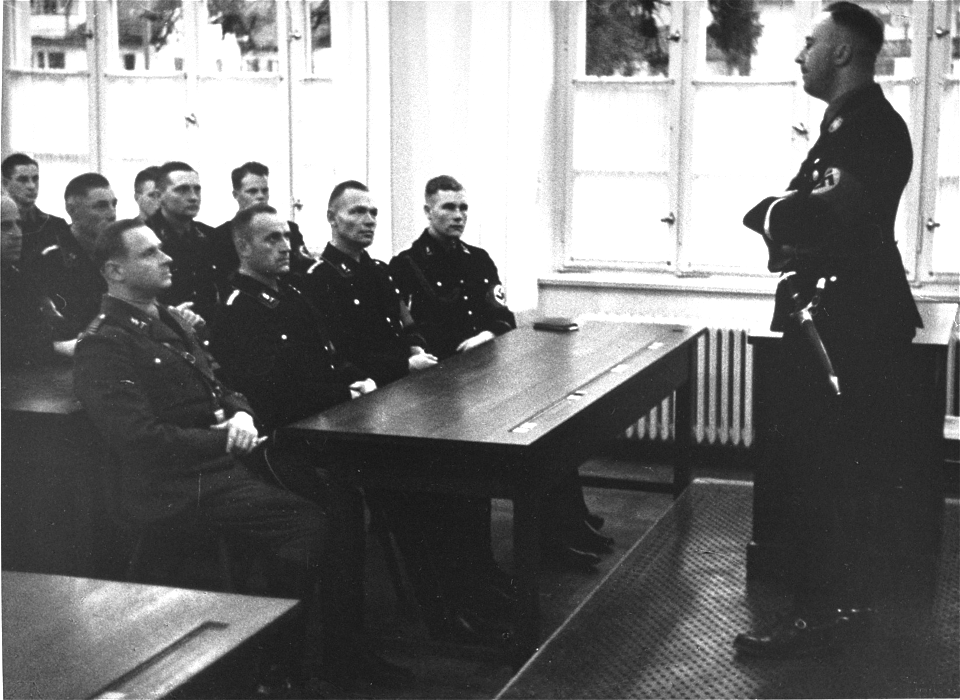
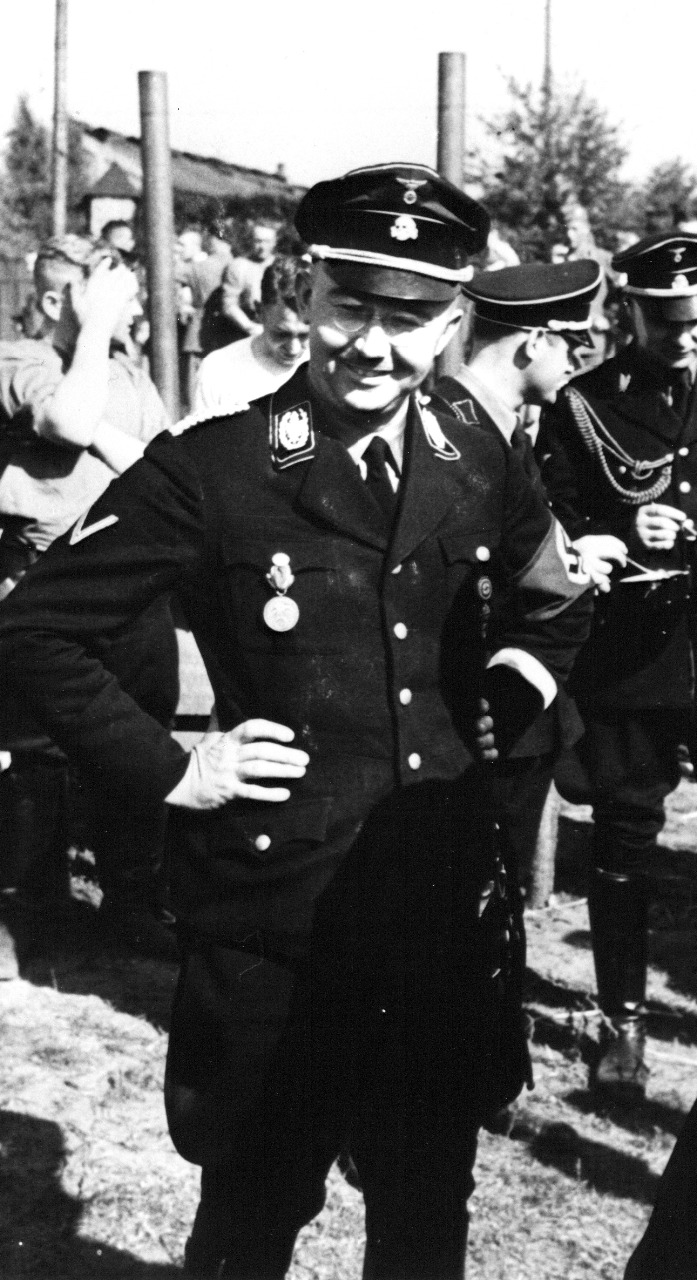
However, the archetype of a pathological child killer is not Heinrich Himmler, but the mythical Medea who, in cold blood, murdered two of her children to avenge her husband's infidelity.
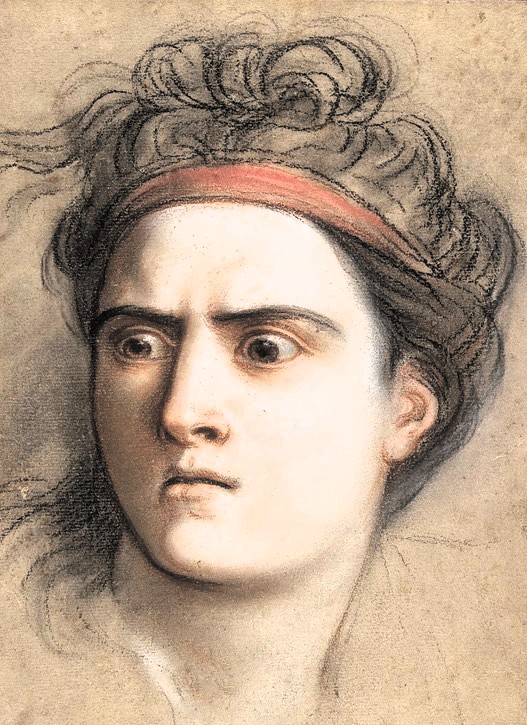
So it is a question of proportions. Like when the womanizer, mass murderer and marriage imposter Monsieur Verdoux defended himself in Chaplin's film of the same name:
Wars, conflict - it's all business. One murder makes a villain; millions, a hero. Numbers sanctify, my good fellow!
In fact, the cynical Verdoux quotes the English bishop Belby Porteus (1731-1809), a fierce opponent of the Church's hypocritical silence on, or even the defence of, the slave trade, which, according to him, was sanctified by greed. Profits even silence the Church and Mammon gags Jesus.
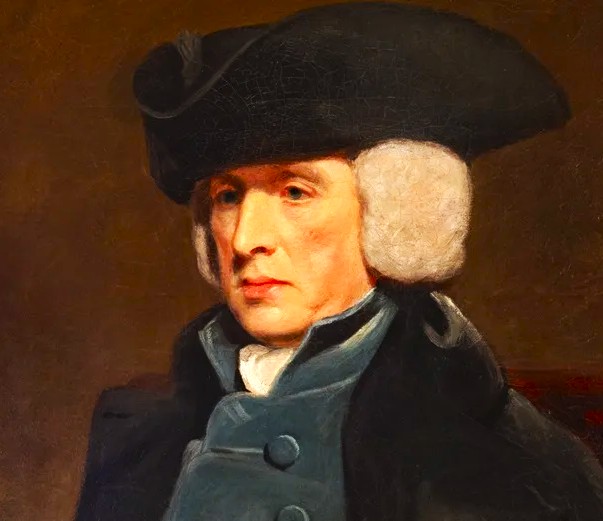

The absurdity of the dimensions of the murder is underlined in Jonhatan Littell's novel The Kindly Ones from 2006, in which the fictional SS officer Max Aue, without any apparent remorse, tells of his participation in the murders of Jews when he was an officer in the Sonder Commandos that liquidated Jews, partisans and gypsies on the Eastern Front and how he later became part of the organization of the concentration camps. This mass murderer gets into trouble not because of his participation in mass murder, which was rewarded with the Iron Cross, but because he was suspected on uncertain grounds of the murder of his mother and stepfather. Max Aue was therefore followed on his heels during the burning World War by two detective policemen from Kripo, the Nazi Kriminalpolizei. Kripo was mostly investigating crimes such as murder, rape and arson.

The title of the novel – Les Bienveillantes alludes to the ancient Greek theatrical trilogy Orestien by Aeschylus, in which Orestes, after murdering his mother, is hunted by the goddesses of vengeance, the Erinyes, but who is eventually exonerated in a trial, after which the Erinyes came to be called the Eumenids, the Benevolent. Max Aue is acquitted of the suspicion of his mother's murder, while his mass murders in the service of the Nazi regime are swept under the carpet.
The title of Littell's novel and its underlying Greek mythology bring us into the world of classical tragedy and one of its most fascinating characters – the child murderer Medea. She has followed me ever since we read Euripide’s drama at university. It was almost a shock to find how an author more than four hundred years before our era could have created such a passionate, insightful and multi-layered drama about a woman's anxiety and incredible crimes. How can a mother be driven to kill her own children? The drama is so rich and remarkable that I have read it several times, always in amazement.
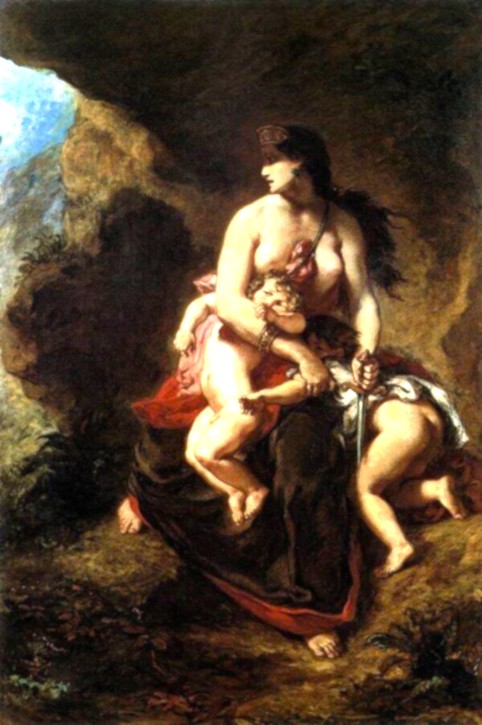
Medea's story begins with a journey that dates back to the Bronze Age, perhaps around 1,300 BCE. The greatest heroes of the Greeks, several of them sons of gods and later fathers of several heroes of the Iliad, had joined the young Jason to sail with him to Colchis, located at the far end of the world known to the Greeks at the time. Specifically, on the coast of present-day Georgia, below the vast, snow-capped mountain massif of the Caucasus. There, in a grove in Kolchis hung the Golden Fleece, for unknown reasons coveted by the entire known world.

Far away, in the city of Iolchis in Greek Thessaly, King Pelias had usurped power after throwing his half-brother Aison into prison. In good time, however, Aison had sent his son Jason to be raised far out in the countryside by the wise centaur Cheiron.
When Jason as an adult left Cheiron and sought out Iolchi's, he ended up at a party organized by his sneaky uncle. When he saw the handsome youth, Pelias understood that it must be Jason, the rightful holder of his throne, but Pelias also realized that he could not kill his popular nephew and decided instead to send him on what he considered to be an impossible and deadly adventure – namely, the theft of the Golden Fleece.
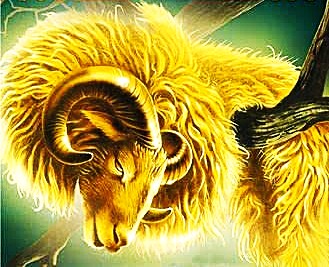
This treasure found its origin when the sea god Poseidon coveted the beautiful Theophane. In order to seize the lovable creature all for himself and prevent her from falling into the hands of other lovers, Poseidon turned the poor girl into a ewe and himself into a ram. Their remarkable offspring became Chrysomallos, a huge ram that could fly and speak, and had a fur coat of gold, which shone like the sun. The amazing animal was given by Poseidon to the sun god Helios.
Nefele, a nymph linked to cloud formation and thus also had something to do with Helios, was married to king Athamas, with whom she had a boy and a girl, Phrixos and Helle. However, Athamas grew tired of Nefele, made her his concubine (something Jason much later wanted to do with Medea) and instead married Ino, whom Hera disliked because she had once saved the newborn Dionysus (the result of one of her husband Zeus' extramarital escapades) from her wrath.
Ino hated Nefele and falsely convinced her husband Athamas that she was behind a famine and that in order for the gods to be appeased, he had to sacrifice Phrixos and Helle. However, Nefele managed to tear his children away from her enraged ex-husband, who was about to lay his children on the altar and cut their throats.
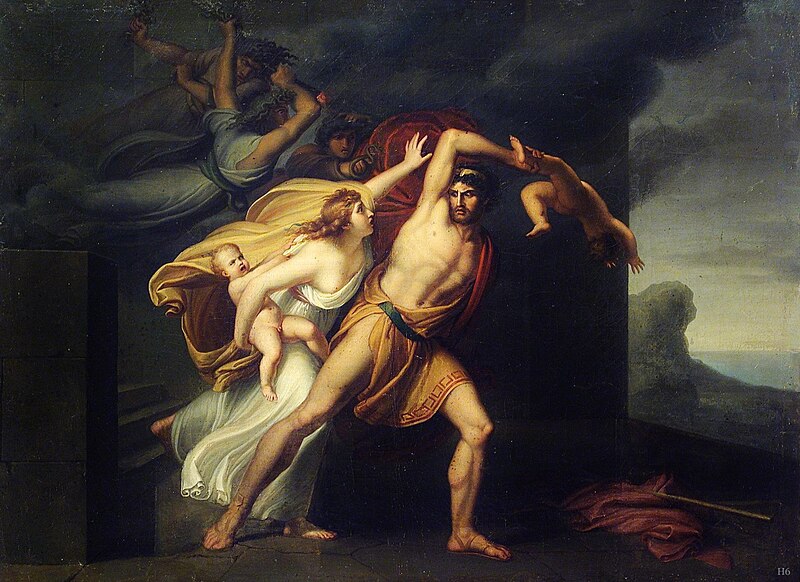
From his heavenly heights, Helios had witnessed the drama and sent his golden Chrysomallos to earth that the children of Nephele might be brought to safety at the end of the world, i.e. Colchis. During their journey, however, Helle was seized by vertigo and fell into the strait that came to be known as the Hellespont after her.
Phrixos survived the perilous journey and sacrificed Chrysomallos to Zeus, because the supreme god in the form of Zeus Phýxius was the protector of refugees and strangers. Phrixos gave Chrysomallo's golden fleece to Colchi's king Aïtes, who was the son of Helios. In gratitude, Aïtes guaranteed Phrixos his protection and allowed him to marry his daughter Chalciope.
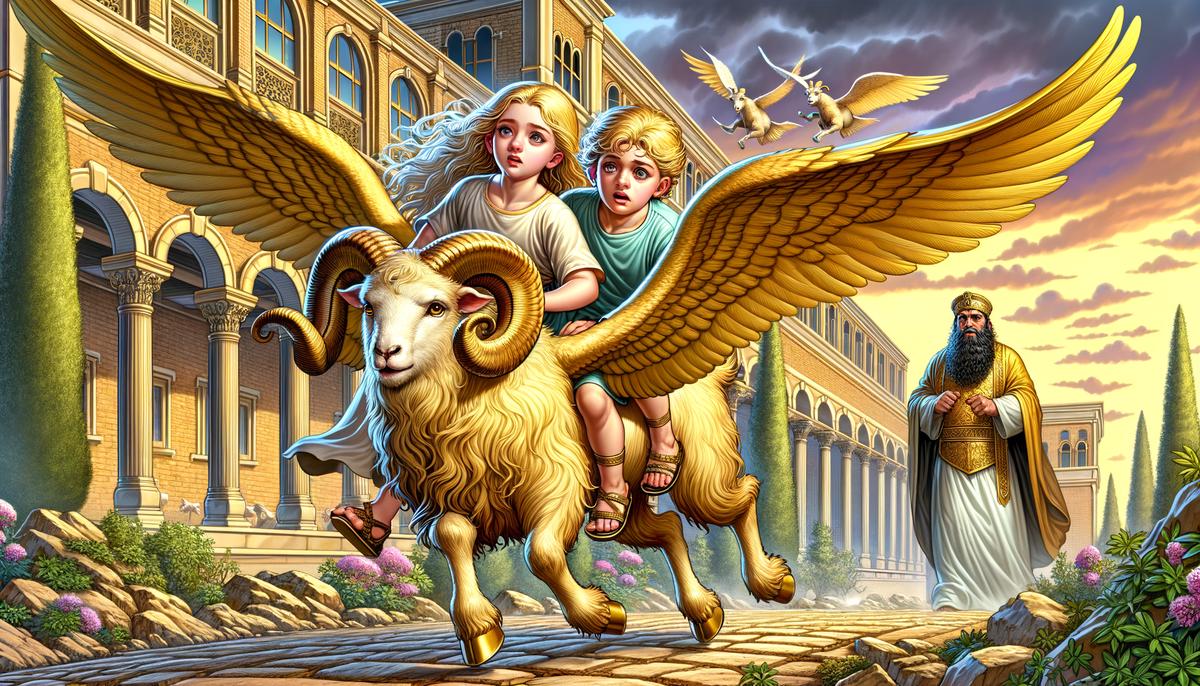
But why did Pelias send his nephew to retrieve the Golden Fleece? And the more difficult question – why did so many of Greece's greatest heroes accompany him on the perilous journey in search of a more or less incomprehensible object?
Like so many myths and fairy tales lost in ancient darkness, there are no proper answers to such questions, but that has not stopped a multitude of writers from trying to find answers to them. Before I tell about Medea, it might be enlightening to touch upon the issue of legendary quests
First, the fairy tale motif. All over the world, we find fixed patterns when it comes to the telling legends and myths. It is extremely common for young men, and sometimes the occasional woman, to set out in search of unknown places and things – Soria Moria Castle east of the sun and west of the moon, the Cave of Venus, El Dorado, the Holy Grail, the Philosopher's Stone, or the Herb of Life.
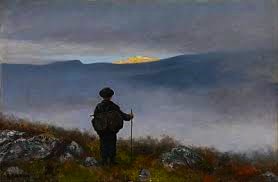
It can also be a story that symbolically depicts a young person's change into maturity. The heroes of these myths are, as mentioned, often young men who through their perilous journeys come to an understanding of what life is really about, or more often than not, they find a woman with whom they can share their life and have children. Or – perhaps it is a matter of following a destiny that higher powers have already determined for them.
For Jason, perhaps the hunt for the Golden Fleece was a combination of all of that – he sought a mysterious object that he finally obtained by overcoming a monster and brought back with him a beautiful woman, at the same time, he had with her help been able to accomplish a mission set about by Hera – that of marriage, fidelity and home, after all she was the goddess of home and maternal love. When Jason finally broke these sanctified conditions, he got really bad off, but at first – Hera had been gracious to him.
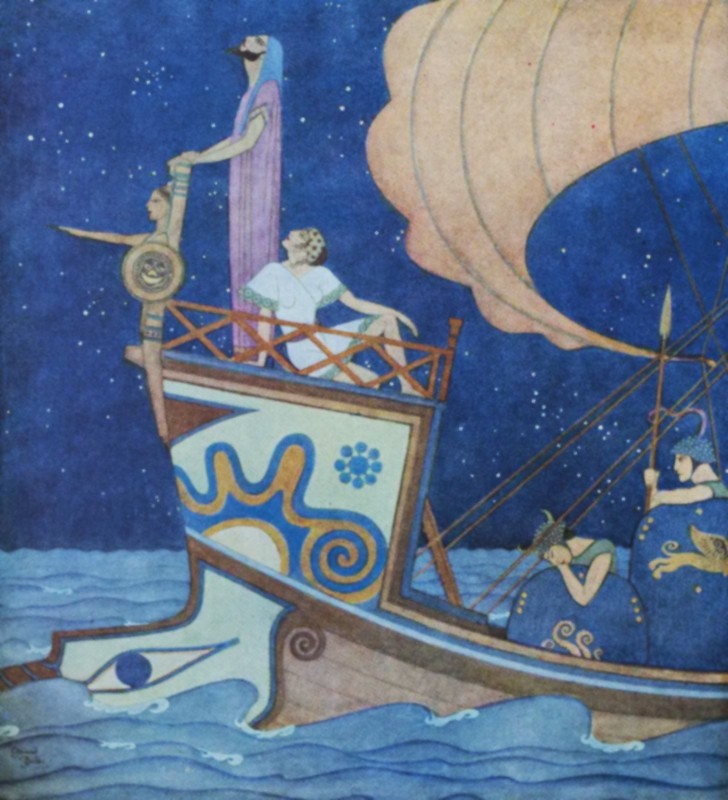
Hera had made plans for how to exact revenge on the Pelias, who was hated by her. He had on a number of occasions denied her the sacrifices that were due to her and, even worse, had murdered a woman within her temple.
Pelia's mother had been displaced by his father (apparently a common behavior among Greek kings) and remained living as a concubine in the house of King Salmoneo. However, the king's new wife, Sidero, treated her predecessor and her son so badly that, after he became an adult, the latter attacked his wicked stepmother so violently that she had to seek refuge in the temple of Hera. The enraged Pelias did not allow himself to be hindered by the fact that his so hated stepmother had sought Hera's protection, but rushed after Sidero into the temple and stabbed her to death in front the altar dedicated to Hera, thereby irreparably defiling the sanctuary of the goddess.
When Hera heard that Pelias was again arranging a great sacrifice to the gods, but one more intended to omit her, the goddess changed herself into an old, broken woman, and sat herself down at a crossroads outside the city of Iolchis, asked passers-by to carry her across a swift running stream. This was the goddess's way of finding someone worthy of her trust.

Passers-by ignored the disguised Hera's request for help until Jason appeared and carried her across the river. Hera realized that this handsome young man was to be trusted. However, one of Jason's sandals had been stuck in the river, and when he later showed up at Pylia's sacrificial ceremony, Pylias was horrified to notice that he was missing a sandal. The despotic ruler had namely been prophesied that a young man wearing only one sandal would eventually cause his death, and what was worse – when asked who he was, Jason replied:
Having now reached the age of twenty without having previously uttered any insults or committed deplorable acts, I have come home to restore my father's former honour and to reclaim the royal title that others have usurped.
The terrified Pylias promised Jason to have the best possible ship built, lavishly equipped, and man it with Greece's most intrepid youths, not least the great Heracles, so that Jason could thus would be able to conquer the Golden Fleece and prove himself worthy of Iolchi's royal throne.
This was a test of manhood that caused by the fact that Jason had been wearing only one sandal, a sign that he only had one foot on the ground and found himself in an intermediate stage, halfway between youth and maturity. The great adventure would make Jason a real man, someone who had proved his strength and courage.
It was the poet Pindar (518 – 438 f.Kr) who had narrated this in an ode he sang during the Olympic Games in 466 BCE. In the ode, Pindar also paid tribute to Medea, whom he made sing about the voyage of the ship Argos:
Thus sounded Medea's rhythmic song, and in immovable silence the godlike heroes bowed their heads as they listened to her wise counsel.
Pindar’s stanzas were part of the first longer account of the Argonauts' journey to Iolchis, though Apollonius of Rhodes (295 – 215 f.Kr.) Argonautica became the classic account of their adventures, dramatic and well-written in artful Greek by a librarian at the huge library of Alexandria, where he had access to the large number of heroic tales and geographical depictions that came to form the basis of his story.
Medea is the person who stands out most sharply and the reader gets to follow her thoughts and feelings through inner monologues. The other characters of this fanciful fairy tale, including Jason, are far more standardized depictions. Argonautica is a classic adventure story, filled with excitement and romance.
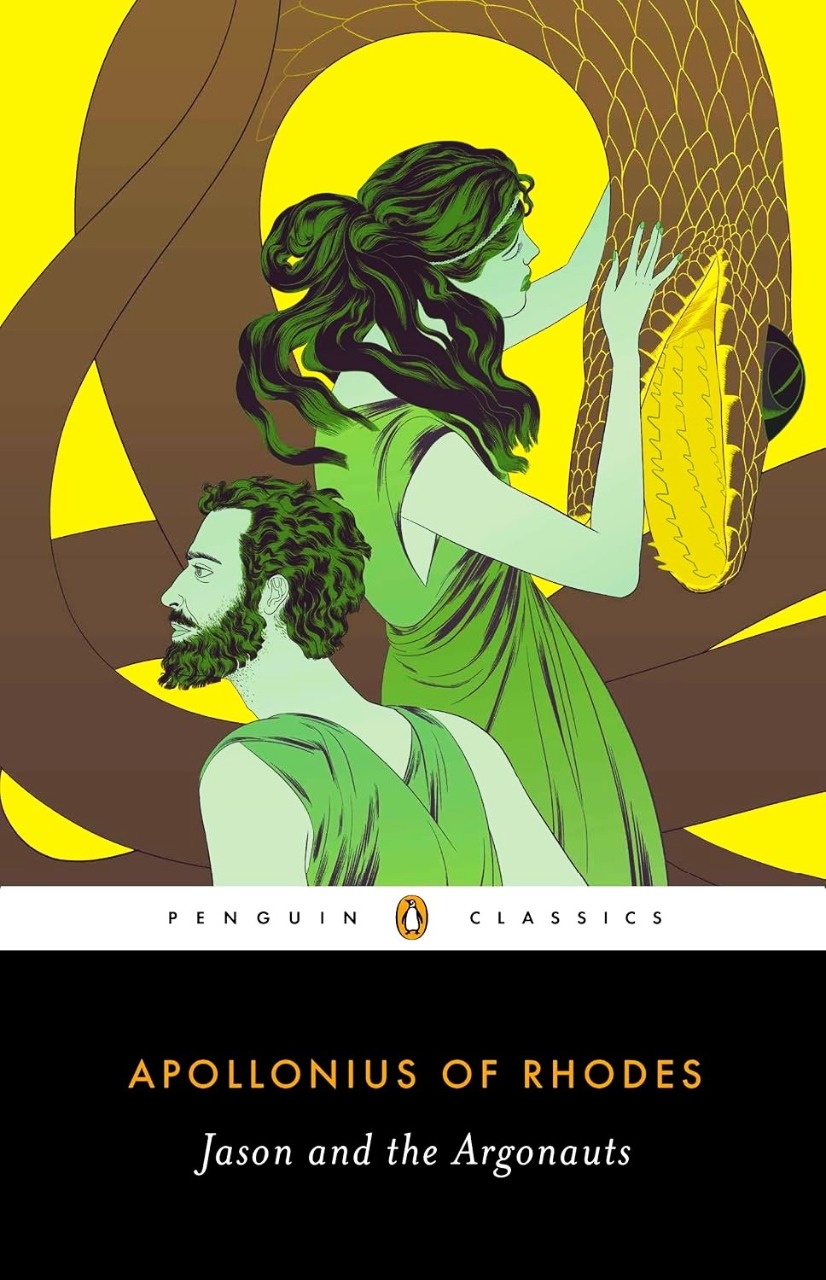
The stately ship Argos was by the master builder Argus created under the direction of the goddess Athena. Argus then accompanied Jason on his journey. Argos was timbered from spruce and its fifty oars were made from pines cut at the sacred Mount Pelion. In the bow, Argus hammered a branch from a sacred oak growing in the grove of Zeus in Dodona, where the trees could speak. The branch had the ability to speak in times of danger and then advise Jason on what to do.
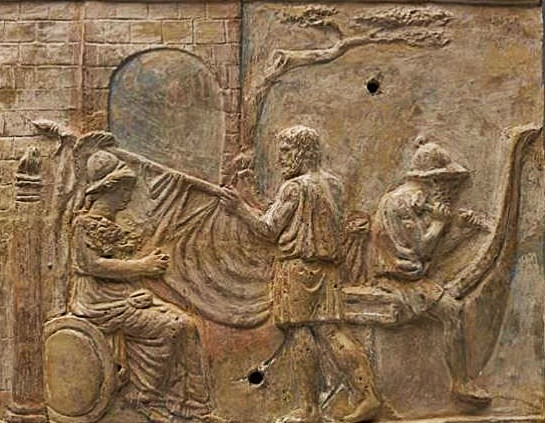
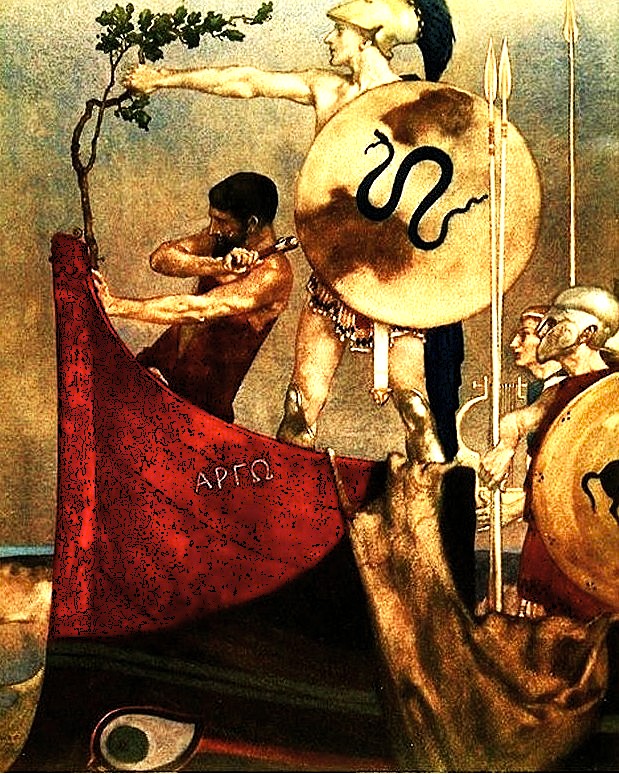
It was time to leave. The men and women of Iolchis gathered together to bid farewell in admiration, weeping, and lamentation to this formidable gathering of Greece's most beloved idols, all stately young men, spectacularly dressed in armour and exquisite cloaks walking down to the Argo, the most magnificent ship ever built in Greece. With exquisite eloquence, Jason comforted his loved ones, but as he walked down to the waiting ship in celebration, he barely noticed
Iphias, the aged priestess of Artemis, their City’s guardian, who came forward and kissed his right hand, but was unable for all her eagerness to say a word to him as the crowd swept on. She was left there by the roadside, as the old are left by the young. Jason had passed and soon was out of sight.
One of the many exquisite scenes that Apollonius provides with, sometimes, as here, with a discreet, sensible commentary.
The young fighters boarded the ship and placed themselves on their predestined places on the rowing benches, when the Argos had reached open water the huge sail was stretched by a gentle breeze and the adventure began.
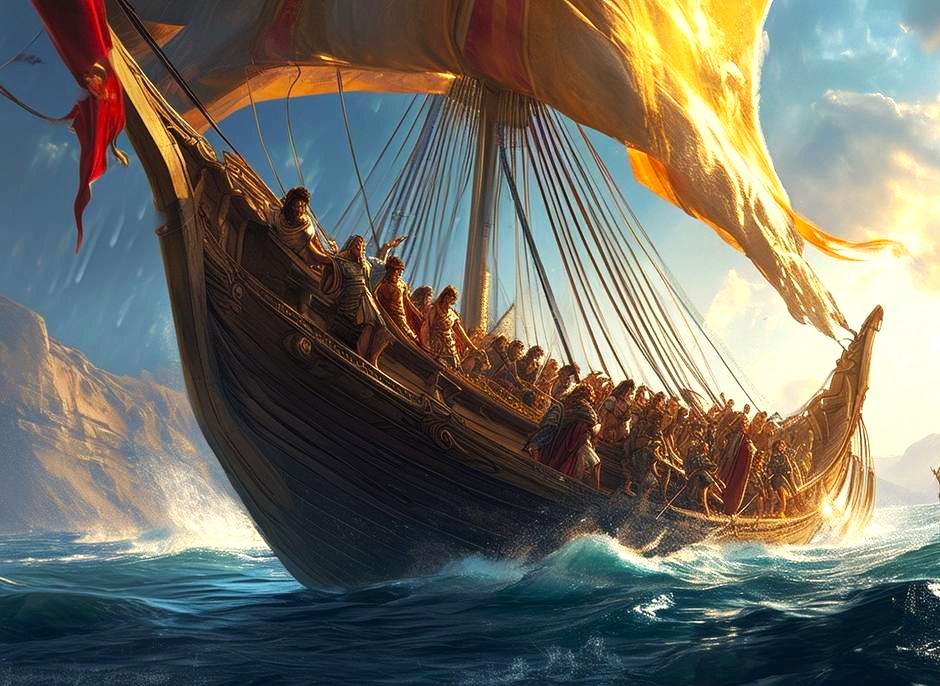
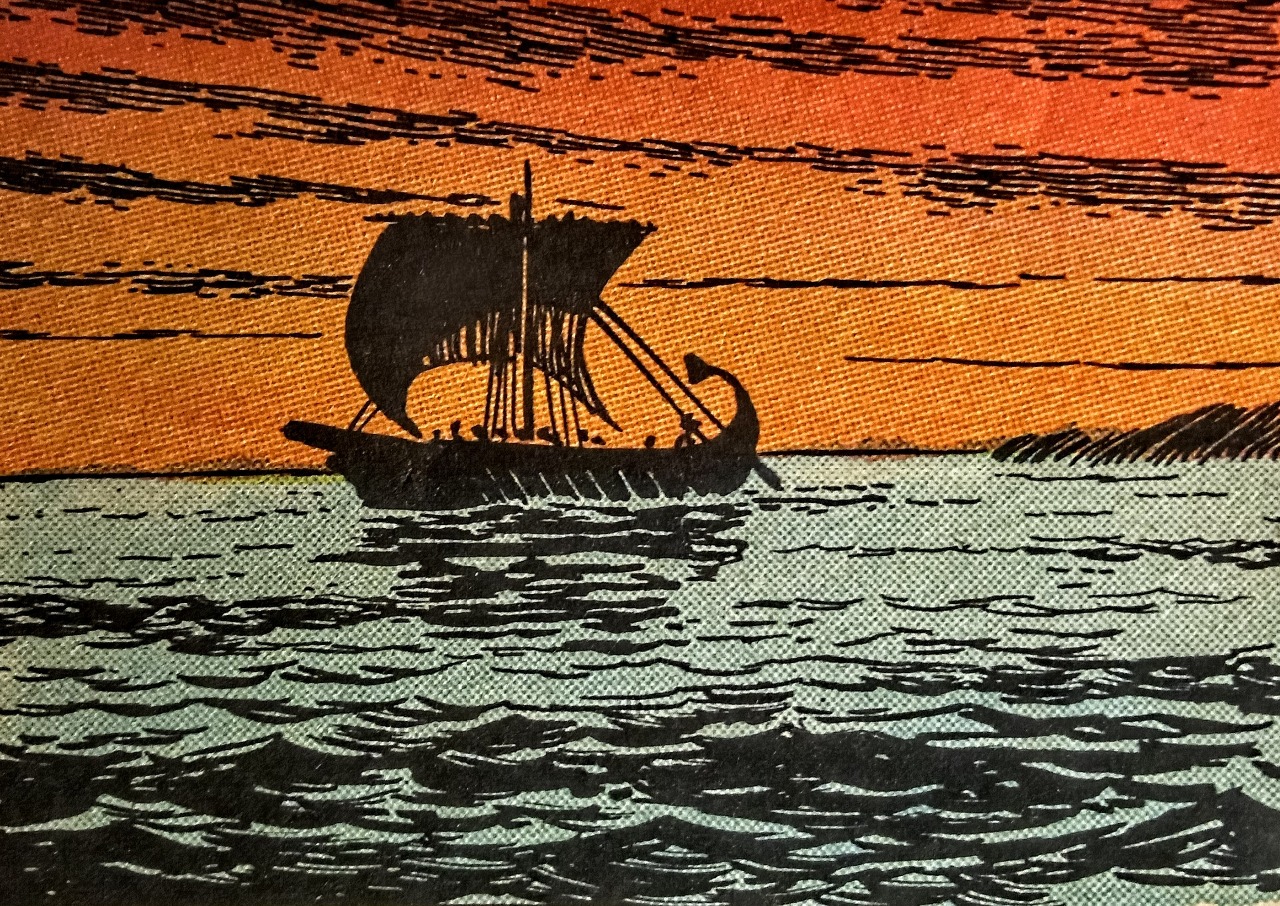
They sailed north and then followed the southern coast of the Black Sea towards Colchis, but it was not only a journey through real shipping lanes but also through the enchanted world of myths. The Argonauts fought hostile armies, six-armed monsters and flying harpies, sailed between insidiously wandering cliffs, shipmates were abducted by water nymphs, or fell victims to huge wild boars with poisonous bites, hideous eagles shot deadly feathers at them.
On several occasions, the men's patience seemed to be running out, and they wished for nothing more than to return home. But Jason's eloquence and firm conviction that they would succeed in conquering the Golden Fleece and thus everlasting glory, managed to convince the crew that it would be unwise to return when they had come so far and put up with so much.
A shore attack with future consequences, that was not told by Apollonius, but was preserved in a number of legends, was when King Laomedon of Troy asked Heracles and Jason to kill a Chetus, a kind of huge sea monster, which was tormenting the inhabitants of his city. Heracles killed the monster, but Laomedon denied the Argonauts their rightful reward. The result was that Heracles and Jason later returned and plundered Troy. When a huge Greek army several years later fought the Trojans, something that is told in detail in the Iliad, it is told that Jason and Heracles were among the fighters.
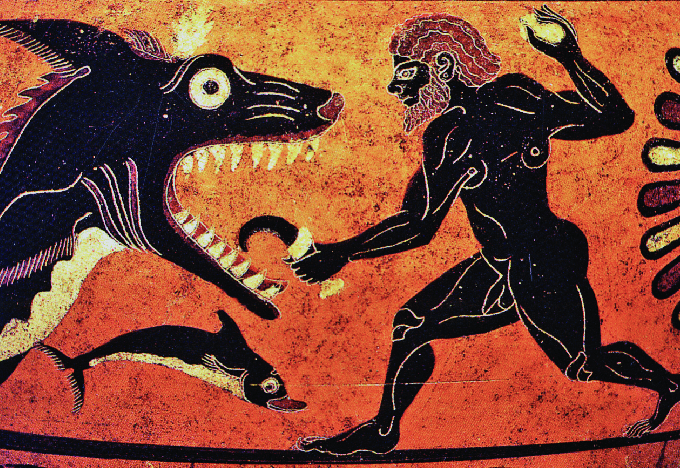
This is according to medieval chansons gestes, songs of glorious deeds, – in fact, both Jason and Heracles were far too old to participate in the Trojan War and legends about them seem to be older than those told about the Trojan War. The deeds of Heracles are often mentioned in the Iliad, but already there they have become fairy tales.
The Iliad also mentions Jason, but only as a famous "seafarer", father of the king of Lemnos. In medieval chansons , however, Jason's love story with Medea is highlighted and Heracles has become a mighty hero who in the battles of Troy even overshadows Achilles. At the end of the siege of Troy, Heracles hacks his way through the warlike turmoil with his huge sword until he meets Laomedon and with a stab makes his head fly over the violently fighting warriors.
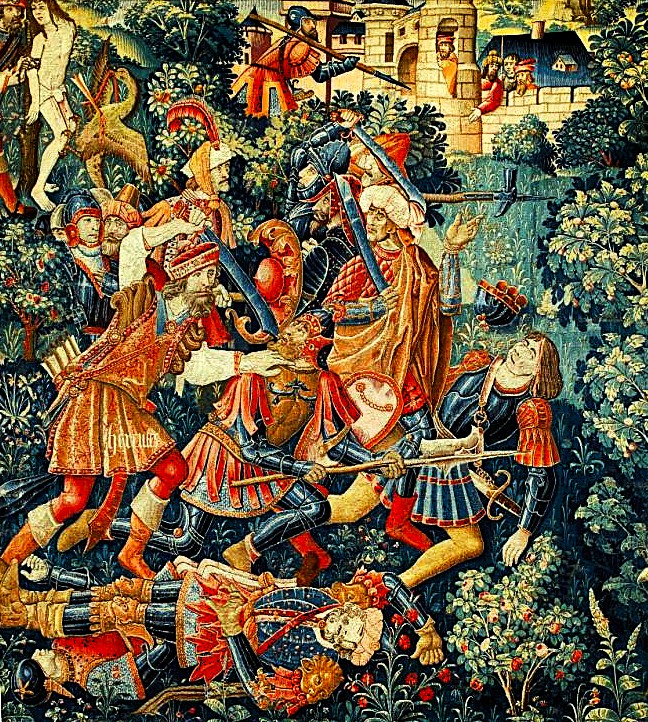
With Apollonius of Rhodes, Jason is not a complete hero, he is equipped with shortcomings and human weaknesses. At times, Jason had considerable difficulties in asserting himself among his equally strong and often more experienced followers. Often he had to confirm his leadership with the support of the seers and respected mediators who had come along for the adventure, not to mention Zeus’ speaking branch nailed to Argos bow, as well as ever-emerging gods and other mythical beings.
At first, Jason seemed to be bothered by being in the shadow of the mighty son of Zeus, Heracles, who even before he joined the Argonauts was widely famous and had been travelling through the kingdoms they arrived at during their journey. Before leaving, Jason had let the Argos crew vote on who they wanted to be their leader and the choice had then fallen unanimously on Heracles, who declined with the reference that it was actually Jason who had been given the task of conquering the Golden Fleece and thus chosen by gods and humans to lead them, despite his youth.
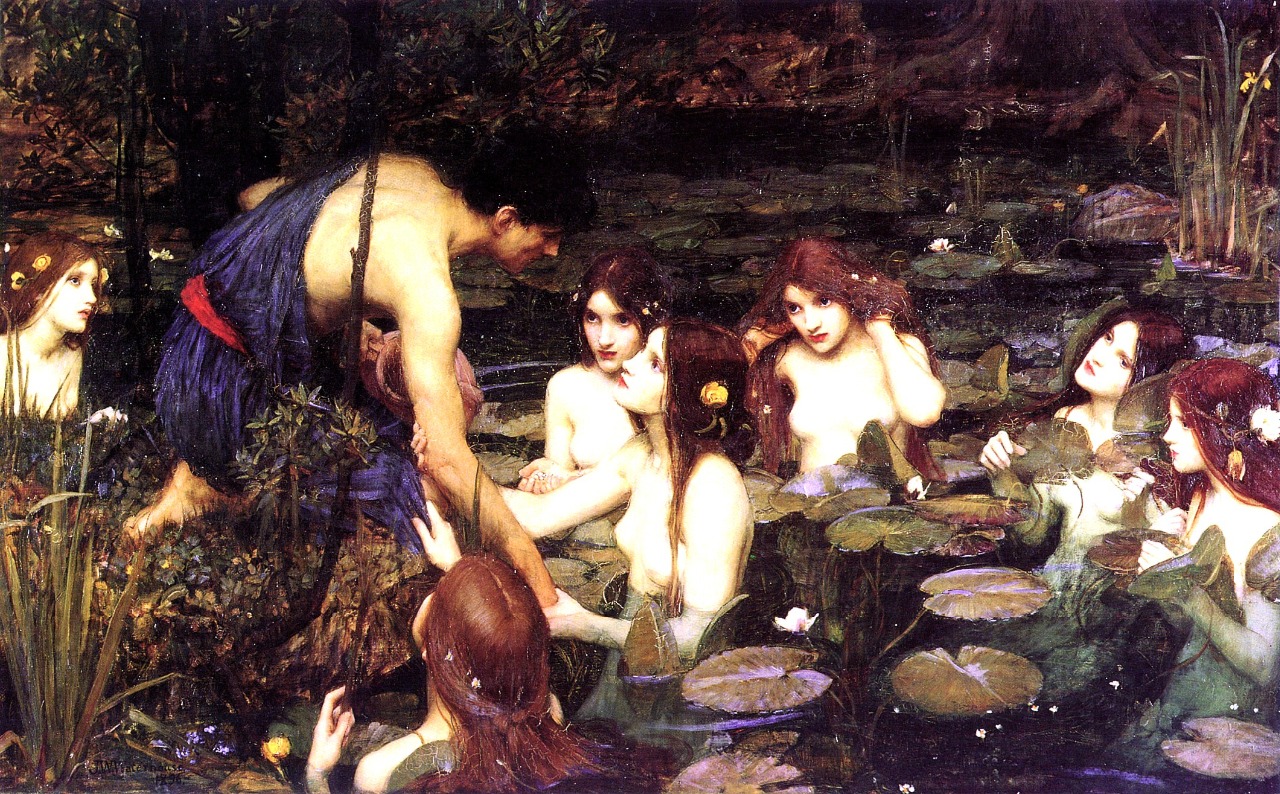
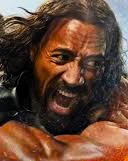
When Heracles' young friend, lover and squire, Hylas, was abducted by water nymphs, and Heracles beside himself and filled with concern for his friend, desperately and furiously lost himself in the forests, Argos' helmsman, Tiphys, requested that they had to take advantage of the fair winds and interrupt their search and waiting for Heracles. Jason agreed with him, However, once out at the open sea, his crew raged against Jason, demanding a return to continue the search for Heracles. The hard-pressed Jason was once again asked for help from the gods, and as an answer to his prayer the gigantic, green sea creature Glaucus, appeared out of the depths, grabbing hold of the ship's railing and asserting to the terrified men that Jason had the full support of the gods. A relieved and much more animated Jason could then take a more secure grip on his commanding power.
Apollonius occasionally lapses into marking only the places that the Argonauts pass through, or where they make their landings, by offering brief notes on the myths and topography that had been associated with them. Occasionally, however, the drama took the form more detailed descriptions of exciting and strange events. Like the meeting with Phineas, a seer who had preferred a long life instead of sight and therefore had been blinded by the gods, though blessed with a profound knowledge of the future. For example, he had told Phrixos that he should let the golden ram Chrysomallos carry him to Cholcis. But Phineas could not refrain himself from telling the horrors that awaited even the gods, and also all of mankind. Zeus became annoyed by this sincerity, and thus punished Phineas, who could not see his own future, by allowing him to be tormented by the harpies, abominable flying beasts, half women, half vultures. As soon as he was about to eat, these monsters plunged down from heaven, ate what they could of Phineas' food, and defiled the rest.

The Argonauts' first sight of the starved, worn-out and blind Phineas is a good example of Apollonius' art of depiction:
He rose from bed, like a phantom in a dream, and with the aid of a staff crept to door on withered feet, feeling his way along the walls. Weakness and age made his limbs tremble as he walked; his shrivelled flesh was caked with dirt, and his bones were held together only by the skin. When he had come out from the hall, his knees gave way and he sat down on the threshold of the courtyard. And there he swooned. The ground beneath him seemed to reel; and he sank down in a coma without the power to speak or stir.
When Phineas had come to his senses and listened to the youthful voices of the Argonauts, he raised a desperate prayer to Zeus for the thousandth time begging him for mercy, and suddenly he saw in his mind's eye not his own future but that of the Argonauts, and understood that they had come to free him from the terrible harpies, which they also succeeded in doing. An overjoyed Phineas offered the Greeks a splendid banquet in gratitude and told the Argonauts of their future travel and what would happen to them next. Wise of the injury, however, he left out all the misery that would befall each of them. After that, Phineas, still blind, had a fairly fine life. However, he never died, but in due course turned into a mole.

Phineas told how the Argonauts would get past the dreaded Clashing Rocks. Soaring cliffs that rose vertically into the sky without a foothold in the depths of the sea. Every ship had to pass them, and almost all of them were doomed to perish, but Phineas could give advice on how to get past them. He told the Argonauts how they would be able to escape being crushed and be carried past them by the treacherous currents produced by the rocks. The depiction of Argo's journey between the rocks is certainly dramatic.
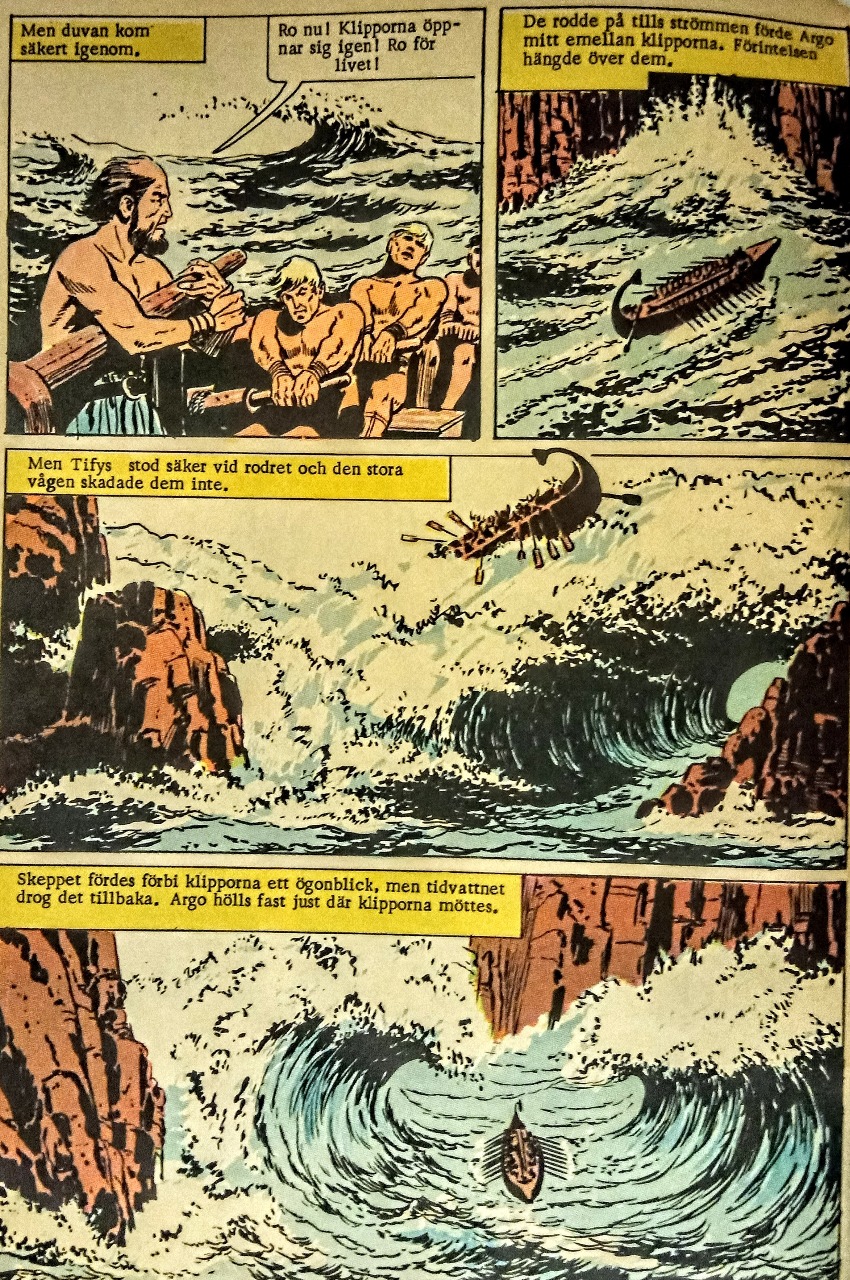
Before the Argonauts had arrived at Phinea’s Island, Jason had committed a rather deplorable act, a premonition of his future betrayals. Before the Argonauts went ashore at the island of Lemnos its women had murdered all of their sybaritic husbands, who had become accustomed to living in the hustle and bustle of slave girls they had abducted during their wars. Their present queen, Hypsipyle, had, however, advised the women not to carry out their cruel revenge and had not herself taken part in the slaughter of the pitiful men. She had the women that after their bloody deed, they would be forced to perform the men's hard chores, such as plowing the hard soil, fishing on the treacherous sea, and caring for unruly cattle. On top of this hardy life, they would live in fear of being attacked by their neighbors – the warlike Thracians.
When the women a little over a year after the murders, sighted the approaching Argo, they feared that it was Thracians who would attack them. However, pleasantly surprised they found that the crew was handsome, friendly young men. Since Hypsipyle had previously advised her female subjects to conceal their crime and seek love from capable men, they now did everything possible to attach the Argonauts to them, and they succeeded beyond expectations.
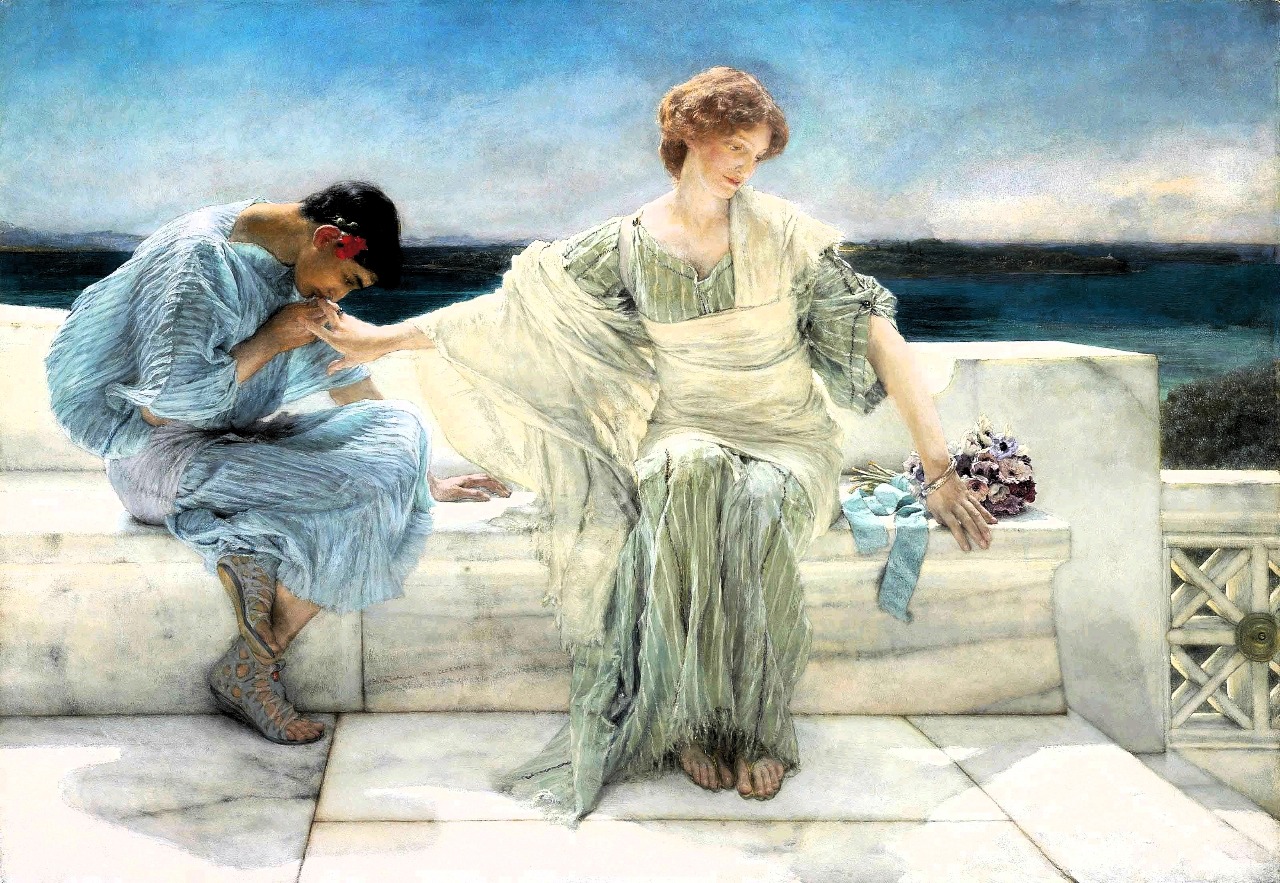
The Argonauts decided to stay on the island and put the journey to Colchis out of their minds. Jason played along and seduced the beautiful Hypsipyle with false pretenses of a happy life together, although all the time he was focused on traveling on to Colchis after the pleasant stay at Lemnos.
When Hypsipyle became pregnant with what would turn out to be twins, Jason decided to abandon her and with a fiery speech he managed to get his men to follow him on towards Colchis. He alleviated Hypsipyle’s' grief by lofty promises of a speedy return, which turned out to be a lie, combining his promises with threats to expose the crimes of the Lemnian women.
The grieving Hypsipyle was by hope and love driven to believe in Jason and gave him as farewell present a god-given fantastic cloak, which Jason later passed on to Medea, who in the future used it to take the life of Jason’s new, young wife. For his crimes, Dante relegated Jason to a place in his Inferno:
The good master [Virgil, Dante's companion], though I have not asked,
said to me, "Look at him there, so tall,
who, despite his pain, does not seem to shed tears,
what a royal countenance he maintains!
That is Jason, through courage and wisdom,
from the Colchies took the golden fleece.
He came on this trip to the island of Lemnos
where cruel, bold women
to all his their had given death.
With beautiful speech and flattering signs
he deceived Hypsipyle, the maiden
whom had heated all fellow sisters.
There he left her, pregnant and alone;
for such a crime he is condemned to this torment [being constantly whipped by demons],
and even for Medea he is punished.
I do not have an English translation with me here, so I had to do a clumsy translation from Italian.
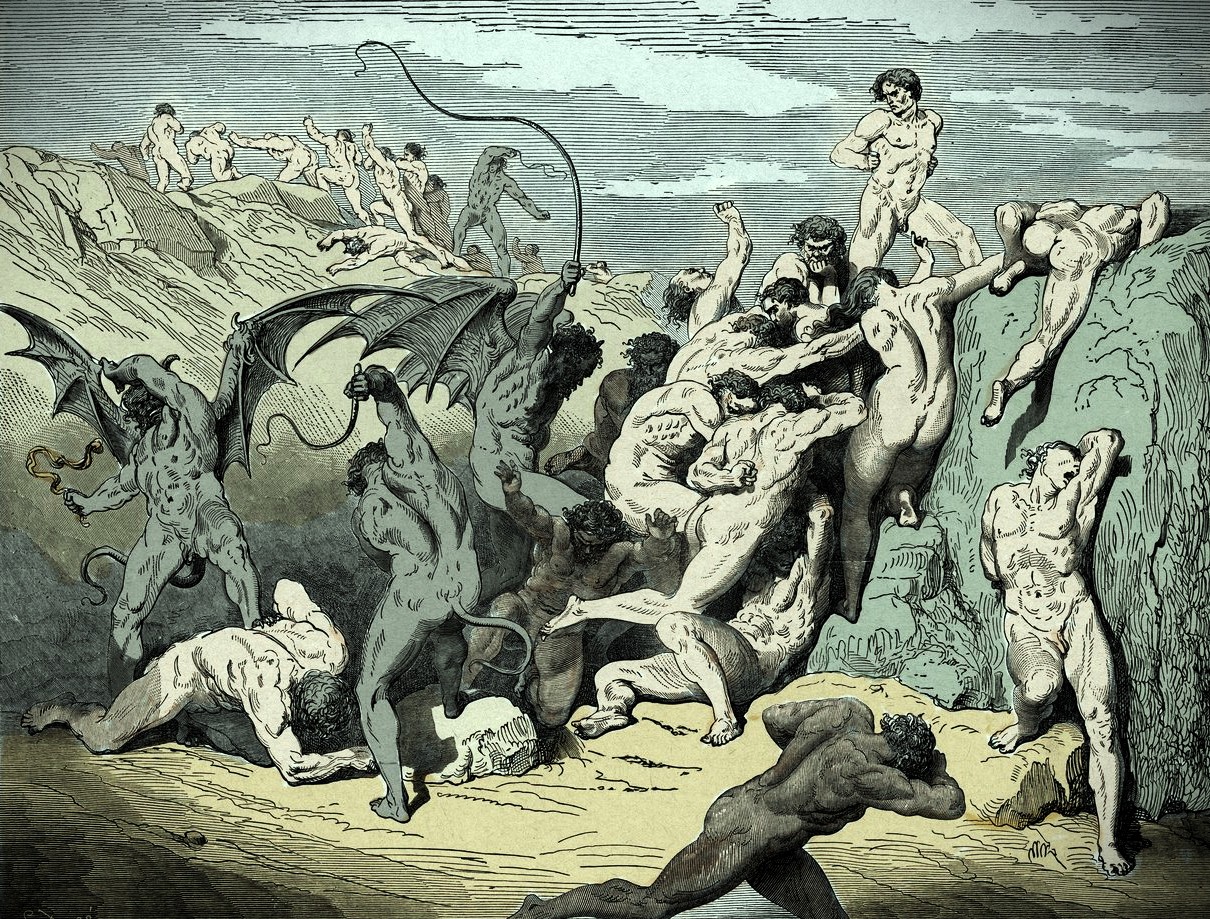
Finally, the Argonauts reach the destination of the journey – Colchis. If they had expected a miserable outpost by the end of the world, they were mistaken. They are greeted by a thriving city with an imposing palace of gold and marble over which the tough and powerful Aïtes, son of the Sun himself, Helios, rules with an iron grip.
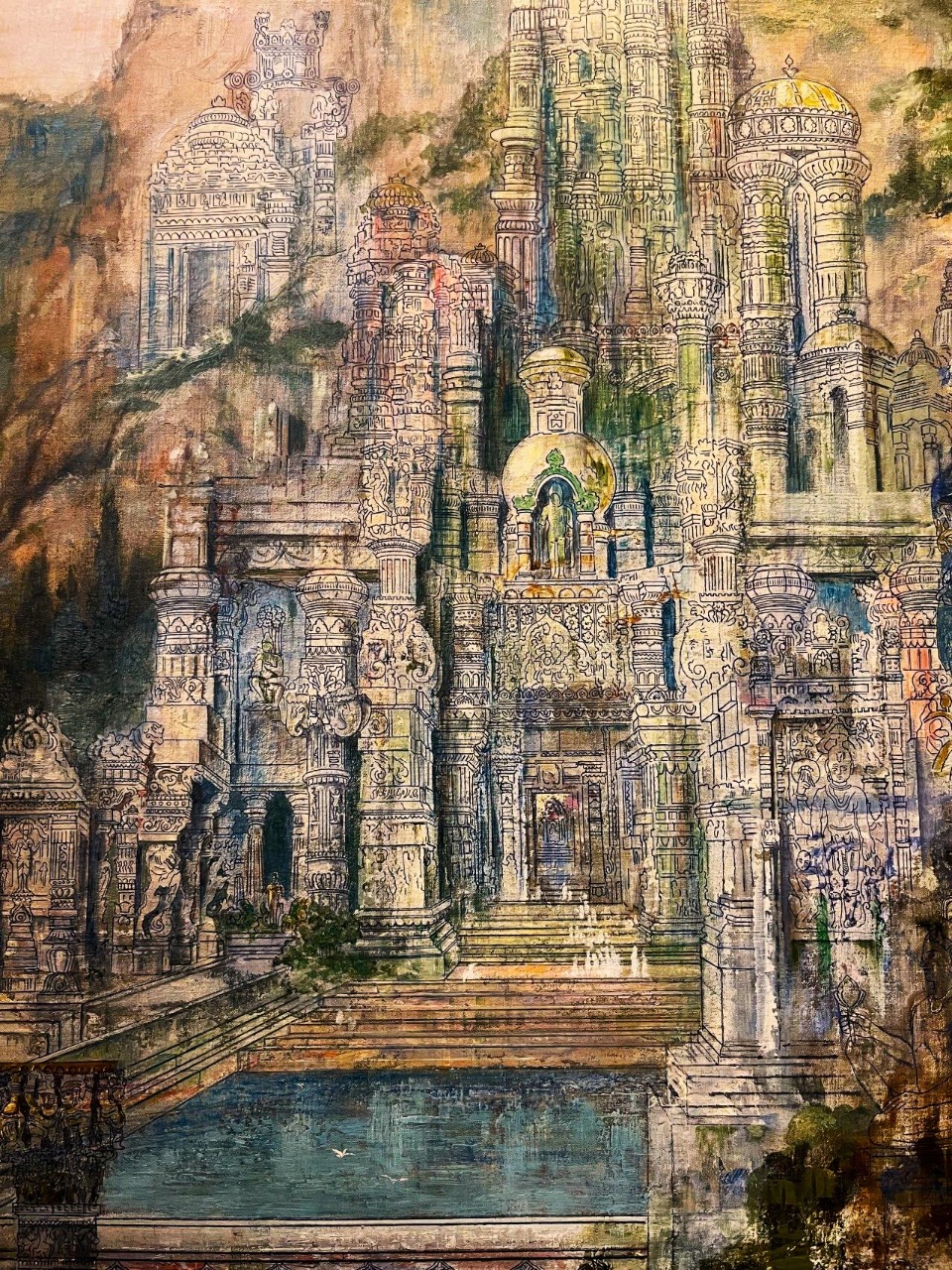
The surrounding landscape stunned the Argonauts, they had never seen mountains as high as those that crowned the impressive Caucasus mountain range. They knew that high up there Zeus had chained the mighty titan Prometheus, the benefactor of men, chained, while an eagle gobbled his liver every day, the liver was restored the next morning. The Titan's cry of pain gave the Argonauts a hint of hard trials that lay awaiting them.
And now the last recess of the Black Sea opened up and they caught sight of the high crags of Caucasus were Prometheus lied chained by every limb to the hard rock with fetters of bronze, and fed an eagle on his liver. The bird kept eagerly returning to its feed. They saw it in the afternoon flying high above the ship with a strident whirr. It was near the clouds, yet it made their canvas quiver to its wing as it beat by, for its form was not that of an ordinary bird: the long quill-fathers of each wing rose an fell like a bank of polished oars. Soon after the eagle had passed they heard Prometheus shriek in agony as it pecked his liver, the air rang with his screams till at length they saw the flesh-devouring bird fly back from the mountain by the same way as it came
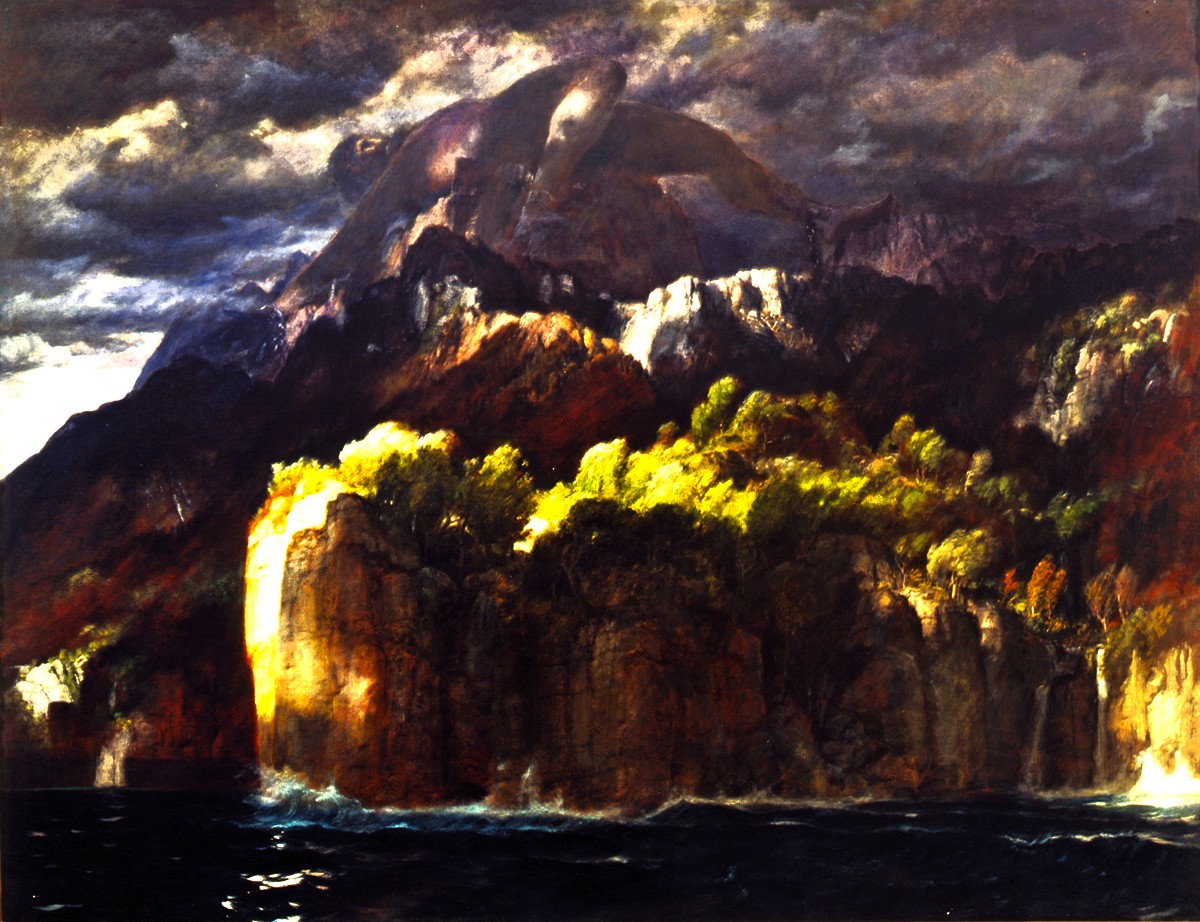
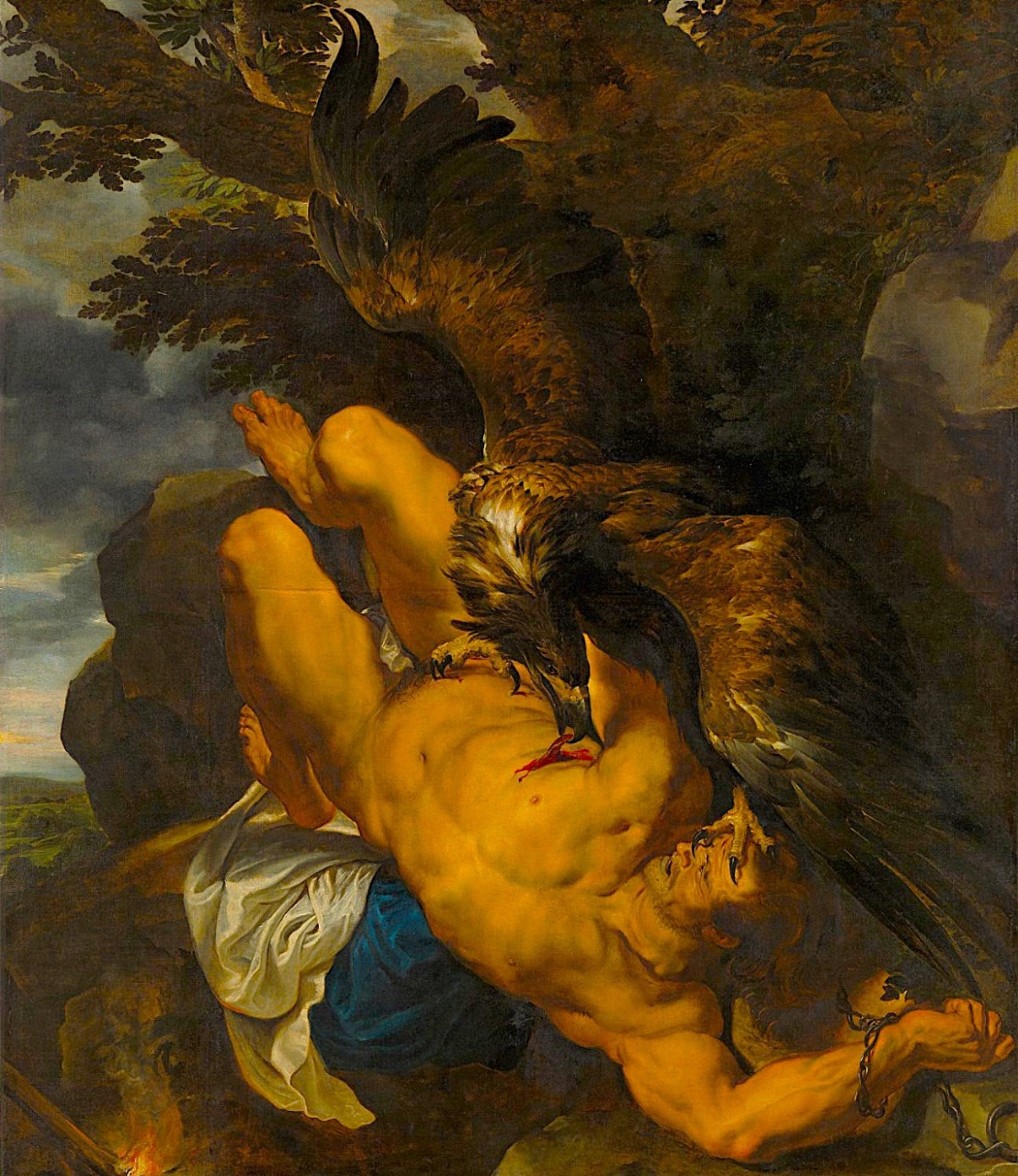
It is in Colchis that the drama takes on a more human touch than before, the characters – especially Medea – take on a firmer form and character. Through Jason King Aïtes found out that the Argonauts were after his beloved Golden Fleece and he became furious. He had sworn never to lose the precious fur that had become one with the fame of his kingdom. Aïtes had nailed the Golden Fleece to the broad trunk of an oak consecrated to Zeus. No man could approach the treasure because it was guarded day and night by a gigantic serpent, whose long fangs dripped with deadly poison.
Aïte's fury was further heightened by Jason's offer to attack Colchi's enemies in exchange for the golden fur. What enemies could a king like Aïtes fear? If he needed an unbeatable army, he single-handedly sowed a field with the dragon's teeth that he, together with his kinsman Cadmos, had knocked out of the jaws of a dragon they had slain outside Corinth. Each time, the dragon sowing gave rise to an army of invincible warriors.
The goddess Hera knew this and together with her confidant goddess – Athena, who also was captivated by Jason’s charm and beauty, Hera went to the goddess of love, Aphrodite, and at the insistence of the goddesses Aphrodite agreed to send her mischievous son Eros to pierce Medea's heart with one of his arrows of love.

Medea had from her aunts Circe and Parsiphaë inherited the arts of magic, the good as well as the evil ones. Medea served as high priestess in the temple of Hecate. Like the great Apollo, the god of light and art, but also lord of plagues and rats, Hecate also had a dual nature. She was the goddess of healing herbs, health and security, but also of the unbridled, cruel Nature, of evil magic and dark powers.
Eros' arrow badly wounded Medea, who until then had been her father's most beloved child, faithful and obedient to him in everything. In addition, she was extraordinarily beautiful. Like her father and her aunts, she was endowed with the sun's piercing gaze and dazzling blondeness. This is despite the fact that she is generally portrayed as black-haired and exotically alluring.
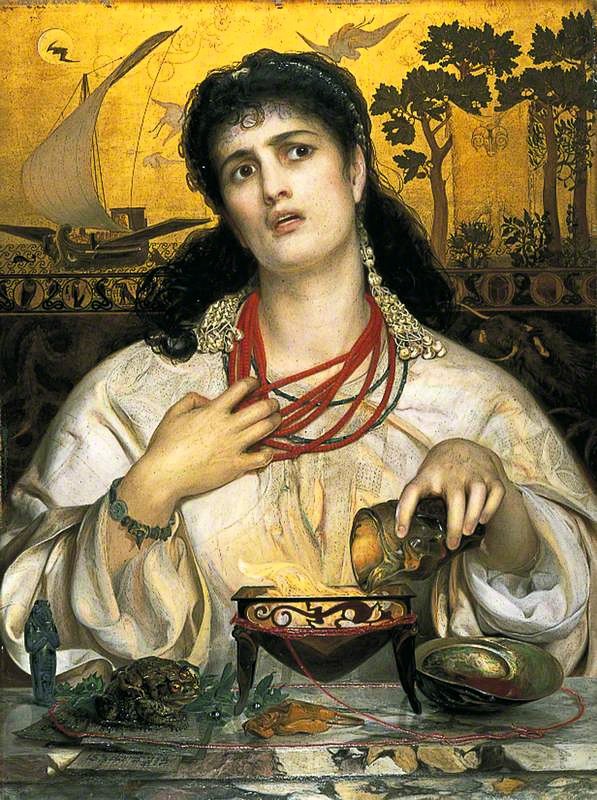
When one of her handmaidens had informed Medea that handsome strangers from a distant land had sought out her father, she was seized by a disturbing premonition that her life would now be profoundly changed. Her connection to the dark forces of destiny made her realize that her fate was going to become connected to these strangers and that the future would bring nothing good.
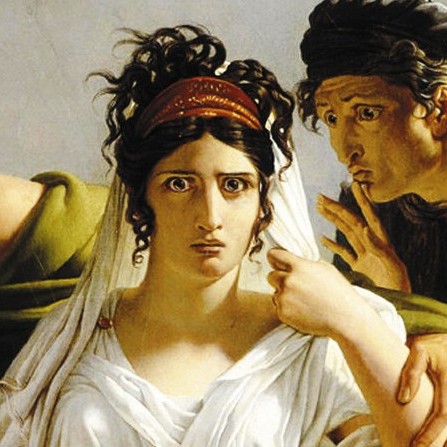
And it got even worse when, at the first sight of Jason, she was simultaneously hit by Cupid's well-aimed arrow and struck by a violent desire for this divinely beautiful youth. As Ovid wrote in his Metamorphoses, Medea was already at the first sight of Jason hopelessly lost and helplessly captivated:
She fell deeply in love with the handsome Jason. Despite a long struggle against her feelings, her reason was powerless to master her passion: “It’s useless to fight Medea,” she said. “ Some God is against you. This or something akin to it surely, is what they call love. How else should I fear for the life of a man I have only just seen? – But why should I feel so afraid? How wretched I am! I must extinguish the fire which is raging inside my innocent heart. I should be more sane, if I could!
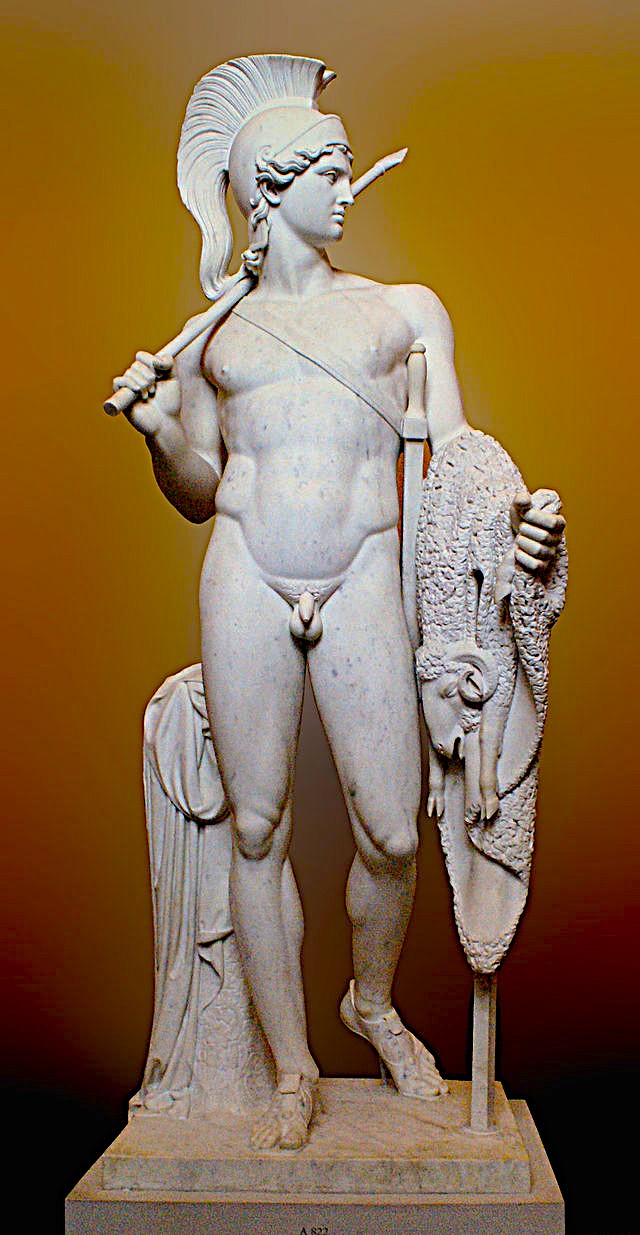
Jason had not been hit by any of Eros' arrows, though he understood that his only way to complete the hopeless mission assigned to him was to seek help, something he had often had done often during Argos' journey towards Colchis.
As in the world of fairy tales, Aïtes made a promise to Jason that he could receive the Golden Fleece as a gift if he could prove himself to be more than an ordinary person. Accordingly, Aïtes gave Jason three utterly impossible tasks – subdue the king's huge, fire-breathing bulls, equipped with deadly pointed bronze horns, then harness them in front of a heavy plough and plough a field while sowing it with dragon seed that would give rise to an army of demonic warriors. After defeating these bronze-clad demons of the Underworld, Jason must overcome the terrifying poisonous snake that tirelessly guarded the Golden Fleece. Only then would he be found worthy to lift the skin from its oak trunk and bring it back to Greece.
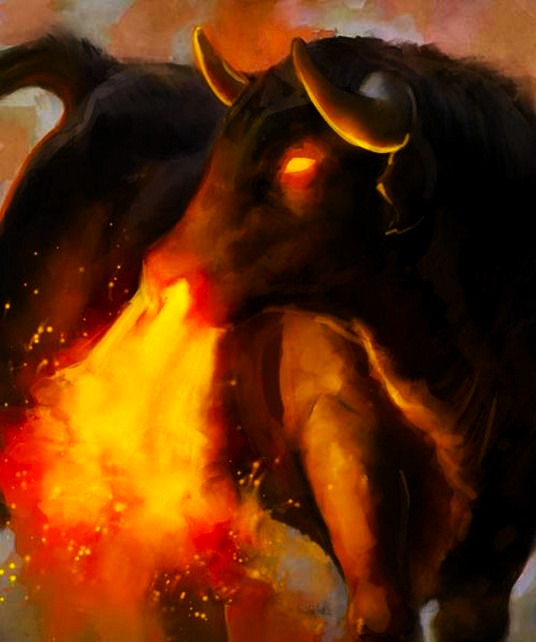
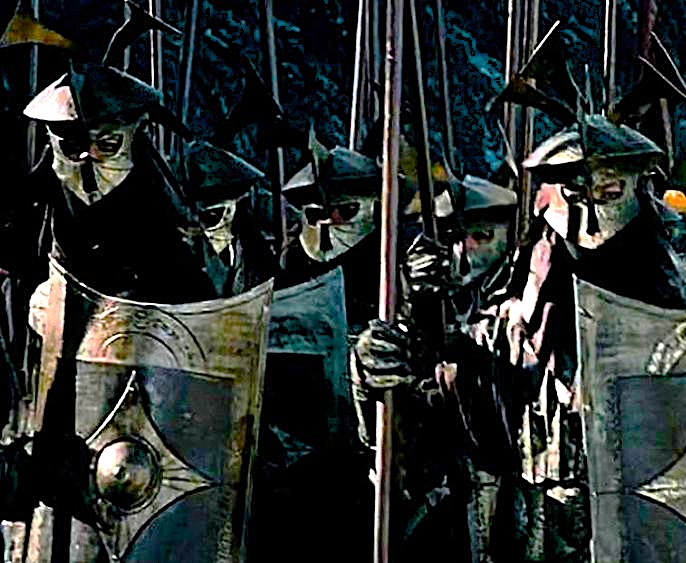

It was with great anxiety that the hopelessly love stricken Meda had listened to all this. She knew it was in her power to protect Jason from the dangers and make him to fulfill the assignments – but would she betray her father, her fatherland and help someone who was so hated by her father? A betrayal that would mean that she was no longer welcome among the Colchians.
Medea spent a sleepless night during which she repeatedly ran in to her sister Chalciope’s room, she had been married to Phrixus (it was whispered that he had been assassinated by the girls' despotic father) and thus knew how difficult it was to live with a stranger in one's own country. If Medea wanted to unite her fate with Jason, she had to leave Colchis.
Chalciope had been deeply in love with her Greek husband and understood her sister's dilemma. She advised her to help Jason and then flee with him to the mythical Greece, which her homesick husband Phrixus had praised in warm terms.
Medea decided to help Jason, but hesitated about fleeing from her homeland. After all, she was both attached to and feared her tyrannical father, Furthermore, she worried about a future as a stranger in a completely unfamiliar land. And... above all – she lived within what Eric Robertson Dodds has called a "pronounced culture of shame", according to him it was the fear of being shamed that characterized the Greeks' belief in their gods and their association with their fellow human beings – "What will everyone else think of me and my actions?" During her sleepmless night, Medea turned and twisted her painful thoughts:
Let him be killed in the struggle, if it is indeed his fate to die in the unploughed field. For how could I prepare the drug without my parent’s knowledge? What story shall I tell them? What trickery will serve? How can I help him, and fail to be found out? Are he and I to meet alone? Indeed, I am ill-starred, for even he dies, I have no hope of happiness; with Jason dead, I should taste real misery. Away with modesty, farewell to my good name! Saved from all harm by me, let him go where he please, and let me die, On the very day of his success I could hang myself from a rafter or take deadly poison. Yet even so my death would never save me from their wicked tongues.
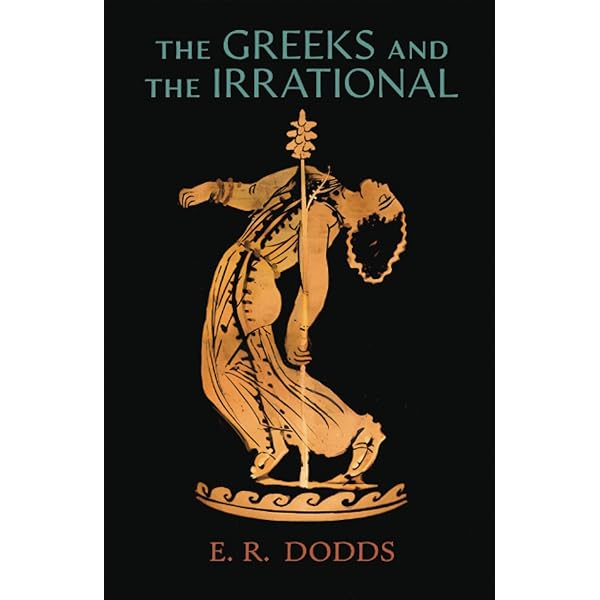
Medea knew full well that only she, Circe's granddaughter and Hecate's priestess, was the only one capable of producing the ointment of invulnerability that would make Jason powerful and indestructible. Through her wizardry, Jason would be able to harness the fire-breathing bulls in front of the plow, plow the field, sow the dragon's teeth, and defeat the demon warriors. And then – then he would have stolen the fleece and sailed away across the seas, leaving Medea behind, alone with the shame of having betrayed her father and her country.
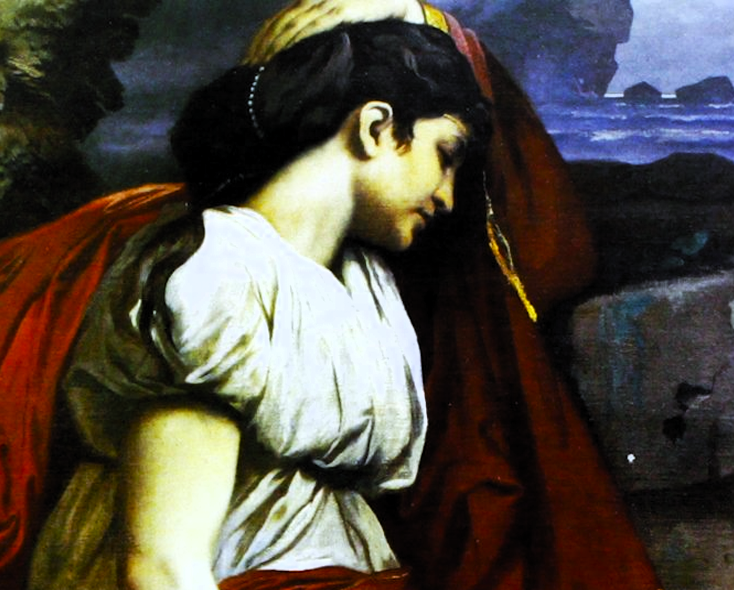
Meda had not even spoken to Jason, and therefore decided to seek him out before dawn, where Argo lay hidden in the high reeds of a viscous river outside the city.
When she had left her handmaidens behind and met Jason at a place she had agreed to with his emissary, one of Phrixus's sons who had joined Jason's men, Jason was dazzled by how Medea's beauty shone in the moonlight, she was not for nothing the granddaughter of the sun. Medea, however, was more captivated than Jason:
At one moment both of them were staring at the ground in deep embarrassment: at the next they were smiling and glancing at each other with the love-light in their eyes. […] Tears of agony ran down her cheeks and her whole body was possessed by agony, a searing pain which shot along her nerves and deep into the nape of her neck, that vulnerable spot where the relentless archery of love causes the keenest pangs.
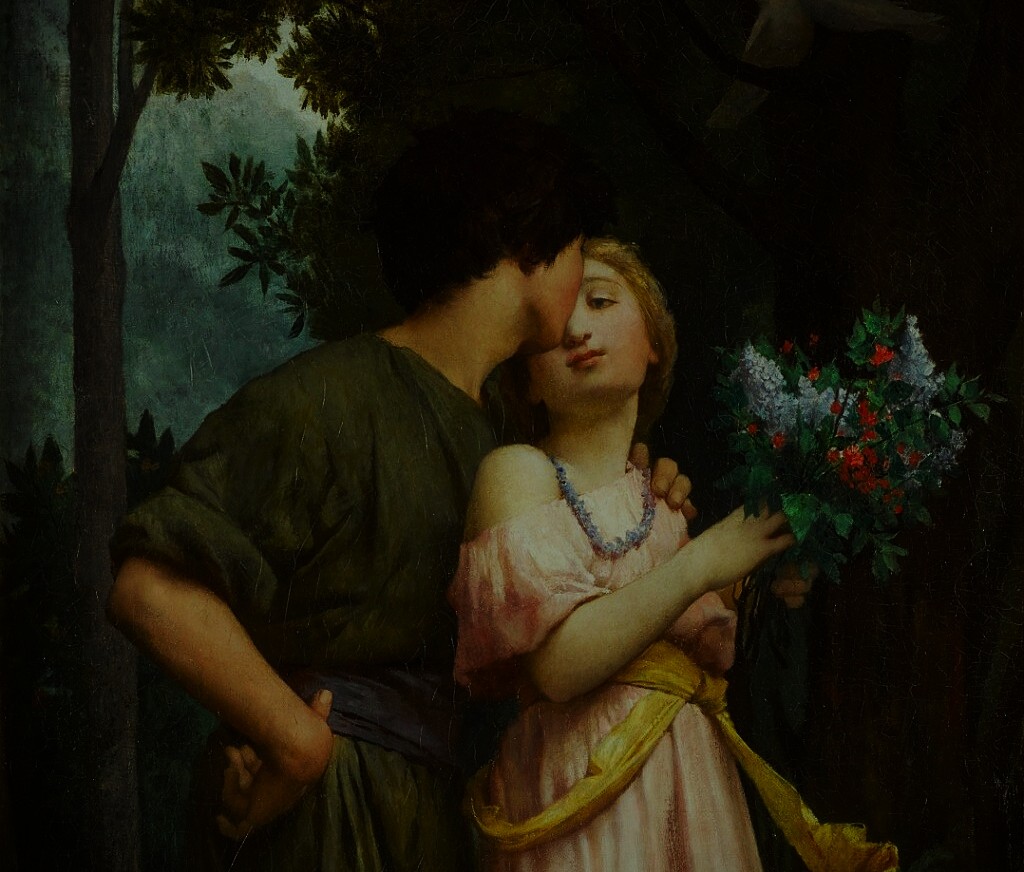
Already knowing that he could benefit from the beautiful girl's knowledge, Jason let his eloquence flow freely. He compared Medea to the most beautiful goddesses imaginable, professed his eternal love, and promised to take her with him on the journey back to his land – more beautiful and more cultured than this godforsaken Colchis at the end of the world. Medea was helplessly seduced, dazzled, blind and captivated. Ovid related the prodigious moment:
Aeson's son looked more beautiful than ever. Medea could hardly be blamed for her passion. Her gaze was fixed on his face, as if she had never seen it before. "There must be a god standing there," she thought in her madness, unable to turn away. But when the stranger had begun to speak, and suddenly seized her right hand, and in the humblest voice begged for her help, promising to make her his wife, Medea burst into tears and answered: "I know what I am doing: so if I am deceived, I cannot blame my ignorance, only my love. You should have your life to thank for the help I give you. Make sure you keep your promise!" He swore by the rites of the threefold goddess [Hekate] and all the power that was hidden in the sacred grove [in which they were]; he swore by his father-to-be, the all-seeing sun-god [Helios], of all the successes he hoped for and all the dangers he feared. Medea believed him.
While judging Medea’s horrible deeds let us keep in mind that she is portrayed as an extremely intelligent, thoughtful woman. Someone who carefully considers every action, every step she takes. Her name seems to be related to the Greek medéia, "anticipate, plan, think through", but this did not prevent her from occasionally succumbing to violent passions.
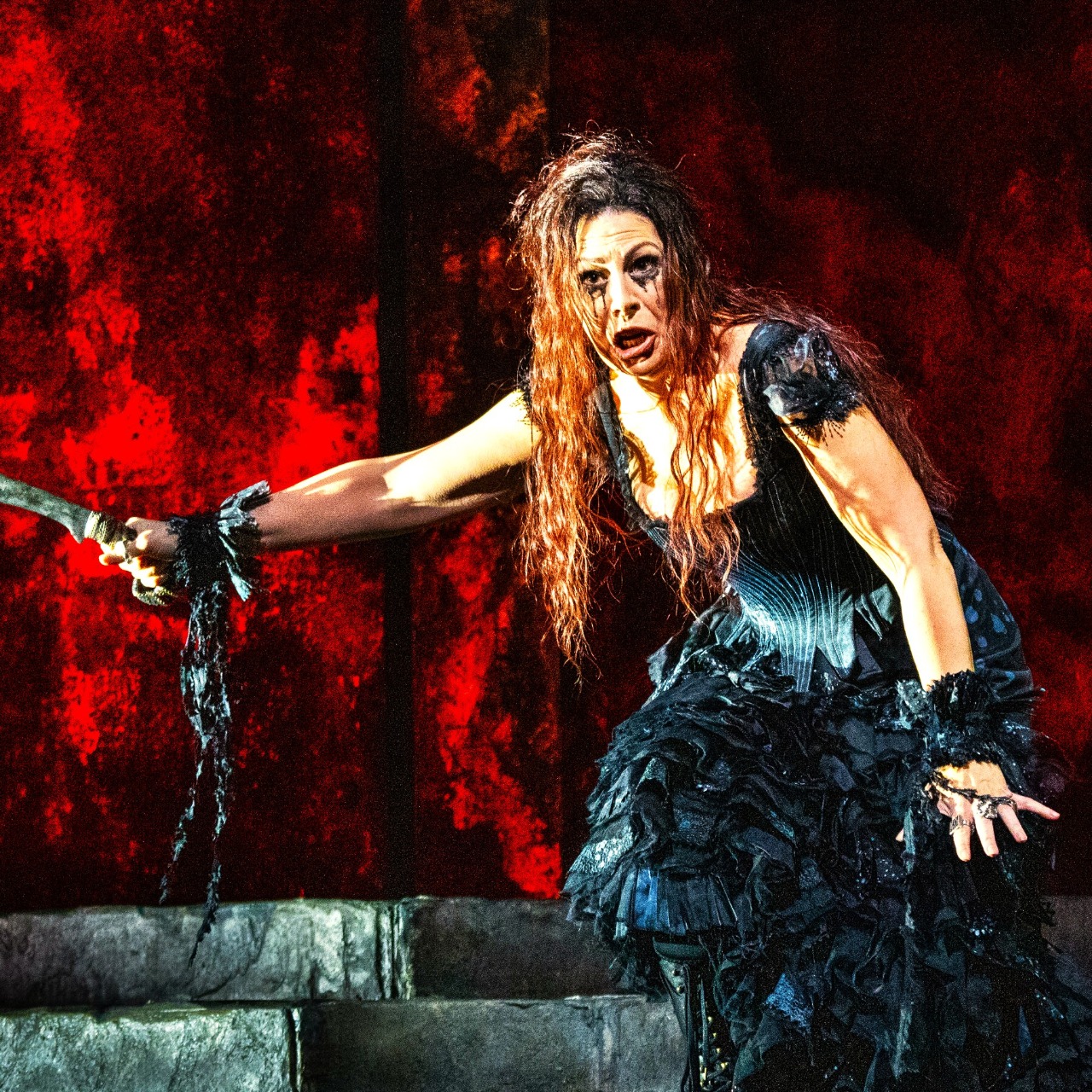
Here we can once again take Dodds to help. The inner painful conversations that Medea occasionally engaged in, and which in Euripides and Seneca became effective monologs, can be explained by the Greek concepts of the soul psyche and thumos. Psyche can might be regarded as a person's personality/character, her social/disciplined self. Thumos, on the other hand, is linked to the body, its functions and thus also to various desires such as hunger and sleep, but not least different urges such as sexual drive, or anger when it takes on bodily expressions, such as physical violence.
Homeric heroes occasionally engage in dialogues with their heart, liver, or stomach. Something that might be interpreted as if their psyche confronts itself with their thumos – urges/passions.
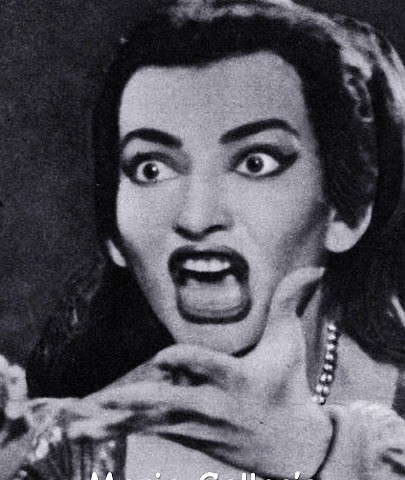
When Jason is later subjected to Medea's reckless wrath, he explains it as her being possessed by an alastor, an inner demon created by unquenchable shame over committed crimes, which have not been reconciled through any appropriate religious rites. However ... the modernity of a writer like Euripides consists in the fact that he makes Medea a struggling human being, someone who is well aware of the fact that she is not possessed by any demons. She knows that is her sense of reason that struggles against her often uncontrollable, passionate nature. Her thumos has been poisoned by ther desire for Jason's love. Medea's misdeeds are not caused by any lack of insight. As when a slave begs for mercy from a cruel master, Medea fights against her violent passions:
I know what evil deeds I intend to commit, but my thumos is stronger than my good intentions. My Thumos is the root of a my worst actions.
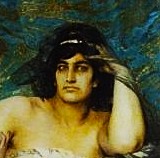
Medea's sharp intellect cmight be characterized by the concept of mêtis, knowledge. It is not an abstract, deeply reflective thoughtfulness, which the ancient Greeks denoted by the concept of sophía, wisdom, but rather of a concrete, action-oriented intelligence, which in itself includes wisdom as well as prudence, cunning and acumen. Qualities that Homer bestowed on his hero "resourceful", polú-tropos, Odysseus. He was certainly encumbered with an overabundance of polýmêtis, multifaceted mêtis. As with Medea such qualities could in Odysseus turn into cruelty and seemingly completely unjustified acts of violence. But such deeds nevertheless seemed to be connected with a certain infernal logic.
Odysseus and Medea were practical-minded individuals. Medea did for example have her extensive and in-depth knowledge of all medicines, tools and toxins present in nature and knew quite well how to benefit from them all.
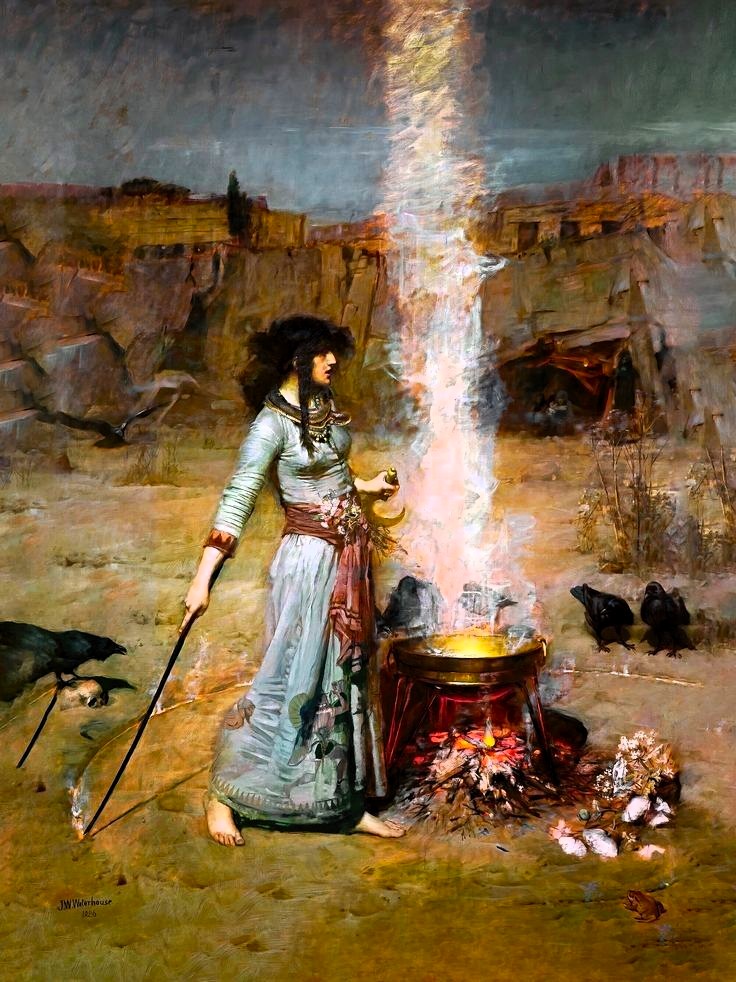
When Jason had professed his love, promised her marriage and a happy life with him, Medea declared that she would become his Ariadne by providing him with the red thread with which he would be able get out of the tangled labyrinth he had ended up in. But woe betide him if he acted like Theseus who had abandoned his Ariadne. If Jason would ever dare to abandon his Medea, she would not let it happen with impunity, like that weak maiden Ariadne! No, no, Medea was made out of other scarp and grain.
She was to give Jason an ointment with which he had to lubricate his entire body. Thus he would become invulnerable for one day and endowed with superhuman courage and undiminished strength. Jason would thus succeed in his otherwise deadly missions; Tame the fire-breathing bulls and defeat the army of demonic warriors.
Furthermore, Medea would make sure to put to sleep the monstrous snake that day and night kept watch over the Golden Fleece and she would then accompany Jason on the return journey. Her magic skills would protect him and his crew from all the dangers that threatened them.
Medea was convinced that she might be able to master all this. But, could she trust Jason? What she wouldn't be able to withstand was if Jason abandoned her in a foreign land, while breaking his promises to be faithful to her forever and protect her and their potential offspring.
After telling him all this, Meda instructed Jason with the utmost care as to how he should proceed during the difficult trials of tomorrow.
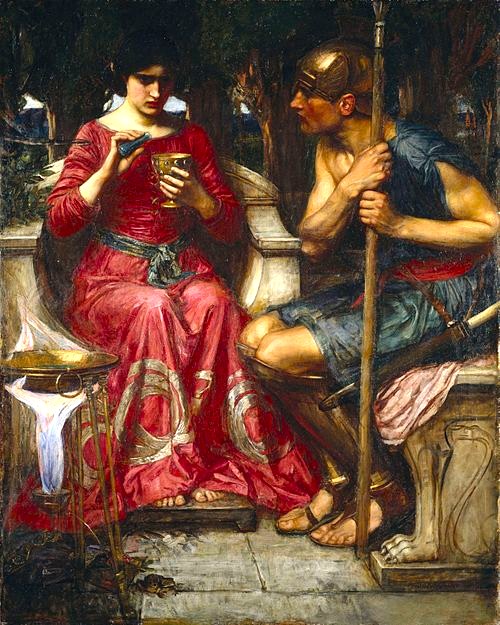
Everything turned out as she had predicted. A betrayed and enraged Aïtes was forced to witness how the invulnerable and superhumanly strong Jason subdued his ferocious bulls, harnessing them to the heavy plow, sowing the dragon's teeth, and defeating the demon warriors. As blood flowed between their mutilated, dead bodies, Jason rushed to Argo, which set sail for the nearby island where Medea was waiting in the grove where Aïtes had nailed the Golden Fleece to the sacred oak.
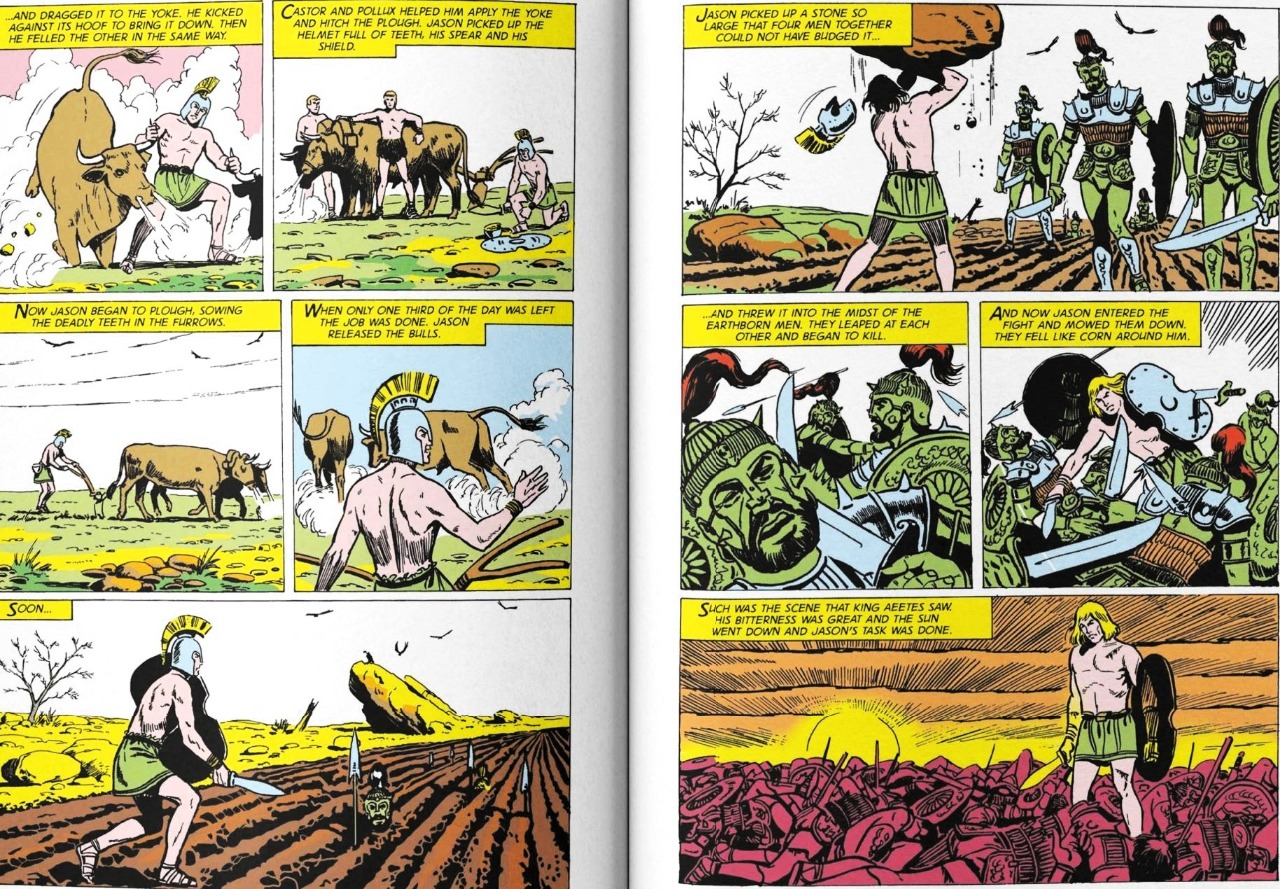
The day of trials was over, and now Medea and Jason stood in front of the Golden Fleece that shone in the darkness of the night, while the huge serpent came slithering upon then.
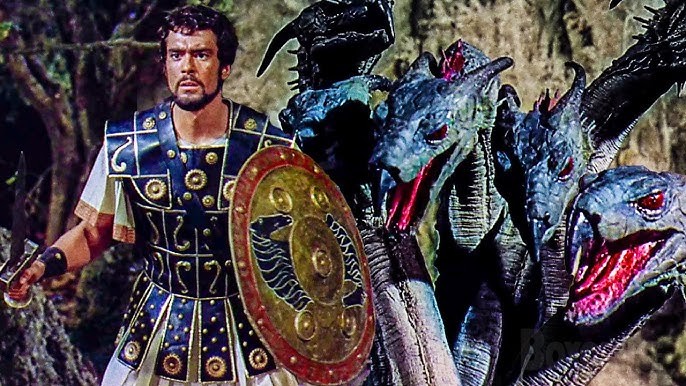
What happened next is unclear. The legends that Apollonius retold, and based his story on, were as mentioned, ancient, multifaceted, and often contradictory. Most of them told, as Apollonius did, that it was Medea who, with one of her drugs, sedated the snake so that Jason could kill it and then steal the skin.
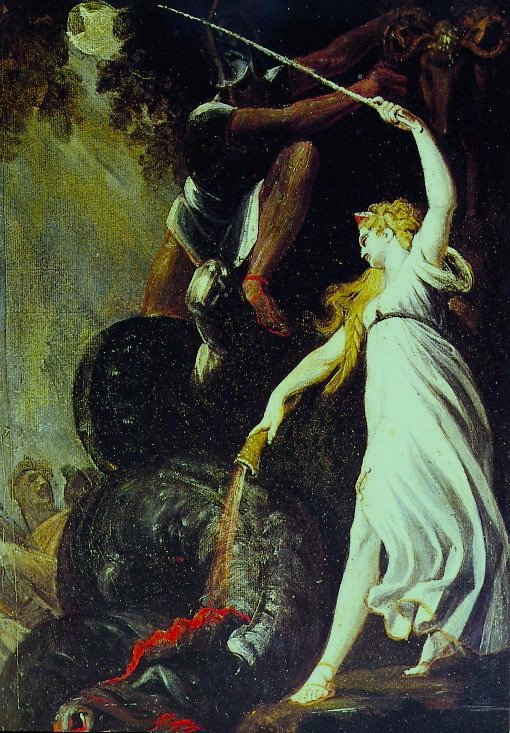
In other legends, Medea put the monster to sleep with hypnotic gestures:
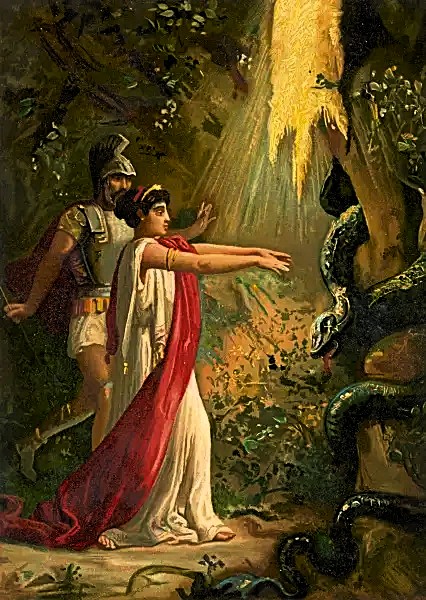
Or Jason drugged and killed the monster on his own, all under Medea's supervision.
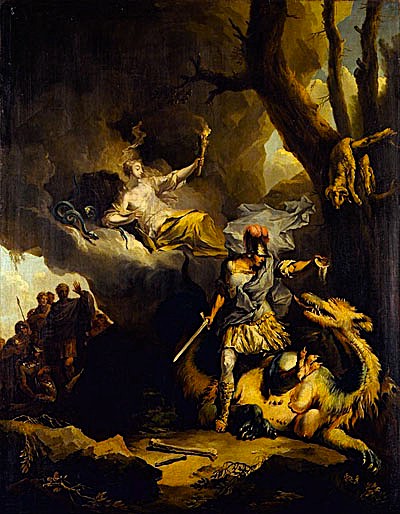
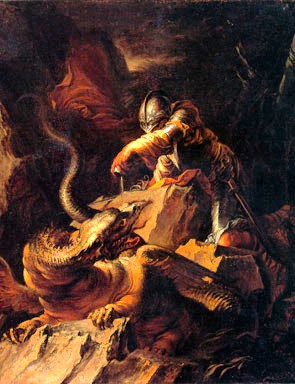
A red-figured ancient Greek vase painting on the bottom of a kylix provides an even more dramatic and now unknown version of events, during which the monster appears to be devouring a seemingly lifeless Jason, but here it is the goddess Athena who appears to intervene to save him.
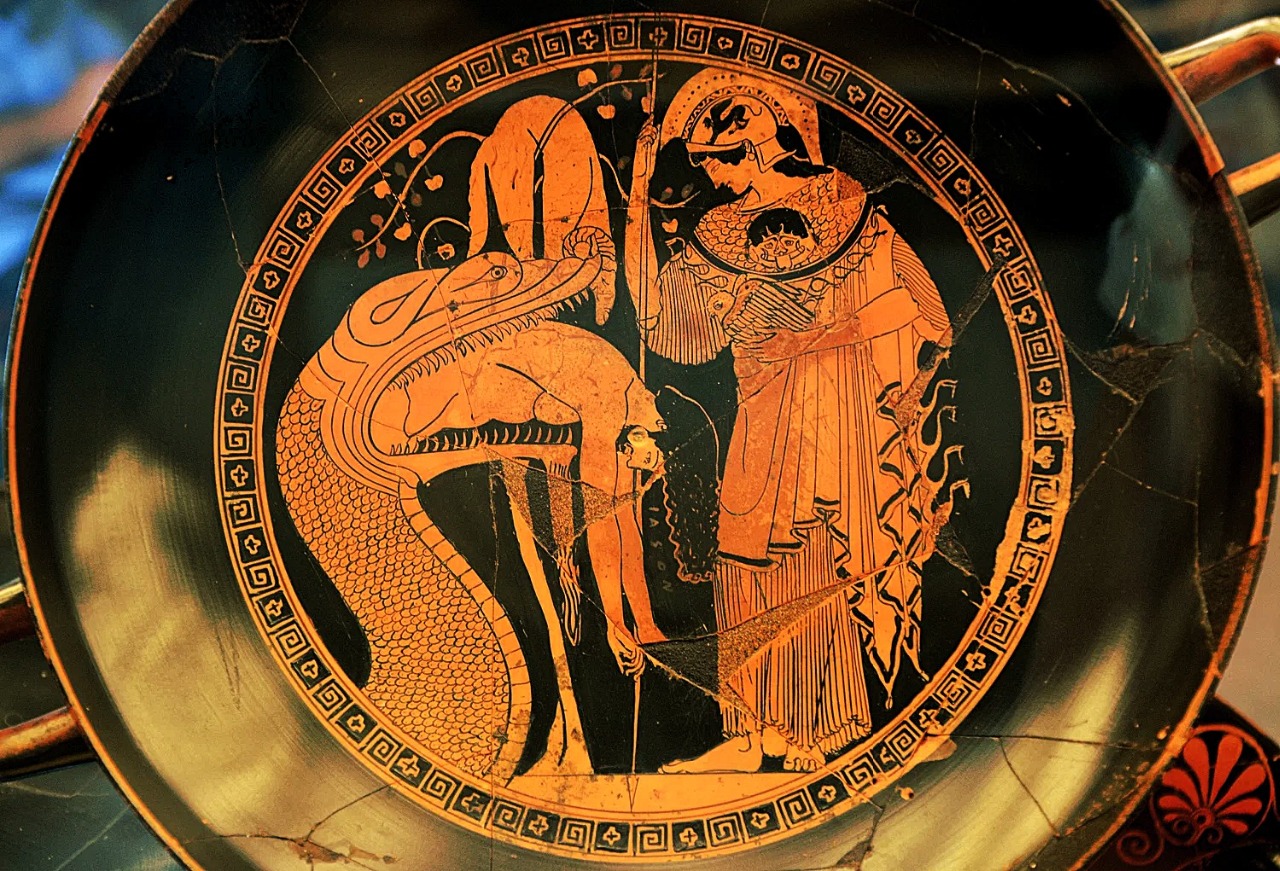
In any case, the newly in love couple managed to bring the Golden Fleece aboard the Argos and then fled across the sea, pursued by Aïte's fleet, led by his son Apsyrtus.
When the Argos reached the mouth of the Danube on the other shore of the Black Sea, they found themselves encircled by the ships of the Colchians, and in order to escape with their lives, the Argonauts were forced to negotiate with the superior force.
Apsyrtus set the conditions – the Greeks could keep the fleece, but King Aïtes demanded that Medea returned to Colchis with her brother. Jason agreed to the arrangement. No wonder the passionate Medea was furious. Less than a few weeks ago, the coward Jason had sworn to gods and future generations that he would be faithful to Medea, to provide her with his protection and love her until death came. Strangely enough, he was now suddenly prepared, not only to save his own skin, but that of the ram as well, and deliver Medea to a vengeful, furious father!
It was the first time Jason faced Medea's rage and he immediately backed down and together they decided to murder Apsyrtos. Under false pretenses, Medea lured her little brother to a meeting during which Jason murdered him.
The betrayal and fratricide left deep marks on Meda's soul, now there was no turning back. She had trodden the path of crime, not only by betraying her father and her country by stealing the Golden Fleece but, even worse, by murdering her brother. And all this for the love of a treacherous wretch who dependent on her strength and intelligence.
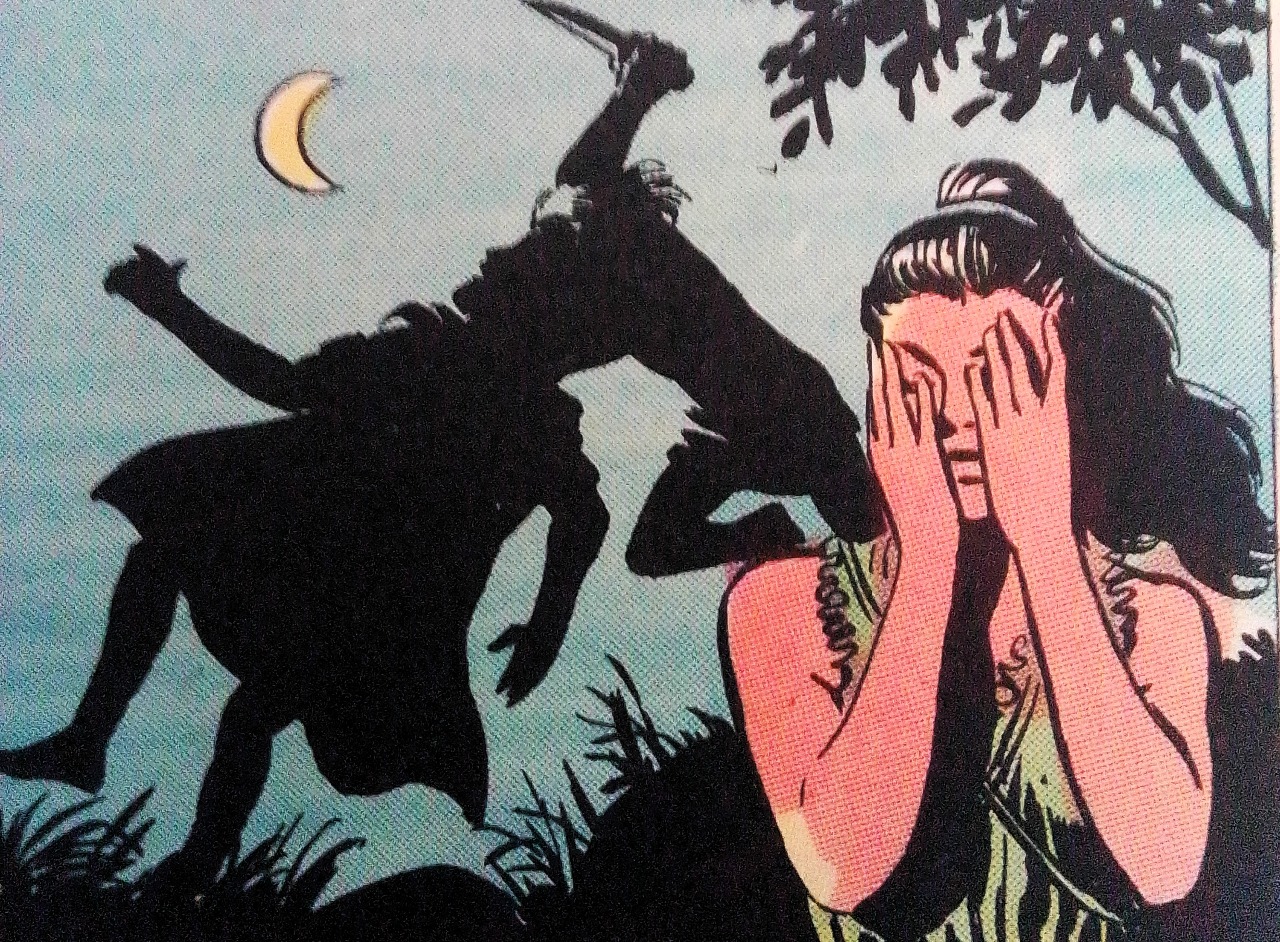
Here, too, the legends give different versions. In his masterful play, Euripides followde the same version as Apollonius, while other authors, such as Seneca and Pasolini, used an even crueller version that makes Apsyrtos considerably younger, an innocent child who accompanied his older sister on the journey to Greece.
When Aïtes appeared with his pursuing fleet, Medea mercilessly dismembered her younger brother and threw the body parts in the wake of the ship, in Pasolini's version, behind her chariot, so that the pursuers were forced to stop to pick them up. The ancestor worshipping Greeks were very careful to take care of the corpses of their kinsmen.
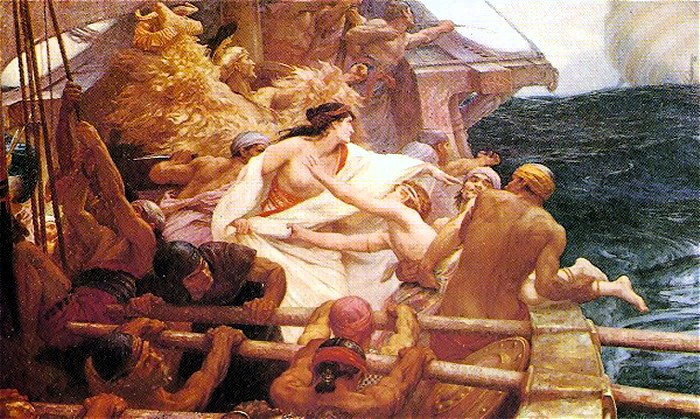
Aïtes fleet proved to be much larger, more ruthless and better armed than anyone could have imagined. It blocked Argos' return journey and during ever-perilous adventures, the Argonauts were forced to make their way through the rivers of Europe down to the Tyrrhenian Sea and then sailed down between Scylla and Charybdis until they finally reached the island of the Phaeacians, whose king warmly welcomed them. However, the Colchians' large fleet was anchored in the sea off King Alcinous' island and demanded Medea's extradition.
According to the gods, the Colchians had the right on their side. Since Medea and Jason were not married, Medea was still her father's property. With Hera's blessing, and in the presence of nymphs, Medea and Jason were therefore married, and with the help of the Phaeacians, the Argonauts then managed to make a break through the Colchian blockade.
However, the trials were not over. The Argonautes were forced to drag their ship across the scorching Libyan deserts and on the coast of Crete they were attacked by the enormous bronze giant Talos, but through Meda's intelligence and magic tricks and Orpheus' incantatory music, they finally made it to Iolchis.
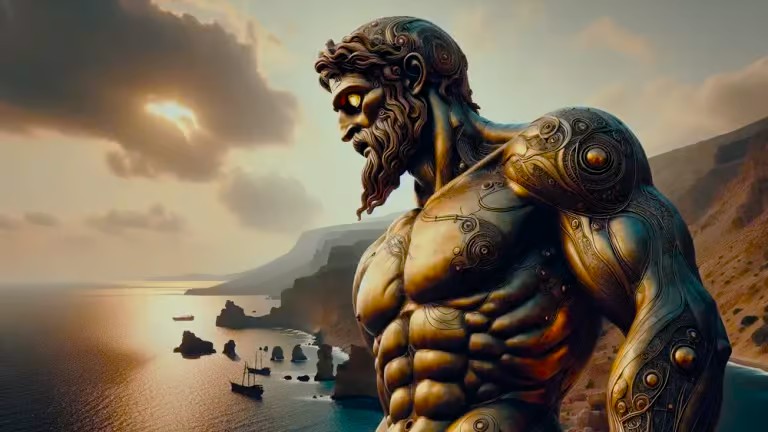
Of course, the Argonauts were received as heroes. They had completed their seemingly impossible mission and brought the Golden Fleece back with them, and the Greeks rejoiced to have their youthful, universally admired heroes with them again.
Neverthelss, new problems awaited and it was again Medea who had to deal with them. First... Jason's father, Aeson, was dying, weakened after a miserable life being imprisoned by his brother Pelias, who was still in power, though weak and dying as well. What Jason now insisted on was to heal his father and take revenge on Pelias.
We have now left Apollonius of Rhodes' Argonautica and it is instead Ovid who tells us about Medea's further fate in his voluminous Mertamporphosis, this insightful and lyrically fascinating encyclopedia of mythical love stories.
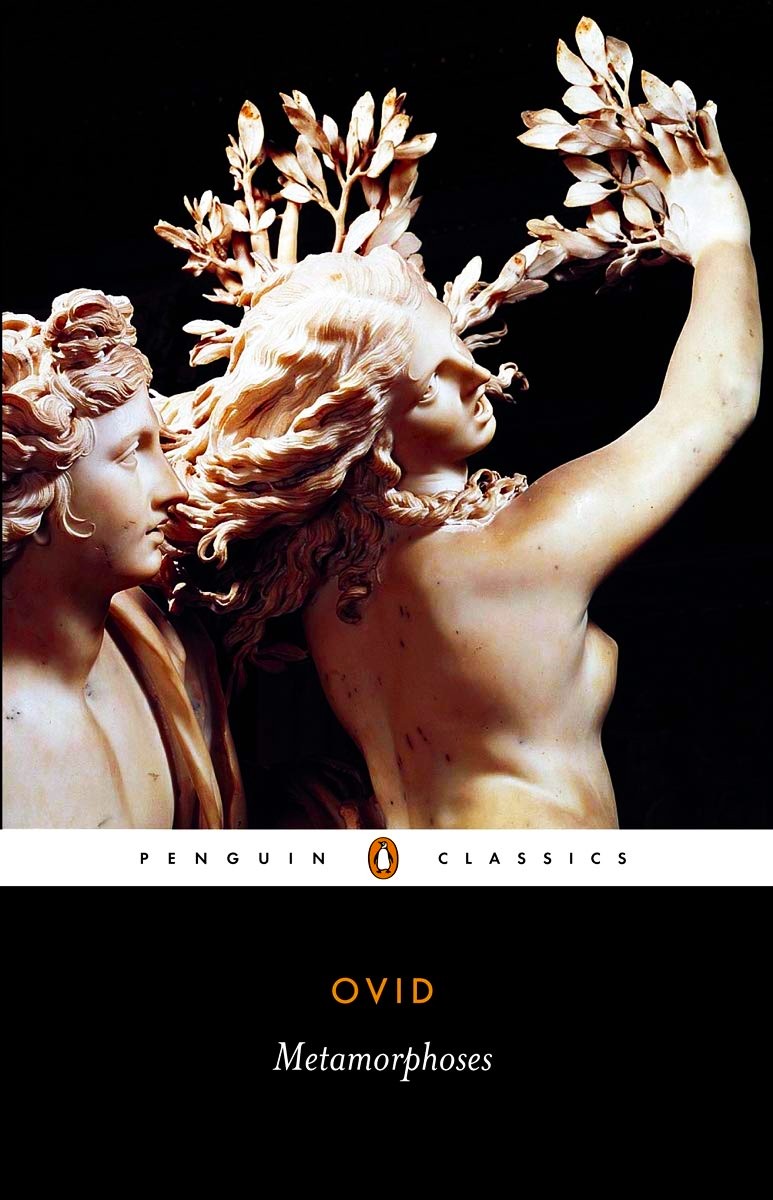
To make Jason's happiness complete after their celebrated arrival, despite all Jason's shortcomings, the poison from Cupid's love arrow continued to flow through her veins, so Medea undertook to rejuvenate the dying Aeson. Again, her love had caused her to succumb to Jason's flattering eloquence:
I grant, dear wife, that you saved me from death; you have given me all., and the sum of your many kindnesses truly pass belief. Yet I ask, if your magical powers can do it – and what they can they not? – Substract a few of my many years to add to the years of my father.
Jason's filial affection moved Medea to tears, and she assured Jason that with great effort she could certainly rejuvenate Aeson without causing her handsome husband to age.
In a loose-hanging robe without knots, she went during the night to the temple of Hecate to ask the Goddess of Darkness for her assistance. Then Medea took off her garment to purify herself in the water of sacred river: She immersed herself under the moonlight then she dressed flew away in her dragon-drawn chariot over the world to collect all the hard-to-find and exotic herbs required for her magical brew. Like Seneca after him, Ovid gave an account of all the ingredients for rejuvenating ointments and drugs required for Medea's magic. A description that reminds of Shakespeare's lyrical descriptions when he in his Macbeth described the witches' drug preparation.
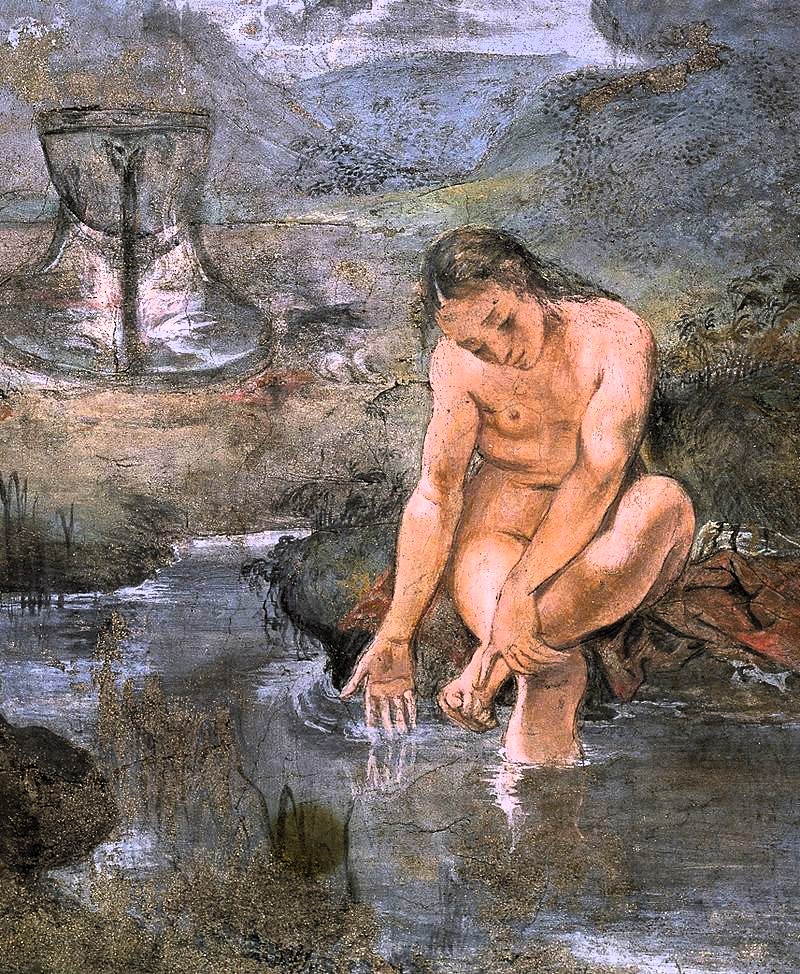
When everything was carefully prepared, Medea put Aeson into a deep sleep, emptied his body of blood, and replaced it with the witches brew she had carefully concocted. And lo and behold, Aeson was resurrected as a youngster, strong and beautiful as his own son. Strangely enough, the legends do not tell us what happened to Aeson after he had been rejuvenated.
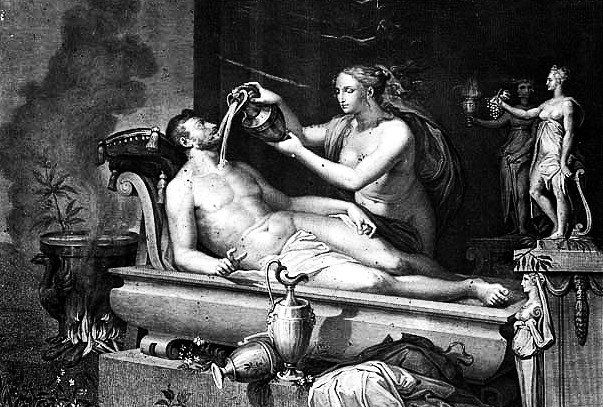
However, Jason was not satisfied with this miracle. He now wanted Medea to use her magical skills to exact the revenge he had so long brooded over against the hateful Pelias. This episode in Jason and Medea's fateful relationship is also mentioned in a drama by Euripides – Alkestis.
After returning from Colchis, Jason and Medea lived as respected citizens in Iolchis. Pelias was still king, but completely powerless. His daughters, Alcestis and her three sisters, who, like others in Iolchis, had been amazed by the miracle Medea had accomplished with Jason's father, and did now approach Medea urging her to rejuvenate their father as well.
The cunning Medea demonstrated her art by butchering an old ram, cutting it up and boiling it. Strangely enough, the ram was transformed during the process and soon a beautiful little lamb jumped out of the pot.
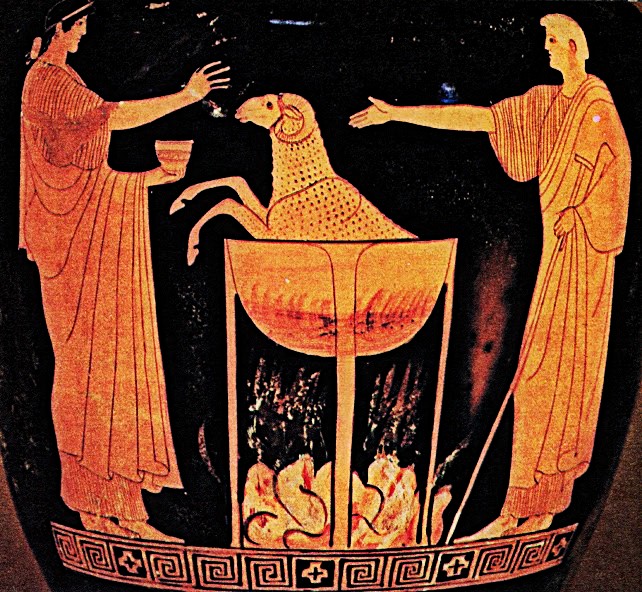
Medea convinced Alkestis and her sisters that they could proceed in a similar way with their elderly father. They murdered and dismembered the reluctant old man while Medea boiled plain water and sang her magic spells over it. After the sisters put the pieces of Pelias into the pot they became so over-boiled that they could not even be taken to the grave, which for the Greeks was the most horrible thing that could happen to a revered deceased. The people of Iolchis were furious at Medea's actions and she and Jason were forced to flee to Corinth, which at the time was ruled by King Creon.
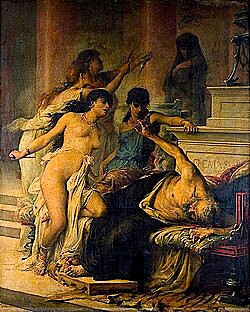
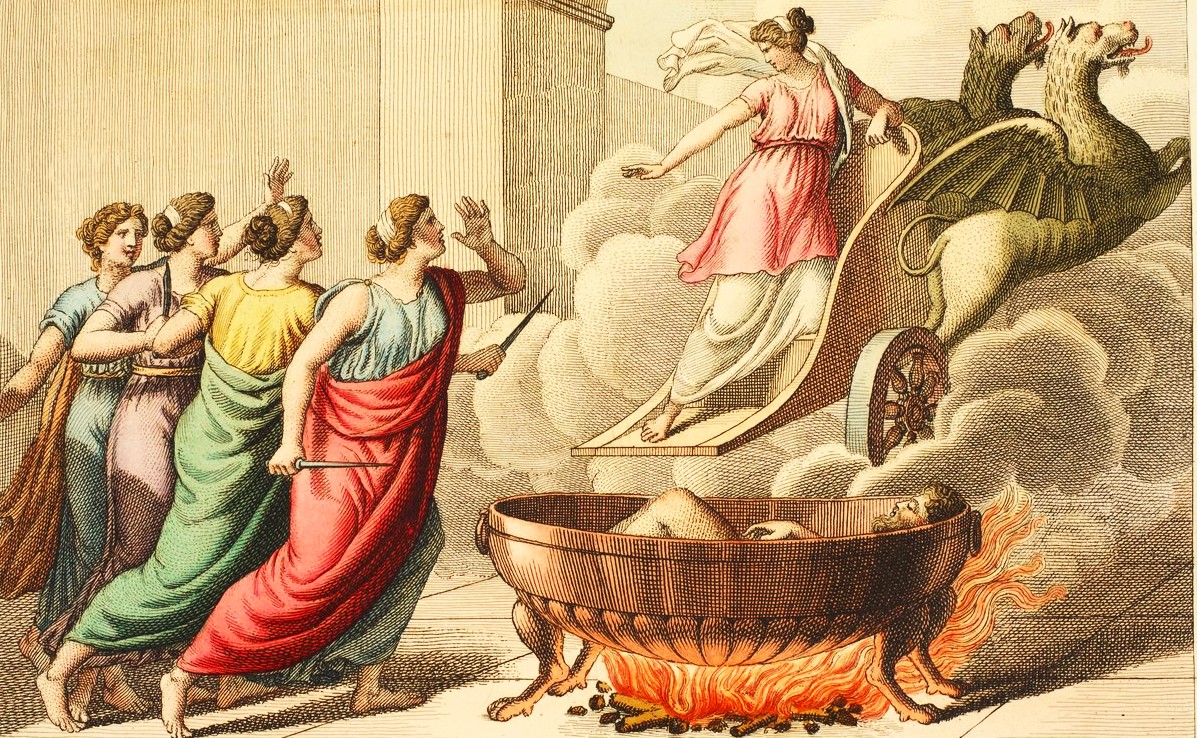
Creon welcomed the famous refugees with open arms. But in Sophocles' play Antigone, we have learned that Creon was in fact a tyrant who considered himself to stand for family honor and upholdin the will of the gods, but actually acted in the opposite way.
In Antigone, Creon aggressively preaches family honour, tradition, and submission to the will of the gods. However, when one of his sons was killed during a rebellion against him, Creon, against all rules and traditions, forbade everyone to bury his deceased son. Howver, Antigone, could not accept such disrespect for the dead and buried her brother. Creon sentenced her to be buried alive, but when he changed his mind at the last moment, it was already too late – Antigone had killed herself, and so had her brother Haemon. Creon behaved just as buffoonishly towards Medea.
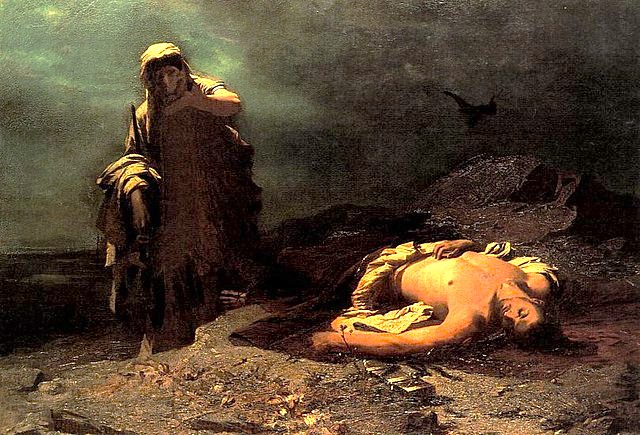
Women did not have many rights in ancient Greece. They were the property first of their fathers and then of their husbands. Euripides Medea exclaims in despair:
Of all creatures that have life and reason, we women are the most miserable of specimens!
When a man was not happy in his marriage, he always had the opportunity to leave home and find an outlet for his frustrations in the company of other men and women. However, if a woman behaved in a similar way, she was considered to be a shameless creature, and a divorced woman was despised as if she had not been good enough for her husband. It was said that the women were safe in their homes, but where was their freedom? They were entirely at the mercy of their husbands' arbitrariness. Men boasted of their courage and combativeness, but as Medea stated – she would rather face an enemy on the battlefield than go through all the dangers and severe torments that childbirth entailed.
And what about her? What kind of security and respect did Medea have now? Abandoned and homeless, she had previously been a disrespectful man's plaything. A possession that now that he had new interests could simply be thrown away, along with their children. A cruel man who treated her as if she were a mere spoil of war and who, when he found another love, no longer cared about his children, because he could within his new family get new ones with pure Greek blood in his veins.
Medea had no father, no brother, or other relatives who could help her face the torment and contempt that now befell her in a foreign land, where she lived alone, feared, and displaced. Jason had turned his back on her, from the shadows she had seen him marry a younger woman – the man who had sworn by the gods to be forever faithful to her. Whose life she had repeatedly saved and defended at the risk of her own life, to whom she had given her all. She – the daughter of a king far more powerful than the pathetic little despot Creon. She, the granddaughter of the sun itself, had now been forced to witness how Jason had married the beautiful Creusa, a descendant of Sisyphus, a villain who had been condemned to be tormented in Hades.
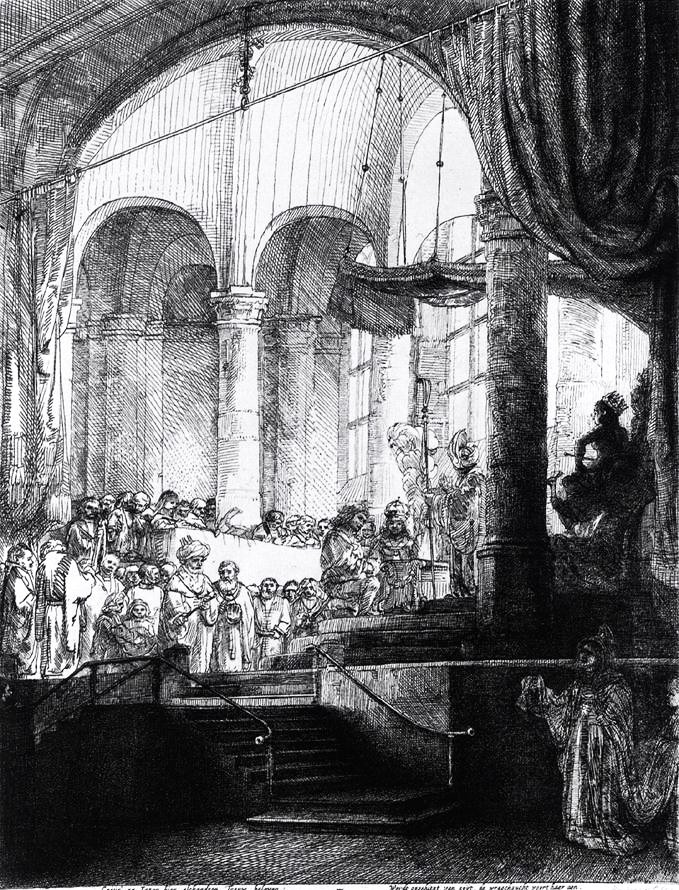
It was said that Greek women were withdrawn and peaceful, but not Medea. It was love that had forced her to give up everything for Jason, and it was his self-love that tore him away from her. If love was wounded in a woman like Medea, her thumos, body-soul was wounded as well, igniting the holy wrath that once filled Achilles:
Sing, Goddess, sing of the rage of Achilles, son of Peleus— that murderous anger which condemned Achaeans to countless agonies and threw many warrior souls deep into Hades, leaving their dead bodies carrion food for dogs and birds— all in fulfilment of the will of Zeus.
The anger that burned in Achilles and Medea was mênis, an uncontrollable anger that took the form of an almost cosmic rage and was thought to have been provoked by crimes committed against social norms. By Seneca, Medea raged:
Light is the sorrow that allows itself to be hidden and reconciled. Atrocities cannot be covered up, they demand action. With ancient powers I will seek my vengeance, from the depth of my bowels it will be summoned. All my feminine fears will be dispelled the rage that has been hidden under the snow of Caucasus. I remember the kind deeds of a young girl, but now a heavier anxiety wells up. The wrath born out of a wife wounded by evil deeds. Crime must with crime be atoned.
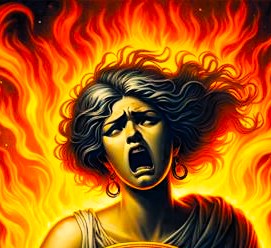
What triggered Medea's mênis was perhaps not only Jason's betrayal. In Seneca, even more than with Euripides, who was his model, it was also Creon's ruthless behaviour – he appears to be an ancient xenophobic Trump – that added salt to Medea's wounds when he ordered her to leave Corinth immediately. When Jason married his daughter, Creon wanted to get rid of Medea at all costs.
In Seneca's house, the despot ruthlessly attacked the woman who was a stranger to him;
Begone! Cleanse our Kingdom from your filth. Take your deadly herbs with you, free us from our fears. Go to your far-off lands where you can invoke your hateful gods!
And she didn't find any support from Jason. He was at home and knew how to deal with the situation. He no longer needed Medea's magic tricks – his journey and difficult mission had succeeded thanks to her self-sacrificing efforts. But that was them. Thanks to Medea, his old father was now transformed into a young man of good health. His archenemy Pelias was dead and gone. Creon liked him and gave Jason a safe home in his rich and powerful city. He had fallen in love with and married the tyrant's young, beautiful and submissive daughter. Something that had given him Corinthian citizenship and upon Creon's death he would become king of the city. However, none of this benefited his passionate and foreign ex-wife (whom Jason deep down was afraid of).
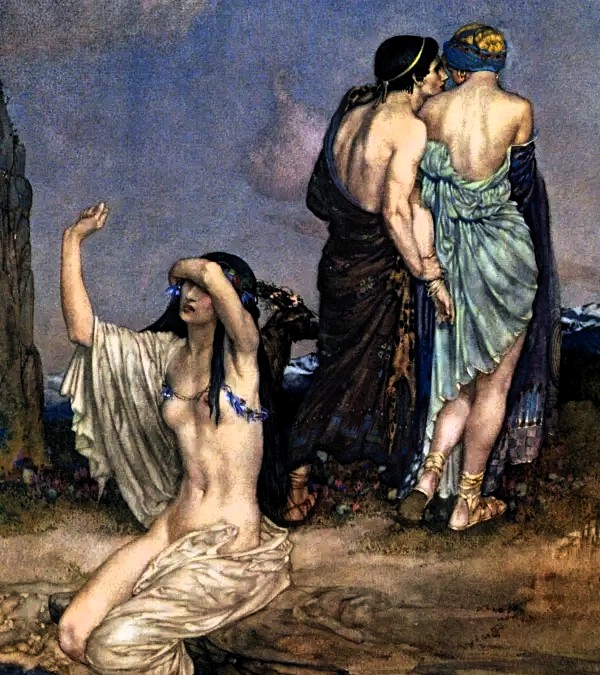
It is worth noting that when Euripides' drama 431 f.Kr. was performed in front of a huge audience of mainly male Athenians, their greatest statesman, Pericles, had a few years earlier introduced a "citizenship law" which meant that in order to be a voting Athenian, both parents of a man (slaves and women were not allowed to vote) had to be Athenians.
A marriage could only be dissolved by the husband announcing his divorce in front of witnesses and the wife being returned to her father, or a relative on her father’s side, together with the dowry. This also meant that if they wanted to retain their citizenship, all Athenian men married to foreign-born women had to divorce them, and the children born within such marriages lost their citizenship.
This is despite the fact that Pericles, after divorcing his wife, lived in an open relationship with Aspasia, who was born in Miletus and was consequently considered to be a metic, foreigner, and according to his own law, Pericles could not marry her.
Is the situation recognizable? An exalted political leader passes a law that restricts the rights of immigrants, but nevertheless considers himself to be above the law and living with an immigrant, who was furthermore considered to have been a fortune-seeking courtesan.

Medea defended herself against the accusations of the despotic Creon – had she not through her courage and knowledge saved the lives of Greece's foremost youthful fighters, among them many Corinthians,? Was she not the daughter of a king far more powerful than Creon, a father who was also the son of the sun itself? Had she not, after having abandoned everything she had and been forced to flee for hers, her husband's and her children's lives? Had she not chosen to live in a city whose citizens she had helped and protected through her experience and knowledge of healing crafts? Creon was relentless, Medea had to leave Corinth immediately.
Did Jason stand up for wife and kids? Hardly. Instead, the newlywed narcissist defended his behaviour by portraying himself as a victim who had done everything for his family. It was not Medea who had assisted him and the Argonauts, rejuvenated his father and taken revenge on Pelias. It was her passion, her love for him, for Jason, that had driven her to do what she had done. thus it was the gods who had created her infatuation and not Medea whom he should thank. Now it was all over, both the love and her power. All that remained was her rude barbarism, which had made her behave disrespectful towards Creon and his daughter Creusa, who only wished Jason and Medea well. Through her refusal to show appreciation, Medea had become a nuisance of herself and became an embarrassment to him. Creon and Kreusa wanted to make him and the children part of their family. A glorious future awaited them and after Creaon's death, Jason would become king. Why was Medea so reluctant to a better life, when she could remain in the household as his concubine? If Creon had said that the children would also be expelled, he surely done so in anger at Medea's intransigence. For the good of all, Medea had to leave, with her magic skills she would surely be able to manage on her own. Nevertheless, Jason would try to persuade Creon to let the children stay and Creusa would then become like a mother to them. Jason, with his charm and experience, knew how best to deal with women.
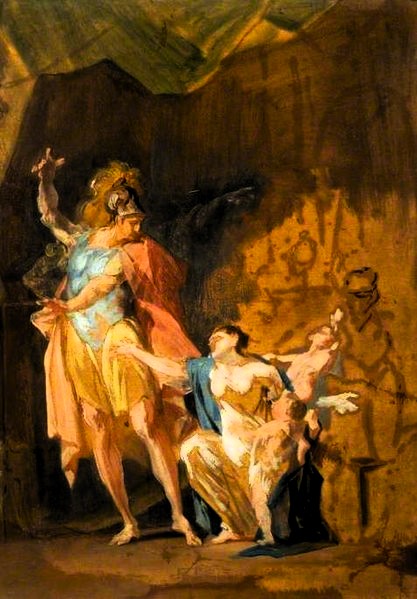
Later writers have often stressed Medea's alienation. Pasolini made his film Medea in 1969 at a time when the exoticism and alternative views of "primitive" cultures were popularized. Inspired by anthropologists/philosophers such as Frazer, Lévy-Bruhl, Jung, Lévi-Strauss, and Girard (who ten years later also influenced the ending of Coppola's Apocalypse Now), Pasolini portrayed Medea’s Colchis as a primitive society with fertility rites and human sacrifices, which, despite its cruelty, was closer to nature and human passions than Jason's Greece. Medea's revenge, the murders of her sons, Creon and Creusa, were thus by Pasolini placed within a ritual context and thus became both a revenge and a purification process.
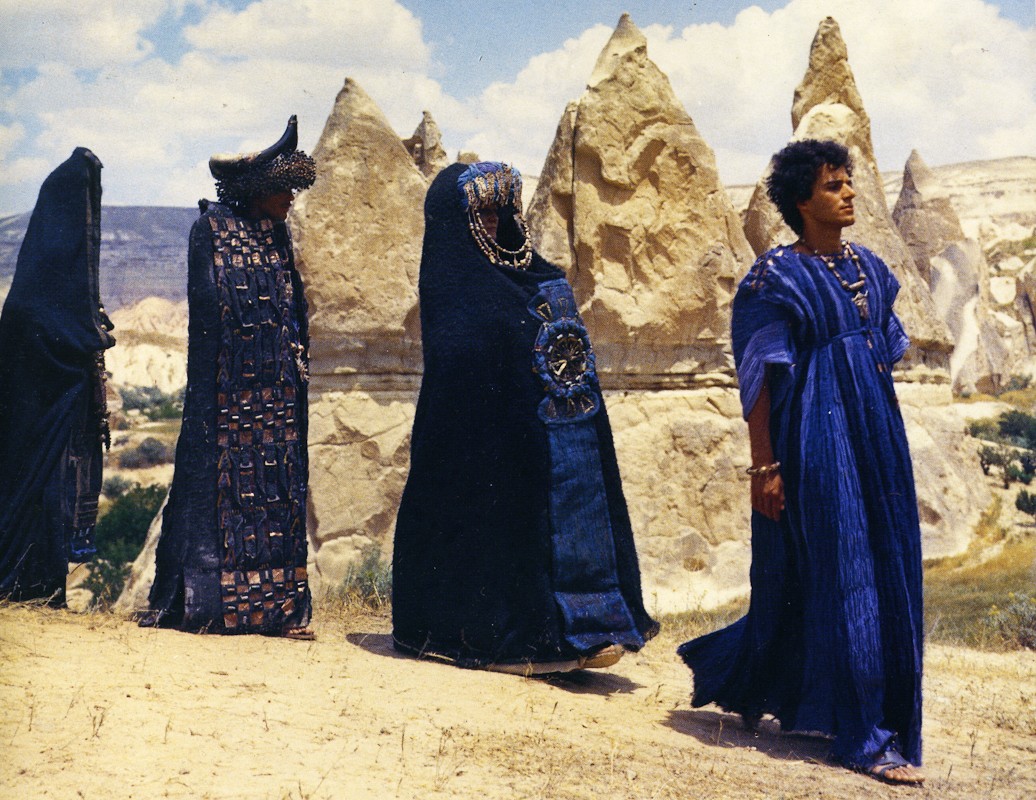
The Italian Corrado Alvaro considered his Medea in his 1950 drama Medea's Long Night in relation to the recent Second World War, with its racial hatred and extermination camps.
In Alvaro's case, Creon and the Corinthian’s feared Medea to such an extent that, in derad of being poisoned, they did not dare to touch anything she had handled. Jason was accepted, he was a Greek like them, but they turned Medea and her children into subversive demons, capable of defiling the Korinthic culture. The presence of the strangers meant that they were considered as being infected by the plague. In Alvaro's drama, it was not Medea who killed her children, but a Corinthian lynch mob that slaughtered both her and the children.
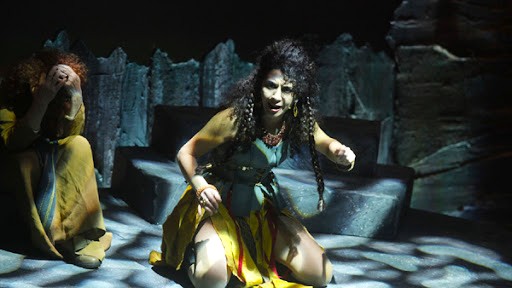
In his Médée from 1946, Jean Anouhil made Medea wander around the countryside like a gypsy with a caravan, until Jason decided to leave her to seek safety and oblivion with Creusa and Creon.
Anouhil's Medea was a sensual creature connected with Nature, civilization did not attract her at all. Her love for Jason was dominant, erotic, and palpable, while Jason was an idealist, albeit an ambiguously cynical one. He wanted to live an easy-to-understand, "moral" life with fixed rules and an uncomplicated everyday life. The free roaming life he placed had enjoyed with Medea did not attract him abynore. The aging, but still passionate, Medea frightened him with her unbridled wildness.
I want the world, not the chaos where you led me by the hand. I want it to take shape at last. You are probably right in saying there is no reason, no light, no resting place.
But it was precisely meaning, light and rest that Jason wanted. Medea could continue with her unfettered existence, but without him and the children. When Medea kills Creusa and her children at the end, she screams in mad rage from the roof of her burning carriage:
Now I have found me scepter again. My brother, my father and the fleece of the golden ram are given back to Cochis. I have found my virginity which you tore from me. I am Medea at last and forever! I am your little brother and you wife! I, the horrible Medea!
Jason left Medea to be consumed by the flames and refused to let people put out the fire.
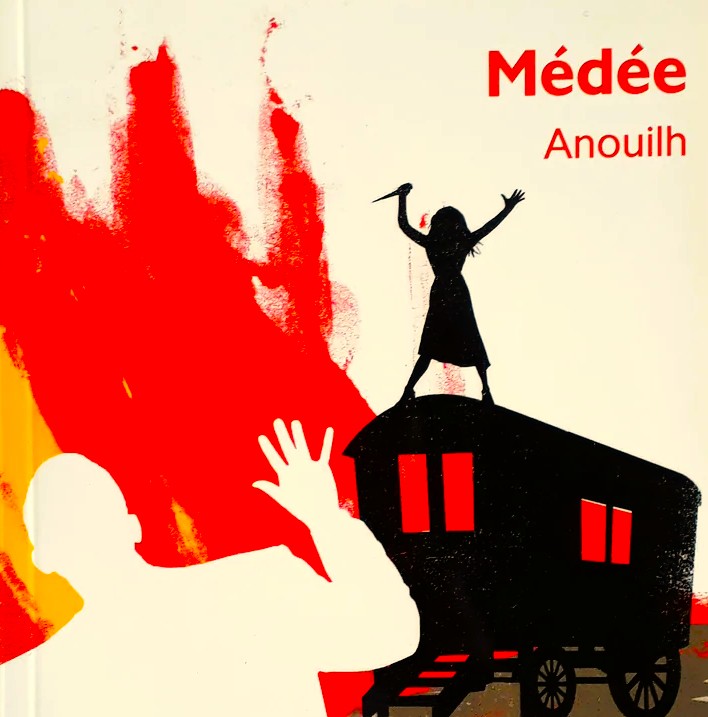
The Austrian Franz Grillparzer's The Golden Fleece, which was completed in 1820, was a trilogy of plays – The Guest, The Argonauts and Medea. It was a story of development in which we get to follow Medea as a young woman; an Amazon riding and hunting in the mountainous areas of the Caucasus. In the second part, Medea matured and immersed herself in the dark arts of magic, while falling in love with Jason and leaving her country, until in the final part she tried to adapt to her new life in Thebes.
According to Grillparzer, the different plays corresponded to phases in Medea's life. The first one ended with Medea's despair through the realization that her father had cowardly and deceitfully used her to murder Phrixus, who came to Colchis with the Golden Fleece. For Medea, it meant the end of her naivety, through which she had believed that her father was an irreproachable hero. Medea's belief in her innocence was lost in the second part of the trilogy, when she was driven to theft, betrayal and murder through her love for Jason. In the third part, she finally came face to face with death and despair.
Just now I took a break in my writing to do some TV watching. Lately, I've been trying to follow an extremely complicated German TV series, Dark, which intricacies are linked to time travel, black holes and the Higgs boson, among other things. In episode 23, called Life and Death, one of the characters said:
A human lives three lives. The first ends with the loss of naiveté, the second with the loss of innocence, and the third with the loss of life itself.
A strange coincidence. Could this have something to do with Grillparzer’s Medea? My searches online yielded no results.

In the last Grillparzer play, we meet a subdued Medea, although passion glows beneath the surface. Creusa is not an insecure young lady, but has the same age as Medea, a childhood friend of Jason's who only thinks well of him. Medea, who wants to adapt to the enlightened "decent" Greek life, has buried her magic paraphernalia and is dressed like a Greek woman. She seems to look up to Creusa as a role model able to teach her to conform to the expectations of the Greek-born Jason, to become what she thinks he wants her to be – a "civilized and decent" woman.
In a key scene, Kreusa tried to teach Medea to play the lyre. But, Medea complained. During her youth, her hands had become rough after handling horse reins, spears and bows. They were not as refined as Kreusa's. "Rebellious fingers!" she exclaimed, “I want to punish you!”
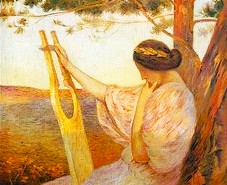
But Medea learned to play and sing a song that Creusa knew that Jason loved when he was young. Medea succeeded in singing it and then asked Creusa if she realized the true meaning of the wors – they were about a beautiful, young hero who with a sure hand crushed his enemies and made women fall for him. No, Creusa hadn't thought about the words, only sung the song. Medea was surprised – are Greeks only interested in sounds? Didn't they think about the meaning of what they sang and said? Like the lines:
To beat all enemies and steal the heart
from all the beautiful virgins!
That's exactly how Jason was – egocentric. He didn't care about other people's feelings. Thoughtless as a child, he hurt the people around him and believed himself to be innocent of the suffering he caused others, not least through the faithlessness he showed women.
Creusa became violently upset. How could Medea utter such things about her husband? This handsome, good person whom Creusa had known since childhood. Medea replied, "Because I know him better than you. I have been by his side when he has been tested. I have seen and experienced his weaknesses." Creusa rushed out of the room.
When Medea later played for Jason, the lyre broke in her clumsy hands, she couldn't possibly move herself in the sophisticated salons of the Greeks. And even worse, her own children were ashamed of her and preferred to resort to the gentle Creusa, who caressed them and babbled:
Come here to me, poor, homeless, little orphans! So young, and yet misfortune bows you down So soon! So young, and oh! so innocent!-- And look, how this one has his father's mien
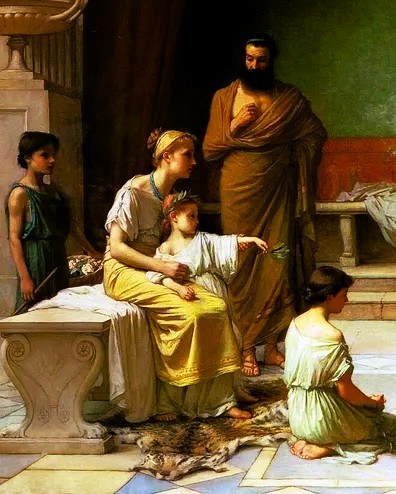
Medea could not restrain her anger:
They are not orphans, do not need thy tears of pity! For Prince Jason is their father; and while Medea lives, they have no need to seek a mother! were it a spear-haft, or the weapons fierce of the bloody hunt, these hands were quick enough!
When Jason has displaced Medea and married Creusa and the newlyweds will keep the children while Medea is driven into exile, her skull shattered and oblivious to all cultivated behavior, her wild animal instincts took over Medea. She killed her children so they would not be overshadowed by those who would be born through Creusa's marriage to a cold and disinterested Jason.
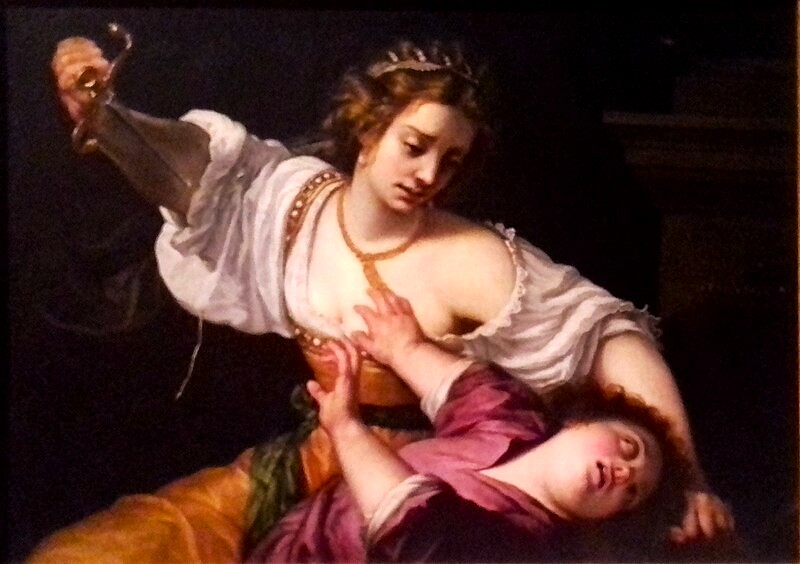
Medea's unsuccessful lyre playing indicated how great the role of music was in ancient Greek society. There are many indications that the Greek dramas were sung, to a much greater extent than we can now imagine. Perhaps opera might be considered to be an heir to this kind of drama. In any case, Medea's passionate drama has inspired several operas. Perhaps most famous of all Meda performances was Maria Callas' portrayal of the here in Luigi Cherubini's Medea, which premiered in Paris in 1797.
Cherubini's opera, which had been popular in its time, did however come to be lying fallow more or less until 1953 when Callas made an explosive performance in the role of Medea at La Scala. Since then, the opera has been a common feature in the global opera repertoire.
With Medea, Leonard Bernstein made his debut at La Scala. He had been called in at the last minute as a replacement, but did nevertheless give an energetic and personal touch to the performance, which exemplarily highlighted Calla's grandiose romantic interpretation of the displaced and furious woman, She gave Medea a voice that dripped with hatred and revenge. It became one of the greatest roles of her life and she sang it several times. Callas was magnificent, as if being possessed she dominated the performances. Her voice could do almost anything, and what she couldn't do with it, she forced it to approach.
The biggest shortcoming was Calla's inability to keep her voice free and unobstructed as it rose in pitch, something she compensated for by putting more effort into it. Callas had the bad habit of carrying her chest voice too high, which for her meant a great effort, not least because it was combined with her constant struggle against her weight. This, and the demanding roles, certainly accelerated the ultimate destruction of her unique voice.
In Hamburg in 1959, Callas' voice cracked in the opening scene of Verdi's Macbeth and then it went downhill. Her acting continued to be beautiful and cinematically precise, but the conductors increasingly tried to make the orchestration dull her progressively deficient vocal resources – a damaged voice can never be repaired. Callas' last tour took place in 1974, but by then her voice was almost gone. Three years later, she died of a heart attack, at the age of 53. There is no film recording of her Medea performances, except for a few scenes.
https://www.youtube.com/watch?v=m7Lyjm9P7BE

In Cherubini’s opera, Medea is killed in the fire she had started in Creon's palace, but in most other versions, such as those by Euripides and Seneca, she first talked to the self-righteous Jason, who claimed to be able to take care of their children and persuade Creusa to become like a mother to the boys, though both he and Medea knew that Creusa hated them.
Medea pretended to be compliant and suggested to Jason that she, as a token of reconciliation, could give Creusa her finest cloak and a tiara, These had been given to Medea by her grandfather, the Sun (in some versions, the cloak is the same as Jason's gift from the Hypsipyle, so treacherously abandoned by him). Jason agreed with some hesitation: "Why give away something so valuable. But... all women are certainly fond of precious things." And indeed, when Medea had sent her sons with the gifts to Creusa, she at first turned away from the boys in disgust, but when she laid her5 eyes on the magnificent robe and sparkling tiara, she became delighted and immediately put them on.
However, Medea has poisoned the gifts. They clung tight to Creusa and burned with such intensity that they caught fire, her father Creon threw himself on his screaming daughter, but the fire spread to him as well and soon the whole palace had caught fire.
Meanwhile, Medea had slit the throats of her children and when Jason appeared, she was standing on the roof of the burning palace with the dead boys in her arms. In Euripides, Medea left the stage in her dragon chariot, but in the much more lugubrious Seneca, she had before that hurled the children's corpses down to Jason, accompanied by a prayer to the gods:
Let him walk in terror through unknown lands, exiled, hated, desolate without a home; too notorious and despised to become a guest anywhere, let him knock in vain at strange gates and long for me, his wife! And, one last revenge … let him beget sons who resemble their father and daughters like their mother!
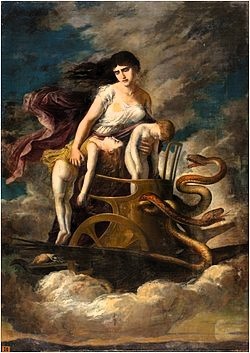
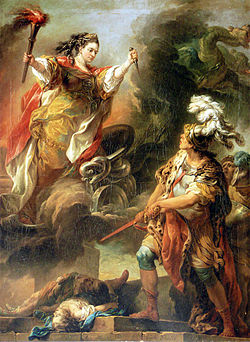
Seneca's plays are far more gruesome than their Greek counterparts, and although they have constituted an important inspiration for masters such as Shakespeare, Racine and Corneille, they have also by many been dismissed not only as unperformable, but also as "absolutely illegible". A verdict I actually can't agree with, Seneca's dramas are actually in my opinion quite OK, with their striking rhetoric and macabre shadow play.
Seneca’s Medea is characterized by a heavy rhythm and in it he makes an interesting connection between the singer Orpheus, who was one of the Argonauts and whose singing could sooth and subdue even the treacherously alluring tones of the sirens and calm the stormy sea, while Medea with her magic tricks was able to achieve similar miracles.
For a Stoic like Seneca, Orpheus and Meda were dangerous extremes. Through their art, they mastered the forces of nature, something that we humans should instead submit to. Nature, despite its unimaginable grandeur and cruelty, is the basis of all human life. If we humans like Orpheus and Medea manipulate it, it can easily lead to chaos and disaster.

During the Middle Ages, Medea became popular within Europes, sophisticated court circles. In the popular Pretiosa Margarita Novella, The New Pearl of High Value, she appeared as a guide for alchemists. In Ovide Moralise, she fought the Antichrist as an ally of God. In Geoffrey Chaucer's The Legend of Good Women, she became the epitome of a betrayed, wronged wife, while she became a nightmare character in Raoul Lefèvre's L'histoire de Jason.
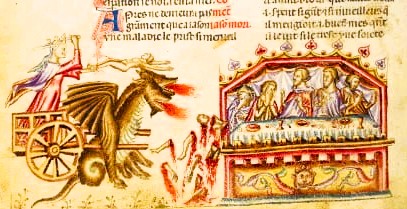
It was as a female idol that Medea made her entry into the "courtly" culture, and it was not in the version of Euripides or Seneca, but in the form of Ovid's milder and more elegant poetry. Medea's greatest impact was probably through the anonymous Ovide Moralisé (c. 1316-28), an enormous, wide-ranging poem that changed the way Ovid's originals were read and how Medea and other classical heroes and heroines in the later Middle Ages came to be part of court culture. But even before that, Medea had been integrated into the European storytelling tradition, mainly through Benoît de Sainte-Maure's epic Roman de Troie from around 1160. There, Medea (before the child murders) appears as attractive, wise, noble and virtuous.
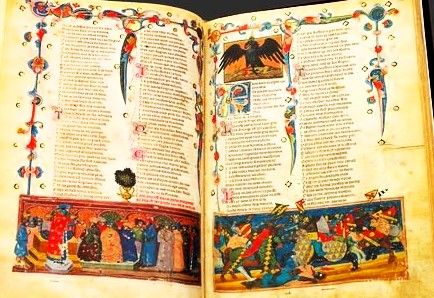
Medea, even more than her horrible side that sometimes breaks out, seems to retain her status as a female role model all throughout the Middle Ages. Christine de Pizan did for example, in her Le Livre de la Cité des Dames, The Book of the Women's City, from 1405, emphasize Jason's disloyalty to Medea and made no mention at all of her murder of her children.
According to Christine de Pizan, Medea was an extremely beautiful, tall and slender lady with a profound knowledge of the forces of nature. In learning she surpassed all other women, for she knew the properties of each plant and what spells they could be used for. With a song that she alone knew, Medea could darken the skies, draw the wind out of gloomy caves in the depths of the earth, awaken storms, make rivers stop flowing, brew all sorts of poisons, create fire out of nothing, and burn down whatever she wished, as well as performing all sorts of other miracles.
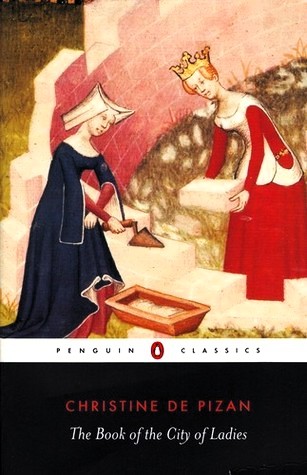
So why did Medea become so popular among troubadours and women writers? Within noble families, women were used as a kind of commodity to strengthen coalitions and create peace between warring factions through marital alliances. However, within a society that valued warfare, it could also be a risk to marry off women as a token to ensure peace. Several married women could end up in unhappy and awkward situations, in particular if their husbands did not have any political/economic interest in them.
Medea's story resonated in such a society. How she of her own volition gave herself to Jason and thus betrayed her male relatives, both father and brother, and how she then, despite her intelligence and great knowledge, became hopelessly dependent on her husband's contacts, position and power. What could a betrayed and abandoned woman do in such a subordinate and vulnerable situation? Several educated, medieval women considered themselves to be their husbands' slave girls.
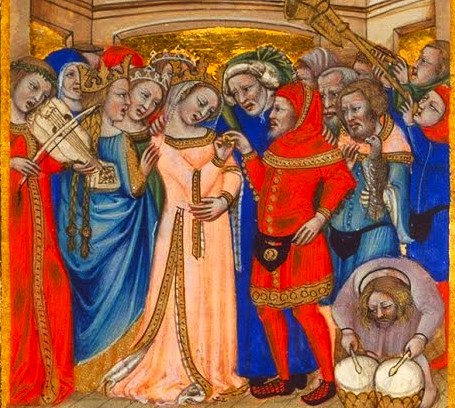
A writer who much later brought out the feminist perspectives from Medea's history was the East German writer Christa Wolf, who in her novel Medea: Voices from 1996 made Medea a representative of free thought. In Wolf's work, Medea is a pragmatically minded woman who follows Jason on his journey from Colchis, not so much for the sake of her love but more out of disgust for her father's despotic rule. In Wolf's case, it is not Medea and Jason who have killed Medea's brother Apsirto, but the corrupt Aïtes, simply because he considered him to be a threat to his authoritative power.
Medea followed Jason to Greece because she imagined that country to be a haven of rationality and humanism, but she was cruelly disappointed when Jason abandoned her and she realized that Creon was just as murderous despot, just like her own father. Creon had had his eldest daughter Ifione murdered and used his younger, Glauce (Kreusa), as if she were a commodity to bind Jason more tightly to him.
Medea tried to help and instruct Glauce, but the poor girl killed herself. Medea, according to Wolf, was also not guilty of the death of her children – falsely accused of a ritual murder, she was sentenced to be banned from Corinth, while her sons were allowed to remain with their father. Later, in Medea's absence, a xenophobic lynch mob stoned her children to death and a false rumour was spread that it was she that had poisoned them.
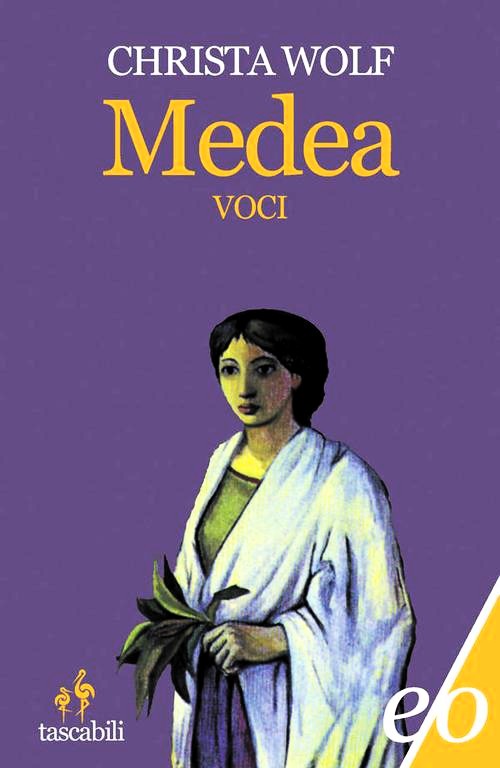
With Euripides, Seneca and Ovid, Medea traveled in her dragon chariot from the scene of the murder. Ovid tells how she sought refuge with King Aegeus in Athens. Medea had previously met him in Euripides' drama and promised that if she had been forced to leave Corinth, she would marry Aegeus and through her sorcery give him the children he desired.
Medea gave birth to hers and Aegeus' son Medus, but when Theseus from one of Aegeus' previous relationships, and who had now grown up without his father's knowledge, unexpectedly appeared, Medea tried to poison him. She considered the appearance of Theseus to be a threat to her own son. However, Medea's intention was discovered at the last moment and she was forced to flee again. Medus later became king of Colchis, Medea's fatherland.
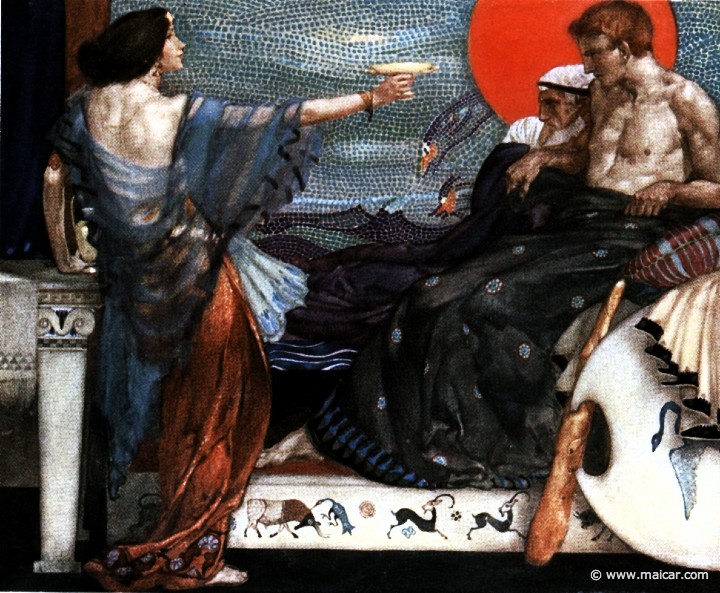
Strangely enough, Medea was rewarded after death by being betrothed to the hero Achilles and with him live in the paradisaic Elysian fields.
Jason's ending was tragic. His hopes for Corinth's royal crown were dashed. The Italian poet Cesare Pavese told in a short story from 1947 how an aged Jason in a temple on Acrocorinto, the Acropolis of Corinth, met Mélita, a temple prostitute who felt sorry for the now old and frail Jason and took care of him.
Jason told Mélita about the adventures of the Argonauts, which had taken place before Mélita was born. Jason could hardly believe that he had been part of all that, which happened as he said "when the world was still young". He had done evil deeds without really understanding that they were actually evil, since he had thought he was strong and "wanted to be like a god."
And Medea? Well, every man meets a seductress at some point. What can a man do about that? Women are mysterious, dangerous and incomprehensible. Who can understand them? It had been a long time since Medea ruined Jason’s life. How and why? Who can understand that? The only thing that seemed to annoy Jason was that Heracles became a god and not him.
Pavese does not tell it, but legend has it that old Jason stumbled down to the sea shore where the wreck of the Argo rested. He fell asleep in its shadow, a heavy beam detached from the hull fell on Jason and crushed his skull.
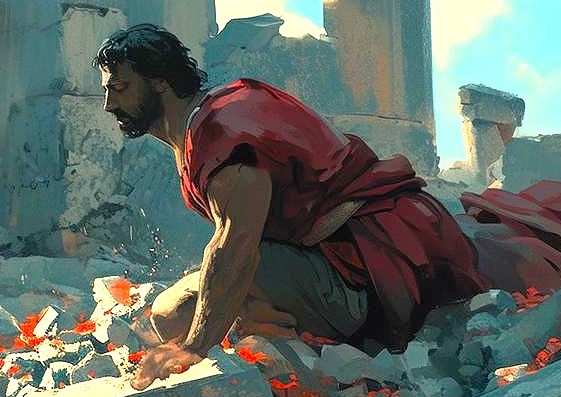
There are many more stories about the child murderer Medea. She constantly changes shape, is reinterpreted and reappears. She has never existed, but she is nevertheless real, just like Hamlet, Don Quixote and Sherlock Holmes, immortal figures who for many of us have become part of our reality.
Aligheri, Dante (2002) La Divina Commedia: Inferno. Firenze: Felice Le Monnier. Anouilh. Jean (2022) Médée. Paris: Flammarion. Apollonius of Rhodes (1972) The Voyage of Argo. Harmondsworth, Middlesex: Penguin Classics. Ciani, Maria Grazia (ed.) Euripide, Seneca, Grillparzer, Alvaro: Medea, variazioni sul mito. Milano: Marsilio. De Pizan, Christine (1999) The Book of the City of Ladies. London: Penguin Classics. Dodds, E.R. (1962) The Greeks and the Irrational. Berkeley, CA: University of California Press. Littell, Jonathan (2009) The Kindly Ones. New York: HarperCollins. Longerich, Peter (2011) Heinrich Himmler. Oxford; Oxford University press. McElduff, Siobhán (2012) “The Multiple Medeas of the Middle Ages”, in Ramus, Vol. 4, Issue 1-2. Ovid (2004) Metamorphoses. London: Penguin Classics. Pasolini, Pier Paolo (1991) Il Vangelo secondo Matteo, Edipo Re, Medea. Milano: Garzanti. Pavese, Cesare (1947) Dialoghi con Leucó. Torino: Einaudi. Peparoni, Demetrio (2023) Medea. Milano: Skira editore. Pepe, Laura (2024) Medea e Giasone. Milano: RCS Media Group. Pindar (1997) Olympian Odes, Pythian Odes. Cambridge, MA: Loeb Classical Library. Sundel, Alfred (1963) “The Argonauts”, Classics Illustrated No. 163. Walsh, Lisl (2009) “Orpheus in Seneca’s Medea,” in The Classical Outlook, Vol, 86, No. 14. Wolf, Christa (1998) Medea: A Modern Retelling. New York: Doubleday.
Efter 23 månaders krig i Gaza uppskattade Rädda Barnen att antalet dödade barn översteg 20 000. Detta gör dock inte att Israels högste krigsledare, Benjamin Netanyahu, främst betraktas som en barnamördare. Det gör heller inte i första hand Heinrich Himmler, den högste ledaren för Andra världskrigets systematiska utrotande av ”icke önskvärda befolkningselement”, vilket ledde till förintandet av mer än 1,5 miljoner barn.
Himmler hade uttryckligen befallt likvideringen av alla judiska barn. I ett tal i Posen (det nuvarande polska Posznań), den 4:e oktober 1943 hade den ovanligt vedervärdige Himmler konstaterat att inte enbart judiska män, utan även judiska kvinnor och barn måste slaktas:
Ty jag ansåg mig inte berättigad att utrota männen – med andra ord, döda dem eller låta dem döda – och sedan låta deras barn växa upp och hämnas på våra barn och barnbarn. Det svåra beslutet var tvunget att fattas att dessa människor måste försvinna från jordens yta. Att organisera och utföra denna plikt som vi är tvingade att utföra var det svåraste vi någonsin har varit tvungna att ta oss an.


Arketypen för en patologisk barnamördare är dock inte Heinrich Himmler utan den mytiska Medea som med kallt blod mördade två av sina barn för att hämnas sin makes otrohet.

Det rör sig alltså om proportioner. Som då kvinnomördaren och sol-och-våraren Monsieur Verdoux försvarade sig i Chaplins film med samma namn:
Krig, konflikter – det rör sig enbart om affärer. Ett mord skapar en skurk; miljoner en hjälte. Antalet helgar, min bäste herre!
I själva verket citerar den cyniske Verdoux den engelske biskopen Belby Porteus (1731-1809), en våldsam motståndare mot Kyrkans skenheliga tystnad gällande, eller till och med försvar av slavhandeln, som enligt honom helgades av girighet. Vinster får till och med Kyrkan att tystna och Mammon sätter munkavle på Jesus.


Absurditeten då det gäller mördandets dimensioner understryks i Jonhatan Littells roman De Välvilliga från 2006 i vilken den fiktive för detta SS-officeren Max Aue, utan någon uppenbar ånger, berättar om sitt deltagande i morden på judar då han som officer inom de Sonderkommandon som likviderade judar, partisaner och zigenare på Östfronten och hur han senare kom att bli en del i koncentrationslägrens organisation. Denne massmördare råkar i svårigheter inte genom sina sitt deltagande i massmord, som belönades med Järnkorset, utan därför att han på osäkra grunder misstänktes för morden på sin mor och styvfar. Max Aue följdes därför under brinnande världskrig i hälarna av två detektivpoliser från Kripo, det nazistiska Kriminalpolizei. Kripo ägnade sig mestadels åt att undersöka brott som mord, våldtäkt och mordbrand.

Titeln på romanen – Les Bienveillantes, anspelar på den antika grekiska teatertrilogin Orestien av Aiskylos, i vilka Orestes efter att ha mördat sin mor jagas av hämndgudinnorna, erinyerna, men som till slut rentvås i en rättegång varefter erinyerna kom att kallas eumenidern, de Välvilliga. Max Aue frikänns från misstankarna kring hans modersmord, medan hans massmördande i naziregimens tjänst sopas under mattan.
Titeln på Littells roman och dess underliggande grekiska mytologi för oss in i den klassiska tragedins värld och en av dess mest fascinerande gestalter – barnamörderskan Medea. Hon har följt mig ända sedan vi på universitetet fick läsa Euripides drama. Det blev nästan en chock att finna hur en författare mer än fyrahundra år före vår tideräkning kunnat skapa ett så passionerat, insiktsfullt och mångbottnat drama kring en kvinnas ångest och oerhörda brott. Hur kan en mor drivas till att döda sina barn? Dramat är så rikt och märkvärdigt att jag läst om det gång på gång, alltid lika förundrad.

Medeas historia tar sin början med en resa som förlorar sig långt tillbaka i bronsåldern, kanske omkring 1 300 f.Kr. Grekernas främsta hjältar, flera av dem söner till gudar och sedermera fäder till flera av Iliadens hjältar, hade förenat sig med den unge Jason för att tillsammans med honom segla till Kolchis, beläget vid bortre änden av den för grekerna då kända världen. Närmare bestämt vid det nuvarande Georgiens kust, nedanför Kaukasiens väldiga, snötäckta bergsmassiv. I en lund i Kolchis hängde Det gyllene skinnet, av okänd anledning åtrått av hela den dåtida världen.

Långt därifrån, i staden Iolchis i det grekiska Thessalien hade konung, Pelias tillskansat sig makten efter att ha kastat sin halvbroder Aison i fängelse. I god tid hade dock Aison sänt sin son Jason för att långt ute på landsbygden, liksom sedermera Achilles, bli uppfostrad av den vise kentauren Kiron.
Då Jason som vuxen lämnat Kiron och sökt sig Iolchis hamnade han på en fest anordnad av sin lömske farbror. Då han fick syn på den stilige ynglingen förstod Pelias att det måste vara Jason, den rättmätige innehavaren av hans tron, men Pelias insåg också att han inte kunde döda sin populäre brorson och beslöt sig istället för sända honom på vad han ansåg var ett omöjligt och dödligt äventyr – nämligen stölden av Det gyllene skinnet.

Denna klenod fann sitt upphov då havsguden Poseidon åtrådde den vackra Theophane. För att kunna lägga beslag på den älskliga varelsen helt för sig själv och hindra att hon föll i händerna på andra älskare, förvandlade Poseidon den stackars flickan till en tacka och sig själv till en gumse. Deras märkliga avkomma blev Chrysomallos en väldig bagge som kunde flyga och tala, samt hade en päls av guld, som lyste som solen. Det fantastiska djuret skänkte Poseidon till solguden Helios.
Nefele, en nymf kopplad till molnbildning och som därmed också hade något med Helios att göra, var gift med kungen Athamas, tillsammans med vilken hon fått barnen Frixos och Helle. Athamas tröttnade dock på Nefele, gjorde henne till sin konkubin (något Jason långt senare ville göra med Medea) och gifte sig istället med Ino, som Hera ogillade eftersom hon en gång räddat den nyfödde Dionysos (resultatet av en av maken Zeus utomäktenskapliga eskapader) från hennes vrede.
Ino avskydde Nefele och övertygade falskeligen sin make Athamas att hon låg bakom en hungersnöd och för att gudarna skulle blidkas måste han offra Frixos och Helle. Nefele lyckades dock slita sina barn från ded rasande maken, som stod i begrepp att lägga sina barn på altaret och skära halsen av dem.

Från sina himmelska höjder bevittande Helios dramat och sände sin gyllene Chrysomallos till jorden för att Nefeles barn skulle föras i säkerhet vid världens ände, dvs. Kolchis. Under färden greps dock Helle av svindel och föll ner i det sund som efter henne kom att kallas Hellesponten.
Frixos klarade dock den vådliga färden och offrade Chrysomallos till Zeus, detta eftersom den högste guden i sin skepnad av Zeus Phýxius var flyktingars och främlingars beskyddare. Frixos skänkte Chrysomallos gyllene skinn till Kolchis kung Aïtes, som var son till Helios. I tacksamhet garanterade Aïtes Frixos sitt beskydd och lät honom gifta sig med sin dotter Kalkiope.

Men varför sände Pelias sin brorson för att hämta Det gyllene skinnet? Och den mer svårbesvarade frågan – varför följde så många av Greklands största hjältar honom på den farofyllda färden på jakt efter ett mer eller mindre obegripligt objekt?
Som så många myter och sagor som förlorat sig i ett forntida mörker ges inte några ordentliga svar på sådana frågor, men det har inte hindrat en mängd författare och vetenskapsmän från att försöka finna svar på dem. Innan jag går in på Medeas roll i det hela kan det kanske vara upplysande att röra om lite bland de där svårigheterna.
Först sagomotivet. Runt om i hela världen finner vi fasta mönster då det gäller berättandet av sagor och myter. Ytterst vanligt är att unga män, och ibland en och annan kvinna, ger sig ur på jakt efter okända platser och ting – Soria Moria slott öster om solen och väster om månen, Venus grotta, El Dorado, Den heliga Graalen, De vises sten, eller Livets ört.

Det kan också röra sig om en historia som symboliskt skildrar en ung människas mognad. Hjältarna i dessa myter är som sagt ofta unga män som genom farofyllda färder kommer till insikt om vad livet verkligen går ut på, eller allt som oftast finner de en kvinna med vilken de kan delas sitt liv och få barn tillsammans med. Eller – kanske det rör sig om att följa ett öde som högre makter redan fastställt.
För Jason var kanske jakten på Det gyllene Skinnet en kombination av allt detta – han sökte ett mystiskt föremål som han slutligen fick tag på genom att besegra ett monster och han förde från äventyret med sig en vacker kvinna, samtidigt hade han med hennes hjälp kunnat fullfölja ett uppdrag som Hera hade gett honom – nämligen äktenskapets, trohetens och hemmets uppdrag. Hera var ju trots allt hemmets och moderskärlekens gudinna. När Jason slutligen bröt dessa helgade villkor gick det riktigt illa, men till en början – Hera hade varit honom nådig.

Hera hade smitt planer på hur hon skulle utkräva hämnd på den av henne avskydde Pelias, som vid en rad tillfällen förnekat henne de offer som tillkom henne och vad än värre var hade mördat en kvinna i hennes tempel. Pelias mor hade förskjutits av hans far (uppenbarligen ett vanligt beteende hos grekiska kungar) och levde som konkubin kvar i kungen Salmoneos hus. Kungens nya hustru, Sidero, behandlade dock sin föregångare och hennes son så illa att denne, efter det att han blivit vuxen, attackerade sin elaka styvmor så våldsamt att hon sökte skydd i Heras tempel. Den rasande Pelias lät sig inte hindras av att hans så avskydda styvmor sökt Heras beskydd, utan rusade efter Sidero in i templet och högg ner henne framför Heras altare, varigenom han ohjälpligt besudlat gudinnans helgedom.
Då Hera hört att Pelias åter skulle arrangera ett stort offer till gudarna, men på nytt tänkte utelämna henne, förvandlade hon sig till en gammal, ledbruten kvinna och slog sig ner vid en flodövergång utanför staden Iolchis och bad de förbipasserande bära henne över den strida strömmen. Det var gudinnans sätt att finna någon som var värdig hennes förtroende.

De förbipasserande struntade i den förklädda Heras begäran om hjälp tills dess Jason dök upp och bar henne över floden. Hera insåg att denne stilige, unge man var att lita på. Men, en av Jasons sandaler hade fastnat i flodbottnens gyttja och då han senare dök upp vid Pylias offerceremoni lade denne förskräckt märke till att han saknade en sandal. Pylias hade nämligen blivit spådd att en ung man med enbart en sandal med tiden skulle orsaka hans död och vad värre var – då man frågat honom vem han var svarade Jason:
Efter att ha nu ha fyllt tjugo år utan att innan dess ha yttrat några oförskämdheter eller begått beklagansvärda handlingar, har jag kommit hem för att återupprätta min faders forna heder och ta tillbaka den kungatitel som andra tillskansat sig.
Den skräckslagne Pylias lovade Jason att låta bygga och utrusta det bästa tänkbara skepp och bemanna det med Greklands mest oförvägna ungdomar, inte minst den store Herakles, så att Jason därmed skulle kunna erövra Det gyllene skinnet och visa sig vara värdig Iolchis kungatron.
Detta var ett mandomsprov som sagts vara orsakat av att Jason bar enbart en sandal, ett tecken på att han enbart hade ena foten på jorden och därmed befann sig i ett mellanstadium, halvvägs mellan yngling och man. Det storartade äventyret skulle göra Jason till redig karl, som för var och en bevisat sin kraft och sitt mannamod.
Det var poeten Pindaros (518 – 438 f.Kr) som berättade detta i ett ode han sjöng under de olympiska spelen 466 f.Kr. för att hylla en lybisk kung som vunnit en hästkapplöpning. I odet hyllade Pindaros även Medea som han låter besjunga skeppet Argos resa:
Så ljöd Medeas rytmiska sång och i orörlig tystnad böjde de gudalika hjältarna sina huvuden medan de lyssnade till hennes visa råd.
Pindaros strofer var en del av den första längre skildringen av argonauternas resa till Iolchis, men den klassiska berättelsen om deras äventyr blev Apollonius av Rhodos (295 – 215 f.Kr.) Argonautica, dramatisk och välskriven på konstfull grekiska skrevs den av en bibliotekarie vid det väldiga biblioteket i Alexandria, där han hade tillgång till den stora mängd hjältesagor och geografiska skildringar som kom att utgöra grunden för hans historia. Medea är den person som framträder skarpast och läsaren får följa hennes tankar och känslor genom inre monologer, långt för James Joyce. Sagans övriga personer, även Jason, är långt mer schablonartat skildrade. Argonautica är en klassisk äventyrsskildring, fylld med fläkt och romantik.

Det ståtliga skeppet Argos skapades under gudinnan Athenas ledning av mästerbyggaren Argus, som sedan följde med på resan. Det timrades av gran och dess femtio åror tillverkades av furor från berget Pelion. I fören hamrade Argus fast en gren från en helig ek i Zeus lund i Dodona, där träden kunde tala. Grenen hade förmågan att yttra sig i farotider och då ge råd till Jason om vad han borde göra.


Det blev dags för avfärd. Iolchis män och kvinnor samlades för att i beundran, gråt och veklagan ta avsked av denna formidabla samling av Greklands mest avhållna idoler, samtliga ståtliga unga män, som festligt klädda i rustningar och utsökta mantlar vandrade ner mot Argo, det praktfullaste skepp som någonsin byggts i Grekland. Med utsökt vältalighet tröstade Jason sina nära och kära, men då han bejublad gick ner till det väntande skeppet lade han knappt märke till
Iphias, Artemis åldrade prästinna, deras stads Väktare, som kom fram och kysste hans högra hand, men trots all sin iver kunde hon inte säga ett ord till honom eftersom folkmassan svepte fram. Hon lämnades kvar vid vägkanten, liksom de gamla lämnas av de unga. Jason hade gått förbi och var snart utom synhåll.
En av de många utsökta scener som Apollonius allt som oftast ger oss i sin skildring, ibland liksom här med en diskret, förnuftig kommentar.
De unga kämparna steg ombord och intog sina förutbestämda platser på roddarbänkarna, då Argos kommit ut på öppet vatten spändes det väldiga seglet av en mild bris och äventyret tog sin början.


Man seglade norrut och följde sedan Svarta havets södra kust mot Kolchis, men det var inte enbart en resa genom verkliga farleder utan även genom myternas förtrollade värld. Argonauterna kämpade mot fientliga arméer, sexarmade monster och harpyor, seglade mellan försåtligt vandrande klippor, skeppskamrater rövades bort av vattennymfer eller föll offer för väldiga vildsvin med förgiftande bett, hiskliga örnar avsköt dödliga fjädrar mot dem. Vid flera tillfällen tycktes männens tålamod vara på upphällningen och de önskade inget annat än att få återvända hem. Men Jasons vältalighet och fasta övertygelse om att de skulle komma att lyckas med att erövra Det gyllene skinnet och därmed evinnerlig ära lyckades Jason gång på gång övertyga sin besättning om att det vore oförnuftigt att återvända då de kommit så längt och fått stå ut med så mycket. .
Ett strandhugg med framtida konsekvenser som inte berättades av Apollonius, men som finns bevarat i en mängd legender var då Kung Laomedon från Troja bad Herakles och Jason att döda en Ketus, ett slags havsvidunder, som plågade invånarna i hans stad. Herakles dödade monstret men Laomedon förvägrade argonauterna deras rättmätiga belöning och resultatet blev att Herakles och Jason senare återvände och plundrade Troja. Då den väldiga grekiska armén flera år därefter bekämpade trojanerna, något som utförligt berättas i Iliaden så sägs det att Jason och Herakles var med bland kämparna.

Detta enligt medeltida chansons gestes, sånger om ärofulla dåd, – i själva verket var dock såväl Jason som Herakles alldeles för gamla för att deltaga i det trojanska kriget och legenderna om dem tycks vara äldre än de som berättades om det Trojanska kriget. Herakles bragder nämns ofta i Iliaden, men redan där har de blivit till sagor.
I Iliaden nämns också Jason, men enbart som den berömde ”sjöfararen”, far till kungen av Lemnos. I medeltida chansons lyfts dock Jasons kärlekssaga med Medea fram och Herakles har där blivit till en väldig hjälte som i slagen vid Troja till och med överskuggar Achilles. Vid slutet av Trojas belägring hackar sig Herakles med sitt väldiga slagsvärd en väg genom det krigiska tumultet tills han möter Laomedon och med ett hugg får hans huvud att flyga fram över de våldsamt kämpande krigarna.

Hos Apollonius är Jason ingen helgjuten hjälte, han har sina tillkortakommanden och mänskliga svagheter. Emellanåt hade Jason ordentliga svårigheter med att hävda sig bland jämnstarka och ofta mer erfarna kamrater. Ofta var han tvungen att bekräfta sitt ledarskap med stöd från de siare och respekterade medlare som var med på färden, för att nu inte tala om Zeus talande gren som satt fastspikad i Argos för, liksom ständigt uppdykande gudar och andra mytiska väsen.
Till en början tycks Jason ha varit besvärad av att befinna sig i skuggan av den väldige gudasonen Herakles, som redan innan han anslöt sig till argonauterna var vittberömd och även hade färdats genom de riken de angjorde under sin färd. Innan avresan hade Jason låtit Argos besättning rösta om vem de ville ha som ledare och valet hade då enhälligt fallit på Herakles, som dock avböjde med hänvisningen att det faktiskt var Jason som givits uppdraget att erövra Det gyllene skinnet och därmed borde vara den som av gudar och människor valts att leda dem, trots sin ungdom.


Då Herakles unge vän, älskare och vapendragare, Hylas, rövats bort av vattennymfer och Herakles utom sig av oro för vännen, desperat och rasande irrat bort sig i skogarna, begärde Argos styrman, Tiphys, att de borde dra nytta av den förliga viden och avbryta sin väntan på Herakles. Jason höll med honom, men väl ute till havs rasade besättningen mot Jason och ville återvända för att söka efter Herakles. Den hårt trängde Jason fick dock åter hjälp av gudarna som den väldige havsvarelsen Glaukos som dök upp ur djupen, grep tag om skeppsrelingen och inför de vettskrämda männen bedyrade att Jason hade gudarnas stöd. En lättad och betydligt mer animerad Jason kunde nu ta ett säkrare om sin befälsmakt.
Författaren Apollonius förfaller emellanåt till att enbart markera de platser som argonauterna passerar, eller där de gör sina landhugg, genom att erbjuda korta notiser om de myter och den topografi som hade satts i samband med dem. Emellanåt ökades dock dramatiken i form av spännande och besynnerliga händelser. Som mötet med Phineus, en siare som föredragit ett långt liv i stället för syn och därför slagits med blindhet, men med kunskap om framtiden. Han hade exempelvis talat om för Frixos att han borde låta den gyllene gumsen . Chrysomallos ta honom till Kholkis. Men han hade inte kunnat avhålla sig från att berätta de hemskheter som väntade till och med gudarna, och även hela mänskligheten. Zeus retade sig på denna uppriktighet och straffade därmed Phineas, som inte kunde se sin egen framtid, genom att låta honom plågas av harpyorna, vedervärdiga flygande vidunder, hälften kvinnor, hälften gamar. Som så fort han skulle äta störtade sig ner från himlen, åt upp vad de kunde av Phineas mat och besudlade resten.

Argonauternas första anblick av den uthungrade, utslitne och blinde Phineas är ett bra exempel på Apollonius skildringskonst:
Han reste sig ur sängen, likt en fantom i en dröm, och med hjälp av en stav stapplade han på förtvinade fötter fram till dörren, medan han kände sig fram längs väggarna. Svaghet och ålderdom fick hans lemmar att darra när han gick; hans förkrympta kropp var täckt av smuts, och hans ben hölls samman endast av huden. När han hade kommit ut ur hallen gav hans knän vika och han satte sig på tröskeln till gården. Och där svimmade han. Marken under honom tycktes vackla; och han sjönk ner i koma, utan kraft att tala eller röra sig.
Då Phineas kommit till sans och lyssnat till argonauternas ungdomliga röster höjde han en förtvivlad bön till Zeus och bad för tusende gången om nåd och plötsligt såg han för sin inre syn inte sin egen framtid men argonauternas och förstod att de kommit för att befria honom från de förskräckliga harpyorna, något de också lyckades göra och den överlycklige Phineas ställde i tacksamhet till ett härligt gästabud och berättade för argonauterna om deras framtida resa och vad som sedan skulle ske med dem. Vis av skadan utelämnade han dock allt det elände som även skulle drabba envar av dem. Därefter hade Phineas, fortsatt blind, en tämligen fin tillvaro. Han dog dock aldrig, utan förvandlades i sinom tid till en mullvad.

Phineas berättade bland annat hur argonauterna skulle ta sig förbi de fruktade Slående klipporna. Skyhöga klippor som utan fäste i havsdjupet reste sig lodräta mot himlen. Varje skepp måste ta sig förbi dem och så gott som alla av dem var dömda att gå under, men Phineas visste råd om hur man skulle ta sig förbi dem. Han berättade för argonauterna hur de skulle klara sig från att krossas och av de förrädiska strömmar som klipporna åstadkom föras förbi dem. Skildringen av Argos färd mellan klipporna är förvisso också ytterst dramatisk.

Innan argonauterna angjorde Phineas ö hade Jason begått en tämligen bedrövlig handling, en föraning om framtida svek. Kvinnorna på Lemnos hade innan argonauternas strandhugg mördat samtliga av sina sybaritiska män som fått till vana att leva i sus och dus med slavinnor de rövat bort under sina krigståg. Deras nuvarande drottning, Hypsipyle, hade dock avrått kvinnorna frän att utföra sin gruvliga hämnd och själv inte deltagit i slaktandet av de ynkliga männen. Hon hade varnat dem för att de efter det blodiga dådet skulle bli tvingade att utföra männens hårda sysslor, som att plöja den hårda jorden, fiska på det förrädiska havet och ta hand om bångstyriga kreatur. Ovanpå detta hårdföra liv skulle de leva i fruktan för att bli överfallna av sina grannar – de krigiskt sinnade trakerna.
Då kvinnorna nu, ett drygt år efter morden, siktade Argo befarade de att det var traker som skulle överfalla dem. Glatt överraskade fann de dock att besättningsmännen var stiliga, vänligt sinnade unga män. Eftersom Hypsipyle tidigare rått sina kvinnliga undersåtar att dölja sitt brott och söka kärlek hos dugliga män, så gjorde de nu allt för att fästa argonauterna vid sig och de lyckades även över förväntan.

Argonauterna beslöt sig för att stanna på ön och slå färden mot Kolchis ur hågen. Jason spelade med och förförde den vackra Hypsipyle med falska förespeglingar om ett lyckligt liv tillsammans, fast hela tiden var han dock inriktad på att efter det behagliga uppehållet på Lemnos färdas vidare mot Kolchis.
Då Hypsipyle blivit gravid med vad som skulle visa sig vara tvillingar beslöt sig Jason för att överge henne och med ett eldigt tal lyckades han få sina män att följa honom vidare mot Kolchis. Hypsipyles sorg mildrade han genom löften om en snar återkomst, vilket visade sig vara en lögn, och hot om att avslöja de lemniska kvinnornas brott.
Den sörjande Hypsipyle drevs genom hopp och kärlek att tro på Jason och skänkte honom till avsked en gudagiven fantastisk mantel som Jason sedermera gav till Medea, som långt i framtiden använde den för att efter Jasons svek mot henne ta livet av hans nya, unga hustru. För sina brott förpassade Dante Jason till en plats i sitt Inferno:
Den gode mästaren [Vergilius, Dantes ledsagare], fast jag ej frågat,
sade mig: ”Se honom där, så reslig,
som trots sin smärta ej tycks gjuta tårar,
vad kunglig uppsyn än han bibehåller!
Jason är han som genom mod och klokhet
från kolchierna tog det gyllene skinnet.
Han kom på denna resa till ön Lemnos
sedan dess grymma, oförvägna kvinnor
åt allt sitt manfolk hade givit döden.
Med fagert tal och insmickrande miner
bedrog han där Hypsipyle, den ungmö
som sina medsystrar bedragit innan.
Där svek han henne, havande och ensam;
för sådant brott döms han till denna plåga [han piskas ständigt av demoner],
och även för Medea blir han straffad.

Slutligen siktar argonauterna resans mål – Kolchis. Hade de väntat sig en eländig utpost vid världens ände misstog de sig. De möts av en blomstrande stad med ett imposant palats av guld och marmor över vilket den hårde och mäktige Aïtes härskar, son till självaste Solen, Helios.

Det omgivande landskapet slog argonauterna med häpnad, de hade aldrig sett så höga berg som de som krönte Kaukasus imponerande bergskedja. De visste att högt däruppe låg den väldige titanen Prometheus, människornas välgörare, kedjad, alltmedan en örn varje dag glufsade i sig hans lever, enbart för att den nästa morgon återigen skulle växa fram. Titanens smärtoskrin gav dem en aning om kommande, hårda prövningar.
Och nu öppnade sig framför dem Svarta havets yttersta stränder och med dem Kaukasus mäktiga klippor, där Prometheus med bronskedjor fjättrats på den hårda klipphällen så att en örn kunde mätta sig med hans lever. Varje dag återvände fågeln ivrigt till sin måltid. På eftermiddagen såg de den med tunga vingslag flyga högt över skeppet. Den befann sig nära molnen, likväl kom segelduken att fladdra då örnens vingar fick luften att vibrera. För dess skapnad var inte lik någon annan fågels. De långa fjäderpennorna steg och föll som när tunga åror driver ett skepp genom vågorna. Strax efter det att fågeln passerat hörde de Prometheus ångestskik medan örnen slet i hans lever. Luften genljöd av hans vrål till dess de såg hur den köttätande fågeln återvände från bergen, samma väg som den kommit.


Det är i Kolchis som dramat får en mänskligare prägel än tidigare, gestalterna – i synnerhet Medea – får en fastare form och karaktär. Då kung Aïtes genom Jason fått reda på att argonauterna är ute efter hans älskade Gyllene skinn blev han rasande. Han hade svurit att aldrig bli av med den dyrbara pälsen, som blivit till ett med hans rikes ryktbarhet. Aïtes hade spikat upp Den gyllene skinnet på den breda stammen till en ek helgad åt Zeus. Ingen människa kunde närma sig dyrgripen emedan den dag som natt bevakades av en gigantisk orm, vars långa huggtänder dröp med dödligt gift.
Aïtes raseri ökades än mer genom Jasons erbjudande att i utbyte mot den gyllene pälsen angripa Kolchis fiender. Vilka fiender kunde en konung som Aïtes frukta? Behövde han en oslagbar armé sådde han egenhändigt ett fält med de draktänder som han tillsammans med sin frände Kadmos slagit ur käften på en drake som de dräpt utanför Korinth. Varje gång gav draksådden upphov till en här med oövervinneliga krigare.
Gudinnan Hera visste detta och tillsammans med sin förtrogna gudinna – Athena, som även hon var betagen av Jason, begav sig Hera till kärlekgudinnan Afrodite och på gudinnornas enträgna begäran gick Afrodite med på att sända sin okynnigt oberäknelige son Eros för att med en av sina kärlekspilar genomborra Medeas hjärta.

Medea hade från sina fastrar Kirke och Parsiphaë ärvt magins hela konstfärdighet, den goda likväl som den onda. Medea tjänade som översteprästinna i Hekates tempel. Likt den store Apollon, ljusets och konstens gud, men också herre över pest och råttor, hade även Hekate en dubbelnatur. Hon var de läkande örternas, hälsans och trygghetens gudinna, men även den tygellösa, grymma naturens, den onda magins och de mörka makternas beskyddarinna.
Eros pil sargade svårt Medea, som tills dess varit sin faders mest älskade barn och honom trogen och lydig i allt. Dessutom var hon utomjordiskt vacker. Likt sin far och sina fastrar var hon förlänad med solens klara, genomborrande blick och bländande blondhet. Detta trots att hon i allmänhet framställs som svarthårig och dolskt, exotiskt lockande.

Då en av hennes tjänarinnor meddelat Medea att stiliga främlingar från ett fjärran land sökt upp hennes fader greps hon av en oroande föraning om att hennes liv nu grundligt skulle komma förändras. Hennes koppling till mörka ödesmakter fick henne att inse att hennes öde var förenat med dessa främlingar och att framtiden inte skulle föra något gott med sig.

Och än värre blev det då hon vid första anblicken av Jason samtidigt träffades av Amors välriktade pil och omedelbart drabbades av ett våldsamt begär efter denne gudomligt fagre yngling. Som Ovidius skrev i sina Metamorfoser var Medea redan vid den första anblicken av Jason hopplöst förlorad och räddningslöst betagen:
Hon blev djupt förälskad i den stilige Jason. Trots en lång kamp mot sina känslor var hennes förnuft oförmöget att bemästra passionen: ”Det är meningslöst att kämpa emot, Medea”, sa hon sig. ”Någon gud är emot dig. Detta, eller något liknande, är väl vad de kallar kärlek. Hur skulle jag annars frukta för en mans liv som jag först nu har sett? – Men varför skall jag då känna mig så skräckslagen? Så eländig jag är! Jag måste släcka denna våldsamma eld som rasar i mitt oskuldsfulla hjärta. Jag skulle vara mer förnuftig, om jag kunde!”

Jason hade förvisso inte träffats av någon av Eros pilar, men han förstod att hans enda möjlighet att fullfölja det hopplösa uppdrag som ålagts honom var att söka hjälp, något han allt som oftast gjort under Argos färd mot Kolchis.
Liksom i sagornas värld gav Aïtes ett löfte till Jason att han kunde få Det gyllene skinnet i gåva om han kunde bevisa sig vara förmer än en vanlig människa. Aïtes gav honom därför tre fullkomligt omöjliga uppdrag – att spänna konungens väldiga, eldsprutande tjurar, försedda med dödligt spetsiga bronshorn, framför en tung plog och med dem sedan plöja ett fält och så det med en draksådd som skulle ge upphov till en armé med demoniska krigare. Efter att ha besegrat dessa Underjordens bronsklädda demoner måste Jason sedan övervinna den fasansfulla giftorm som outtröttlig bevakade Det gyllene skinnet. Först då skulle han befinnas värdig att lyfta skinnet från sin ek och föra det tillbaka till Grekland.



Det var med ångest den hopplöst förälskade Meda lyssnat till allt detta. Hon visste att det stod i hennes makt att skydda Jason från farorna och få honom att uppfylla uppdragen – men skulle hon svika sin far, sitt fosterland och hjälpa denne av hennes far så avskydde främling? Ett svek som skulle betyda att hon inte längre var välkommen bland kolchierna.
Medea tillbringade en sömnlös natt under vilken hon gång på gång sprang in till sin syster Kalkiope, som varit gift med Frixus (det viskades att han blivit lönnmördad av flickornas despotiske fader) och därmed visste hur svårt det var att leva med en främling i sitt eget land. Ville Medea förena sitt öde med Jason så måste hon enligt Kalkiope ge sig av från Kolchis.
Kalkiope hade varit djupt förälskad i sin grekiske make och förstod systerns dilemma. Hon rådde henne att hjälpa Jason och sedan fly med honom till det mytomspunna Grekland, som hennes hemlängtande make Frixus hyllat i varma ordalag.
Medea beslöt sig för att hjälpa Jason, men tvekade inför flykten från sitt fosterland. Hon var trots allt både fäst vid och fruktade sin tyranniske far och oroades inför en framtid som främling i ett fullständigt obekant land. Och … framför allt – hon levde inom vad Eric Robertson Dodds har kallat en ”utpräglad skamkultur”, enligt honom var det fruktan för att bli skambelagda som präglat grekernas gudstro och samvaron med sina medmänniskor – ”Vad skall alla andra tänka om mig och mina handlingar?” Under sin sömnlösa natt vände och vred Medea på sina plågsamma tankar:
”Låt honom dödas i striden med tjurarna, om det nu är hans öde att dö på den oplöjda åkern. För hur skulle jag kunna koka ihop drogen utan mina föräldrars vetskap? Vilken historia ska jag berätta för dem? Vilka knep kommer att tjäna mig? Hur kan jag hjälpa honom utan att bli upptäckt? Ska han och jag mötas i enrum? Ja, jag är dömd på förhand. Ty även om han dör så hyser jag inte något hopp om lycka; med Jason död skulle jag erfara ett än värre elände. Bort med blygsamhet, farväl till mitt goda namn! Räddad av mig från allt det onda som hotar honom, kan jag låta honom gå vart han vill och sedan dö. Samma dag som han triumferat skall jag hänga mig från en takbjälke, eller ta ett dödligt gift. Men, min död skulle likväl aldrig kunna rädda mig från deras onda tungor.”

Medea visste mer än väl att enbart hon, Kirkes sondotter och Hekates prästinna, var den enda kunde framställa den osårbarhetssalva som skulle göra Jason mäktig och osårbar. Genom hennes trollkunnighet skulle han kunna spänna de eldsprutande tjurarna framför plogen, plöja fältet, så draktänderna och besegra demonkrigarna. Och sedan – då skulle han ha stulit skinnet och seglat iväg över haven och lämnat henne ensam med skammen över att ha förrått sin far och sitt land.

Den förälskade Meda hade inte ens talat med Jason och beslöt sig därför att innan natten var tillända söka upp honom, där Argo låg dold i den höga vassen i en trögflytande flod utanför staden.
Då hon lämnat sina tjänarinnor bakom sig och mött Jason på en plats hon avtalat med hans sändebud, en av Frixus söner som förenat sig med Jasons män, så bländades Jason av hur Medeas skönhet strålade i månskenet, hon var ju inte för intet solens sondotter. Medea var dock mer betagen än Jason:
En stund blickade de båda djupt förlägna ner i marken, i nästa ögonblick log de och såg varandra djupt in i ögonen där kärleken lågade. […] Smärtfyllda tårar rann längs hennes kinder, hela hennes kropp brann av smärta och begär, som for längs nerverna, djupt in i nacken till den sårbara punkt där kärlekens obevekliga pil orsakat hennes skarpa våndor.

Jason visste redan att han kunde dra nytta av den vackra flickans kunskaper och lät därför sin salvelsefulla vältalighet flöda. Han jämförde Medea med de vackrast tänkbara gudinnorna, bedyrade sin eviga kärlek och lovade att ta henne med sig på tillbakafärden mot sitt land – vackrare och mer kultiverat än detta gudsförgätna Kolchis vid världens ände. Medea blev hjälplöst förförd, bländad, blind och betagen. Ovidius berättar:
Æsons son såg vackrare ut än någonsin. Medea kunde knappast klandras för sin passion. Hennes blick var fäst vid hans ansikte, som om hon aldrig sett det förut. ”Det måste vara en gud som står där”, tänkte hon i sin galenskap, oförmögen att vända sig bort. Men då främlingen börjat tala och plötsligt grep tag i hennes högra hand och med den ödmjukaste röst bad om hennes hjälp och lovade att göra henne till sin hustru, brast Medea i gråt och svarade: ”Jag vet vad jag gör: så om jag blir lurad kan jag inte skylla på min okunnighet, enbart på min kärlek. Du ska ha ditt liv att tacka för den hjälp jag ger dig. Se till att du håller ditt löfte!” Han svor vid den trefaldiga gudinnans [Hekates] riter och all den kraft som fanns förborgad i den heliga lunden [som de befann sig i]; han svor vid sin blivande fars fader, den allseende solguden [Helios], vid alla framgångar han hoppades på och alla faror han fruktade. Medea trodde honom.
Låt oss minnas detta då vi dömer Medea för henne framtida, fruktansvärda brott. Hon framställs som en ytterst intelligent, eftertänksam kvinna. Någon som noggrant överväger varje handling, varje steg hon tar. Hennes namn tycks vara besläktat med det grekiska medéia, ”förutse, planera, tänka ut”, men det hindrade inte att hon emellanåt föll till föga för våldsamma passioner.

Här kan vi åter ta Dodds till hjälp. De inre plågsamma samtal som Medea emellanåt ägnade sig åt, och som hos Euripides och Seneca blev till effektiva nonologer, kan förklaras genom de grekiska själsbegreppen psyche och thumos. Psyche kan möjligen betraktas som en människas personlighet/karaktär, hennes sociala/disciplinerade jag. Thumos är däremot kopplad till kroppen, dess funktioner och därmed även till olika begär som hunger och sömn, men inte minst andra former av drifter som sexualdrift, eller vrede då den tar sig kroppsliga uttryck, som exempelvis fysiskt våld.
Homeriska hjältar för emellanåt dialoger med sitt hjärta, sin lever, eller sin mage. Något som kan tolkas som om det är psyke som konfronterar sig med thumos – drifterna, passionerna.

Då Jason senare utsätts för Medeas besinningslösa vrede förklarar han det som att hon besatts av en alastor, en inre demon som skapats av ostillad skam över begångna brott som inte försonats genom några lämpliga religiösa riter. Men … moderniteten hos en författare som Euripides består i att han gör Medea till en kämpande människa som är väl medveten om att hon inte är besatt av några demoner – det är att hennes förnuft kämpar mot en okontrollerbar, passionerad natur. Hennes thumos har förgiftats av begäret efter Jasons kärlek. Medeas kommande missgärningar orsakas inte inte av någon på brist på insikt. Som då en slav ber om nåd från en grym herre kämpar Medea mot sina våldsamma passioner:
Jag vet vilka onda gärningar jag tänker begå, men thumos är starkare än mina avsikter. Thumos är roten till en människas värsta handlingar.

Medeas skarpa intellekt skulle kunna karaktäriseras med begreppet mêtis, kunskap. Det rör sig då inte om något abstrakt, djupreflekterande tänkande, något som grekerna betecknade med begreppet sophía, vishet, utan mer om en konkret, handlingsinriktad intelligens, som i sig innefattar såväl visdom som försiktighet, och slughet och skarpsinne. Egenskaper som Homeros förlänade sin hjälte ”den mångförslagne”, polú-tropos, Odysseus. Han var förvisso behäftad med ett övermått av polýmêtis, mångfacetterad mêtis. Liksom hos Medea kunde hos Odysseus dessa egenskaper slå över i grymhet och till synes helt omotiverade våldshandlingar. Men sådana gärningar tycktes likväl vara förenade med en viss infernalisk logik.
Odysseus och Medea var praktiskt inriktade individer. Medea hade exempelvis sina vittomfattande och djupgående kunskaper om alla de läkemedel, redskap och gifter som finns tillstädes i naturen och visste mycket väl hur hon skulle kunna dra nytta av dem.

Då Jason bedyrat sin kärlek, lovat henne giftermål och ett lyckligt liv tillsammans med honom förklarade Medea att hon skulle bli hans Ariadne och skänka honom den röda tråd med vars hjälp han skulle kunna ta sig ur den trassliga labyrint han hamnat i. Men ve honom om agerade som Theseus som övergav sin Ariadne. Om Jason någonsin skulle våga överge sin Medea så skulle hon inte likt Ariadne låta det ske ostraffat!
Hon skulle skänka honom en salva med vilken han måste smörja in hela sin kropp. Därmed skulle han att under en dag bli osårbar och förlänad med övermänskligt mod och oförminskad styrka. Jason skulle därigenom lyckas med sina annars dödsbringande uppdrag; tämja de eldsprutande tjurarna och besegra hären med demoniska krigare.
Vidare skulle Medea se till att söva den monstruösa orm som dag och natt vakade över Det gyllene skinnet och hon skulle sedan följa Jason på tillbakafärden och då genom sina magiska konster beskydda honom och hans besättning från alla de faror som hotade dem.
Medea var övertygad om att hon skulle kunna vara i stånd att bemästra allt detta. Men, kunde hon lita på Jason? Vad hon inte skulle kunna klara av vore om Jason övergav henne i ett främmande land och därmed bröt sina löften om att vara henne ständigt trogen och beskydda henne och deras eventuella barn.
Efter att ha sagt honom allt detta instruerade Meda Jason ytterst noggrant om hur han skull gå tillväga under morgondagens svåra prövningar.

Allt blev som hon förutspått. En sviken och rasande Aïtes tvingades bevittna hur den osårbare och övermänskligt starke Jason betvingade hans vildsinta tjurar, spände dem för den tunga plogen, sådde draktänderna och besegrade demonkrigarna. Medan blodet flöt mellan deras lemlästade, döda kroppar rusade Jason till Argo, som lade ut och seglade till den närbelägna ö där Medea väntade i lunden där Aïtes spikat upp Det gyllene skinnet.

Prövningarnas dag var till ända och nu stod Medea och Jason inför Det gyllene skinnet som lyste i nattmörkret medan den väldiga ormen kom framhasande bakom dem.

Vad som sedan hände är oklart. Legenderna som Apollonius återberättat, och baserat sin historia på, var som sagt urgamla, mångahanda och ofta motsägande. De flesta av dem berättade, som Apollonius också gjorde, att det var Medea som med en av sina droger sövde ormen så att Jason kunde dräpa den och sedan stjäla skinnet.

I andra legender sövde Medea vidundret med hypnotiska gester:

Eller så drogade och dödade Jason monstret på egen hand, allt under Medeas överinseende.


En rödfigurig antik, grekisk vasmålning på bottnen av en kylix ger en än mer dramatisk och numera okänd version av händelseförloppet, under vilken vidundret tycks vara i färd med att sluka en tillsynes livlös Jason, men här är det gudinnan Athena som tycks gripa in för att rädda honom.

Under alla förhållanden lyckades det nyförälskade paret få med sig Det gyllene skinnet ombord på Argos och flydde sedan över havet, förföljda av Aïtes flotta, ledd av hans son Apsyrtos.
Då Argos nått Donaus utlopp vid Svarta havets andra strand fann de sig inringade av kolchiernas skepp och för att klara sig undan med livet i behåll tvingades argonauterna förhandla med övermakten.
Apsyrtos ställde villkoren – grekerna kunde behålla skinnet, men Kung Aïtes krävde att Medea tillsammans med sin bror skulle återvända till Kolchis. Jason gick med på arrangemanget. Inte undra på att den passionerade Medea blev rasande. Här hade ynkryggen Jason för mindre än några veckor sedan svurit till gudar och kommande generationer att han intill döden skulle vara Medea trogen, hennes skydd och kärlek och så var han nu plötsligt beredd att inte enbart för att rädda sitt eget skinn utan guldbaggens, att utelämna Medea till en hämndlysten, rasande fader!
Det var första gången Jason ställdes inför Medeas raseri och han ryggade omedelbart tillbaka och tillsammans beslutade de sig för sig att mörda Apsyrtos. Under falska förespeglingar lurade Medea sin lillebror till ett möte under vilket Jason mördade honom.
Förräderiet och brodermordet satt djupa spår i Medas själ, nu fanns ingen återvändo. Hon hade beträtt brottets bana, inte enbart genom att svika sin fader och sitt fosterland genom att stjäla Det gyllene skinnet utan vad än värre var – mörda sin bror. Och allt detta för kärleken till en svekfull stackare som ständigt var hänvisad till hennes styrka och intelligens för att klara sig.

Även här ger legenderna olika versioner. I sitt mästerliga teaterstycke följde Euripides samma version som Apollonius, medan andra författare, som Seneca och Pasolini, använde sig av den än mer grymma version som gör Apsyrtos betydligt yngre, ett troskyldigt barn som földe sin äldre syster på färden mot Grekland.
Då Aïtes dök upp med sin förföljande flotta styckade Medea skoningslöst sin lillebror och slände likdelarna i skeppets kölvatten, i Pasolinis version bakom sin vagn, så att förföljarna tvingades hejda sig för att plocka upp dem. De förfädersdyrkande grekerna var mycket noggranna med att ta vara på sina fränders lik.

Den stormrike Aïtes flotta visade sig vara mycket större, mer skoningslös och bättre bestyckad än vad någon kunnat ana. Den spärrade Argos tillbakafärd och under ständigt farofyllda äventyr tvingades argonauterna ta sig genom Europas floder ner till det Tyrrenska havet och sedan segla ner mellan Skylla och Karybdis tills de slutligen nådde Fajakernas ö, vars konung varmt välkomnade dem. Kolchiernas stora flotta låg dock i havet utanför Kung Alkinoos ö och krävde Medeas utlämnande.
Enligt gudarna hade kolchierna rätten på sin sida. Eftersom Medea och Jason inte var inte gifta var Medea fortfarande sin faders ägodel. Med Heras välsignelse och i nymfers närvaro vigdes därför Medea och Jason och med fajakernas hjälp lyckades argonauterna sedan slå en bräsch i kolchiernas blockad.
Prövningarna var dock inte över. Argounaterna tvingades släpa sitt skepp över Libyens stekheta öknar och vid Kretas kust anfölls de av den enorme bronsjätten Talos, men genom Medas intelligens och trollkonster och Orfeus besvärjande musik klarade de sig fram till Iolchis.

Givetvis togs argonauterna emot som hjältar. De hade slutfört sitt till synes omöjliga uppdrag och hade Det gyllene skinnet med sig tillbaka och dessutom fröjdades grekerna över att nu ha fått sina ungdomliga, allmänt beundrade heroer hos sig igen.
Men, nya problem väntade och det var åter Medea som fick handskas med dem. Först ... Jasons far, Aeson, var döende, försvagad efter ett eländigt liv som fängslad av sin bror Pelias, som fortfarande var kvar vid makten, om än svag och döende även han. Vad Jason nu enträget bad Medea om var att bota sin far och hämnas på Pelias.
Vi har nu lämnat Apollonius av Rhodos Argonautica och det är istället Ovidius som berättar om Medeas vidare öden i sin omfångsrika Mertamporphosis, detta insiktsfulla och lyriskt fascinerande uppslagsverk kring mytiska kärlekshistorier.

För att göra Jasons lycka fullständig efter deras bejublade ankomst, trots Jasons alla tillkortakommanden fortsatte giftet från Amors kärlekspil att verka i hennes ådror, så åtog sig Medea att föryngra den döende Æson. Återigen hade hennes kärlek fått henne att falla till föga för Jasons insmickrande vältalighet:
”Jag medger, kära hustru, att du räddat mig från döden; att du har gett mig allt, och summan av din stora godhet övergår sannerligen allt man kan hoppas och tro. Likväl frågar jag dig om vad dina magiska krafter kan göra – och vad de inte kan göra? – Kan de dra ifrån några av mina många år för att lägga dem till min fars.”
Jasons sonliga tillgivenhet rörde Medea till tårar och hon försäkrade Jason om att med stora ansträngningar kunde hon förvisso föryngra Æson utan att göra så att hennes stilige make åldrades.
I en löst hängande klädnad utan knutar gick hon under natten till Hekates tempel för att be Mörkrets gudinna om hennes bistånd. Sedan lade Medea av sig sin klädnad för att i floden under det flödande månskenet rena sig i dess vatten inför den svåra uppgift som väntade henne. Därefter flög hon i sin drakdragna vagn över världen för att samla all de svårfunna och exotiska örter som krävdes för hennes magiska göromål. Liksom Seneca efter honom redogjorde Ovidius för alla de ingredienser till föryngrande salvor och droger som krävdes för Medeas trollkonster. En beskrivning som inte står Shakespeare efter då han i sin Macbeth lyriskt beskrev häxors drogtillagning.

Då allt var noggrant förberett försatte Medea Æson i djup sömn, tömde hans kropp på blod och ersatte det med den dekokt hon nogsamt kokat ihop. Och se – Æson återuppstod som en yngling, stark och vacker som sin egen son. Underligt nog berättar legenderna inte vad som hände med Æson efter det att han blivit föryngrad.

Men, Jason nöjde sig inte med detta mirakel. Han ville nu att Medea skulle använda sina magiska färdigheter för att utkräva den hämnd han så länge ruvat över mot den förhatlige Pelias. Även denna episod i Jasons och Medeas ödesmättade relation nämns i ett drama av Euripides – Alkestis.
Efter återkomsten från Kolchis levde Jason och Medea som respekterade medborgare i Iolchis. Pelias var fortfarande kung, men fullkomligt orkes- och maktlös. Hans döttrar, Alkestis och hennes tre systrar, som liksom andra i Iolchis hade blivit förundrade över det underverk Medea åstadkommit med Jasons fader, närmade sig nu Medea och bad henne enträget att föryngra även deras far.
Den listiga Medea demonstrerade sin konst genom att slakta en gammal bagge, stycka och koka den. Märkligt nog förvandlades baggen under processen och snart hoppade ett vackert litet lamm upp ur grytan.

Medea övertygade Alkestis och hennes systrar att de kunde förfara på ett liknande sätt med sin gamle far. De mördade och styckade den motvillige gubben alltmedan Medea kokade upp vanligt vatten och sjöng sina trollsånger över det. Efter det att systrana lagt bitarna av Pelias i grytan blev de så sönderkokta att de inte ens kunde föras i graven, vilket för grekerna var det hemskaste som kunde hända en vördad avliden. Folket i Iolchis rasade över Medeas tilltag och hon och Jason tvingades fly till Korinth, som vid den tiden styrdes av Kung Kreon.


Kreon tog emot de berömda flyktingarna med öppna armar. Fast i Sofokles pjäs Antigone har vi lärt oss att Kreon i själva verket var en tyrann som ansåg sig stå för familjeheder och upprätthållare av gudarnas vilja, fast agerade på motsatt sätt.
I Antigone predikar Kreon aggressivt familjeheder, traditioner och underkastelse inför gudarnas vilja. Men, då en av hans söner dödats under ett uppror mot honom förbjöd Kreon, mot all rätt och tradition, att han inte fick begravas. Den dödes syster, Antigone, kunde inte acceptera en sådan vanvördnad mot de döda och begravde sin bror. Kreon dömde henne då till att begravas levande, men när han i sista stund ångrat sig var det redan försent – Antigone hade tagit livet av sig och det hade även hennes bror Haemon gjort. Lika buffligt uppträdde Kreon i simon tid mot Medea.

Kvinnor hade inte många rättigheter i det antika Grekland. De var sina först sina fäders och sedan sina mäns egendom. Euripides Medea utbrister förtvivlat:
Av alla varelser som har liv och förnuft är vi kvinnor de mest eländiga!
Då en man inte trivdes i sitt äktenskap hade han alltid möjligheten att lämna hemmet och finna utlopp för sina frustrationer i sällskap med andra män och kvinnor. Men om en kvinna betedde sig på ett liknande sätt betraktades hon som en skamlös varelse och en frånskild kvinna föraktades som om hon inte varit god nog för sin man. Man sade att kvinnorna var trygga i sina hem, men var fanns deras frihet? De var helt i händerna på sina mäns godtycke. Män skröt med sitt mod och sin stridbarhet, men som Medea konstaterade – hon skulle hellre skulle möta en fiende på slagfältet än genomgå alla de faror och svåra plågor som en förlossning innebar.
Och hon? Vad hade Medea nu för trygghet och respekt. Övergiven och hemlös hade hon tidigare varit en respektlös mans leksak. En ägodel som nu då han fått nya intressen helt enkelt kastats bort, tillsammans med deras barn. En grym man som behandlat henne som vore hon ett simpelt krigsbyte och som då han funnit en annan kärlek inte längre brydde sig om sina barn, eftersom han nu med sin nya familj kunde skaffa nya med rent grekiskt blod i sina ådror.
Medea hade inte någon far, bror, eller annan släkting som kunde hjälpa henne att möta de plågor och det förakt som nu drabbat henne i ett främmande land där hon levde ensam, fruktad och förskjuten. Jason hade vänt henne ryggen, från skuggorna hade han sett honom gifta sig med en yngre kvinna – den man som svurit vid gudarna att evigt vara henne trogen. Som hon gång på gång räddat livet på, försvarat med fara för sitt eget liv, som hon gett sitt allt. Hon – dotter till en kung långt mäktigare än den småskurne despoten Kreon. Hon, sondotter till självaste solen, hade nu tvingats bevittna hur Jason äktat den vackra Kreusa, ättling till Sisyfos, en skurk som dömts att plågas i Hades.

Det sades att grekiska kvinnor var tillbakadragna och fredligt sinnade, men inte Medea. Det var kärlek som tvingat henne till att ge upp allt för Jason och det var hans egenkärlek som slet honom från henne. Om kärleken sårats hos en kvinna som Medea sårades hennes thumos, kroppssjäl och antände då den heliga vrede som en gång fyllde Akilles:
Sjung, o gudinna, om vreden, som brann hos Peliden Akilles: olycksdiger, till tusende kval för achaiernas söner.
Vreden som brann hos Akilles och Medea var mênis, en okontrollerbar ilska som tog sig formen av ett nästan kosmiskt raseri och som ansågs ha framkallats genom brott begångna mot sociala normer. Hos Seneca rasar Medea:
Lätt är den sorg som låter sig döljas och försonas. Illdåd kan inte skylas över, de tvingar till handling. Med uråldrig kraft skall jag söka min hämnd, Djupt ur mina inälvor skall den manas fram. All min kvinnliga rädsla skingras genom ursinne som gömts i Kaukasus snö. Jag minns en ungflickas vänliga gärningar, men nu väller en tyngre ångest fram. Vrede född ur en hustru som skadats av ogärningar. Brott skall med brott sonas.

Vad som utlöst Medeas mênis var kanske inte enbart Jasons svek. Hos Seneca, kanske än mer än hos Euripedes, som var hans förlaga, var det även Kreons hänsynslösa beteende – han framstår som en Antikens främlingshatande Trump – som strödde ytterligare salt i Medeas sår då han befallt henne att omedelbart lämna Korinth. När Jason gift sig med hans dotter ville Kreon till varje pris bli av med Medea.
Hos Seneca attackerade despoten hänsynslöst den för honom hotfullt främmande kvinnan;
Försvinn! Rena vårt Rike från din smuts. Ta dina dödliga örter med dig, befria oss från vår rädsla. Ge dig av till dina fjärran länder där du kan åkalla dina förhatliga gudar!
Och inte fann hon något stöd hos Jason. Han befann sig på hemmaplan och visste hur han skulle handskas med situationen. Han behövde inte längre Medeas trollkonster – hans resa och besvärliga uppdrag hade genom hennes självuppoffrande insatser blivit undanstökade. Tack vare Medea var nu hans gamle far förvandlad till en yngling med god vigör. Ärkefienden Pelias var undanröjd, Kreon gillade honom och gav Jason en trygg hemvist i sin rika och mäktiga stad. Han hade förälskat sig i och gift sig med tyrannens unga, vackra och undergivna dotter. Något som gjort att han fått korinthiskt medborgarskap och vid Kreons frånfälle bli kung över staden. Inget av detta gynnade hans passionerade, utländska och före detta hustru (som Jason innerst inne var rädd för).

Till saken hör att då Euripides drama 431 f.Kr. spelades inför en väldig publik av främst manliga athenare hade deras störste statsman, Perikles, några år tidigare infört en ”medborgarlag” som innebar att för att kunna vara röstberättigad athenare måste en mans (slavar och kvinnor fick inte rösta) bägge föräldrar vara athenare.
Ett äktenskap kunde enbart upplösas genom att maken tillkännagav skilsmässa inför ett vittne och hustrun återlämnades till sin far, tillsammans med hennes hemgift. Detta innebar också att om de ville behålla sitt medborgaskap måste alla athenska män gifta med utlandsfödda kvinnor skiljas från dem och de barn som fötts inom sådana äktenskap miste sitt medborgaskap.
Detta trots att Perikles efter att ha skilt sig från sin hustru levde i ett öppet förhållande med Aspasia, som var född i Miletus och följaktligen räknades som en metic, utlänning, och i enlighet sin egen lag kunde Perikles inte gifta sig med henne.
Känns situationen igen? En upphöjd politisk ledare stiftar en lag som begränsar immigranters rättigheter, men anser sig likväl själv stå över och leva tillsammans med en immigrant, som dessutom ansågs ha varit en lycksökande hålldam.

Medea försvarade sig lönlöst mot den despotiske Kreon – hade hon inte genom sitt mod och sin kunskap räddat livet på Greklands främsta ungdomliga kämpar, bland dem många korinther? Var hon inte dotter till en kung betydligt mäktigare än Kreon, en far som dessutom var son till självaste solen? Hade hon inte trots detta efter att ha övergett allt hon haft och tvingats fly för sitt, sin makes och sina barns liv, valt att leva i en stad vars medborgare hon hjälpt och skyddat genom sin stora och dyrköpta erfarenhet och konstfärdighet? Kreon var obeveklig, Medea måste omgående lämna Korinth.
Ställde Jason upp för hustru och barn? Knappast. Istället försvarade den nygifte ynklingen sitt beteende på ett narcissistiskt vis och framställde sig själv som ett offer som gjort allt för sin familj. Det var inte Medea som bistått honom och argonauterna, föryngrat hans far och hämnats på Pelias. Det var hennes passion, hennes kärlek till honom, till Jason, som drivit henne till vad hon gjort. därigenom var det gudarna som skapat hennes förälskelse och inte Medea som han borde tacka. Nu var det slut, både kärleken och hennes kraft. Kvar fann enbart hennes ohyfsade barbari som fått henne att uppträda oförskämt mot Kreon och hans dotter Kreusa, som enbart ville Jason och Medea väl. Genom sin vägran att visa uppskattning hade Medea blivit till besvär och skam för honom. Kreon och Kreusa ville göra honom och barnen till en del av sin familj. En strålande framtid väntade dem och efter Kreaons frånfälle skulle Jason bli kung. Varför tredskades Medea när hon kunde bli kvar i hushållet som hans konkubin? Om Kreon sagt att även barnen kunde fördrivas så hade han gjort det i vredesmod över Medeas omedgörlighet. För allas bästa måste Medea ge sig av, med sin trollkunnighet skulle hon säkert klara sig på egen hand. Jason skulle dock försöka övertala Kreon att låta barnen stanna kvar och Kreusa skulle då bli som en mor för dem. Jason visste med sin charm och erfarenhet hur man bäst kan handskas med kvinnor.

Senare författare har ofta poängterat Medeas främlingskap. Pasolini gjorde sin film Medea 1969 vid en tid då ”primitiva” kulturers exotism och alternativa syn på tillvaron populariserats. Inspirerad av antroploger/filosofer som Frazer, Lévy-Bruhl, Jung, Lévi-Strauss och Girard (som även påverkade slutet på Coppolas tio år senare Apocalypse Now) framställde Pasolini Medeas Kolchis som ett primitivt samhälle med fruktbarhetsriter och människooffer, som trots sin grymhet stod närmre naturen och mänskliga passioner än Jasons Grekland. Medeas hämnd, morden på sönerna, Kreon och Creusa sattes av Pasolini därmed in i ett rituellt sammanhang och blev samtidigt till såväl en hämnd, som en reningsprocess.

Italienaren Corrado Alvaro såg sin Medea i sitt drama Medeas långa natt från 1950 i relation till det nyligen överståndna Andra världskriget, med dess rashat och utrotningsläger.
Hos Alvaro fruktade Kreon och thebanerna Medea i en så hög grad att de i oro över att bli förgiftade inte vågade röra vid något som hon handskats med. Jason accepterades, han var en grek liksom de, men de förvandlade Medea och hennes barn till sammhällsomstörtande demoner, kapabla att besudla den kointhiska kulturen. Främlingarnas närvaro gjorde att de betraktades som pestsmittade. I Alvaros drama var det inte Medea som dödade sina barn utan en korinthisk lynchmobb som slaktade såväl henne som barnen.

I sin Médée från 1946 lät Jean Anouhil Medea likt en zigenerska med en karavan dra runt på landsbygden, tills dess Jason beslutat sig för att lämna henne för att söka trygghet och glömska hos Kreusa.
Anouhils Medea var en sensuell naturvarelse, civilisationen lockade henne inte alls. Hennes kärlek till Jason var dominant, erotisk och påtaglig, medan Jason var en idealist, om än en tvetydigt cynisk sådan. Han ville leva ett lättfattligt, “moraliskt” liv med fasta regler och en okomplicerad vardag. Det fria, tidigare liv han haft med Medea lockade honom inte länge. Den åldrande, men fortsatt passionerade, Medea skrämde honom genom sin otyglade vildhet.
Jag vill ha en annan värld än det kaos där du ledde mig vid handen – Jag vill att den världen äntligen tar form. Du har förmodligen rätt när du säger att det inte finns någon mening, inget ljus, ingen viloplats.
Men det var just mening, ljus och vila som Jason eftertraktade. Medea kunde gärna fortsätta med sin obundna tillvaro, men utan honom och barnen. Då Medea på slutet dödat Kreusa och sina barn skriker hon i galet raseri från taket på sin övertända vagn:
Nu har jag återfunnit min spira. Min bror, min far och den gyllene baggens päls är återbördade till Kochis. Jag har återfunnit min oskuld som du slet ifrån mig. Jag är Medea, äntligen och för alltid! Jag är din lille bror och din hustru! Jag, den hemska Medea!
Jason lät Medea förtäras av lågorna och vägrade låta folk släcka elden.

Österrikaren Franz Grillparzers Det gylllene skinnet, som avslutades 1820, var en pjästrilogi – Gästen, Argonauterna och Medea. Det var en utvecklingshistoria i vilken vi får följa Medea som en ung kvinna; en amazon som rider och jagar i Kaukasus bergsområden. I andra delen mognar Medea och fördjupar sig i magins svartkonster, samtidigt som hon förälskar sig i Jason och lämnar sitt land, tills hon i den avslutande delen försöker anpassa sig till sitt nya liv i Thebe.
Enligt Grillparzer motsvarade de olika pjäserna faser i Medeas liv. Den första som avslutade med Medeas förtvivlan genom insikten om att hennes fader fegt och svekfullt använt henne för att mörda Frixus, som kom till Kolchis med Det gyllene skinnet. För Medea innebar det slutet på hennes naivitet genom vilken hon trott att hennes far var en oförvitlig hjälte. Tron på sin oskuldsfullhet förlorade Medea i trilogins andra del, då hon genom sin kärlek till Jason drevs till stöld, svek och mord. I den tredje delen stod hon slutligen ansikte mot ansikte med död och förtvivlan.
Alldeles nyss gjorde jag en paus i mitt skrivande för lite TVtittande. Jag har under den senaste tiden försökt följa en ytterst krånglig tysk TVserie, Dark, vars förvecklingar bland annat är kopplade till tidsresor, svarta hål och higgsbosonen. I avsnitt 23, kallat Liv och död, sa en av karaktärerna:
En människa lever tre liv. Det första slutar med förlusten av naivitet, det andra med förlusten av oskuld och det tredje med förlusten av själva livet.
Jag studsade till. Kunde detta ha med Grillparzers Medea att göra? Mina sökningar på nätet gav inget resultat. En ren tillfällighet?

I den sista grillparzerpjäsen möter vi en dämpad Medea, fast lidelsen glöder under ytan. Kreusa är här inte en osäker ung dam, utan jämngammal med Medea, en barndomskamrat till Jason som enbart tror gott om honom. Medea som vill anpassa sig till det upplyst ”anständiga” grekiska livet, har grävt den sina trolldomattiraljer och klätt sig som en grekinna. Hon tycks se upp till Kreusa som till en förebild som skall lära henne att anpassa sig till den grekiskfödde Jason, bli som hon tror att han vill att han skall vara – en ”civiliserad och anständig” kvinna.
I en nyckelscen försökte Kreusa lära Medea att spela lyra. Men, Medea beklagade sig. Under hennes ungdom hade händerna förgrovats efter att ha handskats med hästtyglar, spjut och pilbågar. De varr inte så förfinade som Kreusas. ” Upproriska fingrar!” utropar hon. ” Jag skulle vilja straffa dem!”

Men Medea lärde sig med möda spela och sjunga en sång som Kreusa vet att Jason älskade som ung. Hon sjöng den och frågade sedan Kreusa om hon insåg ordens sanna betydelse – de handlade om en vacker hjälte som med säker hand krossade sina fiender och fick kvinnor att falla för honom. Nej, Kreusa hade inte tänkt på orden, enbart sjungit sången. Medea blev förvånad – är greker enbart intresserade av välljud? Tänkte de inte på innebörden av vad de sjöng och sa? Som raderna:
Att slå alla fiender och stjäla hjärtat
från alla vackra jungfrur!
Just sådan var Jason – egocentrerad. Han brydde sig inte om andra människors känslor. Tanklös som ett barn sårade han folk omkring sig och trodde sig själv vara oskyldig till det lidande han förorsakade andra, inte minst genom den trolöshet han visade kvinnor.
Kreusa blev våldsamt upprörd. Hur kan Medea säga något sådant om sin man! Denne stiliga, goda människa som Kreusa känt sedan barndomen. Medea svarade: ”För att jag känner honom bättre än du. Jag har varit vid hans sida då han prövats. Jag har sett och upplevt hans svagheter.” Kreusa störtade ut ur rummet.
Då Medea senare spelade för Jason går lyran sönder i hennes klumpiga händer, hon kunde omöjligt föra sig i grekernas sofistikerade salonger. Och än värre, hennes egna barn skämdes för henne och tydde sig hellre till den milda Kreusa, som smekte dem och jollrade:
Kom hit till mig, stackars, hemlösa, små föräldralösa barn. Så unga och ändå skall olyckor redan drabba er. Så unga och åh .. så oskyldiga.”
Hon klappade den äldstes guldlockiga hår:
Och se! Han har redan sin fars min och hållning.

Medea förmåde inte hålla tillbaka sin vrede:
De är inte föräldralösa och behöver inte dina medlidsamma tårar! Prins Jason är deras far och medan Medea lever behöver de inte söka en annan moder. Se, dessa händer vet att handskas med ett spjut och är snabba nog för en blodig jakt!
Då Jason förskjutit Medea och gift sig med Kreusa och de nygifta skall behålla barnen alltmedan Medea drivs i landsflykt slog det slint i hennes skalle och glömsk av all kultiverat uppträdande tog hennes vilddjursintinkter över Medea. Hon dödade sina barn för att de inte skulle hamna i skymundan för de som skall födas genom Kreusas giftermål med en kall och ointresserad Jason.

Medeas misslyckade lyrspelande visade hur stor musikens roll var i det antika grekiska samhället. Mycket tyder på att de grekiska dramerna sjöngs, i mycket högre grad än vi nu kan föreställa oss. Kanske är operan en arvtagare till denna sorts dramatik. Säkert är i varje fall att Medeas drama inspirerat flera operor. Kanske mest känd är Maria Callas framställning av huvudrollen i Luigi Cherubinis Medea, som hade sin premiär i Paris 1797.
Cherubinis opera, som på sin tid varit populär, låg sedan mer eller mindre i träda till 1953 då Callas gjorde ett explosionsartat framträdande i rollen som Medea på La Scala. Operan har sedan dess varit ett vanligt förkommande inslag i den globala operarepertoaren.
Med Medea gjorde Leonard Bernstein sin debut på La Scala. Han hade i sista minuten kallats in som ersättare men gav likväl en ytterst energisk och personlig prägel på föreställningen, som föredömligt lyfte fram Callas storstilade romantiska tolkning av den förskjutna rasande kvinnan, Hon gav Medea en röst som dröp av hat och hämnd. Det blev hennes livs stora roll och hon sjöng den flera gånger. Callas var storslagen, som vore hon besatt dominerade hon föreställningarna. Hennes röst kunde göra nästan vad som helst, och det hon inte kunde göra med den tvingade hon den att närma sig.
Den största bristen var Callas oförmåga att hålla rösten fri och obehindrad när den steg i tonhöjd, något hon kompenserade genom att lägga mer kraft i sången. Callas hade den dåliga vanan att bära bröströsten för högt vilket för henne innebar en stor ansträngning, inte minst som den var kombinerad med hennes ständiga kamp mot sin vikt. Detta och de krävande rollerna påskyndade säkerligen den process som slutligen förstörde hennes unika röst.
I Hamburg 1959 sprak Callas röst i öppningsscenen till Verdis Macbeth och sedan gick det utför. Hennes skådespeleri fortsatte att vara vackert och filmiskt precist, men alltmer sökte dirigenterna få orkestreringen att dojja hennes alltmer bristande röstresurser – en skadad röst kan aldrig repareras. Callas sista turné ägde rum under 1974, men då var rösten i det närmaste borta. Tre år senare dog hon i en hjärtattack, 53 år gammal. Det finns ingen filminspelning från hennes Medeaförställningar, förutom enstaka scener.
https://www.youtube.com/watch?v=m7Lyjm9P7BE

Hos Cherubini dödas Medea i den brand hon anstiftat i Kreons palats, men i de flesta andra version, exempelvis hos Euripides och Seneca, samtalade hon först med den självgode Jason som sa sig kunna ta hand om deras barn och övertala Kreusa att bli som en mor för pojkarna, men både han och Medea visste mycket väl att Kreusa avskydde dem.
Medea låtsads vara medgörlig och föresog Jason att hon skulle skänka sin finaste mantel och ett diadem som hon fått av sin farfar, Solen (i en del versioner är manteln densamma som Jason fått till skänks av den av honom så svekfullt övergivna Hypsipyle). Jason gick med viss tvekan med på förslaget: ”Varför ge bort något så värdefullt. Men … alla kvinnor är förvisso förtjusta i dyrbarheter.” Och mycket riktigt, då Medea sänt sina söner med gåvorna till Kreusa vändr hon sig först i obehag bort från pojkarna, men då hon blivit varse den makalösa manteln och det gnistrande diademet blev hon förtjust och satte omgående på sig dem.
Men, Medea hade förgiftat gåvorna. De brände sig fast vid Kreusa och då hon fattat eld, kastade sig hennes far, Kreon, över henne, men även han började brinna och snart var hela palatset övertänt.
Under tiden hade Medea skurit halsen av sina barn och då Jason dök upp stod hon på det brinnande palatsets tak med de döda pojkarna i famnen. Hos Euripides lämnade hon scenen i sin drakvagn, men hos den betydligt mer lugubre Seneca hade hon innan dess slungat barnens lik ner till Jason, åtföljda av en bön till gudarna:
Låt honom vandra i skräck genom okända länder, landsförvisad, hatad, fattig, utan hemvist; en alltför beryktad och föraktad gäst, låt honom förgäves kacka på främmande portar och längta efter mig, sin hustru! Och, ännu en sista hämnd, låt honom avla söner som liknar deras far och döttrar lika sin mor!


Senecas dramer är betydligt ohyggligare än sina grekiska förlagor och trots att de utgjort en viktig inspiration för storheter som Shakespeare, Racine och Corneille har de av många avfärdats inte enbart som ospelbara, utan också som ”absolut oläsbara”. Ett omdöme jag faktiskt inte kan hålla med om, Senecas dramer är enligt mig faktiskt helt OK, med sin stiliga retorik och makabra skuggspel.
Hans Medea präglas av en tung rytm och i den gör Seneca bland annat en intressant koppling mellan sångaren Orpheus, som var en av argonauterna och som med sin sång kunde betvinga till och med sirenernas förrädiskt lockande tongångar och stilla vädrets makter, alltmedan Medea med sina trollkonster kunde åstadkomma liknande underverk.
För stoikern Seneca var Orpheus och Meda farliga ytterligheter. Genom sin konst behärskade de naturens krafter, något som vi människor i stället borde underkasta oss. Naturen är trots sin ofattbara storhet och grymhet grunden för allt mänskligt liv. Om vi människor likt Orpheus och Medea manipulerar den kan det lätt leda till kaos och katastrof.

Under Medeltiden blev Medea populär inom europeiska, sofistikerade hovkretsar. I den inom vissa kotterier populära Pretiosa Margarita Novella, Den nya pärlan av högt värde, framstod hon som en guide för alkemister. I Ovide Moralisé bekämpade hon som Guds allierade Antikrist. I Geoffrey Chaucers The Legend of Good Women blev hon urtypen för en sviken, förorättad hustru, medan hon blev en mardrömsfigur i Raoul Lefèvres L'histoire de Jason.

Det var som en kvinnlig idol Medea gjorde sitt inträde i den ”höviska” kulturen och det var då inte i Euripides eller Senecas tappning, utan i form av Ovidius mildare och elegantare poesi. Sitt största genomslag fick nog Medea genom den anonyma Ovide Moralisé (ca 1316-28), en enorm, vidsträckt dikt som förändrade hur Ovidius original lästes och hur Medea och andra klassiska hjältar och hjältinnor under den senare medeltiden kom att bli en del av hovkulturen. Men redan innan dess hade Medea blivit integrerad i den europeiska berättartraditionen, främst genom Benoît de Sainte-Maures episka diktverk, Roman de Troie från omkring 1160. Där framstår Medea (innan barnmorden) som attraktiv, vis, ädel och dygdig.

Denna status som kvinnlig förbild tycks Medea, än mer än sin hemska sida som ibland bryter fram, behålla under hela Medeltiden. Christine de Pizan betonade exempelvis i sin Le Livre de la Cité des Dames, Boken om kvinnostaden, från 1405, Jasons illojalitet mot Medea och nämnde inte alls hennes mord på sina barn.
Enligt Christine de Pizan var Medea en extremt vacker, lång och smal dam med stor kunskap om naturens krafter. I lärdom överträffade hon alla andra kvinnor, ty hon kände varje växts egenskaper och vilka trollformler de kunde användas till. Med en sång som hon ensam kände till kunde Medea förmörka himlen, dra vinden ur mörka grottor i jordens djup, väcka stormar, få floder att sluta rinna, brygga alla möjliga gifter, skapa eld från ingenting och bränna ned vad hon än önskade och utföra allehanda andra underverk.

Varför blev då Medea så populär bland trubadurer och kvinnliga författare? Inom adliga familjer användes kvinnor som en slags handelsvaror för att genom äktenskapliga allianser stärka koalitioner och skapa fred mellan stridande fraktioner. Men, inom ett samhälle som värdesatte krigföring kunde det gå illa att gifta bort kvinnor som ett sätt att säkerställa fred och därigenom kunde flera gifta kvinnor hamna i olyckliga situationer, speciellt om deras män inte hade än politiskt/ekonomiskt intresse för dem.
Medeas historia gav återklang i ett sådant samhälle. Hur hon av egen vilja gav sig till Jason och därmed svek sina manliga släktingar, såväl far som bror, och hur hon sedan, trots sin intelligens och stora kunskaper blev hopplöst beroende av sin mans kontakter, position och makt. Vad kunde en sviken och övergiven kvinna göra i en sådan underordnad och utsatt situation? Flera bildade, medeltida kvinnor betraktade sig som sina mäns slavinnor.

En författarinna som lång senare tog fram de feministiska perspektiven ur Medeas historia var den östtyska författarinnan Christa Wolf som i sin roman Medea: röster från 1996 gjorde Medea till en den fria tankens företrädare. Hos Wolf är Medea en pragmatiskt sinnad kvinna som följer Jason på hans färd från Kolchis, inte så mycket för sin kärleks skull utan mer i avsmak för sin fars despotiska välde. Hos Wolf är det inte Medea och Jason som tagit livet av Medeas bror Apsirto, utan den korrupte Aïtes, enbart för att han betraktade honom som ett hot mot sin enväldiga makt.
Medea följde Jason till Grekland eftersom hon föreställde sig det landet som ett säte för rationalitet och humanism, men hon blev grymt besviken då Jason övergav henne och hon insett att Kreon var en lika mordisk despot som hennes egen far. Han hade låtit mörda sin äldsta dotter Ifione och använde sin yngre, Glauce (Kreusa), som vore hon en handelsvara för att binda Jason fastare vid sig.
Medea försökte hjälpa och instruera Glauce, men den stackars flickan tog livet av sig. Medea var enligt Wolf inte heller skyldig till sina barns död – falskt anklagad för ett ritualmord, dömdes hon till förvisning från Korinth, medan hennes söner fick stanna kvar hos sin far. Sedermera stenade en främlingsfientlig lynchmobb i Medeas frånvaro hennes barn till döds och det falska ryktet spreds att det var hon som giftmördat dem.

Hos Euripides, Seneca och Ovidius färdades Medea i sin drakvagn från mordplatsen. Ovidius berättar hur hon sökte sin tillflykt hos kung Aegeus i Athen. Medea hade i Euripides drama tidigare träffat honom och lovat att om hon tvingats lämna Korinth skulle hon gifta sig med Aegeus och genom sin trollkunnighet skaffa honom de barn han åstundade.
Medea födde med Aegeus sonen Medus, men då Theseus från ett av Aegeus tidigare förhållanden, och som nu vuxit upp förutan sin fars vetskap, oförmodat dök upp försökte Medea förgifta honom. Hon såg Theseus uppdykande som ett hot mot sin egen son. Medeas uppsåt uppdagades dock i sista stund och hon tvingades åter fly. Medus blev sedermera kung av Kolchis, Medeas fädernesland.

Märkligt nog belönades Medea genom efter döden på de Elyseiska fälten förmälas med hjälten Achilles. Jasons slut blir tragiskt. Hans förhoppningar om Thebes kungakrona grusas. Den italienske poeten Cesare Pavese berättade i en novell från 1947 om hur en åldrad Jason i ett tempel på Akrokorinto, Korinths Akropolis, träffade Mélita en tempelprostituerad som ömkade sig över den nu gamle och skröplige Jason och tog hand om honom.
Jason berättade för Mélita om argonauternas äventyr, som ägt rum innan Mélita var född. Jason tycktes knappt själv tro att han varit en del av allt det där, som skedde när som han sa ”världen ännu var ung”. Han hade utfört onda gärningar utan att egentligen ha begripit att de verkligen var onda, ty han hade trott sig vara stark och ”ville vara som en gud”.
Och Medea? Tja, varje man träffar någon gång en förförerska. Vad kan en man göra åt det? Kvinnor är mystiska, farliga och obegripliga. Vem kan begripa sig på dem? Det var länge sedan Medea förstörde hans liv. Hur och varför? Vem kan förstå det? Det enda som tycktes gräma Jason var att Herakles blev en gud och inte han.
Pavese berättar det inte, men legenden säger att den gamle Jason en dag stapplade ner till havsstranden där vraket av Argo vilade. Han somnade i dess skugga, en tung bjälke lossnade från skrovet föll ner på Jason och krossade hans skalle.

Det finns många fler berättelser om barnamörderskan Medea, Hon skiftar ständigt gestalt, omtolkas och dyker upp på nytt. Hon har aldrig funnits men är likväl verklig, precis som Hamlet, Don Quijote och Sherlock Holmes, odödliga gestalter som för flera av oss blivit till en del av verkligheten.
Aligheri, Dante (1983) Den gudomliga komedin, översatt och kommenterad av Ingvar Björkeson. Stockholm: Natur och kultur. Anouilh. Jean (2022) Médée. Paris: Flammarion. Apollonius of Rhodes (1972) The Voyage of Argo. Harmondsworth, Middlesex: Penguin Classics. Ciani, Maria Grazia (ed.) Euripide, Seneca, Grillparzer, Alvaro: Medea, variazioni sul mito. Milano: Marsilio. De Pizan, Christine (1999) The Book of the City of Ladies. London: Penguin Classics. Dodds, E.R. (1962) The Greeks and the Irrational. Berkeley, CA: University of California Press. Henrikson, Alf (1983) Antikens historier. Stockholm: Bonniers. Littell, Jonathan (2009) De välvilliga, Stockholm: Brombergs. Longerich, Peter (2009) Himmler: en biografi. Stockholm: Norstedts. McElduff, Siobhán (2012) “The Multiple Medeas of the Middle Ages”, in Ramus, Vol. 4, Issue 1-2. Ovid (2004) Metamorphoses. London: Penguin Classics. Pasolini, Pier Paolo (1991) Il Vangelo secondo Matteo, Edipo Re, Medea. Milano: Garzanti. Pavese, Cesare (1947) Dialoghi con Leucó. Torino: Einaudi. Peparoni, Demetrio (2023) Medea. Milano: Skira editore. Pepe, Laura (2024) Medea e Giasone. Milano: RCS Media Group. Pindar (1997) Olympian Odes, Pythian Odes. Cambridge, MA: Loeb Classical Library. Sundel, Alfred (1963) “The Argonauts”, Classics Illustrated No. 163. Walsh, Lisl (2009) “Orpheus in Seneca’s Medea,” in The Classical Outlook, Vol, 86, No. 14. Wolf, Christa (1997) Medea: röster. Stockholm: Norstedts.
Recently I read an article about the large portrait of Mao Zedong that hangs over the gate of the Forbidden City. It weighs one and a half tons and is seven by four and a half meters in size.

Weather and environmental degradation constantly wear it down, and every year a new portrait is therefore painted. During Mao's lifetime, it was varied, to a certain extent, in harmony with the Leader's changed appearance. The portrait is painted in oil, reinforced with fiberglass and plastic. At least nine times completely new versions of the portrait were painted. Since 1977, Ge Xiaoguang has been painting them.
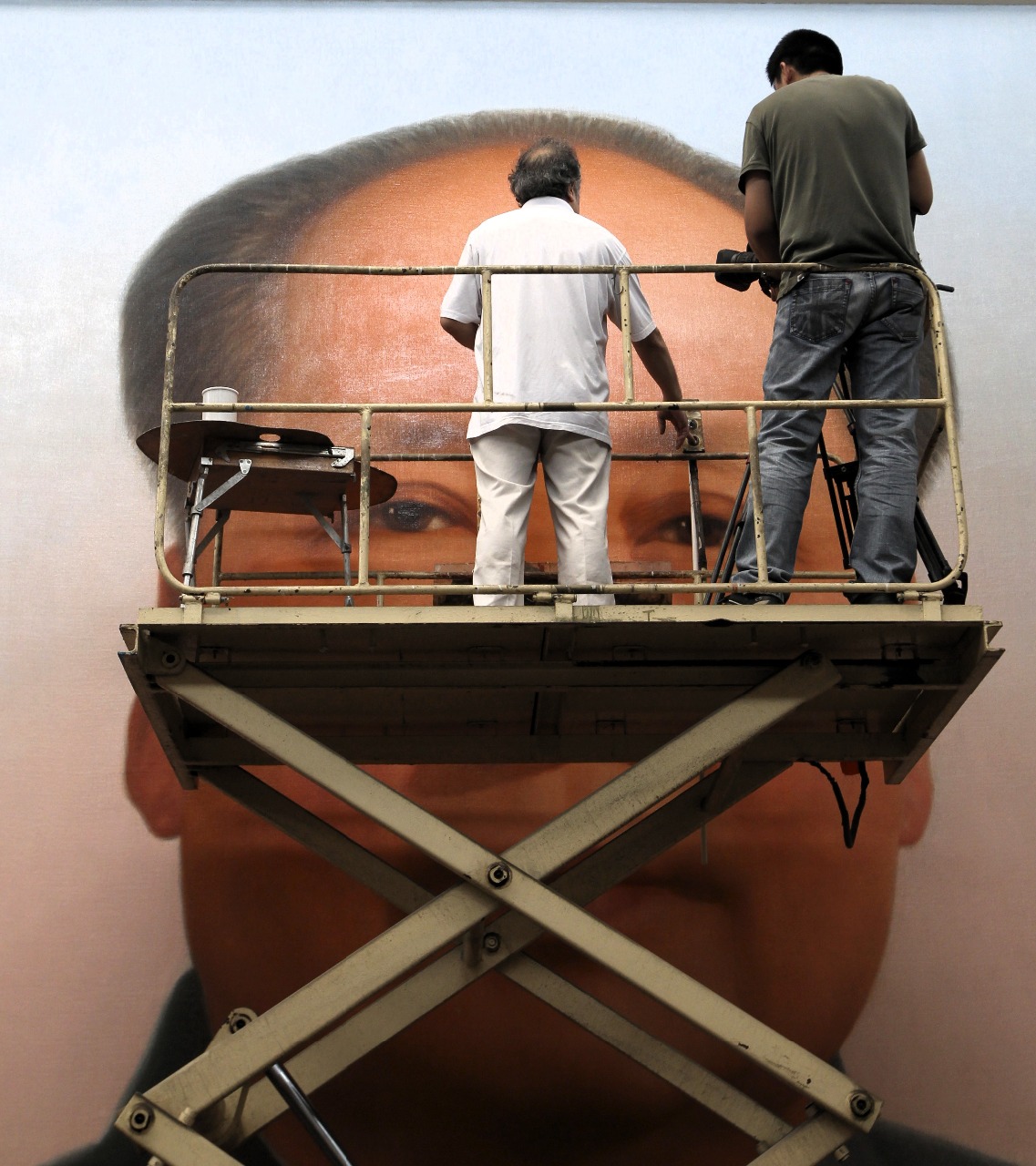
Other artists have been Zhou Lingzhao who created the first portrait in 1949. Xi Mang made a new one in 1950. Zhang Zhenshi was responsible for the versions between 1951 and 1963, followed by Wang Guodong from 1963 to 1976 and finally Ge Xiaoguang.
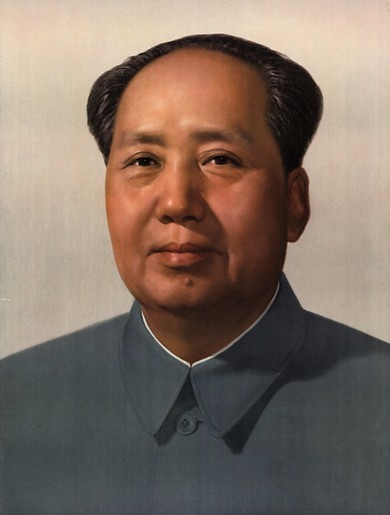
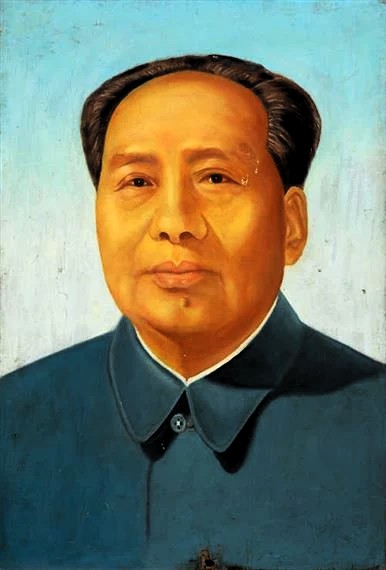
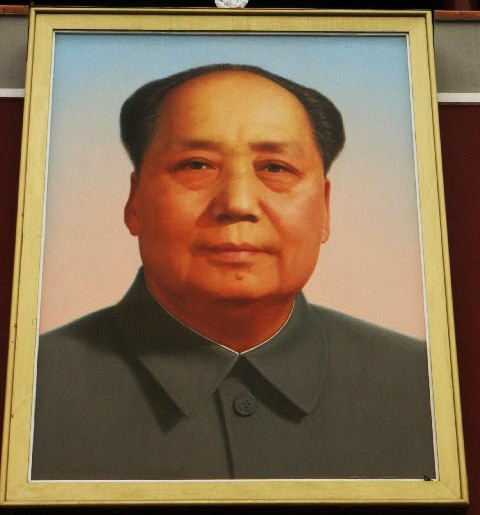
The model for Zhang Zhenshi's portrait, which seems to have been the best, was offered for sale in Berlin in 2006 by the Beijing Huachen Auction Company, which is owned by the Beijing Tourist Board and Centre for Cultural Heritage and Restoration. The estimate was USD 120,000, but the sale was stopped at the last minute by the government of the People's Republic of China and it is now in the National Museum of China.
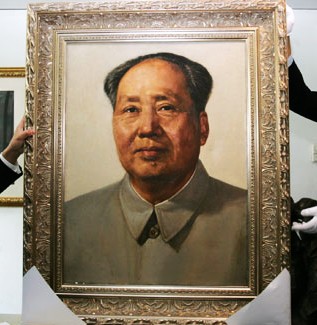
Zhang Zhenshi's portrait was based on a photograph taken by Hou Bo (1924–2017). She and her husband Xu Xiaobing were Mao's "court photographers" for several years and were allowed to make a number of photographs of the Great Helmsman and China's high potentates.
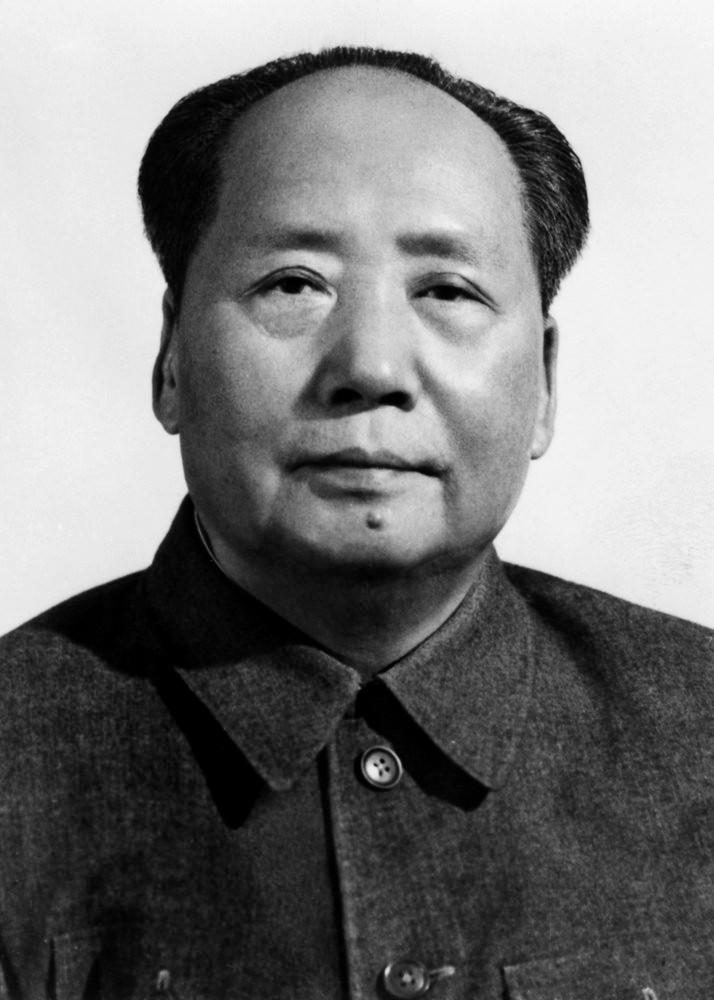
The couple stayed at Mao's summer residence in the Fragrant Hills National Park and socialized in Mao's closest circle. Several of Hou Bo's photographs were transformed into the typically meticulous super-realistic paintings that were distributed in millions of editions throughout China.
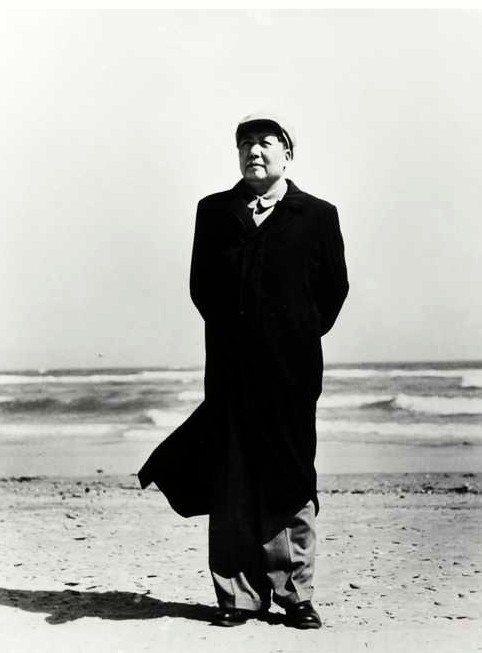
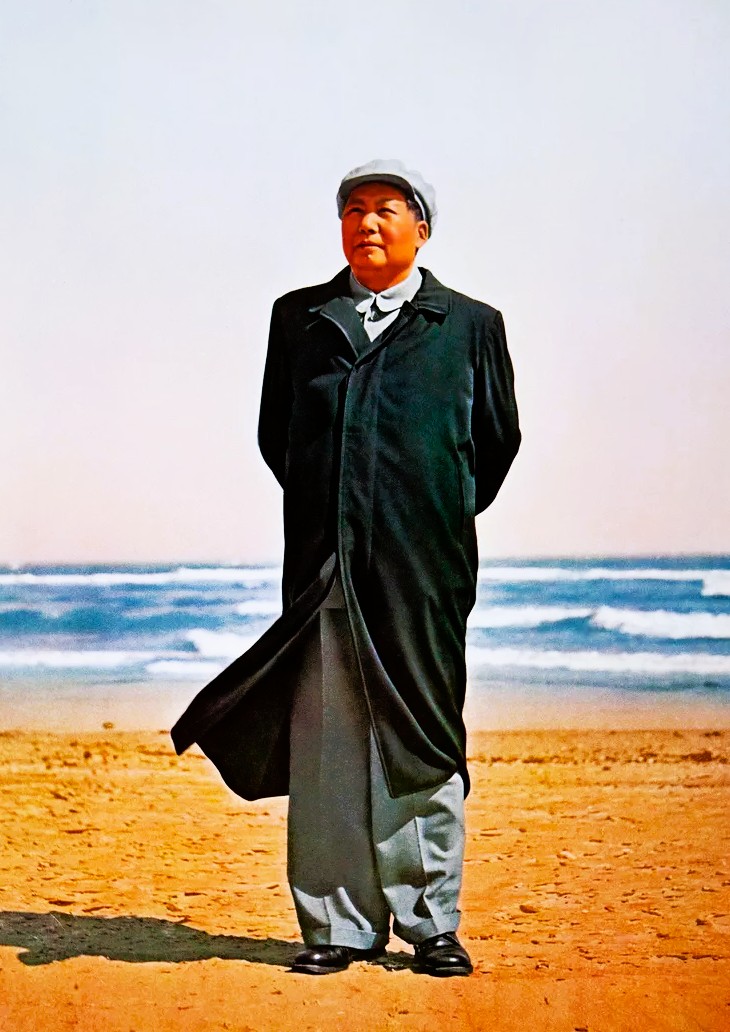
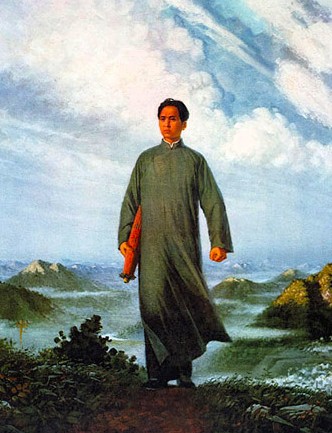
Hou Bo also took photographs at official events, and her documentation of the proclamation of the founding of the People's Republic of China has become classic.
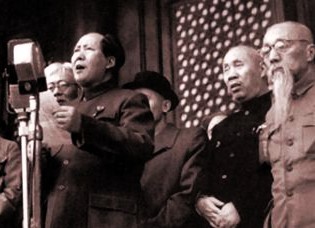
Before Chairman Mao's portrait adorned the gate of the Forbidden City, it had likewise exhibited other large portraits. First of Sun Yat-sen, who from the gate had proclaimed the Chinese Republic in 1911, and when Chiang Kai-shek after Sun Yat-sen in 1928 became president of the State Council, China's government, his portrait ended up above the gate entrance. After Chiang Kai-shek's flight to Taiwan, Mao's face has been the permanent ornament since 1949.
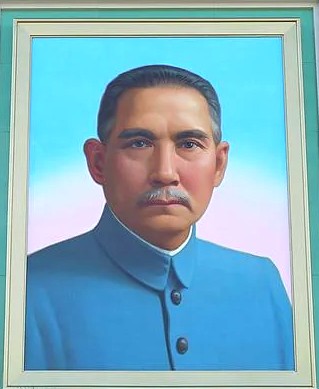
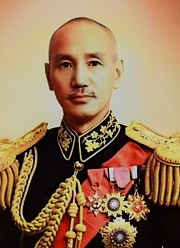
Tiananmen Square – in Chinese Tiān'ānmén Guǎngchǎng, The Square by the Gate of Heavenly Peace – became the absolute focal point of the cult of Mao during the Cultural Revolution (1966-1976) and culminated when the Great Leader's millions of fanatical youth gathered at mass meetings, waving Mao's Little Red and chanting slogans in honor of the great man. On one such occasion my friend Sagrada from the Dominican Republic was present and she has told me how Mao, far up there in the gallery above his portrait, took one of those close to him by the hand and how this handshake went from one to the other throughout the square. A transmission of divine power not unlike the idea behind the "apostolic cession" of the Christian Church.

Mao's image was revered as if it was a sacred icon. The creator of one of the giant portraits that adorn the gates of the Forbidden City, Zhang Zhenshi, has told in an interview how he got into trouble during the Cultural Revolution after a “student cadre” accused him of distorting his portraits of the Great Helmsman by having in his representations diminished the venerable countenance of the Leader, as he had represented him in such a way that only one ear was visible. This has been remedied on later colossal portraits, but not on the yuan banknotes adorned with Mao's face.
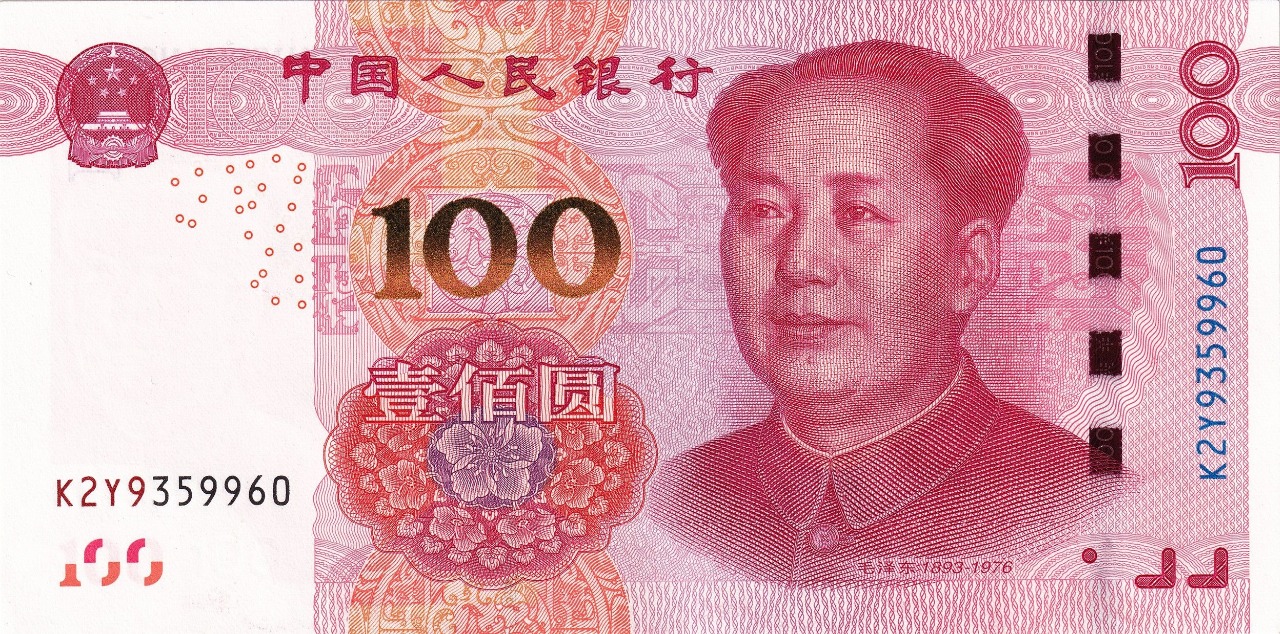
During my youth, even in the remote Lund, there were those who dressed in Mao overalls and proudly wore a small button icon bearing a picture of Chairman Mao, just as American politicians now have to carry a flag pin.
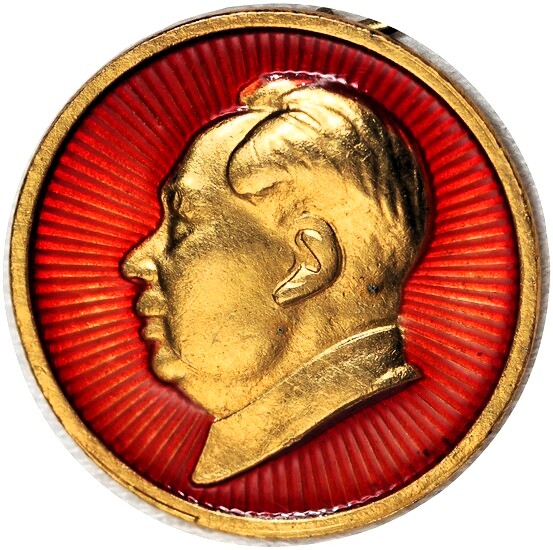

During the numerous demonstrations of that time, it was also common to carry placards with Chairman Mao's face. Often in the appearance of Zhang Zhenshi's legendary portraits
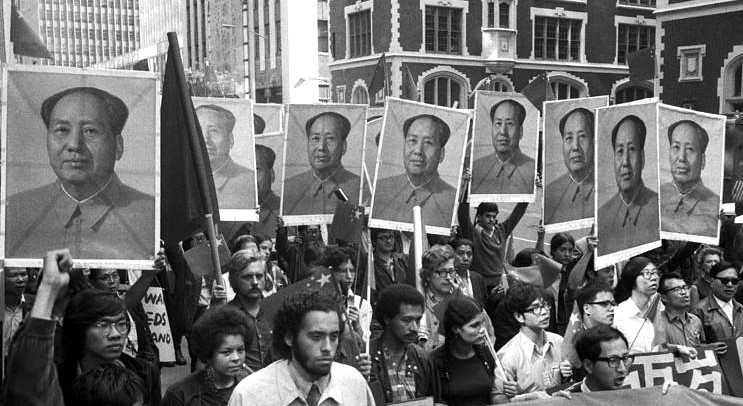
The controversial and anarchist Swedish artist Lars Hillersberg made in the ruthless magazine Puss fun of this personality cult and presented an illustration where a crowd carry portrait of unknown citizens.
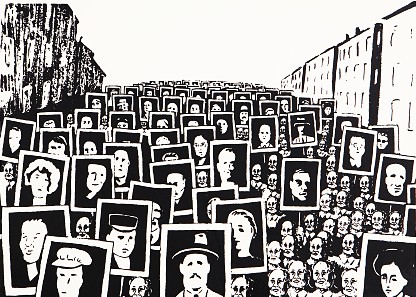
Tiananmen Square also became the scene of an iconic performance by an unknown person who has remained famous. Between April 15 and June 4, 1989, extensive student demonstrations were held in the square and its surroundings. The participants demonstrated against corruption within the ruling Communist Party and demanded greater democratic and human rights. The protests were finally put down with ruthless violence. According to official sources, a few hundred people were killed, but unofficial figures point to up to 3000 casualties.
On June 5, after “securing” the square, the military began to regain control of the city's thoroughfares. A column of tanks from the 1st Armoured Division left the square, but in the easterly direction, on the Chang'an Avenue, the advance was prevented by a lone protester who had placed himself in the middle of the street. The brief stalemate between the man and the tanks was captured by Western journalists, who witnessed it from the roof terrace of the Beijing Hôtel. Who the Tank Man was and what happened to him has remained unknown, but Time magazine named him one of the last century's 100 Most Influential People and the unknown man has become a symbol of personal courage in the face of oppressive regimes. In other words – an icon of freedom.


From the archives: Tiananmen Square's "Tank Man"
But... What exactly is an icon? The Greek word simply means “image”, or ”likeness”, but the word early came to denote images of venerable, influential people, or representations that honoured deceased loved ones, such as the famous mummy portraits from the Faiyum Oasis, which in Antiquity housed a large Greek-speaking population, in addition to the native Egyptians.
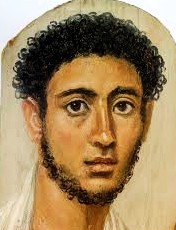
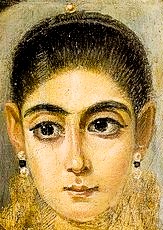
While talking about icon painting, it has primarily come to denote an art form that finds its roots in Christian paintings of the fourth century, especially those in the catacombs of Rome.
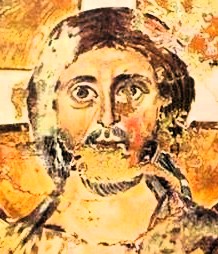
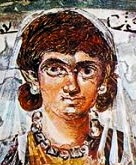
From an early age, however, there was fierce Christian opposition to depictions. The early Christian church was closely linked to Judaism and its commandments and ordinances were generally followed, not least the prohibition in Exodus (20:4-5):
You shall not make for yourself an image in the form of anything in heaven above or on the earth beneath or in the waters below. You shall not bow down to them or worship them; for I, the Lord your God, am a jealous God, punishing the children for the sin of the parents to the third and fourth generation of those who hate me.
Thus, one could not make angels, humans, or animals objects of worship, such acts could only be addressed to God. Nor were attempts to depict, or even imagining, the figure of God acceptable, because his appearance was far beyond human form and imagination.
However, the ancient world where Christianity was taking root and came to thrive was a world where visual art was everywhere. Within such an overwhelming and refined visual environment, a ban on images could not be maintained for any length of time. Soon icons, i.e. images, became abundant even within the Christian cult.
Below is the first known representation of Christ Pantokrator, Christ the Almighty, i.e. Jesus as the incarnate Deity. The icon dates from the 500s and is preserved in the legendary St. Catherine's Monastery at the foot of Mount Sinai. The picture is one of the monastery's more than 2000 icons, created from the 500s and into modern times.
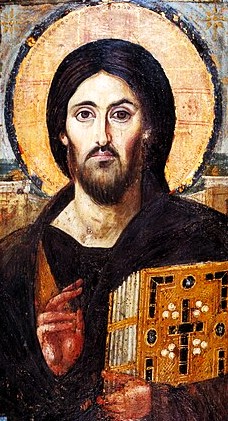
Within the Christian church, the idea that one could depict Christ, God and the saints has gradually prevailed and become dominant. The argument was that all these figures divine characters were enclosed by human bodies. Had not God created man in His image? And God had through Jesus Christ become man, with a body that could be perceived with the human senses, thus could also the bodily manifestations of God and Jesus be depicted. Furthermore, the Old Testament’s prohibition had been applied before God through Jesus had revealed himself in a bodily form.
The tricky question of pictorial representation had been worn and soaked by Christian potentates during the Second Council of Nicaea, 787. This Council took place while the “Byzantine iconoclasm” was raging in full swing. Fanatics smashed ancient and Christian sculptures alike, while frescoes were painted over and icons burned, and artists were beaten.
![]()
![]()
The Council decided that icons and other images of the divine certainly had a significant function in the Christian cult. For believers who could not read they had an educational function, since visual arts created an understanding of the Christian doctrine of salvation and the meaning of the biblical stories.
The contemplation of images could also fill the viewer with a sense of meditative devotion created through their inherent prokinesis, i.e. images were considered as gestures/signs of respect for the divine and thus they could produce a profound receptivity to the Christian message, they even convey messages that could not be expressed in words. However, the fact that images are depictions and thus based on relationships, but they possess only “relative qualities”. They are not divine in themselves. Images lack latreia “absolute qualities,” i.e. the same nature as the divine. Thus, icons could absolutely not be objects of any worship. This was an abomination – idolatry. The difference between an icon and an idol is that the icon only alludes to the presence of the divine, while an idol is a deity in itself.
The best equivalent of the Christian concept of idol is probably the murti of Hinduism, in the sense that an image itself can include a divine “soul”, a murta. The image thus constitutes an “embodiment” of a spiritual dimension/concept, the basic meaning of the word murti.
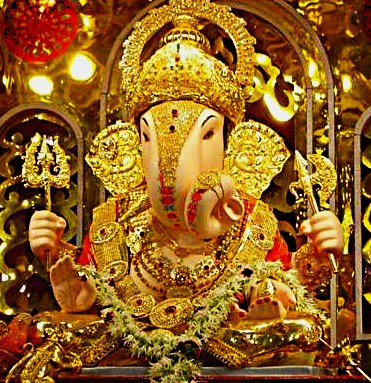
Hatred of Christian art did not subside with the Second Nicene Meeting. Image-storming fanatics continued to appear from time to time and in various contexts. When the religious wars between Catholics and Protestants paralyzed Europe in the fifteenth century, a Protestant mob could occasionally in violent rage attack church art, maim sculptures and destroy paintings.
![]()
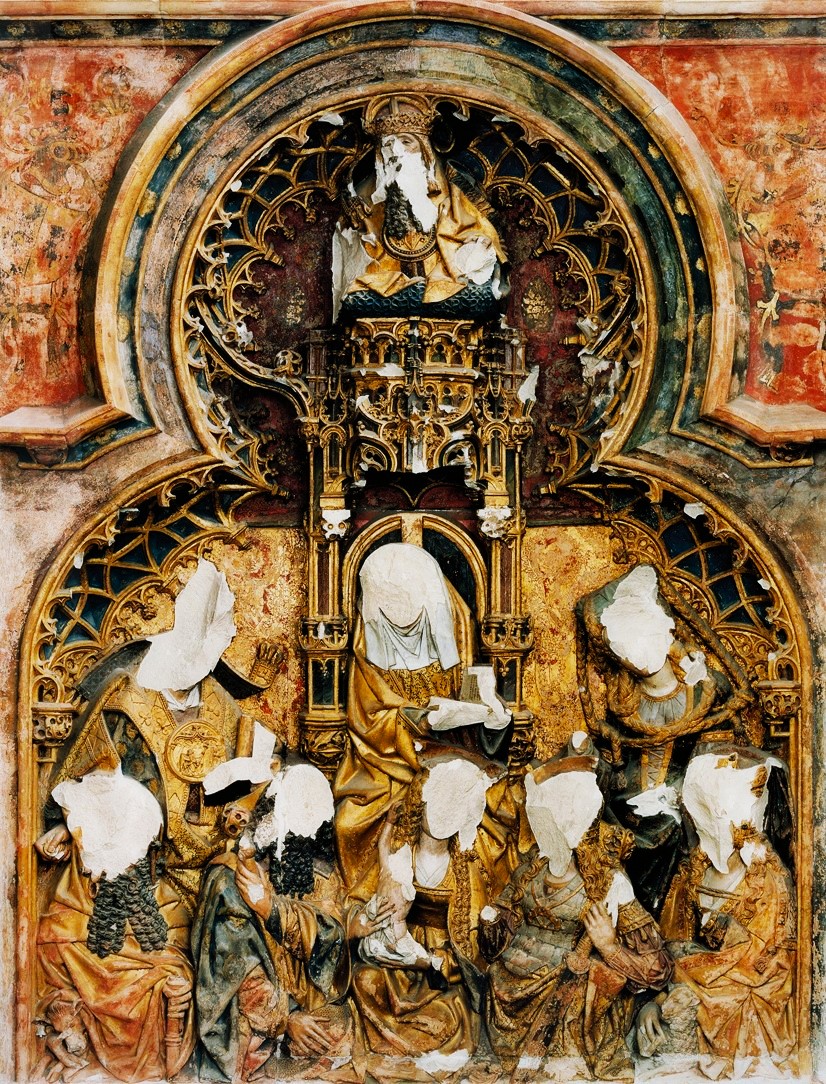
Under other conditions, French revolutionaries in the late eighteenth century destroyed not only the statues and symbols of the monarchy, but also raged against ecclesiastical power and destroyed Christian art. Churches were burned down and sculptures hacked to pieces.
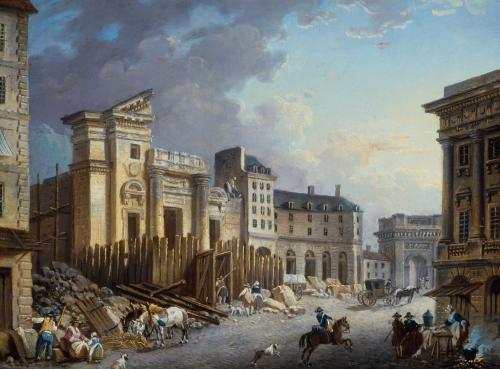
Revolutionaries have sometimes harboured an implacable hatred towards Church power. During civil wars in Mexico and Spain, where conservative forces within the Church often joined the Central Power, several priests and monks were executed by revolutionaries, while churches were looted. Below, a priest is being executed in México, while mummified nuns from a Carmelite monastery are being exposed in Barcelona in 1936.
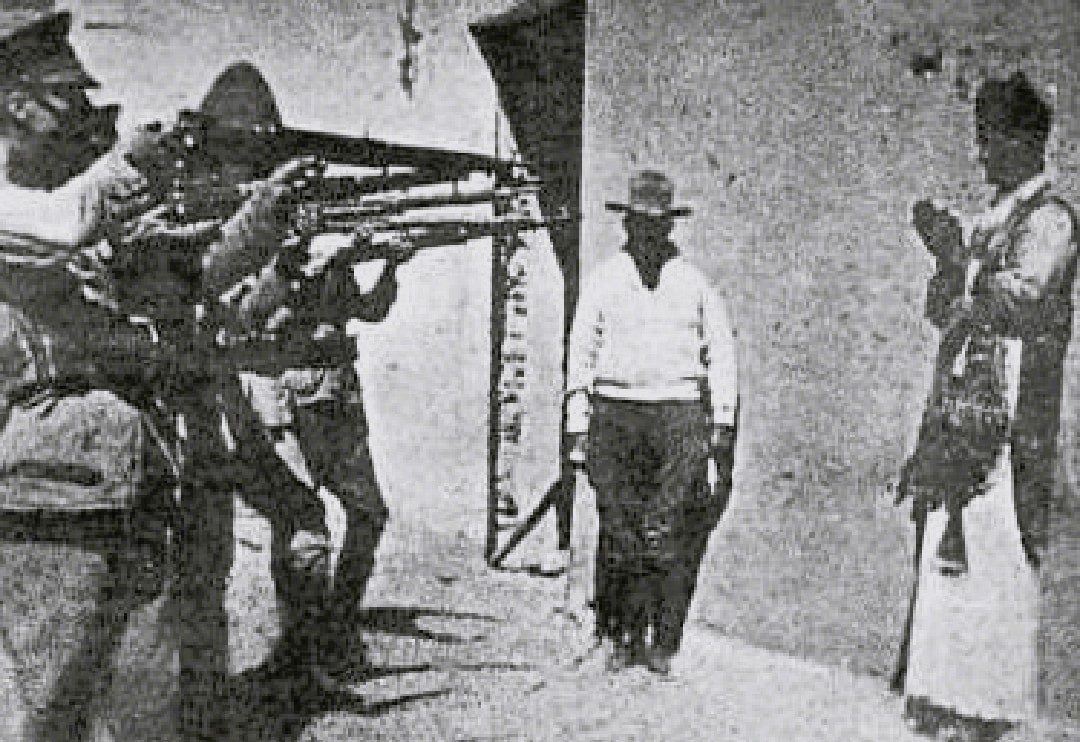
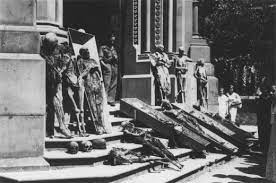
Seldom, however, has the persecution of religion and destruction of its art treasures reached such dimensions as it did in the Soviet Union in the twenties and thirties, where contempt for religion was openly sanctioned by the state power.
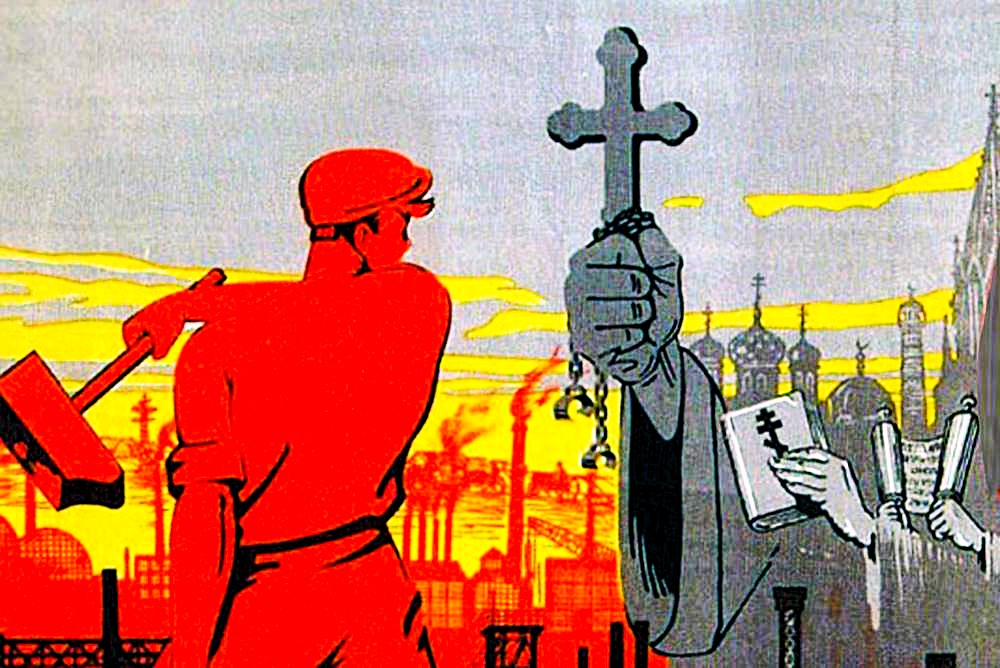
Churches and icons were destroyed. Most notable was the explosion of Moscow's cathedral, Christ the Savior, which was demolished on Stalin's orders on December 5, 1931.
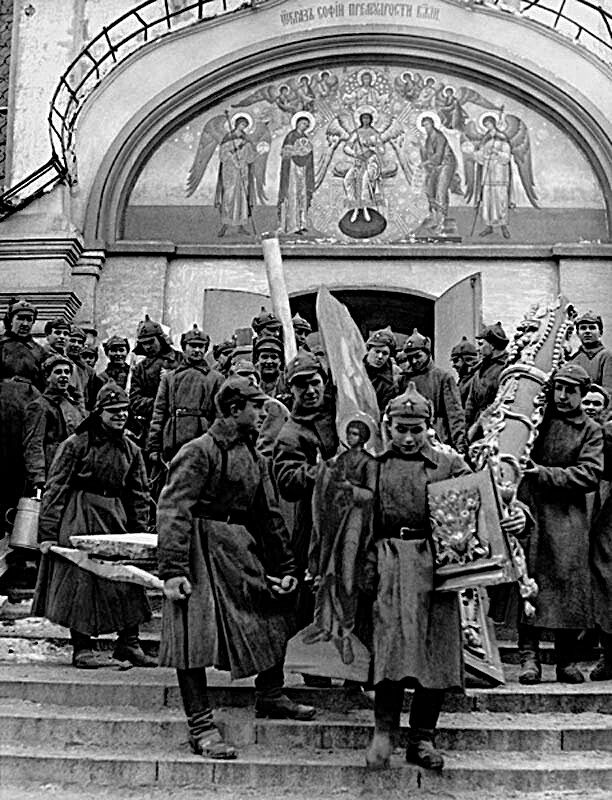
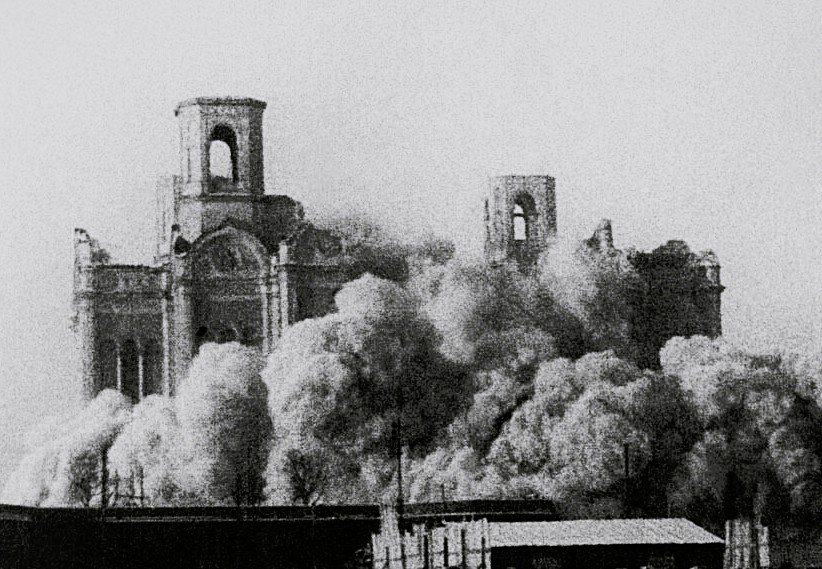
The intention was that the cathedral would be replaced by a huge Palace of the Soviets, crowned by a monumental statue depicting Lenin, as usual with an outstretched right hand.
However, the Second World War put an end to the large-scale project and the site of the destroyed cathedral did instead become the world's largest swimming pool.

After the fall of communism, the Cathedral of Christ the Savior was rebuilt and resurrected in 2000, in all its magnificent grandeur.
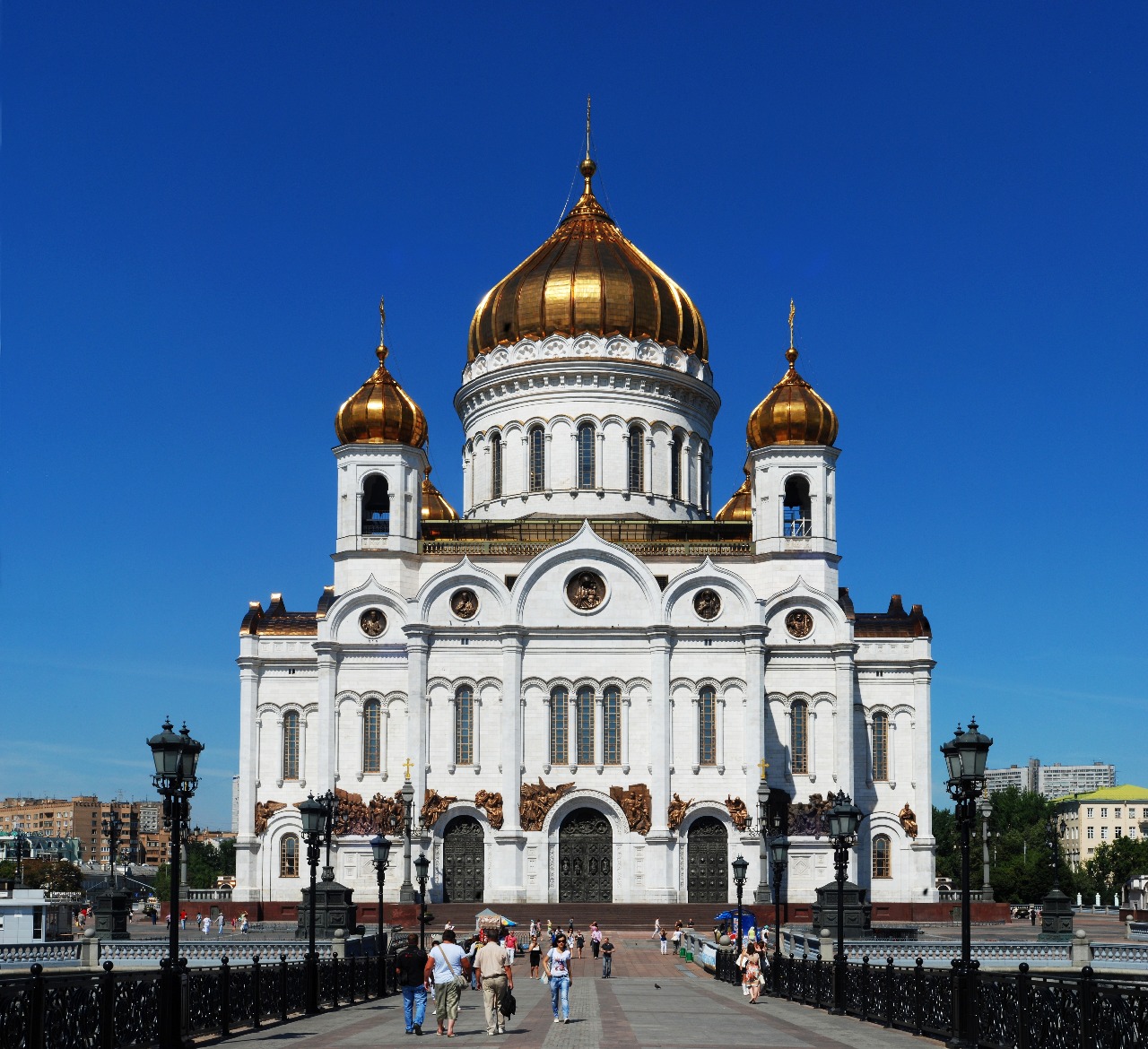
However, the destruction of religious buildings, works of art and other symbols in countries such as the Soviet Union and China did not mean the end of the erection of monumental works of art, although these no longer paid homage to saints and other deceased sacred or extraterrestrial religious entities. The centre of worship instead became earthly saintly figures, living and dead. Stalin filled the Soviet Union with pictures and sculptures of himself and the Lenin he officially adored.
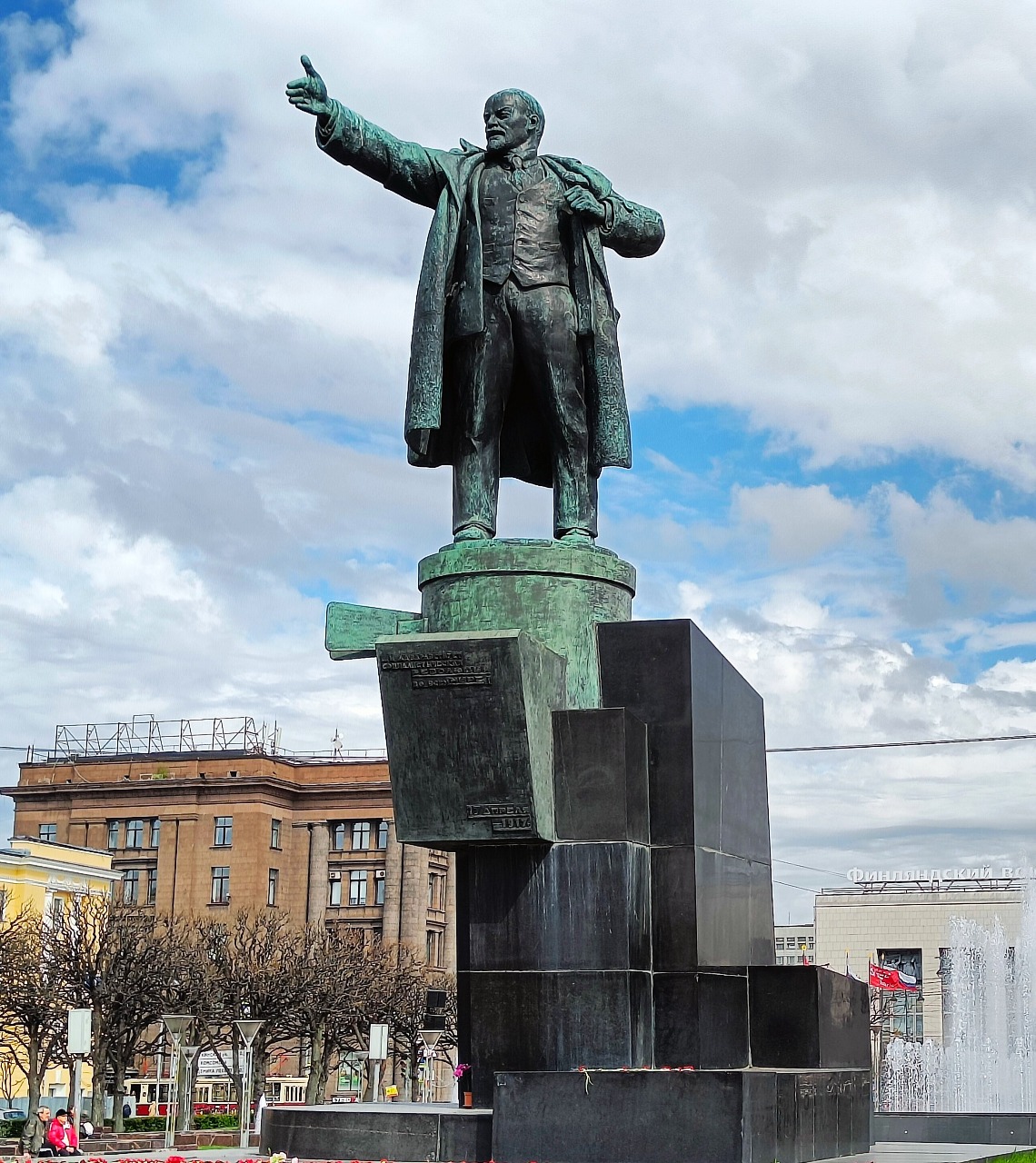
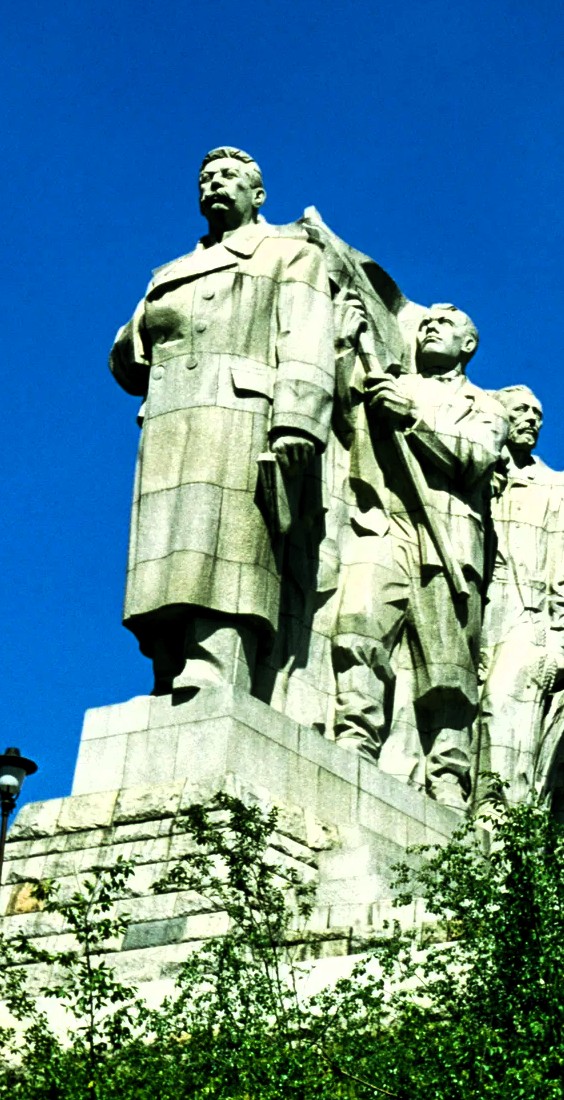
While Lenin was generally depicted with his right arm raised in a gesture aiming at a glorious future, Stalin statues mostly depicted the Leader with his right arm lowered, or with his hand, in a Napoleonic manner, tucked under his coat lining.
This was probably because Stalin had a complex for his crooked right arm. He was seriously injured at the age of twelve when his arm was squeezed under a horse-drawn carriage. An extensive operation had caused the arm to become shorter and stiff at the elbow.
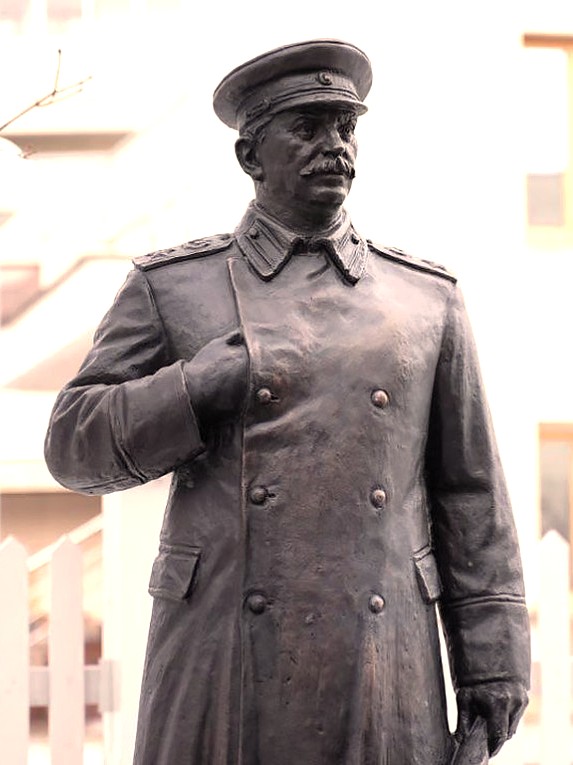
The Lenin statues, however, persisted with their outstretched right arm. Something he exiled Russian artists Komar and Melamid amused themselves with when they depicted Lenin visiting New York for a The New Yorker cover, showing how the Soviet leader hails a taxi in front of a McDonald's restaurant.

The grotesque idolization of leaders such as Lenin, Stalin and Mao has not prevented their successors from imitating such deification in their lifetimes, allowing themselves to be portrayed through icons and sculptures.
Like Kazakhstan's dictator Nursultan Nazarbayev, who after being vigorously supported by Putin was forced to resign in 2022:
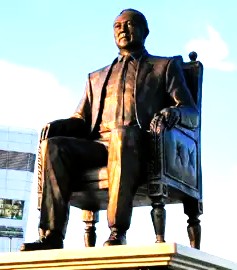
However, his successor Kassym-Jomart Tokayev has already been honoured with a statue in neighbouring Kyrgyzstan, where he sits talking with its president Sadyr Japarov, who took office in 2021.
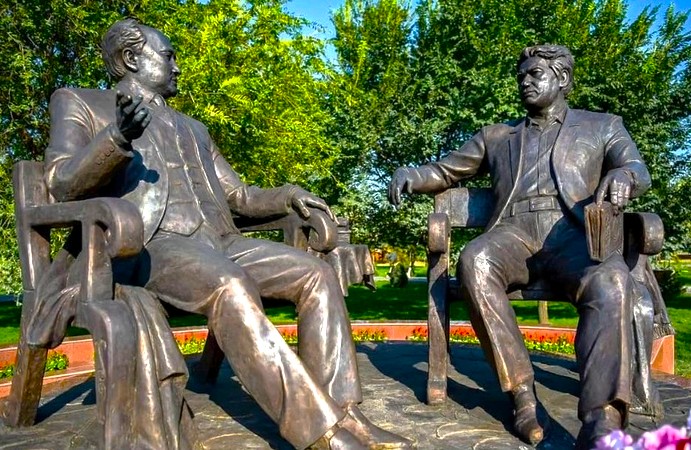
Sadyr Japarov has already found an opportunity to erect a statue of his friend and master Vladimir Putin:
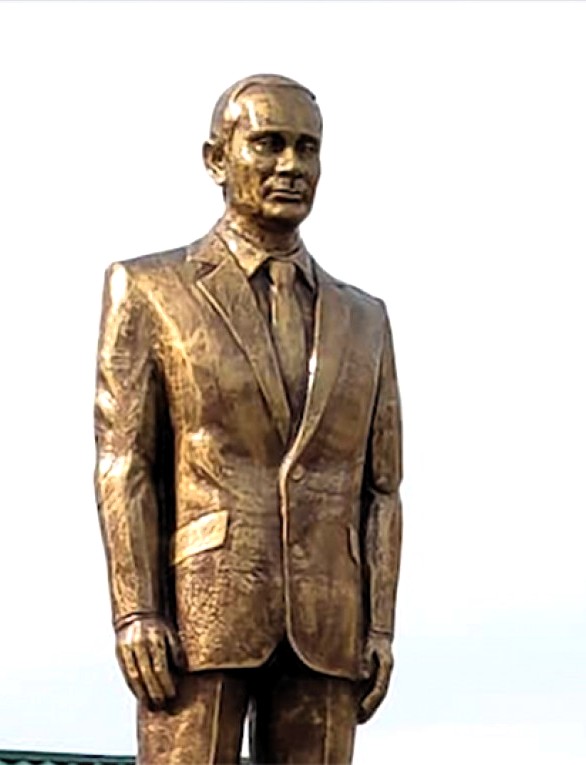
In Kyrgyzstan and Kazakhstan, the idols sit in chairs, but in Turkmenistan Gurbanguly Berdymukhamedov is a bit sharper and has allowed himself to be depicted on horseback, covered in gold and placed on a high, shining white and artificial mountain.
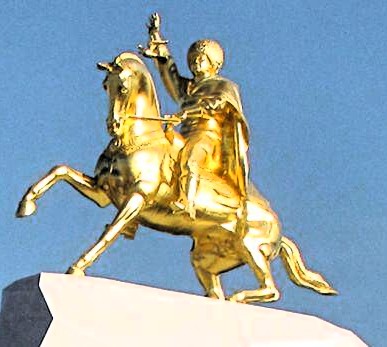
This sculpture is even larger than the statue of Berdymukhamedov's predecessor, Turkmenbashi. His statue is also was gold-plated and placed high up on a solid pillar.
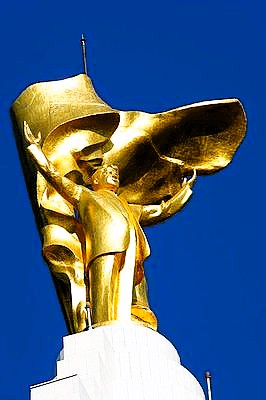
I do not know if North Korea's current dictator Kim Jong-un has yet had a statue erected in honour of himself, but the country has countless statues of his grandfather Kim Il-sung (by whom we recognize Lenin's gesture) and Kim Jong-un’s father Kim Jong-il. The largest statues are more than twenty meters high and surrounded by grotesque rites.
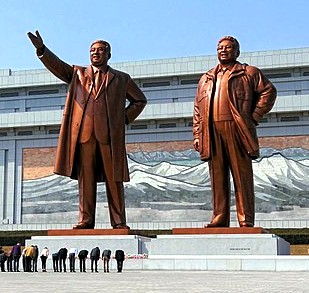
I wonder what it is that drives these grotesque dictators to erect sculptures of themselves and force their subjects into a bizarre worship of their inflated egos.
A ridiculously self-absorbed, self-enriching and unusually bloodthirsty dictator was Rafael Leonidas Trujillo, who in the Dominican Republic had the capital and the country's highest mountain named after himself and during his own lifetime filled the country with his busts and statues. Every Dominican home was required to have a plaque stating that Trujillo was its protector and master.
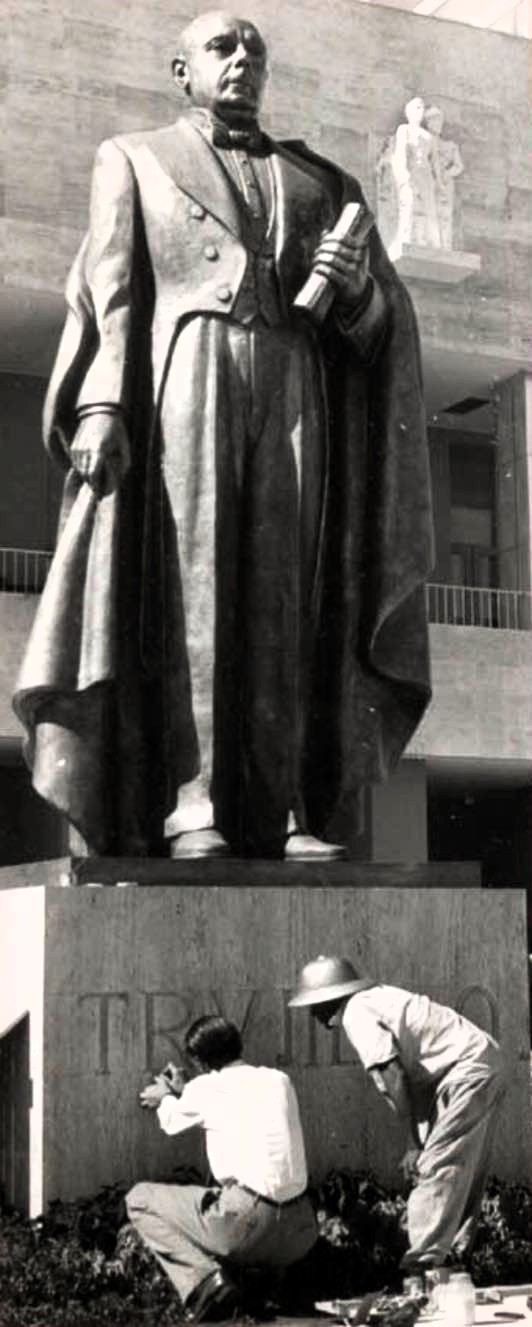
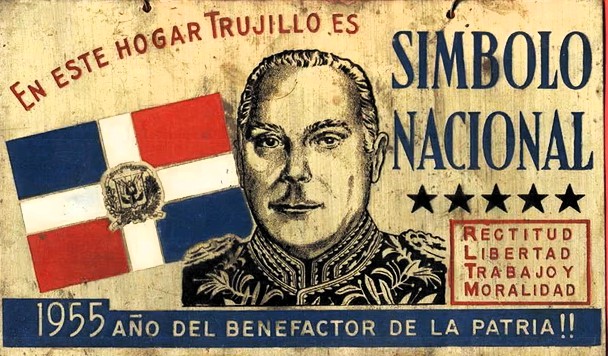
Is this ever-present dictatorial madness a way of convincing citizens that they are constantly watched, constantly controlled, like the all-seeing Big Brother in Orwell's eerie 1984?

Something that is not really an illusion since several of these dictators have had and still have an effective secret police, prepared to be of service to them with murder, torture and other forms of terror.
Hitler was supported by his murderous and powerful Gestapo, Stalin by the KGB and the large number of smaller autocrats have also had/have their murderous henchmen. China has its Ministry of State Security, Kazakhstan KNB, Turkmenistan MNB, Saudi Arabia Mabahith, Venezuela SEBIN, Sudan NISS, Russia FSB, just to name a few of the most well-known and ruthless secret organizations. In Iran we find VAJA, which under various names replaced the Shah's SAVAK. The Iranian Shah Mohammad Reza Pahlavi was also a strange autocrat who loved to steer himself out in borrowed feathers and pose for iconographic portraits, such as one by the famous Italian master Pietro Annigoni.
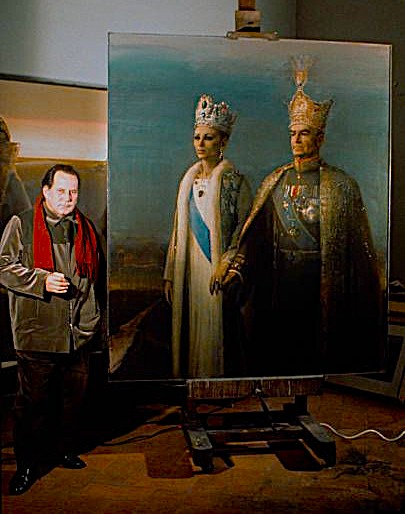
Perhaps it is just a matter of making an impression on the world and guaranteeing one's legacy. Through an image, an icon, they try to transform themselves into idols. They want to transmute themselves as if they were a divine presence—saints deserving worship of their subjects. A saint is more than an image; it is an ideal. Take Mother Teresa, who in many people's minds has become identical with selfless self-sacrifice, a symbol of goodness. Is she worthy of all this worship?
In a certain sense – Yes. Her Orden is now active in 610 locations in 123 countries, with nursing homes and hospices for people with HIV/AIDS, leprosy and tuberculosis. Her nuns provide family counselling, run orphanages and schools. The small, wrinkle-faced lady with her friendly smile became identical with a self-sacrificing, fervently Christian kindness.
But the little woman sank in my esteem when, during my time in the Dominican Republic, I saw her embrace the Haitian dictator Baby Doc and his wife, millionaire Michèle Bennett Pasquet, this in America's poorest country, where people lived in fear under the Duvalier regime's dreaded secret police, the notorious Tonton Macoutes.
Mother Teresa paid tribute to the nasty governing couple for their generous contributions to her activities and paid tribute to the beautiful witch Michèle with the words:
I have met many people; kings, presidents and prime ministers, but I have never seen poor people so familiar with their heads of state as they were with her. That was a beautiful lesson for me.
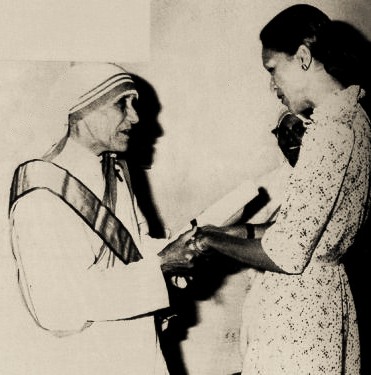
Urghh! It made me feel sick. Did not the saintly Teresa know with whom she had spent time with and now praised so fervently? Then I learned that Mother Teresa had happily and gratefully accepted money from and paid tribute to millionaires such as Charles Keating and Robert Maxwell.
As Emperor Vespasian stated, “Money does not smell.” During the 1980s, when I on television saw Mother Teresa visiting Haiti, Charles Keating was president of the American Continental Corporation and the Lincoln Savings and Loan Association. When Lincoln Savings went bankrupt in 1989, it cost the US federal government over $3 billion and about 23,000 customers were left with worthless bonds. In the early 1990s, Keating was convicted in both federal and state courts of fraud, extortion, and conspiracy.

And Robert Maxwell? A super-rich media mogul who embezzled hundreds of millions of pounds from his own companies' pension funds while living in luxury on his estate outside Oxford, if he wasn't out at sea on his luxury yacht, Lady Ghislaine, named after his notorious daughter; socialite and convicted sex trafficker

Unfortunately, the accounts of Mother Teresa’s Missionaries of Charity are unavailable. For example, although Indian law requires charities to publish their accounts, Mother Teresa's organization ignores this provision. It is not known whether the Delhi Finance Ministry, which would be responsible for the charities' accounts, keeps the actual figures since when asked the answer continues to be that the data is "classified".
The only country where the finances might be scrutinized has been Great Britain, where it has been estimated that only seven percent has gone to Madre Teresa's activities, apparently most of received funding rests in an unaccounted account at the Vatican.
Mother Teresa had strict views against abortion, which she considered to be a crime on par with the Nazis' extermination of the Jews. She pointed to the spiritual benefits of a life of poverty, a view that seemed to harmonize with the lack of adequate medical care provided to the poor in the care of care of the Missionaries of Charity, despite the fact that of the organization’s large bank assets. Diagnosis was arbitrary, pain relief inadequate, and there were few trained doctors active within the Organization. On the other hand, great emphasis was placed on the fact that all those who were admitted for “care” ought to be baptized and all dying patients systematically received a Christian baptism, regardless of their religious beliefs. I don't know if the conditions have improved, but Mother Teresa is definitely not my kind of saint.
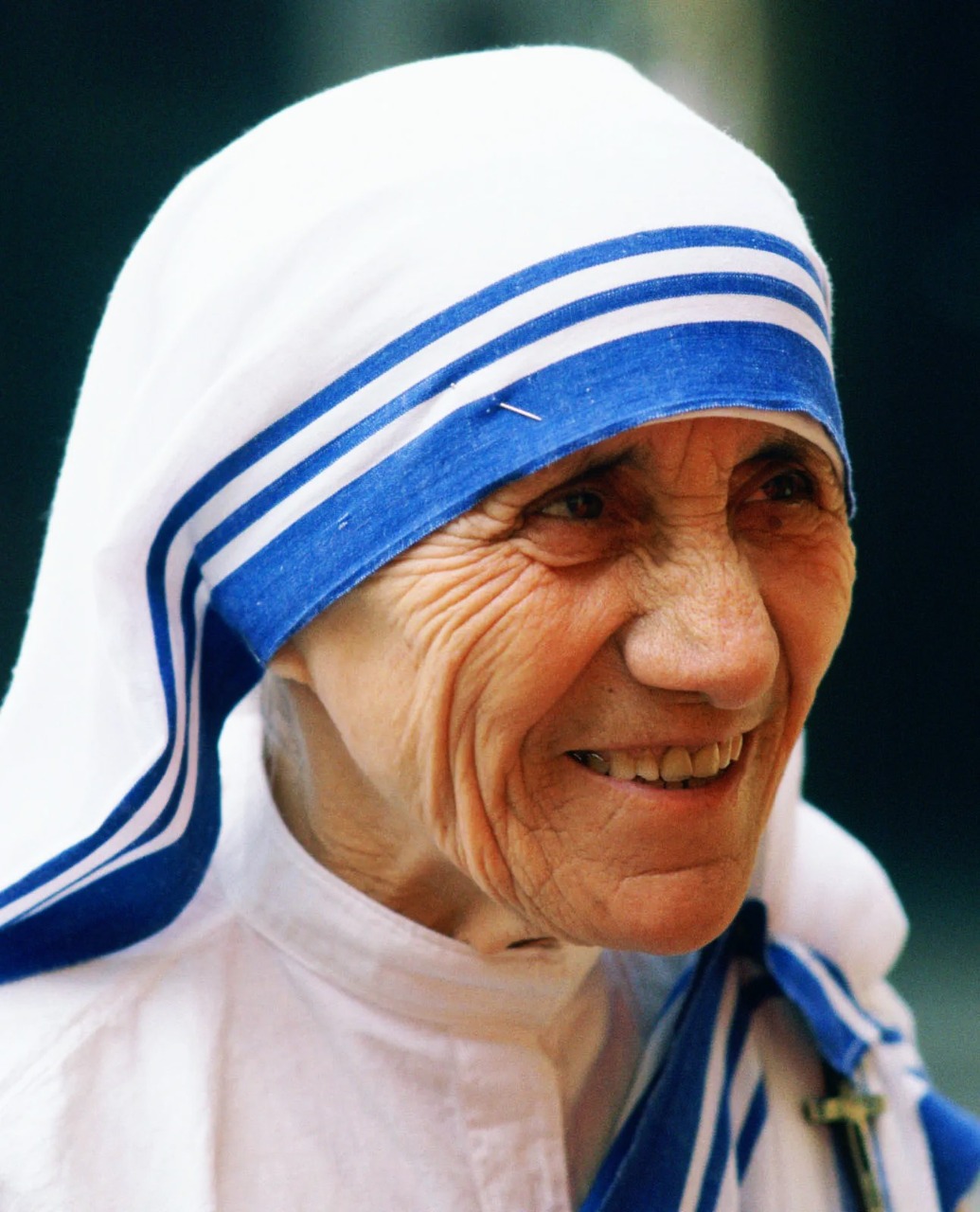
I am also not really clear about the sainthood of Padre Pio, so immensely popular in Italy, other than that he could demonstrate stigmata. Perhaps they came about by divine influence, but evil tongues stated that he single-handedly aided divine providence. Certainly, the fortune that was collected in Pietrelcina through all the alms led to the construction of one of Italy's best hospitals, although the basic funding came from Emanuele Brunato, who had raised his millions through black market deals in Nazi-occupied France and the United Nations Fund for Aid and Rehabilitation (UNRRA), which after World War II helped refugees and poor people all over war-torn Europe.
Padre Pio was perhaps OK; his sainthood is based on all the miracles that people say took place around him. His preaching was not particularly remarkable, but he lived a simple life and stated that:
Suffering is a special sign of God's love, for it makes you resemble His divine Son through the anguish He felt in the desert and on Calvary.
Here in Rome, people pray to Padre Pio to find a parking spot, and you can find his image everywhere – in bars, car repair shops and grocery stores.
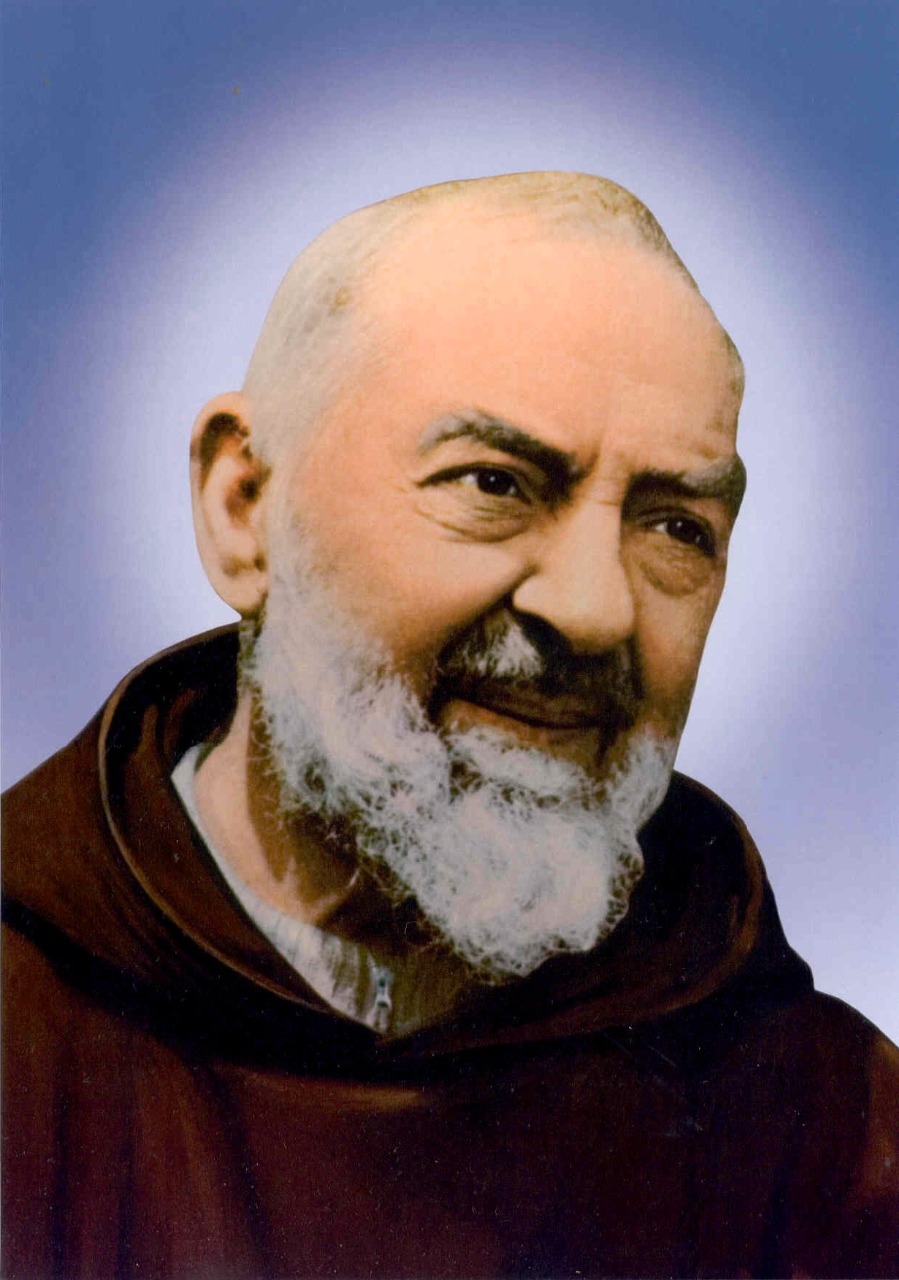
The portraits of famous men and women have become like Byzantine icons. They encapsulate a very special dimension, filled with allusions, hope and inspiration. Einstein stands for intelligence and general genius.
.jpg)
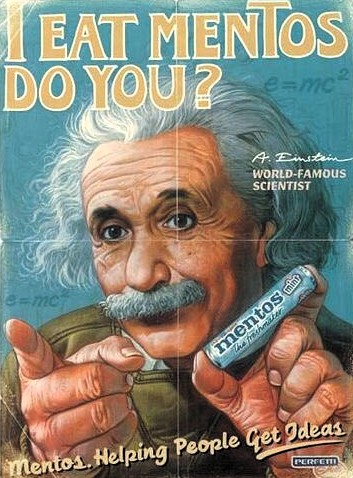
Sigmund Freud is also linked to genius, but if Einstein is the archetype of a scientific genius, the ideas around Freud also revolve around the subconscious instinct and above all – sex.
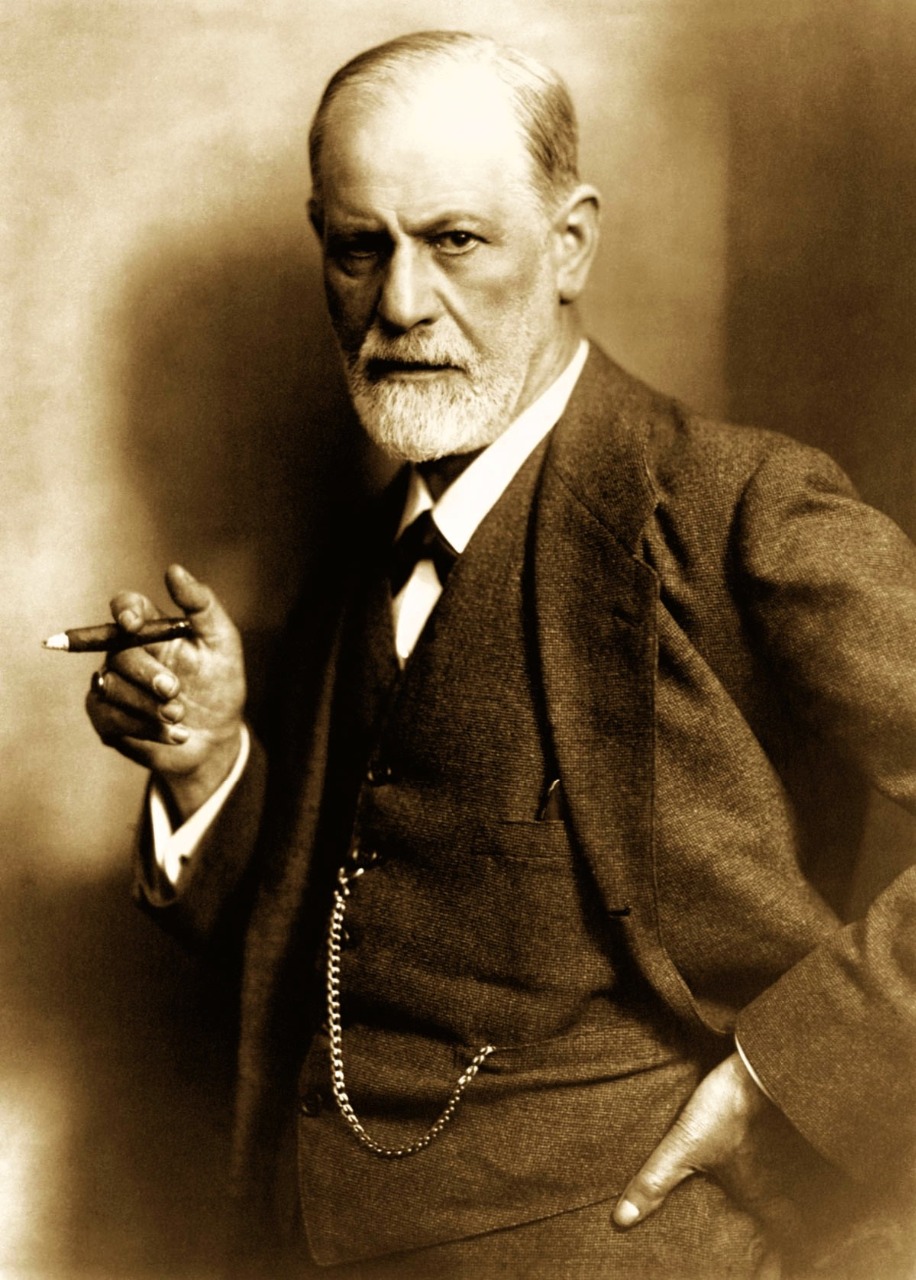
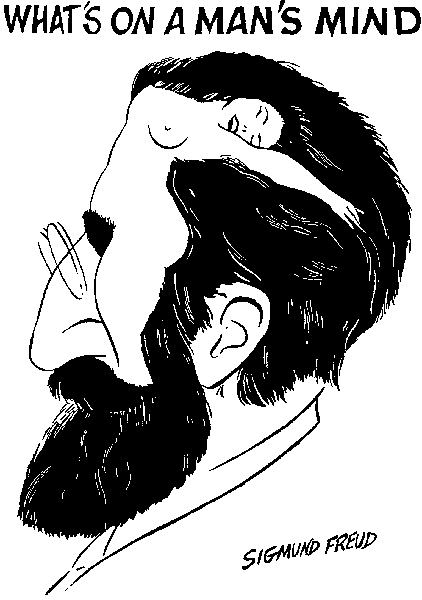
Chaplin's anarchic and poor vagabond has become the epitome of film and humour.


Karl Marx's face is linked to social criticism and revolution in its more intelligent version.
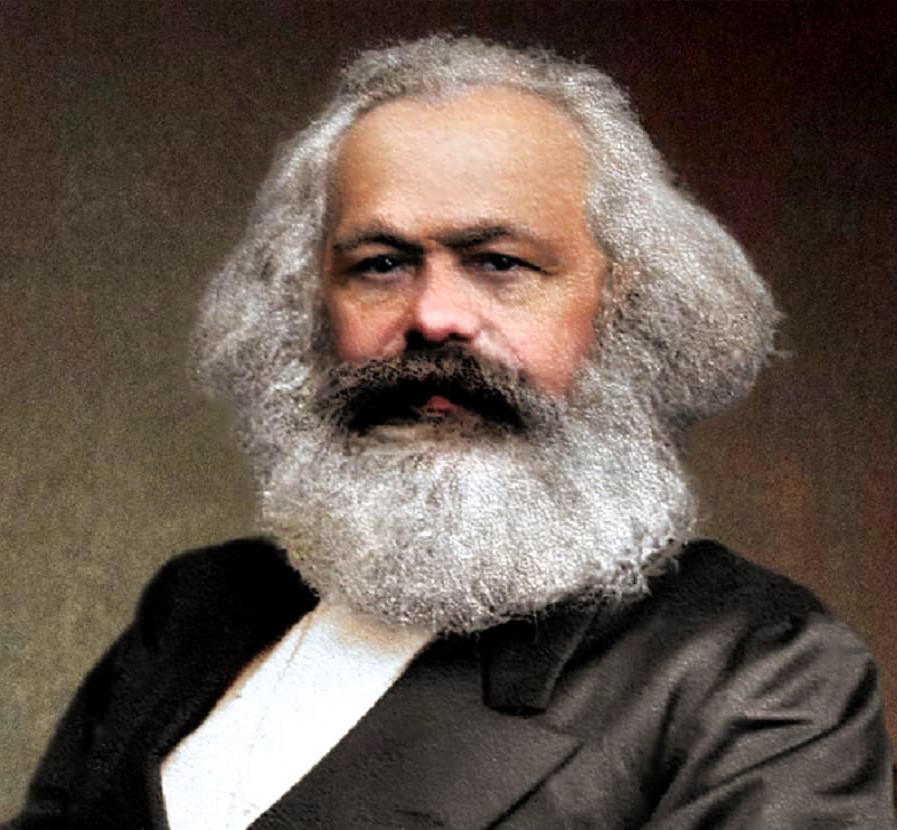
.jpg)
Che Guevara also became a revolutionary saint, though more than Marx he is the object of a youthful cult. Che was good-looking and in his portraits he radiates an inner glow. If Padre Pio's image adorns workshops and boutiques of Italian small business owners, Che Guevara's image is all over the world to be found in rooms and apartments of radical youth.

Like the painting of Mao which adorns the gate in Beijing, the Che poster finds its origin in a photograph. Alberto Korda selected it from a series of photographs he had taken on March 5, 1960, during a memorial ceremony for the victims of the La Coubre explosion. Korda has said that he chose the image because of Guevara's facial expression, which according to him reflected absolute intransigence, anger and pain.
La Coubre was a French ship loaded with 76 tons of Belgian ammunition. Against all rules, it had been moored at the quay in Havana (ships with dangerous cargo must be unloaded out at sea) and when it exploded, between 75 and 100 people were killed. Cuba blamed the United States for the attack.
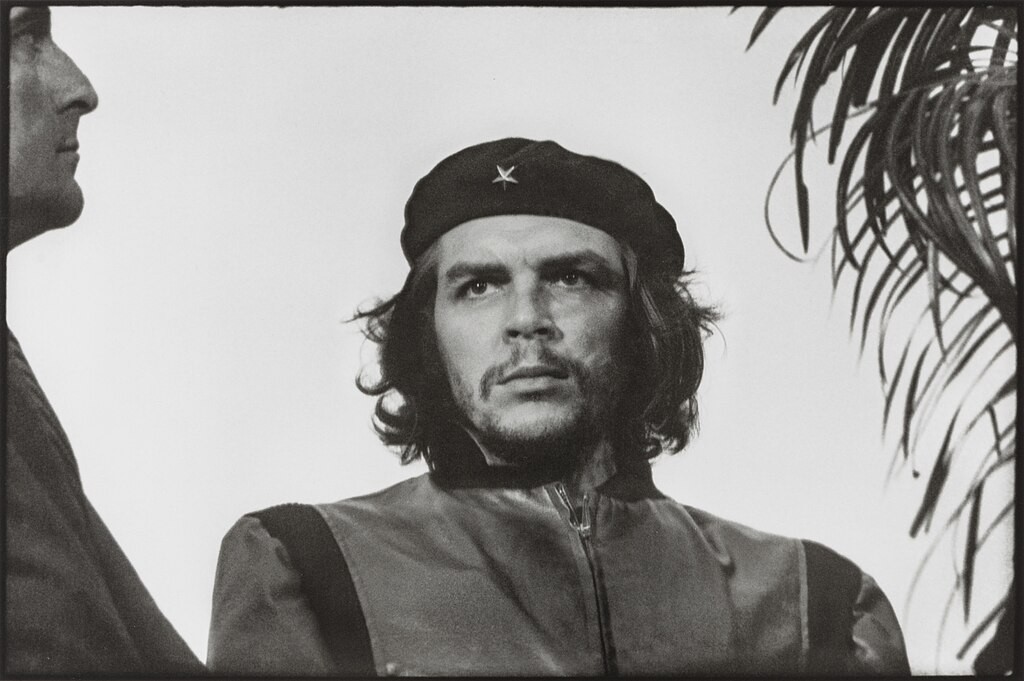
Handsome revolutionaries undeniably have an iconographic impact. Mexico's Emiliano Zapata became such a powerful symbol, even more handsome than Marlon Brando who enacted him in Elia Kazan's excellent 1952 film Viva Zapata .
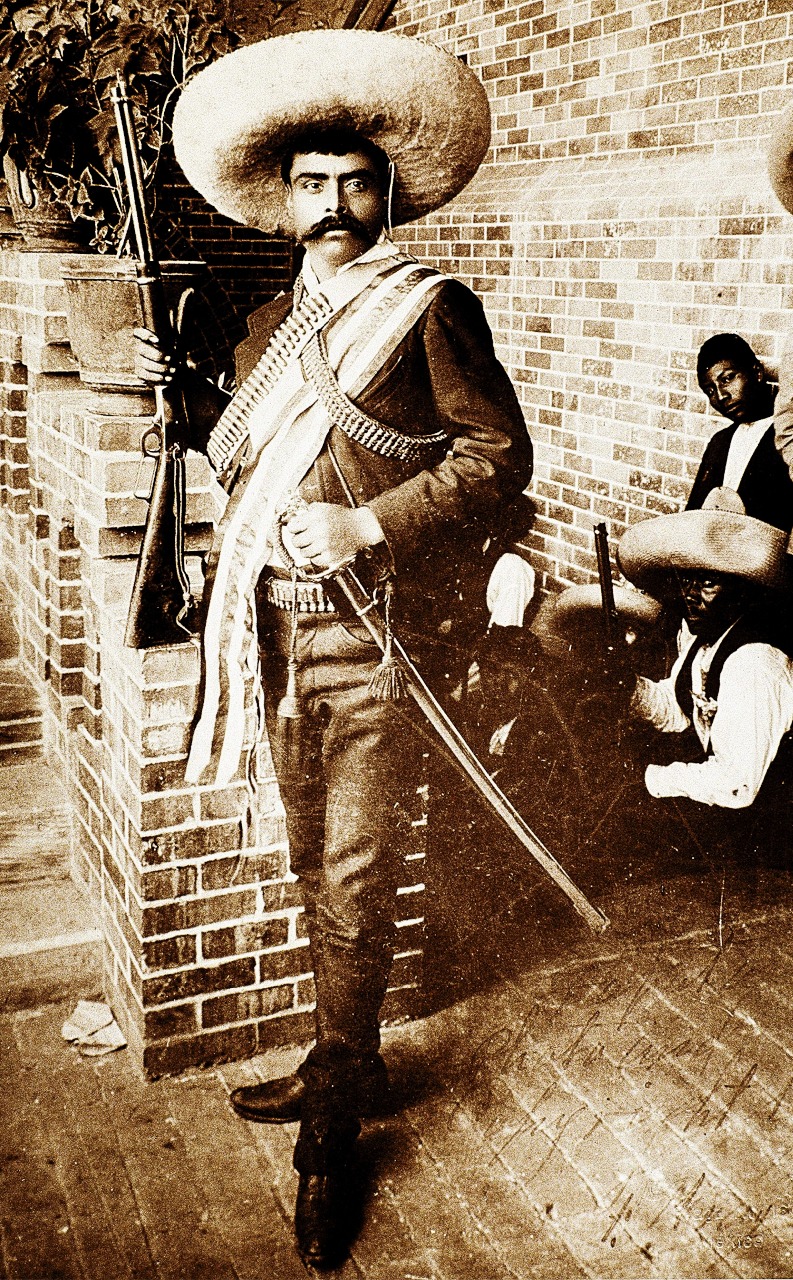
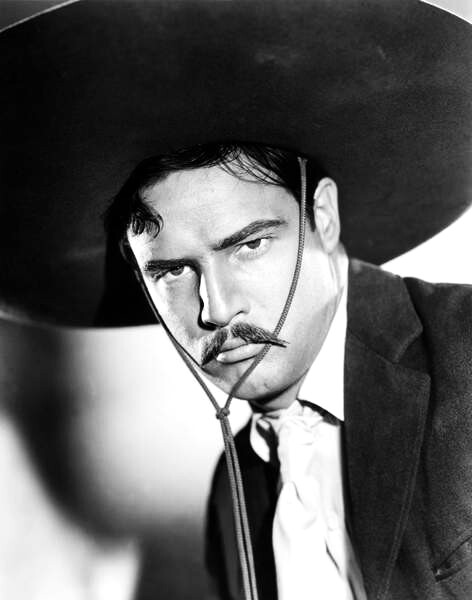
Attention-grabbing headgear often seems to be part of memorable iconography. Che's beret did for a time become a popular outfit for militant youths, such as the United States' Black Panthers.

Later, several radical youths replaced the beret with Mao's cap.

Nowadays, you can mark your views by wearing a Palestinian kefiah.

Already French revolutionaries of the eighteenth century distinguished themselves from reactionaries by wearing a Phrygian, red “liberty cap.”
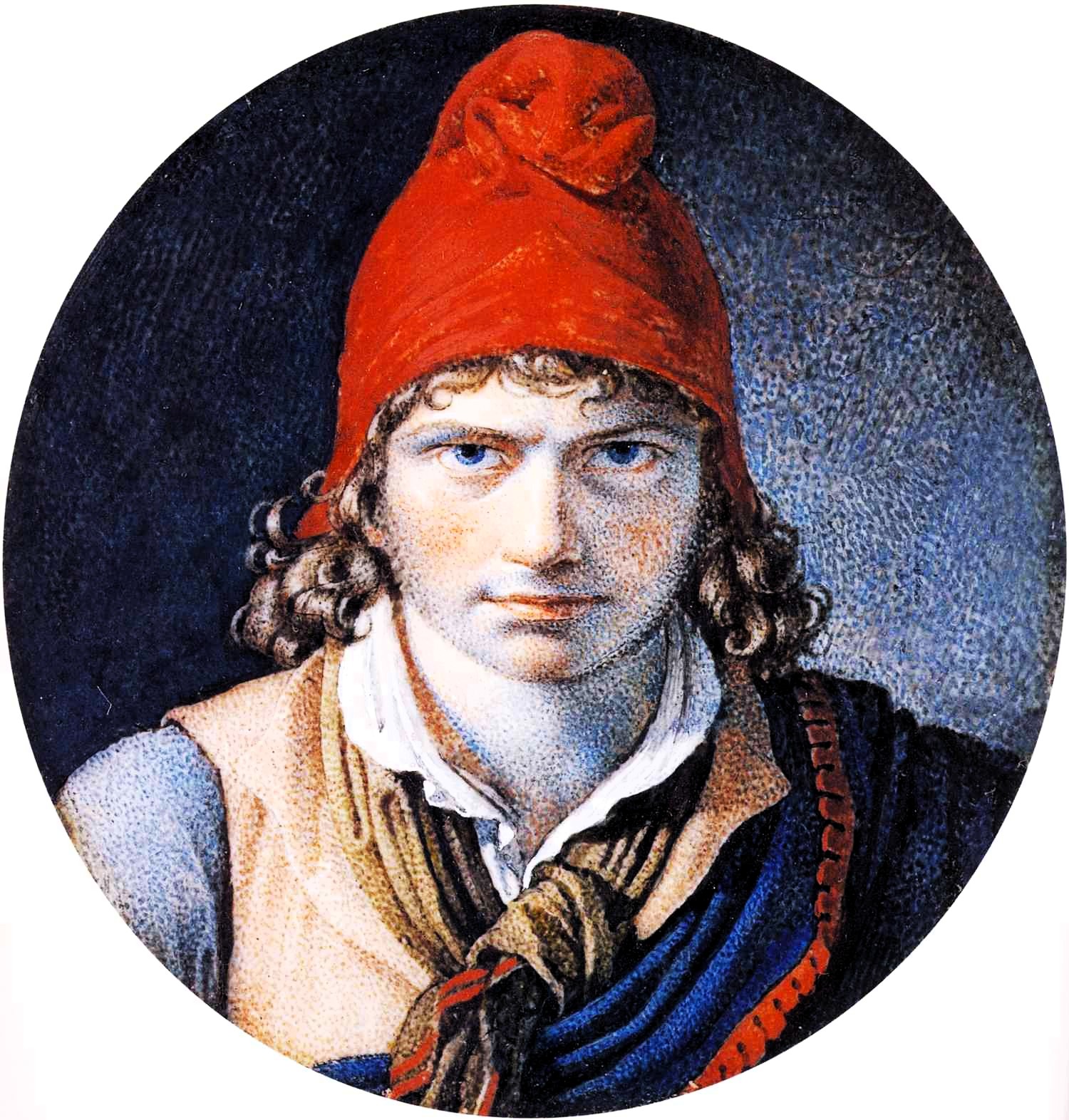
Talibans like to wear a pakol hat.

While radical feminists can solidarize themselves with the persecuted Russian feminist punk, protest and performance group Pussy Riot, by wearing a knitted pussy cap.

A fashion-oriented resistance similar to the pussy caps were knitted caps worn by some Dutch during the Nazi occupation, patterned with the colours and round logo of the British Royal Air Force, RAF.

However, it is not always that a hat or cap suggest radicalism. For example, in 1925 Kemal Atatürk introduced his “hat law” which stipulated the wearing of Western hats instead of the fez, which Sultan Mahmud II had introduced in 1826 as compulsory headgear for all Ottoman officials. Atatürk regarded the fez as a sign of Turkish backwardness.

Conservative hat fashion is also constituted by Trump's distasteful headgear.

Or maybe even the more imaginary Marlboro man's cowboy hat, which alludes to a tough and rough wilderness life, an existence that requires its smoking macho guy.

The Marlboro Man may find his urban counterpart in the sharp-tongued private detectives of the film world, personified in Humphrey Bogart's fedora-wearing Philip Marlowe.

Someone who moves in all environments is the athletic and at the same time intellectual archaeologist Indiana Jones, who also is sentimentally attached to his hat.

The archetype of a proto-conservative totalitarian headdress was the Prussian Pickelhaube, which Kaiser Willhelm II was complemented with a an upward-pointing moustache.

Mustaches can also be an iconographic marking. Think, for example, of Hitler's moustache which, in combination with his hairstyle, is enough to allude to him.

The incomparable skilled and ironically commercially conscious Salvador Dali also used his moustache as a trademark.

The even more commercialized Andy Warhol, who elevated commercialism, fame, and laissez faire to an art form, knew how to make use of iconographic portraits in his superficially distinctive art, often with strangely aesthetically pleasing results. By Warhol we find an almost unbelievable number of versions of iconic portraits. Images that even before Warhol had manipulated them were fairly worn and well-known, not least portraits of Mao, Lenin and Marilyn Monroe.
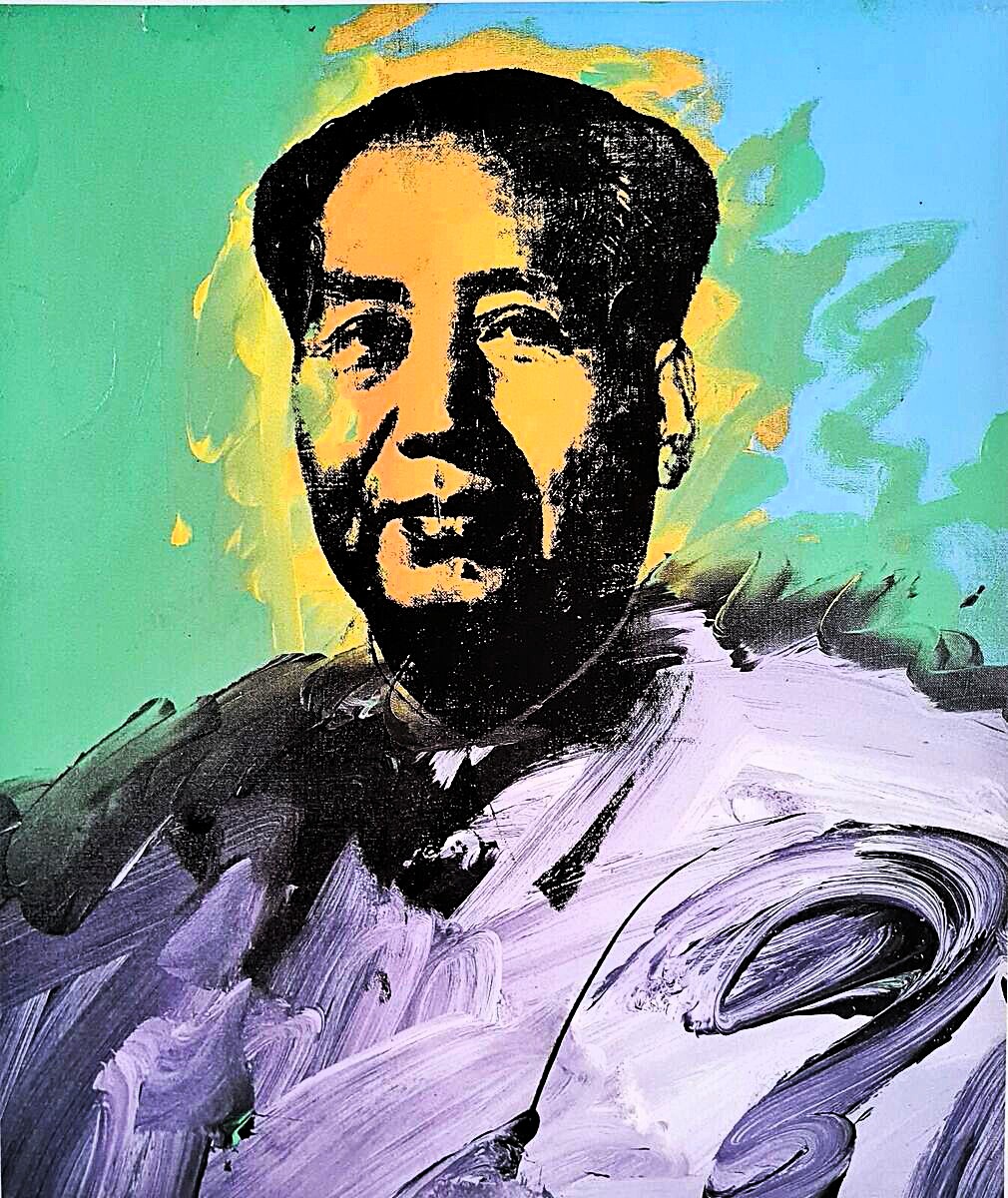
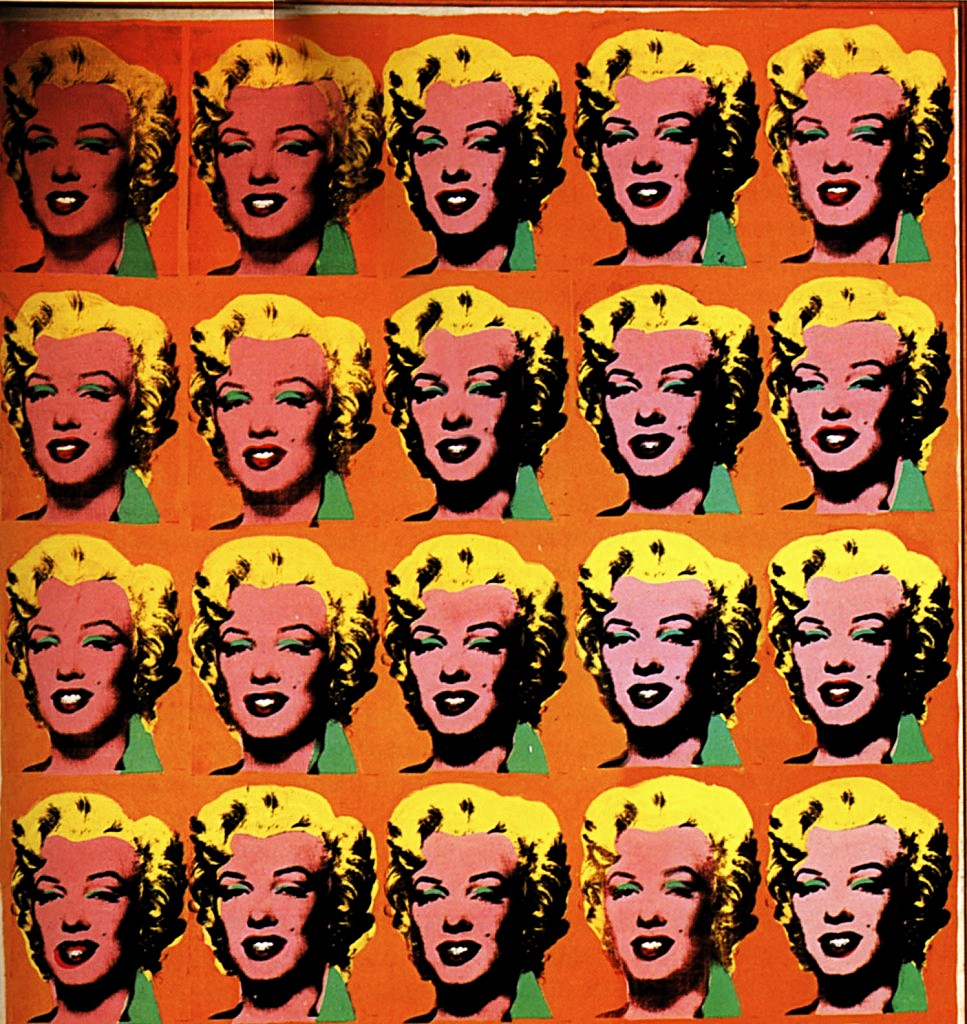
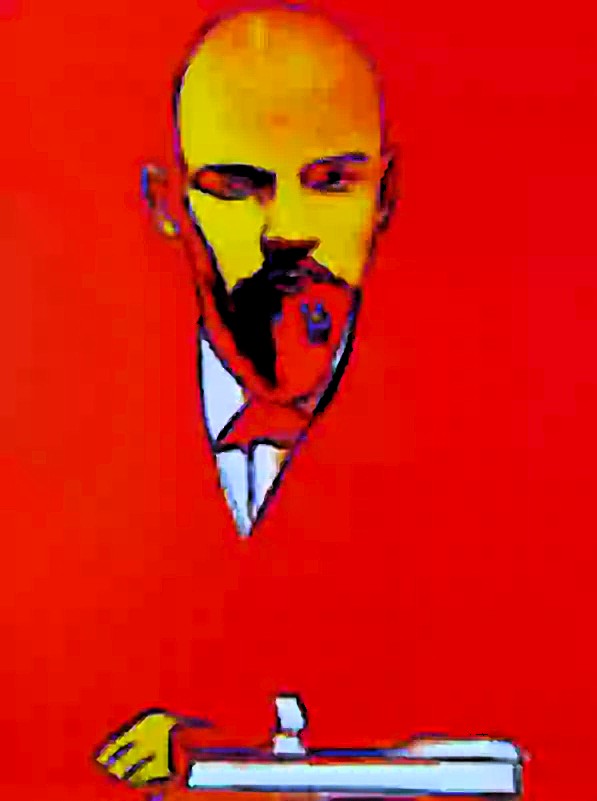
Like so many other artistically produced icons, Warhol's portraits were based on photographs, an artform that constantly produces icons. Consider, for example, the skilfully staged photographs of Marilyn Monroe and Igor Stravinsky.

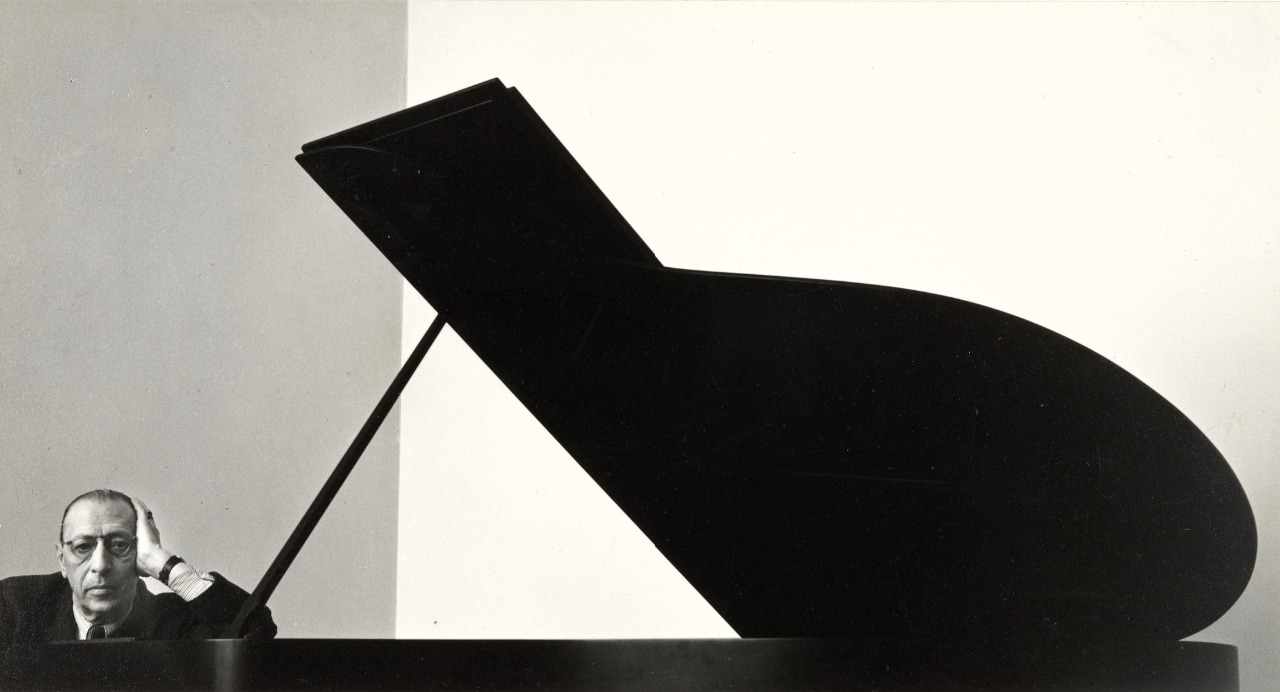
Or Winston Churchill's victory gesture that during World War II gave the British courage and hope and has since become an internationally occurring symbol.

The multifaceted Andy Warhol has more often than not been awarded the origin of an iconic logo that he did not create, but which became a symbol of an outspoken, rude youth culture, filled with contempt for the establishment and good taste – the Rolling Stones' outstretched tongue.
It was thus not Warhol who created this iconic image, but a young John Pasche who was studying at the Royal College of Art in London. The financially minded Mick Jagger had asked the Rolling Stones headquarters to contact the school and ask them to identify a young talent who could come up with a striking symbol for the rock group.
Pasche was chosen, but his original proposal was not to Jagger's liking. He had thought of something more exotic and showed Pasche a picture of the Hindu terrifying goddess of death – Kali.
Kali, the Great Mother, who like the eternal time destroys everything, yet persists. She is the relentless nature that, despite her predators and victims, persists. With her outstretched tongue Kali teases and mocks us. She sees through our social facade; perceives the dark desires we deny and suppress. She forces us into our shameful past, so that a realization of our shortcomings enables us to be born anew.
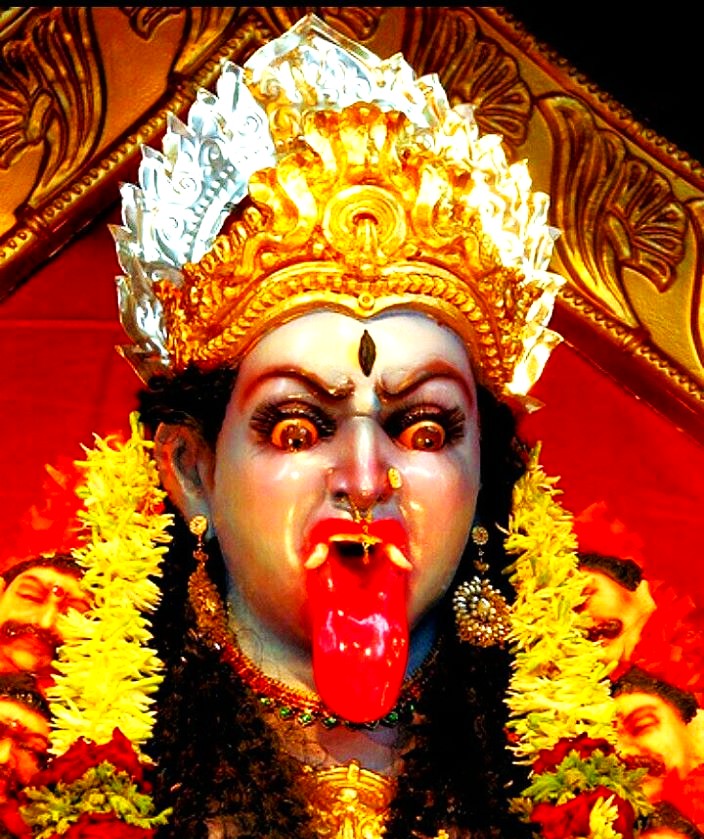
Pashe became fascinated by the goddess's outstretched tongue and in a moment of inspired excitement he came up with what became a pop artwork – a synthesis of works by significant pop artists such as Warhol, Ruscha, Ramos and Lichtenstein.

Back to the iconic meaning of headwear. It is not only as symbolic marker of ideological conviction that a hat or cap can take on a certain meaning, they can also be associated with admired men and women.
In India, for example, the young freedom hero Bhagat Singh (1907-1931), who was hanged by the British, is associated with his hat.
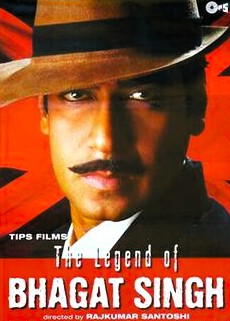
John Lennon's hat model was worn by many of his fans, often in combination with his round glasses.

Another person who has become almost identical with his hat is the Nicaraguan revolutionary Augusto Sandino (1895-1934), who between 1927 and 1933 fought against the U.S. occupation of his country. A year after the U.S. withdrawal, Sandino was executed on the orders of the coup plotter Anastasio Somoza.
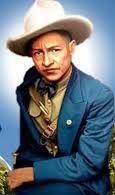
Sandino is one of many iconic figures who have become something of a symbol of the country they fought for. There are plenty of such “nation fathers.” Such as Garibaldi, Gandhi, Mandela and Atatürk, to name a few figures who are now depicted as statues and a plethora of pictures.
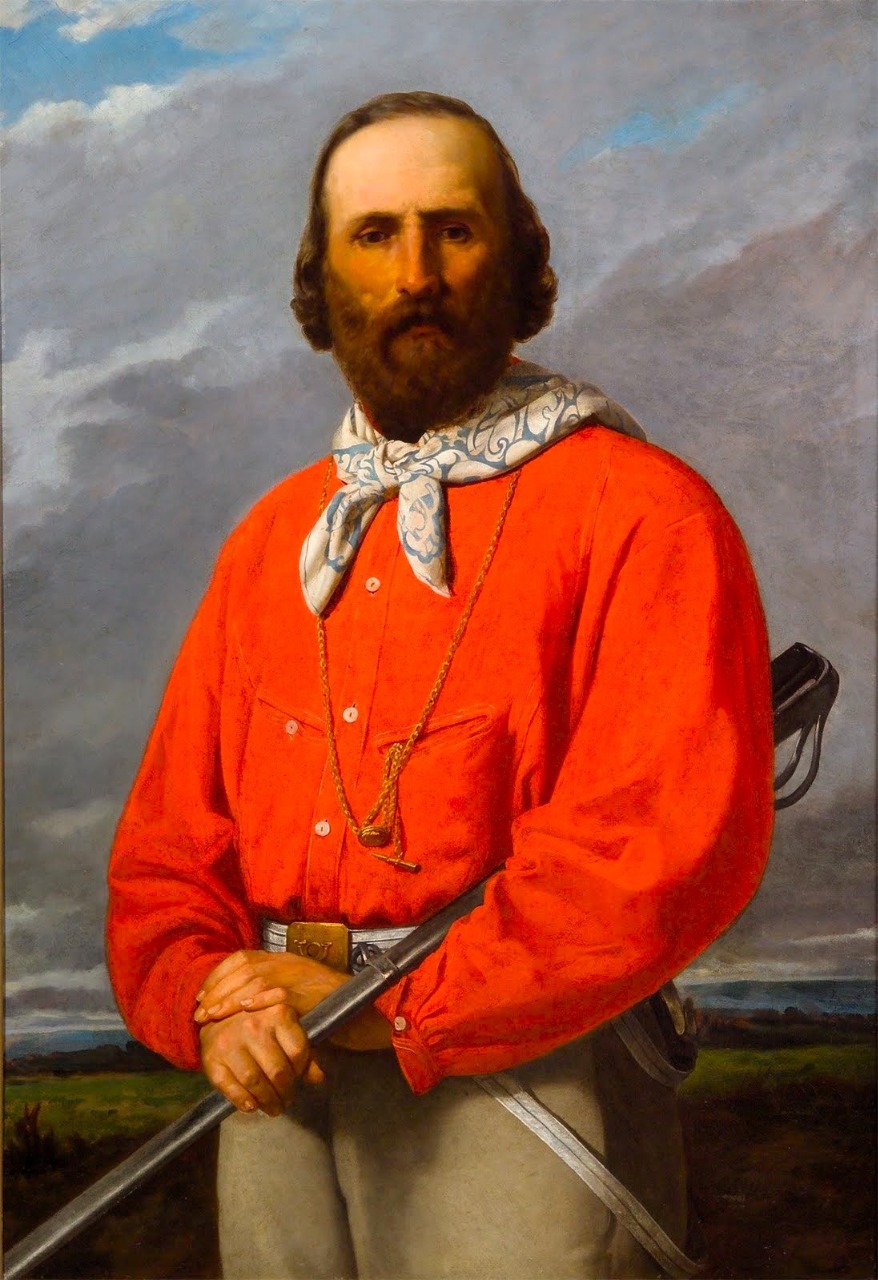
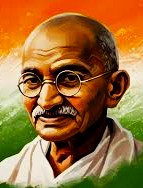
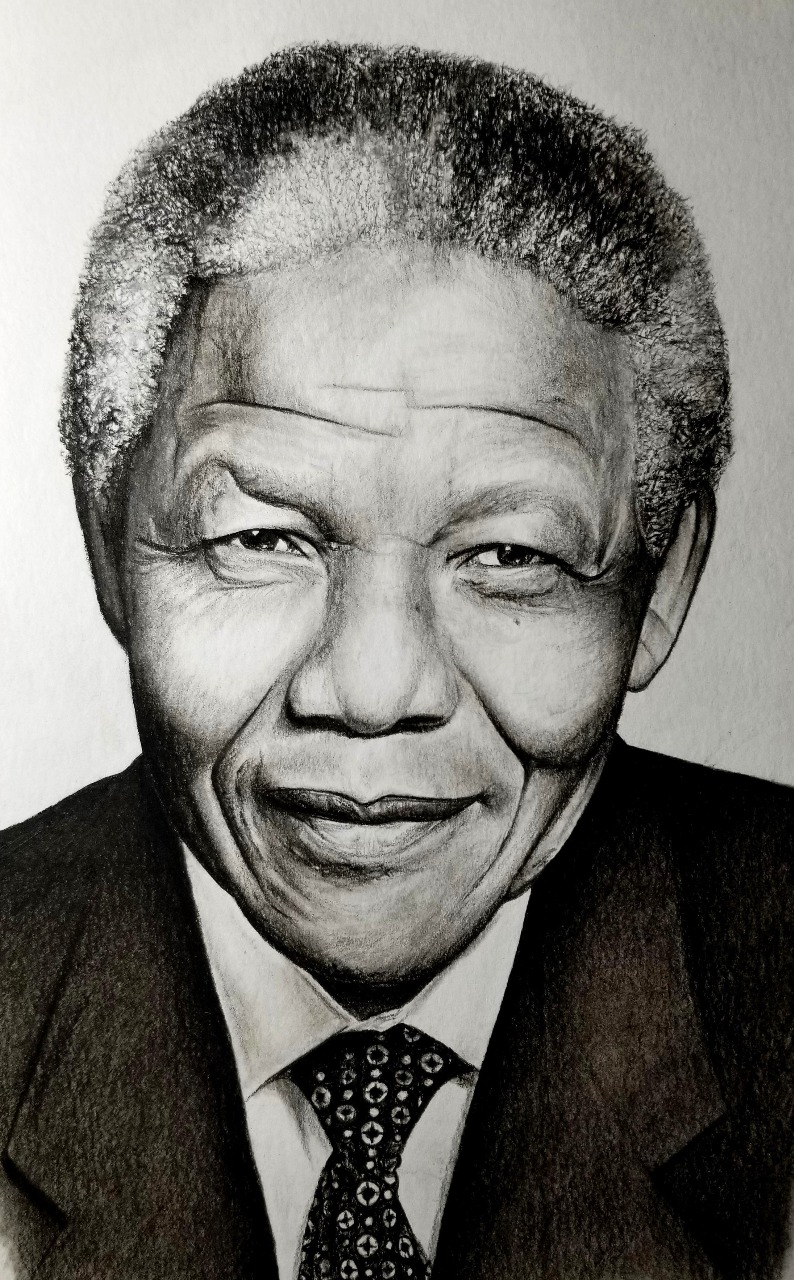
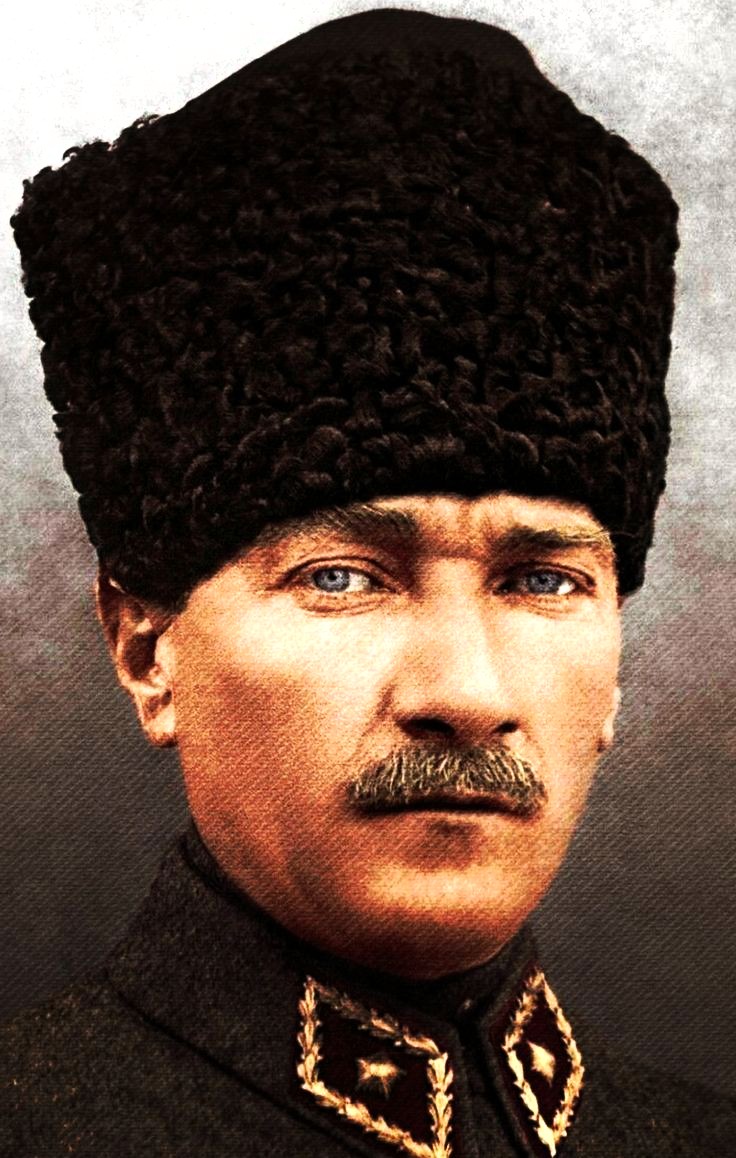
Fathers of the nations, though evil ones, can perhaps also be dictators whose portraits once adorned the offices and prisons of totalitarian regimes.
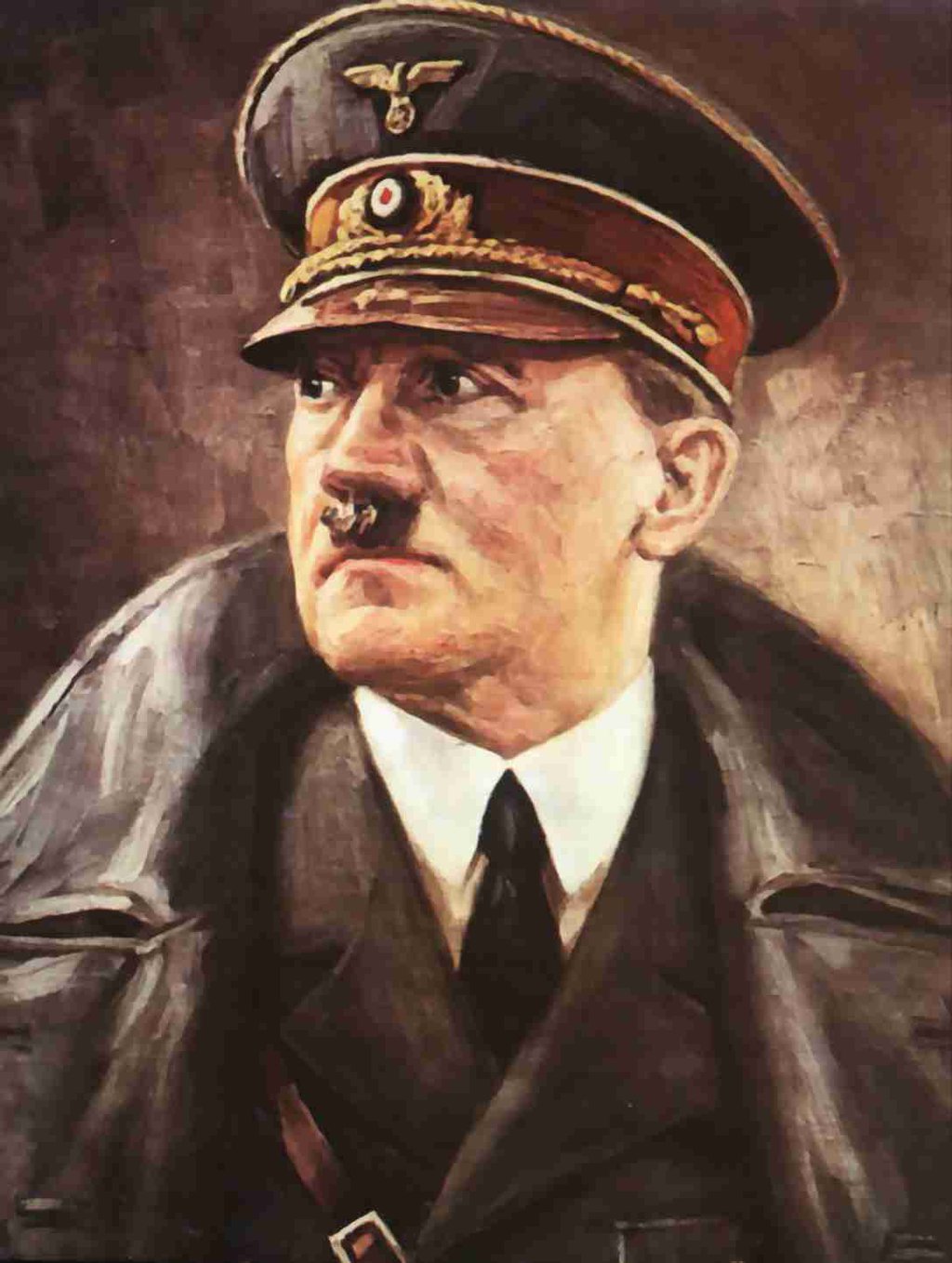
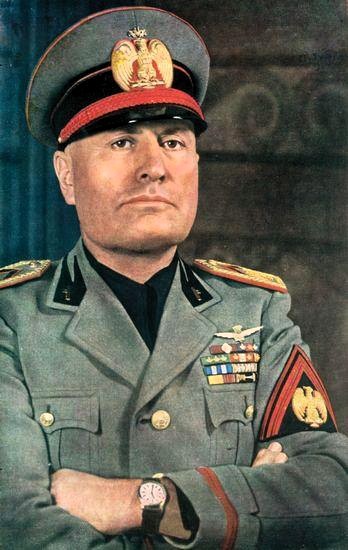

Self-glorified and pathetically portrayed, they have looked down on victims and subjects. As successors to this type of icons, one can possibly perceive the portraits of sitting presidents that adorn offices and embassies


More often than not, these potentates are extremely serious. Perhaps even somewhat threateningly they watch over the officials and visitors of embassies and government offices. Nowadays they wear ties and jackets and even if they would like to, they no longer present themselves in such splendor as previous autocrats, like Napoleon Bonaparte.
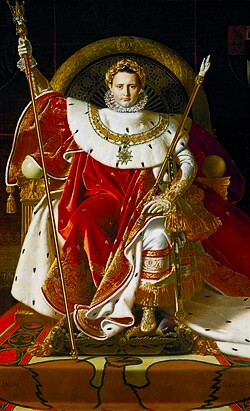
A man who, by the way, was also known for a somewhat odd headdress.
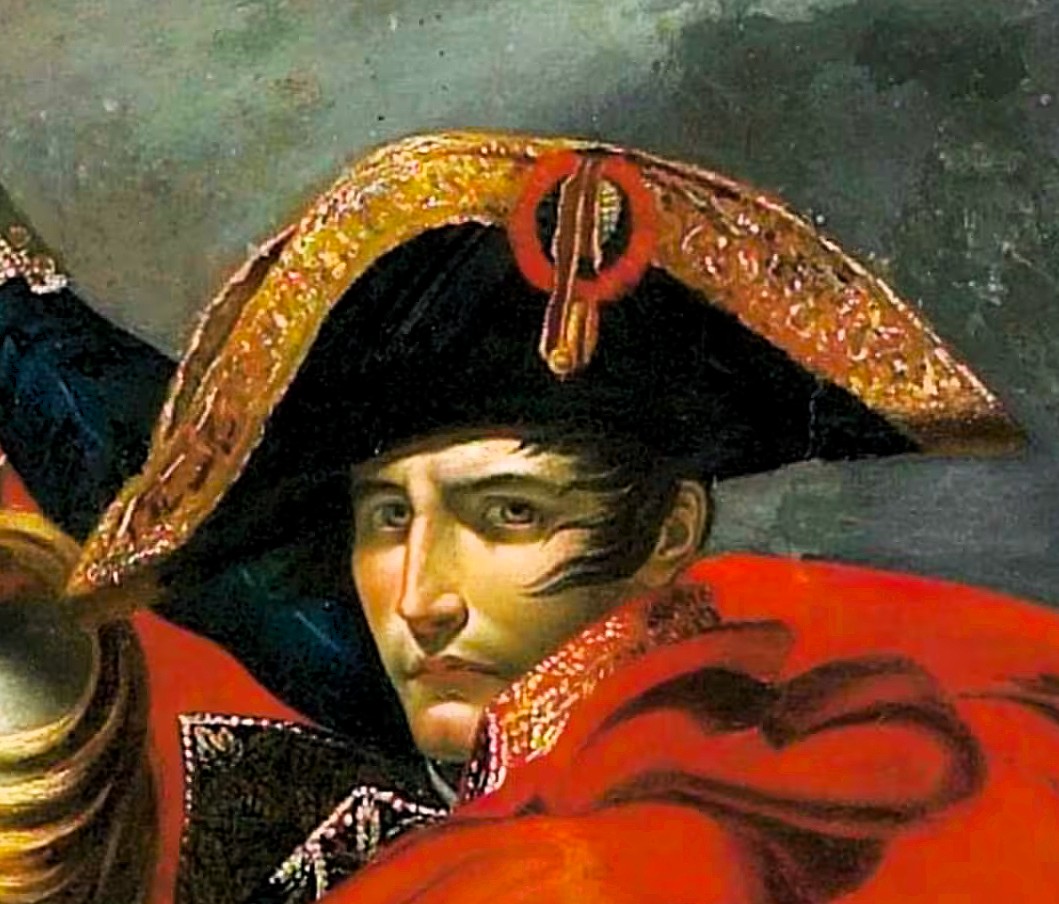
But it is not only statesmen/women who become icons. Also, artists, mainly rock musicians. For example, the deceased Elvis Presley (although some fans believe he is still alive) is worshipped in an almost religious manner.
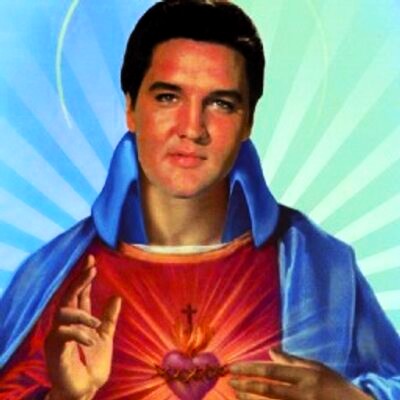
Another icon is the prematurely deceased and charismatically unbridled Jim Morrison, singer and lyricist for the rock band The Doors, who died at the age of 27 in a bathtub in Paris. A death as legendary as his short life story. The iconic image of Morrison is called The Young Lion and was taken by photographer Joel Lee Brodsky, who made several of the covers for The Doors ' records.

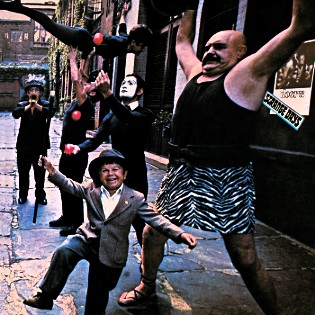
Morrison's death came exactly two years to the day after the death of Rolling Stones guitarist Brian Jones and about nine months after the deaths of Jimi Hendrix and Janis Joplin. These musicians died at the age of 27 and have thus given rise to a multitude of myths and conspiracy theories.

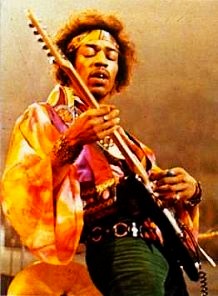

These young musicians became icons because of their charisma and knowledge, this unlike other idols created for reasons of power politics. For example, the unpleasant young Nazi and hooligan Horst Wessel.
He developed a friendship with Joseph Goebbels and after Wessel was killed by two members of the Communist Party at the age of 23, he was transformed by his diabolical friend into a Nazi national saint. Wessel's main reason for fame, apart from a certain musical talent and for having beaten up opponents, was that he had written the Horst Wessel song, which became the national anthem of Nazi Germany alongside Deutschland, Deutschland über alles.
In fact, the melody was stolen from a song of unknown origin, the so-called Königsberg song, which was sung in one of the militant Freikorps of which Wessel had been a member. Books and plays were written and films were made about Horst Wessel, statues were erected and inspiring pictures were spread.

Other more or less politically constructed youth heroes appeared in the Soviet Union and the Chinese People's Republic. The Russians had their Pavlik Morozov and the Chinese their Lei Feng.
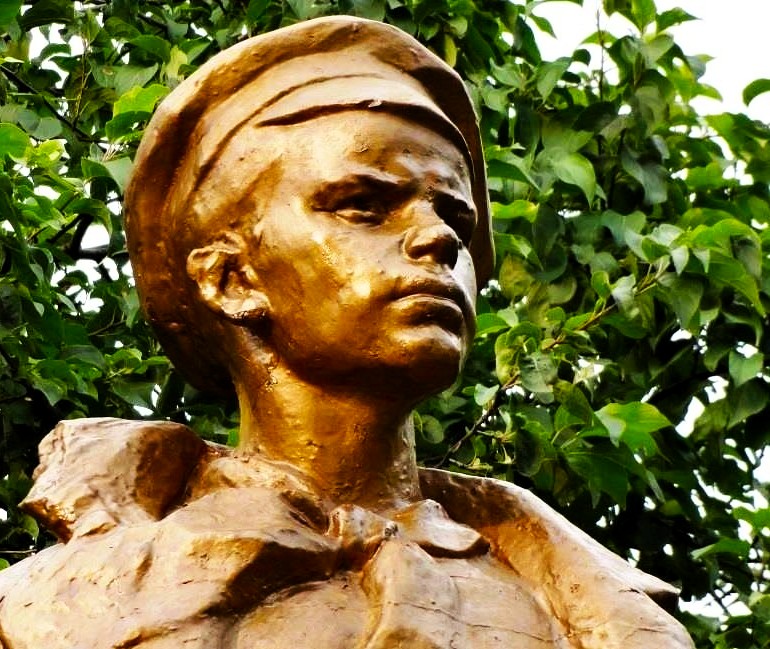
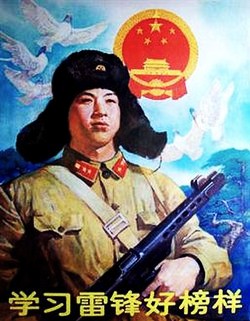
The myths surrounding these mostly fabricated heroes are probably just as inadequately truthful as the halo of heroes surrounding other previously worshipped, but later often fallen national heroes.
From school, I remember the stories about the Swedish national founder Gustav Vasa, who was then still worshipped as the father of the nation and a patriotic symbol. Something that was confirmed by Carl Milles' powerful sculpture from 1925, which in painted oak greets the visitor at the entrance to the National Museum and under which the motto “Be Swedish” is inscribed.
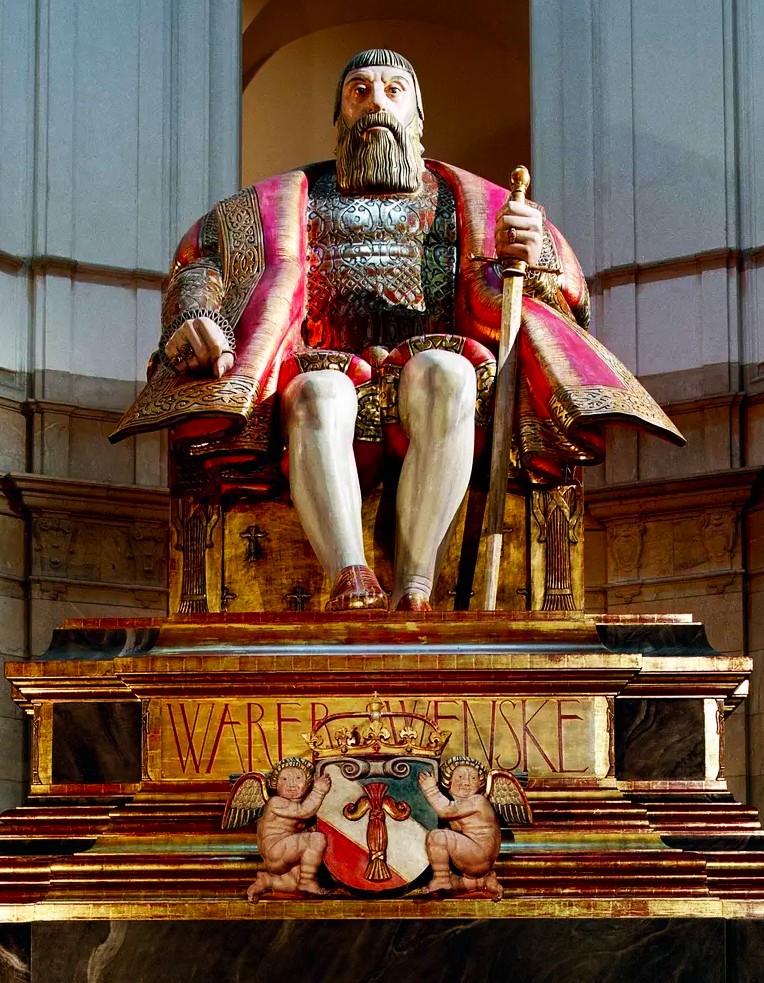
Nowadays, it has been established that Gustav Vasa was a ruthless realpolitiker, who with brutal methods got rid of his opponents and used ruthless propaganda to consolidate his power.
After previously giving sparkle to various brands, the royals’ propaganda opportunities have diminished in Sweden. What remains is probably only King Oscar's Sardines that are manufactured in Norway and bear the name of the Swedish King Oscar II, because he at the time of the sardine brand’s introduction ruled over both Norway and Sweden.

When Norway was separated from Sweden, the Swedes instead produced King Gustaf's Sardines, with a nicer packaging.
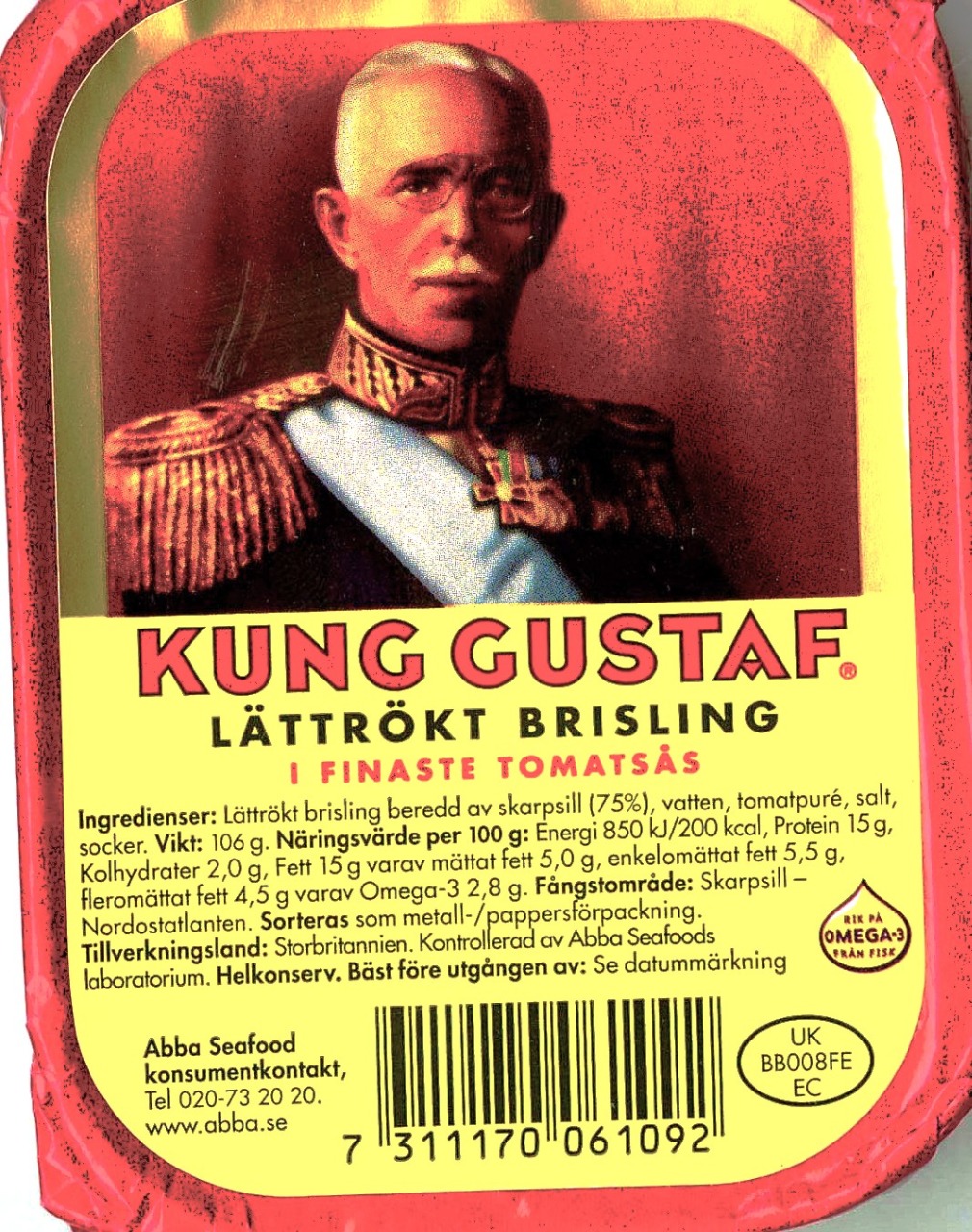
The fact that royalty is no longer a selling brand is perhaps one reason why the Wasa Crispbread, which is exported all over the world, has now removed the portrait of the old nation father and tyrant and replaced him with just the trademark text, which for many has lost its original meaning.
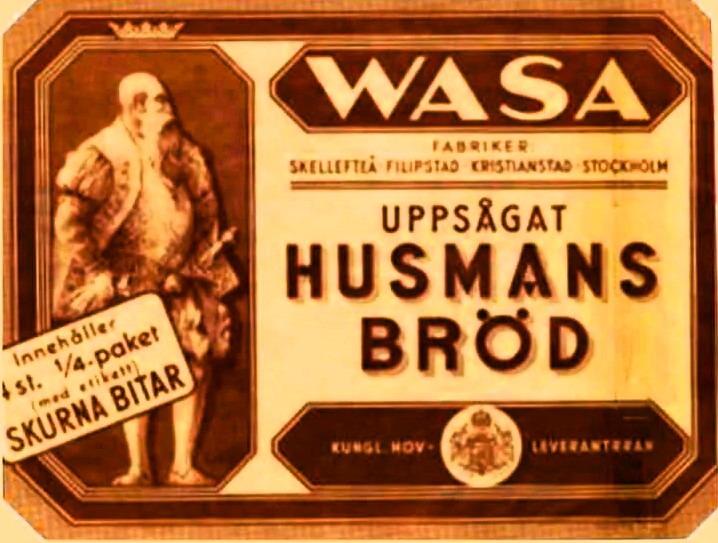

If an image becomes iconographic, it can facilitate the sale of the product behind it. Something that also applies to politics. Take, as an example, Barak Obama's election poster, called the most effective American political poster since Uncle Sam Wants You.

Obama's election poster was so striking that it obtained a large number of imitators and perhaps also contributed to Obama's election victory.

That image was also based on a photograph and Shepard Fairey, who created it, had not asked for permission to use it as a model. It was a photograph taken by a certain Mannie García, the result of Fairey's indulgence was a long legal process that Fairey eventually lost.

He was sentenced to two years of probation and a $25,000 fine. However, Fairey's artwork was a stroke of luck and has now for several years been a source of both satire and inspiration.

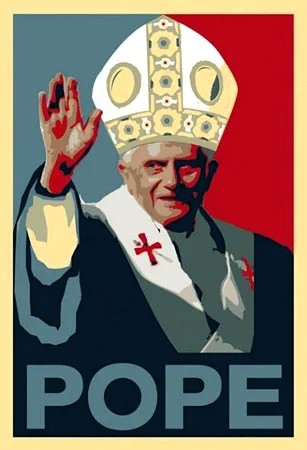

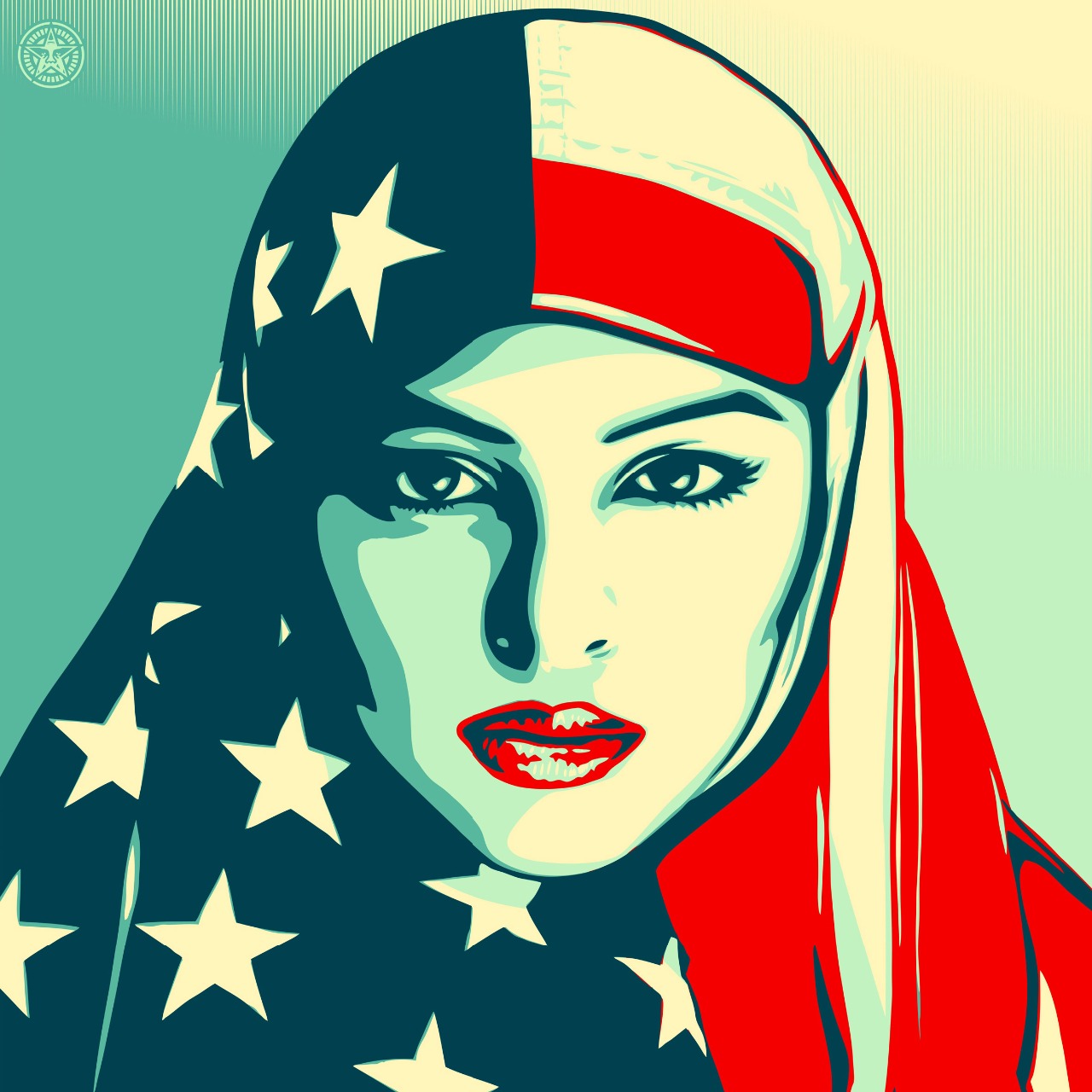
On reflection, it is possible that Fairey also was inspired by various commercial predecessors. Obama's abstracted face makes me think of Kentucky Fried Chicken's logo, with its stylized image of its founder Colonel Sanders.

Colonel Sanders' appearance brings to mind some retired Confederate officer who now cooks excellent food. In fact, Harland David Sanders had not been a military man at all. In his case, the designation “colonel” was an honorary title that governors of various states might give to citizens who have earned gratitude for something they done for their state.
Sanders had worked on the railroad, as an insurance agent, gas station manager, partner in a steamboat company, and failed in a law firm, until finally, during the Great Depression, he began selling specially-breaded chicken pieces from a fast-food shed.
This humble beginning developed into an astonishing success story, and Sanders ended his days as a millionaire, always dressed as the cuddly man he portrayed himself to be—dressed in an elegant, impeccably white suit, with a black bow tie. He dyed his hair and beard white, until at last they really were.

Actually, Colonel Sanders' trademark was not a scam. He was, in a sense, a Southern colonel who devoted himself to cooking. It was different with two other well-known brands, which also alluded to a rural, homely South, where black slaves lived in peace and prosperity with their masters, to whom they served excellent food.
In the 1940s, chemists Huzenlaub and Heron Rogers had discovered a method to pre-treat rice so that it cooked faster, but retained all nutrients. Their rice variant began to be marketed in 1945, along with other products, by the company Converted Rice Inc and under the name Uncle Ben. They were almost immediately a huge success.
The brand depicted an elderly African-American gentleman with the same bow tie as Colonel Sanders. However, no Uncle Ben existed, even though Converted Rice Inc. at first claimed that Uncle Ben had been a chef and rice producer whose products had been so excellent that he became one of the U.S. Army's top rice suppliers.
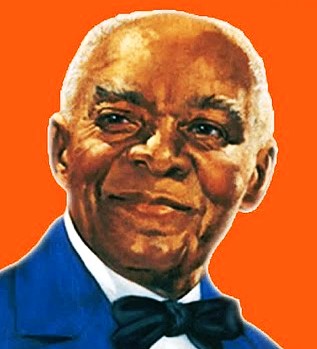
Perhaps Converted Rice Inc. was inspired by the success of Chris Rutt and his partner Charles Underwood with their brand – Aunt Jemima, which among other things sold syrup and flour for pancake batter. They had in 1888 bought a small mill in St. Joseph, Missouri, but had not found a convincing brand for their products. The success came after Rutt noticed a rather grotesque vaudeville poster, which inspired him to use a smiling African-American Mamy as the company logo.
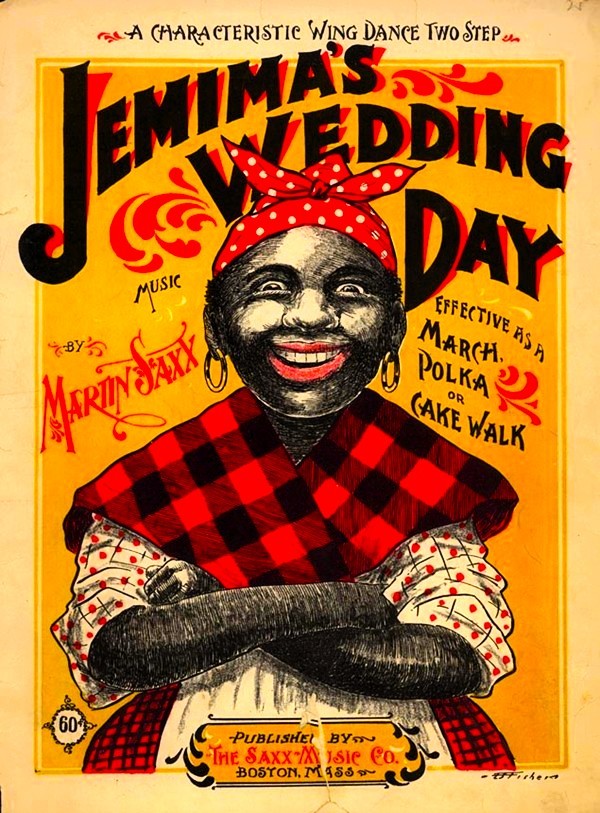
The grotesqueness of the vaudeville poster was moderated – Aunt Jemima became a smiling and motherly lady, who could later be used as a promotion in film clips and television commercials.

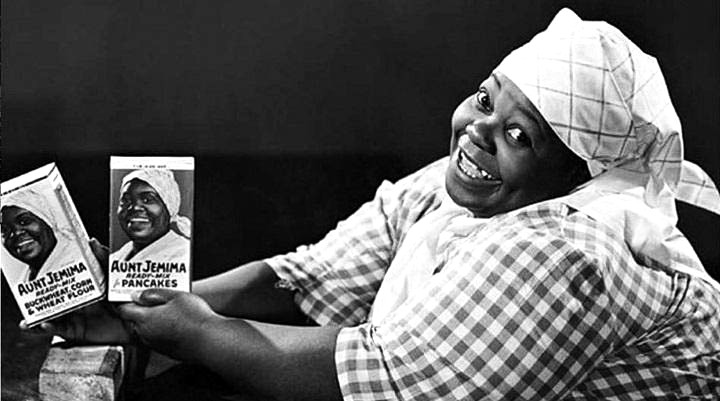
Both Uncle Ben and Aunt Jamima have recently come under heavy criticism for being successful attempts to market products with the help of racially prejudiced and fabricated ideals of a harmonious South.
Similar criticism has also befallen the French Banania, a popular chocolate drink that is mainly distributed within France, with ingredients such as chocolate, banana flour, honey and sugar. Banania began to be marketed during the World War I and its owner distributed large quantities of Banania to the front under the slogan "to our soldiers an abundant nutrient, easy to preserve and store."
The company's owner, Pierre Lardet, was also looking for a selling, iconic image, both convincing and exotic, given the chocolate and banana ingredients. He concluded that the best brand would be a tirailleur Senegalese, a member of the popular infantrymen from French West Africa. Banania was then marketed along with the image of a happily smiling Senegalese enjoying his Banania during a break in the fighting .
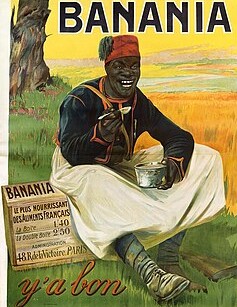
The picture was accompanied by the text Y'a bon, “it is good”, to allude to the pidgin French that the Africans were believed to speak. In fact, the expression was made up. After the war, the depiction was simplified to a close-up of a happily smiling Senegalese soldier, still with the text Y'a bon.
The philosopher and psychiatrist Franz Fanon, born in Martinique, did in his book Black Skin, White Masks present the Banania advertisement as an example of how commercialism objectifies people. The smiling Banania man's silly, benevolent smile infantilized him by turning the Africans into children, like the kids who were Banania's main consumers. Like a child the Banania man was unable to communicate in correct French and this fictional Senegalese accordingly used the childish and imaginary phrase Y'a bon.
.jpg)

From my childhood, I remember how Africans were often used in advertisements for chocolate, coffee and licorice, among other things. In my hometown there was a shop that had a large coffee grinder in its display window and sold coffee and tea in bulk. I thought the store had a wonderful scent and remember an advertisement made by the Danish artist Aage Sikker Hansen that I am not bothered by at all, but instead consider to be a real work of art.
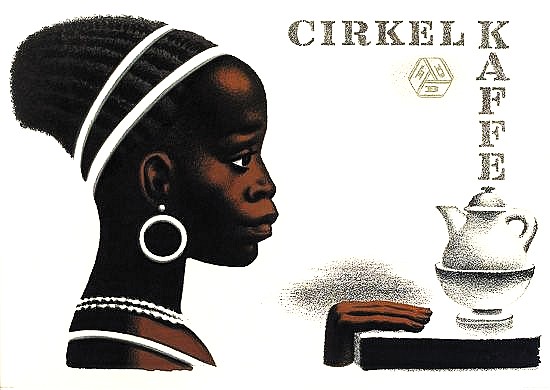
The figures and slogans of commercialism are ever-present. Some of them can be grotesque and annoy me with their ugliness. One such icon is McDonald's Ronald McDonald, “the hamburger-happy clown"”, who in 1963 made his debut in American television commercials at a time when the clown Bozo's show was the most popular children's program.

For many children, however, the heavily made up and overly intrusive Bozo became a horror figure, something that has been reflected in a variety of masks and films.

McDonald's TV clown was not entirely successful. He had too much of Bozo about him, so the burger chain hired Coco the Clown. Actually, Michael Polakov, a Latvian-born circus clown counting upon an ancestry from a family with a solid clown background. Coco was what in classical clown tradition is known as an "August" and he transformed the McDonald figure into a more colourful and less sinister figure than Bozo.
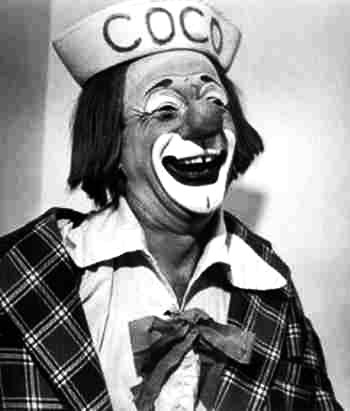

However, Ronald McDonald appears to be significantly more fake and threatening than a real circus clown. I believe that clowns as practitioners of a venerable entertainment tradition belong in the circus ring and nowhere else, least of all should they be abused for commercial interests.
The clown tradition is destroyed when it is commercialized. Something Santa has also experienced when he became abused by business interests, as when the Coca Cola Company transformed him with the help of Haddon Sundblom, born in Michigan but with Swedish-speaking parents from the Finnish Åland archipelago between Seden and Finland.
Sundblom's Santa Claus had been mainly inspired by a poem by Clement Clarke Moore, written in 1823. In Moore's poem, Santa Claus comes flying with a sleigh pulled by his reindeer – Dasher, Dancer, Prancer, Vixen, Cupid, Comet, Donder and Blitzen. He dives into the chimney and places his presents around the Christmas tree.
He had a broad face and a little round belly
That shook when he laughed, like a bowl full of jelly.
He was chubby and plump, a right jolly old elf.

Moore's Santa was small in stature, and had become sooty during his journey through the chimney, more fairy-like than Haddon Sundblom's portly, large and Ho! Ho!-chuckling Santa. A commercialized figure with elements from several directions – for example, from the Swedish artist Jenny Nyström's friendly and charming Santa, combined with the Dutch Saint Nicholas and the Russian Father Frost.

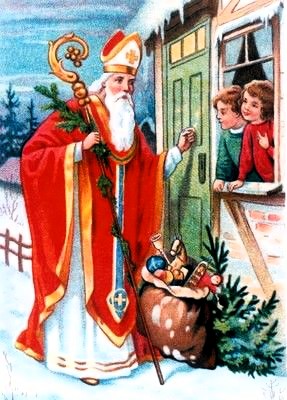
.jpg)
The result was the unbearably chuckling fat guy who has plagued us ever since he made his entry into the Coca Cola Company in 1931.

In Sweden, Santa often comes for a personal visit and if he then wears a mask, he can unfortunately destroy the illusion of being a real person and also arouse fear in the smaller children.

Masks often depict iconographic figures, such as certain politicians and monsters. They can sometimes be just as terrifying, both of them.

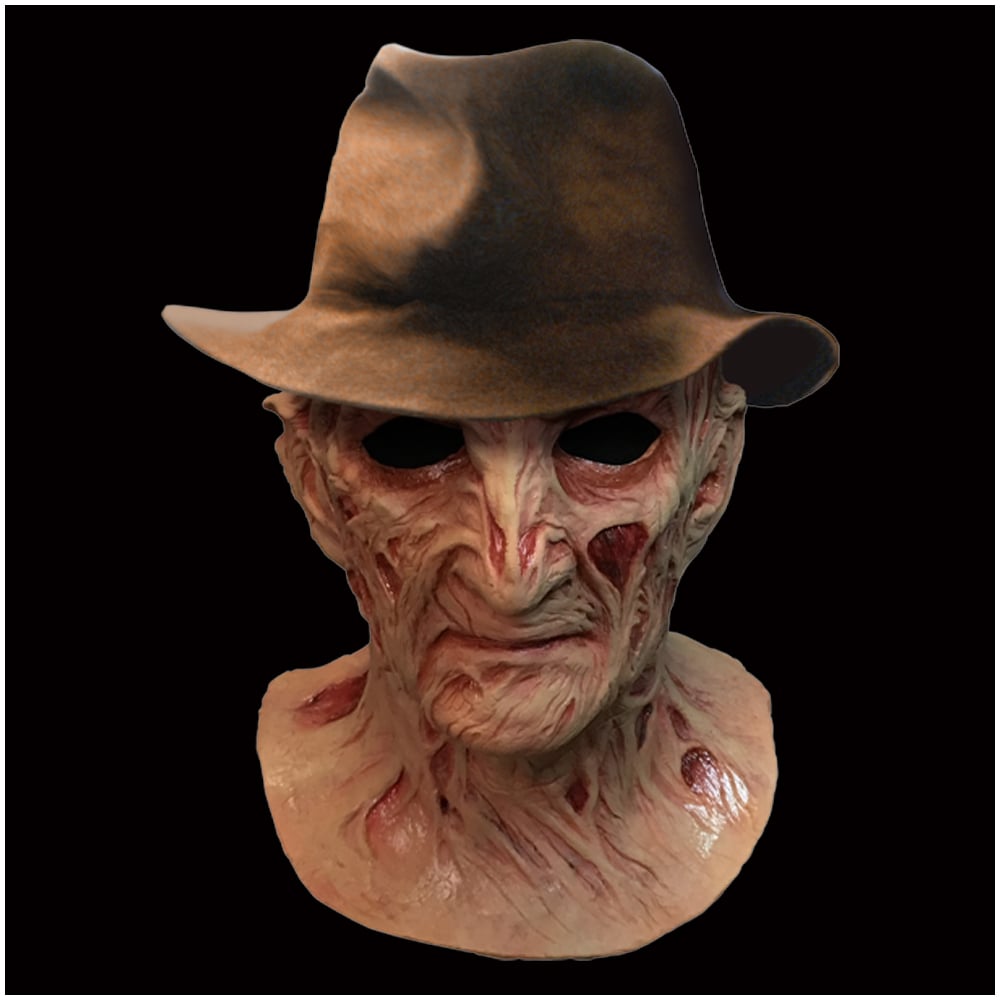
Also well-known are various carnival masks, such as those in Venice, which also were even worn on a daily basis, to disguise persons who for various reasons wanted to remain anonymous.
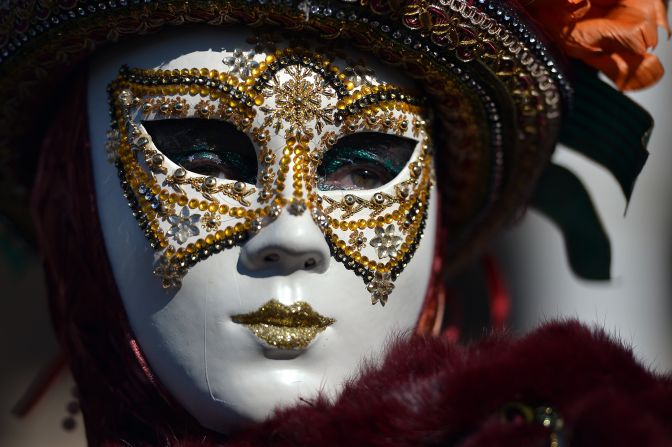
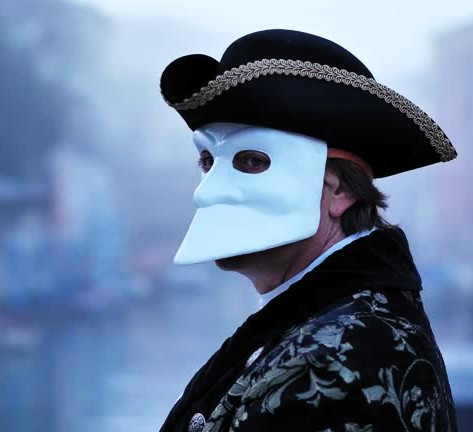
By hiding the personality, masks could serve shady and criminal purposes. As in an 18th century etching by Daniel Chodowiecki where masked gentlemen molest a terrified young girl.
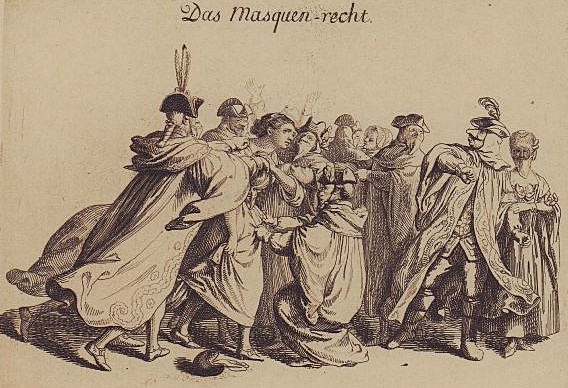
A scene that makes me think of the wealthy perverts depicted in Kubrick's Eyes Wide Shut.
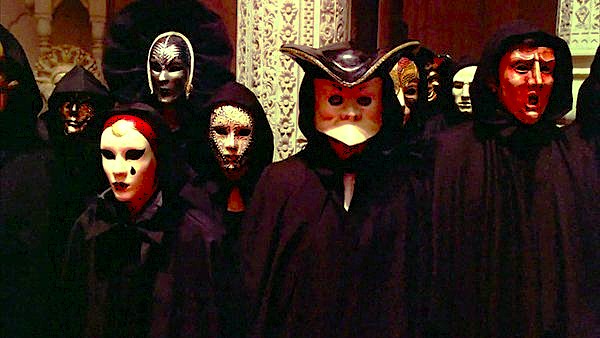
Some masks have become icons as well. For example, the mask is The Scream, which is the one that is sold the most around Halloween. The mask finds its origin in a schlaser film by Wes Craven, whose films a horror movie habitué like me never has been particularly attracted to. Although I occasionally watch such films, I am more fascinated by creeping, psychological horror than the overly effect-seeking slasher - and splatter tradition which Wes Craven's films are part of. As usual, The Scream is about a mask-wearing mass murderer.

It is often said that the mask was inspired by Edvard Munch's The Scream, something its creator, Loren Gitthens, has denied.
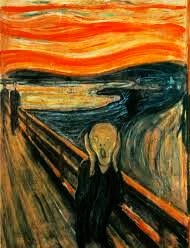
Gitthens is probably right in his denial, especially as he has pointed to other more obvious sources of inspiration, such as the poster for Pink Floyd's The Wall and some ghosts appearing in the Scooby-Do cartoons, especially in an episode called Unmasking the Ice-Cream Flavoured Phantoms.

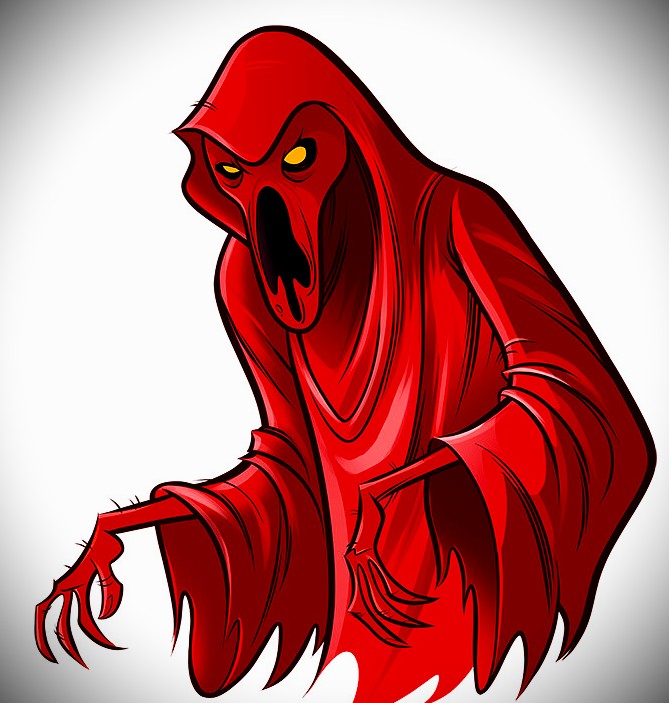
Gitthens also mentions a short film that I remember from my childhood when I saw it on TV and since then have had a hard time forgetting it, just like another horror sequence – Walt Disney's first Silly Symphony from 1929.
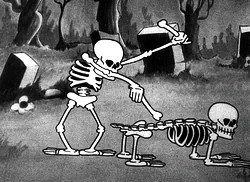
https://www.youtube.com/watch?v=gm744AGvknU
The short film Gitthens refers to – Dave Fleischer's Betty Boop – Snow White from 1933, is better than Disney's dancing skeletons and is now considered one of the highpoints of early film animation. It was mostly created not by the brothers Max and Dave Fleischer (who is named as the director) but by Dave's assistant Roland Crandall.
What makes that short film special, aside from its surprising, surrealist effects, is Cab Calloway's interpretation of St. James Infirmary Blues. Calloway's specific singing and dancing style constitutes the basis for the short film's central scene, which takes place in a lugubrious cave. A cinematic experience far superior to Wes Craven's The Scream.
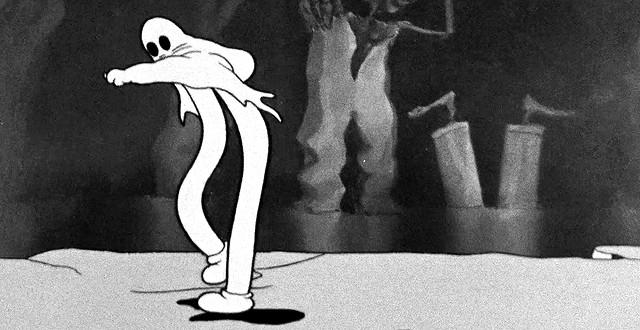
https://www.youtube.com/watch?v=cKOSJ5AAwfc
Cab Calloway appeared in several of Fleischer's short films and for a time in the thirties he was a trendsetter in several areas, as an orchestra leader and songwriter, but also as a distinctive scat singer, a skilled and extremely original dancer and not least a fashion lion, who through his extravagant zoot suits, inspired the style of clothing and demeanour of a number of Harlem's radical youth.
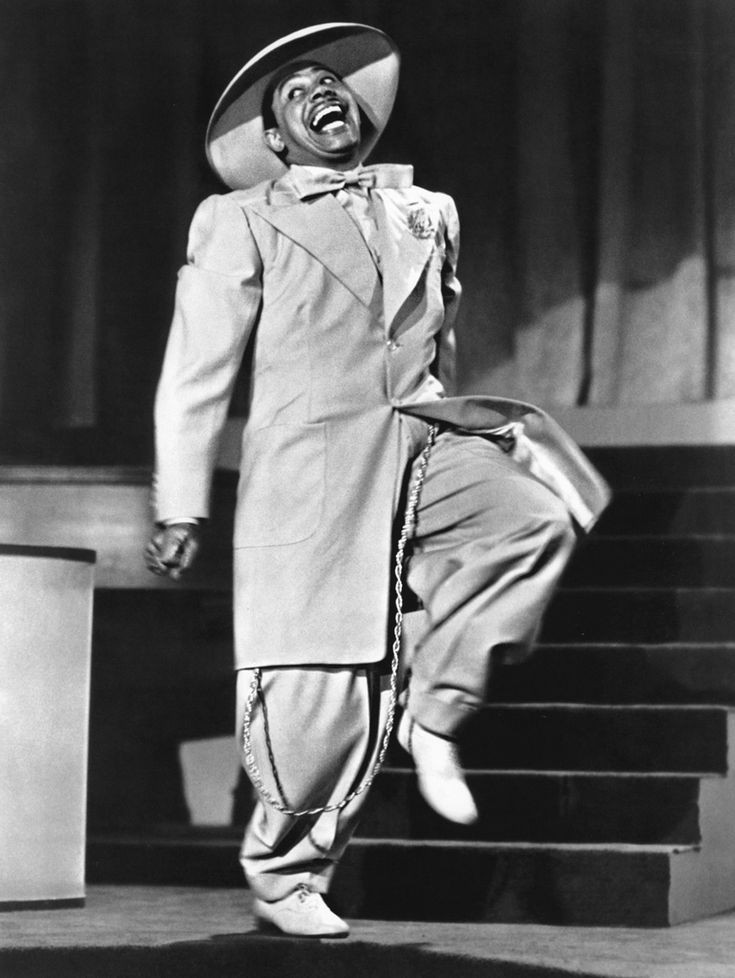

Not only has Wes Craven's The Scream inspired a popular mask, but also the Guy Fawkes mask, which is not worn for Halloween, but has inspired anarchists and other radical youth, originates from a movie – James McTeigue's film V for Vendetta, a dystopian thriller from 2005, based on a 1989 graphic novel, written and drawn by Alan Moore and David Lloyd.
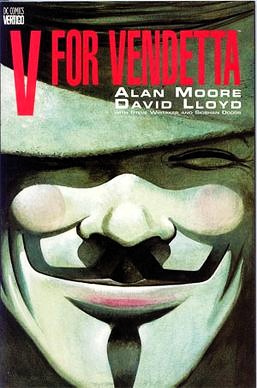
The novel and film are set in a near future where a fascist, totalitarian regime has subjugated Britain and is engaged in controlling the population through deceitful propaganda and more or less open surveillance, while unwanted individuals are imprisoned or executed, including immigrants, homosexuals and people of religious beliefs other than that of state-sanctioned “Christians”. V is an anarchist and masked freedom fighter whose growing crowds engage in protests and meticulously planned terrorism. They wear masks inspired by the appearance of Guy Fawkes, a Catholic rebel leader who in 1606 was hanged, drowned and dismembered after a failed attempt to blow up the British Parliament.

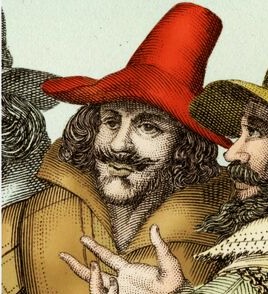
Other iconic figures that have come to characterize public awareness and appear in various contexts are the Aliens. In their current form – with small, humanoid bodies, softly smooth skin, and disproportionately large heads, endowed with huge almond-shaped eyes – they appeared after the American couple Barney and Betty Hill claimed they had been abducted by such creatures and taken to their spaceship.

These aliens got their current, more definitive look after the author Whitley Strieber in his book Communion from 1987 described in detail his encounters with such creatures. The book was announced to be a “true story” and not like Streiber's earlier work as a novel. Communion became a bestseller that made its author both well-known and wealthy.

I assume Strieber, like some other unscrupulous authors, discovered that supposed non-fiction books about alternative history and sensational discoveries/experiences sell better than other texts.
There are several examples of this, not least Colin Wilson, who was previously appreciated by me through his interesting and well-written non-fiction books The Outsider and The Occult but he eventually ended up in a lucrative swamp of wild speculations and conspiracy theories. Not to mention Graham Hancock, who has become a millionaire in the same genre and in addition to the writing of several books, was provided with the opportunity to create speculative TV series that through their amateurish and supposedly "scientific" approach have contributed to a distorted, completely unfounded view of accepted history.
Even before Strieber became well-known through his Communion , I had read his novel about werewolves in New York, it was considerably better than its film adaptation – Wolfen, overshadowed by its contemporary and noticeably better werewolf films The Howling and An American Werewolf in London.

Fictional icons such as aliens have become integrated into a parallel reality that many of us have become familiar with since our childhood. Not only gnomes and trolls live and thrive there, but also creatures like Barbie and the Mario brothers.


A Russian exile, Mikhail Bogin, whom I once met in New York, told me how much he admired the cowboys and gangsters created in the United States.
They are brilliant! The Americans are masters of entertainment. They turn the extermination of the Indians into an exciting story, while serious crimes make excellent gangster films. People assume they won the Vietnam War and that the Americans won World War II. They have no idea that the defeat of Nazism began in Stalingrad. What has my country been able to do with all the misery that exists there? Hardly any entertainment. No one believes our myths, not even ourselves. Who is the model worker? Stakhanov? Who can believe such a thing? No one can believe in any Udarnik, Super Worker. No Russian can imagine that he comes from the best country in the world. But the Americans think they do. They believe in their Constitution, their Superman and their Donald Duck. We Russians do not believe in anything. The politicians destroyed religion and the monarchy; they never succeeded in replacing them.
Superheroes occupy a prominent place in the imaginary world of icons. The archetype is Superman, who conquered the world before Marvel's multifaceted heroes and heroines appeared.

The Superman was created in 1938 by childhood friends Jerry Siegel and Joe Shuster. They worked closely together, with Siegel as author and Shuster as illustrator. They were inspired by movies and cartoons.
Superman's dual nature was born out of Zorro's and the Red Carnation's concealment of their true existence. Superman's cosmic origins were inspired by the numerous science fiction magazines of the time. His outfit was taken from movie heroes' capes and often tight-fitting outfits. Characters portrayed by Douglas Fairbanks in his roles as Robin Hood, D'Artagnan, or The Black Pirate, but inspiration also came from the leotards of professional wrestlers. Superman's visage was taken from Johnny Weismüller's Tarzan and the badge that Superman wore on his chest had been inspired by the movie heroes' history-inspired emblems. The more everyday Clark Kent borrowed his character and appearance from film comedian Harold Lloyd.
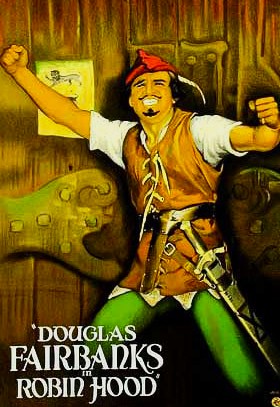

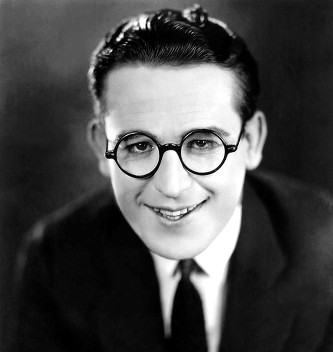
Shuster was a wrestling and boxing enthusiast and Italians like to claim that the original idea of a Superman came from Primo Carnera, the Walking Mountain, Italy's first heavyweight champion, who due to his impressive physique and height came to appear in a number of films and advertising campaigns.
Recently I saw in Rome a portrait of Carnera made by the versatile futurist artist Giacomo Balla. Through its realism and poster-like execution, the painting gave the impression of being an early example of pop art. Balla had obtained a specific effect by covering his painting with metal chicken wire.
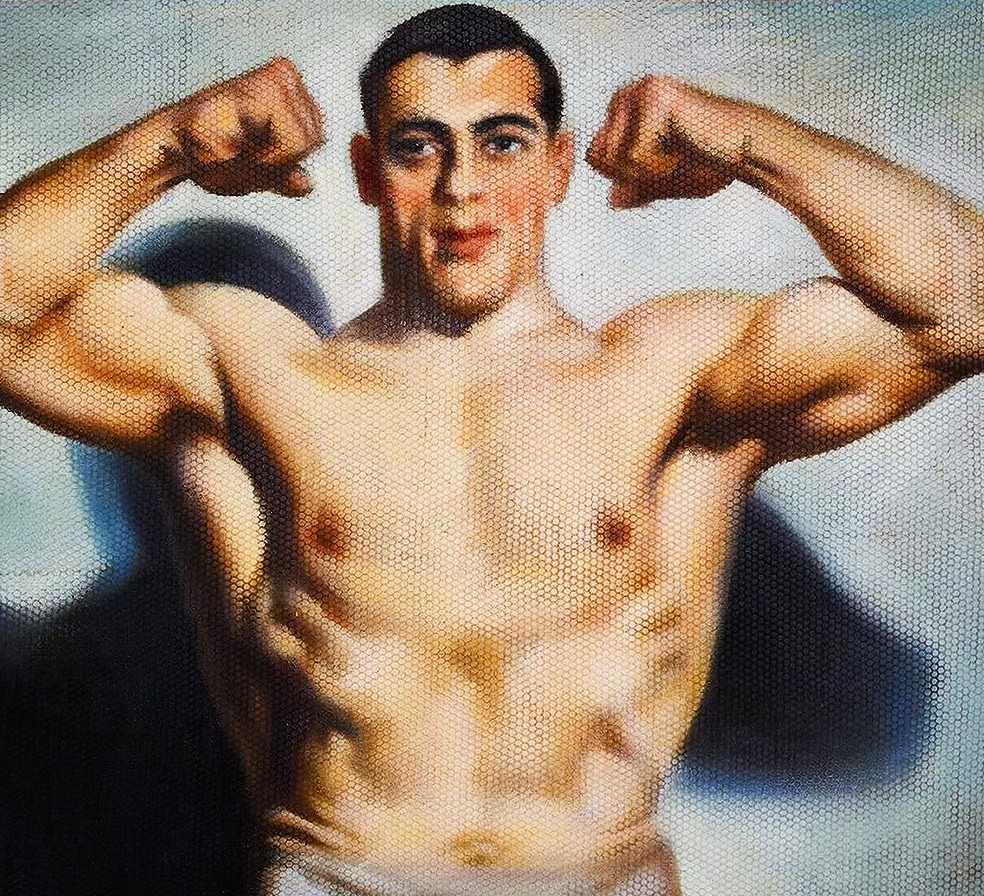
An Italian graphic novel by Davide Toffolo tells the story of Carnera's life and includes an episode in which Jerome Siegel happens to see the huge Carnera get into a car and, like other observers, he becomes deeply moved by the sight of this giant, yet kind and polite man.
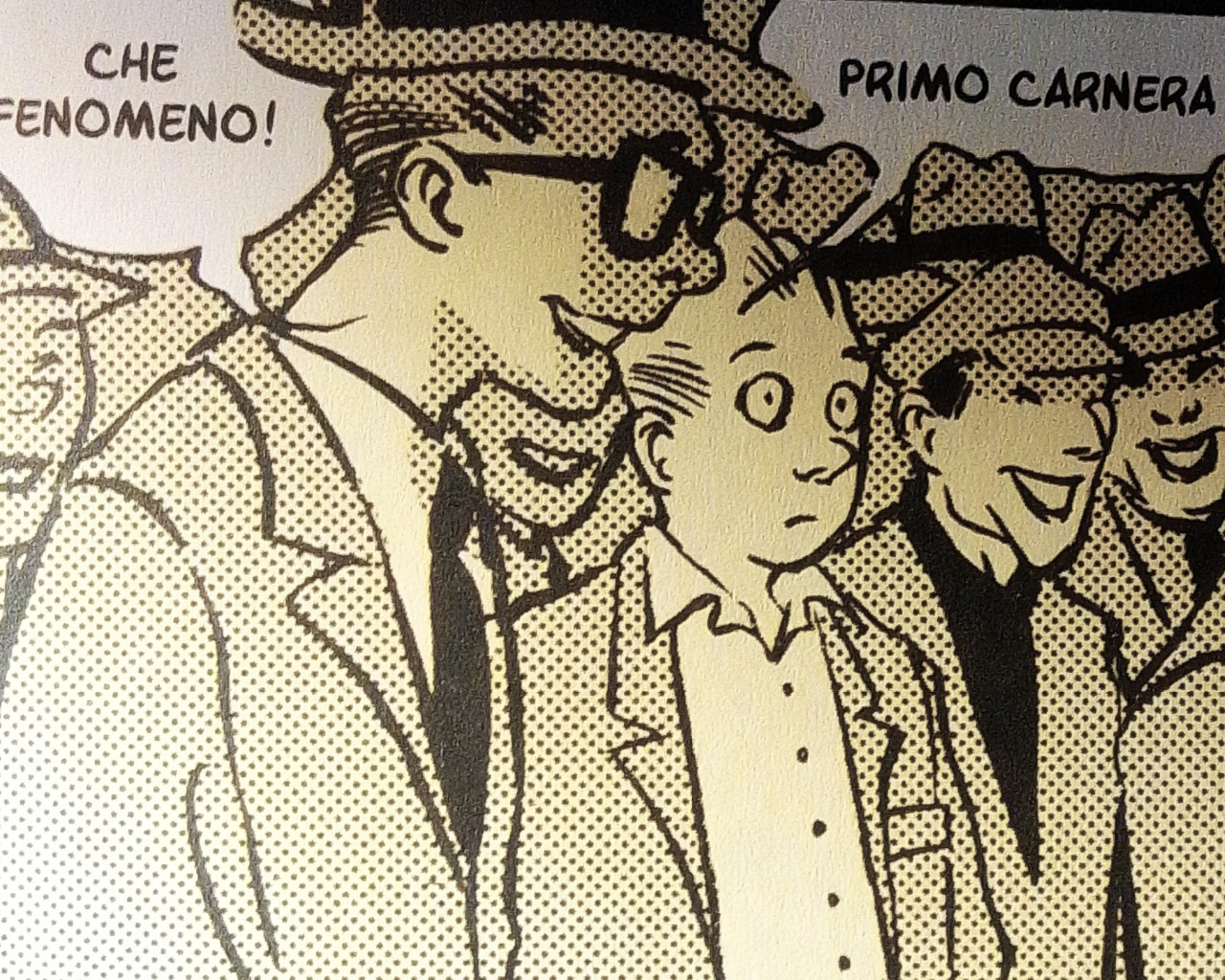
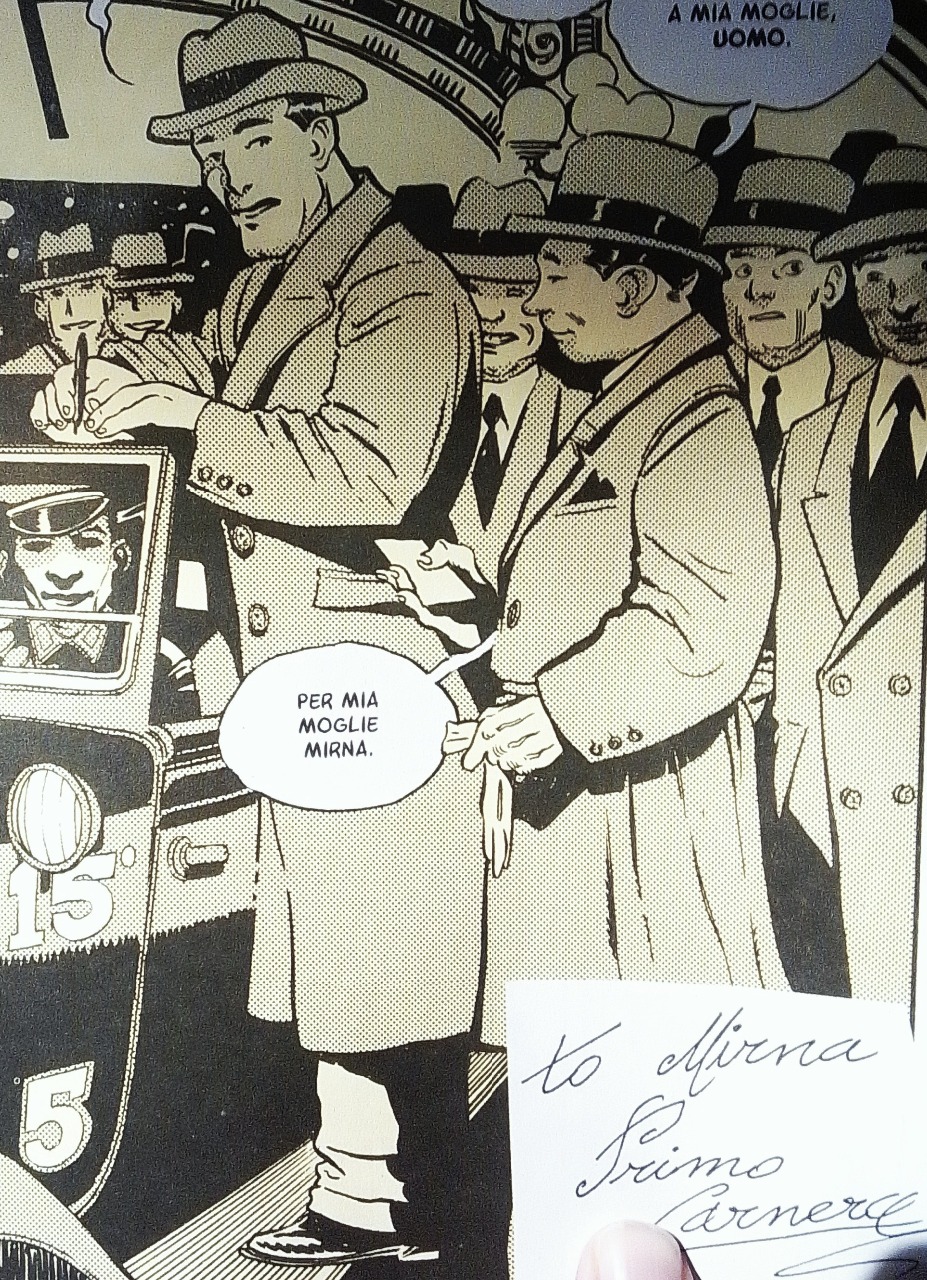
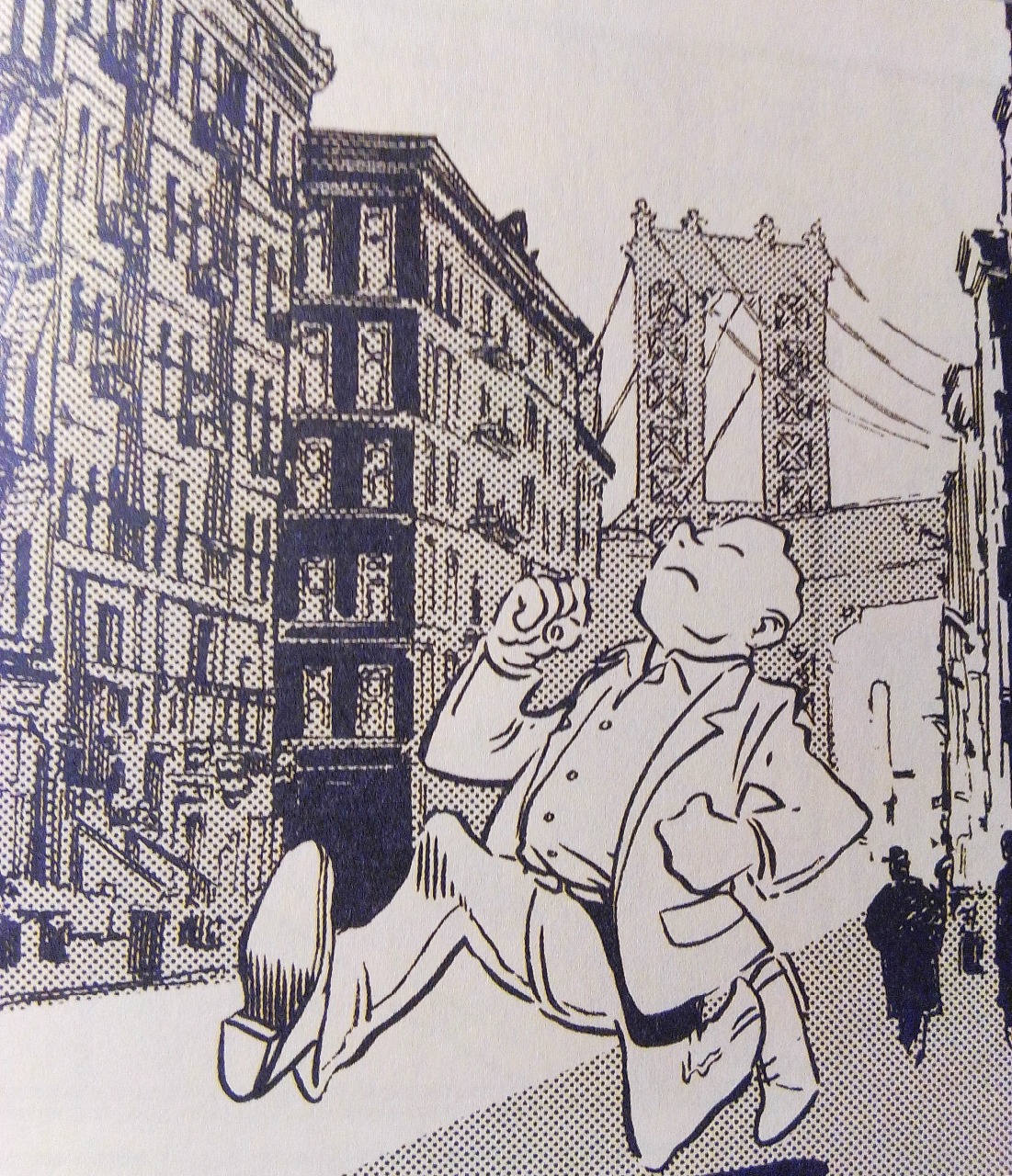
Siegel rushes back to the studio he shares with Shuster, and soon they've come up with the perfect basic idea for their creation – Superman.
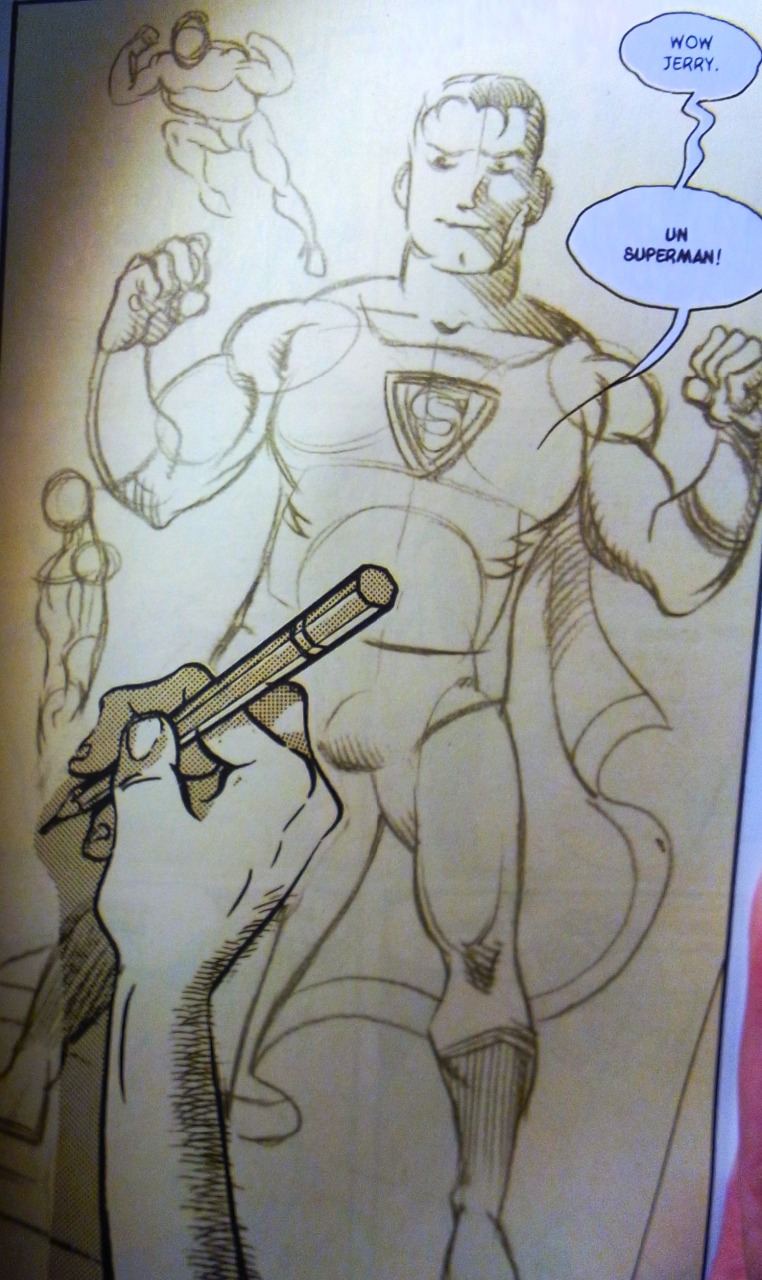
During my childhood I read with great interest several comics about various superheroes, but the world that gripped me the most was probably Donald Duck's and especially Carl Banks' depictions his adventures together with his nephews Huey, Dewey, and Louie, Scrooge McDuck, Magica De Spell, the Beagle Boys, Gladstone Gander, Daisy Duck, the Junior Woodchucks, and Gyro Gearloos, all of them characters invented by Banks.
I can still remember several of my favourite adventures which took place in exotic places; searches for the Fountain of Youth, how the ducks ended up in the land of square eggs, or on a frozen Viking ship. There were zombies, harpies and other fascinating figures, everything that could excite an easily impressed kid like me.

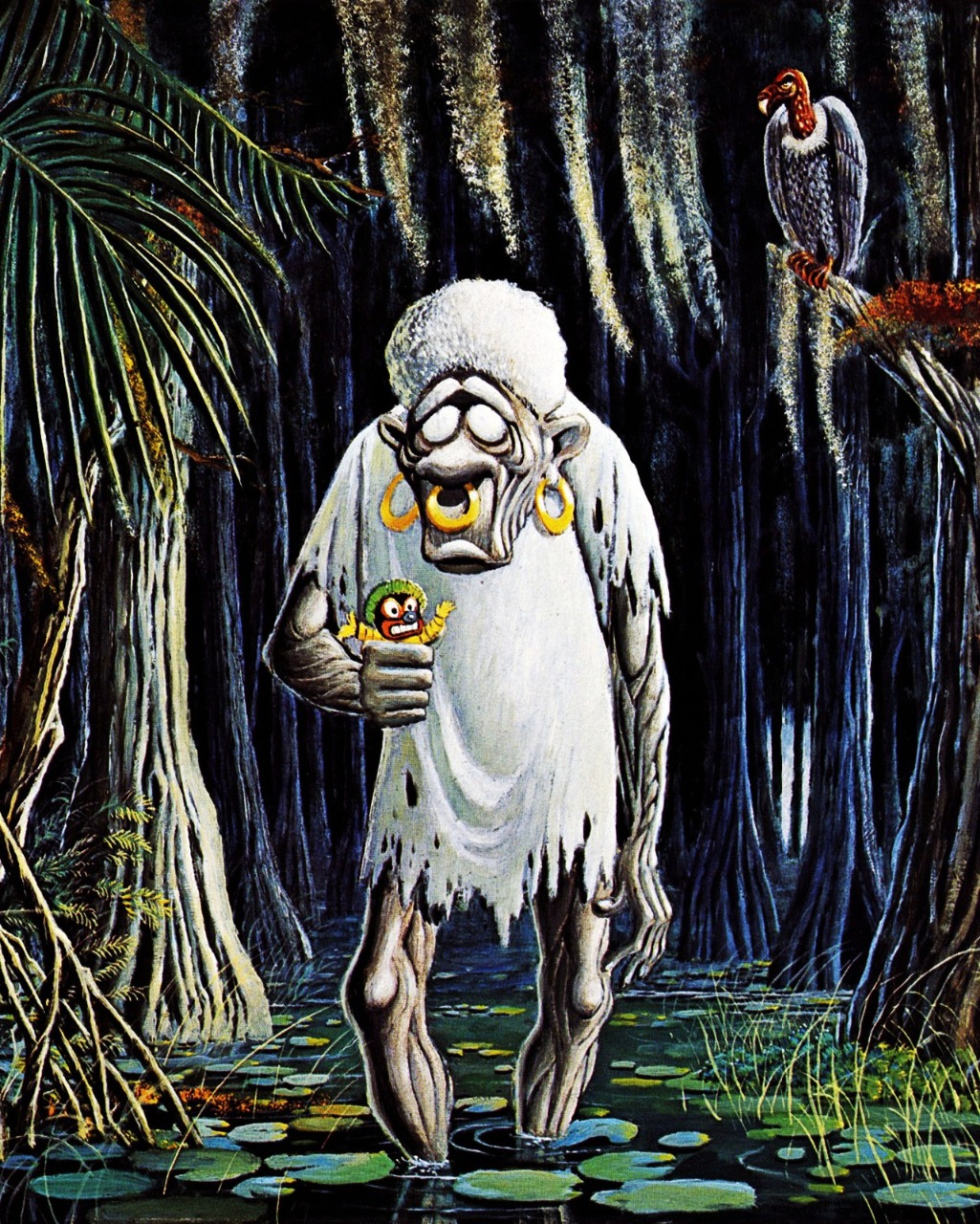
I remember how I enjoyed all this and how the matinees' appearance of Donald´s face told the childish audience that there would now be a cartoon feature, triggering a boisterous cheer.

The archetypal world of Disney is so appreciated and domesticated that it can be used in all kinds of contexts. Even to provide a satirical dimension to an existence that is completely different from Disney's utopian sphere. Like Charlie Christensen's cartoon about Arne Anka – a misanthropic and largely unsuccessful cultural worker, lives in Stockholm's inner city where he spends most of his time drinking with his friends Krille Cocodrile, Sigge Pigg and Micke Miserable. Constantly preoccupied with a largely frustrated pursuit of female companionship and success, the sarcastic duck airs his cynical reflections about the depressing state of the world and the hopeless misery of his present existence.

Arne's outward resemblance to Donald Duck led to lawsuits from the Disney Group, and Christensen subjected his cartoon character to a fake car accident with subsequent plastic surgery and made Arne change his name to Arne X. When the Disney Group abandoned the lawsuit, Christensen let Arne obtain a false beak and thus regain his original appearance and embittered self.

Well, it is now high time to end this far too extensive deep dive into a sea of all kinds of icons. There is much more to write and discover about this phenomenon, but I have to put a stop somewhere. Since I have used more pictures than text, I do this time not attach any list of sources, although I have of course used several of the books I find around me and much information may also be gained from the net.
Nyligen läste jag en artikel om det stora porträtt av Mao Zedong som hänger över porten till den Förbjudna staden. Det väger ett och ett halvt ton och är sju gånger fyra och en halv meter stort.

Väder och miljöförstöring sliter på det och varje år målas därför ett nytt porträtt. Under Maos levnad varierades det diskret för att i viss mån harmoniseras med Ledarens förändrade utseende. Porträttet är målat i olja, förstärkt med fiberglas och plast. Minst nio gånger målades helt nya versioner av porträttet. Sedan 1977 har Ge Xiaoguang målat dem.

Andra konstnärer har varit Zhou Lingzhao som skapade det första porträttet 1949. Xi Mang gjorde ett nytt 1950. Zhang Zhenshi stod för versionerna mellan 1951 och 1963, följd av Wang Guodong 1963 till 1976 och slutligen Ge Xiaoguang.



Förlagan till Zhang Zhenshis porträtt, som tycks ha varit det bästa, utbjöds till försäljning i Berlin 2006 av Beijing Huachen Auction Company, som ägs av Beijings turistbyrå och center för kulturarv och restaurering. Utropspriset var USD 120 000, men försäljningen stoppades i sista stund av Folkrepubliken Kinas regering och det finns numera i Kinas Nationalmuseum.

Zhang Zhenshis porträtt var baserat på ett fotografi taget av Hou Bo (1924–2017). Hon och hennes make Xu Xiaobing var under flera år Maos ”hovfotografer” och tilläts att göra en mängd fotografier av Den store rorsmanen och Kina höga potentater.

Paret bodde vid Mao’s sommarresidens i de Doftande kullarnas nationalpark och umgicks i Maos närmaste krets, något som gjorde att de också tilläts ta privata fotografier av den Ledaren. Flera av Hou Bos fotografier omvandlades av konstnärer till de typiskt minutiösa superrealistiska målningar som i miljonupplagor spreds över hela Kina.



Hou Bo tog även fotografier vid officiella tillställningar och hennes dokumentation av utropandet av grundandet av den Kinesiska folkrepubliken har blivit klassiska.

Innan Ordförande Maos porträtt prydde porten till den Förbjudna staden hade den likaledes uppvisat andra stora porträtt. Först av Sun Yat-sen som därifrån 1911 utropat den Kinesiska republiken och när Chiang Kai-shek efter honom 1928 blev president över Statsrådet, Kinas regering, hamnade hans porträtt över porten. Efter Chiang Kai-sheks flykt till Taiwan har Maos ansikte sedan 1949 varit portens permanenta prydnad.


Den himmelska fridens torg – på kinesiska Tiān'ānmén Guǎngchǎng, Torget vid Himmelska fridens port – blev under Kultrurevolutionen (1966-1976) den absoluta brännpunkten för kulten av Mao och fick sin kulmen då den Store ledarens miljonskaror av fanatiska ungdomar samlades vid massmöten, viftande med Maos Lilla röda och skanderande slagord till den store mannens ära. Vid ett sådant tillfälle befann sig min väninna Sagrada från Domiikanska republiken blad dessa ungdomar och hon har för mig berättat hur Mao, längt däruppe på läktaren ovanför sitt porträtt tog en av de honom närstående i handen och hur detta handslag sedan gick från den ena till den andra över hela torget. En förmedling av gudomlig kraft inte olik tanken bakom den kristina kyrkans ”apostoliska sucession”.

Maos bild vördades som om den vore en helig ikon. Skaparen av ett av de jättelika porträtten som pryder porten till den Förbjudna staden, Zhang Zhenshi, har i en intervju berättat hur han under Kulturrevolutionen, hamnade i trångmål efter det att en ”studentkader” anklagat honom för att förvanska sina porträtt av den Store rorsmannen genom att i sina framställningar ha förminskat Ledares ärevördiga anlete då han framställt honom på ett sådant sätt att enbart hans ena öra blev synligt. Detta har åtgärdats på senare kolossalporträtt, men inte på de yuansedlar som pryds med Maos anlete.

Under min ungdom fanns även i det från Kina så avlägsna Lund de som klädde sig i mao-overaller och med stolthet bar en liten knapp-ikon försedd med en bild av Ordförande Mao, liksom amerikanska politiker numera måste bära en flag pin med den amerikanska fanan.


Under den tidens talrika demonstrationer var det också vanligt att bära med sig plakat med Ordförande Maos ansikte. Ofta i form av Zhang Zhenshis legendariska porträtt

Den milt sagt kontroversielle och anarkistiske konstnären Lars Hillersberg gjorde i det hänsynslösa magasinet Puss sig lustig över denna persondyrkan och lät i en illustration en folkmassa bära porträtt av okända medborgare.

Den Himmelska fridens torg blev även skådeplatsen för ett ikoniskt framträdande av en person som förblivit känd. Mellan den 15:e april och 4:e juni 1989 hölls omfattande studentdemonstrationer på torget och dess omgivningar. Man demonstrerade mot korruption inom det styrande kommunistpartiet och krävde större demokratiska och mänskliga rättigheter. Protesterna slogs slutligen ned med hänsynslöst våld. Enligt officiella källor dödades några hundra människor, men inofficiella tal pekar på upp emot 3000 dödsoffer.
Den 5:e juni, efter att ha ”säkrat” torget, började militären återta kontrollen över stadens genomfartsleder. En kollon stridsvagnar från 1:a pansardivisionen lämnade torget, men i riktning österut, på Chang'an Avenyn, hindrades frammarschen av en ensam demonstrant som ställt sig mitt på avenyn. Det korta dödläget mellan mannen och stridsvagnarna fångades av västerländska journalister, som befann sig Beijing Hôtels takterrass. Vem ”Tankmannen” var och vad som hände honom har förblivit okänt, men magasinet Time utsåg honom till en av förra seklets ”100 mest inflytelserika människor” och den okände manen har blivit en symbol för personligt mod gentemot förtryckande regimer. Med andra ord – en Frihetens ikon.


https://www.youtube.com/watch?v=FaojdRThXbY
Men . . . vad är egentligen en ikon? Det grekiska ordet betyder helt enkelt ”bild”, eller ”likhet”, men ordet kom tidigt att beteckna bilder på vördnadsvärda, inflytelserika personer, eller framställningar som hedrade avlidna nära och kära, som de berömda mumieporträtten från Faiyum-oasen som under Antiken förutom inhemska egypter hyste en stor grekisktalande befolkning.


Då man talar om ikonmåleri har det främst kommit att beteckna en konstform som finner sina rötter i 300-talets kristna måleri från, i synnerhet de målningar som förekommer i Roms katakomber.


Redan tidigt fanns det dock ett våldsamt kristet motstånd mot avbildningar. Den kristna fornkyrkan var nära kopplad till judendomen och man följde i allmänhet dess bud och förordningar, inte minst Andra Mosebokens förbud (20:4): ”Du skall icke göra dig något beläte eller någon bild, vare sig av det som är uppe i himmelen eller av det som är nere på jorden eller av det som är i vattnet under jorden. Du skall inte tillbe dem eller tjäna dem.” Man fick alltså inte göra änglar, människor, eller djur till föremål för dyrkan, sådan kunde enbart riktas till Gud. Man fick heller inte försöka avbilda, eller ens föreställa sig Guds gestalt, eftersom hans skepnad var långt bortom mänsklig form och föreställning.
Den antika världen där kristendomen växte fram och kom att frodas var dock en värld där bildkonsten fanns överallt. Inom en sådan överväldigande och raffinerad visuell miljö kunde ett bildförbud inte vidmakthållas under någon längre tid. Snart blev ikoner, dvs. bilder, rikligt förekommande även inom den kristna kulten.
Nedanär den första kända framställningen av Kristus Pantokrator, den Allsmäktige, alltså Jesus som den inkarnerade gudomen. Ikonen är från 500-talet och bevarad i det legendariska Sankta Katarinaklostret vid Sinais fot. Bilden och är en av klostrets fler än 2000 ikoner, skapade från 500-talet och in i modern tid.

Inom den kristna kyrkan hade så småningom uppfattningen att man kunde avbilda Kristus, Gud och helgonen segrat. Argumentationen gick ut på att alla dessa gestalter hade mänskliga kroppar. Hade inte Gud skapat människan till sin avbild? Och Gud hade genom Jesus Kristus blivit människa, med en kropp som gick att uppfatta med mänskliga sinnen, därmed kunde även Guds och Jesus kroppsliga manifestationer avbildas. För övrigt … det gammaltestamentliga förbudet gällde ju innan Gud genom Jesus hade uppenbarat sig i en kroppslig gestalt.
Den knepiga frågan kring bildframställningar hade under det andra konciliet i Nicea, 787 nötts och blötts av kristna potentater. Konciliet ägde rum medan den ”bysantinska ikonoklasmen” rasade för fullt. Fanatiker krossade såväl antika som kristna skulpturer, medan fresker målades över och ikoner brändes upp, konstnärer misshandlades.
![]()
![]()
Konsiliet beslutade att ikoner och andra avbildningar av det gudomliga förvisso har en betydande funktion inom den kristna kulten. De har en pedagogisk funktion för troende som inte kan läsa, bildkonsten skapar en uppfattning om den kristna frälsningsläran och de bibliska berättelsernas innebörd.
Betraktandet av bilder kan även fylla åskådaren med en känsla av meditativ andakt skapad genom deras prokinesis, dvs. de är åtbörder/tecken på respekt inför det gudomliga och därmed frambringar de mottaglighet för det kristna budskapet, de kan till och med förmedla sådant som inte kan uttryckas i ord. Ikoner besitter porikinesis genom att de är avbildningar och därmed bygger på relationer, men de besitter enbart ”relativa egenskaper”. De är inte gudomliga i sig. De saknar latreia ”absoluta egenskaper”, dvs. samma natur som det gudomliga. Därmed får ikoner absolut inte bli föremål för någon dyrkan. Detta är en styggelse – avgudadyrkan/idolatri. Skillnaden mellan en ikon och en idol är att ikonen enbart anspelar på det gudomligas närvaro, alltmedan idolen är en gudom i sig själv.
Den bästa motsvarigheten till det kristna begreppet idol är antagligen hinduismens murti, i meningen att en avbildning i sig kan innefatta en gudomlig ”själ”, en murta. Avbildningen utgör därmed ett ”förkroppsligande” av en andlig dimension, grundmeningen i ordet murti.

Hatet mot den kristna konsten bedarrade inte i och med det andra nicenska mötet. Bildstormande fanatiker fortsatte att emellanåt dyka upp i olika sammanhang. Då religionskrigen mellan katoliker och protestanter lamslog Europa under femtonhundratalet kunde en protestantisk mobb emellanåt i våldsamt raseri gå lös på kyrkokonsten, lemlästa skulpturer och förstöra målningar,
![]()

Under andra förutsättningar gick franska revolutionärer i början av sjuttonhundra-nittiotalet till storms inte enbart mot monarkins statyer och symboler, utan även mot den kyrkliga makten. Kyrkor brändes ner och skulpturer förstördes.

Revolutionärer har ibland hyst ett oförsonligt hat mot kyrkomakten. Under inbördeskrig i México och Spanien, där konservativa krafter inom Kyrkan ofta anslöt sig till Centralmakten avrättades flera präster och munkar av revolutionärerna, medan kyrkor plundrades. Nedan arbebuseras en präst i México, medan mumifierade nunnor från ett karmeliterkloster exponeras i Barcelona 1936.


Sällan har dock förföljelsen av religion och förstörandet av dess konstskatter fått sådana dimensioner som i Sovjetunionen under tjugo- och trettiotalen, där religionsförakt öppet sanktionerades av statsmakten.

Kyrkor och ikoner förstördes. Mest uppmärksammad blev sprängningen av Moskvas katedral, Kristus Frälsaren, som på Stalins order demolerades den 5:e december 1931.


Meningen var att katedralen skulle ersättas av ett enormt Sovjeternas palats, krönt av en monumentalstaty förställande Lenin, i vanlig ordning med en uppsträckt högerhand.
Det andra världskriget satte dock stopp för det storstilade projektet och platsen för den ödelagda katedralen blev istället världens största swimmingpool.

Efter kommunismens fall återuppbyggdes Kristus Frälsarens katedral och återuppstod år 2000 i all sin praktfulla storhet.

Förstörandet av religiösa byggnader, konstverk och andra symboler i länder som Sovjetunionen och Kina betydde som vi sett dock inte slutet på monumentala konstverk, fast dessa hyllade inte längre helgon och andra avlidna eller utomjordiska, religiösa förebilder. Centrum för dyrkan blev istället jordiska helgongestalter, levande som döda. Stalin fyllde Sovjetunionen med bilder och skulpturer av sig själv och den av honom förgudade Lenin.


Medan Lenin allmänhet avbildades med högerarmen lyftad i en gest riktad mot en strålande framtid så framställde stalinstatyerna för det mesta Ledaren med sänkt högearm eller handen, på napoleanskt manér, instoppad under rocklinningen.
Detta berodde antagligen på att Stalin hade komplex för sin krortare högerarm. Han vid tolvårs ålder skadats svårt då armen blivit klämd under en hästdragen vagn. En omfattande operation hade gjort så att armen blivit kortare och stel vid armbågen.

Leninstatyerna fortsatte dock att framhärda med sina framtidssträckta händer. Något som de exilryska konstnärerna Komar och Melamid roade sig med då de till ett The New Yorker omslag framställde Lenin på besök i New York medan han framför McDonalds hejdar en taxi.

Den groteska idoliseringen av ledare som Lenin, Stalin och Mao har inte hindrat deras efterträdare från att under sin livstid efterapa denna förgudning och låta sig själva bli framställda genom ikoner och skulpturer.
Som Kazakstans diktator Nursultan Nazarbayev, som efter att livligt ha blivit understödd av Putin tvingades avgå 2022:

Hans efterträdare Kassym-Jomart Tokayev har dock redan fått sig förärad en staty i grannlandet Kyrgyzstan, där han sitter och samtalar med dess president Sadyr Japarov, som tillträdde 2021.

Sadyr Japarov har för övrigt redan funnit ett tillfälle att resa en staty över Putin:

I Kyrgyzstan och Kazakstan sitter idolerna i stolar, men i Turkmenistan Gurbanguly Berdymukhamedov ett strå vassare och har låtit sig framställa sittande till häst, täckt i guld och placerad på ett högt, lysande vitt och konstgjort berg.

Skulpturen är större än statyn av Berdymukhamedovs företrädare, Turkmenbashi. Även han guldbetäckt och placerad högt upp på en bastant pelare.

Jag vet inte om Nordkoreas nuvarande diktator Kim Jong-un ännu har låtit resa en staty över sig själv, men landet hyser ett otal statyer över hans farfar Kim Il-sung (hos vilken vi känner igen Lenins gest) och fadern Kim Jong-il. De största statyerna är mer än tjugo meter höga och omgivna av groteska riter.

Jag undrar vad det är som driver dessa groteska diktatorer att resa skulpturer av sig själva och tvinga sina undersåtar till en undrgiven dyrkan av deras uppblåsta egon.
En löjligt självupptagen, självberikande och ovanligt blodtörstig diktator var Trujillo, som i Dominikanska Republiken lät döpa huvudstaden och landets högsta berg efter sig själv och under sin livstid fyllde landet med sina byster och statyer. Varje dominikanskt hem ar tvingat att ha en plakett som omtalade att Trujillo var dess beskyddare och herre.


Är denna ständigt närvarande diktatoriska galenskap ett sätt att övertyga medborgare om att de är ständigt övervakade, ständigt kontrollerande, som den allseende Storebror i Orwells kusliga 1984.

Något som egentligen inte är en illusion eftersom flera av dessa diktatorer haft och har en effektiv hemlig polis, beredd att stå dem till tjänst med mord, tortyr och annan terror.
Hitler stöddes sin mäktiga Gestapo, Stalin av KGB och den stora mängden mindre självhärskare har även de haft sina mordiska hantlangare. Kina har sitt Ministerium för Statssäkerhet, Kazakstan KNB, Turkmenistan MNB, Saudi Arabia Mabahith, Venezuela SEBIN, Sudan NISS, Ryssland FSB, enbart för att nämna några av de mest välkända och hänsynslösaste hemliga organisationerna. I Iran finner vi VAJA, som under olika beteckningar ersatte Shahens SAVAK, även han en underlig självhärskare som älskade att styra ut sig i lånta fjädrar och posera för ikonografiska porträtt, exempelvis ett av den kände italienske mästaren Pietro Annigoni.

Kanske det endast rör sig om att göra intryck på världen och garantera sitt eftermäle. Genom en bild, en ikon, försöker de förvandla sig till idoler. De vill omvandla sig som om de vore en gudomligvorden närvaro – helgon förtjänta av sina undersåtars dyrkan. Ett helgon är ju förmer än en bild, ett ideal. Ta Moder Teresa, som i många människors tankevärld blivit identisk med osjälvisk självuppoffring, en symbol för godhet. Är hon värd all denna dyrkan?
Jovisst, hennes orden är nu verksam på 610 platser i 123 länder, med vårdhem och boenden för människor med HIV/AIDS, spetälska och tuberkulos. Hennes nunnor ger familjerådgivning, sköter barnhem och skolor. Den lilla, ledbrutna damen med sitt vänliga leende blev identisk med en självuppoffrande, innerligt kristen godhet.
Men den lilla kvinnan sjönk i min aktning då jag under min tid i Dominikanska Republiken fick se henne omfamna den haitiske diktatorn Baby Doc och hans hustru, miljonärskan Michèle Bennett Pasquet, detta i Amerikas fattigaste land, där folk levde i skräck under Duvalier-regimens fruktade hemliga polis, de ökända Tonton Macoutes. Moder Teresa hyllade det otäcka paret för deras generösa bidrag till hennes verksamhet och hyllade den vackra häxan Michèle med orden:
Jag har mött många människor; kungar, presidenter och premiärministrar, men jag har aldrig sett fattiga människor vara så förtrogna med sina statsöverhuvuden som de var med henne. Det var en vacker lärdom för mig.

Urghh! Det vände sig i magen på mig. Visste inte den helgonlika Teresa med vilka hon umgåtts och hyllade så innerligt? Sedan fick jag veta att Moder Teresa glatt och tacksamt tagit emot pengar av och hyllat millionärer som Charles Keating och Robert Maxwell.
Som kejsar Vespasianus konstaterade: ”Pengar luktar inte”. Under 1980-talet, då jag på TV sett Moder Teresas besöka Haiti var Charles Keating VD för American Continental Corporation och Lincoln Savings and Loan Association. När Lincoln Savings 1989 gick i konkurs kostade det USA:s federala regeringen över 3 miljarder dollar och cirka 23 000 kunder lämnades med värdelösa obligationer. I början av 1990-talet dömdes Keating i både federala och statliga domstolar för bedrägeri, utpressning och konspiration.

Och Robert Maxwell? En stormrik mediamogul som förskingrade hundratals miljoner pund från sina egna företags pensionsfonder alltmedan han levde i lyx på sitt gods utanför Oxford, om han inte var ute till havs på sin lyxyacht, Lady Ghislaine, uppkallad efter sin sorgligt ryktbara dotter; societetsdam och dömd sex trafficker

Dessvärre är räkenskaperna för Moder Teresas orden otillgängliga. Även om exempelvis indisk lag kräver att välgörenhetsorganisationer offentliggör sina räkenskaper så ignorerar Moder Teresas organisation denna föreskrift. Det är inte känt om finansministeriet i Delhi, som skulle ansvara för välgörenhetsorganisationernas räkenskaper, har de faktiska siffrorna och vid förfrågan ges svaret att uppgifterna är ”hemligstämplade”.
Det enda land där finanserna gått att granska har varit Great Britain, där man uppskattat att endast sju procent gått till Madre Teresas verksamhet, uppenbarligen vilar det mesta inom ett oredovisat konto på Vatikanen.
Moder Teresa hade strikta åsikter mot abort som hon ansåg vara ett brott i paritet med nazisterna judeutrotning. Hon pekade på den andliga nyttan av ett liv i fattigdom, en åsikt som tycktes harmonisera med den brist på adekvat sjukvård som gavs de fattiga i hennes ordens vård, trots att organisationen hade stora banktillgångar. Diagnostiseringen var godtycklig, smärtlindring bristfällig och få utbildade läkare var verksamma inom organisationen. Däremot lades stor vikt vid att alla de som togs in för ”vård” borde döpas och alla döende fick systematiskt ett kristet dop oavsett deras religiösa övertygelse. Jag vet inte omförhållandena har förbättrats, men Moder Teresa är definitivt inte mitt helgon .

Jag är heller inte riktigt klar över den i Italien så oerhört populäre Padre Pios helgonskap, annat än att han kunde uppvisa stigmata. Kanske uppkom de genom gudomlig inverkan, men elaka tungor säger att han på egen hand hjälpte den gudomliga försynen. Visst, den förmögenhet som i Pietrelcina samlades in genom alla allmosor ledde till uppförandet av ett av Italiens bästa sjukhus, fast grundfinansieringen kom från Emanuele Brunatto, som skaffat sina miljoner genom svartabörsaffärer i naziockuperade Frankrike och FN:s fond understöd och rehabilitering (UNRRA) som efter Andra världskriget hjälpte flyktingar och fattiga över hela det krigsdrabbade Europa.
Padre Pio var kanske i och för sig OK, hans helgonstatus grundar sig på alla de mirakel som folk säger ägde rum kring honom. Hans predikande var inte speciellt märkvärdigt, men han levde ett enkelt liv och konstaterade att:
Lidande är ett särskilt tecken på Guds kärlek, ty det får dig att likna hans gudomlige son genom den ångest han kände i öknen och på Golgata.
Här i Rom ber man bland annat till Padre Pio för att finna en parkeringsplats och man finner hans bild överallt – i barer, bilverkstäder och speceributiker.

Kända mäns och kvinnors porträtt har blivit som bysantinska ikoner. De sammanfattar i sig en alldeles speciell dimension, fylld av anspelningar, hopp och inspiration. Einstein står för intelligens och allmän genialitet.
.jpg)

Sigmund Freud är också kopplad till genialitet, men om Einstein är urtypen för ett geni så rör sig idéerna kring Freud även om det undermedvetna driftslivet och framför allt – sex.


Chaplins anarkistiske och fattige vagabond har blivit till sinnebilden för film och humor.


Karl Marxs ansikte kopplas samhällskritik och revolution i dess mer intelligenta tappning.

.jpg)
Che Guevara blev även han ett revolutionens helgon, men mer än Marx är han föremål för en ungdomlig kult. Che såg bra ut och utstrålar i sina porträtt en inre glöd. Om Padre Pios bild pryder italienska småföretagares verkstäder och butiker så satt/sitter Che Guevaras ansiktsbild över hela världen uppnålad i radikala ungdomars rum och lägenheter.

Likt målningen av Mao som pryder porten i Beijing finner Cheaffischen sitt ursprung i ett fotografi. Alberto Korda valde ut det bland en mängd fotografier han tagit den femte mars 1960, under en minnesceremoni för offren för La Coubre-explosionen. Korda har sagt att han valde bilden på grund av Guevaras ansiktsuttryck, som enligt honom speglade absolut oförsonlighet, ilska och smärta. La Coubre var ett franskt fartyg lastat med 76 ton belgisk ammunition. Mot alla regler hade det förtöjts vid kajen i Havanna (fartyg med farlig last skall lossas ute till havs) och då det exploderade dödades mellan 75 till 100 personer. Kuba anklagade USA för attentatet.

Stiliga revolutionärer har onekligen en ikonografisk genomslagskraft. Mexikos Emiliano Zapata blev en sådan kraftfull symbol, till och med stiligare än Marlon Brando som spelade honom i Elia Kazans utmärkta film Viva Zapata från 1952.


Uppseende huvudbonader tycks ofta vara del av minnesvärd ikonografi. Ches basker blev exempelvis under en tid en uppskattad utstyrsel för militanta ungdomar, exempelvis USA:s Svarta pantrar.

Senare ersatte flera radikala ungdomar baskern med Maos mössa.

Numera kan man markera sina åsikter genom att bära en palestinsk kefiah.

Redan sjuttonhundratalets franska revolutionärer särskilde sig från reaktionärerna genom att bära en frygisk, röd “frihetsmössa”.

Talibaner bär gärna en pakolhatt.

Medan radikala feminister kan solidarisera sig med den förföljda ryska feministiska punk-, protest- oh performancegruppen Pussy Riot, genom att bära en stickad pussymössa.

Ett modeinriktat motstånd liknande de stickade mössor med mönster och färger från det brittiska Royal Air Force, RAFs runda logo, som en del holländare bar under naziockupationen.

Det är dock inte alltid som en hatt eller mössa antyder radikalitet. Kemal Atatürk införde exempelvis 1925 sin “hattlag” som stipulerade bärandet av västerländska hattar istället för fezen, som Sultan Mahmud II 1826 infört som obligatorisk huvudbonad för alla osmanska tjänstemän. Atatürk betraktade fezen som ett tecken på Turkiets efterblivenhet.

Ett konservativt hattmode är även Trumps osmakliga huvudbonad.

Eller kanske till och med den mer imaginära Marlboromannens cowboyhatt, som anspelar på ett tufft och hårdhänt uteliv, en tillvaro som kräver en rökande machokille.

Marlboromannen finner kanske sin urbana motsvarighet i filmvärldens skarptungade privatdetektiver som personifierats i Humphrey Bogarts hattförsedde Philip Marlowe.

Någon som rör sig i samtliga miljöer är den atletiske och samtidigt intellektuelle arkeologen Indiana Jones, även han sentimentalt bunden till sin hatt.

Urtypen för en urkonservativt totalitär huvudbonad var den preussiska pickelhuvan som hos Kejsar Willhelm II kompletterades med ett par uppåtsträvande mustascher.

Mustascher kan för övrigt också vara en ikonografisk markering. Tänk exempelvis på Hitlers mustasch som i kombination med hans frisyr räcker för att anspela på honom.

Även den oförliknelige, skicklige och ironiskt kommersiellt medvetne Salvador Dali använde sin mustasch som ett varumärke.

Den än mer kommersialiserade Andy Warhol, som upphöjde kommersialism, kändisskap och laissez faire till en konstform, visste att i sin ytligt särpräglade konst utnyttja ikongrafiska porträtt, ofta med ett märkligt estetiskt tilltalande resultat. Hos Warhol finner vi exempelvis en i det närmaste otrolig mängd versioner av ikoniska porträtt. Bilder som redan innan Warhol manipulerade dem var tämligen slitna och välkända, inte minst porträtt av Mao, Lenin och Marilyn Monroe.



Som så mänga andra konstnärligt framställda ikoner var Warhols porträtt baserade på fotografier, en konstform som även den ständigt producerar ikoner. Tänk exempelvis på de skickligt iscensatta fotografierna av Marilyn Monroe och Igor Stravinsky.


Eller Winston Churchills segergest som under Andra världskriget skänkte britterna mod och hopp och sedan dess har blivit en internationellt förkommande symbol.

Den flyhänt mångfacetterade Andy Warhol har allt som oftast tillerkänts en ikonisk logo som han inte skapat, men som blivit till en symbol för en frispråkigt, oförskämd ungdomskultur, fylld med förakt gentemot etablissemang och god smak – Rolling Stones utsträckta tunga.
Det var alltså inte Warhol som åstadkom denna ikoniska bild, utan en ung John Pasche som studerade vid Royal College of Art i London. Den ekonomiskt sinnade Mick Jagger hade bett Rolling Stones huvudkontor att kontakta skolan och be dem identifiera en ung talang som skulle kunna komma upp med en anslående symbol för rockgruppen.
Valet föll på Pasche, men hans ursprungliga förslag föll inte Jagger i smaken. Han hade tänkt sig något mer exotiskt och visade Pasche en bild på den hinduiska, skräckinjagande dödsgudinnan Kali.
Kali, den Stora Modern som likt den eviga tiden förgör allt, men likväl består. Hon är den oförsonliga naturen som med sina rovdjur och offer likväl består. Hon retar och hånar oss med sin utsträckta tunga och genomskådar vår sociala fasad, ser de mörka begär vi förnekar och undertrycker. Hon tvingar oss ner i vårt förflutnas skam, så att insikten om våra brister gör så att vi kan födas på nytt.

Pashe fascinerades av gudinnans utsträckta tunga och i ett ögonblick av inspirerad begeistring kom han upp med vad som blev ett popkonstverk – en syntes av verk av betydande popkonstnärer som Warhol, Ruscha, Ramos och Lichtenstein.

Tillbaka till huvudbonadernas ikoniska betydelse. Det är inte enbart som symboliska markeringar för ideologisk övertygelse som en hatt eller mössa kan få en viss betydelse, de kan även associeras med beundrade män och kvinnor. I Indien associerar man exempelvis den unge frihetshjälten Bhagat Singh (1907-1931), som hängdes av engelsmännen, med hans hatt.

John Lennons mössmodell bars av många av hans fans, gärna i kombination med hans runda glasögon.

En annan person som i det närmaste blivit identisk med sin hatt är den nicaraguanske revolutionären Augusto Sandino (1895-1934), som mellan 1927 och 1933 kämpade mot USA:s ockupation av sitt land. Efter att USA dragit sig tillbaka blev han ett år senare avrättad på order av kuppmakaren Anastasio Somoza.

Sandino är en av många ikoniska figurer som blivit till något av en symbol för det land de kämpat för. Sådana landsfäder finns det gott om. Som Garibaldi, Gandhi, Mandela och Atatürk, för att nämna ett fåtal gestalter som numera finns avbildade som statyer och en uppsjö av bilder.




Som landsfäder, fast ondskefulla sådana, kan man kanske även benämna de diktatorer vars porträtt en gång prytt totalitära regimers kontor och fängelser.



Självförhärligade och patetiskt framställda har de blickat ner på offer och undersåtar. Som efterföljare till denna sorts ikoner kan man möjligen uppfatta de porträtt på sittande presidenter som pryder kontor och ambassader


Allt som oftast är dessa potentater ytterst allvarliga. Kanske till och med något hotfulla vakar de över ambassaders och regeringskontors funktionärer och besökare. Numera har de slips och kavaj och även om de skulle vilja det så visar de sig inte längre i sådan ståt som tidigare självhärskare, exempelvis Napoleon Bonaparte.

En man som för övrigt även han var känd för en något udda huvudbonad.

Men det är inte enbart statsmän/kvinnor som blir ikoner. Även artister, främst rockmusiker. Exempelvis så ägnas den numera avlidne Elvis Presley (fast några fans tror att han fortfarande är i livet) en nästan religiös dyrkan.

En annan ikon är den tidigt bortgångne, karismatiskt otyglade Jim Morrison, sångare och textförfattare för rockbandet The Doors, som 27-årig dog i ett badkar i Paris. En död lika legendomspunnen som hans korta levnadshistoria. Den ikoniska bilden av Morrison kallas Det Unga lejonet och togs av fotografen Joel Lee Brodsky, som gjorde flera av omslagen till The Doors skivor.


Morrisons död kom exakt på dagen två år efter Rolling Stones gitarristen Brian Jones död och ungefär nio månader efter Jimi Hendrix och Janis Joplins död. Dessa musiker dog vid 27 års ålder och har därigenom gett upphov till en mängd myter och konspirationsteorier.



Dessa unga musiker blev ikoner på grund av sin karisma och kunskaper, detta till skillnad från andra idoler som skapats av maktpolitiska skäl. Exempelvis den otrevlige ungnazisten och huliganen Horst Wessel. Han utvecklade en vänskap med Joseph Goebbels och efter det att Wessel 23-årig blivit dödad av två medlemmar av det kommunistiska partiet förvandlades han av sin diaboliske vän till ett nazistiskt nationalhelgon. Wessels främsta grund till berömmelse, förutom en viss musikalisk begåvning och för att ha pryglat upp opponenter, var att han författat Horst Wessel sången som vid sidan av Deutschland Deutschland über alles blev Nazitysklands nationalhymn.
I själva verket var melodin stulen från en sång av okänt ursprung, den så kallade Königsbergssången som sjöngs i en av de s.k. frikårer i vilken Wessel varit medlem. Det skrevs böcker, pjäser och gjordes filmer om Horst Wessel, statyer restes och inspirerande bilder spreds.

Andra mer eller mindre politiskt konstruerade ungdomshjältar dök upp i Sovjetunionen och den Kinesiska Folkrepubliken. Ryssarna hade sin Pavlik Morozov och kineserna sin Lei Feng.


Myterna kring dessa till största delen fabricerade hjältar är väl lika bristfälligt sannfärdiga som hjälteglorian kring andra tidigare dyrkade, men sedermera ofta fallna nationalhjältar.
Från skolan minns jag historierna om den svenske nationalgrundaren Gustav Vasa, som då fortfarande dyrkades som landsfader och nationell symbol. Något som bekräftades av Carl Milles mäktiga skulptur från 1925, som i bemålad ek möter besökaren i entrén till Nationalmuseet och under vilken devisen ”Waren Swenske” står inskriven.

Numera har man konstaterat att Gustav Vasa var en hänsynslös realpolitiker, som med brutala metoder röjde motståndare ur vägen och använde hänsynslös propaganda för att befästa sin makt.
Efter att tidigare givit glans åt olika varumärken har i Sverige kungligheternas propagandamöjligheter minskat. Vad som återstår är väl enbart Kung Oscars sardiner som tillverkas i Norge och som bär Kung Oscars namn eftersom han då varumärket introducerades härskade över såväl Norge som Sverige.

Då Norge skilts från Sverige producerade svenskarna istället Kung Gustafs sardiner, med en snyggare paketering.

Att kungligheter inte längre slår så bra som varumärke är kanske en orsak till varför Wasa knäckebröd, som exporteras över hela världen, numera har tagit bort porträttet på den gamle landsfadern och tyrannen och ersatt honom med enbart varumärkstexten, som för många tappat bort sin ursprungliga betydelse som en hyllning till Landsfadern.


Om en bild blir ikonografisk kan det underlätta försäljningen av den produkt som står bakom den. Något som även gäller inom Politiken. Tag exempelvis Barak Obamas valaffisch, kallad den mest effektiva amerikanska politiska affischen sedan Uncle Sam Wants You.

Obamas valaffisch var så anslående att den fått en stor mängd efterapare och kanske den även i viss mån bidrog till Obamas valseger.

Även den bilden var baserad på ett fotografi och Shepard Fairey som skapade den inte hade bett om lov att använda som förlaga. Det gällde ett fotografi taget av en viss Mannie García, resultatet av Faireys överseende blev en utdragen rättsprocess som Fairey förlorade.

Han dömdes till två års villkorlig dom och USD 25 000 i böter. Dock var Faireys konstverk ett lyckokast och har nu under flera år utgjort en källa till såväl satir som inspiration.




Vid närmare eftertanke är det möjligt att Fairey även inspireras av olika kommersiella föregångare. Obamas abstraherade ansikte får mig att tänka på Kentucky Fried Chickens logo, med dess stiliserade bild av grundaren Colonel Sanders.

Överste Sanders utseende för tankarna till någon pensionerad sydstatofficer, som dragit sig tillbaka för att ägna sig åt matlagning. I själva verket hade Harland David Sanders inte alls varit militär. Beteckningen ”överste” var i hans fall en äretitel som guvernörer i olika delstater kan ge till medborgare som gjort sig förtjänta av tacksamhet för något de gjort för sin stat.
Sanders hade arbetat vid järnvägen, som försäkringsagent, bensinmacksföreståndare, delägare i ett ångbåtskompani och misslyckats med en advokatverksamhet, tills han slutligen under den Stora depressionen börjat sälja specialpanerade kycklingbitar från ett snabbmatsskjul. Denna blygsamma början utvecklade sig till en förbluffande framgångssaga och Sanders slutade sina dagar som miljonär, alltid klädd som den mysövereste han framställde sig som – iförd en elegant, oklanderligt vit kostym, med svart fluga. Han färgade sitt hår och skägg vita, tills de slutligen verkligen blev det.

Egentligen var Överste Sanders varumärke ingen bluff. Han var i viss bemärkelse en sydstatsöverste som ägnade sig åt matlagning. Annat var det med två andra kända varumärken, som även de anspelade på ett ruralt, hemtrevligt Södern, där svarta slavar levt i fred och välmåga tillsammans med sina herrar, som de serverat utmärkt mat.
Under 1940-talet hade kemisterna Huzenlaub och Heron Rogers upptäckt en metod för att förbehandla ris så att det kokade snabbare, men behöll samtliga näringsämnen. Deras risvariant började 1945, tillsammans med andra produkter, av företaget Converted Rice Inc saluföras under namnet Uncle Ben. De blev nästan omgående en stor succé.
Varumärket framställde en äldre afro-amerikansk herre med samma fluga som Överste Sanders. Någon Uncle Ben existerade dock inte, även om Converted Rice Inc. till en början hävdade att Uncle Ben varit en köksmästare och risproducent vars produkter varit så utmärkta att han blev en av den amerikanska arméns främsta risleverantörer.

Kanske hade Converted Rice Inc. inspirerats av de framgångar Chris Rutt och hans kompanjon Charles Underwood haft med sitt varumärke – Aunt Jemima, som bland annat sålde sirap och mjöl för pannkakssmet. De hade 1888 köpt en liten kvarn i St. Joseph, Missouri, men inte funnit något övertygande varumärke för sina produkter. Framgången kom efter det att Rutt under promenad lagt märke till en tämligen grotesk vaudevilleaffisch som inspirerade honom att använda en leende afro-amerikansk Mamy som logo.

Vaudevilleaffischens groteskeri mildrades, Aunt Jemima blev till en leende och moderlig dam som senare kunde användas som promotion i filmsnuttar och tv-reklam.


Såväl Uncle Ben som Aunt Jamima har under senare tid kommit under hård kritik som varande lyckade försök att saluföra produkter med hjälp av rasmässigt fördomsfulla och uppdiktade idealbilder av ett harmoniskt Södern. Liknande kritik har även drabbat det franska Banania, en populär chokladdryck som främst distribueras inom Frankrike, med ingredienser som choklad, bananmjöl, honung och socker. Banania började saluföras under det Fösta världskriget och dess ägare distribuerade stora mängder Banania till fronten under slogan ”till våra soldater ett rikligt näringsämne, lätt att bevara och lagra ”
Företagets ägare, Pierre Lardet, sökte också efter en säljande, ikonisk framtoning, såväl övertygande som exotisk, detta med tanke på choklad- och bananingredienserna. Han kom fram till att det bästa varumärket vore en tirailleur Senegalese, en medlem av de populära infanteristerna från Franska Västafrika. Banania kom därefter att saluföras tillsammans med bilden en lyckligt leende senegales som under en paus i striderna avnjöt sin Banania.

Bilden ackompanjerades med texten Y'a bon, det är gott, för att anspela på den pidginfranska som afrikanerna ansågs tala. I själva verket var uttrycket påhittat. Efter kriget förenklades framställningen till en närbild av en lyckligt leende senegalesisk soldat, fortfarande med texten Y'a bon.
Filosofen och psykiatrikern Franz Fanon, bördig från Martinique, framställde i sin bok Svart hy, vita masker bananiareklamen som ett exempel på hur kommersialism objektifierar människor. Den leende banianamannens fånigt välvilliga leende infantiliserade honom genom att förvandla afrikanen till ett barn, lik de ungar som var Bananias främsta konsumenter. Likt ett barn även han, oförmögen att kommunicera på korrekt franska, använde sig den uppdiktade senegalesen av det barnsliga och påhittade Y’a bon.
.jpg)

Från min barndom minns jag hur afrikaner ofta användes i reklam fòr bland annat choklad, kaffe och lakrits. I min hemstad fanns en affär som i skyltfönstret hade en stor kaffekvarn och som sålde kaffe och te i lösvikt. Jag tyckte att butiken hade en underbar doft och minns en reklambild gjord av den danske konstnären Aage Sikker Hansen som jag inte alls störs av, utan istället betraktar som ett riktigt konstverk.

Kommersialismens figurer och slogans är ständigt närvarande. En del av dem kan vara groteska och retar mig genom sin fulhet. En sådan ikon är McDonalds Ronald McDonald, ”den hamburgerglada clownen", som 1963 debuterade i amerikanska i tv-reklamfilmer vid en tid då clownen Bozos show var det mest populära barnprogrammet.

För många barn blev den hårdsminkade och överdrivet påträngande Bozo dock en skräckfigur, något som återspeglats i en mängd masker och filmer.

McDonalds tv-clown var inte helt lyckad. Han hade alltför mycket av Bozo över sig, så hamburgerkedjan hyrde in clownen Coco. Egentligen Michael Polakov, en lettiskfödd cirkusclown med anor från en familj med gedigen clownbakgrund. Coco var vad som i clownsammanhang kallas för en ”August” och han omvandlade McDonaldfiguren till en färggladare och mindre sinister figur än Bozo.


Ronald McDonald framstår dock som betydligt falskare och hotfullare än en riktig cirkusclown. Jag anser att clowner som utövare av en vördnadsvärd underhållningstradition hör hemma i cirkusmanegen och ingen annanstans, allra minst bör de missbrukas av kommersiella intressen.
Clowntraditionen förstörs då den kommersialiseras. Något även Tomten erfarit då han misshandlats av affärsintressen, som då Coca Cola Company omvandlade honom med hjälp av Haddon Sundblom, född i Michigan men med svenskspråkiga föräldrar från Åland.
Sundbloms Santa Claus hade främst inspirerats av en dikt av Clement Clarke Moore som skrevs 1823. I Moores dikt kommer Santa Claus flygande med en släde dragen av sina renar – Dasher, Dancer, Prancer, Vixen, Cupid, Comet, Donder och Blitzen. Han dyker ner i skorstenen och lägger sina presenter kring julgranen.
Han har ett brett ansikte och en liten rund mage
som skakar när han skrattar, likt en skål fylld med gelé.
Knubbig och fyllig, som en riktigt glad gammal älva.

Moores Santa var liten till växten och hade blivit sotig under sin färd genom skorstenen, mer älvlik än Haddon Sundbloms frodige, store och Ho! Ho!-skrockande Santa. En kommersialiserad figur med inslag från flera håll – exempelvis från den svenska Jenny Nyströms vänlige och charmige tomte, kombinerad med den holländske Sankt Nicolaus och den ryske Fader Frost.


.jpg)
Resultatet blev den odrägligt skrockande tjockis som plågat oss alltsedan han 1931 gjorde sitt inträde hos Coca Cola Company.

I Sverige kommer som bekant Tomten ofta på personligt besök och om han då bär en mask kan han dessvärre förstöra illusionen av att vara en verklig person och även väcka skräck hos de mindre barnen.

Masker framställer ofta ikonografiska figurer, som vissa politiker och monster. De kan ibland vara lika skräckinjagande.


Välkända är även olika karnevalsmasker, som de som i Venedig till och med bars till vardags, så att de som av olika anledningar ville vara anonyma kunde dölja sig bakom dem.


Genom att de dolde personligheten kunde masker tjäna ljusskygga och kriminella syften. Som i en etsning av Daniel Chodowiecki där maskförsedda herrar antastar en skräckslagen ung flicka.

En scen som får mig att tänka på de perversa lebemännen i Kubricks Eyes Wide Shut.

En del masker har blivit ikoner även de. Exempelvis är masken The Scream, den som säljs mest kring Halloween. Masken finner sitt ursprung i en schlaserfilm av Wes Craven, vars filmer även en skräckgfilmshabitué som jag aldrig varit speciellt attraherad av. Även om jag emellanåt ser sådana filmer är jag är mer fascinerad av krypande, psykolgisk skräck än den alltför effektsökande slasher - och splattertradition som Wes Cravens filmer är en del av. I vanlig ordning handlar The Scream om en maskförsedd massmördare.

Det sägs ofta att masken är inspirerad av Edvard Munchs Skriet, något dess skapare, Loren Gitthens, har förnekat.

Gitthens har antagligen rätt i sitt förnekande, speciellt som han pekat på andra mer uppenbara inspirationskällor, som affischen till Pink Floyds The Wall och en del spöken som förkommer i de tecknade serierna om Scooby-Do, speciellt några som dyker upp i en episod kallad Glassdemonerna.


Gitthens nämner också en kortfilm som jag minns från min barndom då jag någon gång såg den på TV och sedan dess haft svårt att glömma, precis som en annan skräcksekvens – Walt Disneys första Silly Symphony från 1929.

https://www.youtube.com/watch?v=gm744AGvknU
Den kortfilm som Gitthens hänsvisar till – Dave Fleischers Betty Boop –Snövit från 1933, är bättre än Disneys dansande skelett och räknas nu som en av den tidiga filmanimationens höjdpunkter. Den skapades till största delen inte av bröderna Max och Dave Fleischer (som står som regissör) utan av Daves assistent Roland Crandall.
Vad som gör den kortfilmen speciell, bortsett från dess överraskande, surreralistiska effekter, är Cab Calloways tolkning av St. James Infirmary Blues. Calloways speciella sång- och dansstil utgör underlaget till kortfilmens centrala scen som utspelar sig i en luguber grotta. En filmupplevelse vida överlägsen Wes Cravens The Scream.

https://www.youtube.com/watch?v=cKOSJ5AAwfc
Cab Calloway uppträdde i flera av Fleischers kortfilmer och under en tid på trettiotalet var han stilbildande på flera områden, som orkesterledare och låtskrivare, men också som särpräglad scatsångare, en skicklig och ytterst originell dansare och inte minst ett modelejon, som genom sin extravaganta zoot suit, inspirerade klädstilen och uppträdandet hos en mängd av Harlems radikala ungdomar.


Det är inte enbart Wes Cravens The Scream som inspirerat en populär mask. En annan sådan, som inte bärs till Halloween, utan istället har inspirerat anarkister och andra radikala ungdomar, är Guy Fawkes-masken som härstammar från James McTeigues film V for Vendetta, en dystopisk thriller från 2005, baserad på en grafisk roman från 1989, skriven och tecknad av Alan Moore och David Lloyd.

Romanen och filmen utspelar sig i en nära framtid där en fascistisk, totalitär regim har underkuvat Storbritannien och ägnar sig åt att genom lögnaktig propaganda och mer eller mindre öppen övervakning kontrollera befolkningen, alltmedan oönskade individer fängslas eller avrättas, inklusive invandrare, homosexuella och människor av annan religiös tro än den kristna.
V är en anarkist och maskerad frihetskämpe vars växande skaror ägnar sig åt protester och minutiöst planerad terrorism. De bär masker inspirerade av Guy Fawkes utseende, en katolsk upprorsledare som 1606 hängdes, dränktes och styckades efter ett misslyckat försök att spränga det brittiska parlamentet i luften.


Ikoniska figurer som kommit att prägla ett allmänt medvetande och som dyker upp i olika sammanhang är utomjordingarna. I sin nuvarande utformning – med små, humanoida kroppar, mjukt slät hy och oproportionerligt stora huvuden, försedda väldiga mandelformade ögon – dök de upp efter det att det amerikanska paret Barney och Betty Hill påstått att de av sådana varelser hade blivit enleverade och förda till ett rymdskepp.

Sin nuvarande, mer definitiva framställning fick dessa utomjordingar efter det att författaren Whitley Strieber i sin bok Communion från 1987 detaljrikt beskrivit sina möten med rymdvarelser. Boken beskrevs som en ”sann historia” och inte som Streibers tidigare verk som en roman. Communion blev en bestseller som gjorde författaren välkänd och förmögen.

Jag antar att Strieber,, liksom en del andra skrupellösa författare, upptäckt att förmenta faktaböcker om alternativ historia och sensationella upptäckter/upplevelser säljer bättre än andra texter.
Det finns flera exempel, inte minst den av mig tidigare uppskattade Colin Wilson som efter intresseväckande och välskrivna faktaböcker som The Outsider och The Occult hamnade i ett kanske lönande träsk av vilda spekulationer och konspirationsteorier. För att nu inte tala om Graham Hancock som blivit miljonär inom samma genre och förutom författandet av ett flertal böcker gavs möjlighet att skapa spekulativa tv-serier som genom sin amatörmässiga och förmenta ”vetenskaplighet” hos flera av sina beundrare skapat en förvriden och fullkomligt ogrundad syn på vedertagen historia.
Redan innan Strieber blev välkänd genom sin Communion hade jag läst hans flyhänt skrivna roman om varulvar i New York, bättre än sin inte helt oävna filmatisering – Wolfen, som dock överskuggades av de samtida berydligt bättre varulvsfilmerna The Howling och An American Werewolf in London.
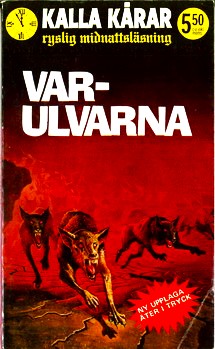

Uppdiktade ikoner som utomjordingar har blivit integrerade i en parallell verklighet som många av oss blivit välbekanta med ända sedan vår barndom. Där lever och frodas inte enbart tomtar och troll utan även varelser som Barbie och bröderna Mario.


En exilryss, Mikhail Bogin, som jag en gång träffade i New York, berättade för mig hur mycket han beundrade de cowboys och gangsters som skapats i USA.
De är geniala! USA är mästare på underhållning. De gör utrotandet av indianerna till en spännande historia, medan allvarliga brott blir utmärkta gangsterfilmer. Folk tror att de segrade i Vietnamkriget och att USA vann Andra världskriget. De har inte en aning om att nazismens nederlag började i Stalingrad. Vad har mitt land kunnat göra av allt elände som finns där? Knappast underhållning. Ingen tror på våra myter, inte ens vi själva. Vem är mönsterarbetaren? Stakhanov? Vem kan tro på sådant? Ingen kan tro på någon Udarnik, Superarbetare. Ingen ryss kan inbilla sig att han kommer från världens bästa land. Men det tror amerikanarna. De tror på sin Konstitution, sin Stålman och sin Kalle Anka. Vi ryssar tror inte på någonting. Politrukerna förstörde religionen och monarkin, de lyckades aldrig ersätta dem.
Superhjältar intar en framstående plats inom ikonernas imaginära värld. Arketypen är Stålmannen som erövrat världen innan Marvels mångfacetterade hjältar och hjältinnor dök upp.

Syålmannen skapades 1938 av barndomsvännerna Jerry Siegel and Joe Shuster. De arbetade tätt tillsammans, med Siegel som textförfattare och Shuster som illustratör. De inspirerades av film och serier.
Stålmannens dubbelnatur föddes ur Zorros och den Röda Nejlikans hemlighållande av sin sanna existens. Stålmannen kosmiska ursprung inspirerades av tidens talrika science fiction-magasin. Kostymeringen hämtades från filmhjältarnas slängkappor och ofta åtsmitande mundering. Karaktärer gestaltade av Douglas Fairbanks i roller som Robin Hood, D’Artagnan, eller Den svarte piraten, men inspiration kom även från fribrottares trikåer. Ansiktet hämtades från Johnny Weismüllers Tarzan och märket som Stålmannen bar på sitt bröst hade inspirerades av filmhjältarnas historieinspirerade emblem. Den mer vardagligt menlöse Clark Kent fick låna sin karaktär och utseende från filmkomikern Harold Lloyd.



Shuster var brottnings- och boxningshabitué och italienare hävdar gärna att ursprunget till Stålmannen kom från Primo Carnera, Det vandrade berget, Italiens förste tungviktsmästare, som genom sin imponerande kroppshydda och längd kom att uppträda i en mängd filmer och reklamkampanjer.
Nyligen såg jag i Rom ett porträtt av Carnera gjort av den mångsidige futuristen Giacomo Balla. Det gav genom sin realism och affischartade utförande intrycket av att vara ett tidigt popkonstverk. Balla hade originellt nog täckt sin tavla med ett kycklingnät av metall.

En italiensk grafisk roman av Davide Toffolo berättar om Carneras liv och innehåller en episod i vilken Jerome Siegel ser hur den väldige Carnera stiga in i en bil och blir liksom övriga iakttagare djupt tagen av anblicken av denne jättelike, men likväl vänligt artige man.



Siegel rusar tillbaka till studion han delar med Shuster och snart har de gemensamt kommit upp med den perfekta grundidén för sin skapelse – Stålmannen.

Visserligen läste jag under min barndom med stort intresse seriemagasinen om olika superhjältar, men den värld som grep mig mest var nog Kalle Ankas Ankeborg och då speciellt Carl Banks skildringar kring Kalle Anka, tjattarna, Farbror Joakim, Björnligan, Alexander Lukas, Magica de Hex, Kajsa Anka, Oppfinnar-Jocke, gröngölingskåren och så mycket annat som Banks skapade.
Jag minns fortfarande flera av mina favoritäventyr som utspelades på exotiska platser; jakter efter Ungdomens källa, hur ankorna hamnat i de fyrkantiga äggens land, eller på ett fastfruset vikingaskepp. Där fanns zombier, harpyor och andra fascinerande figurer.


Jag minns hur jag njöt av allt detta och hur matinéernas porträtt av Kalles ansikte varskodde den barnsliga publiken om att nu skulle det komma ett tecknat inslag och ett våldsamt jubel utlöstes.

Den arketypiska disneyvärlden är så uppskattad och hemtam att den kan användas i alla möjliga sammanhang. Till och med för att ge en satirisk dimension åt en tillvaro som är fullkomligt annorlunda Disneys utopiska sfär. Som Charlie Christensens serie om Arne Anka – en misantropisk och i stort set misslyckad kulturabetare, som bosatt i Stockholms innerstad ägnar det mesta av sin tid åt att supa tillsammans med polarna Krille Krokodil, Sigge Pigg och Micke Misär. Ständigt upptagen av en i stort sett frustrerad jakt på kvinnosällskap och framgång luftar den sarkastiska ankan sina cyniska betraktelser rörande världens eländiga tillstånd, samtidens och tillvarons utsiktslösa elände.

Arnes yttre likhet med Kalle Anka ledde till stämningshot från Disneykoncernen och Christensen utsatte därför sin seriefigur för en fejkad bilolycka med följande plastkirurgi och lät Arne ändra sitt namn till Arne X. Då Disneykoncernen övergav stämningsärendet lät Christensen Arne skaffa sig en lösnäbb och därmed återfå sitt ursprungliga utseende och förbittrade jag.

Nåväl, det är nu hög tid att avbryta denna alltför omfattande djupdykning bland allsköns ikoner. Det finns mycket mer att skriva och upptäcka kring detta fenomen, men jag måste sätta ett stopp någonstans. Eftersom jag den mesta tiden under skrivandets gång använt fler bilder än textkällor så bifogar jag denna gång inte någon källförteckning, fast jag har givetvis använt flera av de böcker jag har omkring mig och mycket står också att finna på nätet.
Many years ago, my oldest sister gave me a lithograph. At the time, she was a flight attendant and had bought it from some bouquiniste in Paris. Certainly, it was not an original, but I have never cared about that, the main thing is the subject – in this case, the lithograph was by Honoré Daumier (1808–1879) and I had it above my bed for several years. It depicted a thin, almost transparent little girl in front of a group of lawyers/judges.
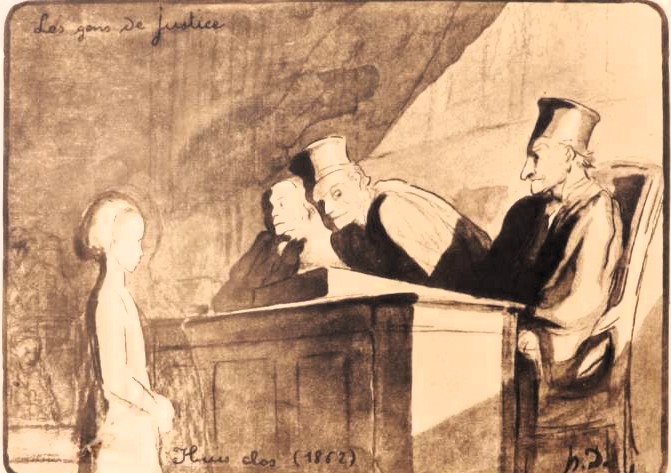
Why had she ended up there? Had she committed a misdeed? Been the victim of crime, or witnessed one? One of the lawyers/judges turns to the viewer. Has anyone said something that caught his attention? Has anyone entered the room and interrupted the proceedings? Accordingly, the viewer becomes part of the drama. I fantasized and dreamed about that lithograph. It was unique; vivid, strange. A fragment from a long-forgotten time.
Daumier? Who was that? He made more than 500 oil paintings, 1,000 watercolors, 1,000 woodcuts and more than 4,000 lithographs, all of them of highest quality and quite unforgettable. One of my brothers-in-law gave me a book with Daumier's lithographs and I never tire of looking at them.
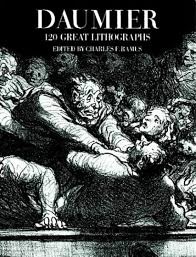
A gold mine of thought-provoking satire, where the independent anarchist Daumier, in a radiant mood, scourges and laughs at the monarchy, the aristocracy, the clergy, the politicians, the judiciary, the lawyers, the police, the detectives, the rich, the military, the bourgeoisie, all his countrymen and human nature in general.
To my surprise, Paul and Linda McCartney made a short film in 1993 called Daumier’s Law. Linda was a professional photographer who had been interested in art since childhood and was particularly fascinated by Daumier. Her mother was a fashion designer and her father a lawyer specializing in legislation related to the art- and entertainment industry. among his clients he had famous artists such as Willem de Kooning and Mark Rothko.
Linda’s interest in Daumier inspired McCartney to compose minimalist music to Daumier's images; simple, modernist pieces, based on themes from Daumier’s art – markets, courts, Don Quixote.
McCartney contacted the artist Geoff Dunbar, who in 1984, together with the McCartney couple had created made an animated short film – Rupert and the Frog Song, which told a story about how the bear Rupert one evening had ended up in a mysterious underground place where frogs every hundred years performed a ritual show, while singing a charming song by McCartney – We All Stand Together, arranged by the “fifth Beatles”, the producer George Martin.
The music video was broadcast time and again on MTV. We were by then living in the Dominican Republic, where the music video channel was broadcast several years before it appeared in Europe. My then two-year-old daughter was very fascinated by McCartney’s frog song, cartoons tend to delight kids, in particular if they are well made. The Rupert film had the aspect of a vintage Disney.

https://www.youtube.com/watch?v=6PMiP90ntZ8
A friend of mine once stated that it was John Lennon who provided the Beatles’ repertoire with its specific flavour, its salt and depth, while Paul McCartney stood for a “superficial folksiness”. He considered Paul’s tunes to be easy-going “pub songs” and that that was all he had produced since the Beatles broke up, apart from some efforts to produce some unsuccessful attempts at highbrow orchestral pieces. Perhaps my friend was right to some extent. In any case, the film Rupert and the Frog Song was deeply rooted in English folksy, children's tradition.
Rupert is an English children's cartoon character created by a certain Herbert Tourtel and illustrated by his wife, Mary. In 1920, Rupert appeared in the Daily Express, where it still lives on.

Rupert is a very English phenomenon. The little, lovable bear who lives with his pipe-smoking, gardening father and housewife mother in a cozy cottage located in a bucolic Nutwood. Each story begins in that cottage from which Rupert usually sets out on a small errand for his mother, or to visit a friend, the story then develops into an adventure in an exotic place, such as King Frost’s castle, the Kingdom of the Birds, in the underworld or at the bottom of the sea.
The stories about Rupert have become an integral part of English children’s culture and have given rise to countless children’s books, films, TV series and dolls. McCartney and Dunbar’s short film is a loving tribute to this cozy, safe and at the same time exciting world. And ... the frog song is for certain an excellent "pub song".
https://www.youtube.com/watch?v=WfEyEp62-l4


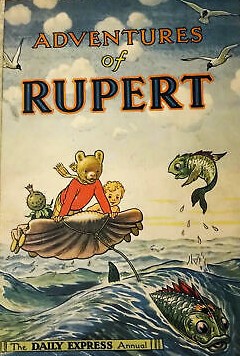
Well, it was natural that Paul McCartney turned to the congenial Geoff Dunbar and asked him to make a short film based on Daumier’s world, based on McCartney’s minimalist music and his and Linda's script. The result is fascinating, especially for someone familiar with Daumier’s art. Almost every sequence alludes to one of Daumier’s many works of art and the animation is skillfully done. The film can actually be considered as an excellent introduction to Daumier’s production.
https://www.youtube.com/watch?v=V-WlJ3ZXZc4
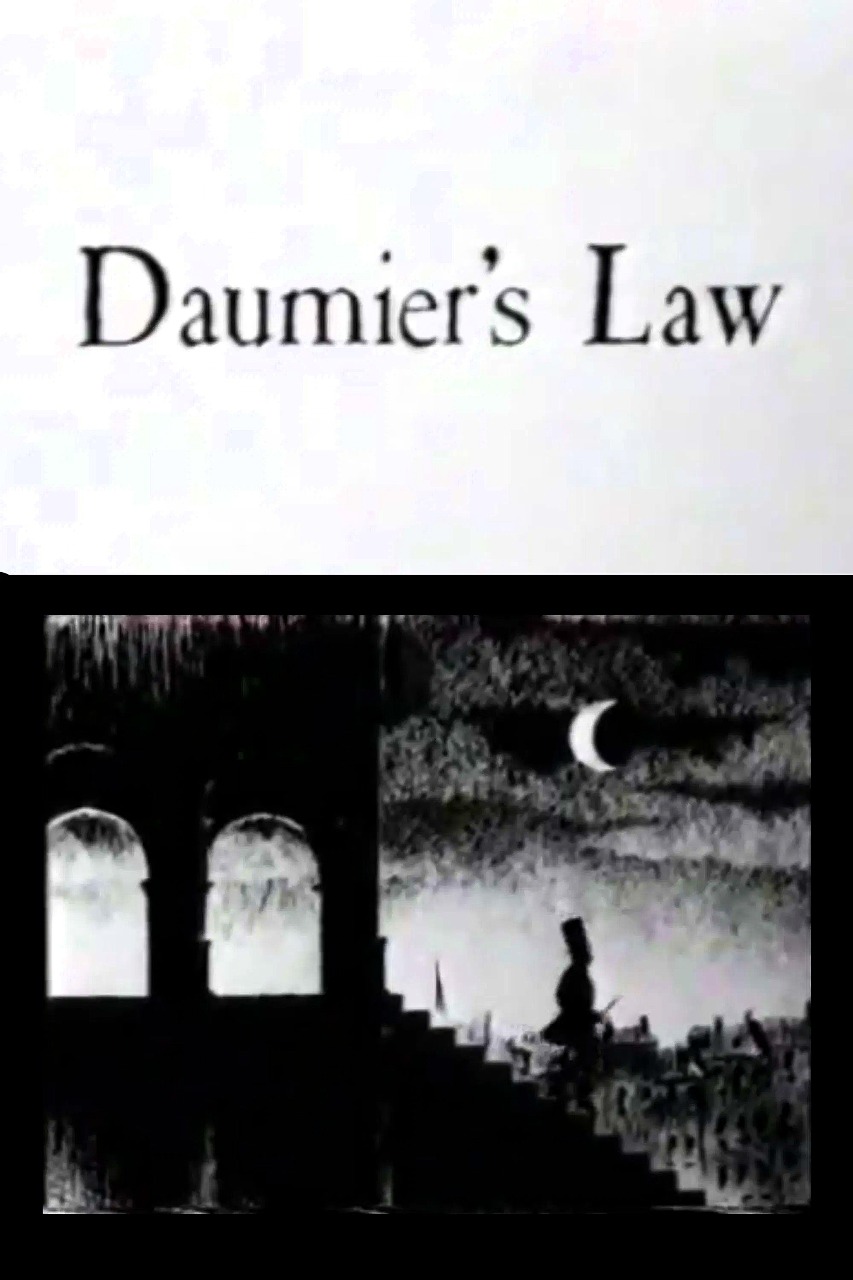
In these times of Trumpism silencing all valid criticism of his regime, which back by Mammon’s minions is back suffocating free speech, my admiration for the shrewd and fearless Daumier has increased even more.
In a previous blog post I gave an example of how even the insignificant me had been silenced by Trump’s stupid censorship, which like a nauseating lump of dough has settled above U.S.’s free speech and in a scandalous fashion has tried to silence comedians like Jimmy Kimmel and Stephen Colbert.
I look with appreciation at a lithograph by Daumier in which the Free Press has dealt a fatal blow to backward monarchy and is preparing to battle representatives of the bourgeoisie and capitalism.
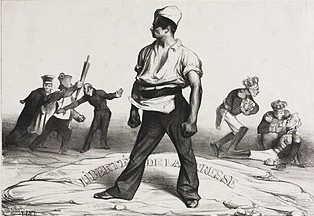
When Daumier made this lithograph, he had already fallen out with the Trumpists of his time. In 1831, in the satirical magazine La Caricature, Daumier had depicted King Louis Philippe I as the giant Gargantua, into whose mouth an increasingly impoverished French population is forced to deliver load after load of its hard-earned income.
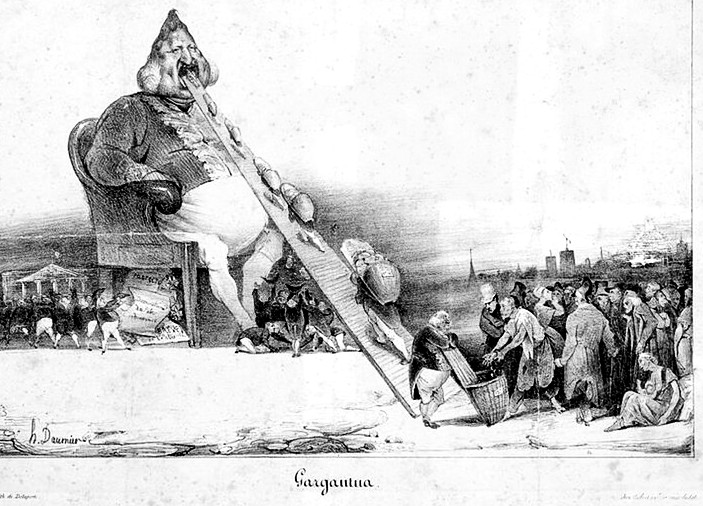
The following year, Daumier was put on trial and accused of “inciting hatred and contempt for the government, and insulting the king.” He was sentenced to six months in prison and a fine of 500 francs. However, Daumier’s fame had already become so great that loud protests were raised against the verdict. The great writer Balzac exclaimed, quite rightly: “This guy has Michelangelo in his blood!” The verdict was postponed, but Daumier did not remain silent.
Later that year, Daumier published a picture he called The Court of King Pétaud in which he caricatured the submissive cabinet of King Louis Philippe I. You do not see the king himself, but a submissive queue of his sycophantic ministers humiliating themselves before him.
.jpg)
This time, Daumier was arrested in his parents’ apartment and placed in the Sainte-Pélagie prison, where he served six months. In prison, Daumier continued to produce his anti-government drawings, which were smuggled out, according to him, to ”further irritate the government.”
The expression King Pétaud's court probably originated from a time when Paris beggar community appointed a leader whose title was Roi Pétaud, from the Latin peto, I pray. This potentate ruled from the Cour des miracles, the Court of Miracles, which referred to a slum area where unemployed migrants from the countryside lived. It was a refuge for poor people who had settled there to hide ways from authorities, who did not dare to enter the mob-ruled quarters. The place was called the Court of Miracles because the lame could walk there and the blind regained their sight, an allusion to the fact that many of those who begged in the streets of Paris did so under a pretence of suffering from various ailments, which they in fact were faked in order to arouse empathy.
In Victor Hugo's 1831 novel The Hunchback of Notre Dame, the poet Gringoire thoughtlessly wanders into the Court of Miracles where he encounters Clopin, whom he had previously thought was an ordinary beggar, but now turns out to be King of the Truands, the criminals and outcasts of Paris. Clopin sentences Gringoire to death for “unlawful trespassing,’ but at the last second, Gringoire is saved by the beautiful Esmeralda who agrees to marry him. Clopin appears in Disney's version of The Hunchback of Notre Dame.

Daumier's reference to Hugo’s contemporary novel and its beggar king could hardly have escaped the Parisian reading public. Louis-Philippe I had initially been relatively popular. Since he owed his throne to a popular revolution, he was called the Citizen King, and his supporters further praised him as King of the Barricades underline the popular sympathies he enjoyed and the king’s outward appearance of modesty. In fact, Louis Philippe’s regime found its support among the wealthy bourgeoisie. His reign was actually dominated by a close-knit group of wealthy industrialists and bankers.
Under the leadership of the Citizen King, the conditions of the working class deteriorated, whole the income gaps widened considerably. Already at the beginning of Louis Philippe's reign, several Parisian intellectuals had noticed that the Government was in fact a plutocracy ruled by the country's wealthiest capitalists, entirely in accordance with their self-centred interests, and beneath the populist surface, class oppression increased, while denunciation spread and opposition was silenced.
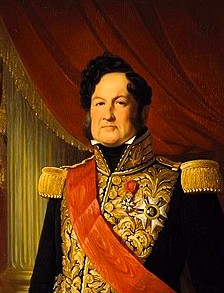
Of course, there were no annoying TV comedians at that time, but the satirical press, with newspapers like La Caricature and Charivari, Hullabaloo, relentlessly scourged King Louis-Philippe and as is the case now with Trump nowadays, ridiculed the king’s statements and appearance. The King’s tail of minions and flatterers did everything in their power to silence all criticism
Famously, the caricaturist Charles Philipon was accused of having mocked the king when La Caricature had portrayed Louis Philippe as a bricklayer in the process of covering up the slogans and leading names of the so-called June Revolution, which actually had brought him to power.
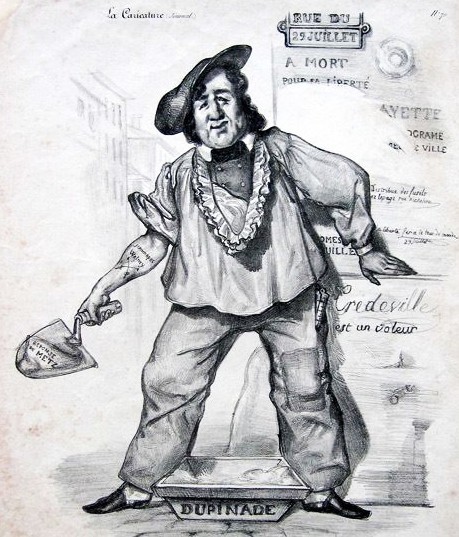
In an ironic defence, Philipon wondered how the Court could be sure that it was really Louis Philippe the First that he had depicted as a bricklayer, after all, the king could be likened to anything, for example to a pear.To clarify this claim, Philipon demonstrated a drawing he had made in which Louis-Philippe was gradually transforming into a pear.
Philipon was in 1831 sentenced to six months in prison in Sainte-Pelagie, where Daumier was already confined, and on top of that, Philipon was sentenced to 2,000 francs in fines and another seven months for additional offenses. However, the famous pear drawing was in 1834 reprinted in Le Charivari and soon spread beyond the borders of France.
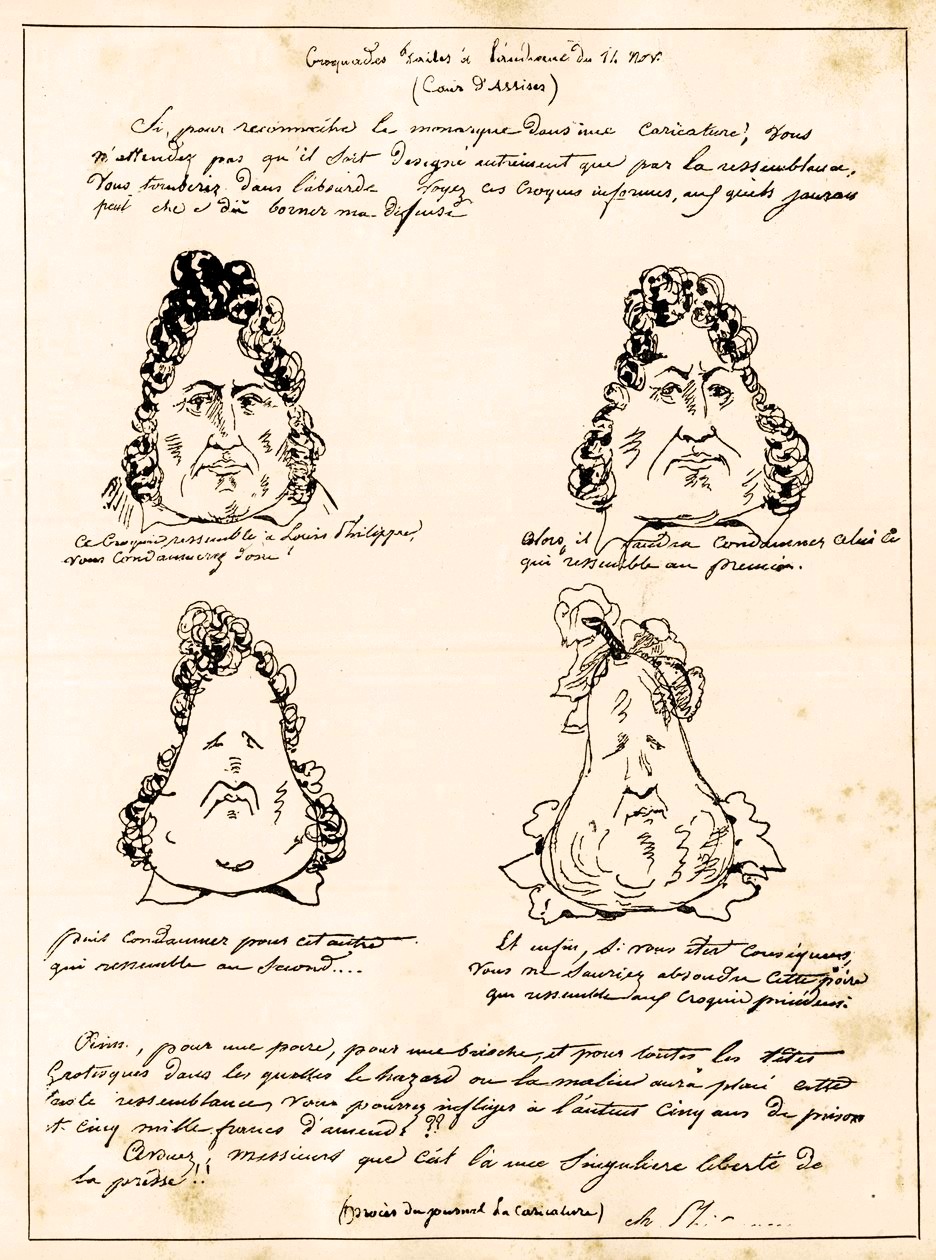
The result was new fines for Le Charivari, which several times before had been charged with slander and sedition. To raise money to cover the fines,Le Charivari once again printed the pear image, this time as a separate broadsheet sold for two sous. It was now apparently Daumier who had made a new version of Philipon's original drawing
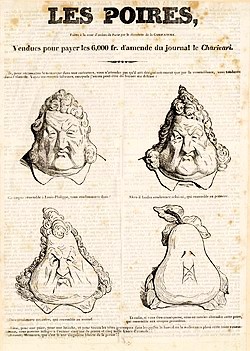
Daumier’s struggle against censorship and other oppression was not only expressed a satirical manner. He could also create serious illustrations that expressed his dissatisfaction with the regime’s poorly concealed terror. For example, when protests broke out in 1834 and Louis-Philippe’s militia opened fire on a residential building, assumed to be occupied by rebels, a number of completely innocent families were massacred instead.
A dead father is depicted lying dead in his bloodied nightgown and fallen across his child that has been crushed by his weight. The picture clearly indicated how unprotected innocent had been killed in cold blood. Daumier's good friend Charles Baudelaire praised the mundaneness of the image, which despite its cruel reality, or perhaps because of it, had become a monumental act of accusation worthy of a Shakespearean drama: “Here only silence and death are reigning."
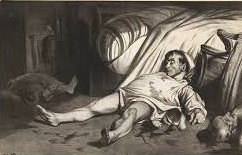
Daumier saw the greatness of simplicity. By depicting the everyday life of the French people, he elevated it to great art. Here, no classical education was required, no imitation of the academies’ high-ranking artistic ideals. Artists had to walk down into the alleys, down to the people.
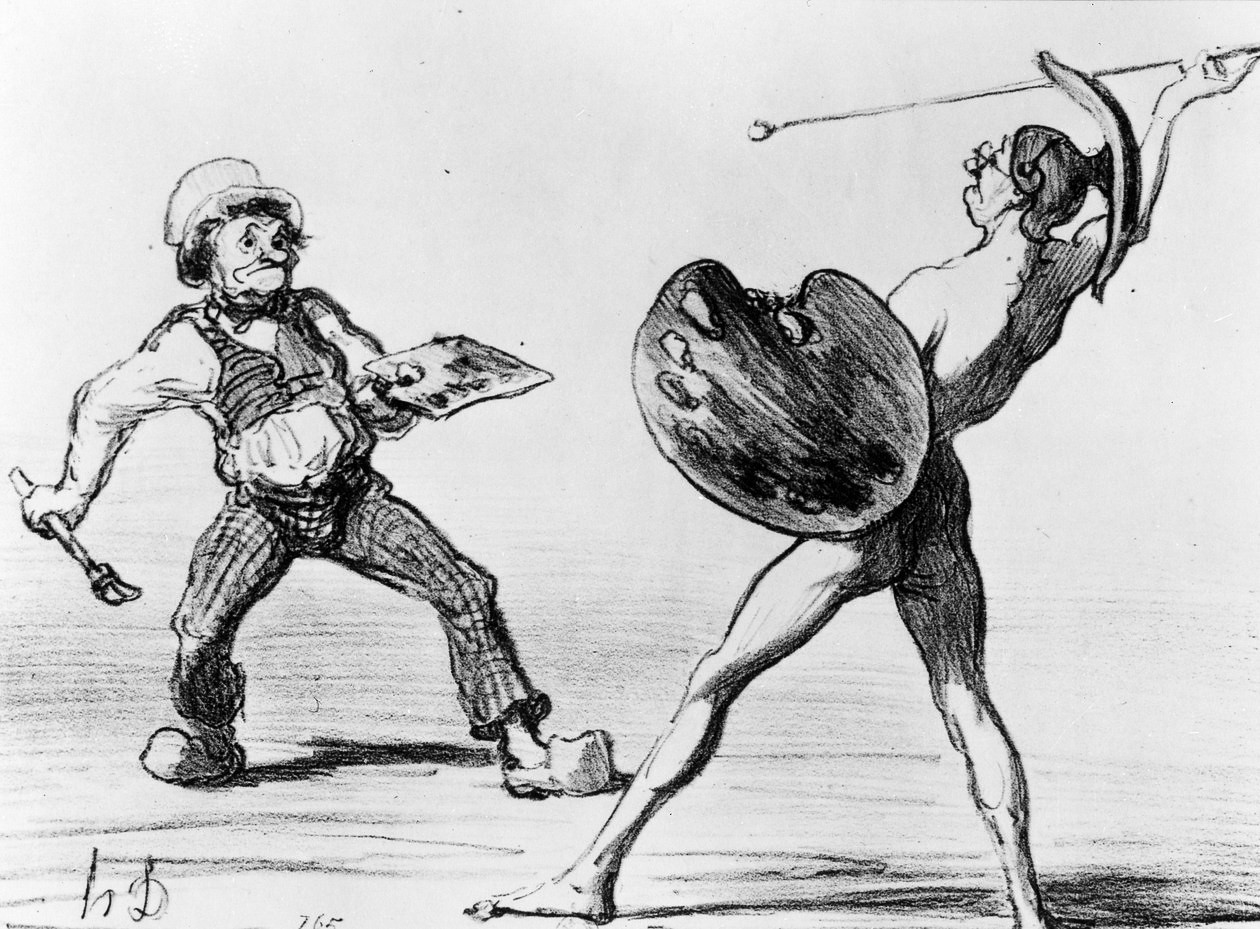
The peasants of Jean-François Millet
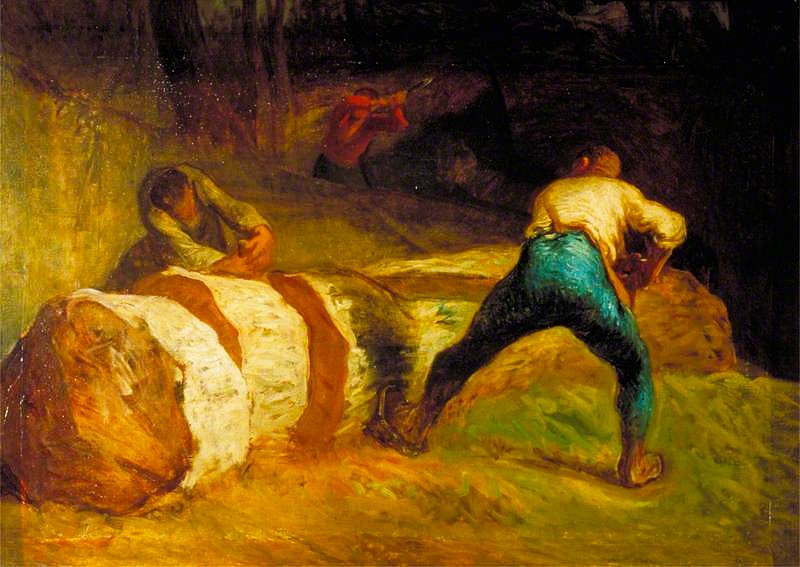
against the ancient Romans of Jacques-Louis David.
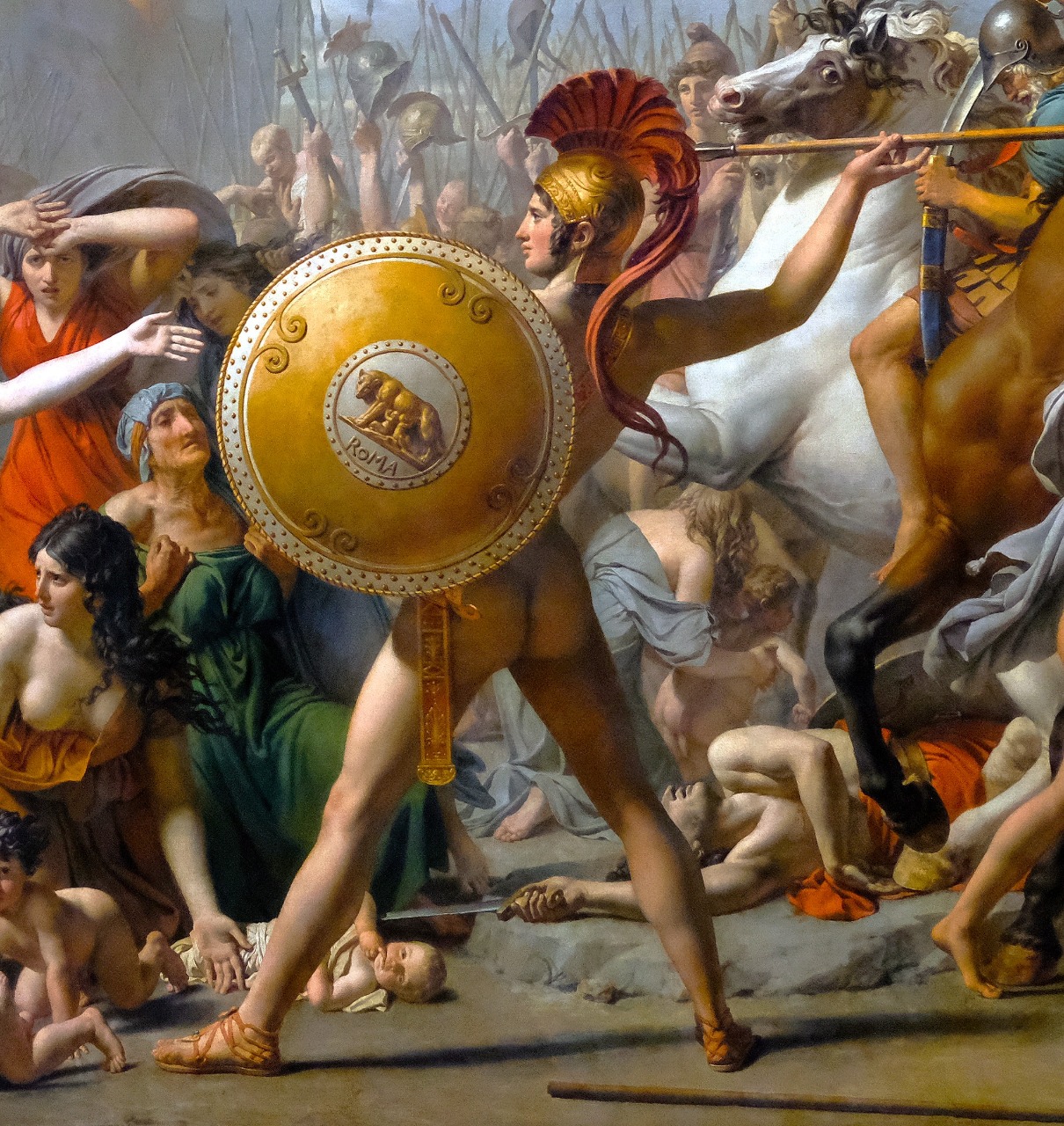
Daumier came from a poor family. His father, Jean-Baptiste, was a glazier who framed pictures, sold graphic prints, and wrote poetry. Some of his plays were staged by traveling theatre companies and modest success made him to move to Paris in 1814, followed by his wife and six-year-old Honoré. The financial success was minimal. One of Jean-Baptiste's poetry collections found a publisher, but only a few copies were sold. An amateur theatre group staged one of his plays, but there was hardly any audience. The picture framing business was a failure and the family lived in poverty. Honoré’s indebted father went bankrupt and at the age of twelve Honoré was forced to work as an errand boy for a huissier de justice, a profession unique to the French legal system.
A huissier de justice is a minor official within in the judiciary who forwards summons, enforces and collects court and legal claims, including bankruptcy, property claims, seizures and evictions. An activity that probably made the young Honoré both fascinated by, and disgusted with, representatives of the French legal system. In any case, he devoted a large part of his art to portraying lawyers in full operation. They might force tears to appear while defending of their clients,
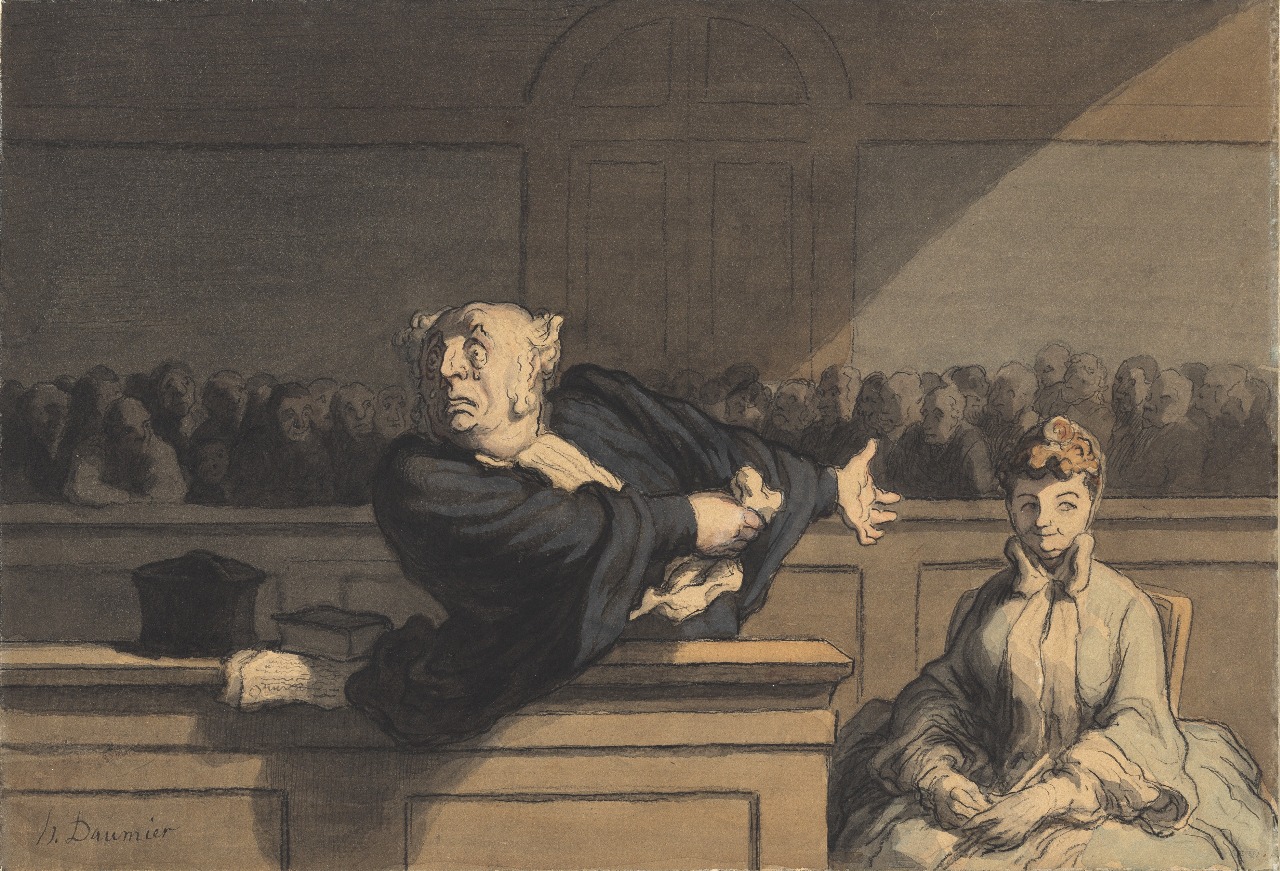
indulge in numbing rhetoric, marked by dramatic acting,
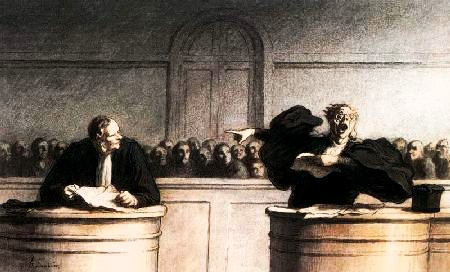
Lose themselves in pious speeches devoted to exonerating a client, as here where a lawyer refers to the crucified Jesus to arouse sympathy for a woman who has broken down behind his back.
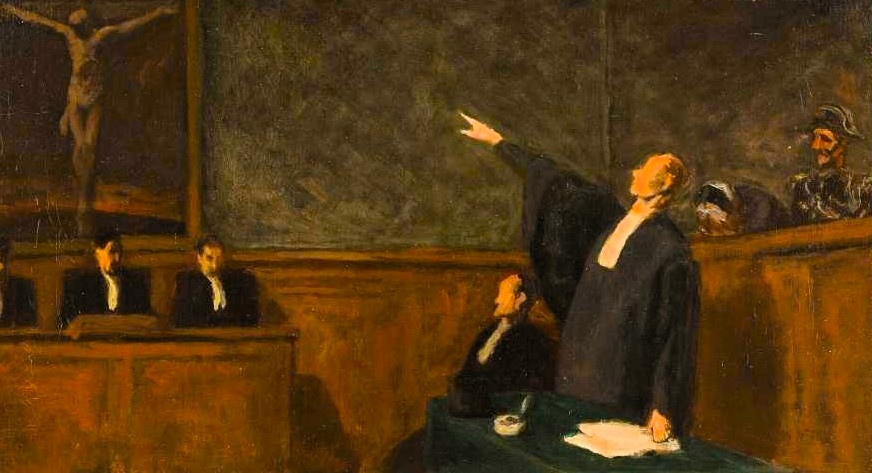
Lawyers and judges are intriguing in courtrooms and corridors.
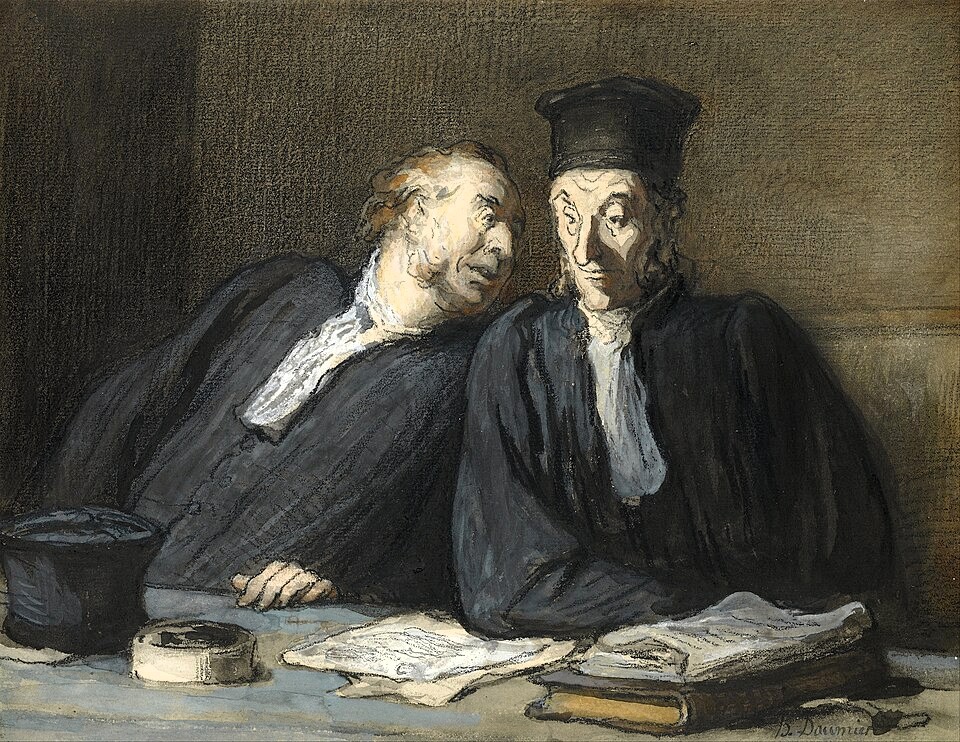
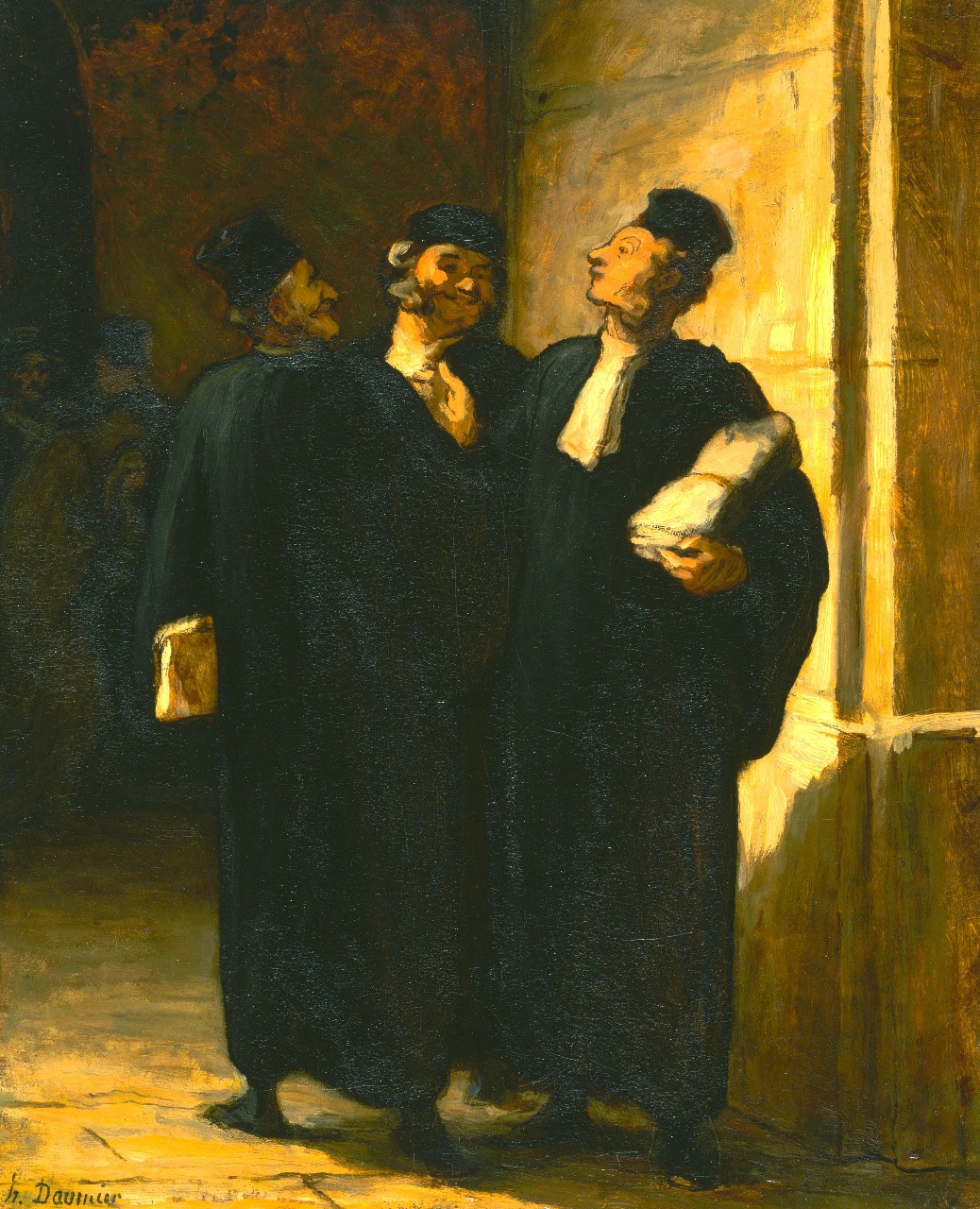
As masters of life and death, courtiers are with solemn steps advancing through the palaces of justice.
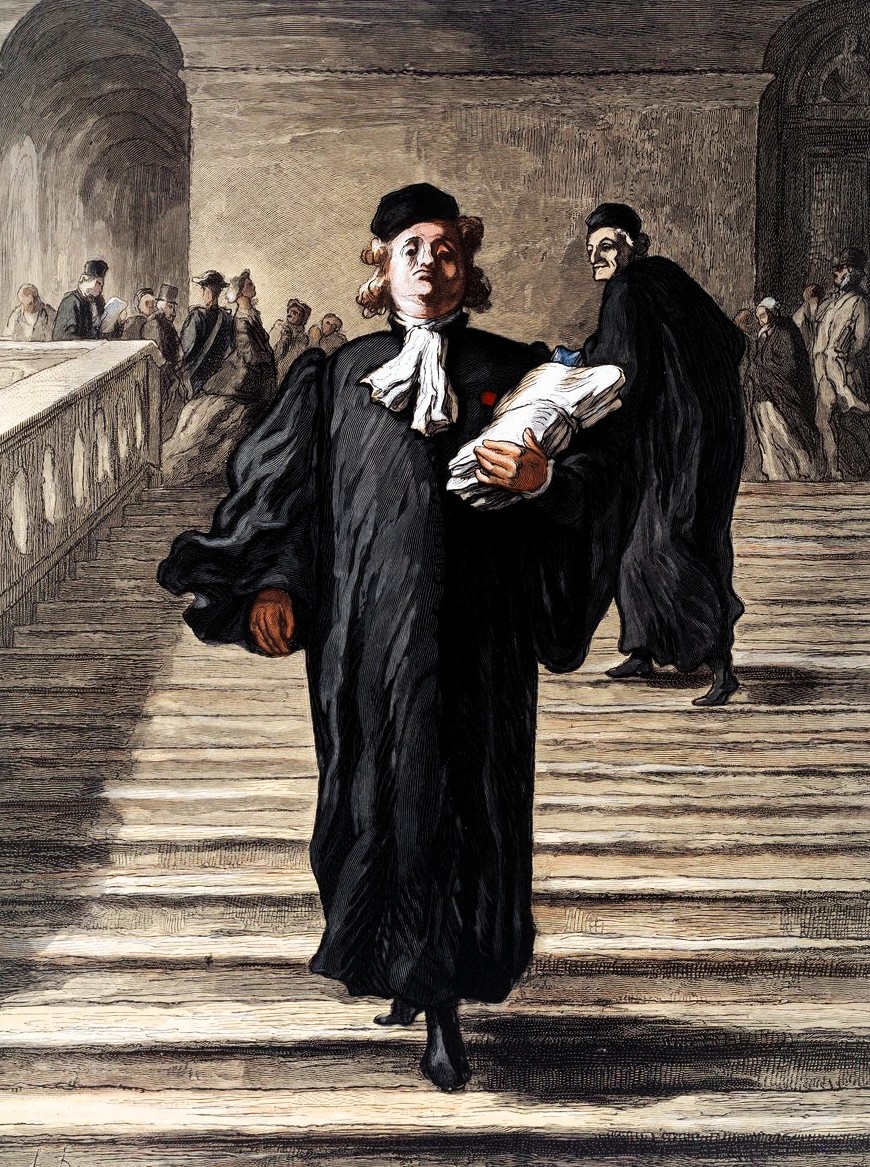
But their eloquence doesn’t always succeed in persuading their colleagues.
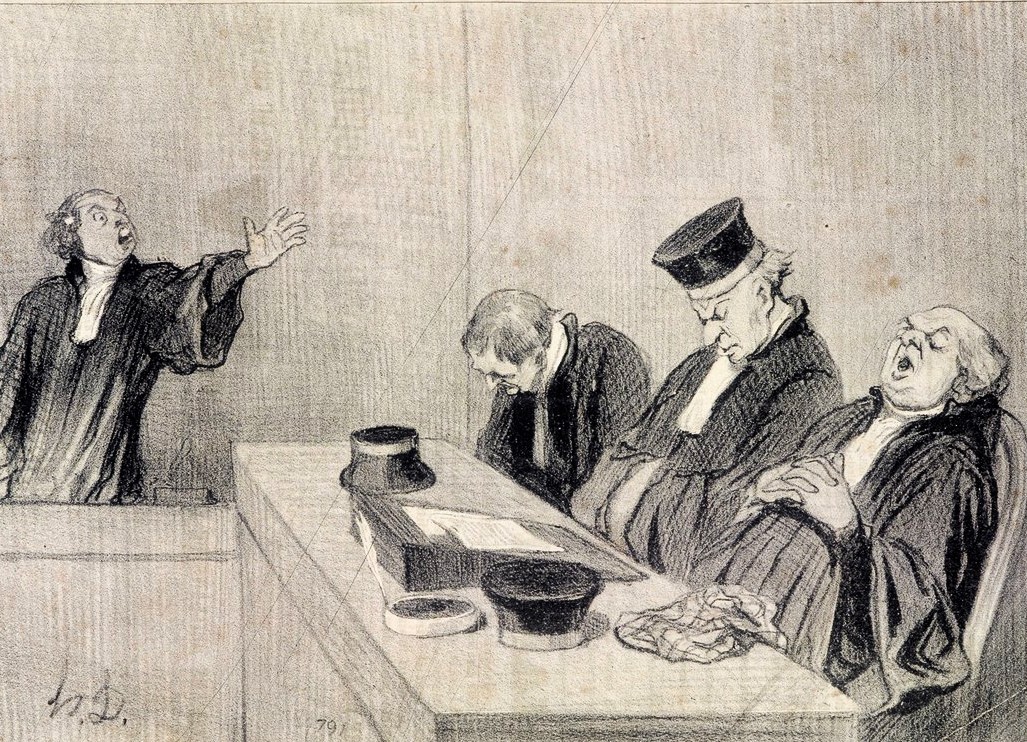
And the clients they manage to acquit are not always God’s best children.
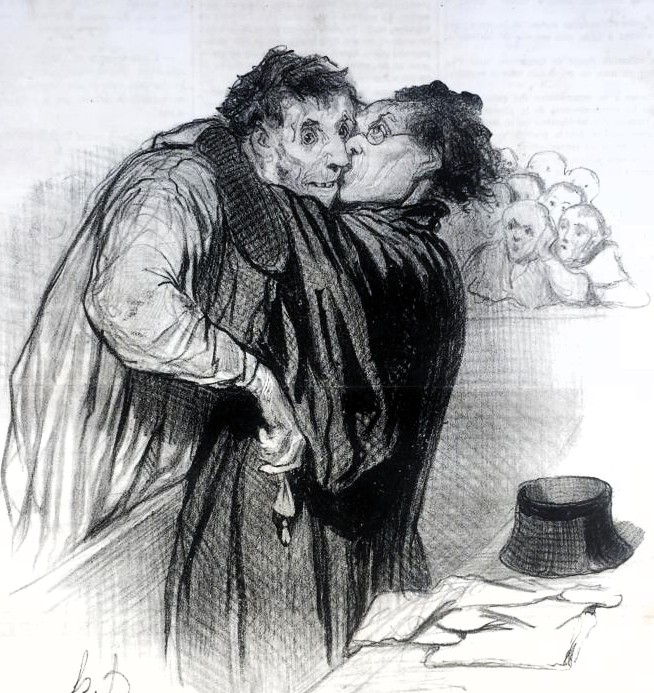
Daumier knew from own experience that controllers of legal and political power were not to be trusted and he attacked them mercilessly, letting their exteriors reflect their interiors. He filled the image of a legislative assembly with a menagerie of unpleasant characters.
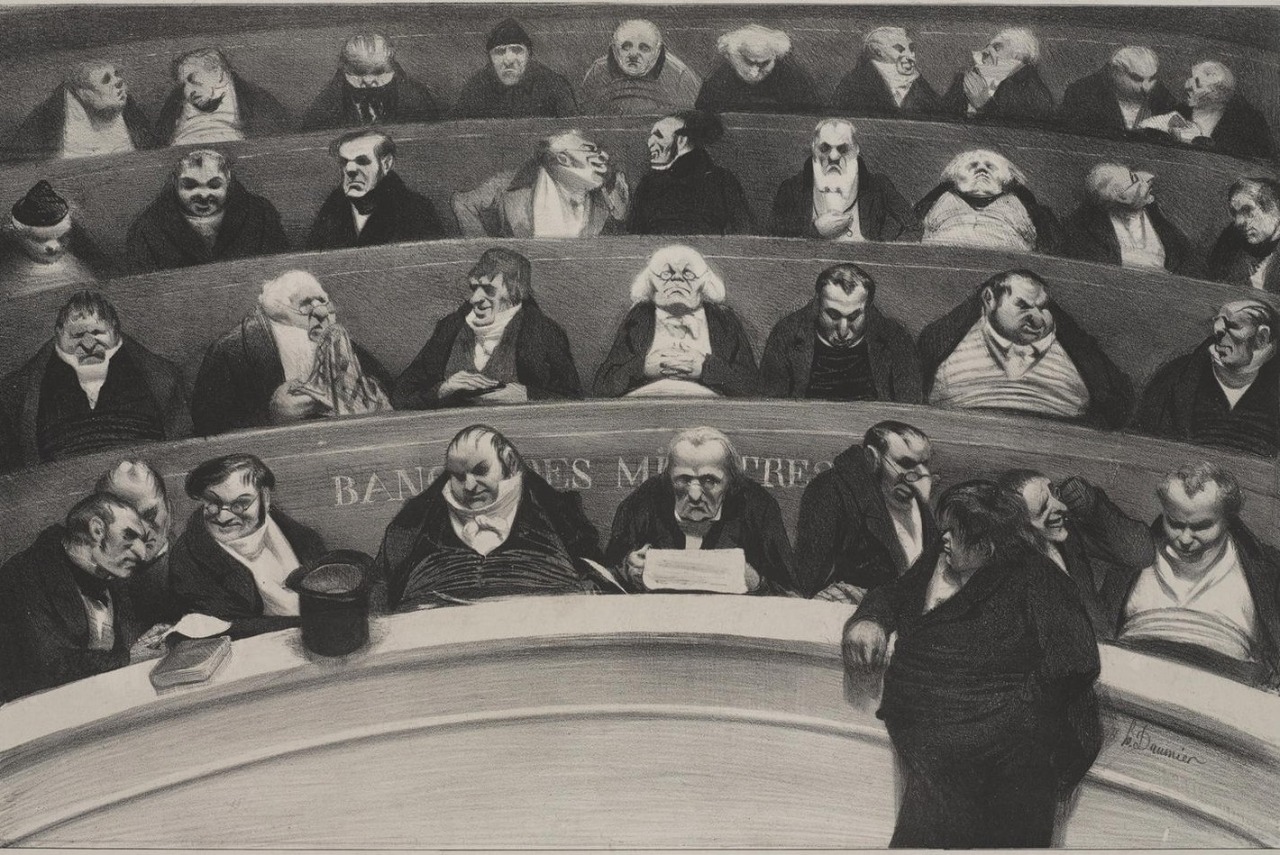
Daumier’s artistic skills were not limited to painting and printmaking, he was also a master sculptor, as in his statuette of Ratapoil, the Rat Skin, one of Louis-Napoleon’s bat-armed provocateurs, whose job it was to incite crowds, often through violence and bribery. A swaying, strutting figure with a goatee and a rumpled hat.
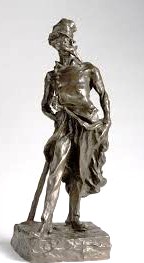
For his own amusement, Daumier made in clay, which he fired and glazed, a number of portraits of parliament members of– here we see an aristocrat, a banker and a bourgeois with an angered, bright red face.
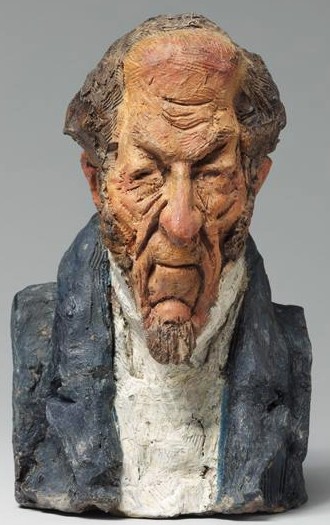
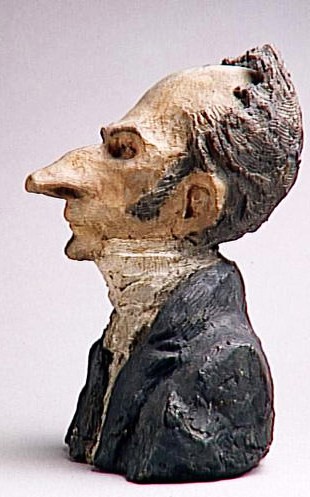
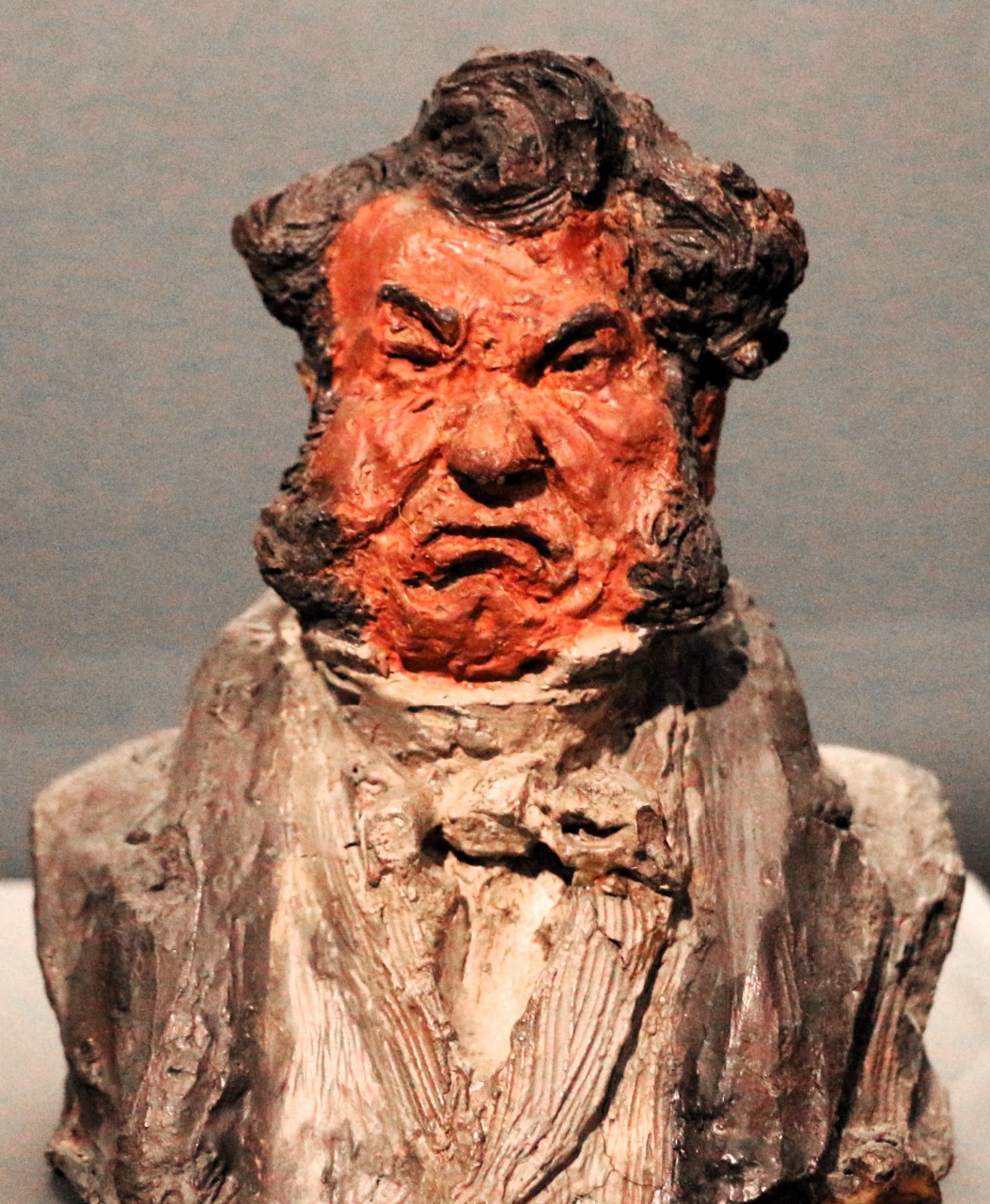
It was different when Daumier portrayed working people. Like the washerwomen who toiled along the banks of the Seine.
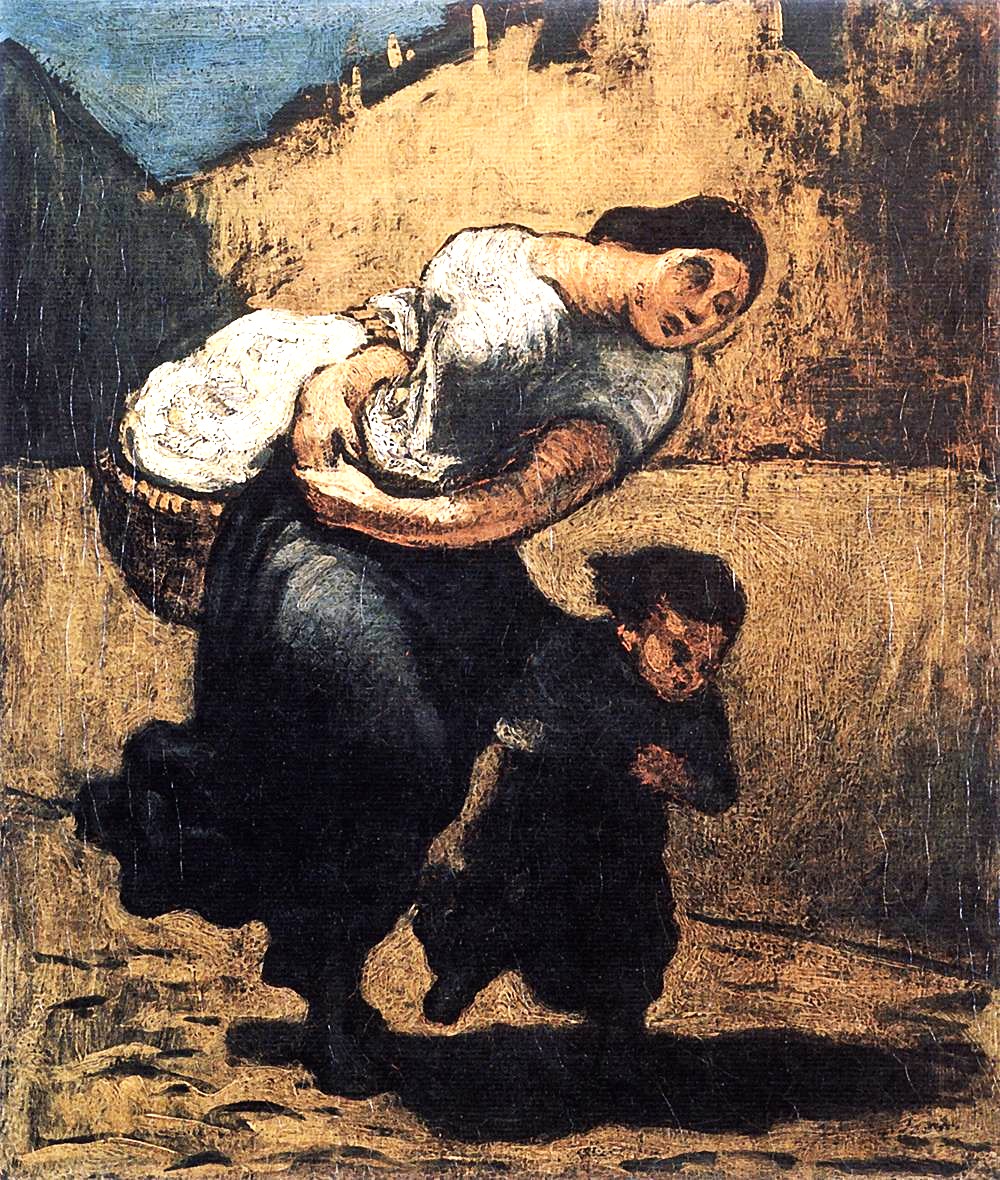
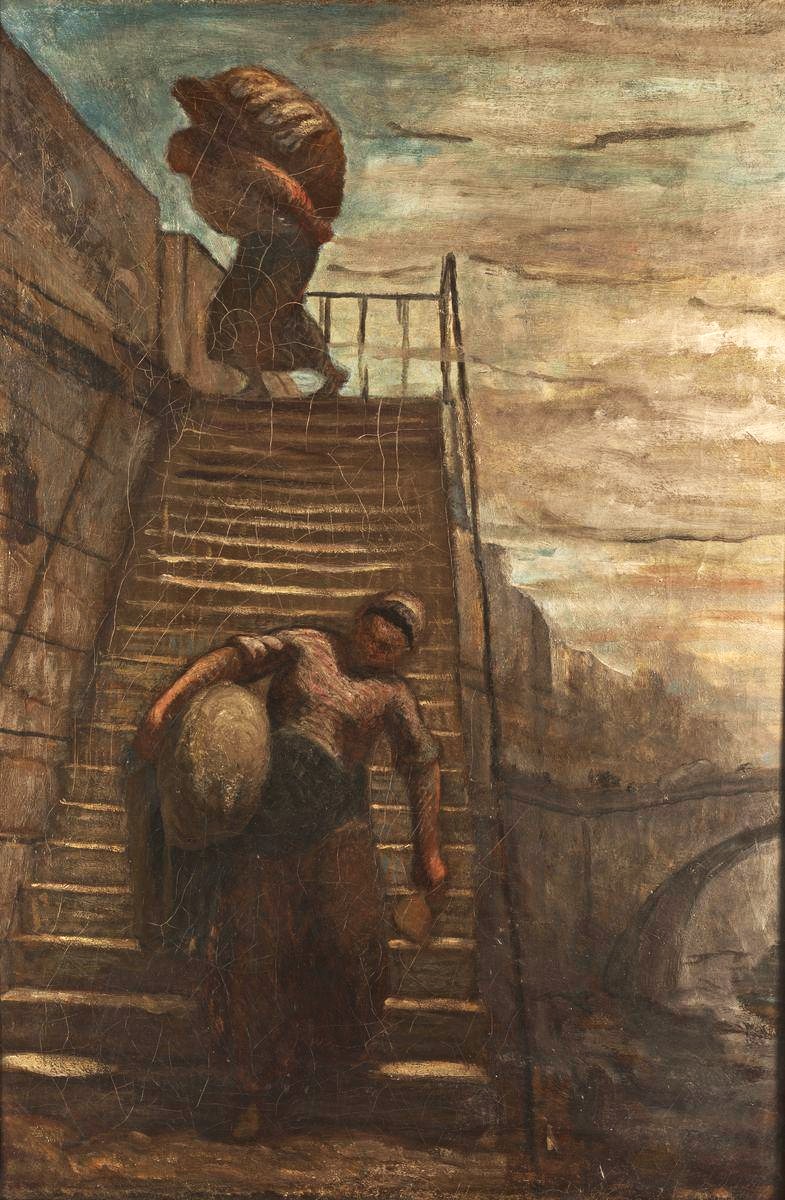
Workers and poor people.
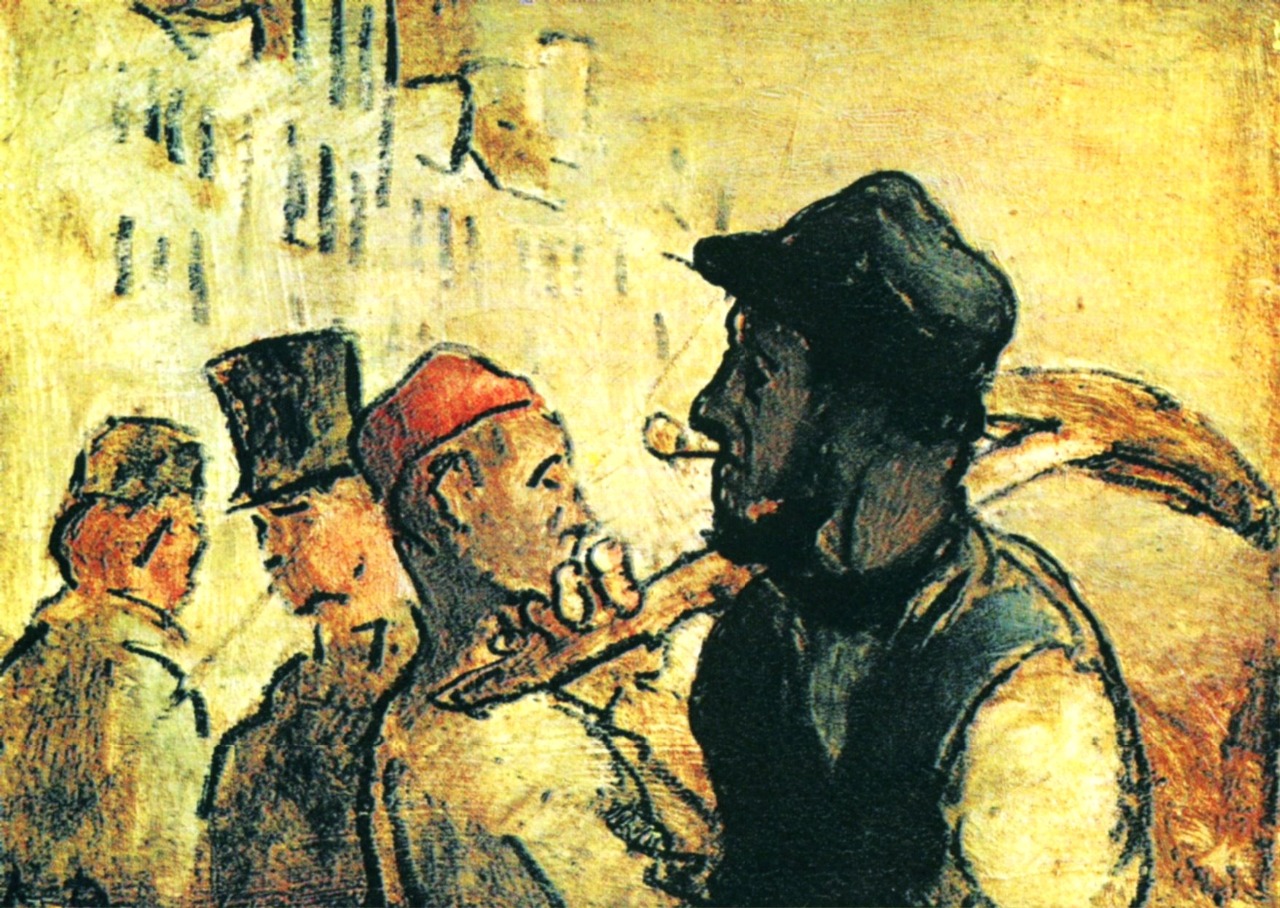
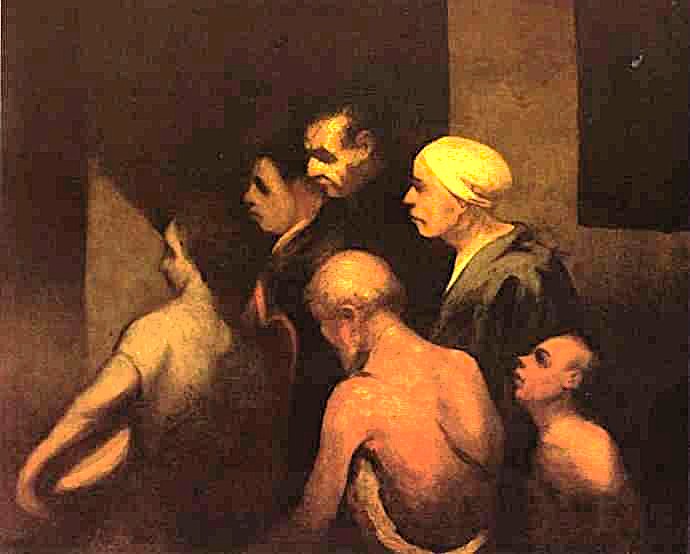
Refugees:
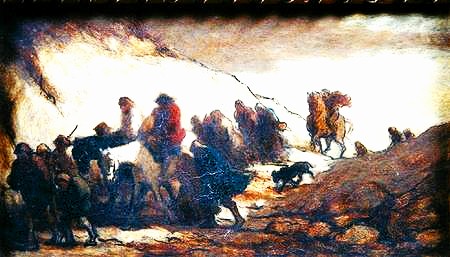
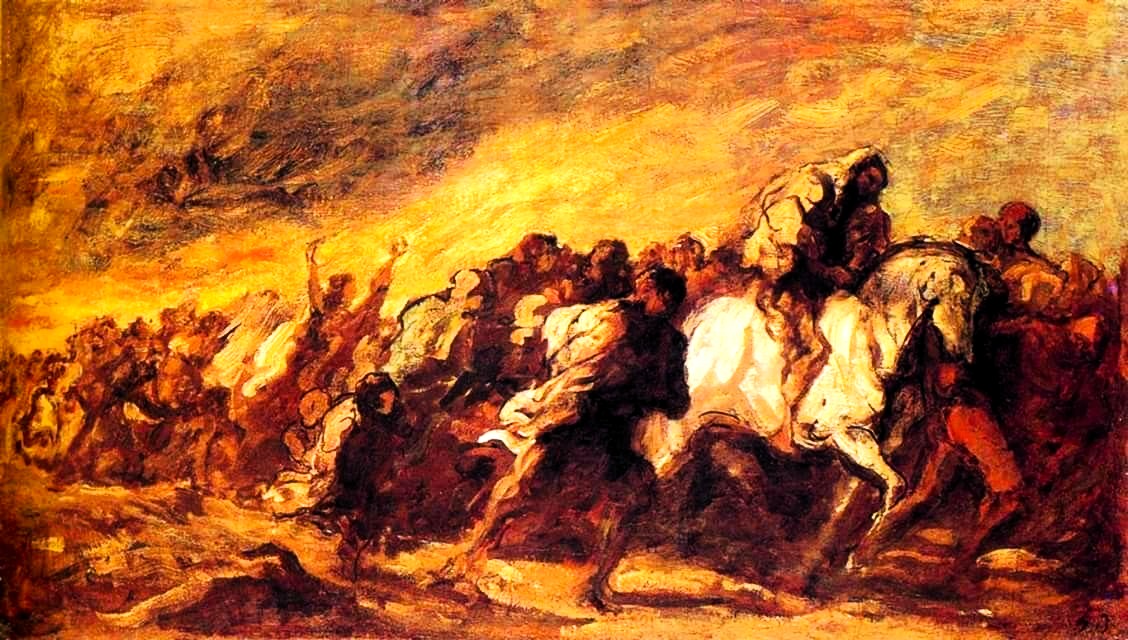
Daumier took offense at warmongers, as here in the image of a satisfied inventor of the needle rifle, a weapon equipped with a needle-like firing pin that revolutionized the contemporary arms industry.
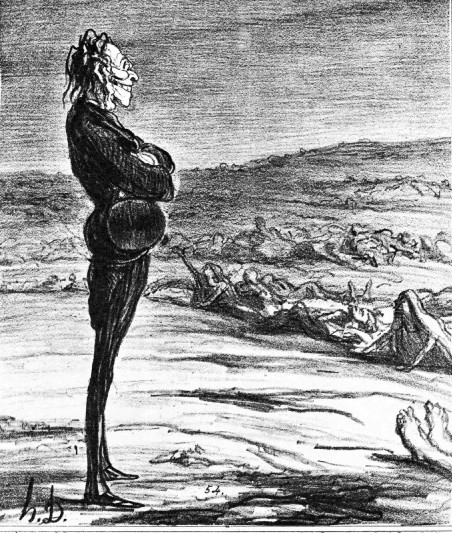
His vision of skeletons and corpses advancing towards a War Council caused the censors to ban its publication.
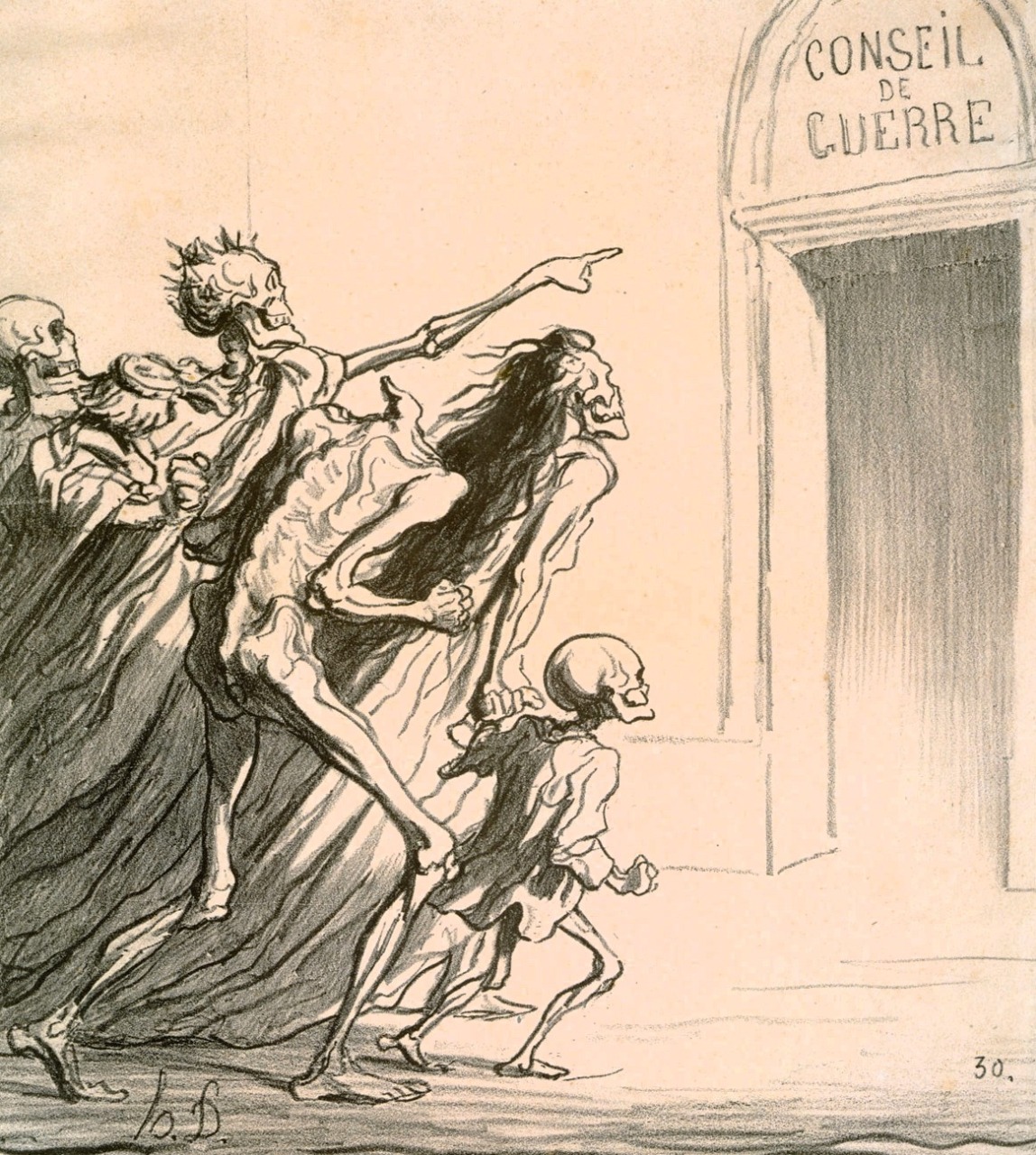
With his proletarian roots, Daumier was well aware of class differences and found various ways to depict them, as in his image of a first-class train compartment:
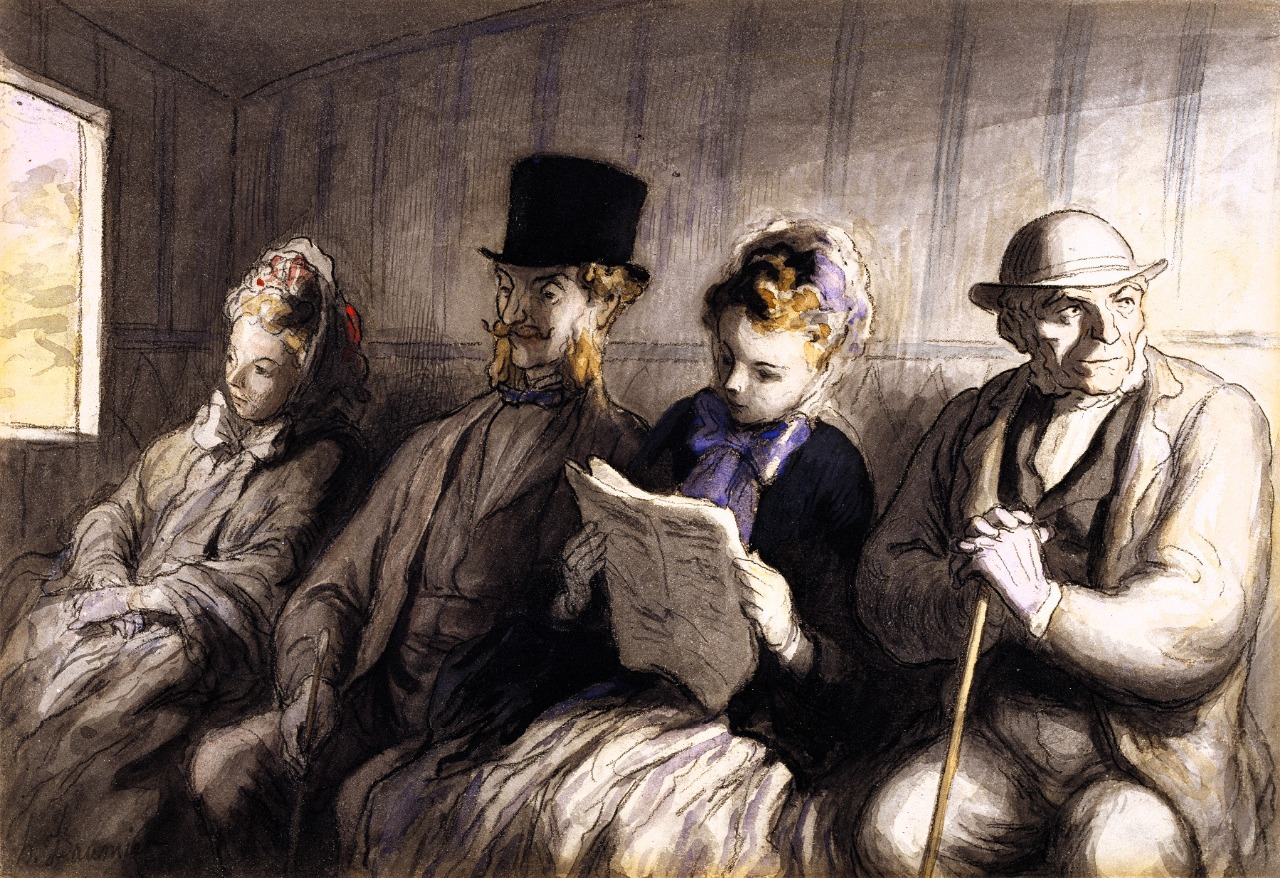
its second-class equivalent,
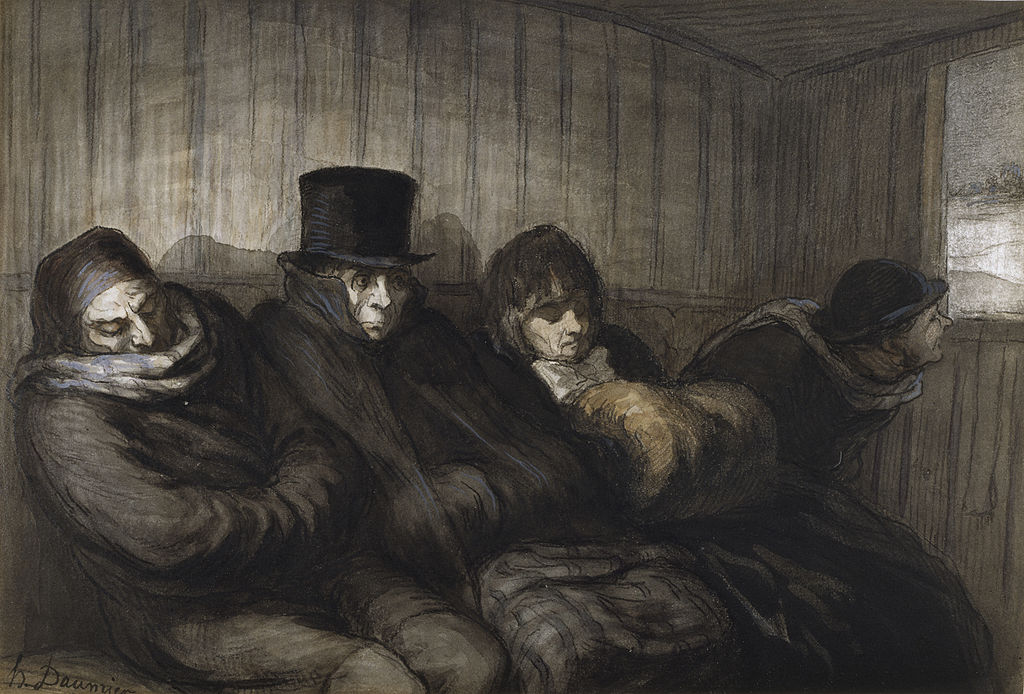
and a third-class compartment:
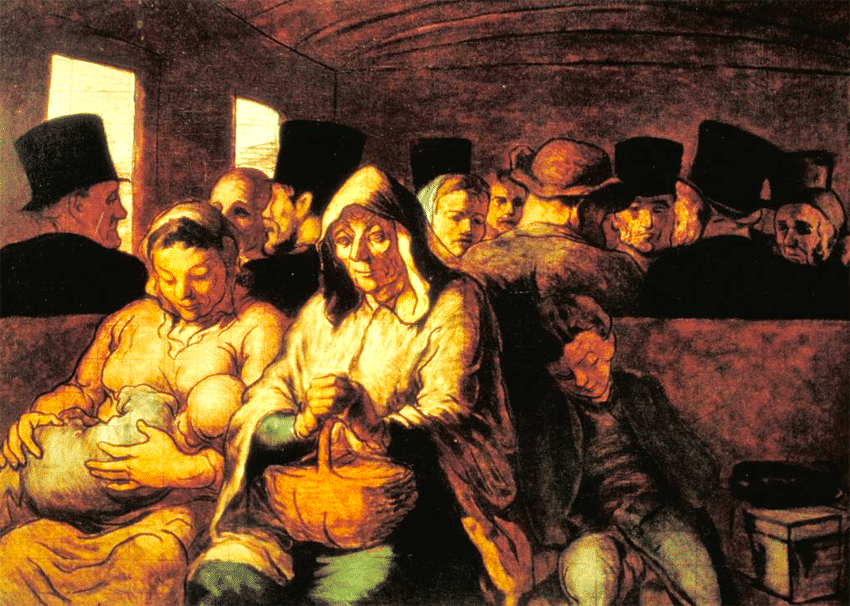
What I find most remarkable about Daumier is his artistic mastery, which seems to have sprung from a vein of unknown origin and becoming paired with a razor-sharp ability to observe. Without a complete education, Daumier seems to have been endowed with an instinctive feeling for the possibilities and dynamics of oil painting, sculpture and graphic art.
Boldly and uninhibitedly, he threw himself into all varieties of art and did so with a bravura and self-satisfaction that often seem to have been blind and deaf to the tastes and demands of the market. His oil paintings, for example, were virtually unknown to his contemporaries.
If Daumier ever made an excursion into the generally profitable field of religious art, it was in the form of intensely personal interpretations, emerging from an empathetic, highly personal perspective, as in his Ecce Homo, depicting how Pilate presents Jesus before the people. A rendition that could not possibly interest any wealthy religious potentate.
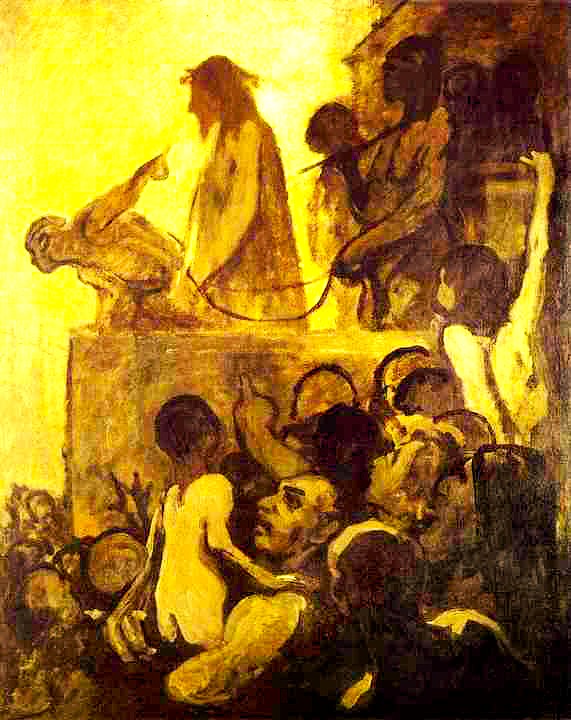
If Daumier was inspired by his visits to the Louvre, it was mostly evident through his sumptuous depictions of bacchanals, based on predecessors like Jordaens or Rubens.
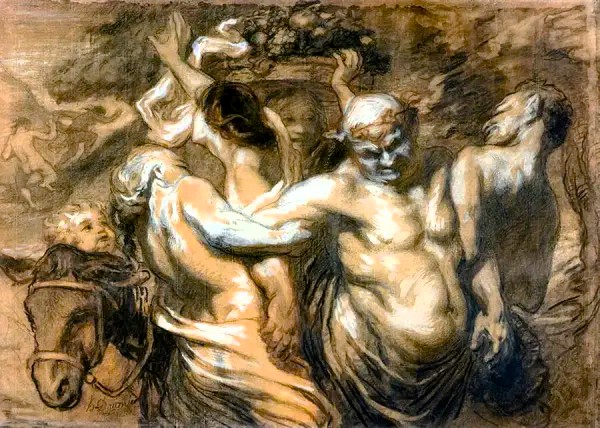
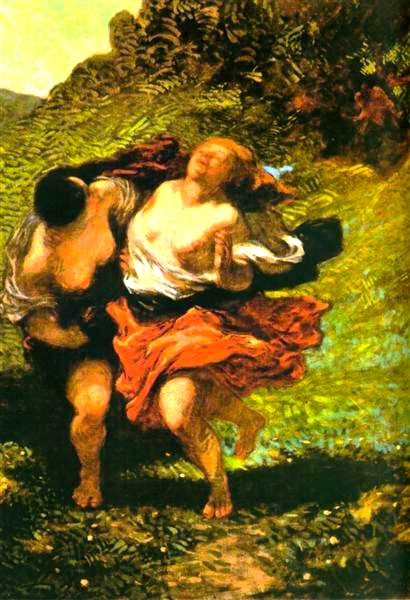
Otherwise, Daumier amused himself by parodying classical mythology, often seriously worshipped by academic painters. Like when Pygmalion has created his Galatea and she after coming to life helps herself from the snuffbox of her sculptor.
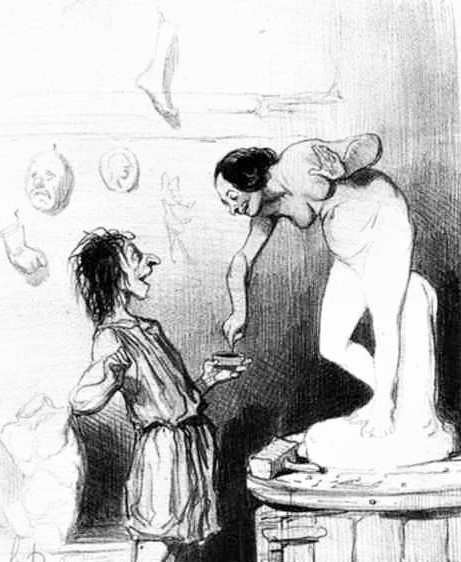
Or a rather skinny and intimidating Narcissus is falling in love with his reflection.
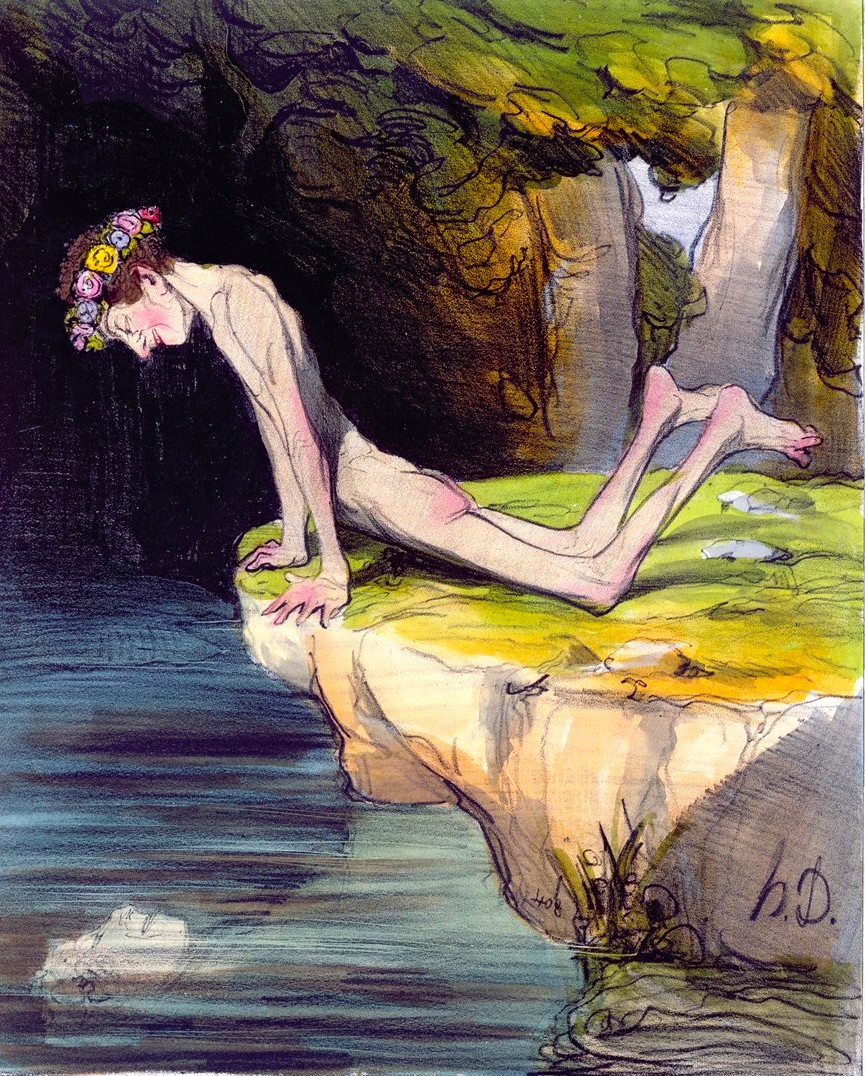
Daumier’s father dealt, as most frame makers still do, in graphic prints and other inexpensive art.
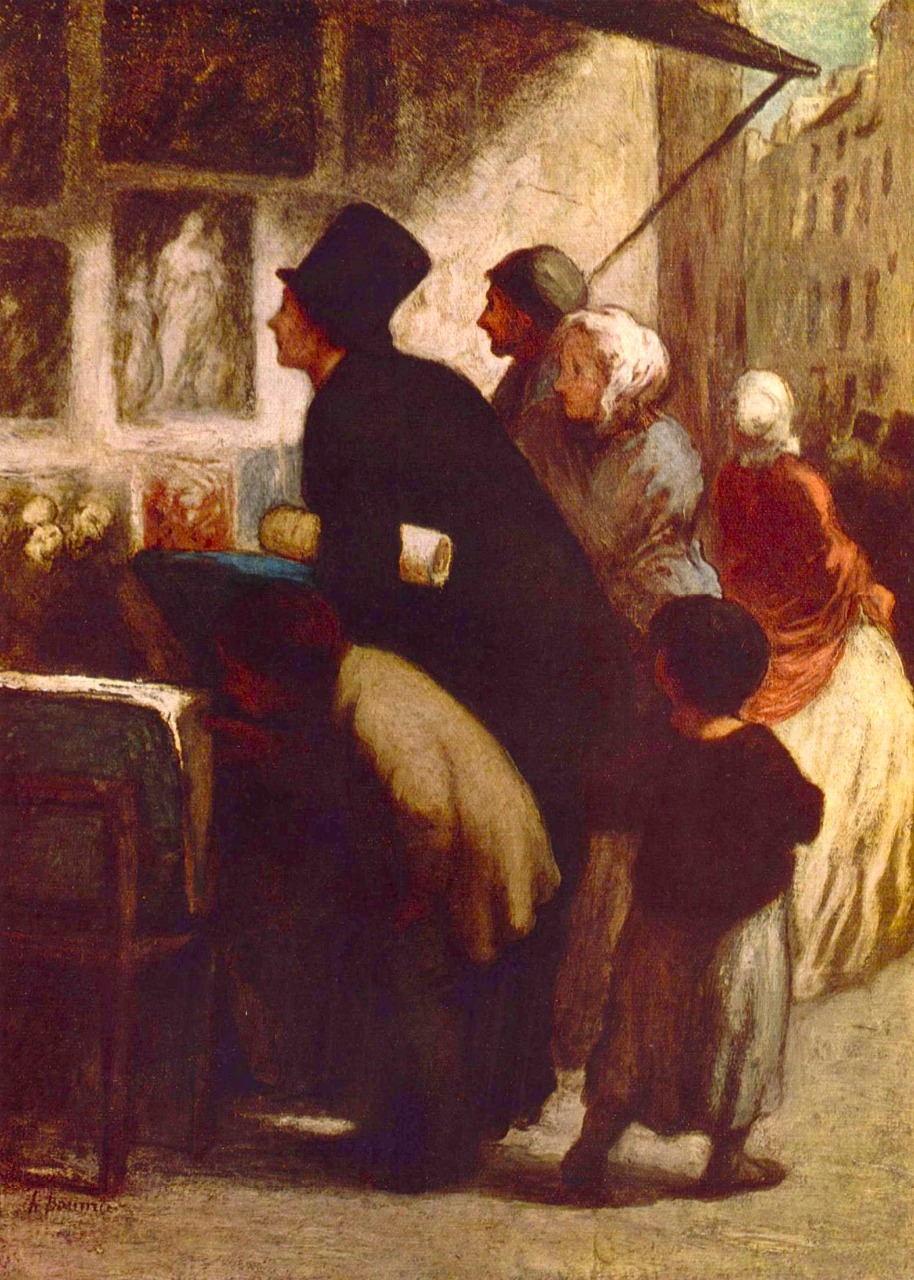
Among those who visited his office were certainly the occasional artist and bookseller.
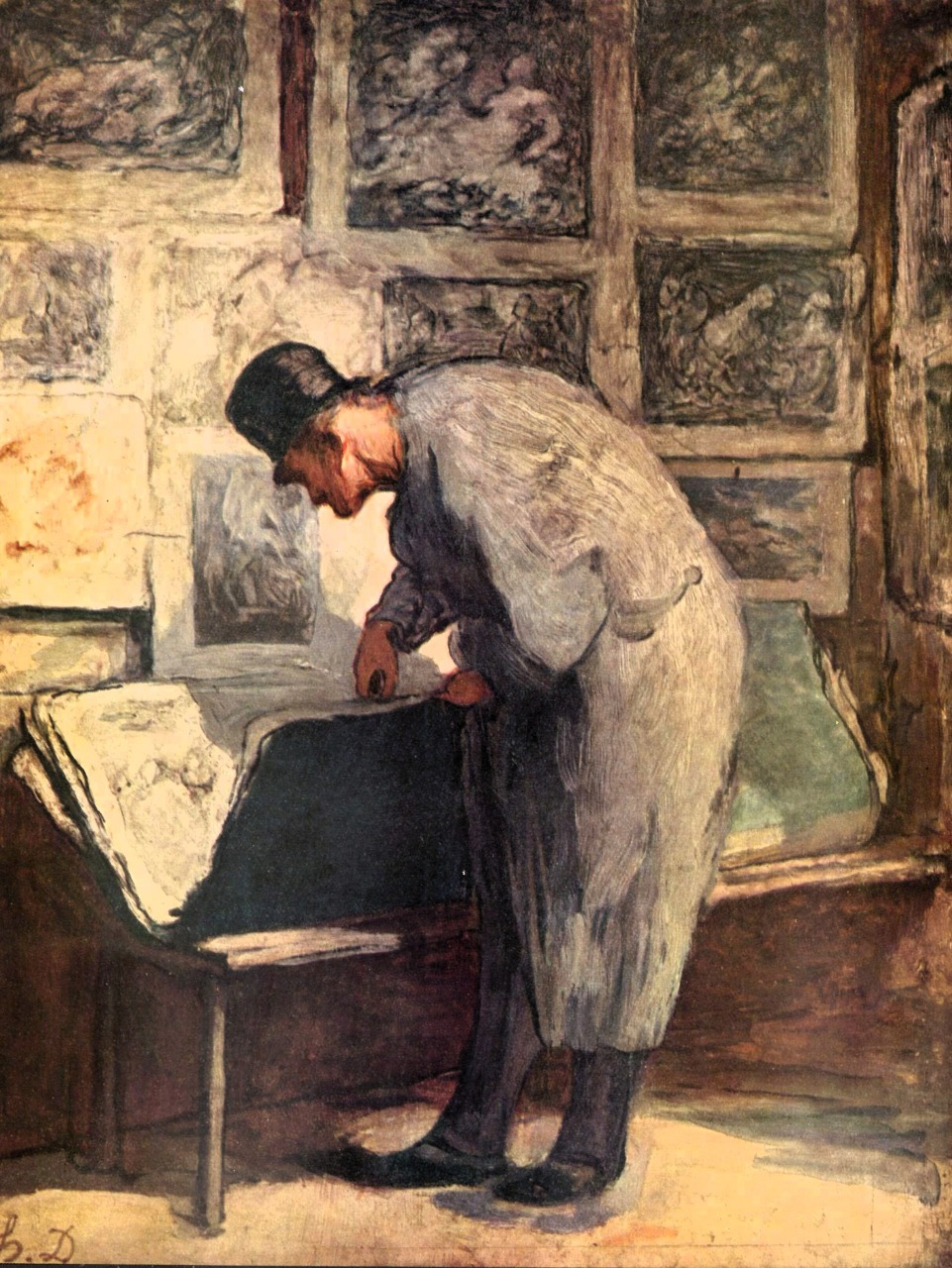
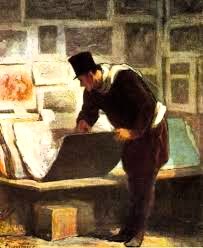
It was probably his father's connections that eventually led Daumier to an employment at Delaunay’s, a well-established bookstore located among the arcades of Palais-Royal, constituting a hub of Parisian art life, where the young Daumier could meet influential writers and artists, who stimulated his great interest in art. He drew daily and visited the nearby Louvre.
A good friend of his father, Alexandre Lenoir, founder of the Musée des Monuments Français, discovered Daumier's talents, took him to art exhibitions and ensured that he entered the Académie Suisse, where Daumier got the opportunity to draw from live models and was able to demonstrate the artistic skills he already possessed.
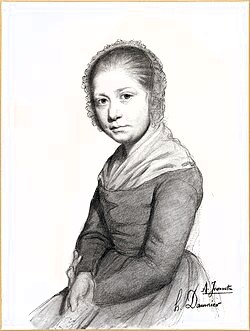
Soon Daumier was working with the newspaper printing houses and had perfected his demand of lithography, while his satirical talent and keen powers of observation became greatly appreciated. Although he never became wealthy through his art, Daumier was able to support himself and his wife, a seamstress named Marie-Alexandrine Dassy, with whom he begot son who died while still an infant. Daumier remained faithful to his wife throughout his life.
Marie-Alexandrine did not at all understand her husband's art and did noy keep any of his art work. After Daumier's death in 1879, his widow sold his entire production for a total of 1,500 francs. Among the buyers were several of Daumier's artist friends.
Daumier was a socialite, but did not leave behind many easily identifiable portraits. However, among his many pictures we find many depictions of friends looking at a works of art together.
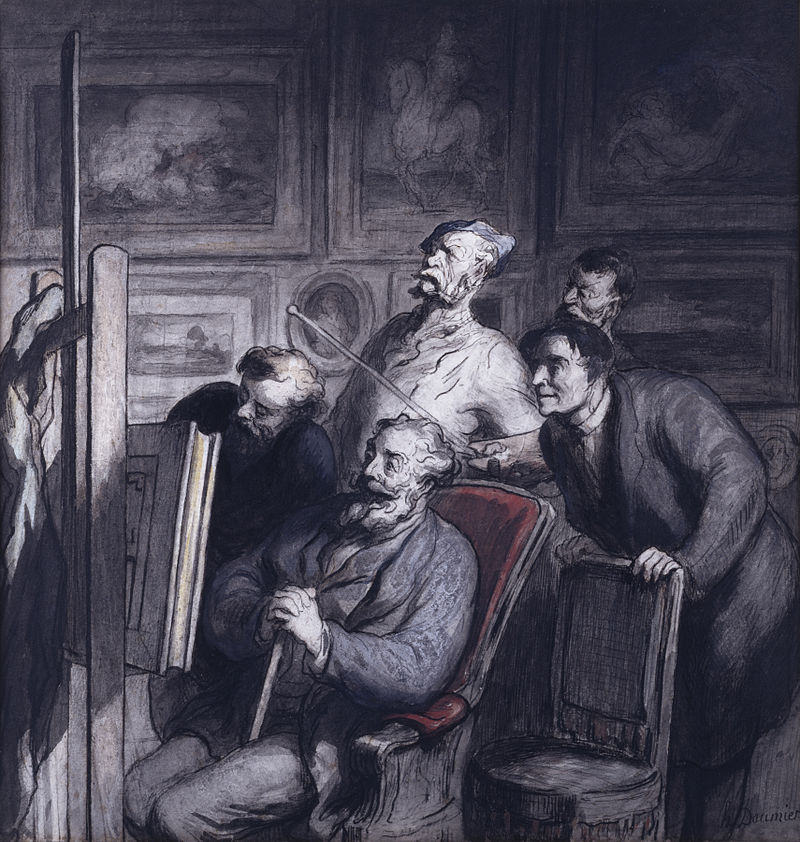
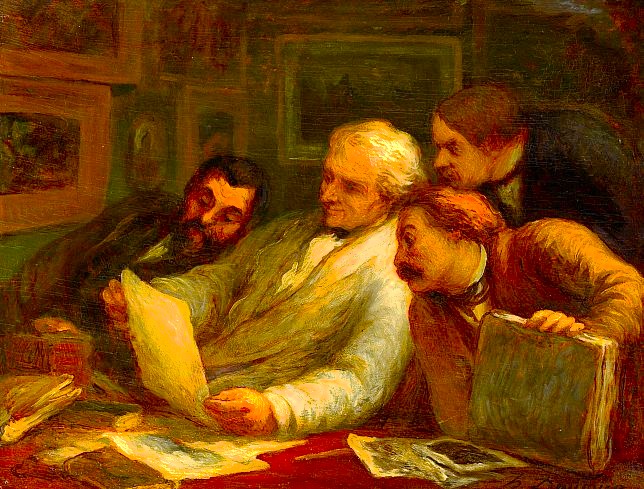
playing chess,
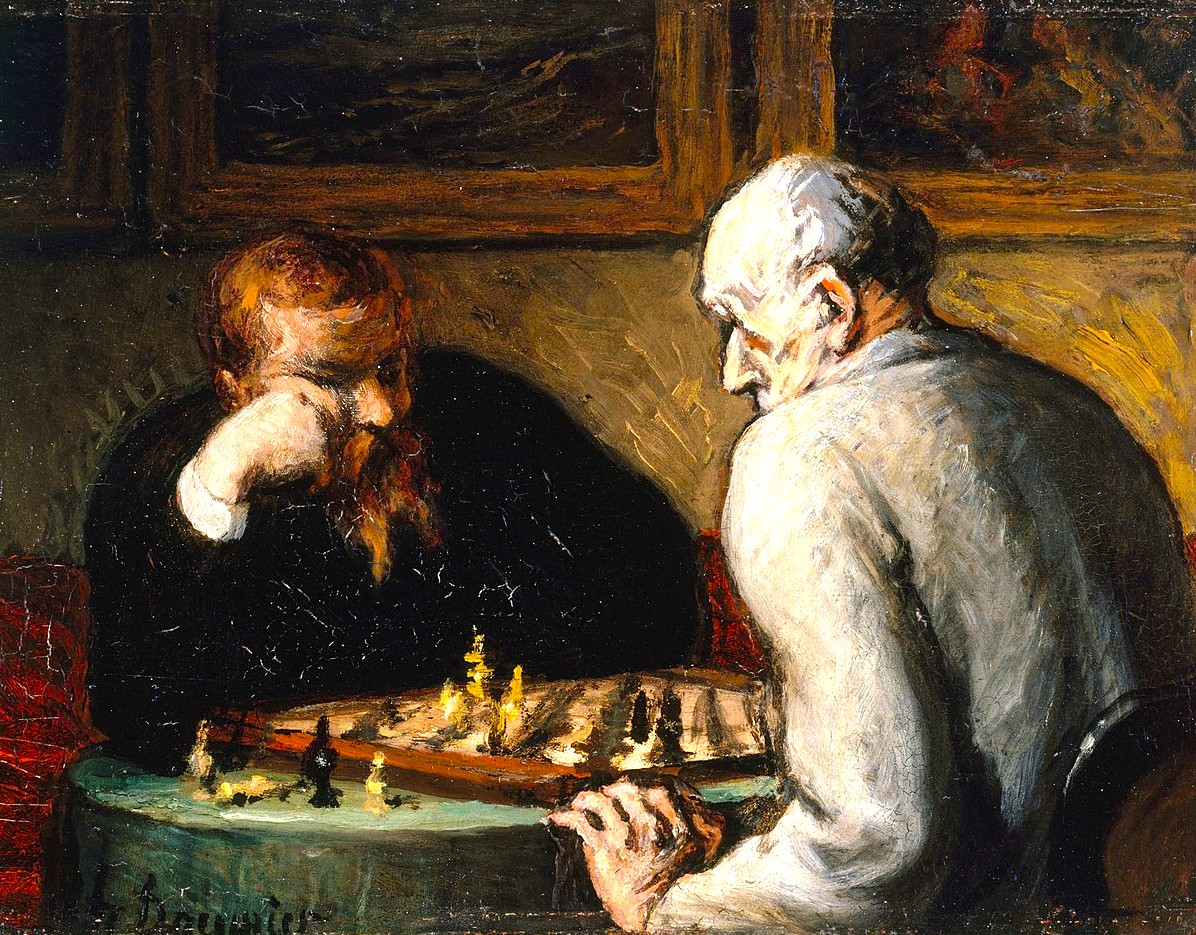
or taking a walk through a nightly Paris.
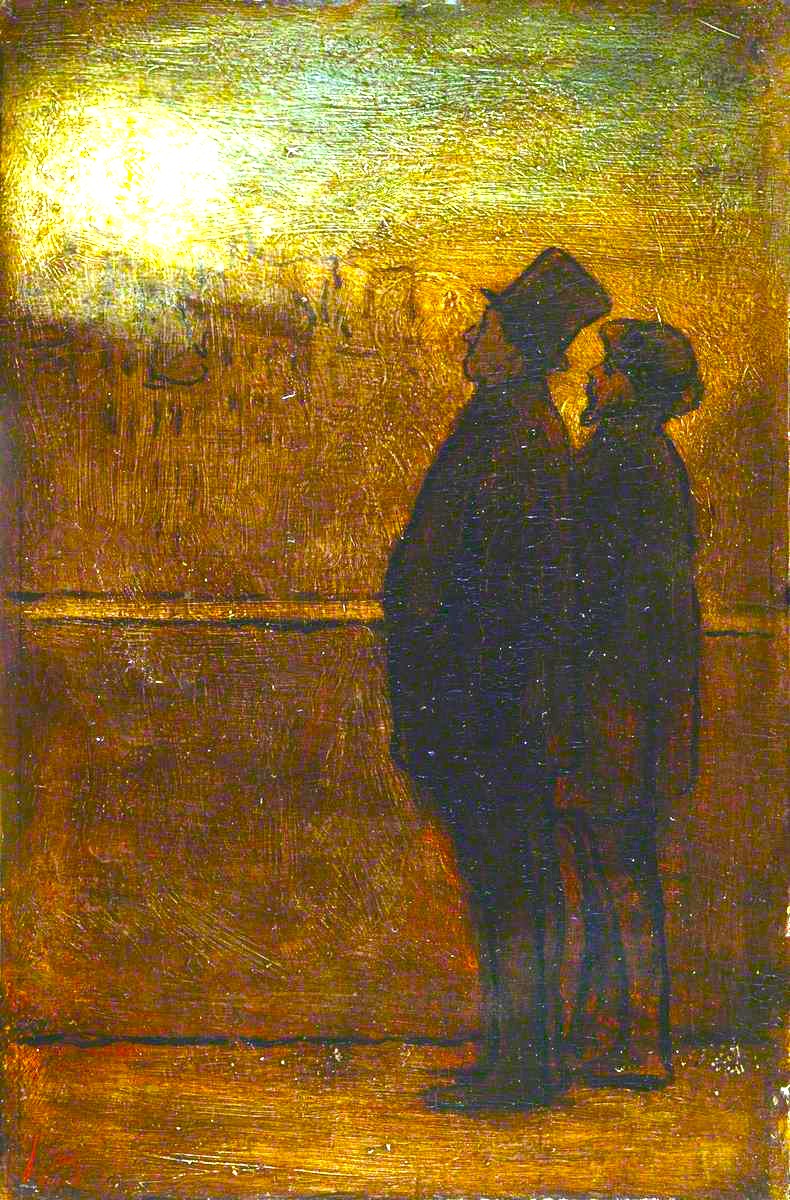
He also often depicted artists in the process of painting, but these are obviously neither self-portraits, nor pictures of any identifiable artist friends.
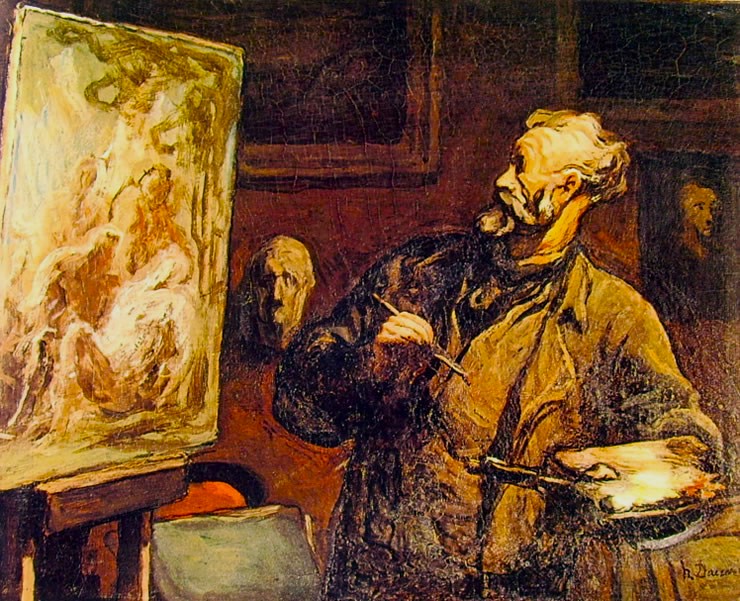
Daumier was a distinctly urban man and made very few landscape paintings.
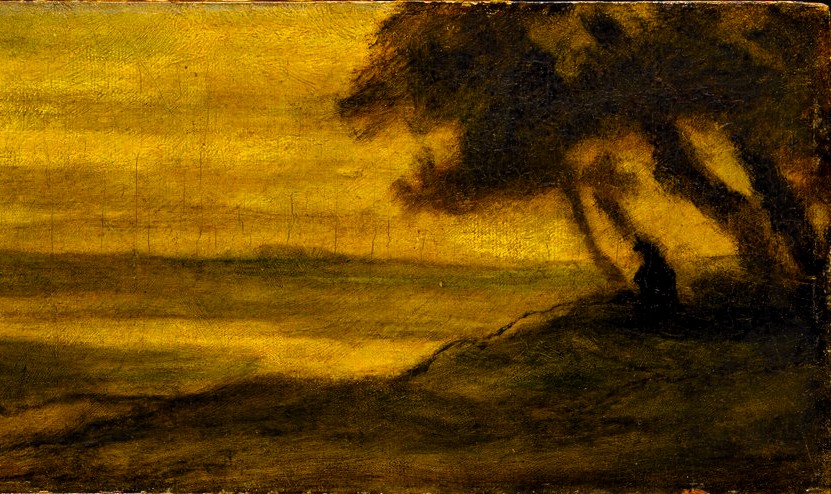
and it is rare for any peasants to appear in his paintings.
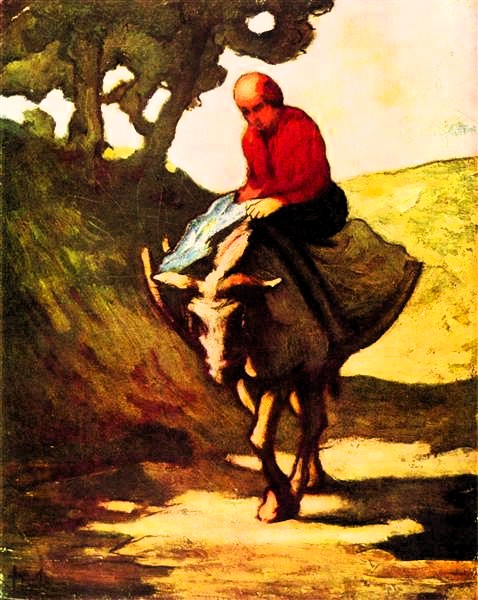
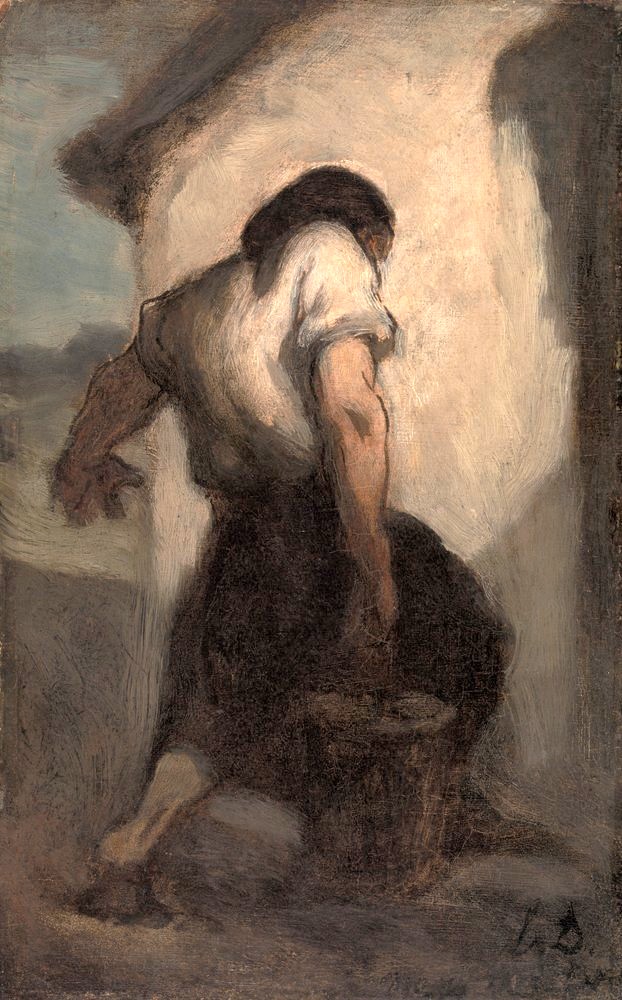
Much of Daumier’s output concerns Parisian theatrical life. He devoted his art to what happened on stage, often in such a way that the viewer gets the feeling that the artworks capture the mysteriously unnatural lighting of the theatres. As here in a production of Molière’s Le Malade imaginaire, The Imaginary Invalid.
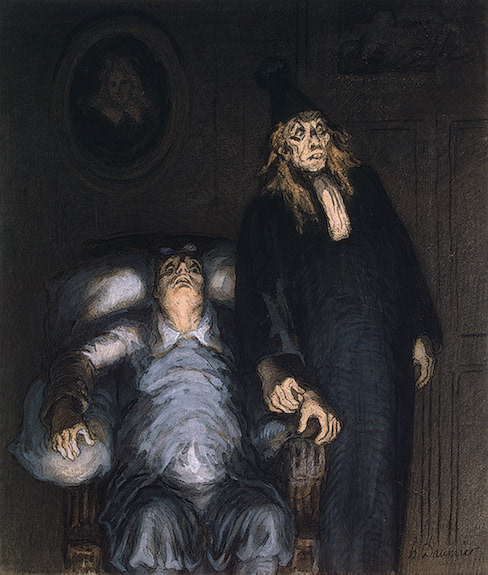
In a series of paintings, Daumier depicted a scene from Molière’s Les Fourberies de Scapin, Scapin’s Deceptions, a Comedia dell’arte-inspired play with a multitude of complications, most of which originate from the manipulations of the cunning valet Scapin. In the scene depicted by Daumier, Scapin is hatching plans together with another valet, here called Cispin, but generally named Silvestre.
Daumier’s image is endowed with a demonic aura that has fascinated me since I first saw it. Scapin is observing something with a calculating gaze and a Mephistophelian smile, while he is listening to something Cispin whispers in his ear – is it common slander, or a diabolical plan?
.jpg)
The image has a suggestive power reminding me of another whisper depicted in a painting by the Italian Francisco Hayez, painted 25 years earlier and placed in Venice. It is called Vengeance is Planned and it also provides a somewhat lugubrious impression.
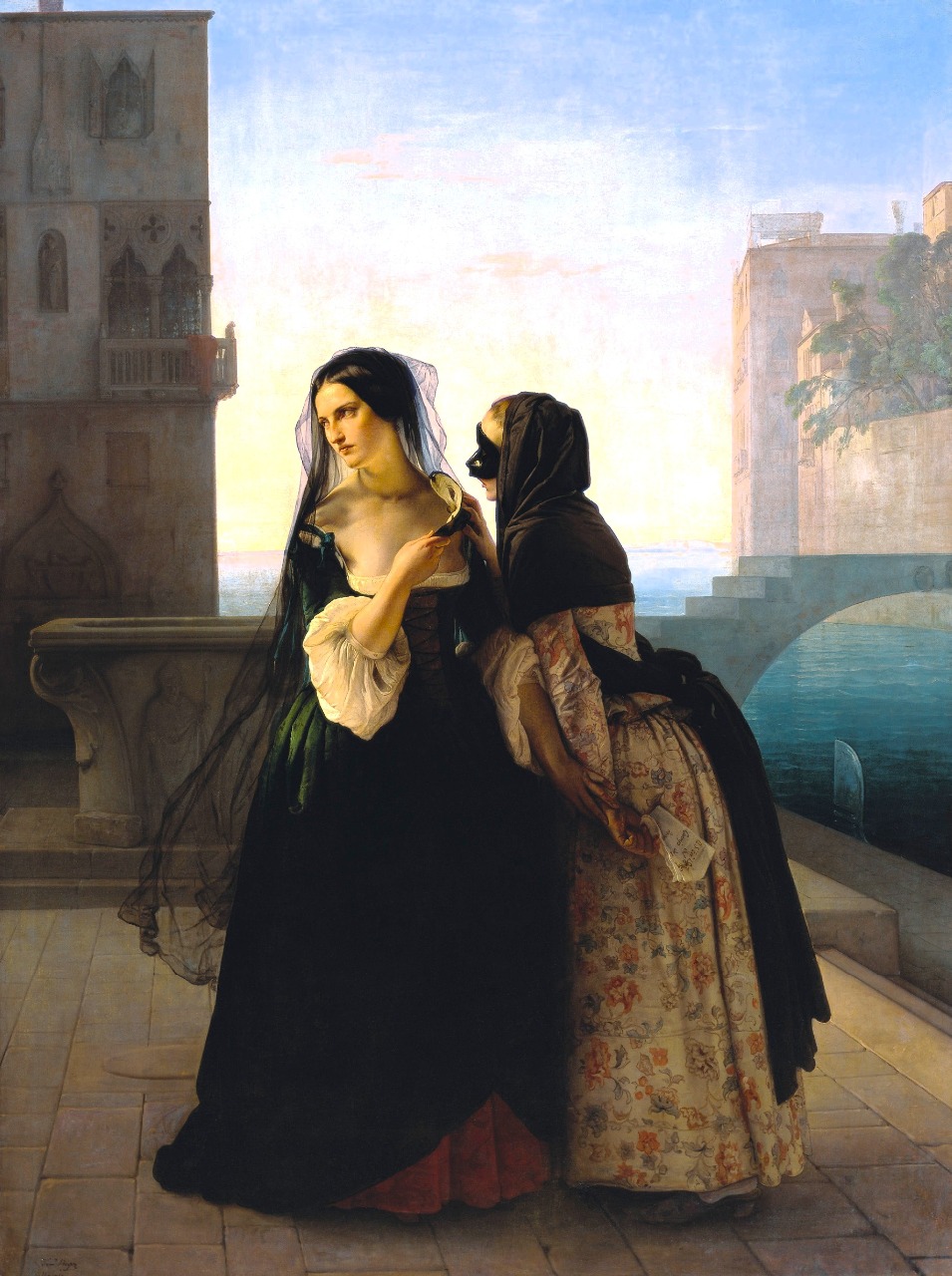
Daumier dedicated at least two more oil paintings to Scapin and Cispin, also dramatically imaginative.
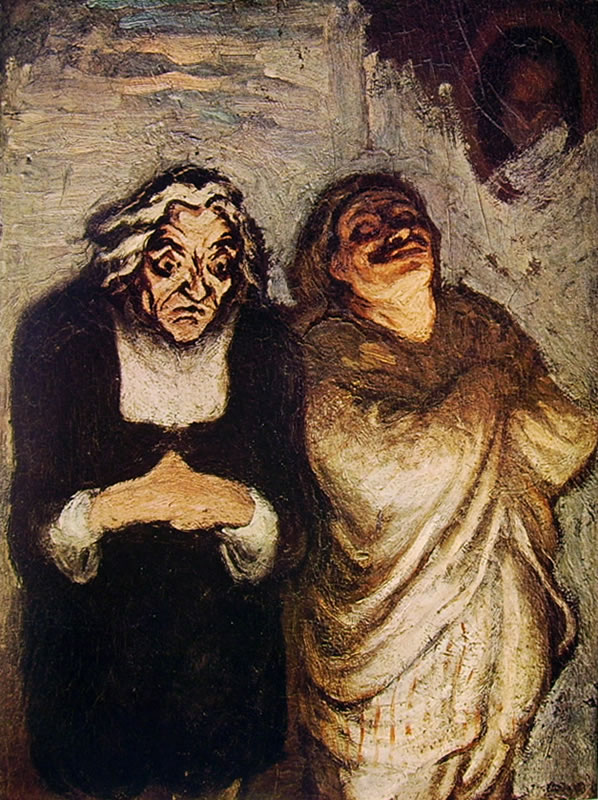
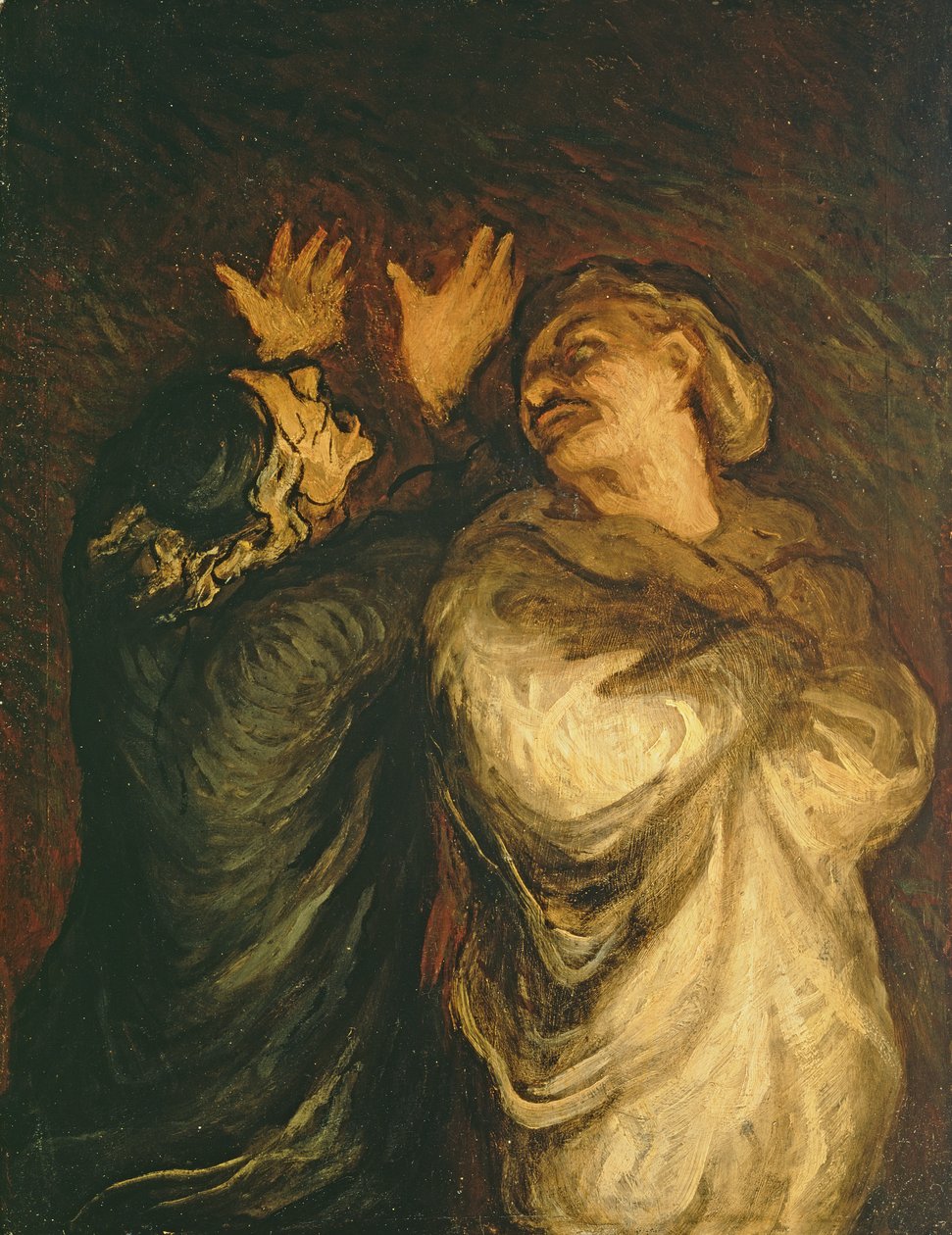
Daumier was not content to simply follow the events on stage. True to his habits, he observed and interpreted his surroundings as well. With his sharp gaze, he noticed how a bored musician yawned in the orchestra pit during a long-winded opera performance.
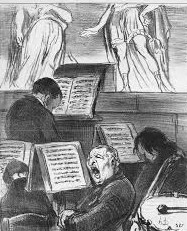
He turned his gaze towards the upper galleries, where poorer spectators had their seats and saw how they intensely following the dramas unfolding on stage.
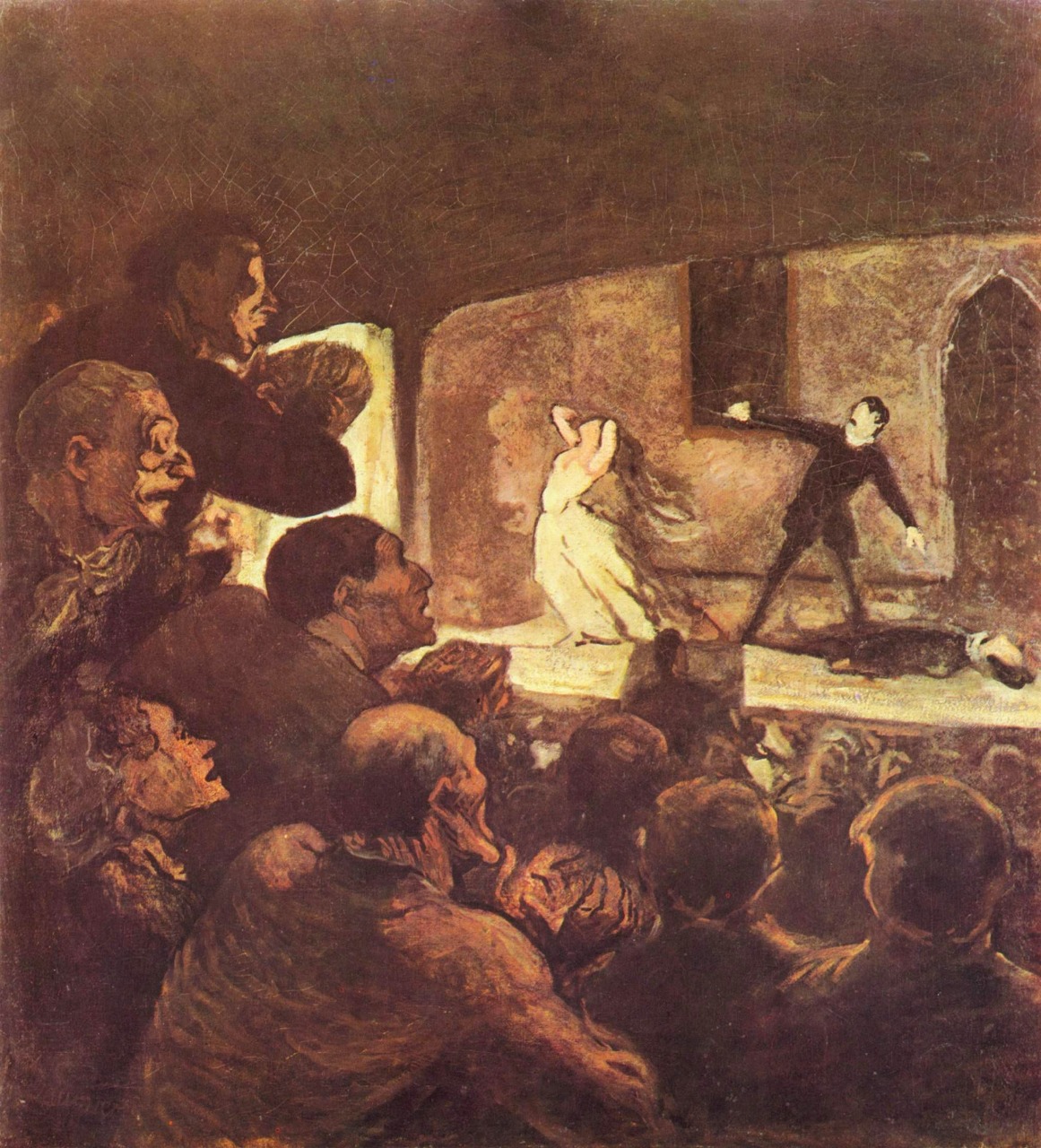
Or the commotion that could erupt when emotions overflowed and disagreements turned into fistfights.
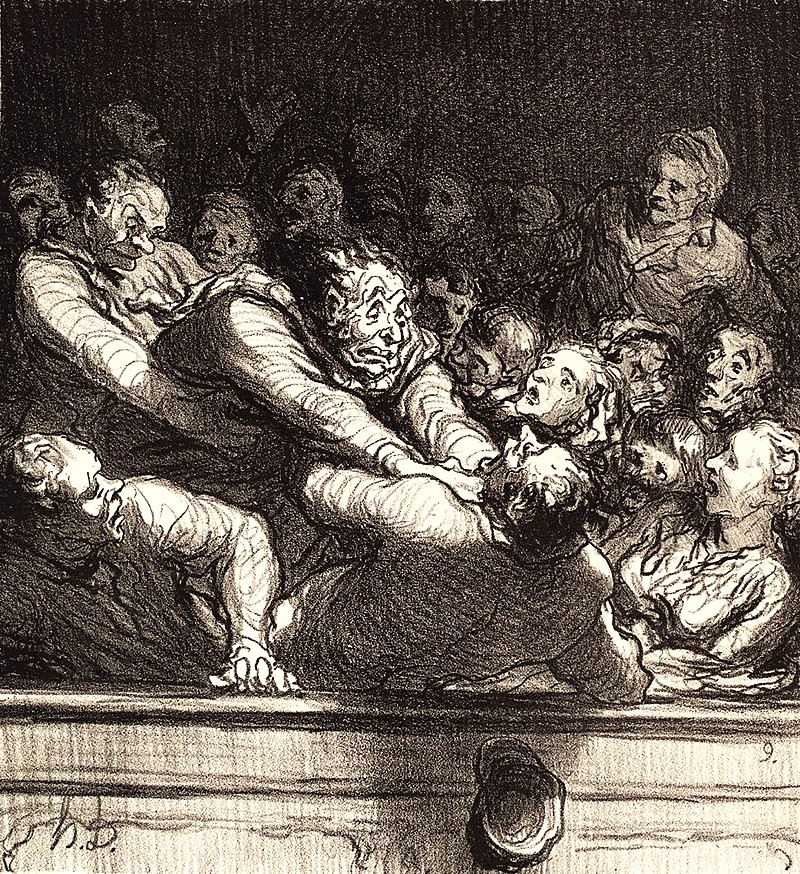
He could also move around among the wealthier spectators further below and observe how they spent breaks between acts.
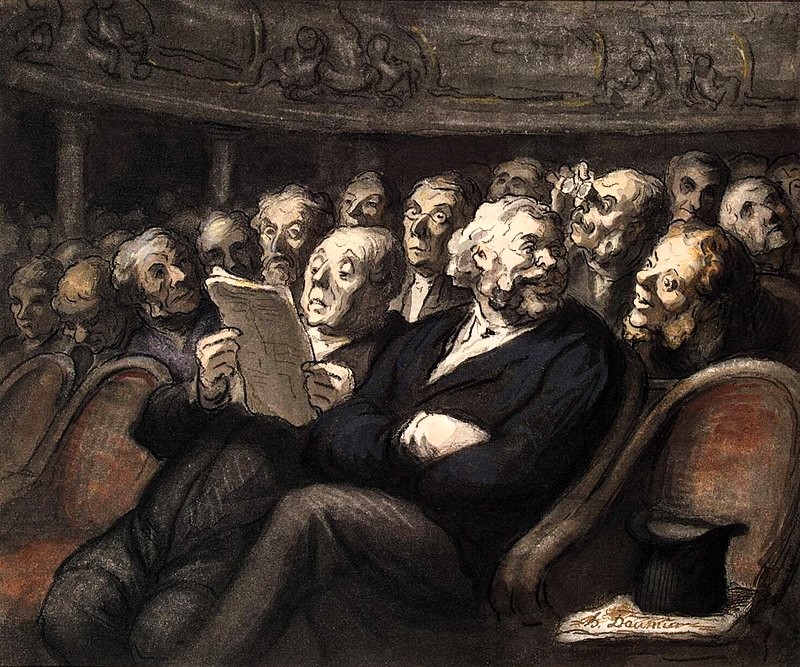
Daumier is an expressionist of a rarely seen kind, though he also has a lot in common with the Impressionists. Like the picture depicting another groups attentive spectators.
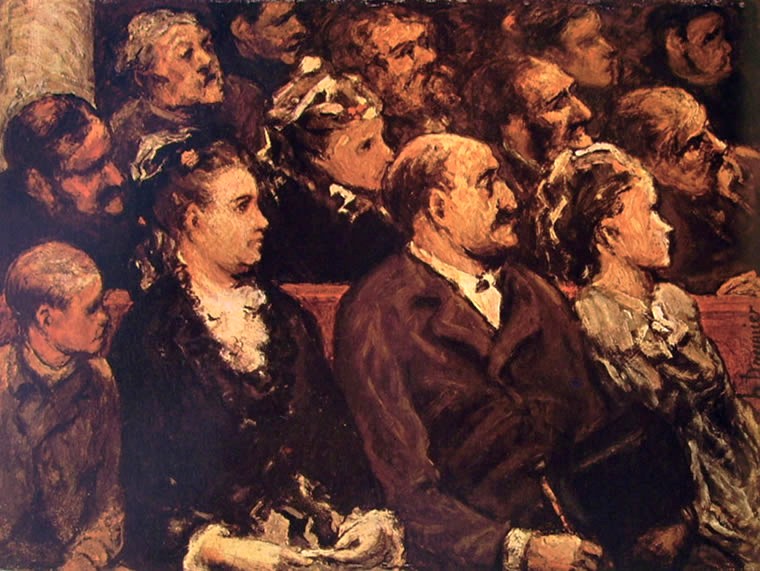
This painting makes me think of artists like Degas and Manet and perhaps even more of the contemporary German Adolph Menzel.
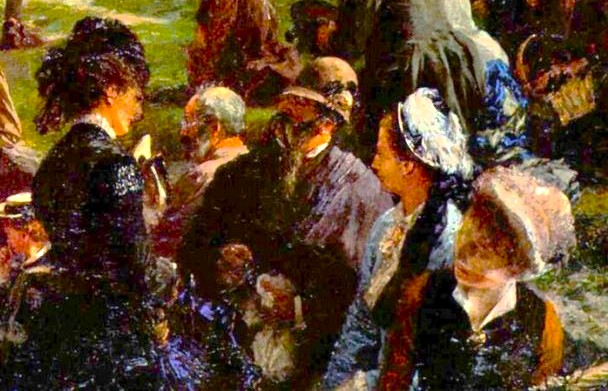
The fact that Daumier did not devote himself so much to classical literature, but was more of a habitué of the theatre, opera, circus and market jesters, did not mean that he lacked literary interests and next to the great illustrator Gustave Doré he became the one who, in my opinion, was best able to empathize with Don Quixote. Consider, for example, how the befuddled knight charges to attack one of his many chimeras, while his faithful friend and confidant Sancho Panza in despair raises his hands to the sky.
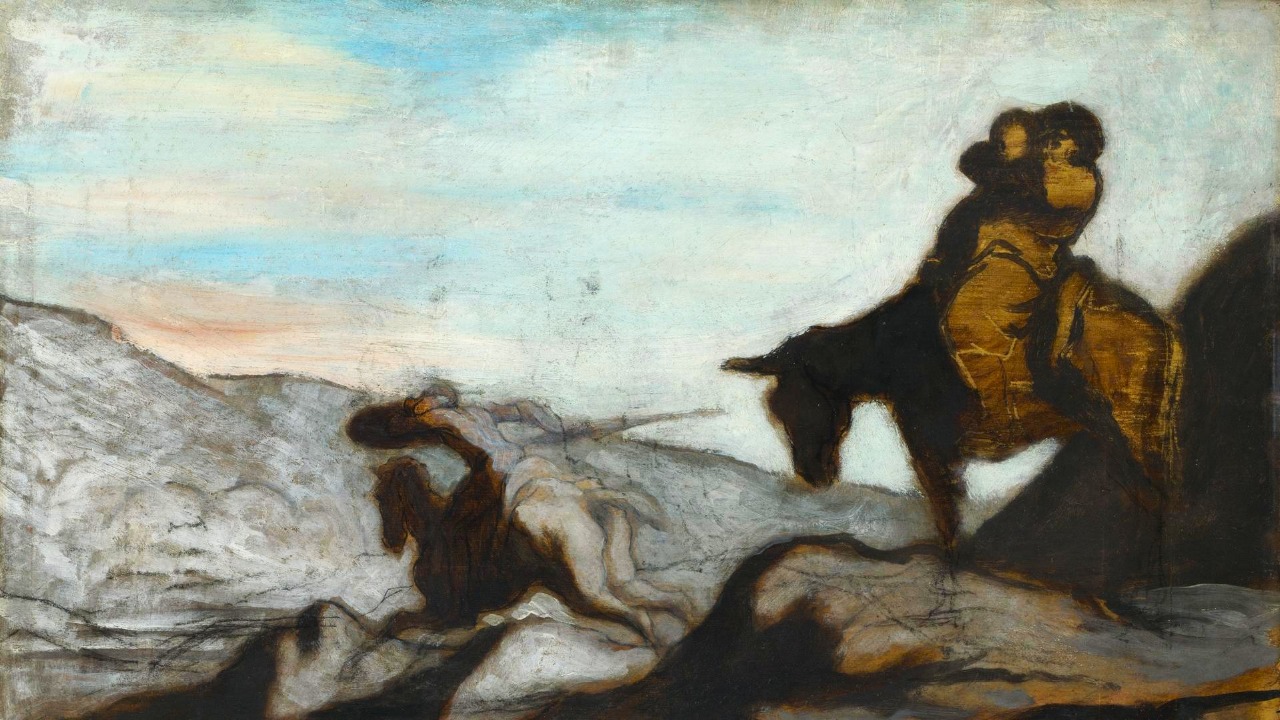
The same Sancho who, with respect and affection, follows his incomprehensibly idealistic master through one adventure after another. The great Don Quixote, always as sitting erect and proud on his frail Rosinante and equipped with his pitiful armour.
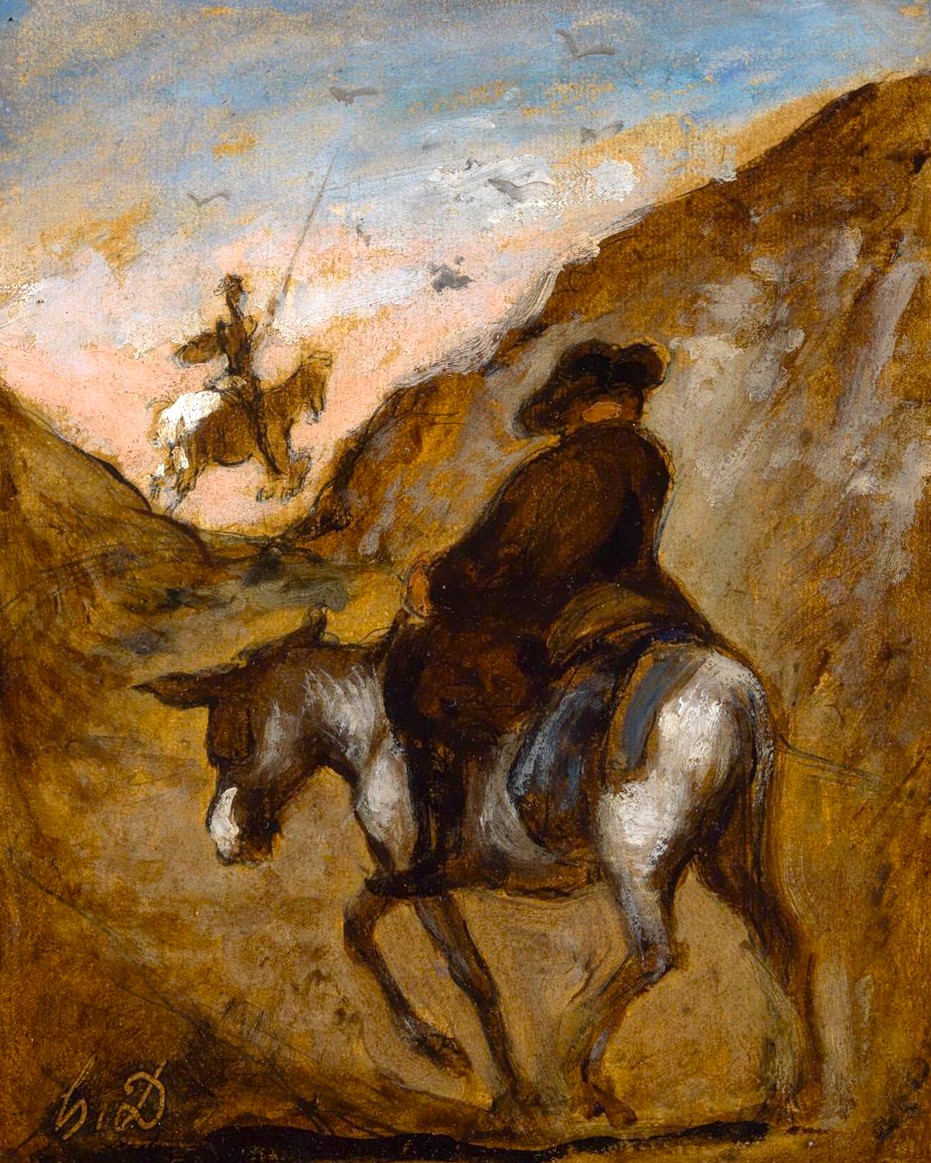
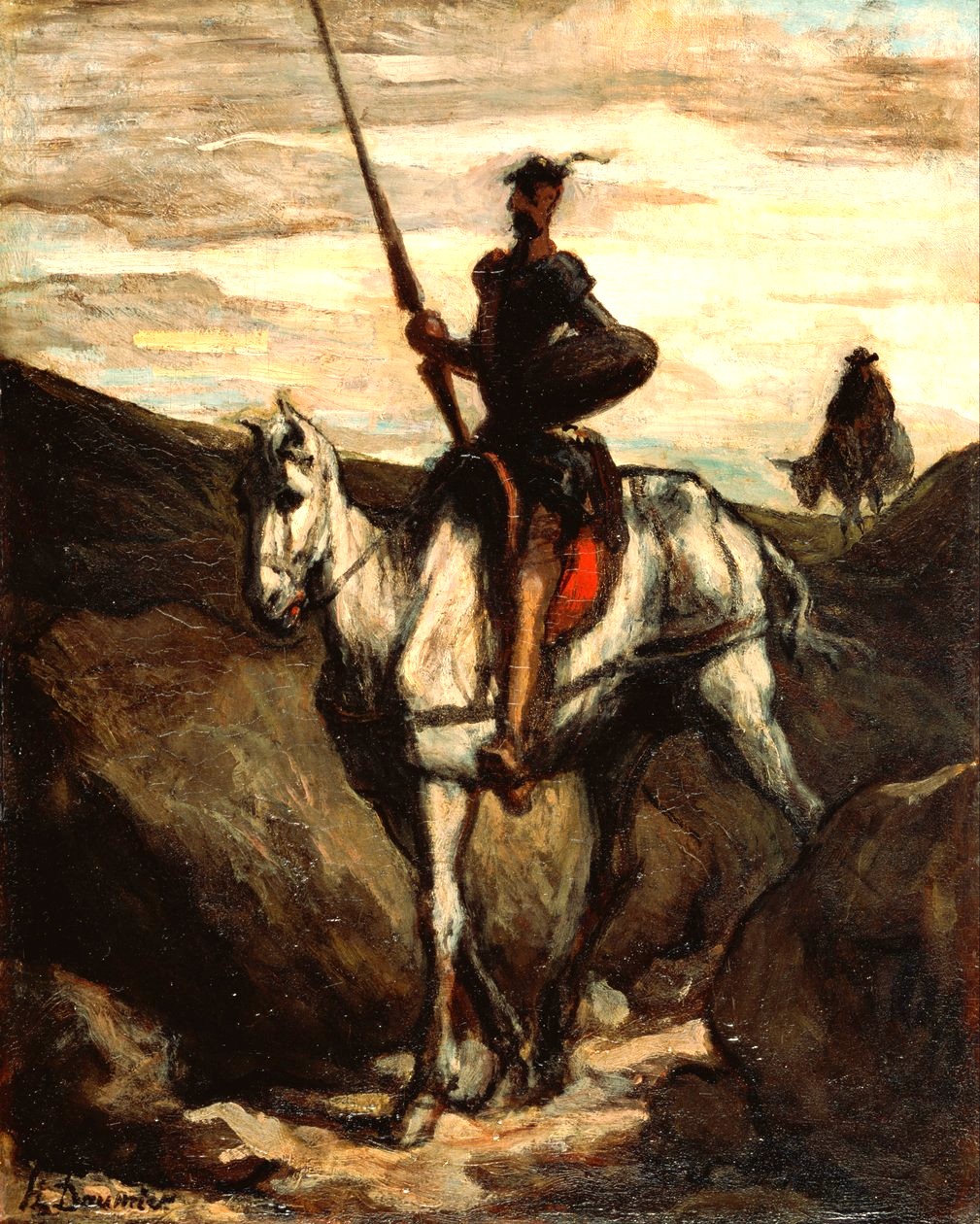
Sancho is sleeping soundly while Don Quixote sits awake and gazes into a fantasy world into which Sancho cannot keep him company.
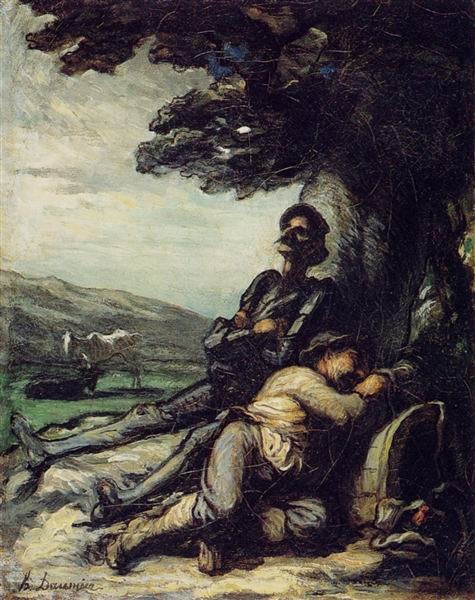
Among Daumier's many illustrations for Cervantes’ Don Quixote, we can also find his preparatory and sometimes unfinished illustrations. With distinctive lines, Daumier firmly evokes the confrontation of the two Spaniards with a dead mule. The perspective is original and perfect, as is the discreet colouring.
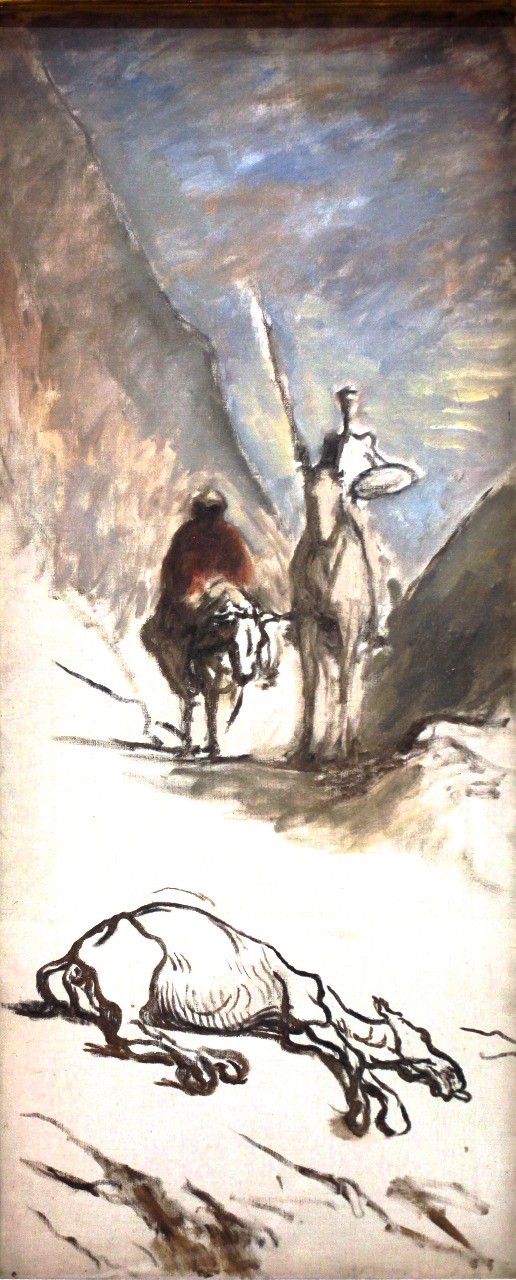
Or take the quickly sketched image of Don Quixote riding down a slope, this is exactly what it looks like when a horse with a rider moves downhill. The diagonal balance is outstanding with Quixote's sharp profile and the angle of the lance creating a perfect triangle.
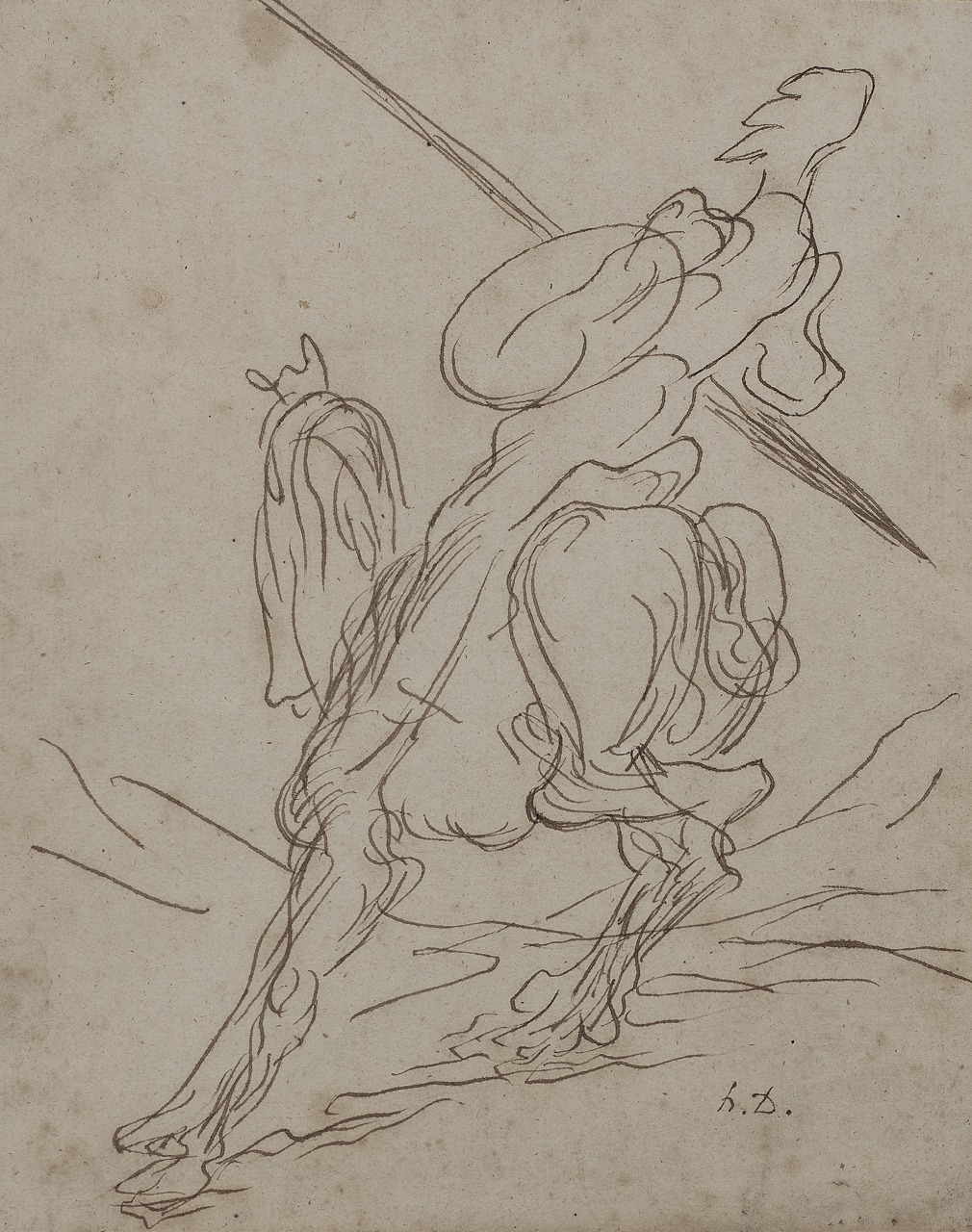
Daumier's linework is not always as distinct like that. He might also create figures through a jumble of lines. Consider this sketch of a pair of wrestlers, it certainly has a dynamic, an almost musical rhythm.
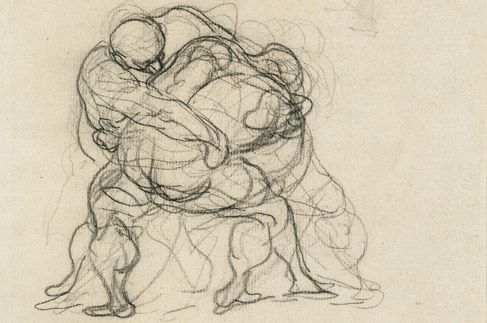
I have often found this rhythm within in Daumier’s art, here he actually depicts a musical moment, filled with his uncanny dynamism:
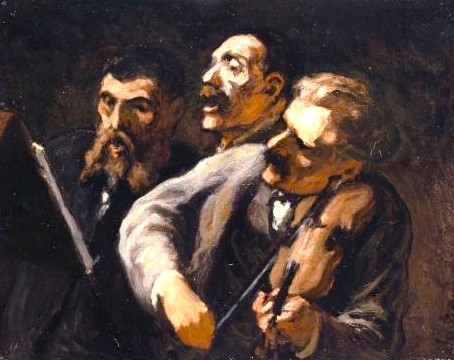
Movement and dynamics fascinated Daumier, as in this oil sketch where he depicted a man pulling himself down a rope.
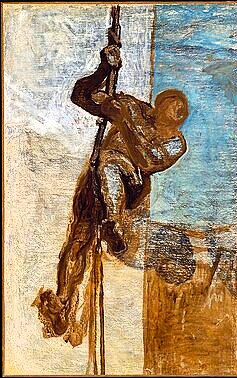
All the time this sharp gaze, this empathy. Another dynamic sketch also depicts two men wrestling, but here is a furious rage that was missing in the previous fight.
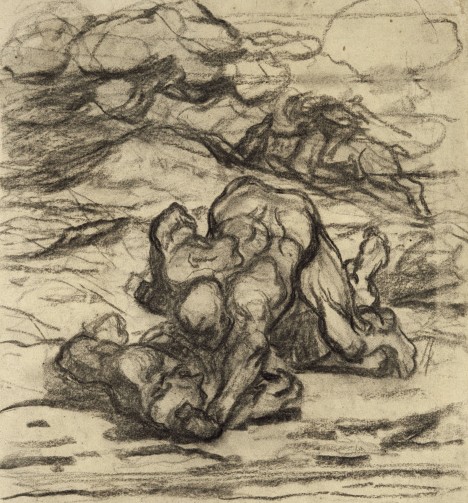
The oil painting that resulted from that sketch has retained, perhaps even amplified, the blind fury. The combatants are locked in a life-and-death struggle, while a third person in the background appears to be stealing a donkey from one of them.
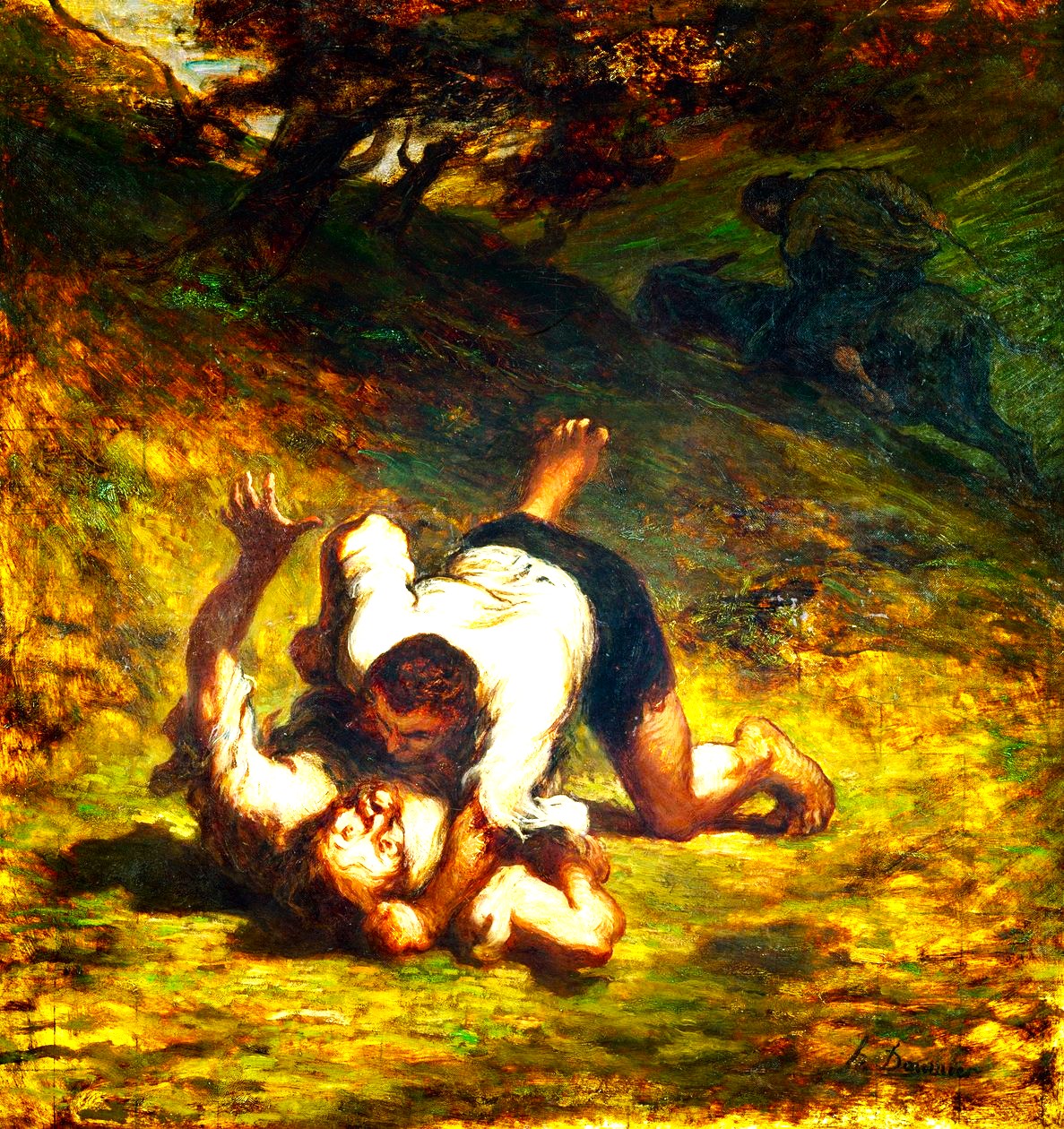
The wrestlers in the first sketch are professional fighters, and the painting they are based on I saw several years ago at Ordrupgaard in Charlottenlund outside Copenhagen, an art museum founded by the insurance firm owner, art collector, and millionaire Wilhelm Hansen. I visit this museum again after the world-famous Zaha Hadid in 2005 designed a light and airy exhibition space.

It is always a special feeling to end up in front of an original work of art and perhaps because I had that lithograph I mentioned above by my bed, I was particularly fascinated by Daumier's strongman waiting behind a curtain for his entrance in the circus ring. He looks towards the powerful wrestlers who are engaged in their fight. The lone pugilist does not convey strength and power, but rather vulnerability and loneliness, like Pierrot in Watteau’s famous eighteenth-century painting.
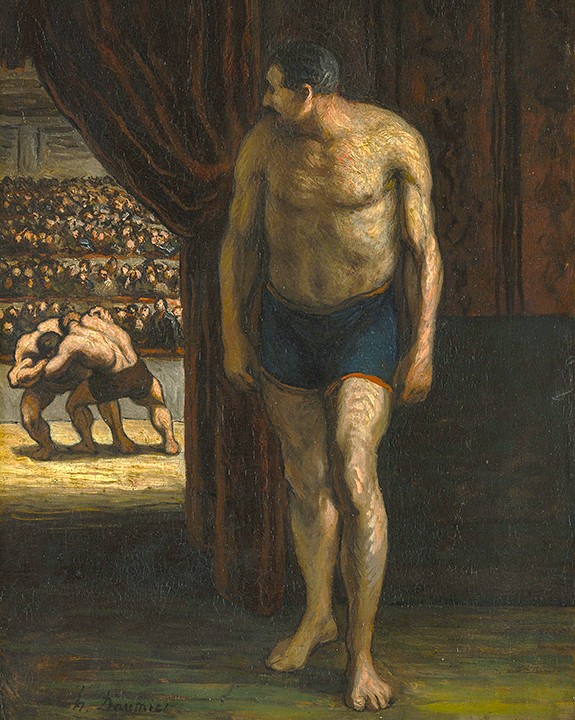
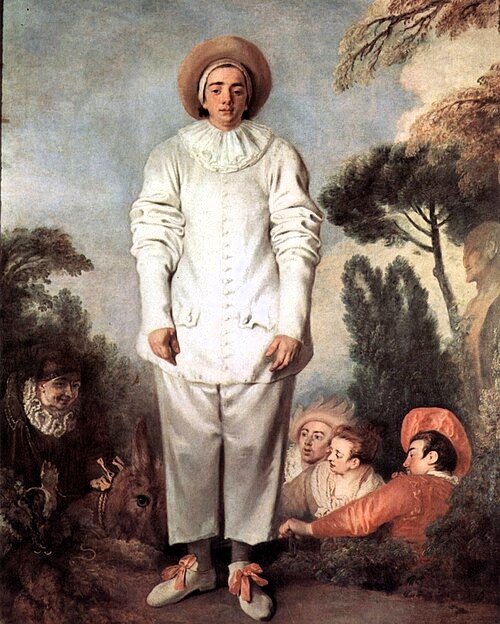
Market people, artists and jesters were Daumier’s soul mates, not lawyers, politicians and military men. He discovered the artistry in unassuming musicians, actors and chess players. Daumier’s market announcers are professional actors just like his cheating lawyers, but their artistry is art for art’s sake, not an act before an unsuspecting audience, or a humiliating, servile submission before some corrupt ruler.
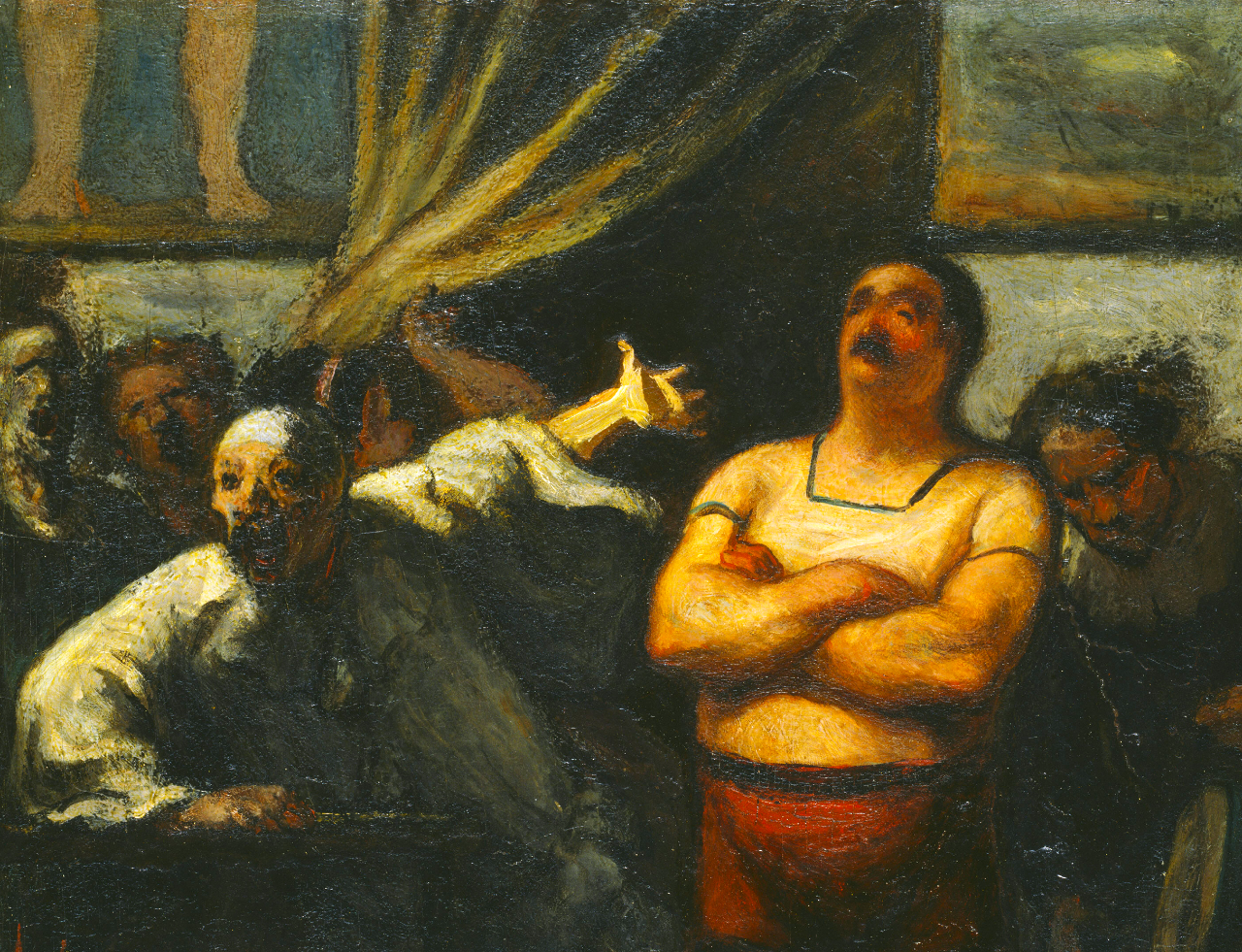
Sometimes Daumier’s actors wear a mask, but it doesn’t hide any cheating and corruption. His circus folks exaggerate and try to attract their audience, but they don't hurt anyone. They lie, but the lie is part of the act, the make-believe, the entertainment, the audience is well aware of the lie, its part of the amusement.
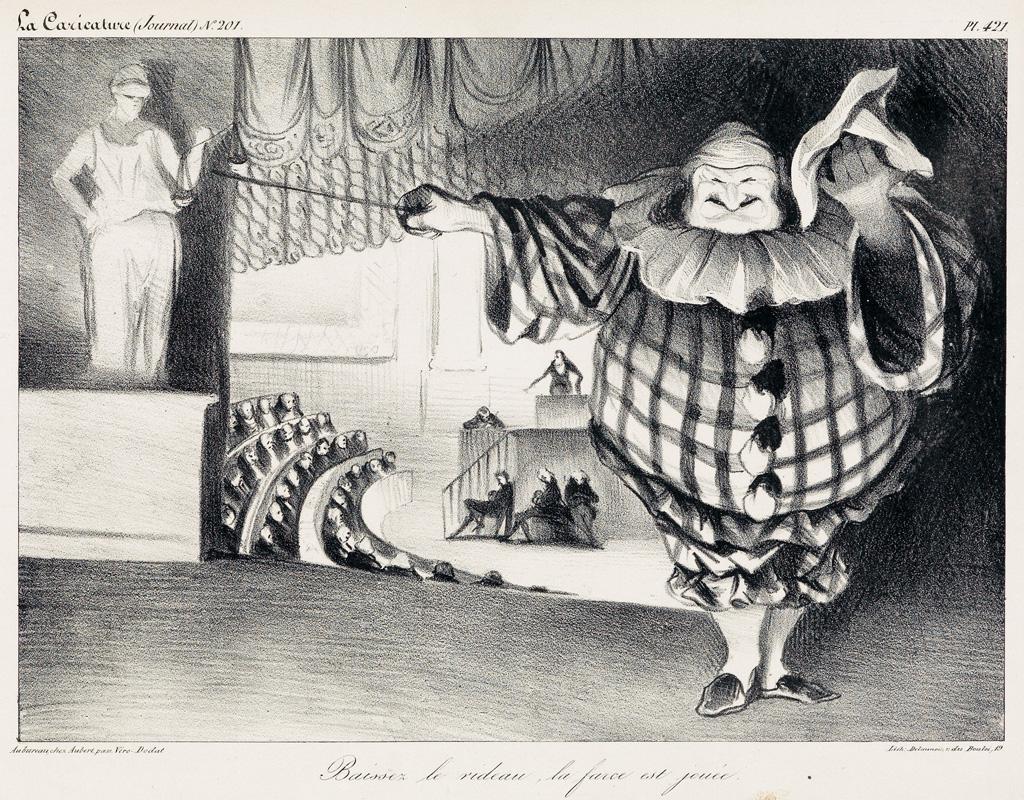
People shout, sing, play and scream, but in all the commotion there is an authenticity that reveals what it's all about – simple joy and entertainment.
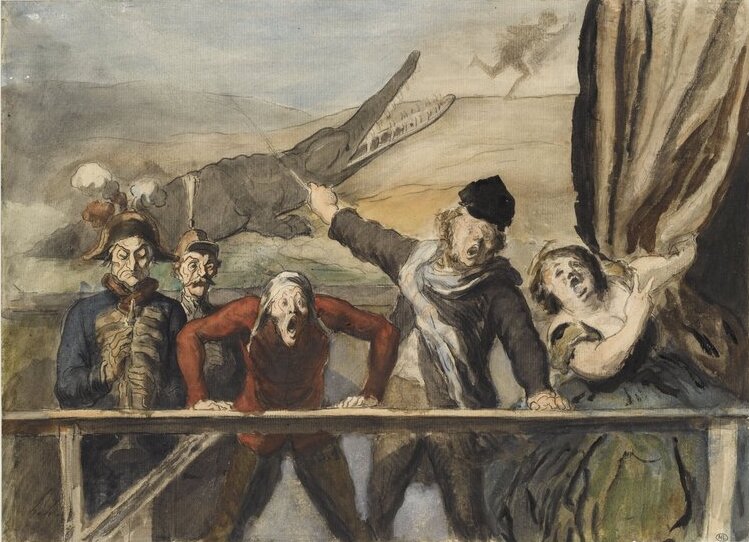
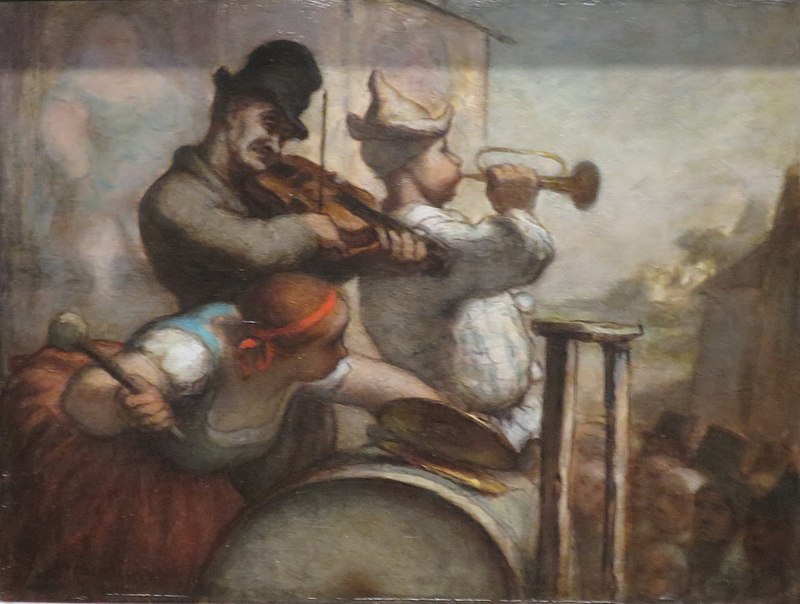
Daumier's art is also genuine. Not only in its fearlessness, its direct expression, its straightforward political stance, its depiction of life as it is, but also in its technique. He paints in a way that makes his viewers understand that what we see is art, "a part of a landscape seen through a temperament", not a photographic account where the brushstrokes have been hidden. At times, Daumier is so straightforward that his thick brushstrokes might bring to mind an abstract painting.
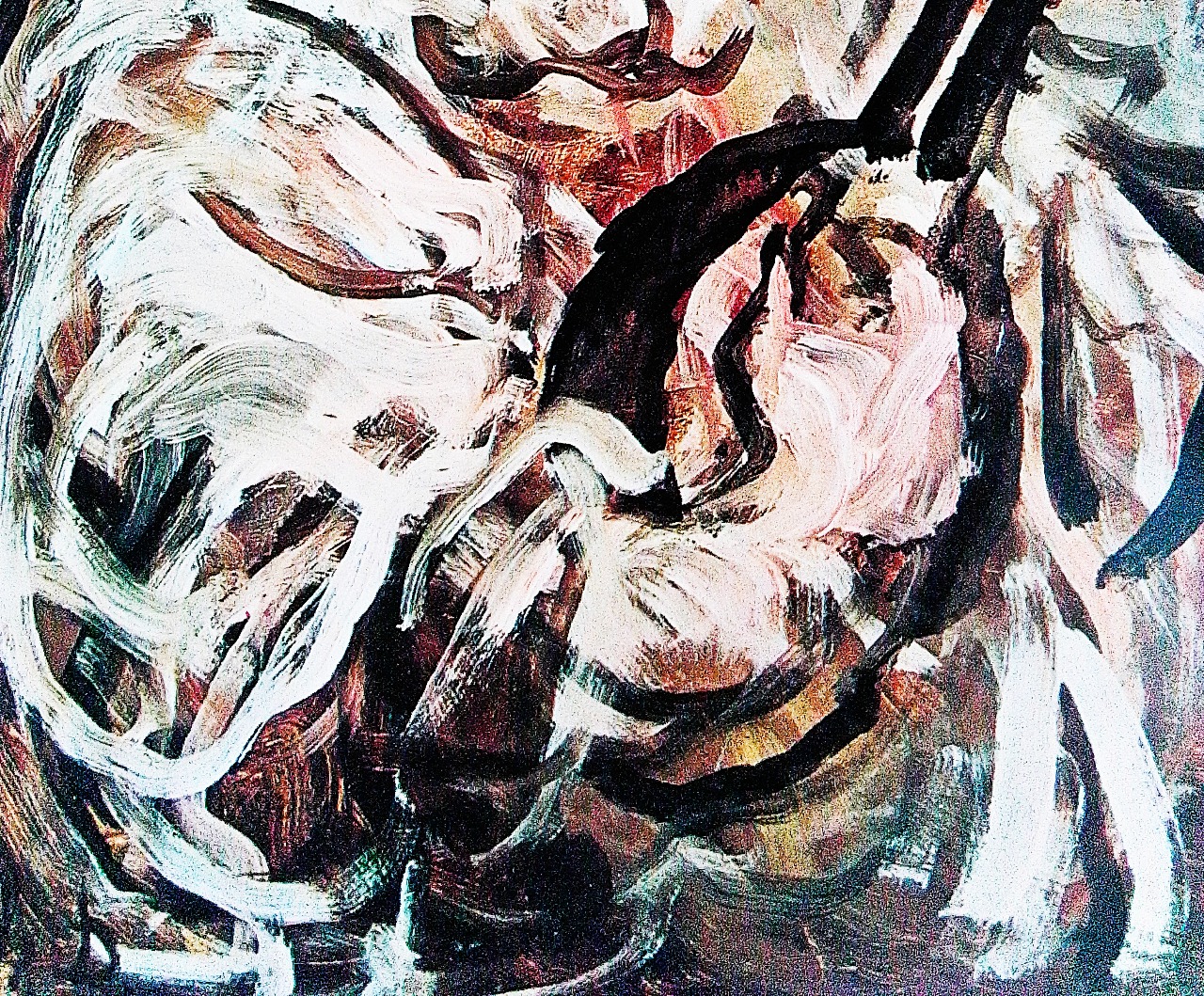
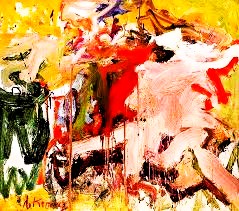
But the jumble of white lines, grey background and skin tones becomes a rhythmic whole that depicts how a Pierrot tunes his mandolin.
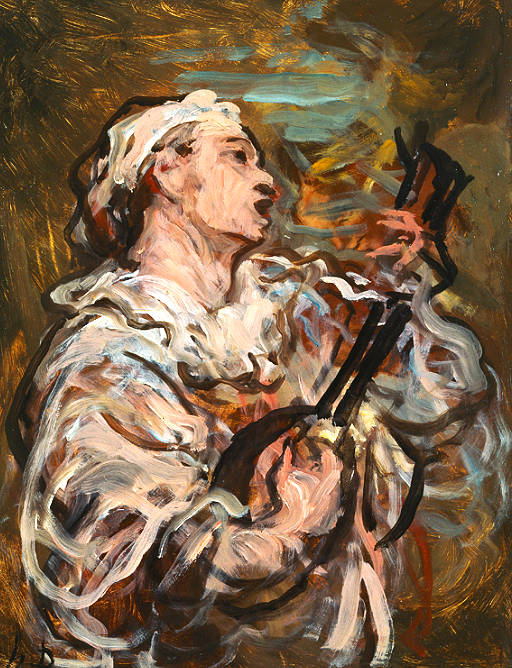
Does Daumier have no predecessors? He is certainly unique; lithography was a relatively new technology so he was in many ways a pioneer. When it came to his paintings and sketches, we find examples of contemporary predecessors, such as the slightly younger Millet and the slightly older Delacroix, who sometimes come close to Daumier.
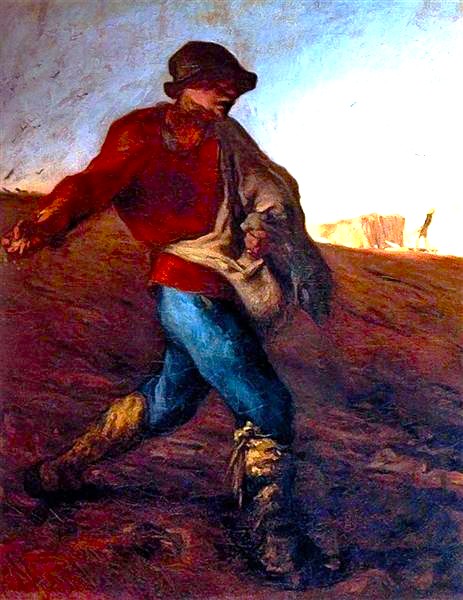
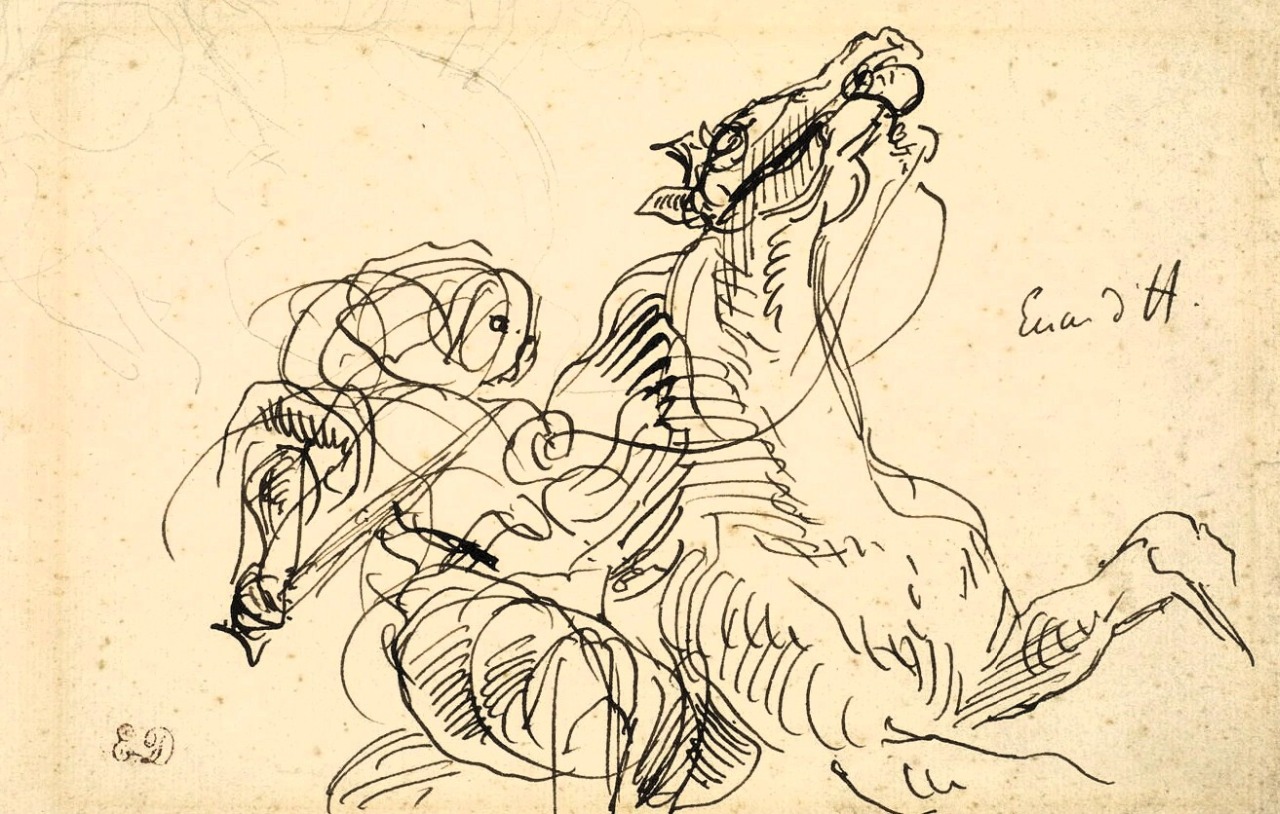
When it comes to older masters, he may have been influenced by Rembrandt’s brown, black and golden chiaroscuro.
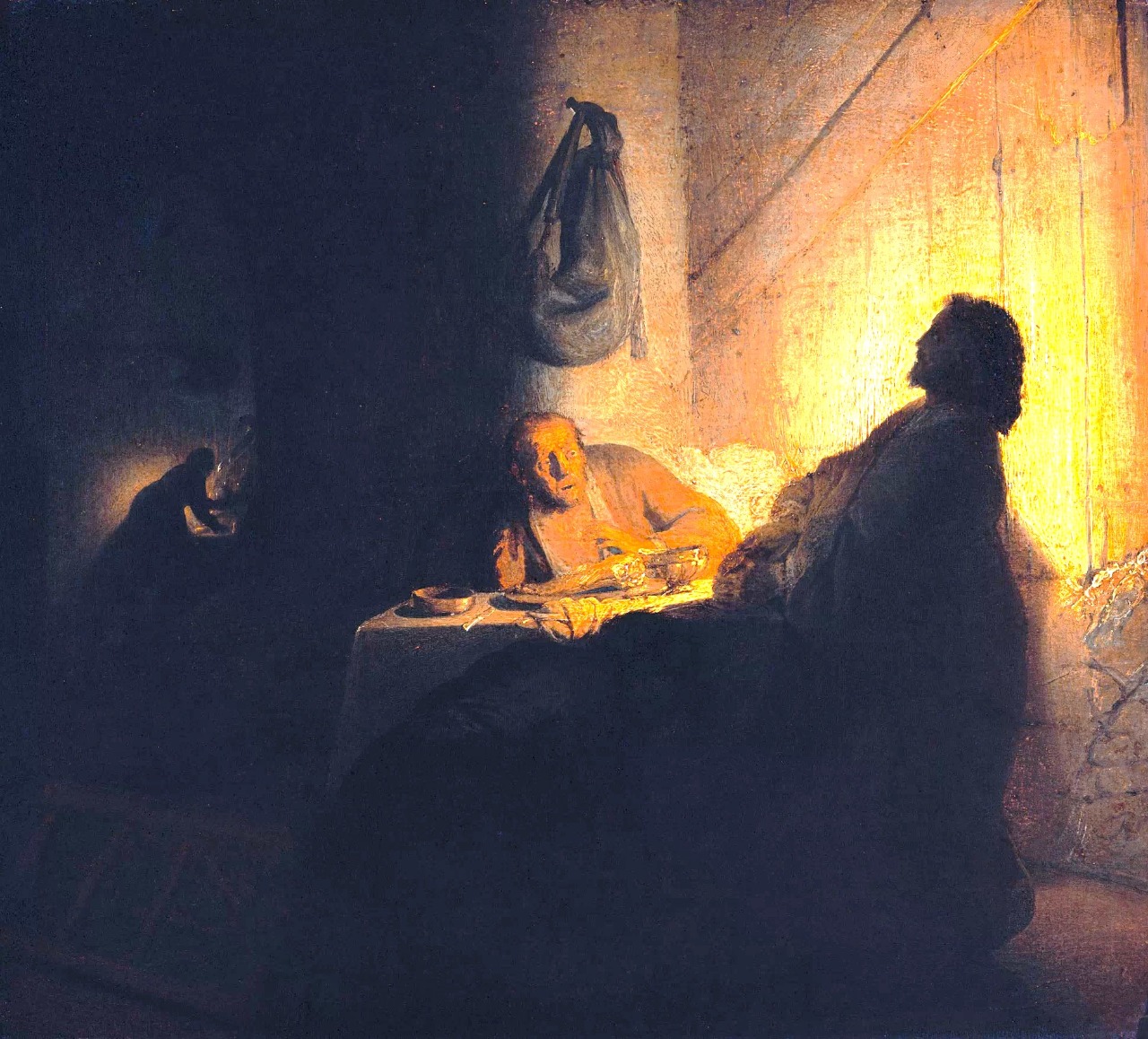
Daimier reminds me of the Genovese painter Alessandro Magnasco (1667–1795) both when it comes to the palette as the dynamic brushstrokes.
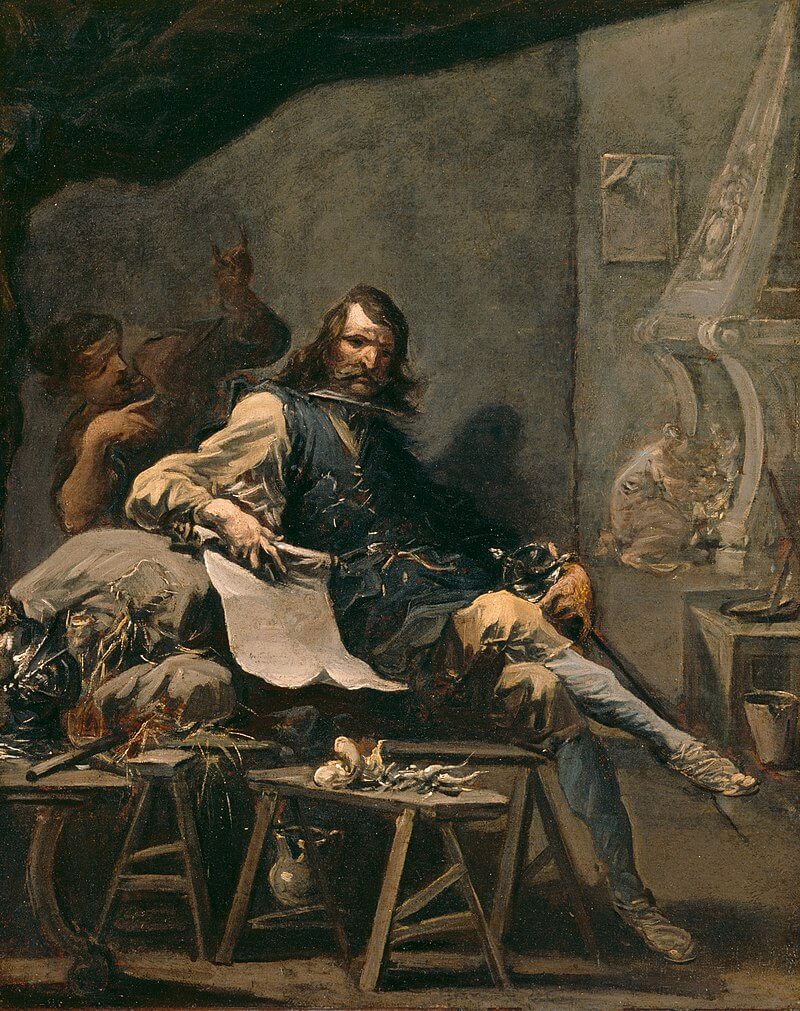
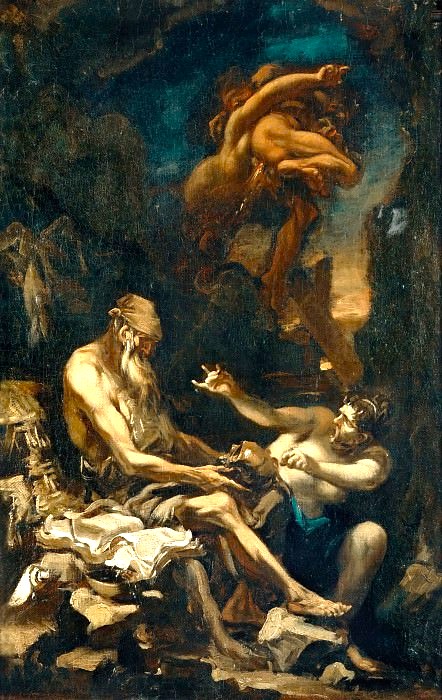
Daumier’s Don Quixote Reading, seem to evidence associations to Magnasco.
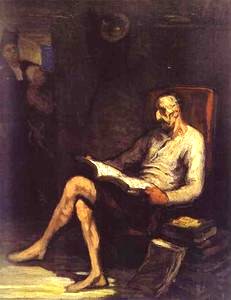
Perhaps he had seen the Magnasco paintings in the Louvre, for example the one depicting a gypsy wedding.
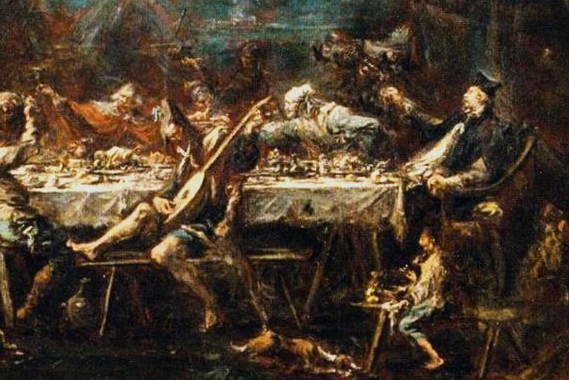
Nevertheless, to me Daumier is and remains unique, not least because for the many years I had his lithograph above my bed and often looked at the pale, helpless, and obviously poor girl in front of her judges. One of whom kept looking straight at me. Under the picture Daumier had written Huis clos – Behind closed doors.
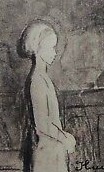
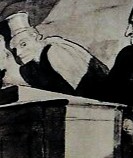
Mandel, Gabriele (1971) L’Opera pittorica completa di Daumier. Milano: Rizzoli editore. Ramus, Charles F. (1978) Daumier: 120 Great Litographs. Garden City, New York: Dover Art Books
Honoré Daumiers uppriktiga och oklanderliga konst
För många år sedan fick jag en litografi av min äldsta syster. På den tiden var hon flygvärdinna och hade köpt den hos någon bouquiniste i Paris. Säkerligen inte en originalitografi, men sådant har jag aldrig brytt mig om, huvudsaken är motivet – i det här fallet var litografin av Honoré Daumier (1808–1879) och jag hade den under flera år ovanför min säng. Den föreställde en mager, nästan genomskinlig liten flicka framför ett gäng advokater/domare.

Varför hade hon hamnat där? Hade hon gjort sig skyldig till något brott? Varit utsatt för, eller bevittnat ett sådant? En av advokaterna/domarna vänder sig mot betraktaren. Är det någon som yttrat något? Har någon kommit in i rummet och avbrutit processen? Betraktaren blir en del av bildens drama. Jag fantiserade och drömde om den där litografin. Den var annorlunda; levande, märklig. Ett utsnitt från en längesedan förgäten tid.
Daumier? Han gjorde fler än 500 oljemålningar, 1 000 akvareller, 1 000 träsnitt och fler än 4 000 litografier, alla av högsta kvalitet, mycket oförglömligt. En av mina svågrar gav mig en bok med Daumiers litografier och jag tröttnar aldrig på att titta i den.

En satirens guldgruva där den oberoende anarkisten Daumier på ett strålande humör gisslar, förtalar och skrattar åt monarkin, aristokratin, prästerskapet, politikerna, rättsväsendet, advokaterna, polisen, detektiverna, de rika, militären, borgarklassen, alla sina landsmän och den mänskliga naturen i allmänhet.
Till min förvåning gjorde Paul och Linda McCartney 1993 en kortfilm kallad Daumiers lag. Linda var en professionell fotograf som sedan barndomen varit konstintresserad och speciellt fascinerad av Daumier. Hennes mor var modedesigner och fadern en advokat specialiserad på lagstiftning rörande underhållsindustrin. Han räknade bland sina klienter berömda konstnärer som Willem de Kooning och Mark Rothko.
Lindas daumierintresse inspirerade McCartney att till bilder av Daumier komponera minimalistisk musik; enkla, modernistiska stycken, baserade på teman från Daumiers konst – marknader, domstolar, Don Quijote.
McCartney kontaktade konstnären Geoff Dunbar, som 1984 tillsammans med paret McCartney gjort den tecknade kortfilmen Rupert and the Frog Song, Rupert och grodsången, som handlade om hur björnen Rupert en natt hamnat på en mystisk underjordisk plats där grodor vart hundrade år utförde en rituell show och då sjöng en charmerande sång av McCartney – We All Stand Together, Vi står alla tillsammans, arrangerad av den ”femte Beatles”, producenten George Martin.
Musikvideon sändes gång på gång på MTV. Vi bodde då i Dominikanska Republiken där musikvideokanalen sändes flera år innan den dök upp i Europa. Min då två-åriga äldsta dotter var fascinerad av McCartneys grodsång.

https://www.youtube.com/watch?v=6PMiP90ntZ8
En god vän sa mig en gång att han ansåg att det var John Lennon som gav saltet och djupet till Beatles repertoar, alltmedan Paul McCartney stod för det ”ytligt folkliga”. Han menade att vad McCartney åstadkom var trallvänliga ”pubsånger” och att det är var vad han gjort sedan Beatles bröt upp. Kanske hade han i viss mån rätt. Under alla förhållanden var filmen Rupert and the Frog Song djupt rotad i engelsk folklig, barntradition.
Rupert, i Sverige kallad Olle Brum, är en engelsk barnseriefigur skapad av en viss Herbert Tourtel och illustrerad av hans hustru, Mary. Rupert dök 1920 upp i tidningen Daily Express där den lever vidare.

Rupert är ett mycket engelskt fenomen. Den lille, älsklige björnen bor tillsammans med sin piprökande, trädgårdsodlande far och husliga mor i en hemtrevlig stuga belägen i det bukoliska Nutwarje berättelse tar sin början i den där stugan från vilken Rupert vanligtvis ger sig ut på ett litet ärende för sin mor, eller för att besöka en vän, något som sedan utvecklas till ett äventyr på en exotisk plats, som Kung Frosts slott, Fåglarnas rike, i underjorden eller på havets botten.
Historierna om Rupert har blivit en integrerad del i engelsk barnkultur och har gett upphov till ett otal barnböcker, filmer, TV-serier och dockor. McCartneys och Dunbars kortfilm är en förälskad hyllning till denna mysiga, trygga och samtidigt spännande värld. Och … grodsången är förvisso en alldeles utmärkt ”pubsång”.
https://www.youtube.com/watch?v=WfEyEp62-l4



Nåväl, det var alltså naturligt att Paul McCartney vände sig till den kongeniale Geoff Dunbar och bad honom att på grundval av sin minimalistiska musik och sitt och Lindas manus göra en kortfilm baserad på Daumiers bildvärld. Resultatet är fascinerande, speciellt för någon som är förtrogen med Daumiers konst. Så gott som varje sekvens anspelar på ett av Daumiers många konstverk och animationen är skickligt utförd. Filmen kan faktiskt betraktas som en utmärkt introduktion till Daumiers produktion.
https://www.youtube.com/watch?v=V-WlJ3ZXZc4

I dessa tider av trumpismens tystande av all vederhäftig kritik, som med Mammon i ryggen kväver det fria ordet, har min beundran för den genomskicklige och orädde Daumier ökat än mer.
Jag gav i en tidigare blogginlägg ett exempel på hur jag tystats genom , dumdryga censur som likt en kväljande degklump lägrat sig över USA:s fria ord och på ett skandalöst sätt försökt tysta komiker om Jimmy Kimmel och Stephen Colbert.
Jag betraktar med uppskattning en litografi av Daumier där den Fria Pressen utdelat ett dråpslag mot den bakåtsträvande monarkin och gör sig beredd att möta bourgeoisiens och penningmaktens representanter.

Då Daumier gjorde den litografin hade han redan råkat i klammeri med sin tids trumpister. År 1831 hade Daumier i skämttidningen La Caricature framställt kungen Ludvig Philipp I som jätten Gargantua, i vars gap den allt fattigare befolkningen tvingas leverera lass efter lass med sina surt förvärvade inkomster.

Året därefter ställdes Daumier inför rätta och anklagades för att ha ”uppviglat hat och förakt mot regeringen, samt förolämpat konungen.” Han dömdes till sex månaders fängelse och böter på 500 franc. Men, Daumiers berömmelse hade redan blivit så pass stor att ljudliga protester restes mot domen. Den store författaren Balzac utropade, med all rätt: ”Den här killen har ju Michelangelo i blodet!” Domen sköts upp, men Daumier tystnade inte.
Senare samma år publicerade Daumier en bild han kallade Kung Pétauds hov i vilken han karikerade hur Konung Ludvig Philipp I den Förstes underdåniga kabinett. Man ser inte kungen själv men en nidbild av hur hans lismande ministär förödmjukar sig inför honom.
.jpg)
Denna gång arresterades Daumier i sina föräldrars lägenhet och placerades i Sainte-Pélagies fängelse, där han avtjänade sex månader. I fängelset fortsatte Daumier att producera sina regeringsfientliga teckningar som smugglades ut för att enligt honom ”ytterligare irritera regeringen”.
Uttrycket Kung Pétauds hov härstammade antagligen från en tid då Paris tiggarkommunitet utsåg en ledare som fick namnet Roi Pétaud, från latinets peto, jag ber. Denne potentat regerade från Cour des miracles, Mirakelgården, som syftade på ett slumområde där arbetslösa migranter från landsbygden bodde. En tillflyktsort för de stackare som kommit dit för att gömma sig från myndigheterna. Platsen kallades Mirakelgården eftersom de lama där kunde gå och de blinda fick synen tillbaka, en anspelning på att flera av de som tiggde på Paris gator gjorde det i sken av att de led av olika lyten, som de i själva verket fejkade för att väcka empati.
I Victor Hugos Ringaren i Notre Dame från 1831 irrar poeten Gringoire in på Mirakelgården där han stöter på Clopin, som han tidigare trott vara en vanlig tiggare, men som visade sig vara kungen av Truands, Paris brottslingar och utstötta. Clopin dömer Gringoire till döden för ”olaga intrång”, men i sista sekund räddas Gringoire av den vackra Esmeralda genom att gå med på att gifta sig med honom. Clopin dyker upp i Disneys version av Ringaren i Notre Dame.

Daumiers hänvisning till Hugos aktuella tiggarkung kunde knappast ha gått den läsande parispubliken förbi. Louis-Philippe I hade till en början varit relativt populär. Eftersom han hade sin tron att tacka en folklig revolution kallades han för ”Medborgarkungen”, och hans anhängare hyllade honom ytterligare som ”barrikadernas konung” för att därigenom understryka de folkliga sympatierna och kungens yttre sken av anspråkslöshet. I själva verket fann Louis-Philippes regim sitt stöd främst från den rika borgarklassen; industrialister och bankirer. Ludvig Philipps regeringstid dominerades av rika industrialister och bankirer.
Under medborgakungens ledning försämrades arbetarklassens villkor och inkomstklyftorna ökade avsevärt. Redan vid början av Ludvig Philipps regering hade flera av Paris intellektuella uppmärksammat att regeringen i själva verket var en plutokrati styrd av landets välbeställda kapitalister, helt i enlighet med deras självcentrerade intressen och under den populistiska ytan ökade klassförtrycket, medan angiveriet spred sig och oppositionen tystades.

Givetvis fanns det på den tiden inga irriterande TV-komiker, men skämtpressen, med tidningar som La Caricature och Charivari, Rabalder, gisslade oförtrutet kung Louis-Philippe och hans svans av smickrare gjorde allt i sin makt för att tysta kritiken, som liksom fallet nu är med Trump, förlöjligade kungens uttalanden och utseende.
Berömt blev hur karikatyrtecknaren Charles Philipon anklagades för att ha förlöjligat kungen då han i tidningen La Caricature framställt Louis-Philippe som en murare i färd med att skyla över den så kallade junirevolutionens slagord och ledande namn.

I ett ironiskt försvar undrade Philipon hur Rätten kunde vara så säker på att det var Louis-Philippe han framställt som murare, trots allt kunde man ju kunna likna konungen med vad som helst, exempelvis med ett päron och för att förtydliga sitt påstående visade Philipon en teckning han gjort på vilken Louis-Philippe successivt förvandlats till ett päron.
Philipon dömdes 1831 till sex månaders fängelse i Sainte-Pelagie, där Daumier redan satt inspärrad, och ovanpå det dömdes Philipon till 2 000 francs i böter och ytterligare sju månader för andra förseelser. Den famösa päronteckningen trycktes dock 1834 i Le Charivari och spreds snabbt även utanför Frankrikes gränser.

Följden blev nya böter för Le Charivari, som flera gånger tidigare åtalats för regeringsförtal och uppvigling. För att samla in pengar så att böterna kunde täckas tryckte Le Charivari päronbilden separat och sålde den för två sous. Denna gång var det uppenbarligen Daumier som gjort en ny version av Philipons ursprungliga teckning.

Kampen mot censur och annat förtryck tog sig hos Daumier inte enbart satiriska uttryck, han kunde också göra illustrationer som med djupt allvar uttryckte hans missnöje med regimens dåligt förtäckta terror. Som då protester blossat upp 1834 och Louis-Philippes milis öppnat eld mot ett bostadshus som antogs vara ockuperat av rebeller, istället för regimmotståndare massakrerades ett antal fullkomligt oskyldiga familjer.
Den döde familjefadern, som liggande död med nerblodad nattskjorta har fallit över och krossat sitt barn, visar hur oskyddade och oskyldiga de dödade varit. Daumiers gode vän Charles Baudelaire prisade bildens vardaglighet, som trots sin alldaglighet, eller kanske tack vare den, blivit till en monumental anklagelseakt: “Här råder enbart tystnad och död”.

Daumier såg enkelhetens storhet. Genom att skildra det franska folkets vardag lyfte han upp den till stor konst. Här krävdes ingen klassisk bildning, inte något efterapande av akademiernas högt ställda konstideal. Konsten skulle ner i gränderna, ner till folket.

Jean-François Millets bönder

mot Jacques-Louis Davids antika romare.

Daumier kom från en fattig familj. Fadern, Jean-Baptiste, var glasmästare som främst ägnade sig åt att rama in tavlor, sälja grafiska tryck och skriva poesi. En del av hans dramatik sattes upp av kringresande teatersällskap och blygsamma framgångar fick honom att 1814 flytta till Paris, följd av hustrun och den sexårige Honoré. Den ekonomiska framgången blev minimal. En av Jean-Baptiste diktsamlingar fann en förläggare, men få exemplar såldes. En amatörteatergrupp satte upp en av hans pjäser, men publiken uteblev. Tavelinramningen gick skralt och familjen levde i fattigdom. Den skuldsatte fadern bröt ihop och vid tolv års ålder tvingades Honoré arbeta som springpojke åt en huissier de justice. En verksamhet unik för franskt rättsväsen.
En huissier de justice är en lägre tjänsteman inom juristkåren som delger stämningar, verkställer och indriver domstols- och rättsliga fordringar, inklusive konkurs, egendomsanspråk, beslag och vräkningar. En verksamhet som antagligen fick den unge Honoré att såväl fascineras av, som avsky företrädare för franskt rättsväsen. Under alla förhållande ägnade han en stor del av sin konst åt att framställa advokater i full verksamhet. De kan framtvinga tårar i försvaret av sina klienter,

hänge sig år bedövande retorik, präglad av dramatisk skådespelarkonst,

förlora sig i retoriskt gudfruktiga utspel ägnade åt att rentvå en klient, som här där en advokat hänvisar till den korsfäste Jesus för att väcka medlidande med en kvinna som brutit samman bakom hans rygg.

Advokater och domare intrigerar i rättssalar och korridorer.


Som herrar över liv och död skrider rättstjänarna fram genom justitiepalatsen.

Men det är inte alltid som deras vältalighet lyckas övertala kollegerna.

Och de klienter som de lyckas frikänna är inte alltid Guds bästa barn.

Daumier visste av egen erfarenhet att maktens representanter inte var att lita på och han angrep dem skoningslöst medan han lät deras yttre spegla deras inre. Bilden av en lagstiftande församling fyller han med ett menagerie av otrevliga typer.

Daumiers konstskicklighet begränsade sig inte till måleri och grafik, han var också en mästerlig skulptör, som i hans statyett av Ratapoil, Råttskinnet, en av Louis-Napoleons påkbeväpnade provokatörer, vars jobb bestod i att hetsa upp folkmassor, ofta genom våld och mutor. En svajande, struttande figur med pipskägg och tillbucklad hatt.

För sitt eget nöjes skuld förfärdigade Daumier i lera, som han brände och glaserade, en mängd nidbilder av parlamentsledamöter – här en aristokrat, en bankir och en ilsken borgare med högrött nylle.



Annat var det då han framställde det arbetande folket. Som tvätterskorna som slet vid Seinens strand.


Arbetare och fattiga människor.


Människor på flykt.


Daumier ondgjorde sig över krigshetsare som i bilden av en nöjd uppfinnare av nålgeväret, ett vapen som försett med ett nålliknande avfyrningsstift revolutionerat samtidens vapenindustri.

Hans vision av skelett och kadaver på marsch mot krigsrådets kontor, fick censuren att förbjuda dess publicering.
.
Med sina proletära rötter var Daumier väl medveten om sitt samhälles klasskillnader och fann olika sätt att skildra det på, som i sin bild av en förstaklasstågkupé,

dess andraklass motsvarighet

och en tredjeklasskupé:

Vad jag finner märkligast med Daumier är hans konstnärliga mästerskap som tycks ha sprungit fram ur en inte källåder, parad med en knivskarp iakttagelseförmåga. Förutan en komplett skolning tycks Daumier ha förlänats med en instinktiv känsla för oljemåleriets, skulpturens och den grafiska konstens möjligheter och dynamik.
Djärvt och ohämmat kastade han sig in i konstens alla varianter och gjorde det med en bravur och självtillfredsställelse som oftast tycks var varit blind och döv för marknadens tycke och krav. Hans oljemåleri var exempelvis så gott som okänt av hans samtid.
Om Daumier någon gång gjorde en utflykt in på den religiösa konstens område skedde det i form av intensiva personliga tolkningar, helt utifrån ett empatiskt perspektiv, som i hans Ecce Homo som framställer hur Pilatus förevisar Jesus inför folket.

Om han låtit sig inspireras av sina besök på Louvren rörde det sig mest om mustiga backanaler, typ Jordaens eller Rubens.


Annars ägnade sig Daumier sig åt att roa sig åt klassisk mytologi. Som när Pygmalion skapat sin Galatea och hon efter det att ha vaknat till liv tar sig en pris ur sin mästares snusdosa.

Eller en tämligen spinkig och anskrämlig Narcissos som förälskat sig i sin spegelbild.

Daumiers far handlade, som de flesta ramtillverkare fortfarande gör, med grafiska tryck och annan billig konst.

Bland de som besökte hans förrättning fanns säkerligen en och annan konstnär och bokhandlare.


Det var säkert faderns kontakter som gjorde att Daumier så småningom fick anställning hos Delaunay's, en väletablerad bokhandel beläget bland Palais-Royal och ett nav i det parisiska konstlivet, där han kunde träffa inflytelserika författare och konstnärer som stimulerade hans stora konstintresse. Dagligen tecknade han och besökte det närbelägna Louvren.
En god vän till fadern, Alexandre Lenoir, grundare av Musée des Monuments Français upptäckte Daumiers talanger, tog med honom till konstutställningar och såg till att han kom in på Académie Suisse där Daumier fick möjlighet att teckna efter levande modell och omgående kunde visa upp den konstskicklighet han redan behärskade.

Snart var Daumier verksam inom tidningarnas tryckerier och hade fulländat litografins möjligheter, samtidigt som hans satiriska talang och skarpa iakttagelseförmåga rönte stor uppskattning. Även om han aldrig blev förmögen på sin konst kunde Dauimier hjälpligt försörja sig själv och hustrun, en sömmerska vid namn Marie- Alexandrine Dassy, med vilken han fått en son som dock dog ett år efter giftermålet. Han blev hustrun trogen hela sitt liv.
Marie- Alexandrine förstod sig inte alls sig på makens konst och efter Daumiers död 1879 sålde änkan hela kvarlåtenskapen för sammanlagt 1 500 francs. Bland köparna fanns flera av Daumiers konstnärsvänner. Daumier var en sällskapsmänniska men efterlämnade inte många lättidentifierade porträtt, däremot många bilder med vänner som tillsammans betraktar olika konstverk


spelar schack

eller promenerar genom ett nattligt Paris.

Han framställde även ofta konstnärer i färd med att måla, men det rör sig uppenbarligen varken om självporträtt eller bilder av några konstnärsvänner.

Daumier var en utpräglad storstadsmänniska och gjorde mycket få landskapsmålningar.

Det finns inte mycket lantliv hos Daumier och det är sällan några bönder dyker upp i hans konst.


Mycket av Daumiers produktion rör Paris teaterliv. Han ägnade sin konst år vad som skedde på scenen, ofta på ett sådant sätt att betraktaren får en känsla av att konstverken fångat teatrarnas mystiskt onaturliga ljussättning. Som här i en uppsättning av Molières Den inbillade sjuke.

I en serie målningar framställde Daumier en scen från Molières Les Fourberies de Scapin, Scapins bedrägerier, ett Comedia dell’arte inspirerat lustspel med en mängd förvecklingar av vilka flera finner sitt upphov i den finurlige betjänten Scapins manipulationer. I den scen som Daumier framställt smider Scapin planer tillsammans med en annan betjänt, som här kallas Cispin, men i allmänhet brukar heta Silvestre.
.jpg)
Daumiers bild är förlänad med en demonisk utstrålning som fascinerat mig sedan jag första gången såg den. Scapin betraktar något med en beräknande blick och ett mefistofeliskt leende medan han lyssnar till något Cispin viskar i hans öra – förtal eller en diabolisk plan?
Bilden har en suggestiv kraft som påminner mig om en annan viskning framställd på en målning av italienaren Fransisco Hayez. I detta fall rör det sig om en tavla målad 25 år tidigare med motiv från Venedig, den heter En hämnd planeras och ger även den ett något kusligt intryck.

Daumier ägnade minst ytterligare två oljemålningar åt Scapin och Cispin. Även de dramatiskt fantasieggande.


Daumier nöjde sig inte enbart åt att följa scenens händelseförlopp. Sin vana trogen betraktade han och tolkade han sin omgivning. Med sin skarpa blick varseblev han hur en uttråkad musiker under en långrandig operaförställning gäspar i orkesterdiket.

Han vände blicken mot de övre gallerierna där fattigare åskådare hade sina platser och såg hur de intensivt följde med i de dramer som utspelade sig nere på scenen.

Eller det tumult som kunde utbryta då känslor svallade över och meningsmotsättningar omsattes i handgemäng.

Han kunde också röra sig nere bland de förmögnare åskådarna på parkett och betrakta hur de tillbringade pauserna mellan olika akter.

Daumier är en expressionist av sällan skådat slag, men han har också en hel del gemensamt med impressionisterna. Som nedanstående bild av andra uppmärksamma teaterbesökare.

Denna målning får mig att tänka på konstnärer som Degas och Manet och kanske än mer på den samtide tysken Adolph Menzel.

Att Daumier inte ägnade sig så mycket åt klassisk litteratur utan mest var en teaterns, operans, cirkusens och marknadsgycklarna habitué betydde inte att han saknade litterära intressen och bredvid den store illustratören Gustave Doré blev han den som enligt min mening bäst kunnat leva sig in i Don Quijote. Betrakta exempelvis hur den galne riddaren av den sorliga skepnaden rider till attack mot ett av sina många hjärnspöken, alltmedan hans trogne vän och förtrogne Sancho Panza i uppgiven förtvivlan höjer händerna mot skyn.

Samme Sancho som i respekt och tillgivenhet följer sin obegripligt idealistiske riddare genom det ena äventyret efter det andra. Den store Don Quijote ständigt lika stolt på sin skröpliga Rosinante och i sin erbarmliga rustning.


Sancho slumrar gott medan Don Quijote sitter vaken och blickar in i en fansativärld in i vilken Sancho inte kan göra honom sällskap.

I Daumiers många illustrationer till Don Quijote kan vi också finna bland hans förberedande och ibland inte slutförda. Med distinkta streck kan Daumier med fast hand frammana de två spanjorernas konfrontation med en död mulåsna. Perspektivet är originellt och perfekt och så är även den diskreta färgsättningen.

Eller ta den snabbt nerkastade skissen av hur Dom Quijote rider nerför en sluttning, just så ser det ut då en häst med en ryttare rör sig neråt.

Den diagonala balansen är enastående med Quijotes skarpa profil och lansens vinkel, som skapar en perfekt triangel. Daumiers linjeföring är inte alltid distinkt, han gillar också att genom ett virrvarr av streck skapa sina figurer.
Betrakta skissen av ett par brottare, visst har den en dynamik, en nästan musikalisk rytm.

Något jag ofta även funnit i Daumiers målningar, som här där han faktiskt framställer ett musikaliskt ögonblick:

Rörelse och dynamik fascinerade honom, som i denna oljeskiss där Daumier framställde en man som halar sig ner längs ett rep.

Hela tiden denna skarpa blick, denna inlevelseförmåga. En annan dynamisk skiss framställer även den två brottande män, men här finns ett ursinnigt raseri som saknades i den förgående kampen.

Oljemålningen som den skissen resulterade i har behållit, kanske till och med förstärkt, det blinda raseriet. Kontrahenterna år koppade i en kamp på liv och död, medan en tredje person i bakgrunden tycks stjäla en åsna från någon av dem.

Brottarna i den första skissen är professionella kämpar och den målning som de utgör grunden för såg jag för flera år sedan på Ordrupgaard i Charlottenlund utanför Köpenhamn, ett konstmuseum grundat av försökringsbolagsägaren, konstsamlaren och miljonären Wilhelm Hansen. Jag måste åka dit igen efter det att den världsberömda Zaha Hadid 2005 designat en ljus och luftig utställningslokal.

Det är alltid en speciell känsla att se ett konstverk i original och kanske för att jag hade hans litograf över min säng blev jag speciellt fascinerad av Daumiers kraftkarl som bakom ett förhänge väntar på sin cirkusentré. Han blickar mot de kraftiga brottarna som på arenan är inbegripna i sin kamp. Den ensamme artisten förmedlar inte styrka och kraft, utan snarare utsatthet och ensamhet, liksom Pierrot på Watteaus berömda sjuttonhundrartalsmålning.


Marknadsfolk, atister och gycklare är Dumiers själsfränder, inte advokater, politiker och miltärer. Han såg konstfärdigheten hos anpråkslösa musiker, skådespelare och schackspelare. Daumiers marknadsutropare är professionella aktörer precis som hans falskspelande advokater, men deras artisteri är konst för konstens skull inte något skojeri inför en aningslös publik, eller en förnedrande, lismande undergivenhet inför någon korrupt makthavare.

Ibland bär de en mask, men den döljer inte falskspel och korruption. De överdriver och försöker locka sin publik, men det skadar ingen. De ljuger, men lögnen är en del av underhållningen, folk vet att det är en lögn.

Man larmar, sjunger, spelar och skriker, men i allt tumult finns en äkthet som avslöjar vad det hela rör sig om – enkel glädje och underhållning.


Även Daumiers konst är äkta vara. Inte enbart då det gäller det orädda, direkta uttrycket, det rättframma politiska ställningstagandet, skildringen av livet som det är, utan även tekniken i sig. Han målar på ett sätt som gör att betraktaren förstår att det är konst hen ser, ”en del av ett landskap sett genom ett temperament”, inte en fotografisk redovisning där penselstråken har dolts. Emellanåt är Daumier så rättfram att de tjocka penseldragen kan föra tanken till en abstrakt målning.


Men virrvarret av vita streck, grå bakgrund och hudvalörer blir till en rytmisk helhet som framställer hur en Pierrot stämmer sin mandolin.

Har Daumier inga föregångare? Han är visserligen unik, litografin var en relativt ny teknik så där var han i mångt och mycket en pionjär. Då det gällde hans måleri och skisser så finner vi exempel vi samtida föregångsmän, som den något yngre Millet och den något äldre Delacroix som ibland kommer Daumier nära.


Då det gäller äldre mästare kanske han tog intryck av Rembrandts bruna, svarta och gyllengula klärobskyr.

Mig påminner Daumier mig om Alessandro Magnasco (1667–1795) såväl då det gäller färgval som dynamisk penselföring.


Daumiers läsande Don Quijote får mig exempevis att associera till Magnasco.

Kanske hade han sett de Magnascotavlor som finns på Louvren, exempelvis en som förställer ett zigenarbröllop.

För mig är och förblir dock Daumier unik, inte minst genom att jag under så många år hade hans litografi över min säng och ofta betraktade den bleka, hjälplösa och uppenbarligen fattiga flickan framför sina domare, varav av en av dem tittade rakt på mig. Huis clos, stod det under bilden – Bakom stängda dörrar.


Mandel, Gabriele (1971) L’Opera pittorica completa di Daumier. Milano: Rizzoli editore. Ramus, Charles F. (1978) Daumier: 120 Great Litographs .Garden City, New York: Dover Art Books



